
| Homepage > The Work of the Assembly > Committees > Agriculture and Rural Development > Reports > Report on the Welfare of Animals Bill | |||||||||||||||||||||||||||||||||||||||||||||||||||||||||||||||||||||||||||||||||||||||||||||||||||||||||||||||||||||||||||||||||||||||||||||||||||||||||||||||||||||||||||||||||||||||||||||||||||||||||||||||||||||||||||||||||||||||||||||||||||||||||||||||||||||||||||||||||||||||||||||||||||||||||||||||||||||||||||||||||||||||||||||||||||||||||||||||||||||||||||||||||||||||||||||||||||||||||||||||||||||||||||||||||||||||||||||||||||||||||||||||||||||||||||||||||||||||||||||||||||||||||||||||||||||||||||||||||||||||||||||||||||||||||||||||||||||||||||||||||||||||||||||||||||||||||||||||||||||||||||||||||||||||||||||||||||||||||||||||||||||||||||||||||||||||||||||||||||||||||||||||||||||||||||||||||||||||||||||||||
|
|||||||||||||||||||||||||||||||||||||||||||||||||||||||||||||||||||||||||||||||||||||||||||||||||||||||||||||||||||||||||||||||||||||||||||||||||||||||||||||||||||||||||||||||||||||||||||||||||||||||||||||||||||||||||||||||||||||||||||||||||||||||||||||||||||||||||||||||||||||||||||||||||||||||||||||||||||||||||||||||||||||||||||||||||||||||||||||||||||||||||||||||||||||||||||||||||||||||||||||||||||||||||||||||||||||||||||||||||||||||||||||||||||||||||||||||||||||||||||||||||||||||||||||||||||||||||||||||||||||||||||||||||||||||||||||||||||||||||||||||||||||||||||||||||||||||||||||||||||||||||||||||||||||||||||||||||||||||||||||||||||||||||||||||||||||||||||||||||||||||||||||||||||||||||||||||||||||||||||||||||
Ms Kate Davey |
Department of Agriculture and Rural Development |
1. The Chairperson (Mr Paisley Jnr): We now move to a presentation from the Department of Agriculture and Rural Development (DARD) on the pre-legislative scrutiny of the draft animal welfare Bill. That represents another major chunk of work that we will have to get down to in this session and the following one. As members know, the draft Bill provides new powers and penalties to deal with new types of offences. It is aimed at preventing cruelty to animals and promoting their welfare.
2. I welcome Ms Colette McMaster, Ms Kate Davey, Mr Paddy McGuckian and Mr John Terrington from the Department of Agriculture and Rural Development. The Committee has just received a bundle of papers on the proposals for the draft animal welfare Bill. I do not wish to go into those proposals in great detail today, but I want you to give us an overview of the pre-legislative period. Members have been provided with a helpful summary.
3. Are you taking the lead today, Colette?
4. Ms Colette McMaster (Department of Agriculture and Rural Development): I am. We are grateful for the opportunity to address the Committee on the proposed new animal welfare Bill. Beside me is Kate Davey, who has been appointed as head of the new animal welfare Bill team.
5. The Chairperson: Should we congratulate you on that?
6. Ms Kate Davey (Department of Agriculture and Rural Development): Perhaps you should commiserate.
7. The Chairperson: We will wait until the end of the legislative process.
8. Ms McMaster: John Terrington, who has been involved in animal welfare policy for a number of years, has been appointed head of the new dog control Bill. Paddy McGuckian is the Department's veterinary adviser on animal welfare issues.
9. The Chairperson: You are all very welcome.
10. Ms McMaster: Kate and I will deliver the presentation, and John and Paddy will assist with any queries.
11. You will be aware that it is the Minister's intention, subject to Executive approval, to progress the new animal welfare Bill through to enactment during the lifetime of the current Assembly. Recently, the Minister met the deputy Chairperson and the Committee Clerk to discuss the timescale for the Bill. The timescale for bringing forward the Bill is challenging, but we are committed to working with the Committee to make that achievable. Today is the first of a series of engagements that we plan to have with the Committee and which we hope will be a helpful way to update you and take your views on the Bill as it develops. The purpose of the presentation is to start the engagement on the proposed Bill at an early stage.
12. I shall cover the need for the new Bill and the aim of the new legislation, and I shall talk about the consultation that has taken place. After that, Kate will outline the proposed new powers that are to be included in the draft Bill, which is covered by the paper that the Department issued to members. I shall then outline the next steps, and we will be happy to take any comments and questions.
13. The existing animal welfare legislation in Northern Ireland, the Welfare of Animals Act (Northern Ireland) 1972, has been in place for 37 years. It makes provision for the prevention of unnecessary pain and distress for livestock on agricultural land, for the protection of any animal from unnecessary suffering and to regulate specific activities involving animals. It regulates the keeping of pet shops, animal boarding, riding and zoological establishments.
14. Since the 1972 Act came into force, public awareness has increased that an animal does not suffer solely as a result of physical abuse covered by deliberate acts, cruelty and neglect. Equally, today's society is concerned about the quality of an animal's life and the need for legislation that will provide for an animal's wider welfare needs.
15. The existing legislation provides powers to deal with cruelty offences when they have happened; it does not provide powers to take action to prevent cruelty from happening. In addition, the existing legislation provides for the regulation of some specific activities involving animals, but it does not address issues that have emerged since 1972 — for example, activities such as dog breeding, circuses and animal sanctuaries.
16. New animal welfare legislation came into force in Scotland in 2006 and in England and Wales in 2007. We aim to ensure that the new legislation in Northern Ireland will protect animals here to at least the same level as in Great Britain and that we build on any lessons that have been learned since the primary legislation came into force in GB.
17. The aims of the new Northern Ireland legislation are to address the gap between the legislative protection that is provided to farmed and non-farmed animals; to strengthen the powers to prevent unnecessary suffering; to introduce new powers and penalties to deal with new types of offences; and to provide enabling powers to regulate, through subordinate legislation, activities involving animals. The benefit of having enabling powers is that the legislation can be updated to deal with issues that emerge or change in the future.
18. In 2006, the Department consulted on proposals for new animal welfare legislation. That consultation paper outlined the current situation and made proposals for new legislation. It took cognisance of the new legislation that was progressing through Westminster and the Scottish Parliament, which has subsequently come into force.
19. Proposals were aimed at identifying measures to update and strengthen animal welfare powers — for example, to extend powers to all vertebrates, including farmed and non-farmed animals — and to introduce powers and penalties to deal with new types of offences — for example, to ensure that all activities relating to animal fighting are illegal.
20. During the formal consultation, which ended in December 2006, the Department received comments from 92 stakeholders and met representative groups to hear their views on the proposals. All respondents supported proposals to bring forward new legislation, and the majority supported many of the specific proposals. A small number of issues received a mixed reaction — for example, a proposal to ban the docking of dogs' tails.
21. The consultation was carried out under direct rule, and when the Minister took office in 2007, she wanted time to consider fully the issues that were raised. Over the past two years, the Minister and officials met a range of key welfare stakeholders. The Department has also considered submissions from welfare groups and interested individuals on their concerns about the existing animal welfare legislation. To round off the consultation stage before finalising policy proposals, we held a stakeholder workshop with a wide range of animal welfare stakeholders on Thursday 17 September. The Committee Clerk and Assistant Committee Clerk attended.
22. The Chairperson: How did that go, Colette?
23. Ms McMaster: That went well. A good range of people attended, and there was general support for the Bill's proposals. Some issues were raised, particularly the ban on docking and giving animals as prizes. Issues were raised about the enforcement of existing powers. We have invited stakeholders to submit further written comments by 25 September. We will take all those comments on board and put them to the Minister before any proposals are finalised. It was a useful day. We will also provide the Committee with details of the comments that were received and subsequent comments that come to us in writing.
24. Ms Davey: I wish to outline the proposed new powers that will be included in the new animal welfare Bill. On a small number of occasions, the proposals clarify powers that are already contained in the Welfare of Animals Act (Northern Ireland) 1972. However, I do not plan to outline the powers in the 1972 Act. In practice, the 1972 Act will be repealed and its powers will be re-enacted in the new Bill. Therefore, what we have today will be automatically carried forward.
25. I will cover the proposed new powers under the following headings: the scope of the Bill; the prevention of harm; the promotion of animal welfare; animals in distress; and enforcement. The summary that members have is laid out in much the same way, so that should be helpful.
26. I will turn to the scope of the Bill. The policy aim is to protect sentient animals from cruelty and unnecessary suffering. That will be limited to vertebrates. It is also proposed to provide enabling powers to amend, through subordinate legislation, the range of animals covered by the Bill should further scientific evidence prove that to be necessary.
27. Although all vertebrates will be protected from cruelty and unnecessary suffering, it is proposed that protected animals will be afforded a higher level of protection. Those can be defined as animals commonly domesticated, under the control of man on a permanent or temporary basis, and not living in a wild state.
28. Responsibility for an animal will also be clarified. It is proposed that a person who owns an animal will be responsible for it, and/or a person who assumes responsibility for an animal's day-to-day care — for example, in a boarding kennel.
29. With respect to the proposals for the prevention of harm to animals, the policy aim is to protect any animal from cruelty. Unnecessary suffering is caused in two ways: either by taking a deliberate act to cause unnecessary suffering; or by failing to take steps to prevent unnecessary suffering from occurring. Although it is already an offence to cause cruelty to an animal, whether farmed or non-farmed, the current legislation does not specifically require owners and keepers of non-farmed animals to ensure that all the welfare needs of their animals are met. Given that there is already a requirement for farmed animals under the Welfare of Farmed Animals Regulations (Northern Ireland) 2000, it is now proposed that that should be extended to all non-farmed animals, including domestic pets; that is an important change. It is proposed that not only will it be an offence to cause physical or mental suffering to an animal by a deliberate act but it will be an offence to fail to take steps to prevent unnecessary suffering to a protected animal — for example, by an omission of actions.
30. It is also proposed that it will be an offence for the person who is responsible for an animal to permit another person to cause unnecessary suffering, or for them to fail to prevent unnecessary suffering, and, to do so, it is proposed that other new offences will be introduced. It is currently an offence to carry out a prohibited procedure that interferes with the sensitive tissues or bone structure of an animal, other than those permitted through specific exemptions. One such exemption is the docking of dogs' tails by a veterinary surgeon, before their eyes are opened. It is now proposed to remove that exemption and make it an offence to dock dogs' tails, including working dogs. It is also proposed to make it an offence for someone to take an animal from Northern Ireland to a place outside Northern Ireland to have a prohibited procedure carried out.
31. It is also proposed that it will be an offence to administer a drug or substance that is otherwise harmless in a manner or quantity that has the effect of making it poisonous to an animal, or to administer an injurious drug or substance to an animal. It will also be an offence to abandon an animal, whether that abandonment is permanent or temporary and irrespective of whether it causes unnecessary suffering.
32. Powers to deal with animal fighting will also be strengthened and new offences created. It is proposed that it will be offences for: causing an animal fight to occur; making or accepting a bet on an animal fight; training an animal to fight; recording, supplying or possessing any recordings of an animal fight without due reason; or possessing anything designed or adapted for use in an animal fight. If it proves to be necessary in the future, enabling powers will be sought to regulate, through subordinate legislation, the use of electronic training devices.
33. With respect to the promotion of animal welfare, the policy aim is to impose a duty on owners and keepers of animals to take reasonable steps to ensure the welfare of animals in their care. That is often termed a duty of care. It is an offence under the Welfare of Animals Act (Northern Ireland) 1972 to fail to exercise reasonable care and supervision to prevent unnecessary suffering to an animal. Furthermore, under the Welfare of Farmed Animals Regulations (Northern Ireland) 2000, as amended, an owner and/or the keeper of an animal must:
"take all reasonable steps to ensure the welfare of that animal, and … ensure that it is not caused any unnecessary pain, suffering, injury or distress."
That is the duty of care.
34. No equivalent powers exist under the 1972 Act with respect to non-farmed animals, and, to close the gap between farmed and non-farmed animals, it is proposed that it will be an offence if all reasonable steps are not taken to ensure that the needs of a protected animal are met to the extent required by good practice. To help to implement the duty of care, inspectors will be empowered to issue improvement notices if those requirements are not met. It will also be an offence to fail to comply with improvement notices. Under the Welfare of Farmed Animals Regulations (Northern Ireland) 2000, equivalent notices are already issued by DARD in respect of farmed animals.
35. As part of the promotion of welfare, the giving of an animal as a prize does not sit easily with the concept of a duty of care. Although a person under the age of 16 can look after an animal, the legal responsibility for that animal rests with the parent or guardian. Therefore, it is proposed to make it an offence to sell, or to give as a prize, an animal to a person under 16 years of age. It is not proposed to ban the giving of animals as prizes per se to people over 16 years of age.
36. The 1972 Act gives the Department the power to regulate the standards for keeping livestock on agricultural land and to prepare codes of practice for farmed animals. No similar powers exist for non-farmed animals. Therefore, it is proposed to seek enabling powers to make subordinate legislation to regulate for the keeping of non-farmed animals and to allow codes of recommendation to be prepared for non-farmed animals.
37. The 1972 Act makes it an offence to keep a pet shop, animal boarding, riding or zoological establishment without a licence from the Department. Some would argue that the current legislation is too narrow and does not cover the full range of activities involved in animals. Therefore, it is proposed to extend the current enabling power to prohibit the carrying out of activities involving animals without a licence or registration. To avoid the problems where the legislation narrowly defines the activities that require licensing, it is not proposed to detail specifically each activity that will be included. However, the activities that are likely to be dealt with in subordinate legislation will include dog-breeding establishments; greyhound tracks; circuses; and animal sanctuaries. Separate consultations will take place on those issues as they are progressed.
38. The new Bill also proposes to provide enabling powers to regulate, through subordinate legislation if that proves necessary, the keeping of certain wild animals as domestic pets.
39. As the new legislation seeks to provide protection for animals before they suffer, the policy intention is that there should be powers to allow animals to be looked after if they are suffering, or likely to suffer, if they remain where they are. Therefore, a range of powers in relation to animals in distress is proposed: an authorised officer who finds a protected animal suffering, or likely to suffer, can take steps to alleviate the animal's suffering; and an authorised officer can take a protected animal into his or her possession where a veterinary surgeon certifies that it is suffering, or likely to suffer, and, in an emergency, that can be done without a veterinary surgeon's certificate.
40. The new Bill proposes new powers to care for animals on the premises or at another place; new powers to remove an animal to a place of safety; powers to mark the animal to identify it; and a person will commit an offence if he or she intentionally objects to a person exercising those powers. We are also proposing that a court can decide the future of the animal, which would include selling or destroying the animal.
41. Additional powers will also be sought to seize animals involved in fighting offences. Currently, the PSNI has powers to seize, as evidence, only an animal involved in a fighting offence; it cannot seize an animal on welfare grounds. New powers are proposed to seize, on welfare grounds, any animal involved in a fighting offence or any animal kept for use in an animal fight.
42. Currently, DARD has powers to enter agricultural land in respect of offences pertaining to livestock. The Department also has powers to enter pet shops, riding establishments, animal-boarding establishments and zoos. The PSNI has powers to enter all premises if it believes that an offence of cruelty or unnecessary suffering is being committed or has already been committed. There are no powers to enter premises to rescue animals that are likely to suffer.
43. To enforce the new powers in the proposed Bill in respect of non-farmed animals, and to prevent unnecessary suffering, new powers of entry are required. It is proposed that the Bill should provide new powers of entry and search, under warrant, in connection with its new provisions, such as the ones that relate to animals in distress that I mentioned. There will also be new powers of arrest for the police with regard to the prevention of harm to animals. In addition, there will be enabling powers to make subordinate legislation that allows other bodies to carry out enforcement actions on behalf of the Department. In areas where the Bill provides enforcement powers to make subordinate legislation at a later stage, any new subordinate legislation would be subject to full public consultation and scrutiny by the Committee.
44. Some view the current conviction penalties that a court can impose as too lenient. There have been calls for the inclusion of higher penalties in new legislation to provide a greater deterrent for some offences. Therefore, it is proposed that the maximum penalty for cruelty should be increased from three months in prison and a fine of £5,000 to a maximum term of 51 weeks' imprisonment or a fine of up to £20,000, or both. There have also been suggestions that current legislation makes it easy to circumvent disqualification orders imposed by the courts, because the custody of an animal can nominally be transferred to a third party. In such cases, the disqualified person remains in control of the animal.
45. To combat that, it is proposed that the courts will have the power to issue a seizure order, which will deprive the person in question of possession or ownership of an animal and specify its disposal. The courts will have the power to disqualify a person from owning animals; keeping animals; participating in the keeping of animals; and controlling or influencing how animals are kept. It is proposed that the courts will also be able to order the destruction of an animal if they feel that it is in the animal's best interests. The courts will also be able to order the seizure of equipment used in offences, cancel any licence and disqualify any person from holding a licence.
46. That is a summary of the main provisions that we propose to include in the Bill. Colette will summarise the benefits and advise the Committee of the next steps.
47. Ms McMaster: Existing animal welfare legislation has been in place in Northern Ireland since 1972, so it needs to be updated to reflect the standards of animal welfare that are expected today. Kate outlined the various powers that we are proposing for inclusion in the Bill, and I will highlight the key ones.
48. The proposed Bill will close the gap between the existing protection for farmed and non-farmed animals by setting out obligations for people to promote the welfare of all vertebrate animals, including domestic pets for which they are responsible. That will help to prevent cruelty to all animals and will clarify that responsibility for an animal will include permanent or temporary ownership and includes owning, managing or in any way keeping an animal. It will provide powers to protect animals that are likely to suffer in addition to those that are suffering or have suffered. It will provide stronger penalties and enforcement powers to deter cruelty and will provide enabling powers that will allow for legislation to be updated to deal with new or changing issues.
49. That outlines DARD's thinking on the policy proposals to be included in the new Bill. We want to take Committee members' questions and comments today. If members have any further comments that they want to make after today, we would be grateful if they could be forwarded quickly, because it would help us to keep to our timescale for moving the Bill forward in the next week. After that, the next step is to advise the Minister of the Committee's views and those submitted by stakeholders, which will be with us in writing by the end of the week. We then propose to finalise the policy proposals and begin to draft the Bill. This is the first in a series of engagements with the Committee. We plan to come back on 13 October, and we hope to be able to update you further at that time.
50. The Chairperson: Thank you very much for taking us through the proposed Bill. The only way that it will get through the House on such a tight timescale is if we get agreement on the scope of the Bill and on what it should do. There will be much work to do to try to get that right, and much toing and froing. Given that timescale, if we get into a huge dispute about what is involved, the Bill will not get through the House in time. Therefore, we need to work very quickly and closely together to shape the Bill in the right way.
51. I have a couple of brief questions that deal with the scope of the Bill on the issue of suffering. Is the phrase "conditions where an animal is likely to suffer" to be included in the Bill, or is the point of action only when an animal actually suffers? For example, if someone sees a dog locked in a car on a hot day, but the dog is not suffering, that person may believe that the dog is likely to suffer if it is locked in the car for much longer. At what point can an officer take action? When will those powers take effect? Is it at the point of suffering or the point at which someone suspects that there might be suffering? That will determine the extent of the power. The same logic would apply if someone sees a tethered horse at the side of the road. At what point is that animal suffering? When does that become a genuine complaint about an animal that is likely to suffer, and not a nuisance complaint from someone who objects to the animal being there?
52. Ms Davey: The new power that we are introducing extends beyond when an animal suffers; it gives us the power to take action to prevent unnecessary suffering. Take the example of the dog in the car: the dog is likely to suffer if it remains in the car. The Bill will gives us the power to take action a long time before the dog is lying there taking its last breath after being half cooked.
53. It would be exceptionally difficult to specify exactly every occasion on which those powers can be used. There are judgement calls to be made on each specific occasion, and there will be veterinary judgements to be made. However, we need to be clear that one of the benefits of the Bill is that we can take action to prevent unnecessary suffering. We do not have to wait until that suffering happens.
54. The Chairperson: Who will be in charge of making that decision? Does it have to be one of your appointed officers who patrols and implements that? Can a complaint come from a police officer or a member of the public? Where does the monitoring or enforcement of those powers come from?
55. Mr John Terrington (Department of Agriculture and Rural Development): The powers under discussion already exist for farmed animals, and the Department's vets have responsibility for dealing with those powers. Currently, the only other enforcement agency beyond that are the police. We recognise that the police have priorities. However, there is a separate power set out in the proposals that Kate outlined that suggests that we consider whether there are other agencies or organisations that could take those powers on board. We will consult on that in due course.
56. The Chairperson: Kate mentioned animals being given as prizes and sold to people under the age of 16. At traditional fairs in Northern Ireland — for example, the Lammas Fair or Ballyclare May Day Fair — animals such as goldfish are regularly given as prizes, or there may be an auction by an unlicensed horse dealer. Does that come under the scope of the Bill?
57. Ms Davey: Under the scope of the Bill, we are proposing that no animal can be given as a prize or sold to a person under the age of 16. That includes goldfish.
58. The Chairperson: Do proposals such as that potentially leave the legislation open to ridicule and the suggestion that it is going too far, or is that not the view that you are hearing from stakeholders?
59. Ms Davey: It is about trying to get the balance right. The stakeholders at the meeting on 17 September, for example, were in favour of a total ban on animals being given as prizes not just to people under 16 years of age. They do not think that the Department is going too far by saying that a child under 16 years of age cannot win a goldfish. Those stakeholders would like us to go further. It is important to achieve a balance, without being a regulatory authority and stating that people cannot look after an animal if they are given it as a prize. We are saying that, by setting the age at 16, should a person get an animal as a prize, he or she should be able to make a judgement call: first, to accept the prize; and, secondly, to decide whether he or she is capable of looking after that animal. That is why we have tried to enable that judgement call.
60. The Chairperson: There will be issues on which we will want to come back to you. I know that you want to be informed about those matters very quickly, and we intend to have a fluid delivery of information from members back to the Department so that you can shape the proposals as expeditiously as possible.
61. Mr Elliott: You mentioned subordinate legislation on powers of entry and enforcement in answer to the Chairman. What are your thoughts on that? I am trying to broaden the issue because, when we make primary legislation, we want to consider subordinate legislation also. The licensing and registration of activities is another issue. What does the Department plan to do? One possibility is to give more powers on the registration process to local councils. Is that your intention, or are you thinking of keeping that process in the Department or giving those powers to an outside body?
62. Ms McMaster: I will answer the question about enforcement responsibilities, and others can add to it. In the consultation proposal, the Department specifically proposed a greater role for local councils, particularly in respect of licensing or registering activities involving animals. There was a fairly mixed response to that proposal. Half the responses received were in favour of the proposal and half were not. Some of those who were against the proposal to give a greater role to local councils recommended that the enforcement responsibility should remain with central government. Others suggested that other bodies should be considered for having a role in enforcement.
63. In light of those comments, the Department is not being prescriptive, at this stage, as to whether it would give a role to other bodies. There will be continuing powers for the Department in relation to farmed animals and the policing of other circumstances, but, rather than be prescriptive, we want the opportunity to explore the issue further with other bodies and to consider whether it would be effective to engage with them. Enabling powers allow the Department to explore that issue in more depth and to consult with other bodies that may have a role in the future. We are not being prescriptive, and we have no firm ideas about that. We have not ruled anything in or out.
64. Mr Terrington: The second point concerned the licensing of other activities. As Kate and Colette said, the current rules on what can be licensed are fairly limited, and they sit with the Department. If there is potential to extend the sort of activities that need licensing, that have powers of inspection, and so on, there is a job of work to consult widely on what that would mean and who would do it. The two issues dovetail, in that any new licensing powers would be considered in light of any enforcement powers.
65. Dr W McCrea: There is no doubt that there is much in this legislation that strikes a chord in my heart and with which I am in wholehearted agreement. It is absolutely disgraceful that anyone should be allowed to get away with inflicting suffering and cruelty on animals. There can be no justification for it. We have seen some very sad pictures on television showing animals — little dogs, donkeys and horses — rescued from absolute cruelty and from starving to death.
66. There is a great need for a suitable animal welfare Bill. However, I must warn against going from the sublime to the ridiculous. As a lad, I was reared on a farm, and I had a dog all my life. I was under 16 years of age, but I loved that dog and cared for it. I had my first dog for 13 years, and it was very precious to me. I was given that dog. To tell me that I could not be given a gift of a dog because I was under 16 years of age is absolutely ridiculous. The Department should wise up and go for real offenders, irrespective of age. Parental responsibility should come into it.
67. Colette, you cited stakeholders' views and said that stakeholders wanted the proposals to go further. Who are those stakeholders? I want to know their names. I want to see whether they represent me or whether they have some other agenda.
68. The Chairperson: All the stakeholders' information is in the document.
69. Dr W McCrea: That is grand. We need to know exactly who they are. To suggest that all the stakeholders wanted to go further is ridiculous.
70. The phrase "to prevent unnecessary suffering" also requires a judgement call. An official may come around from the Department and say, "That dog is too fat" — I am sorry for pointing at the Committee Clerk; that was accidental. [Laughter].
71. I will point elsewhere. An official could claim that a dog is too fat and is suffering unnecessarily. Again, the Department must wise up. The judgement of officials could give rise to concern, so careful judgement is called for. As regards the distress involved in removing an animal, we need to know who looks after it. Does licensing and looking after the animal become the duty of the local council? If you give power to the councils to do that, will you provide finance for the councils to do the job, or is this to be paid for by ratepayers? Are you giving more powers without giving more money? As a councillor for 36 years, I assure you that that is totally unacceptable.
72. You talked about a maximum fine of £20,000. What about setting a minimum penalty? I am fed up with the way in which the courts set fines. It seems to me that they are too lenient with people. Fines are minimal rather than at the maximal. It sounds good to give a maximum of 51 weeks' imprisonment or a £20,000 fine. Why not set a minimal figure to ensure that an offender gets imprisonment or an effective fine for certain offences. Without that, for behaviour deemed not acceptable by the community in general, the courts will give only a crack on the fingers or a slap on the wrist. That is unacceptable to the community.
73. The Chairperson: The issue about the power of councils has been raised; will you have a conversation with the Minister of the Environment about the review of public administration and about the new powers that he will introduce? He is introducing measures to deal with leylandii trees and to create powers for the new council structure that will allow the police to deal with those issues. I do not know whether you have discussed those issues with the Department of the Environment.
74. Ms Davey: Yes; we have already spoken to the respective officials in the Department of the Environment and will continue to do so. As John said, we are not saying, at this point, that councils will receive specific new powers. We might decide to grant subordinate powers. However, we have engaged with the Department of the Environment and will continue to do so, particularly if we take the road of subordinate legislation and give welfare powers to councils for the first time. I can assure the Committee about that.
75. The Chairperson: I am sorry; I interrupted you earlier. Perhaps you could respond to members' comments.
76. Ms McMaster: During the consultation, we considered the issue of the transfer of animals. Although a person under the age of 16 could look after an animal, the legal responsibility for the animal will rest with the parent. That is the principle behind the idea, not that a child cannot have a family pet. Under the legislation, legal responsibility will rest with the parent.
77. We received a range of comments about the age limit for the transfer of animals by sale or prize. Some comments supported the proposal, and others did not. At the stakeholder workshop, further comments were made and more may arrive with the Department. The current policy position is that we will introduce proposals to ban the transfer of animals by sale or prize to persons under the age of 16. We will take account of, and reflect on, any comments before we finalise the policy proposals.
78. Mr Terrington: The proposal was never intended to prevent a parent from giving a pet to a child. In such situations, the decision on responsibility is taken in advance. It is about handing a goldfish or another animal to a kid and allowing him or her to walk away without considering how to look after the animal.
79. Ms McMaster: Paddy can perhaps comment on how we will make a decision to take action if an animal is suffering.
80. Mr Paddy McGuckian (Department of Agriculture and Rural Development): Under the Welfare of Farmed Animals Regulations (Northern Ireland) 2000, qualified veterinarians can make a judgement in a situation where they feel that animals are being kept in a way that is likely to cause suffering. That process will not be carried out by a random official but by a qualified veterinarian who understands the legislation and makes a judgement on the basis of his or her experience and training over a number of years. That system works well in a farm setting and often alleviates suffering. It is almost a shot across the bows to tell the keeper that, although his animals are not suffering now, he is keeping them in a way that is, in the Department's opinion, likely to cause suffering. We ask him to fix that.
81. In our experience, herd keepers often welcome that approach. They benefit from an improvement notice, because they use their husbandry to make alterations and corrections that sort the problem out. Of course, some people do not listen, and it is an offence to not comply with an improvement notice. We envisage that we will use the same tactic for companion animals, such as dogs, that are being kept in a situation that is likely to cause suffering.
82. That is where the gap exists in legislation. There is no description of unnecessary suffering in legislation. If I were a departmental veterinarian bringing a case to court, the magistrate has to decide if it was unnecessary suffering. I can argue my case, but the judgement is made by the court. From a veterinarian's point of view, that is a strange arrangement, but that is the way that it has been done for a long time, and it works.
83. Dr W McCrea: There is something in the back of my mind about such a case in which they said that they would take a dog off a pensioner. The dog was her only friend. She was told that she was too good to the dog and was causing it unnecessary suffering by allowing it to become too fat. It was enough to put the old lady over the edge.
84. Mr McGuckian: We have been talking about companion animals. In the area of livestock, there are codes of recommendations about how animals should be kept. It involves making people aware of those codes of recommendations, and it is a form of giving advice to people. People end up before a court if they fail to do what is required in the improvement notice. Therefore, we are aiming to improve the situation. It is not a matter of someone going out and removing a dog from the person on the spot, unless we are in seizure situations and serious situations.
85. Mr Savage: I am sorry that I missed part of the meeting, but I had to go downstairs. I am concerned about the docking of tails. What is the difference between docking a dog's tail and docking the tail from a young piglet? As you said, such things can happen to young animals before they open their eyes.
86. Ms Davey: You have to look at the reasons why the tails are being docked. In many cases, dogs' tails are docked because they look better with docked tails. There is an argument that working dogs' tails are docked because they may get hurt in later life. The research that we examined indicates that such a small number of working dogs' tails are injured in later life that it does not justify causing the unnecessary suffering to every young pup just in case it gets its tail hurt later. That is unnecessary suffering.
87. I will leave it to Paddy to explain why there is a difference between dogs' tails and pigs' tails or lambs' tails being docked.
88. Mr Savage: I am well aware of why it is done because I am a farmer, and I declare an interest as such. I cannot see what the difference in pain experienced by the animal would be. I have docked many tails, and the level of pain depends on the machine that is being used.
89. Mr McGuckian: The legislation reflects exactly what you are saying, Mr Savage. The Welfare of Farmed Animals Regulations (Northern Ireland) 2000, as amended, relates to pigs. It discourages the docking of pigs' tails, because a pig's tail is an appendage with sensitive tissue. It is well recognised in Europe that the docking of pigs' tails should not be allowed. That is covered in legislation. The area that is not covered here is the docking of dogs' tails, and that is why we are moving to make the change.
90. Mr Savage: How can we assume that it is more painful for one animal than another?
91. Mr McGuckian: I do not think that we are assuming that.
92. Mr Savage: People would not be doing it unless they had a reason to do it.
93. Mr McGuckian: The assumption is that removing an animal's appendage is no different from my cutting off your wee finger.
94. Mr Savage: There is a difference.
95. Mr Shannon: People need their wee fingers.
96. Mr McGuckian: There is no difference. Animals are regarded as sentient beings; they have feelings. The science that we are working with states that an animal experiences great pain when an appendage is removed.
97. Mr Savage: If that is done professionally, there is no difference in the level of pain. We are grasping at straws and making a mountain out of a molehill.
98. Mr McGuckian: The British Veterinary Association and the Royal College of Veterinary Surgeons, of which I am a member, would take disciplinary action against me for docking a dog's tail in a manner that is outside the law as it currently stands. It is the strongly held opinion of the veterinary profession that the removal of an appendage, such as a dog's tail, does not need to be done. It is avoidable. Those terms are important in animal welfare. We are talking about avoidable pain and distress. That is why we included that proposal.
99. Mr Savage: Does the reference to electric shock devices include electric fences or anything similar?
100. Ms Davey: We are seeking the power to make subordinate legislation in the future should it prove necessary. The reference is to electronic training devices, not electric fences or anything like that. We are not stating that we will ban such devices. However, should further consideration of the issue be required in the future, the necessary enabling powers would be contained in the primary legislation. If, at that stage, action is proven to be necessary, we can put forward a range of proposals that would first go out to public consultation and be presented to the Committee for scrutiny. No specific proposals exist at present.
101. Mr W Clarke: I am sorry that I had to nip out of the room.
102. I am sorry if the subject of my question has already been covered. If similar regulations on docking tails do not apply in the South, people could, in practice, buy a dog from just over the border.
103. Secondly, will you give the Committee a breakdown of the differences between our proposed legislation and the legislation that applies in Scotland, England and Wales?
104. The Chairperson: Will you provide the Committee with a table that illustrates the differences?
105. Ms Davey: Certainly, and, if it helps the Committee at this stage, I will quickly summarise the differences now.
106. Animal welfare legislation in the South is being reviewed, and no decision on the docking of dogs' tails has been made. That is why we suggest that it also be an offence to take an animal from the North to the South for that procedure. Otherwise, that would be an easy way out.
107. If, for example, the South does not ban the docking of tails, it will remain legal for someone to buy a dog with a docked tail there and bring it to the North. However, the buyer would have to confirm that the dog had been bought in the South. We are aware of that issue.
108. The new legislation that has been introduced in Scotland is exactly the same as that which is being proposed in Northern Ireland. The legislation in England and Wales is slightly different in that England has banned the docking of tails but has allowed working dogs to be exempted. We will summarise the differences in a table for the Committee.
109. Mr Shannon: I have not been a member of the Committee for long, but I want to comment on a couple of issues. At one stage, the only thing missing from Willie McCrea's contribution was a rendition of 'Old Shep'. I was waiting for him to break into song and take us on a trip down memory lane.
110. The Chairperson: You are only saying that because he has left the room, but the meeting is being covered by Hansard staff.
111. Mr Shannon: I was hoping that he might break into Del Boy's favourite song, but that is by the way.
112. The Chairperson: You have gone to the dogs.
113. Mr Shannon: It seems a wee bit ludicrous to impose such a restriction on the purchase of pets. I understand that you said that even family members would be affected: is that correct?
114. Ms Davey: We said that there is nothing to stop a family from owning a dog and children calling that dog "their" dog. However, the legal responsibility rests with the adult. This concerns someone selling an animal, or giving it as a prize, to a child under 16 years of age. We appreciate the comments, but we are trying to get the balance right so that the animal is protected. If a 14-year-old wins an animal at a fair, comes home, and the parents say that they do not want it, what happens to that animal?
115. The Chairperson: Take this example: a child under 16 years of age finds a bag of puppies or kittens in the countryside and rescues them: they have not been won or purchased. They fall into the hands of the child, who decides to look after and maintain them. Who, in your opinion, is responsible? Is it the child?
116. Ms Davey: If it is a young child, the parents are responsible. The child will bring those animals home, and he or she will have to get the parents' agreement to keep the animals. Therefore, there is an agreement —
117. The Chairperson: You do not keep the cat; the cat keeps you. What if they decide to keep the kittens outside and rear them as outdoor animals?
118. Ms Davey: In practical terms, the animals have to be fed. They are domestic animals. Children will bring an animal home and get their parents' agreement to keep and look after the animal. The animal has not been sold to them, and they not been given it as a prize. However, until the child is over 16 years of age, the responsibility for that animal rests with the parent or guardians.
119. The Chairperson: Technically, that animal is a stray.
120. Ms Davey: The parents have taken temporary responsibility for the animal. The legislation concerns animals that are owned permanently or temporarily. Therefore, the animal is under the control of man.
121. Mr Shannon: I turn to question 6 in the consultation paper:
"Do you agree there should be an extension of legislation restricting the docking of dogs' tails?"
How did the Department arrive at the recommendation that there should be an extension to the legislation for docking dogs' tails? Would it not have been more logical to have an exemption for working dogs. I had a cursory look through the consultation replies. I am not for one second decrying any person's response to the questions, but, in the tally of those who responded, 32 did not want legislative change and 46 did.
122. That is only one part of the process. Again, I am not for one second decrying the responses of those who said that there should be an extension to the legislation — it is good of people to take the time to respond — but should the New Life Parrot Rescue and helpline service, with respect, really be the people on whom we should base an opinion on tail docking? The badger group is very worthwhile and does a tremendous job, but is it the group to ask about docking?
123. The Chairperson: May I say this, Jim: anyone is entitled —
124. Mr Shannon: Absolutely.
125. The Chairperson: It is an open consultation, and anyone is entitled to respond, and those groups have taken the time to respond to the consultation. You should say that they do not have a right.
126. Mr Shannon: I have not said that they should not have a right; I said that they should have a right. If you would let me finish, please, I am trying to draw comparisons in relation to the number of people who replied. The people who replied that there should be no legislative change are people who are involved with working dogs. I looked down the list of respondents. I do not know the names of all the individuals, but the organisations on that list indicate that they are people who are involved with working dogs. It might have been better for the Department to have fully considered the responses from all the knowledgeable groups and individuals, but they were outweighed by those who wanted change.
127. The Chairperson: The Department will probably solicit information directly from the main groups. An open consultation will invite everyone to come forward. That is a normal process.
128. Mr Shannon: I think that there should be an exception for working dogs, similar to that which has existed over the years across the water. I am not directly involved with such animals, but I know people who have had their dogs' tails docked. I am aware of people from organisations who have working dogs, and they, religiously and honestly, say that they do not want any legislative change. It worries me that the Department seems to have ignored that. I will seek legislative exceptions similar to those across the water. I am not decrying any groups.
129. The Chairperson: I know that you are not.
130. Mr Shannon: There are lots of experts.
131. The Chairperson: I know that you are not decrying any groups, but I am always concerned that, if people have been diligent and decided to respond, even if they do not have a sectoral interest, their views must be considered because they have been expressed. You are right: the way in which those views are calibrated is important. I would not like the impression to be created that their views are not relevant, but I know that you were not trying to create that impression. It is important that people are consulted.
132. Ms Davey: On receipt of consultation responses, we do not look at only the numbers and decide that the majority wants one thing, the minority wants another, and jump for the majority. That was not the case on this issue. The advice on which we are working came from the Royal College of Veterinary Surgeons and our vets. They say that that docking a dog's tail causes unnecessary suffering. It is unnecessary to dock a dog's tail purely for the appearance of the dog.
133. With regard to whether there should be exemptions for working dogs, the evidence available suggests that a small number of working dogs have tail injuries. An argument is used that working dogs' tails are docked to prevent injury, but the evidence does not support that. More domestic pets incur tail injuries by having their tails closed in the door. You are suggesting that every working dog should suffer unnecessarily just in case it has a tail injury later in its life. That is unnecessary suffering; it is not needed to allow a dog to live.
134. Mr Shannon: We are going to have to disagree on this. People who have contacted me have a different opinion from the opinion that has just been expressed. It would be remiss of me to sit here and not to make my opinion heard. The evidence that I have is clear, and it states that there is not an issue. The reason why we have not seen problems with dogs' tails in the circles in which I move is that they have been docked. What we are talking about here is change. I assume that the officials across the water took advice from the same veterinary groups, and so forth, that Ms Davey mentioned, and they decided that there should be an exemption for working dogs. Why should Northern Ireland be treated differently from the mainland? I know that there have been changes in Scotland, but I am talking about the mainland.
135. Ms Davey: We would welcome any evidence from members, because we are examining this process. The issue was raised at our stakeholder meeting on 17 September, and the stakeholders wanted to put forward further evidence, so we are awaiting that.
136. The Chairperson: Have you closed your minds on this issue?
137. Ms Davey: No; these are proposals. We want evidence.
138. Mr Irwin: I want legislation that deals with people who are cruel to animals. There is no doubt that there are people who have no respect for animals and cause them to suffer. Loopholes need to be closed.
139. For example, a farmer can be cruel to his animals, and when is he prosecuted in court and told to stop keeping animals, he can simply switch the herd to his wife's name and continue to keep those animals. There must be some way to deal with that. I know that that may be difficult, but there are such occurrences. The Department's plan to dock dogs' tails seems to be a minor issue by comparison. In fact, dogs' tails have been docked for generations, and, if they are docked properly by a vet, the dog does not suffer.
140. The officials clarified the situation with respect to the proposals for children under 16 years of age keeping pets, and the Committee is now aware that they will still be able to keep them, but that it will be illegal for them to buy animals or to receive animals as a prize. That clarification was helpful, because that proposal would have been very hard to police, and it would have been totally silly to try to stop children keeping pets. It is important that the loopholes that allow those who are cruel to animals to continue to keep animals in another name after being prosecuted are examined.
141. Ms Davey: The Department endorses the comments that the member has just made, and the last set of powers that I detailed in my presentation are aimed at trying to close the loophole that he has described. However, we must also be mindful that, when the Department is drawing up the proposed legislation, it must also take account of other legislation such as human rights legislation.
142. Mr McGlone: I compliment the witnesses for their work in framing the proposed legislation, because it is a fine and principled piece of work. However, I am concerned with some finer points and the practical outworkings of the proposed legislation. For example, the offence of animal abandonment will be hard to police; William McCrea touched on that issue earlier. Who will investigate such a situation? It has happened outside my own house that wee kittens have been thrown out of a car, a wee pup has been dumped over a ditch or a dog that was a Christmas present has been dumped on the road. We all know what will happen. I will ring the police and say, "Someone has just dumped some kittens out of a black or white car." The police will reply, "Aye surely, Patsy. But we have boys beating one another up and down the street, there's a car smash five miles out the road, and a house has just been broken into." That injection of reality must come into play, as must how those offences can be investigated by the PSNI when it is under-resourced and overstretched. Furthermore, if those crimes cannot be investigated by the police, that brings us to the second alternative, which is whether some sleight of hand is being used, under the review of public administration, to transfer the responsibility for investigating those offences to local authorities, without the necessary provision of resources. That would be difficult, given the pressures and concerns of ratepayers in the current credit crunch.
143. Ms Davey mentioned the requirement to regulate the keeping of non-farmed animals. Forgive my ignorance on that point, but will you clarify and expand on what that will mean in practice?
144. Ms McMaster: With respect to the comments that the member has made about practicality, the Department wants to ensure that, when it comes to the outworkings of the proposed legislation, it is effective and can be operated effectively in practice. Those are important issues, which have also been raised by other stakeholders, and the Department has taken them on board.
145. As Kate said, the Department has already established contact with the Department of the Environment (DOE) on the potential involvement of councils, if that were considered appropriate, and it has also made contact with the relevant personnel in the police. Ongoing discussions will continue with those bodies to make the proposed legislation work effectively.
146. At this stage, it is not intended to transfer powers of prosecution to the councils by sleight of hand. The decision on what body will prosecute offenders has not yet been made. If powers of prosecution are transferred, communication and contact with the councils will be needed, and there will be resourcing issues in the councils that would need to be resolved.
147. Mr McGlone: You said that you are taking those matters on board and that you have initiated conversations with the police and the DOE. Can we be privy to some of the content or direction of those conversations?
148. Ms McMaster: We are at the start of the process. We initiated it, and we intend to take it forward as the Bill moves through its various stages. What authorised bodies will be involved in the powers that enable the subordinate legislation will be subject to the development of further proposals. To an extent, that is downstream from the powers that —
149. Mr McGlone: Perhaps my question was not clear enough. What was the content and detail of your discussions with the DOE and the police?
150. Ms McMaster: We will keep the Committee updated on the contacts —
151. Mr McGlone: Perhaps you are not aware of that detail.
152. Ms Davey: As Colette said at the outset, I recently took over leadership of the Bill team. I made those contacts and informed the DOE and the police of exactly where we are in the process. I have set up meetings to take the matter forward. Those intense meetings have yet to happen, but they are in the diaries. We will update the Committee when the meetings happen.
153. Mr McGlone: My other question concerned regulation.
154. Ms Davey: We mentioned regulation and codes of practice, which are already in place for farmed animals. We suggest that there should be enabling primary powers to allow us to have such regulation for non-farmed animals. We have no specific codes or regulations in mind for non-farmed animals, but it may be helpful if Paddy outlines the regulations for farmed animals. I must emphasise that we have no specific codes in mind, but that power would allow us to have regulation if it became necessary in the future.
155. Mr McGlone: I am trying to get my head around what it means to regulate the keeping of non-farmed animals. How does that work in practice, and what are the implications for people who have non-farmed animals?
156. Ms Davey: There are no implications yet, because we will get the high-level power only if we go down this road. Firm guidelines would clearly set out the detail and implications of the proposal. Those would be consulted on fully as part subordinate legislation and subject to the Committee's full scrutiny.
157. Mr McGlone: Basically, it is a concept that as yet has no detail.
158. Ms Davey: Yes; we are seeking only an enabling power to allow us to do that in the future if it proves necessary. There is no specific proposal that is sitting half-baked and waiting to be brought forward. However, regulations and codes of practice for farmed animals are already in force. The regulations on non-farmed animals could be along those lines, but we are not thinking of issuing codes of practice on how someone should keep a cat. We are looking at realistic measures. As Paddy explained earlier, farmers regard the codes of practice as helpful advice. We hope that the codes of practice for non-farmed animals will also be regarded as helpful advice should they ever materialise.
159. The Chairperson: That ends the evidence session. I appreciate the departmental officials coming here and providing us with their views. We will give you more information as it arises; I encourage members to speak to the Committee Clerk so that information can be given to the Department as quickly as possible. Much work has to be done to get this right, but it is fairly clear where it is headed. We must make sure that we get past the areas of difficulty and difference quite quickly. I do not think that the difficulties are massive, to be honest with you. What I have heard today suggests that there has been a fairly good response.
160. Ms McMaster: Thank you.
161. The Chairperson: Thanks to Colette, Kate, John and Paddy.
Members present for all or part of the proceedings:
Mr Ian Paisley Jnr (Chairperson)
Mr Tom Elliott (Deputy Chairperson)
Mr Thomas Burns
Mr Pat Doherty
Mr William Irwin
Mr Patsy McGlone
Mr Francie Molloy
Mr George Savage
Mr Jim Shannon
Witnesses:
Ms Kate Davey |
Department of Agriculture and Rural Development |
162. The Chairperson (Mr Ian Paisley Jnr): We will receive a presentation on the draft animal welfare Bill from Department of Agriculture and Rural Development (DARD) officials Colette McMaster, Paddy McGuckian, Kate Davey and Andrew Kell. You are very welcome. The purpose of the Bill is to update existing legislation, and to introduce new powers and penalties to deal with new types of offences and other matters. Colette, please make your presentation, after which we will ask some questions.
163. Ms Colette McMaster (Department of Agriculture and Rural Development): Thank you for this further opportunity for the Department to update the Committee on the proposals for the new animal welfare Bill. This follows our initial presentation on 22 September, and is the second in a series of engagements that the Department plans to have with the Committee on the Bill as it develops. We hope that this will continue to be a helpful way to update the Committee and to take its views on the Bill as it develops.
164. We will provide an update on the Bill's proposals following the Department's consideration of the written comments that it received after a stakeholder workshop that was held on 17 September, and the Committee's comments on 22 September. After the workshop, stakeholders had until 25 September to provide the Department with written comments about the proposals in the draft Bill. That brought to a close the formal public consultation phase on the Bill. The Department received 31 sets of comments from a wide range of stakeholders who attended the workshop, and comments from others who were unable to attend.
165. Written comments very much reflected the view that was expressed by stakeholders on the day of the workshop. There was overall support for a new Bill, and for a large number of its proposals, for example, increased powers to deal with animal fighting; new powers to address actions that result in animals suffering; new powers about a duty of care; a new offence to cause physical or mental suffering by a positive act or omission; and clarification about who is responsible for an animal.
166. Although there was good support for a wide range of proposals, not all of them received unanimous support. A range of views was expressed about the proposals referring only to vertebrates; banning tail docking of all dogs, including working dogs; banning the giving of animals as prizes to under 16s; regulating circuses through subordinate legislation; and increasing the maximum penalties to 51 weeks imprisonment and/or a £20,000 fine.
167. Clarification was also sought about a number of issues, including whether the Bill would provide powers to take action in cases in which an animal is likely to suffer; whether it would include the "five freedoms" under good practice; and how the new powers would be enforced. The issues that were raised by stakeholders are similar to those that were raised by Committee members at our first presentation on 22 September 2009.
168. I will now hand over to Kate, who will outline the Department's thinking on the issues that have been raised.
169. Ms Kate Davey (Department of Agriculture and Rural Development): I will start with the issue about definition of an animal. The proposal that was presented to stakeholders and the Committee was to protect all vertebrates from cruelty and unnecessary suffering and to provide enabling powers to amend the range of animals that would be protected through subordinate legislation should that prove necessary in future.
170. Of the 31 written responses to the consultation, 15 took the view that the definition should be extended to include some invertebrates such as octopus, squid, lobster and crab. We have considered the evidence that was provided and the views of stakeholders, and we believe that, at this time, there is still insufficient evidence to justify extending the definition of animal to include invertebrates. We plan, therefore, to continue with our original proposal, which is in line with powers in the animal health Acts in England, Scotland and Wales. However, as I said, the enabling powers would allow us to extend that definition at a later date, if evidence becomes available.
171. We also proposed to remove the exemption for the tail docking of dogs and to make it an offence to dock all dogs' tails and to take a dog out of Northern Ireland to have a prohibited procedure carried out. Of the 31 written responses received after the workshop was held, four welcomed the total ban, while three believed that there should be an exemption for working dogs. A number of Committee members also supported the exemption for working dogs.
172. The Department reconsidered the evidence and the views of stakeholders and members, but it still feels that no new evidence has been presented that warrants a change to the proposal at this time. As we said at the previous meeting, the Department is aware of ongoing research in Britain that is specifically considering the risk factors for tail injuries of working dogs. The results from that research will be available around the end of the year. At that stage, the Department will study the outcome of the research and consider whether it has any implications for our current proposals.
173. The Chairperson: Sorry to interrupt, but are you telling us that the Department still has an open mind on the matter and will await the outcome of the research?
174. Ms Davey: We are saying that we have a firm proposal and that should something emerge from the research that gives us cause to reconsider the proposal, we will do so.
175. We proposed to ban the giving of an animal by sale or prize to anyone under the age of 16. Fifteen of the 31 written responses took the view that there should be a total ban on the giving of animals as prizes to anyone, irrespective of their age. Four respondents also suggested that animals should not be sold to anyone under the age of 18, thereby raising it from 16. One respondent opposed our original proposal. Moreover, some Committee members expressed concerns that the proposal may prevent children from farming backgrounds, for example, owning animals and getting involved in looking after them at an early age. During our presentation on 22 September 2009, we assured the Committee that that was not the case and that that was not the intention of the proposal. It would not stop children from keeping pets in a family situation.
176. We are talking about a situation in which a child arrives home unexpectedly with an animal and the parent or guardian does not agree that he or she can keep it, leaving the animal neglected or abandoned. The proposal will not stop a child owning an animal in a family situation. It is about getting the balance right, while protecting the animal. The Department plans to continue with the proposal to make it an offence to give by sale or prize an animal to a person under 16 years of age. However, an adult can still accept that prize on a child's behalf. We are not proposing to change it, as some respondents wanted, by banning it completely.
177. Another proposal that we put to stakeholders and to the Committee was to extend the current enabling powers to prohibit the continuation of activities that involve animals without a licence or registration for a range of activities, including circuses. Subordinate legislation would then be introduced with specific powers for each of those activities, and there would be full consultation on that. Ten of the 31 respondents called for a ban on the use of all animals in circuses, and the remaining 21 did not comment on that proposal. The original consultation in 2006 sought views on banning only the use of certain non-domesticated animals in circuses and regulation through licence or registration. In 2007, the Department for Environment, Food and Rural Affairs (DEFRA) initiated a study on wild animals in travelling circuses. An academic panel considered that, on the issue of animals in circuses, to justify a change to the status quo:
"the balance of the evidence would have to present a convincing and coherent argument for change. On the basis of the scientific evidence submitted to it, the Panel concluded that such an argument had not been made out."
178. The panel went on to conclude that:
"there appears to be little evidence to demonstrate that the welfare of animals kept in travelling circuses is any better or worse than that of animals kept in other captive environments."
179. The Department is therefore minded to continue with the current proposal to extend the enabling powers to allow licensing or registration of circuses. Should it become necessary to make secondary legislation in the future, that specific proposal will be consulted on.
180. The last issue about which there was concern or disagreement is the increase in penalties for cruelty offences. The proposal was to increase the maximum penalty for cruelty offences from three months imprisonment and/or a £5,000 fine, to 51 weeks imprisonment and/or a £20,000 fine. The increased maximum penalties for cruelty were welcomed by many of the stakeholders, while nine of the written responses stated that they were too lenient. A Committee member asked if a minimum penalty could be introduced in the new Bill. We referred that to the Departmental Solicitor's Office, and it is under consideration. We will update the Committee on the outcome of those deliberations during our next update on 1 December. In line with penalties in GB, the Department is minded to continue with the current proposal for the maximum penalties for cruelty offences.
181. Colette mentioned that a number of issues require clarification. The first of those was the case of animals that are "likely to suffer". We were asked whether the Bill would include powers to prevent animals from suffering. I confirm that the Department proposes to include powers to allow actions to be taken in cases in which non-farmed animals that are likely to suffer, if the conditions that they are kept in are not improved. We already have such powers for farmed animals under the Welfare of Farmed Animals Regulations (Northern Ireland) 2000 as amended, and that is already actively enforced.
182. The second issue was about whether the "five freedoms" would be included in the new legislation. A number of stakeholders asked whether, under the duty of care, we would document those in the Bill. Those freedoms are the need for a suitable environment; the need for a suitable diet; the need to be housed with or without other animals depending on the species; the need to be allowed to exhibit normal behaviour; and protection from pain, suffering, injury and disease. Subject to the legislative draftsman's final decision, the Department will want to include those in the Bill so it specifies the needs of an animal.
183. The last issue that required clarification was about enforcement. As the Committee is aware, the Welfare of Animals Act (Northern Ireland) 1972 is enforced by DARD in respect of farm animals, and by the PSNI in respect of cruelty offences. At present, local councils undertake the registration of dog breeding establishments under the Dogs (Northern Ireland) Order 1983. They have no specific role in implementing the animal welfare legislation in the 1972 Act.
184. In the 2006 consultation on the new animal welfare Bill, views were sought solely on local councils being given a role in enforcing animal welfare legislation, and that was not extended to other bodies. The Department's proposal was to take enabling powers to make subordinate legislation that would allow other bodies to carry out enforcement on its behalf, and those other bodies may have included councils. Not unexpectedly, that was an issue that generated the most interest from stakeholders and the Committee. Many people sought clarification about how the new powers would be enforced, and two stakeholders suggested that an independent enforcement agency should be created. Three respondents suggested that only DARD and the PSNI should be given enforcement powers, and two stakeholders were opposed to local authorities being given any role in enforcement.
185. The Department has considered the comments and views of the Committee. We have also sought advice from the Departmental Solicitor's Office, and views from the Office of the Legislative Counsel, which would be drafting the legislation, about the Department's proposal to take enabling powers to allow other bodies to carry out those functions. Taking account of all the views of stakeholders, the Committee and the legal advice, the Department is now proposing to take primary powers in the Bill to allow local councils to appoint inspectors to carry out enforcement activities. That will be done under guidance from the Department.
186. A range of meetings have been organised for this month with officials from the Department of the Environment's local government division, the Northern Ireland Local Government Association and the PSNI to discuss the detail of how those new enforcement powers for non-farm animals will be implemented. When we have held those meetings, we will come back to the Committee on 1 December 2009, and will be happy to provide details of the discussions and the Department's thinking on their outcome.
187. I will hand you back to Colette, who will outline our next steps.
188. Ms McMaster: As I said at the beginning, the assessment of the comments that were made at the stakeholder workshop brings the formal public consultation phase of the proposed Bill to a close. The next stage involves a proposal from the Minister to seek the Executive's agreement at their meeting on 5 November 2009 to progress the Bill through to enactment during the lifetime of this Assembly.
189. The Bill team will start to draft instructions for the Office of the Legislative Counsel, and, as Kate said, we will come back to the Committee to update it on the issues about which members have asked questions, particularly on enforcement. We will engage further generally with the Committee about the Bill as we proceed. Our next update is scheduled for 1 December 2009. We are happy to receive comments or take questions about any issues that members want clarified.
190. The Chairperson: Thank you for appearing before the Committee and for continuing with the rolling dialogue about the progress of the Bill.
191. I welcome representatives of the Royal Society for the Protection of Birds (RSPB) to the Public Gallery. If members want to make themselves available informally to members of the RSPB after the meeting, they will be happy to chat just about the Bill and other matters.
192. You said that you are going to come back to the Committee about the enforcement issue. Some suggestions that were received during the consultation period state that the existing legislation is not really the issue; rather, it is the lack of enforcement of the existing legislation. Therefore, although the changes that are to be made in updating the legislation are to be welcomed, it has been suggested that the big issue to get right is enforcement. When you come back to the Committee about that issue, you should bear in mind the need for a clear definition of "officers" and "inspectors", as referred to in the draft legislation. There is some uncertainty about the term "officers". Does it refer to PSNI officers, to DARD officials, or to both, and, if so, in what circumstances?
193. If local authorities appoint inspectors, as is the case in England and Wales, what role do you envisage that the Ulster Society for Prevention of Cruelty to Animals (USPCA) will have, if any, in the implementation of the Act? Will improvement notices be used to avoid seizures and prevent suffering? Are arrangements in place to care for the seized animals that are being held as evidence? Such issues have been raised by stakeholders, and that is something that the Committee wants to hear your views on. If that is not possible today, you can come back to us. I know that the Department will be considering the enforcement issue next, as Kate said.
194. I note that, in its briefing, the Ulster Farmers' Union (UFU) raised concerns about powers of entry, and feels that a third party should be present at the time of entry to premises. Please reflect on that point. There is also a need to clarify the issue about the accidental administration of poisons. If a poisonous substance has been released accidently, is there any protection for the person who was responsible, or will that person be subject to the same enforcement powers? I note that the inclusion in the Bill of powers of appeal would be welcomed, again, in the interest of protecting someone who has innocently been caught up in doing something that they did not mean to. Those are the matters that have been brought to my attention.
195. Will you explain why the Department is not accepting the proposal from a lot of respondents who said that they want invertebrates to be included in the Bill?
196. Ms McMaster: You raised a number of issues, and perhaps we will need to come back to the Committee on some of those.
197. As Kate said, we have left it open for provision to be made in the Bill, at a later stage, to include invertebrates in the definition of "animal". That will happen if further evidence emerges to demonstrate that invertebrates are sentient. Such evidence is not available to us as yet. However, we are leaving that open to reconsider if such evidence does become available.
198. The Chairperson: Your Bill team will then need to make a decision about whether the inclusion of invertebrates will be in primary or secondary legislation.
199. Ms McMaster: That would be covered in secondary legislation. The primary Bill will allow for an Order to be made.
200. The Chairperson: It will give the flexibility to adopt that.
201. Ms McMaster: Yes.
202. There is no intention to change the role of the USPCA. It is an independent charity, and nothing in the Bill will change that. The Department will continue to work closely with the USPCA.
203. The Chairperson: Sometimes, experts from the USPCA are called on if a suspected offence is taking place. The USPCA would ultimately take a role, not necessarily in policing — that is too strong a word — but in trying to manage a situation of cruelty. Will you be considering its role, and will any requirements be placed upon it? If so, will such requirements have to be legislated for?
204. Ms McMaster: We are not planning to place any requirements on the USPCA in the draft Bill.
205. Ms Davey: Perhaps I should address a couple of those issues. You asked a specific question about improvement notices, Chairperson. Improvement notices will be issued; they are already being issued for farmed animals. The intention is that, as a stepping stone, improvement notices will be issued for non-farmed animals so that there will be no need for immediate seizure of the animal. That will provide an opportunity to change the conditions in which the animal is kept.
206. You also asked about the issue of powers of entry, which was of concern to the UFU. The Committee will be aware that the Diseases of Animals Bill contains provisions for third parties to accompany inspectors. We will examine closely the powers contained in that Bill to determine whether we can replicate them in the draft animal welfare Bill.
207. I will move to the issue of poisons. We are not talking about accidental poisoning; we want to address the situation in which a drug that is not normally classified as dangerous is used deliberately to cause unnecessary harm or suffering to the animal. The innocent farmer who accidently administers a little too much drug will not be affected by the proposals in the draft Bill. We want to focus on cases of deliberate malpractice in the use of drugs that are commonly available.
208. The courts will decide the outcome of the vast majority of cases in which animals are seized, should they be in distress or suffering cruelty. The courts offer a right of appeal against such decisions, because, ultimately, the courts decide where the future of the animal rests.
209. Ms McMaster: You are looking for a clearer definition for officers and inspectors and the circumstances in which they can act. That is a part of the discussions that we want to have over the next few weeks.
210. The Chairperson: I appreciate that. Kate did say that the Department was going to go into that point. I would like you to come back to us on that issue because it has been raised with us.
211. It is also important that the consultation with the Committee is taken seriously. I note that, after our most recent meeting, we put some issues to you about the docking of tails. You are still on the other side of that issue, as is the case with the issues around sales of animals to children under 16 years of age, circuses still being allowed, and invertebrates. There must be some give and take in the consultation; we accept that. Members will expect to see some give and take in order to allow the issues to flow and to see them through. I am not asking you to respond to that; I am just marking your card. We want to see some flexibility when it comes to discussing the proposed changes.
212. Mr Elliott: Thank you for your presentation. One of the big issues will be enforcement, and the level of authority that will be given to inspectors. There is confusion in the community about the current legislation. Will the draft Bill insist on the presence of veterinary surgeons at inspections? There is an argument that veterinary surgeons know best about the welfare of animals and that they have a key role to play. Has any thought been given to that?
213. Ms McMaster: The existing powers are enforced by the Department in respect of farmed animals. The councils will avail themselves of departmental guidance when it comes to appointing persons who will have enforcement responsibilities.
214. Ms Davey: We previously outlined the issues with regard to animals in distress. We explained that the authority of an officer to take possession of protected animals is certified by a veterinary surgeon, who determines whether an animal is suffering or likely to suffer. That has to be done in the vast majority of cases where animals are going to be seized. There is —
215. Mr Elliott: What do you mean by the "vast majority"?
216. Ms Davey: I was about to explain that. The "vast majority" means a very small number of cases where emergency action has to be taken because, for example, an animal is bleeding to death or whatever. The animal may have to be put down before a veterinary surgeon arrives if, for example, it has been severely injured in a road traffic accident. There are exceptions, but they are exceptional exceptions. Paddy can comment from a veterinary surgeon's perspective.
217. Mr Paddy McGuckian (Department of Agriculture and Rural Development): The system that is in place has worked reasonably well. A police constable can put an animal to sleep if he is unable to reach a veterinary surgeon in an emergency. That system has operated for a long time.
218. Mr Elliott: My understanding is that, under the current legislation, the seizure of animals does not have to be authorised by a veterinary surgeon.
219. Mr McGuckian: The difficulty is that the current legislation provides no power to seize a healthy animal.
220. Mr Elliott: That seems to have happened though.
221. Mr McGuckian: DARD does not have the power to seize a healthy animal.
222. Mr Elliott: The police seem to be able to do that. There seems to be an anomaly in the current legislation. My information suggests that the system does not work properly; I am keen to resolve that.
223. Mr McGuckian: That is why we are trying to change the legislation. We want to put officers in a position where they can seize animals that are likely to suffer. That will correct the problem with the current legislation.
224. Mr Elliott: I realise that the Department will come back to us on this issue. I am sorry to go over it, but it is important and must be dealt with, right from the start. You outlined a couple of options, including an independent enforcement agency. Some people have rejected council involvement. What is the Department's train of thought on how to deal with the matter and on who will deal with it? Will it be the councils or an independent enforcement agency? I am keen to ensure that whoever deals with it has the relevant expertise. I will be blunt: the PSNI has authority to seize animals. I mean no disrespect to some officers, but they do not know when an animal's welfare is in danger. That is no reflection on the officers; they are simply not trained in that area.
225. The Chairperson: I met the PSNI this week to discuss that issue. The reason for the meeting was that police officers felt restricted because the money that was required to pay for such incidents came from their local budget. However, I received an assurance that the money comes from a central PSNI budget. Therefore, officers in specific regions should not feel under any pressure that a requirement to seize an animal will affect their local budget. Local commanders will be asked to drive home that point in their localities. Members should be aware of that.
226. Ms McMaster: There are several issues on enforcement and resourcing that we want to discuss with the police and the local councils, and we will explore those matters at forthcoming meetings. There are several problems with the existing legislation, and that is why we want to introduce the new Bill. We want to identify any issues and decide how to address them. You are right that there are issues, and those may come up in the course of our discussions.
227. Mr Elliott: Will some of the guidance be put into the draft Bill before it goes to the Executive on 5 November 2009?
228. Ms McMaster: On 5 November, we will seek formal clearance to introduce the draft Bill. We need agreement for its broad policy principles to go forward in this period of the Assembly.
229. The Chairperson: Is it correct to say that, once the Bill has been drafted, it has to return to the Executive for approval? Is that the green light that is required to allow it to go forward?
230. Ms McMaster: The draft Bill has to undergo a number of stages of Executive approval. We are at the stage of gaining clearance to proceed to the drafting of legislation.
231. The Chairperson: It is a case of getting approval for the draftsmen to do the work.
232. Ms McMaster: Yes; that is absolutely right. The Bill clearance stage and the pre-introductory stage come before the Committee Stage, so we have to go back to the Executive a number of times. Once the draft Bill has been formally agreed, we can move forward to its development.
233. The Chairperson: This stage facilitates the Department's acquisition of the money that is required to get the draftsmen to do their work; is that correct?
234. Ms McMaster: Yes.
235. The Chairperson: We have clarified that the draft Bill will go back to the Executive.
236. Ms Davey: I will clarify something for Mr Elliott, who asked specifically about the Department's proposal for an independent enforcement agency. That is not in the Department's thinking — it was the view of two stakeholders. We feel that the PSNI already carries out enough enforcement on farmed animals. We propose that the draft Bill makes provision for the Department to appoint or to get local councils to appoint inspectors.
237. Mr Savage: I wish to refer back to the powers of entry. If someone wants to go onto a farm, that person has to notify the farm holder. However, your proposals state that departmental officials can go onto a farm without notifying the owner. That defeats the purpose of the powers of entry. Why do you not have to notify the farmer before going onto his farmland? You would expect me to notify you if I was going to one of your places — what is the difference?
238. I have always argued that the farmer will treat you with respect if you treat him with respect. Given the number of animals and cattle that are stolen, a farmer will be very concerned if he sees someone walking suspiciously across his land, if he has not received any notification of a visit. Officials from the Department of Agriculture and Rural Development are very important people, and they should treat farmers with a wee bit more respect.
239. Mr McGuckian: The Welfare of Animals Act 1972 gives powers of access to departmental officers, and that legislation is reasonable. Regardless of the herd-keeper's view, we sometimes have to go onto land in order to protect the welfare of animals. On other occasions, we try to ensure that the farmer is given prior notice. We have to apply the principle that no notice is given for welfare inspections. That welfare inspections must take place without notice is a guiding principle that is imposed on us by the European Union. In every circumstance, we try to work under that guiding principle.
240. Mr Savage: You may have your notions, but I still think that, no matter where an inspection takes place on a farm, the landholder should be notified of that inspection. I know that you have a job to do, but what you have said reeks of a suspicion that farmers are trying to do something that they should not be doing. You must take that suspicion out of the system. The bulk of famers welcome inspectors on to their farms, but it raises suspicion when something that is seen as untoward is done behind their backs. That must be eliminated. I speak as a farmer, and I have nothing to hide from any official from the Department who comes on to my land. However, farmers would not be pleased if inspectors were to try to come on to farms without letting them know.
241. Paragraph 20 in annex B refers to a provision to ensure that owners of animals exercise reasonable care with their animals. It refers to a duty of care for their animals being placed on owners. During Question Time in the House yesterday, I tried to ask a question about the cattle that were stolen in the Loughgall area, and I was ruled out of order, but the opportunity has arisen today. I am very concerned about that issue. The draft Bill will place a:
"duty to take steps that are reasonable in all the circumstances to ensure an animals needs are met to the extent required by good practice and where a person abandons an animal for which he is responsible so that anyone who leaves an animal without taking reasonable steps to ensure that it is capable of fending for itself and living independently will commit an offence."
242. You will know that, a few days ago, animals suffering from TB and brucellosis were collected from farms. They were left on the side of a road in a lorry, and no one was with them. Can you explain how the provision covers that? The animals were under the duty of care of the Department of Agriculture and Rural Development, because, when they were lifted from the farms, a piece of paper was exchanged between the farmer and the Department for which someone had to sign. When the animals went on to the lorry, they were the responsibility of the Department.
243. Ms McMaster: Are you referring to article 20 the Welfare of Animals Act (Northern Ireland) 1972?
244. Mr Savage: I am referring to paragraph 20 in annex B to the Department's correspondence that we received today. How can the Department justify what happened in the example that I mentioned? If a farmer had done that, you would throw the book at him. The first thing that you would to would be to take his herd number and his single farm payment from him. I think that that is totally wrong.
245. Ms McMaster: That is one of the areas that are being carried forward from the existing legislation. It will be enhanced. We want to enhance the protection of all animals —
246. Mr Savage: With all due respect, that area is covered by the Welfare of Animals Act (Northern Ireland) 1972. The paper has come before me today, and I am drawing it to your attention. If we are to make rules and regulations, we have to be able to stand over them.
247. Ms McMaster: If you have a specific concern about an existing provision, we can come back to that separately.
248. Mr Savage: It is very plain that that is the case. If you cannot give me an answer today, I will look for an answer some other day.
249. Ms Davey: We are happy to get you an answer, but we need the details of the specific case to which you refer. We are not aware of it.
250. The Chairperson: To be fair to George, it is a relevant question. He mentioned the Welfare of Animals Act (Northern Ireland) 1972 and he referred to case of the animals infected with TB which were stolen from the side of the road. They were taken from farms by officials from the Department; they were handed into the Department's custody. The trailer was unhitched and left at the side of the road while the officer went to collect other animals, and the cattle were stolen from the trailer.
251. If I interpret it correctly, George, your point is that, had a farmer shown a complete lack of duty of care towards the beasts, the full rigour of the new legislation would have hit him severely. Does the same rigour of the law apply to departmental officials who — I do not refer to this case; I am speaking generally — may be regarded as having been careless with animals which they had seized?
252. Mr Savage: That is my point exactly.
253. Ms McMaster: The case you describe will be investigated in the Department. The Department and Veterinary Service will look at the circumstances of the case, and if there are issues that fall under the legislation, they will be looked at —
254. The Chairperson: On the general issue, would the penalties apply to a departmental official who demonstrated a lack in his duty of care towards beasts that he had seized? I imagine that there can only be one right answer to that.
255. Ms McMaster: It is an offence under the Animal Welfare Act. The law applies to the owner of the animals.
256. The Chairperson: Yes; but if the animals are seized by the Department and signed over, they then fall to the care of the Department. Is that not correct?
257. Mr Savage: Remember, Chairman, those animals were diseased. It took a long time and a lot of money to find them on the farms. To leave them in an unhooked wagon at the side of the road is totally careless. We must be careful what we pass in this instance, for it could come back to haunt us some day. I have drawn this to the attention of the Committee, and it must be very careful.
258. Ms McMaster: The member has a specific query, but we recognise that there is also a general issue. We will come back to you on that.
259. The Chairperson: Do. If I owned a dog, which I left in kennels while I went on holiday, the kennel would have the duty of care towards the animal, rather that me, unless I conspired with the kennel owner to be cruel to my dog while I was away, which would be a difficult thing to prove. I assume that the legislation would apply to the person who commits the offence, whether he does so wilfully or through neglect. A departmental official would, therefore, be subject to the same penalty as the owner. I understand that you will come back to us with a response, but George has raised a good question, and it needs an answer.
260. Ms McMaster: Absolutely. We will do that. The intention of the duty of care legislation is that responsibility for the animal moves to whoever is the keeper of the animal at the time of the offence. However, we will come back to the Committee with a response.
261. The Chairperson: Thank you.
262. Mr Shannon: I refer to the issue of tail docking. In reply to the Chairman's question, Kate mentioned that the Department still intends to include it in the legislation, but you said that are prepared to look at the issue. What exactly do you mean by that?
263. Ms Davey: In GB, research is still ongoing on tail docking and the risk of injury to working dogs. The outcome of that research will not be available until the end of the year. We are interested in that research because it may have implications for our proposal, and we need to consider those.
264. Mr Shannon: For the record, I am very much opposed to banning the docking of working dogs' tails. The evidence that we have received, which consists of comments and some fairly lengthy information from different people, including experts, indicates that it would be wrong for the Department to impose a tail docking ban in Northern Ireland, at this stage at least. Do you not feel reassured by looking at the examples of England and Wales, where working dogs can have their tails docked and that is fairly satisfactory? Based on the evidence that you have before you, do you not feel that, perhaps, the Department should not wait until it gathers all its evidence, because the evidence is here already?
265. Ms Davey: No, that is not what the Department feels at this stage. We have also considered the advice from the Royal Veterinary College that tail docking causes unnecessary suffering to an animal and that there is no justification for docking all dogs' tails just in case a number of them may be injured in later life. Obviously, we have considered the comments in the evidence and those from the Royal Veterinary College. Our assessment at this time is that we remain with our current proposal and that we will look at it again in the light of further research that will become available.
266. Mr Shannon: Some of the evidence —
267. The Chairperson: Are you prepared — sorry to interrupt, Jim — to meet the Committee halfway and recognise what has been put to us, which is that, although the restriction of docking of dogs' tails should have limited impact at farm level, there is a belief that it is important to retain the ability to dock tails where it is essential to do so for the welfare of the animal, and that some traditional breeds, for example, of gun dogs, benefit from the docking of tails as it could be counterproductive to their welfare not to do so? Are you prepared to meet us halfway on that point? It allows you to retain a discretionary flexibility.
268. Ms McMaster: Our position is that the purpose of the new Bill is to avoid unnecessary suffering and cruelty. That is really where the Department sits on the docking of animals' tails. It is to —
269. The Chairperson: Sorry, Colette, but, as I said, what if it is essential to do so for the welfare of the animal?
270. Ms McMaster: The ban that we are proposing does not preclude tail docking if there are medical reasons for doing so.
271. Mr McGuckian: In other words, if a dog gets its tail injured in a door, a veterinary surgeon will remove that dog's tail.
272. The Chairperson: Or caught in a barbed wire fence, perhaps, or something like that?
273. Mr McGuckian: Yes. The vet will fix the tail. That is still acceptable under the proposal.
274. We heard from some members that veterinary surgeons are best placed to advise on the welfare of animals. Please be clear that the British Veterinary Association and the Royal College of Veterinary Surgeons are very opposed to tail docking.
275. The Chairperson: I have heard your point on that. I am asking that the legislation emphasises that flexibility — that it has to show that it is essential to dock the tail for the welfare of the animal. That flexibility would be to your advantage.
276. Mr McGuckian: The proposed legislation will still allow a veterinary surgeon, if an animal is injured, to remove the injured part of the tail and to fix the dog's tail. The ban relates to the mass removal of dogs' tails.
277. Mr Shannon: I have never talked about not banning the mass removal of dogs' tails. My point is that working dogs should be an exception.
278. I tell you, quite honestly, that I am minded to oppose the proposed legislation when it comes before us. The Chairperson said that issues should be dealt with at this stage to ease the legislation's passage through the Committee and, ultimately, on the Floor of the Assembly. If provision is not made for working dogs, I will make my voice heard on that, as will others. I am sorry to say it, but I do not think that the Department has considered the information that we have before us fully and honestly at any stage. The information that Committee members have refers to there being no evidence that adult gun dogs have any memory of pain associated with docking. Those are working dogs, and no provision is being made for them. We are suggesting that the exemption in England and Wales works. Should we not follow the example of something that is working?
279. Ms Davey: Whether it is working or not is questionable. As you said, there is an exemption in England and Wales for working dogs to have their tails docked by a veterinary surgeon before they are five days old. A veterinary surgeon has to certify that that dog is going to be a working dog later in its life. That is exceptionally difficult for a veterinary surgeon to stand over in the case of dogs that are up to five days old. We all know that some dogs end up as household pets, even though they are traditionally bred as working dogs. Veterinary surgeons in England and Wales are being asked to judge whether a five-day old pup will be a working dog for the rest of its life or during its life. That is exceptionally difficult to do.
280. The Chairperson: Do the owners not make the call, as opposed to the vet? The owner can make a judgement that his pup will become a working dog.
281. Ms Davey: At that stage, the owner is the breeder, not the person who will own the dog at a later date.
282. The Chairperson: Is his purpose not to breed working dogs as opposed to breeding pups?
283. Ms Davey: Yes, but there is no guarantee that that pup is going to end up as a working dog. Quite a few will end up as ordinary pets.
284. The Chairperson: I would have thought that the price determined that, and that a working dog is expensive. It is bred and bought for that purpose.
285. Ms Davey: Paddy may want to give an opinion from a veterinary point of view. We are finding that veterinary surgeons have to make an exceptionally difficult call, because they certify the dog.
286. Mr McGuckian: It is not a popular task for a veterinary surgeon to have to undertake. The guidance that we are given is that the practice of docking is a mutilation, and that it is something that we should not do. Soundings that I have taken from colleagues indicate that it is not being well practised in England and that it is not popular with the veterinary profession.
287. Mr Shannon: Is there any evidence to prove that?
288. Mr McGuckian: We have taken soundings.
289. Mr Shannon: Where is the evidence? With respect, soundings are not evidence. We have been given an opinion, Chairperson, rather than a factual appraisal of the issue. Has anyone here seen a working dog whose tail has not been docked and the damage that resulted?
290. Mr McGuckian: As a veterinary surgeon, I have seen it in practice. People bring dogs with damaged tails to the surgery, and the vet has to deal with that. However, most vets would agree that that is a rare event.
291. Mr Shannon: Why is it a rare event? It is a rare event because most dogs' tails have been docked. It is not a rare event because it does not happen. It is a rare event because dogs' tails have been docked at an early stage because the dog is going to be a working animal. We are obviously going to disagree on that matter. Just for the record, I will oppose that when the time comes for it to be discussed by the Committee. I suggest that the Department examines the issue carefully and truthfully and comes back with something sensible.
292. The Chairperson: We are still in the consultation period. I hope that the Department is taking note of the consultation, and that there will be a way of reconsidering the issue. In the meantime, you have made your views very clear, Jim.
293. Ms McMaster: We have to go back to the principle of whether it is necessary to dock all dogs' tails because a proportion of dogs would get injured. The evidence shows that not all dogs will get injured. That is what that part of the draft Bill is based on. It is important to clarify that the intention is to prevent unnecessary suffering and cruelty.
294. Mr Shannon: Every working dog that I ever owned had its tail docked, and there was no problem with "bloody tails", if I may use that terminology. Not every dog will be used for working purposes, but those that are should be protected.
295. I want some clarification on the issue of children under 16 being unable to buy a dog. In some situations, dogs will have been given to someone, as opposed to being bought. Where does that fit into the process? In the countryside where I live, dogs are more usually given as a gift, rather than purchased.
296. Ms McMaster: The parent or guardian is ultimately responsible to ensure a duty of care for the animal in the home if the person who received the dog is under 16. That is the principle of the proposed legislation. The ban is specifically about giving pets as prizes or selling them to those under 16. Therefore, there is no specific ban on a present.
297. Mr Shannon: In other words, pets given as gifts are outside that ban. That is fair enough. I have one last question on which I need clarification. A brave few of the people who responded to the consultation referred to the banning of snares. What is the Department's position on that?
298. Ms McMaster: There are no proposals in the legislation to ban snares. Under the Wildlife (Northern Ireland) Order 1985, the Department of the Environment takes the lead on legislation about snares.
299. Mr Shannon: I just wanted to check that, because a fair few of the respondents mentioned it. Snares, as long as they are checked, as they should be, are quite legitimate. I will leave that as a statement rather than a question.
300. Mr Molloy: I apologise for being late. Hopefully, the Department will withdraw the proposal about docking dogs' tails as quickly as it withdrew the dog licensing legislation. The issue of working dogs is one thing; however, having spoken with a number of breeders, it would seem that most dogs are not the way they are because of nature. Rather, they were bred in different ways. For example, terriers have long tails — which does not actually suit them — and finish up hurting themselves just by swiping it. I recently saw examples of a dog bleeding simply because the tail was swiping back and forth as the dog had been in and out of bushes. Therefore, that needs to be considered from the cruelty aspect to save and protect the dog. Sometimes it seems that although all the proposals may look good on paper, they do not correspond to reality, especially for working dogs. A small dog with a big tail can injure itself and do itself harm with the weight of the tail and way that it swipes it about.
301. Is the Department proposing to stop the docking of all animals, because pigs' tails are docked, as are those of sheep and lambs? Are we talking about all animals' tails, or just dogs'?
302. Ms McMaster: We are talking about dogs.
303. Mr Molloy: In that case, why are we talking only about dogs? Surely docking affects pigs and other animals? Again, the reality is that if pigs' tails were not docked, there would be more cruelty with other pigs biting them. We must be consistent about what constitutes cruelty and what causes it.
304. Mr McGuckian: Be clear that veterinary advice is that removing an appendage, such as a tail, from an animal, should not be done. That is the principle on which our approach is based. We are talking about dogs' tails today. Pigs' tails are covered by separate legislation, which is another day's debate. Lambs' tails are covered by separate legislation, and that is another day's debate. The principle is that docking is equivalent to baby's little finger, and you would not amputate a baby's finger because it may suffer some damage later in life. That is the principle of the matter.
305. Mr Molloy: We are talking about animal welfare; therefore, we are talking about more than just dogs, because the principle of docking applies across the board. If you were to say "we will not amputate the child's finger, but we will cut its nails to stop it from scratching itself", the same thing applies to dogs.
306. The Chairperson: I am uncomfortable with comparing animals to children.
307. Mr Molloy: I did not start it.
308. The Chairperson: I know that you did not.
309. Mr Molloy: Animal welfare must involve all animals; otherwise, we are simply talking about dog legislation. It must be wider.
310. Ms McMaster: We are proposing a situation similar to that in Scotland, which has banned the docking of dogs' tails. The docking of farm animals such as lambs and pigs continues to be permitted based on the assessment of welfare issues about farm animals.
311. The Chairperson: I hope that it is not the thin end of the wedge. On that point, I will dock this conversation and thank the officials for attending. We look forward to the next round of consultation on the legislation.
Members present for all or part of the proceedings:
Mr Tom Elliott (Deputy Chairperson)
Mr P J Bradley
Mr Willie Clarke
Mr Pat Doherty
Mr William Irwin
Mr Kieran McCarthy
Mr Francie Molloy
Mr Jim Shannon
Witnesses:
Ms Kate Davey |
Department of Agriculture and Rural Development |
312. The Deputy Chairperson (Mr Elliott): Good morning. I welcome Colette McMaster, Kate Davey, Paddy McGuckian and Andrew Kell. Whoever is leading today should make a presentation, after which members will ask questions.
313. Ms Colette McMaster (Department of Agriculture and Rural Development): Thank you for giving us the opportunity to address the Committee on the Welfare of Animals Bill. We are grateful for the opportunity to update the Committee as part of the process of continuing engagement in advance of the formal scrutiny of the Bill. I am accompanied by Kate Davey, head of the Welfare of Animals Bill team, her deputy, Andrew Kell, and Paddy McGuckian, our veterinary adviser on animal welfare issues.
314. Since our previous update on 16 March 2010, agreement to the Bill's introduction to the Assembly was obtained at the Executive meeting on 10 June, and it was introduced to the Assembly yesterday, 21 June. To give the Committee a better understanding of the legislative objectives, we forwarded a copy of the Bill and the explanatory and financial memorandum to the Committee Clerk on 10 June on an in-confidence basis. I hope that all members received that. Following the introduction of the Bill to the Assembly yesterday, the delegated powers memorandum was issued to the Committee yesterday afternoon.
315. Before I outline the provisions in the Bill, I will set out a brief background to it and the reasons for the need for the new legislation. The Bill is intended to replace the current Welfare of Animals Act (Northern Ireland) 1972, which is almost 40 years old and is no longer sufficient to deal with animal welfare issues. The Bill updates and strengthens the powers in the 1972 Act. The new powers will address the gap between the high level of protection that is afforded to farmed animals compared with the somewhat limited protection that is given, at present, to non-farmed animals, including domestic pets. The Bill will also introduce higher penalties for the more serious welfare offences, such as causing unnecessary suffering and animal fighting.
316. The key benefits of the Bill are: it introduces a duty of care for all protected animals, including domestic pets; it provides powers to take action to prevent animals' suffering, as opposed to the current position whereby action can be taken only after suffering has occurred; it strengthens the current powers on animal fighting, including dogfighting; it provides powers to regulate, through subordinate legislation, a wide range of activities involving animals, such as dog-breeding establishments, the use of animals in travelling circuses and the keeping of non-dangerous exotic pets; and it increases the penalties for serious animal welfare offences such as animal fighting.
317. The Bill is set out in six Parts with a total of 60 clauses and five schedules. The first 18 clauses and schedule 1 set out the substantive policy of the Bill, and the remaining clauses and schedules outline the procedural aspects of how it can be implemented.
318. I will now take a few minutes to set out the Bill's key provisions in more detail. Part 1 covers clauses 1 to 3 and outlines the scope of the Bill, which covers all vertebrate animals. Clause 1 also provides the power to extend, in the future, the definition of an animal to include invertebrates, should scientific evidence become available that those animals are capable of feeling pain. Although all vertebrate animals will have protection from cruelty and unnecessary suffering, the Bill affords protected animals a higher level of protection.
319. Clause 2 defines "protected animals" as those that are "commonly domesticated in Northern Ireland", are "under the control of man" and "not living in a wild state".
320. Clause 3 defines who is responsible for the animal. Although the owner is always regarded as being responsible for an animal, a person who is "in charge" of an animal on a temporary or permanent basis is also responsible for an animal while it is under his or her care.
321. Part 2 sets out the powers for the protection of animals through the prevention of harm and the promotion of welfare. Clauses 4 to 8 create a number of substantive offences that are aimed are preventing specific types of harm, one of which is unnecessary suffering. It will be an offence to cause or permit unnecessary suffering, whether by a positive act or by an omission.
322. The title of clause 5 is "Prohibited procedures". It will be an offence to carry out a procedure that involves interference with the "sensitive tissues or bone structure" of an animal, unless the procedure is carried out by a veterinary surgeon as part of the animal's medical treatment. There is no intention to interfere with normal farming practices; those will still be permitted, and exemptions to clause 5 are set out in schedule 1.
323. Clause 6 covers the "Docking of dogs' tails". It will be an offence to dock a dog's tail or to take it to another jurisdiction to have the procedure carried out, other than for the purposes of its medical treatment by a veterinary surgeon or to safeguard its life.
324. Clause 7 deals with the "Administration of poisons, etc.". It will be an offence to give any poisonous substance or drug that is not normally poisonous in such quantities that it effectively becomes a poison to a protected animal where the person has no "lawful authority" or "reasonable excuse". That provision will not prevent the laying of poisons for the control of vermin.
325. Clause 8 is entitled "Fighting etc.". The Bill strengthens the powers in respect of animal fighting that are contained in the Welfare of Animals (Northern Ireland) Act 1972. It is currently an offence to cause unnecessary suffering to an animal by causing, procuring or assisting in an animal fight; promoting, causing or permitting any performance; taking part in an animal fight; keeping, using, managing, permitting or assisting in the keeping of any premises for animal fighting; receiving, causing or procuring money for admission to an animal fight; and by being a spectator to an animal fight. The change is that those existing offences will become offences whether or not unnecessary suffering is caused.
326. In addition, new offences have been added. Those are: to train or keep an animal for use in connection with an animal fight; to cause an animal fight to take place or to attempt to do so; to supply, publish or show a video recording of an animal fight; to possess a video recording of an animal fight with the intention of supplying it; and to place or accept a bet on an animal fight.
327. Part 2 of the Bill also aims to promote good animal welfare through a variety of substantive offences and regulation-making powers that are contained in clauses 9 to 16. Clause 9 will ensure a duty of care for all animals for which a person is responsible. It will be an offence for a person to fail to ensure that the needs of an animal for which they are responsible are met to the extent that is "required by good practice". The Bill also sets out what the needs of animals are. Those are based on the five freedoms: the need for a "suitable environment", the need for a "suitable diet", the need to exhibit "normal behaviour" as appropriate, the need to be housed "with, or apart from," other animals and the need to be protected from "pain, suffering, injury and disease."
328. Under clause 10, if a person fails to ensure that the needs of their animals are met, an inspector will have the power to issue an improvement notice, which will specify the action that needs to be taken to rectify the situation and the period for compliance. It will be an offence not to comply with an improvement notice. To help owners and keepers to understand their responsibilities and to comply with that duty of care, a power has been taken under clause 16 to allow codes of practice to be produced, similar to those that are already widely used for farm animals. Such codes will be subject to consultation with stakeholders.
329. The 1972 Act provides powers to make regulations to secure the welfare of farmed animals, and, in clause 11, those regulating powers will be carried forward and extended to allow regulations to be made to secure the welfare of non-farmed animals, including domestic pets.
330. Clause 12 and schedule 2 provide powers, through subordinate legislation, to license or register activities involving animals. That will allow, for example, dog-breeding establishments to be licensed. That will improve the standards of those establishments, and it will be welcomed by many legitimate local breeders, as it will help them to promote and market their dogs.
331. Clause 13 contains powers to prohibit, through subordinate legislation, the keeping of certain animals at domestic or other premises. That will allow, for example, if there is supporting scientific evidence, a ban on wild animals in travelling circuses or the keeping of non-dangerous exotic animals as pets.
332. The Bill sets out the key principles of animal welfare, but it leaves the detailed matters to subordinate legislation. That will allow the flexibility for legislation to keep pace with advances in animal welfare without needing to come to the Assembly to change primary legislation. All subordinate legislation that is made under the powers in the Bill will be subject to consultation with relevant stakeholders and to Committee scrutiny. Any regulations made under the Bill will be subject to affirmative resolution.
333. Clause 14 makes it an offence to abandon an animal, whether or not the animal suffers. Clause 15 makes it an offence to give an animal as a prize to anyone under the age of 16, unless the child is accompanied by an adult who is responsible for the "care and control" of the child. Clause 15 will not prevent a child from keeping or looking after pets or from actively learning about the husbandry needs of animals. However, the power will ensure that a responsible adult makes the decision about the keeping of a pet.
334. Part 3 is concerned with animals in distress. Clauses 17 to 20 outline the steps that an inspector or constable can take to alleviate immediately an animal's suffering or to prevent an animal from suffering should its circumstances not change. The clauses in Part 3 of the Bill also outline the powers of entry and provide powers to apply to a Magistrate's Court, in advance of any criminal hearing, for disposal of the animals that have been taken into the possession of the enforcement body. Following the court's determination, the owner of the animals has a right of appeal. The power of entry to a dwelling will, in the main, be by warrant. Schedule 3 to the Bill sets out a range of safeguards for powers of entry, inspection and search under warrant. Those include the use of a code of practice similar to that agreed by the Committee for the Diseases of Animals Act (Northern Ireland) 2010.
335. Enforcement, prosecutions and post-conviction powers are dealt with in Part 4. The enforcement powers are contained in clauses 21 to 28 and provide powers of entry and general powers of inspection in relation to offences and powers in the Bill. Many of the existing arrangements will remain in place. Similarly to what happens now, for example, DARD will appoint inspectors to implement and enforce provisions that deal with farmed animals on agricultural land. The powers that are currently afforded to the PSNI will remain. The PSNI will, as necessary, continue to provide support for the appointed inspectors and will also lead on welfare issues involving organised animal fighting or where other criminal activities are involved. The Bill will provide powers to councils to appoint inspectors. It is proposed that councils will implement and enforce the provisions that deal with non-farmed animals.
336. Clauses 29 and 30 cover prosecution powers and provide district councils with powers to initiate prosecution proceedings for offences under the Bill. Those powers will also remain with the Department. Proceedings for prosecutions will start within three years of the commission of the offence or within 12 months from the date on which sufficient evidence becomes available to justify a prosecution.
337. Clauses 31 to 44 and, in Part 5, clauses 50 and 51, set out the post-conviction powers and provide for increased penalties for serious welfare offences, such as animal fighting, to a maximum of two years' imprisonment and/or an unlimited fine. Powers are also provided to the courts following a conviction to deprive a person of the animal in question, to order the destruction of the animal, disqualify a person from keeping animals and order the forfeiture of equipment and cancellation of licences.
338. Clauses 45 to 49 and clauses 52 to 54 in Part 5 set out the general aspects of the Bill and provide powers to the Department and district councils to appoint inspectors. Part 5 also explains that the Bill does not apply to anything done lawfully under the Animals (Scientific Procedures) Act 1986 or anything that occurs in the normal course of hunting, coursing or fishing.
339. Part 6, comprising clauses 55 to 60, sets out the Bill's general housekeeping aspects.
340. I have gone through the main aspects of the Bill fairly quickly. However, I hope that my presentation has been helpful to the Committee. In summary, the Bill will update, strengthen and improve the framework for animal welfare that was set out in the 1972 Act. It aims to stop cruelty and prevent unnecessary suffering to any vertebrate animal and to promote and enhance the welfare of all protected animals, including domestic pets.
341. The Bill's Second Stage is provisionally scheduled for Tuesday 29 June 2010, which would allow Committee Stage to start on 30 June. We look forward to working with the Committee during the Bill's formal scrutiny. We note that, later today, the Committee will consider a motion to extend the Bill's Committee Stage. We urge the Committee to consider extending Committee Stage to no later than the week beginning 29 November 2010, as happened with the Dogs (Amendment) Bill, or earlier if possible. There is likely to be significant time pressure on Assembly plenary sittings as Departments seek to get their legislation through before the end of the current mandate. The extension of Committee Stage to no later than the week beginning 29 November should ensure that sufficient time remains for the Bill to complete its Consideration, Further Consideration and Final Stages and for Royal Assent to be obtained before the Assembly rises.
342. We are happy to clarify any issues or answer any questions that members may have.
343. The Deputy Chairperson: Thank you for that information, Colette. I will begin with a couple of technical questions. Where are non-farmed animals defined?
344. Ms McMaster: The Bill covers all vertebrate animals and does not define farmed or non-farmed animals. The legislation applying to farmed animals is the Welfare of Farmed Animals Regulations (Northern Ireland) 2000.
345. Ms Kate Davey (Department of Agriculture and Rural Development): As Colette says, the Bill does not go as far as defining farmed or non-farmed animals. The Bill provides protection for all vertebrate animals that are under the control of man — that is, a protected animal. The definition in the Bill is that of a protected animal. Within that definition, all farmed and non-farmed animals are automatically covered.
346. The Deputy Chairperson: However, there is a distinction. Colette, did you say that the enforcement of the protection of non-farmed animals will be the responsibility of councils? There must be a distinction, and I am trying to find out where that distinction is defined. Is it in another piece of legislation?
347. Ms McMaster: The existing arrangements for enforcement and the current legislation provide a higher level of protection for farmed animals. The arrangements for enforcement are that the DARD veterinary service enforces the welfare legislation powers in respect of livestock on agricultural land. In effect, that is the definition of farmed animals in working practice.
348. The Deputy Chairperson: You say livestock on agricultural land. Surely that could include dogs or cats.
349. Ms McMaster: The Welfare of Farmed Animals Regulations (Northern Ireland) 2000 does not cover domestic pets, but farmed animals are defined in that legislation.
350. Ms Davey: An administration or arrangement, such as a service level agreement, will be put in place with the councils in which the areas that they will take forward and the areas that the Department will take forward will be defined. It will not be legislated for. The powers in the Bill allow the inspectors appointed in councils to look at any animals, as is the case with the Department. The powers of the inspectors are wide, but an administrative arrangement will be put in place to define who has what role, so that there is clarification for the public. They will know that they should contact the council if they have an issue about a particular type of animal and that they should contact the Department if they have an issue about a different type of animal.
351. The Deputy Chairperson: I am concerned that, if councils or inspectors bring forward a legal case against an individual for cruelty to animals, that individual may be able to benefit from a loophole due to an argument about whether the animal was farmed or non-farmed. I want to ensure that that is clear and that there is no loophole.
352. Ms Davey: Our legal services tell us that there is no loophole. There is no definition of farmed or non-farmed animals in the Bill, and there is certainly no loophole. The powers of council inspectors are for any protected animal and any vertebrate animal. Departmental inspectors and council inspectors have a wide range of powers. There is no loophole, and we have had discussions to ensure that that is the case.
353. The Deputy Chairperson: The Dogs (Amendment) Bill has had its Second Stage. Do the two Bills complement each other? I wonder how closely the two Bills work together because some aspects of one Bill may rely on legislation in the second Bill.
354. Ms McMaster: The Dogs (Amendment) Bill is concerned with the control of dogs, and the Welfare of Animals Bill is concerned with the welfare of animals, which includes the welfare of dogs. Our two Bill teams are aware of each other's work, and they are progressing in parallel. Therefore, we are aware of any implications of this Bill on the Dogs (Amendment) Bill. As the Bill teams developed the two Bills, they took into account what is covered by existing legislation and, indeed, by any new Bills.
355. Ms Davey: One Bill complements the other. Legally, the same powers cannot be in two pieces of legislation. Therefore, we have to ensure that, if the Dogs (Amendment) Bill includes a certain matter, this Bill does not, and vice versa. As Colette said, we must also ensure that there is no loophole. Although one Bill complements the other, they certainly do not carry the same powers, because, legally, that cannot be done.
356. The Deputy Chairperson: I appreciate that. However, I would not want the two Bills to work against each, especially where cruelty to dogs, through dog fighting, is concerned.
357. Ms McMaster: We have made it quite clear that dog fighting is covered by the Welfare of Animals Bill, because it covers not only dogs but fighting that involves any animal. The regulation of dog-breeding establishments will also be dealt with by the Welfare of Animals Bill, and we will introduce subordinate legislation on that regulation that will be similar to that for other activities involving animals. We want to keep that in clear focus.
358. The Deputy Chairperson: The Committee will scrutinise both Bills, and, if we identify any flaws, we will bring those to your attention.
359. Ms Davey: I can give you a clear example. Clause 12(8) provides for a specific power that repeals some of the powers currently in the Dogs (Northern Ireland) Order 1983 and takes them into the new Bill. Therefore, as Colette said, we would have the power to regulate dog-breeding establishments. We feel that it is more appropriate for those powers to be in the Welfare of Animals Bill as opposed to the Dogs (Amendment) Bill to prevent unnecessary suffering and provide a duty of care.
360. The Deputy Chairperson: I have a query about tail docking, which has been a hugely controversial issue and will continue to be so. We had representations from both sides of the debate and heard no clear scientific evidence that tail docking causes significant pain or long-term damage. Where does the Department stand on tail docking? Do you have any specific evidence to show us?
361. Ms McMaster: On 16 March 2010, we provided evidence, on request, to the Committee. Our assessment is that there is substantial evidence to support a ban on tail docking for all dogs. We put together a list of evidence in support of tail docking and against tail docking. There is a wide range of scientific evidence to demonstrate that tail docking causes pain in neonatal puppies, deprives dogs of a major body appendage and can result in behavioural changes in individual dogs. Tail docking also deprives dogs of a vital form of canine expression and may result in post-docking infections and complications. We considered evidence and advice from expert witnesses such as the Royal College of Veterinary Surgeons, the British Veterinary Association, the British Small Animal Veterinary Association and Veterinary Ireland, which are opposed to the non-therapeutic docking of dogs' tails. We listed a range of evidence for and against tail docking. As the Committee is aware, two additional pieces of research are expected, which will provide further information. We will assess that research in light of the other available information. However, we identified a range of research to support a ban on tail docking.
362. The Deputy Chairperson: I assume that all that evidence is available to the Department for Environment, Food and Rural Affairs (DEFRA) in England and Wales?
363. Ms McMaster: Yes, it is. All that evidence is published and is available.
364. The Deputy Chairperson: I am curious to know whether tail docking has been banned in England and Wales.
365. Ms McMaster: The Animal Welfare Act 2006 provides an exemption for working dogs. However, as I understand it, that is quite difficult to enforce in practice. Professional veterinary bodies that have experience of working with that exemption have come to that conclusion. The Scottish legislation did not provide such an exemption, and it banned outright the docking of dogs' tails. It has been found that that is a much clearer and more effective approach to enforcement.
366. The Deputy Chairperson: It would be useful if we had some information about DEFRA's experience of dealing with that.
367. Ms Davey: We can certainly get the Committee some information on that. I have spoken to DEFRA and the Royal Society for the Prevention of Cruelty to Animals (RSPCA), both of which enforce the legislation in respect of non-farmed animals and domestic pets in England, and, as Colette said, they do not think that the exemption works very well. The exemption is one of the most contentious and difficult parts of the legislation to implement. DEFRA advised us that the decision made in England was not based on scientific evidence. A political decision was taken in the House that an exemption would be allowed for working dogs. Most of the evidence that we provided to the Committee is also available in England. Ultimately, the decision was a political one and was not based on evidence. I have no doubt that the Assembly will come to its own conclusions about the matter.
368. The Deputy Chairperson: That is right, Kate. The Assembly will probably come to its own conclusions. In fact, there is no "probably" about it; the Assembly will come it own conclusions. In the end, it will be a political decision. However, I assume that politicians will try to base that on evidence. I am sure that you can appreciate that we are receiving confusing and conflicting messages at the moment.
369. Mr Irwin: I have concerns about tail docking, which has gone on for decades without any real controversy. I think that an exemption on working dogs is a sensible way forward. Clause 6(5) introduces a ban on the showing of dogs whose tails have been docked after the legislation has come into operation. Does that mean that dogs that have their tails docked because of injury cannot be entered for a show? That is what it says here.
370. Ms Davey: You are talking about an exemption that will apply on very few occasions.
371. Mr Irwin: That is not mentioned in the clause.
372. Ms Davey: I appreciate that. A vet will dock a dog's tail only if that is the ultimate means of curing the animal as opposed to treating it. I accept fully that there is a reference to that in the Bill.
373. The Deputy Chairperson: The docking of dogs' tails is dealt with in clause 6.
374. Ms Davey: Rather than giving the Committee an interpretation of that today, we will take legal advice on it and come back to the Committee. I think that that would be better.
375. The Deputy Chairperson: What happens if a dog's tail has been docked before the legislation comes into operation?
376. Ms Davey: There is no difficulty in that respect.
377. Mr Irwin: I am concerned about dogs that have their tails' docked because of an injury after the legislation comes into operation.
378. Ms Davey: We will seek legal advice on that and come back to the Committee with a definitive answer.
379. The Deputy Chairperson: Will it be an offence to show a dog here whose tail was docked in England, where it is legal to dock working dogs' tails?
380. Ms Davey: It will be an offence if the dog's tail was docked after the legislation was enacted.
381. The Deputy Chairperson: Is that still the case even if the dog's tail was docked in England?
382. Ms Davey: Yes, it is.
383. The Deputy Chairperson: That will be quite difficult.
384. Mr W Clarke: The Deputy Chairperson covered most of the points on which I wanted clarification.
385. The Deputy Chairperson: I hope that you are not saying that you and I think alike.
386. Mr W Clarke: Will you clarify the situation on the licensing of dog-breeding establishments? You mentioned separate legislation. Breeders told the Committee that they wanted greater regulation, as applies in other sectors of the agriculture industry — horses, for example.
387. The docking of dogs' tails will probably be the most controversial issue, because of a lack of information. You spoke about DEFRA. Does the Department have reports on evidence-based information that was presented to the Parliaments on damage to dogs' tails, both in Europe and across the water? Is there any evidence base, particularly in relation to working dogs? Clarity is important on the exemption of working dogs from tail docking. That issue will raised in Committee regularly. Is there any information on the percentage of working dogs, particularly in England, that are exempt?
388. Does the Department have information about any increase in animal neglect, particularly in the current economic climate? Has there been a huge increase in the past year or so?
389. Ms McMaster: We are aware that dog breeders would welcome regulation of their industry. They think that regulation would strengthen their industry and enable them to market their dogs elsewhere, and so on. That will be part of the range of activities that we will seek to introduce through subordinate legislation. As with any subordinate legislation, the details will go out to public consultation and be subject to scrutiny by the Committee.
390. The Deputy Chairperson: Can that not be done in the Bill?
391. Ms McMaster: The Bill will introduce the powers to regulate any activity involving animals through subordinate legislation. A range of activities could be included in that, of which dog-breeding establishments could be one.
392. The Deputy Chairperson: Would it not be simpler to do it on the face of the Bill?
393. Ms McMaster: We are doing it through subordinate legislation to allow flexibility. To do it on the face of the Bill would limit the activities that can be regulated because the Bill will define those activities. There will be advances and new industries will emerge, and the regulations will remain current and will allow us, where necessary, to regulate on new activities or any other animal welfare issues that arise. Subordinate legislation can be reviewed and kept up to date as opposed to having to change primary legislation. Subordinate legislation can also go into a level of detail that is not generally appropriate for primary legislation. The primary legislation will deal with principles and regulating powers. Dog-breeding establishments are included as one of those activities involving animals on which we will seek to introduce subordinate legislation.
394. The Deputy Chairperson: I simply thought that it might be more convenient to include that on the face of the Bill so that further subordinate legislation would not be required.
395. Ms McMaster: We have not consulted on the details. We want to consult on the issue of dog-breeding establishments with the relevant stakeholders.
396. The Deputy Chairperson: I am sorry to have interrupted you.
397. Mr W Clarke: So, you will be consulting as the Bill is being processed and not at the tail end: please excuse the pun. Getting the Bill passed within the lifetime of this Assembly, and consulting after that, will take a considerable period of time. This is a very emotive issue. Rogue elements in breeding establishments are getting all good dog breeders a bad name, and I am concerned that the process could drag on for four years.
398. Ms McMaster: I do not dispute the length of time with you. When we come to determine the subordinate legislation that we will be introducing, we will need to identify and develop the priorities for inclusion in that legislation. People have commented a lot about dog-breeding establishments, so those are likely to be included at the start. As regards consultation, we need the powers that are in this Bill to enable us to introduce subordinate legislation.
399. Mr W Clarke: That is dead on.
400. Ms McMaster: We know that that is a priority for a lot of people.
401. Mr W Clarke: I have a few other points.
402. Ms McMaster: You mentioned the docking of dogs' tails and asked whether there were any reports providing evidence-based information about the damage to tails.
403. Ms Davey: We have provided reports to the Committee, and I think that Ms McMaster alluded to this earlier; a report that has looked at evidence of tail injuries is due to be published next weekend. We have been told numerous times that it will be published, and we hope sincerely that it will be available next weekend. Once that is published, we will supply it to the Committee and members will see the available evidence.
404. You also asked about data on working dogs. There are different definitions of the phrase "working dog" in English and Welsh legislation. Wales has a list, whereas England kept things very general and defined three of four breeds. It is exceptionally unlikely that England will be able to provide us with the number of working dogs that exist or have been docked, but we will certainly ask for that information. As a result of an earlier question that you asked, we tried to get similar data in Northern Ireland, but it was just not available. We provided the Committee with the basic data from the Kennel Club and councils; the Kennel Club gave the number of pups that were born by breed and the councils gave the number of dogs that are generally licensed. Five councils were able to break the information down, but 21 councils had no idea of the breeds of dogs here. The data available is fairly limited, but we will certainly ask those questions.
405. Mr W Clarke: Exemptions are a problem because we do not know how many dogs would be affected. My thoughts are that nearly all dogs are domesticated, in one form or another, to do work. That, primarily, is what most breeds were for, so nearly all breeds would be exempt.
406. Ms Davey: We analysed the data, which was based on England, to see the implications. We defined working dogs as working gun dogs rather than working sheepdogs because, obviously, the tails of sheepdogs such as collies are not docked traditionally. By gun dogs, we mean springer spaniels and cocker spaniels, etc, which are docked traditionally. We defined those from the information we provided to the Committee, and we calculated the average lifetime of a dog. On the basis that it was around 11 to 12 years, we calculated that, in respect of gun dogs collectively, there are probably around 5,000 pups born every year. If an exemption were allowed, those are breeds that could have their tails docked. However, they are very general figures. The information is general; it does not provide a definitive figure.
407. Ms McMaster: Your final point was about the increase in neglect. We have more information about farmed animals, because that is what DARD has been dealing with under existing legislation. There were a number of high profile animal welfare cases last winter because of the severe conditions, and the Veterinary Service was involved in 12 cases, some of them serious. However, having said that, the overall number still represents a very small percentage of farms in the North.
408. Ms Davey: All of the powers that we have for farmed animals in the 1972 Act are replicated in this Bill. There is very little additional power for farmed animals in the Bill, because we have such an extensive range of farmed animal legislation at present. The powers that we have in connection with farmed animals will continue, so we are not expecting to see a rise in the number of farmed animals that we will have to deal with. There will be a rise in the numbers of non-farmed animals, such as cats and dogs, and the Bill will give us powers, which we do not have at present, to deal with those cases.
409. Mr W Clarke: In what category are horses?
410. Ms Davey: The horse is defined as a non-farmed animal.
411. Mr W Clarke: Has there been a rise in the neglect of horses?
412. Ms Davey: There is little substantive evidence of that. There is anecdotal evidence, but we cannot say that there is a wide range of horse welfare cases. I am aware of only one welfare case in respect of horses.
413. Mr Molloy: If inspections were carried out, horses might come into one of those categories. However, let us address this point. The aim of the Bill is animal welfare, is it not?
414. Ms Davey: Yes.
415. Mr Molloy: Your final point is one that I have made before, but it has not been taken on board. If this Bill is about animal welfare and stopping suffering, why are we not changing legislation in relation to pigs, sheep and other animals that undergo the pain of castration? How is your assessment of pain made? Who makes it?
416. Ms Davey: One has to look at the evidence and at the reasons for the pain. The pain has to be unnecessary for it to constitute neglect.
417. Let us talk about the docking of lambs' and pigs' tails. There is a clear husbandry need for lambs' tails to be docked, but it should not be done as a matter of course. Each farmer should look at his flock, and his decision should be based on the breed, the animals and the conditions. On that basis, he should decide whether the animals should be docked. Docking will cause pain, but if it is not done, there is likely to be greater pain caused later to the animals through fly-striking or whatever.
418. The same goes for the docking of pigs' tails. The legislation states clearly that docking should not take place as a matter of course. Proper arrangements should be in place to try to control the biting of tails. It is only when that fails, and on the basis of veterinary advice, that farmers should dock pigs' tails. It is not the case that a certain level of pain is acceptable; it is about looking at the circumstances and judging whether to act now to save substantial pain later and whether there is an alternative.
419. Mr Molloy: When a dog bites, one puts a muzzle on it. You are not suggesting that one should put muzzles on pigs. If this is about biting, and it is not about pain, surely you should be trying to stop the other dog or pig biting.
420. The argument between welfare and pain falls short. I believe that this issue is being driven by vets, because there is financial reward in it for them in the long run and because we know the process that will be gone through.
421. As regards the power to make those decisions, you have the power with respect to animal welfare. You are saying that if a dog's tail is infected or injured, the matter should be dealt with by a vet, and the tail may not need to be docked even at that stage. Surely, the same applies to sheep or lambs? We all know that the majority of lambs are docked at birth, and the Veterinary Service provides rubber rings or bands to do that, in the same way that it does for castration. Who decides what is and what is not an acceptable level of pain?
422. Ms Davey: It depends on the circumstances. You gave an example of the muzzling of pigs, but I do not think that the farming community would accept that.
423. Mr Molloy: We are not talking about the farming community. We are talking about your legislation. You are making the decisions.
424. Ms Davey: The implications of our legislation ultimately affect farmers or owners of domestic pets. We have got to be practical about what we introduce.
425. Mr Molloy: Are you saying that pain does not matter?
426. Ms Davey: No; pain does matter. The point is to look at the circumstances and justify the decision on the basis of what will happen during an animal's lifetime.
427. I am not clear about the point you made about vets being rewarded. I am not sure what the reward would be.
428. Mr Molloy: There is a clear line. If a working dog's tail is damaged, it would have to have veterinary surgery. Anyone who deals with vets knows that what the cost of that would be.
429. Ms Davey: I will make two points. Veterinary surgeons are currently allowed to dock tails, but they will lose that business. A veterinary surgeon can currently dock any dog's tail, and that will stop.
430. Mr Molloy: That does not often happen.
431. Ms Davey: That is what the law currently states: if the tail is docked, it must be done by a veterinary surgeon. Evidence shows that very few working dogs will be injured. I think we will be in a better position next weekend when the report is published to give some —
432. Mr Molloy: Can I ask a question? You said that "very few" working dogs' tails will be injured. Why is that? Is that because their tails have already been docked? You cannot use the current injury figures as a comparator, because the working dogs' tails have been docked. Those figures would have to be reviewed in five years' time to see what the injuries would be.
433. Ms Davey: Evidence-based on work already done in England, Scotland and Wales since their legislation has been introduced is due to come out next year. The Scottish introduced a complete ban, so there is evidence. As this is the first time that evidence is coming forward, we look forward to seeing it and examining the basis for it.
434. Mr Molloy: How many pups are born to working dogs? Do you know the total number of sheep and pigs that are born?
435. Ms Davey: No, not off the top of my head; but we have sheep electronic identification (EID), as members are aware, and we can certainly look at the number of sheep that are registered with farmers. I am sure that we can work it out. I think that the average is a lamb and a half per ewe.
436. Mr Molloy: This piece of legislation on docking falls short because it does not deal with animal welfare; it deals with one specific issue of animal welfare. If it is practical to say that a certain level of pain is acceptable for the rest of the animals, there is nothing to say that the sheep, lambs or pigs do not suffer. Imagine what would happen if the first thing someone did when a newborn baby's teeth came up was to cut them off. That is what is happening within the normal protected species of pigs and that is justifiable according to this legislation. This is not about welfare; it is about your particular ideas of what we should be doing and how. Dog breeding is also farming. The practice could be called dog farming; it is just the category that has come through.
437. You said that the RSPCA was the enforcing authority in England. Is there any proposal to make the USPCA as the enforcing authority here? What is the role of the inspector? We have had some very bad experiences with the USPCA, its enforcement and powers of entry. I want assurance that the enforcement role will not transfer to the USPCA in any future legislation.
438. Ms McMaster: To pick up on what Kate said about pigs and lambs. An overall welfare assessment has been made in those cases, and it is in the greater interest of those animals to dock the tail rather than to —
439. Mr Molloy: When was that decision made? How many years ago?
440. Ms McMaster: That is part of the legislation on the welfare of farmed animals.
441. Mr Molloy: How long has that legislation been in place?
442. Ms McMaster: It is quite current and is updated regularly through the EU.
443. Ms Davey: The legislation has been in place since 2000 and has been updated regularly to the present.
444. Ms McMaster: Therefore, it is based on current assessments of welfare.
445. The USPCA has no statutory role under the legislation; it is an independent charity. There will be no change to the role of the USPCA in the Bill. The Department will continue to work closely with the USPCA on the welfare of animals, as it has been doing through welfare cases. There is nothing in the Bill that will change the current arrangements.
446. Mr Molloy: The Department works along with the USPCA but does not have control over it. The irresponsible actions of the USPCA have left a number of dog breeders in difficult situations. Those people have had no recourse, but when the Department has been challenged, it has walked away from the problem. The Department has a responsibility if it is co-operating and working with those organisations.
447. As happened with the legislation relating to brucellosis, would it be possible to have sight of your proposals before this Bill's provisions are finalised?
448. Ms McMaster: That will not be possible, because there is a potential for quite a large programme of subordinate legislation to arise from the Bill. One of the issues with the primary legislation is the very tight timescale that we are working to so that it gets it through the Assembly. If the Bill is to be passed before the Assembly goes into recess, time will be one of the constraints.
449. We will be bringing the programme of subordinate legislation to the Committee, and the Committee will have close scrutiny of every piece of legislation in that programme.
450. Mr Molloy: My worry is that if the substantial Bill is passed, the Department will be able to bring through whatever legislation it wants to afterwards. If it is possible to bring forward the Bill, I would have thought that it would also be possible to bring forward the subordinate legislation. The Committee should delay approving the Bill until the subordinate legislation is visible.
451. When we raised that issue during the legislation relating to brucellosis, it was possible for the Department to bring forward qualifications. Therefore, the Department should be working overtime to ensure that the Committee has the subordinate legislation so that it can see the long-term implications never mind the short-term ones.
452. Ms McMaster: To clarify, the Bill will introduce the principles and the powers to introduce a range of measures. It will not specify the details that will be contained in the subordinate legislation. In the Diseases of Animals Act (Northern Ireland) 2010 there is specific reference to brucellosis, which we will not have in this Bill.
453. There will be a programme of subordinate legislation following the Bill, which may be update, refined or added to over the years in line with advances in animal welfare. So, it is not something that will be possible to bring forward now.
454. Ms Davey: We are not talking about one piece of subordinate legislation; we are talking about the potential for numerous pieces of subordinate legislation. For example, as we said earlier, we could have subordinate legislation for dog-breeding establishments or on the use of wild animals in circuses. Those will be independent and separate pieces of subordinate legislation.
455. As Colette said, we will have the power to take account of future science and to develop subordinate legislation accordingly. Every piece of subordinate legislation will be consulted on with stakeholders and with the Committee.
456. The Deputy Chairperson: One option could be the use of affirmative resolution rather than negative resolution for the subordinate legislation. That would give us much more of a say and make the legislation more responsive to the Assembly.
457. Ms Davey: Members probably have not had the opportunity to look at the delegated powers memorandum that came through yesterday evening, which shows that the vast majority of legislation arising from the Bill will be subject to affirmative legislation. Only minor points will be subject to negative resolution.
458. When the Committee has had the opportunity to look at the memorandum, and if specific regulation-making powers are currently subject to negative resolution and the Committee would prefer them to be subject to affirmative resolution, it can advise us of that. However, the vast majority are already subject to affirmative resolution.
459. The Deputy Chairperson: OK. We will pursue that issue as time goes on, Francie.
460. Mr Doherty: Thank you for the presentation. I have two general questions. Colette, you said that the Bill was introduced to the Assembly yesterday and will be debated next Tuesday. You mentioned other timescales. I did not quite pick up on those. There is an awful lot of material to study.
461. Ms McMaster: Second Stage is provisionally scheduled for Tuesday 29 June, which will allow Committee Stage to start on 30 June. The subsequent stages include Consideration Stage, Further Consideration Stage and Final Stage, after which Royal Assent needs to be obtained. When the Committee comes to consider the motion to extend the Committee Stage, we urge it to consider extending it to no later than the week beginning 29 November 2010 or, if possible, earlier. That is similar to the extension that the Committee agreed for the Dogs (Amendment) Bill.
462. As the Committee is aware, the Committee Stage of both Bills will run in parallel, because we anticipate that there will be significant pressure on the Assembly's plenary time as a range of Departments seek to get their legislation through before the end of the Assembly mandate. If Committee Stage is completed no later than the week beginning 29 November, there should be sufficient time to progress the Bill through its remaining stages and obtain Royal Assent before the Assembly rises.
463. The Deputy Chairperson: The Committee has not taken any decision on the extension of the Committee Stage yet. You mentioned the Dogs (Amendment) Bill, which we started to scrutinise a couple of weeks ago. I am aware of the date and know that that Bill is much smaller than the Welfare of Animals Bill. Although there is pressure on the Department, the Assembly and the Bill staff, there is also pressure on the Committee. Therefore, we will consider that matter. I want to make you aware that we have not yet made any decision.
464. Mr Doherty: I perhaps should not even comment on this. However, Kate, you suggested that politics should follow evidence.
465. Ms Davey: I suggested that decisions, not politics, should follow evidence.
466. Mr Doherty: I thought you said that politics should follow evidence. I thought to myself that that would be pure logic and a new concept to politics.
467. Ms Davey: I would not be so bold as to say that. I said that decisions should follow evidence.
468. Mr Doherty: Political decisions should follow evidence. I thought that you were implying that even though evidence had been built up over years, politicians often took contrary decisions.
469. Ms Davey: I was repeating what I had been told by my counterparts in England and Wales that an evidence-based decision was not made on tail docking. I have been told that it was a political decision and that the evidence was set to one side.
470. Mr Molloy: That is quite a political statement.
471. Ms Davey: I am purely quoting what I have been told.
472. Mr Molloy: It is quite a political statement to make in the Committee to say that evidence was ignored. We have not seen any evidence yet to justify that here. Therefore, we could maybe make the same statement.
473. The Deputy Chairperson: That issue will come before the Committee again soon.
474. Mr P J Bradley: I want to raise three points. Is the term "unnecessary suffering" all-embracing? I cannot find any reference to the word "starvation" in the Bill, although it may be in there somewhere, or reference to a lack of fresh water. I take it that the term unnecessary suffering includes both those. It might be beneficial include that.
475. My second point is about disqualification. Under the current law, disqualification is almost a joke because people drive a horse and cart through the legislation. People have been disqualified from keeping animals, only to be allowed to do so again within days because there are so many loopholes. Francie talked about you getting more overtime, and I hope that plenty of overtime will be devoted to copper-fastening the legislation so that disqualification really means disqualification.
476. My third point is a minor one. Clause 53 provides that anything that occurs during the normal course of hunting or coursing is not covered by the Bill, unless:
"the animal is released in an injured, mutilated or exhausted condition".
477. It is often when an animal that is being hunted becomes injured or exhausted that it is more prone to attack or being killed. It is important that the words "or hunted" be included after "released".
478. Ms McMaster: You raised the question about starvation, water and so on. Clause 9 defines the duty of care. It is based on the five freedoms of animals: For the purposes of this Act, an animal's needs shall be taken to include -
(a) its need for a suitable environment,
(b) its need for a suitable diet,
(c) its need to be able to exhibit normal behaviour patterns,
(d) any need it has to be housed with, or apart from, other animals, and
(e) its need to be protected from pain, suffering, injury and disease.
479. Ms Davey: The term "unnecessary suffering" is all-embracing. It covers everything, including cruelty and any action that causes unnecessary pain.
480. We fully take your point about disqualification, and we have tried to extend the powers in clause 33 of the Bill to prevent the situation that you have described, in which someone is disqualified and, two days later, animals appear on the land. Clause 33 sets out clearly that the disqualified person is disqualified from owning animals, keeping them, participating in keeping them and being any party to someone else keeping the animals. We tried to extend the power, but we are limited by human rights legislation. For example, if a husband is disqualified, his wife cannot be banned from keeping animals. She has her own human rights, and she cannot be disqualified if she has not committed an offence.
481. Mr P J Bradley: That would also apply to his neighbour.
482. Ms Davey: Yes, that is the unfortunate problem. Penalties can be imposed only on the person who has been convicted. They cannot be imposed on someone else who is an innocent party. We are limited in what we can do, but we feel that we have taken the legislation to the limit of what we can do to strengthen the existing powers.
483. Ms McMaster: You asked whether we could consider adding the words "or hunted" after the word "released" to clause 53(1)(a).
484. Ms Davey: Responsibility for hunting does not rest with the Department of Agriculture and Rural Development. My understanding is that no Department has been allocated that responsibility by the Executive. We have not put anything in the Bill that is outside the Minister's remit. We have held it to what is within her remit, and that is why that wording has been used. The Minister of Agriculture and Rural Development does not have responsibility for hunting.
485. The Deputy Chairperson: Has the Department of Agriculture and Rural Development not been asked to keep a watching brief on the private Members' hunting Bill that is coming forward?
486. Ms McMaster: If a ban on hunting were introduced as a result of a private Members' Bill, we would need to look at that.
487. The Deputy Chairperson: I am talking about the Bill's passage. Was the Department of Agriculture asked to keep a watching brief on the Bill?
488. Ms McMaster: No, that private Member's Bill has not been allocated to a particular Department. Certainly, the Department of Agriculture does not regard hunting as an agricultural activity, and DARD's responsibilities towards animals in the wild are very limited. That is not a Bill for which DARD would have lead responsibility.
489. Mr Molloy: I imagine that it would be consigned to the bin.
490. The Deputy Chairperson: Mr Shannon has just joined us, and he has one specific, short point to make on that issue. He assures me that it is very short.
491. Mr Shannon: Does the Department of Agriculture not have some responsibility for the control of vermin that could cause loss of livestock on land and hills? I cannot really see how the Department does not have a role in that.
492. Ms McMaster: With regard to the welfare of animals, certainly we do have —
493. Mr Shannon: I am talking about hounds. The Chairperson mentioned hounds. There may be proposed changes to hunting with hounds. The Chairperson mentioned that, and you replied that there was not a role for the Department. I thought that the Department had a role in the control of vermin in relation to livestock losses. That is not a tenuous link, by the way. It is a genuine link.
494. Ms McMaster: Under welfare of animals, clearly there are responsibilities for the welfare of animals generally, and we set those out with regard to the control of vermin.
495. Mr Shannon: Foxes. Be specific: foxes.
496. Ms Davey: That certainly does not fall within the Welfare of Animals Bill. Farmers obviously have a duty to protect their animals, but that is not legislated for in this Bill. Whether that is foxes attacking lambs, we are not putting anything in this Bill to prevent animal protection.
497. Ms McMaster: The responsibility for farmers to protect their animals is in the welfare of farmed animals legislation.
498. The Deputy Chairperson: OK, thank you very much.
Members present for all or part of the proceedings:
Mr Stephen Moutray (Chairperson)
Mr P J Bradley
Mr Trevor Clarke
Mr Willie Clarke
Mr Pat Doherty
Mr Simpson Gibson
Mr William Irwin
Mr Kieran McCarthy
Mr Francie Molloy
Witnesses:
Mr Tom Blades |
British Association for Shooting and Conservation |
499. The Chairperson (Mr Moutray): The next item is an oral evidence session with the British Association for Shooting and Conservation (BASC) on the Welfare of Animals Bill. I call to the table Tommy Mayne, Tom Blades, Tony Patterson and Jim Shannon. You are very welcome. I am aware that two of you were here this morning. We ask you to make a brief presentation, after which we will open for members' questions.
500. Mr Tommy Mayne (British Association for Shooting and Conservation): Good afternoon. I am country officer for BASC Northern Ireland. I am accompanied by Jim Shannon MP, who is here in his capacity as a BASC member, Tom Blades, who is head of BASC's gamekeeping department, and veterinarian Tony Patterson. Between Tom, Tony and I, we own a total of nine working gun dogs. I thank the Chairman and the Committee for extending the invitation to BASC to give evidence on the Welfare of Animals Bill. We are grateful for the opportunity to represent our members' interests.
501. The Public and Corporate Economic Consultants (PACEC) study that was carried out in 2006 found that shooting sports contribute £45 million annually to the Northern Ireland economy and provide more than 2,100 full-time jobs. BASC is the representative body for sporting shooting in the UK and has a membership in excess of 130,000. Our aims are to protect and promote all aspects of sporting shooting and the well-being of the countryside. We actively promote good practice, training, education, scientific research and habitat conservation. Working gun dogs play a vital part in recreational shooting, given that they are used to find, flush and recover shot quarry.
502. BASC is concerned that the Welfare of Animals Bill does not provide an exemption that will allow the prophylactic docking of working dogs' tails. Before we address the issue of tail docking, we must clarify the use of the term "working dog" when used in the context of live quarry shooting. Many different breeds of working dog assist their owners in the shooting field, such as Labradors, setters and pointers. However, the three classes of breeds that are normally associated with tail docking are: spaniels, which are used to hunt dense cover and to find, flush and retrieve shot quarry; hunt point retrievers (HPRs), which are used to locate and recover shot game but can also be used to track deer; and terriers, which are used for vermin control above and below ground and on some of the Province's many farms.
503. The reasons for docking the tails of working dogs are well documented and are contained in the various studies that we have provided as evidence. Given the nature of the environment in which they work, those dogs often sustain unnecessary, painful and reoccurring tail damage that causes suffering to the dog and distress to the owner. Those injuries, which are usually sustained while hunting in dense cover, can often become difficult to treat, given that bandages and dressings that are designed to keep the wounds clean and prevent infection can become dirty and dislodged.
504. As part of our portfolio of evidence, we have provided a photograph of a working springer spaniel called Sasha. That dog is well known to me as she belongs to a personal friend, and I have kept her in my kennels many times. The photograph clearly shows that Sasha has sustained a tail injury, which occurred during a single day in November 2009. The photograph does not truly reflect the full extent of the injury, which caused considerable pain and, because the injury kept reoccurring, prevented the dog from working again for the remaining two months of the season. Although that is just one case, it is wholly typical of the injuries sustained by undocked working gun dogs.
505. Prophylactic docking is a preventative measure that is carried out by a qualified veterinary surgeon. It involves the surgical removal of the tail, or part of the tail, from litters of puppies less than five days old to avoid tail damage during their working lives. Although the procedure causes some pain, BASC believes that it is a necessary procedure for working breeds in order to prevent severely painful and reoccurring tail damage during adulthood, which, in many cases, will require therapeutic docking. After being docked, the pup is placed back with its litter mates and, normally, quickly falls asleep or starts to feed from its mother.
506. Prophylactic docking should not be confused with cosmetic docking, which is carried out to maintain long-established breed standards, such as is the case with Rottweilers, boxers and Dobermanns. Studies that we have provided as evidence confirm that some adult dogs undergo tail amputation out of necessity when the tail has been damaged, as a result of complete tail paralysis, tail tumours, or for some other medical reason. That is known as therapeutic docking and is carried out under general anaesthetic. The older the animal, the larger the tail and, therefore, the more traumatic the procedure becomes. Having considered carefully the long-term welfare and management benefits, the Department for Environment, Food and Rural Affairs (DEFRA) recognised the need for an exemption for working dogs in the Animal Welfare Act 2006, which bans tail docking in England and Wales. The exemption allows certain types of working dog to have their tails docked by a veterinary surgeon, provided that they are no older than five days and providing that they comply with other stated criteria as shown on the docking certificate.
507. In Scotland, the Animal Health and Welfare (Scotland) Act 2006 included a total ban on all non-therapeutic tail docking of dogs. The regulations do not allow for prophylactic tail docking of any dog, and, therefore, it is currently an offence for anyone, including veterinary surgeons, to dock the tails of puppies. Given recently published research that supports the argument that prophylactic docking is essential to the long-term welfare of working dogs, BASC Scotland and other organisations have submitted a petition to the Scottish Parliament's Public Petitions Committee to seek an exemption for working dogs. There are no restrictions on tail docking in the South of Ireland.
508. Although BASC is not aware of any veterinary statistics on the number of tail injuries sustained by working dogs in Northern Ireland, it is highly likely that that figure is small. That is not due to the fact that the injuries go unrecorded but is more likely because the Province's working dogs are docked, and, therefore, the risk of tail injury is low. In Northern Ireland, prophylactic docking is currently carried out on farm animals such as lambs and piglets. Lambs undergo the procedure to prevent faecal soiling, and piglets have their tails shortened to prevent the animals from biting each other's tails, which can result in wounds becoming infected.
509. In recent years, a number of very different surveys and studies have been carried out in relation to tail injuries. One of those studies, which is entitled 'Risk factors for tail injuries in dogs in Great Britain', was carried out by Diesel et al and appeared in 'Veterinary Record' in 2010. It covered 52 veterinary practices across the UK, and a copy of that survey has been provided as evidence. The study contained what has become somewhat of a headline-grabbing statement:
"approximately 500 dogs would need to be docked in order to prevent one tail injury."
510. That study surveyed a very broad spectrum of dogs, totalling 138,212, but only 24 of those were working dogs. The chances of any of the other non-working dogs having sustained a tail injury were greatly reduced. Therefore, the survey does not truly reflect the number of tail injuries that were sustained by working dogs during the survey period. Despite that approach, the conclusion was made that:
"Dogs with docked tails were significantly less likely to sustain a tail injury".
511. The survey also concluded that English springer spaniels and cocker spaniels were among the breeds of dogs most at risk.
512. To get a much more realistic idea of the scale of the problem, we need to look at a Scottish-based survey entitled 'Working Dog Injury Survey Analysis' by McKendrick in 2010. Again, a copy of that study has been provided as evidence. The Scottish Government banned tail docking for all dogs in 2007 and, consequently, the remit of the Scottish-based survey was to discover what tail injuries, if any, may have occurred to working gun dogs from August 2008 to July 2009, when dogs born after the tail docking ban started to work with full tails. The survey found that 76% of full-tailed cocker spaniels and 86% of full-tailed springer spaniels sustained injuries. Of the dogs that were injured, 52% required tail amputation. The McKendrick study clearly shows that prophylactic docking is beneficial to the welfare of the working dog.
513. A separate survey by Houlton in 2008 entitled 'A survey of gundog lameness and injuries in Great Britain in the shooting seasons 2005/2006 and 2006/2007' concluded that there were 10 tail injuries in 245 docked springer spaniels: a proportion of 4%. It concluded that there were three injuries, including one fracture, in 12 undocked dogs of that breed, a proportion of 25%.
514. I will repeat that: there were just 10 tail injuries in 245 docked springer spaniels; that is 4%, and three injuries, including one fracture, in 12 undocked dogs of that breed; that is 25%. The corresponding figure for cocker spaniels was five tail injuries in 164 dogs, which is 3%; and three tail injuries in 10 undocked dogs, which is 30%. The survey found that both breeds have a highly significant association between tail injuries and whether the dog is docked.
515. The three studies that I have cited provide to varying degrees clear evidence that supports the prophylactic docking of working dogs. BASC supports and defends the prophylactic docking of working dogs, and our position is supported by the Ulster Farmers' Union. BASC believes that it is in the best interests of the welfare of the working dog to allow a qualified vet to carry out a short simple procedure in order to avoid unnecessary suffering later in life.
516. The procedure should be carried out only by a qualified veterinary surgeon who is satisfied that the puppy is intended for use as a working dog. Evidence is required to prove that the puppy is from a working litter and that it is likely to be used as a working dog should be set out in a code of practice to provide guidance for vets who are asked to decide on individual cases. Such evidence could include whether a puppy's parents are working dogs or whether the owner can demonstrate by means of a firearms certificate or shooting lease that he or she is an active participant in shooting sports or pest control.
517. I understand that the Department may have some concerns as to how a working-dog breeder can be confident that a litter of puppies in his or her care are destined for working homes prior to their having their tails docked. I can go some way to reassure the Department by saying that under the terms of any exemption granted by the Department in Northern Ireland, as per the DEFRA model currently in place in England, the veterinary surgeon asked to dock the tails of puppies would certify that the breed is one covered by the exemption and that the puppies are likely to be used for work in connection with a specified activity.
518. Any docking carried out by a veterinary surgeon outside the boundaries of the exemption is considered by the Royal College of Veterinary Surgeons to constitute an act of disgraceful professional conduct and could result in the vet in question being struck off.
519. Research statistics show that a working dog that has sustained a tail injury usually suffers from repeat injuries requiring extended treatment, resulting in reduced working time. Recurring injuries mean that a partial tail amputation can become a necessity for those dogs that are required to carry out work on a regular basis. Tail amputations carried out by qualified vets under general anaesthetic usually involve a degree of risk.
520. BASC appeals to the Committee to consider an exemption for working dogs in respect of tail docking in the Welfare of Animals Bill. BASC believes that to ban the prophylactic docking of working dogs tails would, as in Scotland, result in unnecessary suffering for large numbers of the Province's working dogs.
521. The Chairperson: Thank you. I will call for questions from members in a moment. Veterinary opinion starts from the premise that docking tails causes pain to dogs. Have you scientific evidence to the contrary?
522. Mr Tony Patterson (British Association for Shooting and Conservation): No, and I agree with that veterinary opinion that the docking of pups' tails causes pain. The old argument is that neonates of any breed, including humanity, do not have a fully-formed central nervous system, which is true. However, all the scientific evidence proves that it is sufficient for them to feel pain. The argument is not that docking at two days is not a painful procedure.
523. The Chairperson: A number of respondents who are opposed to the ban on tail docking have referred to a report entitled 'Tail Injuries of Shorthaired German Pointer Dogs Born in Sweden 1989'. The Department claimed that that paper was not peer-reviewed, had significant methodological shortcomings and that, therefore, its findings are not valid. How do you respond?
524. Mr Patterson: That paper is not a part of our submission. I am not aware of the paper and it bears no relation to our submission.
525. The Chairperson: Do you agree with the Department's conclusion in relation to it?
526. Mr Patterson: I have not read that paper and so cannot comment on it.
527. Mr Molloy: Thank you for your presentation. The Department spoke about other animals such as lambs and pigs having their tails docked because it is necessary. Is there any difference between docking the tails of those animals and docking the tails of dogs?
528. Mr Patterson: No. It is unfair to suggest that lambs or piglets have different pain sensations from dogs. They effectively have the same nervous system and physiology and undergo the same process when docked. Therefore, the argument would have to be that they suffer the same level of pain.
529. Mr Molloy: It was suggested that for every 500 dogs that have their tails docked, only a small proportion are working dogs. Do you have any idea how many lambs would get infections or pigs would get injured if their tails were not docked?
530. Mr Patterson: There are a number of issues. First, the ratio of 500:1 was a slightly bizarre headline figure, which the science cannot justify. That paper included all breeds of dogs, whether they were traditionally docked or not. Therefore, it compared the entire population of dogs, and included breeds that have never been docked and tend not to be prone to tail injuries.
531. The welfare codes are quite strict for sheep and pigs, and the recommendation is that their tails should not be docked unless it is necessary. In respect of sheep, in many farming systems, particularly those involving low-ground intensive sheep production, lambs are not docked as they are ready to go off as fat lambs before any period of risk. However, hill breeds of sheep present a danger because, when they are diarrhoeic, the diarrhoea stains their tails. Flies then lay their eggs on the tails and maggot production ensues in a condition known as fly-strike. The numbers of lambs that can be affected by the condition are variable in flocks, and management techniques involving fly control and other measures can ameliorate it. However, the figures that I have seen suggest that the percentage of lambs that undergo fly-strike is less than the percentage of working dogs that suffer tail damage as detailed in the Biomathematics and Statistics Scotland (BioSS) paper. That paper shows that 86 out of 100 springer spaniel working pups suffer tail damage, and, of those, 52% require surgical amputation as adults. As for pigs, the welfare code strongly recommends that pigs are not docked unless management techniques to reduce tail biting have failed.
532. Tail docking is not recommended as a first step for any animal and I agree totally with the Chairperson that putting an animal through pain should be undertaken only if the consequences later will be worse if it is not done. That is our argument in the case of working spaniels, for example. I totally support the view expressed by the majority of my profession that there is no need to put most breeds of dogs through the pain and suffering involved in docking for purely cosmetic purposes.
533. Mr Molloy: I know that working dogs get injured when they are caught in bramble and dense cover. However, I have also seen dogs that have been injured when they are being transported. Is that normal, and are there ways of preventing injuries when dogs are being transported?
534. Mr Patterson: In my experience, such injuries are rarer events. The Diesel et al paper commented on injuries sustained in that way and suggested that the higher risk breeds were greyhounds, whippets and lurchers. Those breeds have thin tails, which are more prone to the physical damage that you described. However, their tails are also more likely to heal with rest.
535. Mr Mayne: Whippets, lurchers and greyhounds have what we call a wide angle of wag, because they are tall and their tails are long. Their tails are prone to damage in trailers, and so on.
536. Mr W Clarke: Thank you for your presentation. To follow on from what Francie touched on, you certainly present a reasonable argument with regard to the Scottish study on the number of injuries to spaniels. What type of injuries were they? Were they all the result of hunting in dense undergrowth or were some caused by the way in which the dogs were housed? Have you any figures on that?
537. Mr Mayne: Off the top of my head, I believe that there were various injuries to legs, paws, chests and underbellies. However, the figures that we quoted were specific to tail injuries.
538. Mr W Clarke: You presented the case for spaniels. Was there any evidence on injuries to terriers and retrievers?
539. Mr Patterson: The BioSS study covered only working spaniels. It did not cover the hunt point retriever breeds or terriers.
540. Mr W Clarke: Therefore, we do not really have any evidence on terriers and retrievers.
541. Mr Patterson: Diesel et al covered hunt point retriever breeds. They found that there was a slight increase in risk, but that it was not statistically significant in their study.
542. Mr W Clarke: I am trying to get at whether spaniels are the main type of working dogs for which your organisation is calling for exemption.
543. Mr Tom Blades (British Association for Shooting and Conservation): I previously owned a terrier and used it for hunting in a similar way to how one would use a spaniel. My experience is that the potential for damage is exactly the same. The science that we present does not offer the same figures as it does for spaniels. However, there is enough anecdotal evidence that working terriers in the same type of cover could, potentially, sustain similar injuries.
544. Mr Jim Shannon (British Association for Shooting and Conservation): As someone who previously owned several Jack Russell terriers — perhaps I should say that they owned me, because they are the sort of wee dogs that take you over — my knowledge from using them for hunting and flushing in dense cover, and not necessarily for hunting foxes, although my terriers were able to deal with almost anything, is that the damage to their tails was just the same as that caused to springer spaniels. My knowledge as an owner of springer spaniels and terriers over a great many years is, clearly, that the damage to a terrier's tail is the very same as that done to a springer spaniel or, indeed, to an HPR breed.
545. Mr W Clarke: The Committee needs to see evidence of that. Have you any evidence of the damage that is caused to terriers?
546. Mr Shannon: There certainly is evidence from members of shooting organisations. Information is available from owners of terriers and similar breeds. Perhaps it is not all put down on paper but, certainly, knowledge has been gathered over the years. I have to say that my personal experience is clear in my mind. I docked all of my terriers' tails when they were pups. I have also bought terriers whose tails were not docked. They were every bit as enthusiastic as a springer spaniel when it came to chasing through cover. Unfortunately, I regularly had to take the Jack Russell terriers with the longer tails to the vet to have damage to their tails addressed. Therefore, over the years, when I kept terriers and bred them, I always docked their tails. That prevented damage being caused to their tails when hunting.
547. Mr W Clarke: Thank you.
548. Mr Doherty: Thank you for your submission. To summarise all of your evidence: you are arguing exclusively for exemptions for working dogs, and you are against what happened in Scotland and in favour of what has been introduced in England and Wales.
549. Mr Mayne: That is correct.
550. Mr Doherty: Who is responsible for drawing up and supervising the code of practice for vets' determinations on a working dog or making a judgement on that code? How do you envisage all of that?
551. Mr Mayne: We would be quite happy to discuss all of that with the Department and take it further.
552. Mr Doherty: Would the Department supervise that?
553. Mr Mayne: Yes, if that would be possible.
554. Mr Doherty: Is that what happens in England and Wales?
555. Mr Patterson: In England, the certificate is issued by DEFRA. The practice vet who carries out the docking completes the form, but the certification comes from DEFRA.
556. Mr Blades: The certificate lists the exemptions.
557. Mr Doherty: Is that what you propose? Would you like to see that happen here?
558. Mr Blades: Yes; we would like to see a similar model.
559. Mr Mayne: There are two very slightly different models in England and in Wales, but we would be content with either.
560. Mr Blades: The key is to have the exemption for working dogs.
561. Mr Doherty: Excuse me, I do not quite understand: the statistics included in one report state that 4% of tail injuries occur in docked springer spaniels. This is an area on which I may be ignorant, but how can they have tail injuries if they do not have tails?
562. Mr Patterson: Traditionally, a range of docking has been carried out. To compare and contrast show spaniels with working spaniels: show spaniels have traditionally had two thirds of their tails taken off and one third left, so they have been left with short tails. It is the other way around with working spaniels: one third of their tail is docked and two thirds is left. That will normally leave the dog with around eight inches of tail so that it can carry out its normal behaviour of wagging its tail or using it as a rudder in water. The short docking of springers' tails was mainly for cosmetic purposes.
563. The BioSS study has shown a real and direct correlation between the length of docked tail and whether those tails are still likely to be prone to injury. Dogs with tails less than six inches long, which is probably too short, had no injuries at all. Tails that were 10 inches long or more were still prone to some injuries. Some working dogs that have their tails docked have only had the very tips taken off, and they are still liable to sustain some injury from working in dense cover. From my experience, it is really only the last three or four inches, the final tip of the dog's tail, that gets damaged. That is mainly because of dragging brambles. As the skin is thin there, it has a poorer blood supply because it is right at the end of the dog. Those lacerations quickly damage the blood supply, so the dog may end up with a stump that heals very poorly. That can still be the case if a pup's tails is docked and a small fraction is taken off, rather than a third. In my experience, if one third of the tail is taken off, the dog is still left with a tail of around eight inches, but it is very rare for those docked tails to be damaged in normal work.
564. Mr Gibson: Some breeds of hunting dogs do not have their tails docked, such as Labradors, for example. Am I right in saying that Labradors and perhaps setters do not have their tails docked? Are there particular breeds of dog for which you think it is required?
565. Mr Patterson: Yes; very much so. There is a combination of factors: the breed of the dog, the environment in which it works, and the way in which it carries out its work. I have talked about spaniels because that is where my personal experience lies. A spaniel's mode of action is quite distinct. When a spaniel is working, its tail wags non-stop, so it is more likely to get caught. Spaniels are known to be bolder in cover; they will force themselves through dense brambles or suchlike, whereas Labradors tend not to do that. They are more likely to damage themselves from the way in which they work. The dog's tail, because of the hair on it, is more likely to snag and catch those brambles in the first place, so it is a combination of factors.
566. Labradors are not generally prone to cover damage. They can sustain normal trauma, such as having their tails shut in a door — that sort of damage. Other dogs, such as setters and pointers, are used in different areas of work. I was living in the Highlands of Scotland until the end of 2004, where I worked one of my undocked spaniels with no issues at all, primarily because there was mountain cover and no brambles. However, within a few weeks of the first season at the end of 2004, her tail was damaged badly enough to require partial amputation. That was due to a combination of factors, but particularly the dense bramble cover that one will see in most areas of the Province. The dense bramble cover in Northern Ireland means that any spaniels working here will be at risk.
567. The Chairperson: Does the same apply to undocked foxhounds and sheepdogs?
568. Mr Patterson: No. Foxhounds and Border collies work in different cover. They do not push themselves through dense areas of bramble. That is different work and a different mode of action. Foxhounds are built for running in open ground; they do not force themselves through dense cover.
569. Mr Gibson: Perhaps this will sound foolish, but nature designed a dog, and nature reckoned that a dog required a tail. Perhaps the vet will comment on the purpose of the tail. Presumably it has a purpose.
570. Mr Patterson: Absolutely. That goes back to my earlier remark, when I said that I disapprove of short docking, as do most of my colleagues. The tail provides an important behavioural response in a dog's approach to another dog. What it does with its tail is important in its behaviour. Dogs can use their tails as rudders when they are swimming. Tails have a range of functions. There are dangers with short docking, as we are seeing with Rottweilers and Dobermanns. Not only can it lead to behavioural problems, but to physiological problems, because it has the potential to damage the nerve supply to the anus. If a dog is docked, it is important that it has enough of a tail to ameliorate the possibility of such damage, but retain the advantage that a tail can bring in causing it to behave normally and for other purposes.
571. Mr Gibson: People are concerned that if the derogation that you seek is agreed and tail docking is permitted, abuse of the system may occur and a bit of private enterprise might be employed in the removal of tails. Do you believe that the system that applies in England and Wales would be sufficient in preventing such abuse, it were applied here?
572. Mr Patterson: There are two responses to that. It is very helpful that the Kennel Club is not accepting docked dogs for showing. That puts pressure on owners to cosmetically dock out of the system. That is one side of it.
573. As a vet, I am constrained by the law. I am also keenly aware of the power of the Royal College of Veterinary Surgeons. With regard to the DEFRA certificate, there is an onus on vets to certify a number of facts. They need to certify that the breed is exempt from the ban, and they need to be satisfied that the dam and the pups from that dam are likely to be used for working. A number of things are required for certification by way of evidence. They need full details of the person, and evidence such as HM Revenue and Customs certificates; a shotgun certificate; and letters from a gamekeeper to confirm that the bitch has worked. Only when vets are satisfied with all of that can they certify and dock the pups. That is the legal aspect, but as far as the Royal College of Veterinary Surgeons is concerned, cosmetic docking or docking of any breed that does not have an exemption, is regarded as an act of disgraceful professional conduct, and could result in that vet being struck off. If we go along the line that only veterinary surgeons carry out docking, controls are already in place, in law and through the Royal College of Veterinary Surgeons, so a vet would be extremely unwise not to follow those rules to the letter.
574. Mr Gibson: Does the Royal College of Veterinary Surgeons take a view on tail docking?
575. Mr Patterson: Yes. The Royal College of Veterinary Surgeons is totally opposed to cosmetic tail docking, although we mentioned the exemption for certain working dogs that exists in England and Wales. It regards cosmetic docking carried out by a vet as an act of disgraceful professional conduct, with potentially very severe consequences, including being struck off.
576. Mr T Clarke: This time, I am on the BASC's side. After the previous session, you might find that unusual. Earlier, you were asked about the evidence on damage. It is very hard to prove damage because, in the past, more often than not, tail docking was routinely associated with certain breeds, so instances of damage are less likely to be able to be demonstrated. If we are really concerned about animal welfare, it is surprising that we are considering bringing forward this measure. As the BASC said, most — although not all — dog owners keep their animals responsibly for the very reason that they are concerned for their welfare. Therefore, I support BASC.
577. In reply to questions — I had better be careful because I do not know what my colleague beside me will say — various breeds, such as Labradors and Jack Russells, were mentioned. It should come down to the purpose for which a dog is used, as opposed to its breed, because dogs of a particular breed will not always be used for the same purpose. Some people may have a Labrador for a different reason than others. This is more of an observation than a question, but if we really want to consider animal welfare, and removing a dog's tail would give it a better quality of life and mean that it is less likely to be harmed, that is what should be done. We should avoid introducing a ban on tail docking in Northern Ireland.
578. Mr Shannon: On the UK mainland, in England, the system was obviously driven by organisations and sportsmen. DEFRA, the equivalent to DARD here, accepted that it was right to have an exemption. Before coming up with the system, it held extensive discussions with various bodies to gauge opinion. That system is working; it has been tested and shown to be effective, so I humbly suggest that Northern Ireland does likewise.
579. In the 37 years that I have been a shooting man, I have had various types of dogs, particularly terriers and springer spaniels. Both of those breeds are hard-working and want to get into cover; the thicker the cover, the more energetic they are. There is a clear need to dock the tails of those dogs. If an exemption would reduce the suffering of working dogs in Northern Ireland, we should have it. Northern Ireland should follow the example of how things have been done in England.
580. The Chairperson: A DEFRA paper, 'Information on Dog Tail Docking Provided for the Animal Welfare Division', concludes: "The arguments put forward by those who wish docking to be continued are unsound from a scientific viewpoint, are contrary to accepted standards for the welfare of dog(s) and serve only to contribute to artificial physical breed standards."
581. How would you respond to that?
582. Mr Shannon: DEFRA is involved in the system in England and, as such, it had input to the process. Men and women who are involved in sports such as game shooting, rough shooting and wildfowling recognise that working dogs have to be protected. Tail docking is a way to prevent them from injury. With respect, the Committee should take that on board and keep an open mind when deciding what is best, which is that there should be an exemption for working dogs.
583. Mr T Clarke: I would go further than that. Although some people keep dogs for working purposes, other people keep them for leisure. Dogs have natural instincts. For example, even if it is kept as a pet, a Jack Russell's natural instinct is to hunt. If it goes into bramble, it could still be damaged. An exemption should not be extended to one group. It should be common practice that a person who has a particular breed of dog should be allowed to dock it. It should not matter whether I have a Jack Russell that I take out through whin, but do not use for hunting. Someone asked a question about the natural purpose of the tail; we need to also consider the natural purpose and characteristics of a dog, and what it has been bred for in the past. If a dog's natural characteristic is to hunt, regardless of whether it is kept for working or leisure, it will still hunt. Therefore, we should not just look at exemptions for working dogs; we should look at exemptions based on breed.
584. The Chairperson: Thank you for coming before the Committee. This is the first of a number of oral hearings on the Bill, and the Committee has to hear from a lot of people before it concludes its deliberations.
21 September 2010
Members present for all or part of the proceedings:
Mr Stephen Moutray (Chairperson)
Mr P J Bradley
Mr Trevor Clarke
Mr Willie Clarke
Mr Pat Doherty
Mr Simpson Gibson
Mr William Irwin
Mr Francie Molloy
Witnesses:
Ms Kate Davey |
Department of Agriculture and Rural Development |
585. The Chairperson (Mr Moutray): I call to the table Colette McMaster, Kate Davey, Paddy McGuckian and Andrew Kell. You are very welcome. Do you wish to make any brief opening comments before we go to members' questions?
586. Ms Colette McMaster (Department of Agriculture and Rural Development): Yes. Thank you for giving us the opportunity to address the Committee today as part of its scrutiny of the Welfare of Animals Bill. We look forward to working with the Committee during that scrutiny. I am accompanied by Kate Davey, head of the Welfare of Animals Bill team, her deputy, Andrew Kell, and Paddy McGuckian, who is a veterinary adviser on animal welfare issues.
587. I am aware that some members recently joined the Committee, and, therefore, it may be helpful if I briefly outline the key benefits and key provisions of the Bill at the outset. The Bill introduces a duty of care for all protected animals, including domestic pets. It provides powers to take action to prevent animals from suffering, as opposed to the current position whereby action can be taken only after suffering has occurred. It strengthens the current powers in respect of animal fighting, including dogfighting. It provides powers to regulate, through subordinate legislation, a wide range of activities that involve animals, such as dog-breeding establishments, the use of animals in travelling circuses and the keeping of non-dangerous exotic pets, if necessary. It increases the penalties for serious animal welfare offences, such as animal fighting.
588. The Bill is set out in six parts with a total of 60 clauses and five schedules. The first 18 clauses and schedule 1 set out the substantive policy behind the Bill, and the remaining clauses and schedules outline the procedural aspects of how the Bill can be implemented. I will take a few minutes to focus on Parts 1 and 2. Part 1 is the introductory part, and Part 2 sets out the key clauses that introduce the offences in the Bill.
589. Part 1 covers clauses 1 to 3 and outlines the scope of the Bill, which covers all vertebrate animals. Clause 1 also provides power to extend, in the future, the definition of "animal" to include invertebrates if scientific evidence becomes available that those animals are capable of feeling pain. While all vertebrate animals will have protection from cruelty and unnecessary suffering, the Bill affords protected animals a higher level of protection. Clause 2 defines protected animals as animals that are commonly domesticated in Northern Ireland, under the control of man and not living in a wild state. Clause 3 defines who is responsible for an animal. Although the owner is always regarded as responsible for an animal, a person who is in charge of an animal on a temporary or permanent basis is also responsible for that animal while it is in their care.
590. Part 2 sets out the powers for the protection of animals through the prevention of harm and the promotion of welfare. Clauses 4 to 8 create a number of substantive offences aimed at preventing specific types of harm. Clause 4 relates to unnecessary suffering. It will be an offence to cause or permit unnecessary suffering, whether by a positive act or by an omission. Clause 5 relates to prohibited procedures. It will be an offence to carry out a procedure that involves interference with the sensitive tissues or bone structure of an animal, unless the procedure is carried out by a veterinary surgeon as part of the animal's medical treatment. There is no intention to interfere with normal farming practices. Those will still be permitted, and exemptions to the clause are set out in schedule 1.
591. Clause 6 relates to the docking of dogs' tails. It will be an offence to dock a dog's tail or to take it to another jurisdiction to have the procedure carried out other than for the purposes of its medical treatment by a veterinary surgeon or to safeguard its life. Clause 7 relates to the administration of poisons. It will be an offence to give to a protected animal any poisonous substance or drug, which is not normally poisonous, in such quantities that it effectively becomes a poison, where the person has no lawful authority or reasonable excuse. That provision will not prevent the laying of poisons for the control of vermin.
592. Clause 8 relates to animal fighting. The Bill strengthens the powers in respect of animal fighting that are contained in the Welfare of Animals (Northern Ireland) Act 1972. It is currently an offence to cause unnecessary suffering to an animal by causing, procuring or assisting at an animal fight; promoting, causing or permitting any performance; taking part in an animal fight; keeping, using, managing, permitting or assisting in the keeping of any premises for animal fighting; receiving, causing or procuring money for admission to an animal fight; and by being a spectator at an animal fight. Those existing offences will become offences whether or not unnecessary suffering is caused. In addition, new offences have been added, which are to keep or train an animal for use in connection with an animal fight; to cause an animal fight to take place or attempt to do so; to supply, publish or show a video recording of an animal fight; to possess a video recording of an animal fight with the intention of supplying it; and to place or accept a bet on an animal fight.
593. Part 2 also aims to promote good animal welfare through a variety of substantive offences and regulation-making powers that are contained in clauses 9 to 16. Clause 9 will ensure a duty of care for all animals for which a person is responsible. It will be an offence if a person fails to ensure that the needs of an animal for which they are responsible are met to the extent required by good practice. The Bill also sets out what the needs of animals are. Those are based on five freedoms, which are the need for a suitable environment; the need for a suitable diet; the need to be able to exhibit normal behaviour; as appropriate, the need to be housed with or apart from other animals; and the need to be protected from pain, suffering, injury and disease.
594. Under clause 10, if a person fails to ensure that the needs of their animals are met, an inspector will have the power to issue an improvement notice, which will specify what action needs to be taken to rectify the situation and the period for compliance. It will be an offence not to comply with an improvement notice. To help owners and keepers to understand their responsibilities and to comply with that duty of care, a power has been taken under clause 16 to allow codes of practice to be produced, which are similar to those already widely used for farm animals. All such codes will be subject to consultation with stakeholders and this Committee.
595. The 1972 Act provides powers to make regulations to secure the welfare of farmed animals. Under clause 11, those regulating powers will be carried forward and extended to allow regulations to be made to secure the welfare of non-farmed animals, including domestic pets.
596. Clause 12 and schedule 2 provide powers through subordinate legislation to license or register activities involving animals. That will allow, for example, dog-breeding establishments to be licensed. That will improve the standards for those establishments and will be welcomed by many legitimate local breeders as it will help them to promote and market their dogs.
597. Clause 13 contains powers to prohibit, through subordinate legislation, the keeping of certain animals at domestic or other premises. For example, that will allow, if there is supporting scientific evidence, a ban on wild animals in travelling circuses or the keeping of non-dangerous exotic animals as pets.
598. The Bill sets out the key principles of animal welfare but leaves the detailed matters to subordinate legislation. That will allow the flexibility for our legislation to keep pace with advances in animal welfare. Using subordinate legislation to introduce detailed requirements will also ensure that the relevant stakeholders are consulted on the issues that directly affect them. All subordinate legislation that is made under the powers in the Bill will be subject to consultation with the relevant stakeholders and scrutiny by this Committee. Most regulations that are made under the Bill will be subject to the affirmative resolution procedure.
599. Clause 14 makes it an offence to abandon an animal, whether or not the animal suffers. The clause does not prevent the release of game birds that have been reared for shooting purposes or the release of a wild animal following rehabilitation. Clause 15 makes it an offence to give an animal as a prize to anyone under the age of 16 years, unless the child is accompanied by an adult who is responsible for the care and control of the child. That will not prevent a child from keeping or looking after pets or from actively learning about the husbandry needs of animals. However, the power will ensure that a responsible adult makes the decision about the keeping of pets.
600. I have gone through the main aspects of the Bill fairly quickly, and I hope that the presentation has been helpful to the Committee. In summary, the Bill will update, strengthen and improve the framework for animal welfare that was set out in the 1972 Act. It aims to stop cruelty and to prevent unnecessary suffering, and it also aims to promote and enhance the welfare of all protected animals. We are happy to clarify any issues and to answer any questions that members have.
601. The Chairperson: Thank you. You will have had the opportunity to hear the previous witnesses' views on the matter, and, indeed, the majority of responses to the consultation seek an exemption to tail docking for working dogs. Is the Department willing to compromise on that matter?
602. Ms McMaster: I will respond to what the British Association for Shooting and Conservation (BASC) said, and I will set out the position in the Bill as it stands. It has been beneficial to hear the BASC's concerns about working dogs, and we are aware of the strongly held views of some stakeholders on the need for an exemption for working dogs. The Minister is, of course, keen to hear the views of the Committee and stakeholders after the Committee's scrutiny of the Bill. Through our engagement with stakeholders, we are equally well aware of the strongly held views of other stakeholders in support of a ban on tail docking without an exemption. That, of course, is the position that has been taken in the Bill, and that is the position that the Minister has taken.
603. I will explain the reasoning behind coming to that position. The Minister has considered a wide range of scientific evidence and professional opinion, which demonstrates that tail docking causes acute pain to puppies. In some cases, it can also cause long-term pain. It may also reduce the strength of the dog's back and compromise its balance and agility. As the Committee has heard, neonatal dogs, as is the case with other young animals, are likely to feel pain just as intensely, if not more so, than more mature dogs. The removal of the tail deprives the dog of an important means of expression of its intentions and emotions, and that can lead to misunderstandings both with people and with other dogs.
604. The recent research by the Royal Veterinary College and Bristol University on tail docking, which was referred to earlier, confirms that, overall, the risk of tail injuries to dogs is small. The report found that the risk of tail injury to a working dog is less than a third of 1%. As the Committee heard, the report concluded that the tails of 500 puppies would need to be docked to prevent one tail injury in later life. BASC pointed out that that referred to all dogs. However, the report also looked at working dogs, and it found that the risk of injury to a working dog was also less than a third of 1%.
605. The Royal College of Veterinary Surgeons, the British Veterinary Association and the British Small Animal Veterinary Association are all opposed to the tail docking of dogs, except for the therapeutic docking of an injured or a diseased tail. As the Committee is aware, a similar total ban has been adopted in Scotland.
606. In England and Wales, where an exemption is allowed, the Royal Society for the Prevention of Cruelty to Animals (RSPCA), as the enforcement body, has found it difficult to enforce the exemption. For example, in England, the legislation allows cross-breed terriers, spaniels and hunt-point retriever dogs to be exempt. That means that it is virtually impossible to prove or disprove whether a dog that has been docked is an exempt breed. That continues to make difficult the investigations into whether tails were lawfully removed. As it is not an offence to own a dog with a docked tail, it allows some individuals to claim exemption without an evidential burden on them to point towards reliance on that exemption. Therefore, we are aware of some difficulties in the regime of enforcing that exemption in England and Wales.
607. We need to know the Committee's position on the issue.
608. The Chairperson: Is the Department willing to compromise on the matter?
609. Ms McMaster: Is that the Committee's position?
610. The Chairperson: I want to establish a consensus of members' views on the issue. Do members feel that there should be an exemption? If you do, do you agree that we should take the matter to the Bill Office and present a Committee amendment in relation to clauses 5 and 6?
611. Mr T Clarke: I would go further and remove it altogether. The clause on docking should not be there. Docking is common practice for pigs and lambs, but we seem to be penalising dog owners. I propose that the Committee removes the clause on docking.
612. Mr W Clarke: I have not read the Scottish report in great detail, but its evidence makes a case for cocker and springer spaniels. We are early in the process and have not yet heard all the evidence or seen all the presentations. It is premature to be taking a motion at this stage; we are too early. From what I have heard so far, there is a case for spaniels, but I have not yet seen any evidence, even from the Scottish report, of a case for terriers, pointers, Labradors or collies. The breed specifically named is the spaniel. We need to investigate that further.
613. Ms Kate Davey (Department of Agriculture and Rural Development): We need to clarify a number of points before members go down the road of voting.
614. Mr Molloy: The Committee will decide at what stage it makes decisions. It is not up to officials to tell us when to do so.
615. Ms Davey: Sorry, I was not doing that.
616. Mr Molloy: Departmental officials should recognise that they are here to give evidence. If the Committee wants to make a decision now, it is entitled to do so. The Department has listened to the same debate on three occasions, but it has yet to respond to any of the issues or to modify its way. If they want to drag this piece of legislation out to the last, they are going the right way about it. If they want to get the legislation through in a realistic way, they should modify it to meet the need and demand that exists to have, at least, the derogation of some breeds. No evidence has been produced by the Department of Agriculture and Rural Development that there is any difference between the docking of dogs' tails, pigs' tails and lambs' tails. They have not made that differential, and no evidence has been produced.
617. The Chairperson: You have heard some members comment, and they feel strongly about the issue. Is the Department prepared to go away, reconsider and come back next week on the issue? It is early in the Bill process to get bogged down, and it does not bode well if we cannot get over this hurdle.
618. Ms McMaster: We will take away what the Committee is asking us to look at and do that. I want to be clear about what we are being asked to look at. Is it an exemption? If so, what sort?
619. Mr Doherty: I have not made up my mind on this issue, but it is clear that we need evidence around specific breeds. There is a strong lobby that working dogs should have an exemption. "Working dogs" is a broad term. That needs to be broken down into the breeds that are regarded as working dogs. When that is done, let us look at it.
620. Mr Molloy: The clearest definition of a working dog is that it works with organised groups of people who are hunting. However, dogs do not always work in such a way, and a dog can hunt on its own. The docking of some dogs in hunting and kennel clubs may be done in a controlled way. We have heard no evidence that makes a case that there should not be a complete withdrawal of the provision to ban the docking of dogs' tails. Cases can be made for the exemption of certain dogs, but different dogs will hunt in different ways, and different dogs will have their tails injured. The fact that many of the working dogs here have had their tails docked over the years means that the evidence is not clear. That has been the traditional way in which hunting dogs have been worked. The Department must produce evidence that justifies a complete ban on the docking of dogs' tails. The legislation that the Department is trying to push through is draconian. The Department needs to be realistic about the demands and needs of people who work with and use dogs and about the fact that dogs can be injured.
621. The Department has not made a justified differential between the legislation that allows the docking of lambs' and pigs' tails and the proposed legislation that will ban it for dogs. It has said that the docking of 500 dogs' tails may prevent only one injury, but it has not provided any indication of how many lambs' tails are docked and how many would be infected if they were not docked. There is no justification at all in that regard.
622. We are considering the Welfare of Animals Bill. It is animal welfare legislation that needs to be about the welfare of the animal, not about an idea or system that the Department wants to bring in for the purposes of simply legislating.
623. The Chairperson: Given the comments that have been made by members today, the Department needs to go back, have a think about this and put new proposals to the Committee. The Committee will then take it from there.
624. Ms McMaster: There may also be a lack of clarity regarding the evidence that the Committee has heard about, including the Scottish report and the RCVS position that were referred to today. Officials have referred to that evidence, but we have drawn from it a position that is different from the one that the BASC talked about in its presentation. Perhaps it would be helpful if we provided that clarity.
625. The Chairperson: For clarity, the Department needs to go away and bring back something that the Committee can work on; otherwise, the Committee will make its own amendments right from the start. Is that OK?
626. Ms McMaster: Yes, that is fine. We will take that away. You are also seeking clarity on some of those issues.
627. The Chairperson: Yes, absolutely. The Committee Clerk will seek clarity in the meantime.
628. Do members have any questions on the broader aspects of the Bill that they want to pose today?
629. Mr Molloy: I believe that this legislation started off as a way of controlling fighting dogs. If the Department wants this legislation to be passed — we would all support it in that — it should not bring in personal issues that it may have as regards the docking of dogs' tails.
630. The Chairperson: OK. That is fairly clear. Are there any other questions on the more general points?
631. Mr Gibson: There is a reference to the castration of, I presume, cattle and sheep. How will the suggested amendment change the current position?
632. Ms Davey: There will be no change in the current position as regards the castration of lambs, sheep, cattle, and so on as a result of the Bill.
633. Mr W Clarke: Will you elaborate on the issue of dog breeding and how that regulation will come about? The Committee has heard from people who want greater regulation of that. Also, will there be further legislation — probably in the next mandate — that will deal with circuses?
634. Ms McMaster: Dog-breeding establishments have been referred to; that issue came up in earlier discussions. The Welfare of Animals Bill will introduce powers to regulate the activities of establishments that have animals. The Minister has said that she intends to use those powers to regulate and license dog-breeding establishments in order to improve standards and to assist legitimate local breeders to market their dogs. Subordinate legislation will follow to regulate those establishments once the Bill is enacted and the regulatory powers are available. The detail of that subordinate legislation will be consulted on with stakeholders and brought before the Committee as part of the process of developing it.
635. The issue of circuses —
636. Mr W Clarke: And pet shops and that type of thing.
637. Ms McMaster: Pet shops are currently required to be licensed, and that requirement will continue. On the question of circuses, there will be powers in the Bill to introduce subordinate legislation to prohibit the keeping of any animal should that be necessary to secure its welfare. If the need emerges to regulate circuses or the use of animals in circuses, the Department will examine the evidence and bring forward a proposal for subordinate legislation to deal with the issue. We would work through the normal process of developing subordinate legislation; it would be drafted and brought to the Committee and consulted on with stakeholders.
638. Mr Molloy: The League Against Cruel Sports has made a proposal about the use of the Ulster Society for the Prevention of Cruelty to Animals (USPCA). Does the Department have any views about the USPCA's role? The proposal refers to the appointment of inspectors. Who would those inspectors be?
639. Ms McMaster: There is no intent in the Bill to change the role of the USPCA, which, currently, has no statutory role in animal welfare. However, the Bill includes the power to appoint inspectors to enforce the Bill's provisions and potentially extends that enforcement role to the Department and district councils or to people appointed by councils under the guidance of the Department.
640. Mr Molloy: Who will control the USPCA?
641. Ms McMaster: The USPCA is a charitable organisation.
642. Mr Molloy: Yes, but in the past, it has worked in conjunction with DARD. It has pens, and it seizes dogs from other pens. Who will control the USPCA? Who will police the policers?
643. Ms McMaster: The USPCA is one of the animal health and welfare stakeholders that we deal with. That is the relationship between the Department and the USPCA. It is not used to police any of the provisions of animal welfare legislation.
644. Mr Molloy: I want to follow that up. There have been instances in which the USPCA seized animals from breeding kennels on the word of DARD. Who is going to ensure that the messengers from DARD are going to carry out those instructions?
645. Mr Paddy McGuckian (Department of Agriculture and Rural Development): The USPCA has no statutory function. It sometimes works with the police, who have the power to seize animals. The USPCA may, on occasions, persuade the police to seize animals, but it has no power to seize, nor does DARD. That is one of the reasons why we are trying to bring forward this legislation.
646. Mr Molloy: At this point, Chairperson, I should again declare an interest as a member of Dungannon District Council. That council and other councils will have to address the financial and resource implications of the legislation. Are there proposals on how councils will be supported and resourced if they are to take on new roles?
647. Ms McMaster: Yes, absolutely. We have been looking at the resourcing required to deliver enforcement of the Bill. The significant difference in the Bill is the new duty of care for non-farmed animals. The Bill provides power for inspectors to be appointed by the Department or by district councils under guidance from the Department. We have been looking at the role of district councils in enforcement with regard to non-farmed animals. We submitted a bid for around £750,000 in the Budget 2010 exercise to assist with the enforcement costs of the Bill. Essentially, the purpose of that is to cover the cost of the new duty of care for non-farmed animals.
648. Mr Molloy: Subordinate legislation has been mentioned a number of times. As we did with brucellosis, I would like the Committee to see that subordinate legislation before we go into Committee to approve any Bill that may come forward. As with everything else, the issue will be in the fine detail. Furthermore, is an equality impact assessment (EQIA) being carried out on this piece of legislation?
649. Ms McMaster: The Bill is a framework of primary powers, and it will, among other things, create powers to make subordinate legislation across a range of areas. The primary legislation is intended to have a long life, and the purpose of not defining the scope of the Bill's powers in the primary legislation is to allow us to revise and introduce new subordinate legislation, if appropriate, in areas that we do not know about today but which may become welfare issues. At this stage, we do not know and cannot know the full range of areas for which we may need subordinate legislation in the future. We do know about some areas: for example, we want to bring forward subordinate legislation in the area of dog-breeding establishments.
650. Mr Molloy: Can we see that legislation in advance?
651. Ms McMaster: That will be early subordinate legislation, but we cannot bring that legislation forward or consult on it until we have powers in place.
652. The Chairperson: You can bring us the policy behind the primary power.
653. Ms McMaster: Yes, we can certainly discuss with you key principles at that level. That may be helpful for the Committee.
654. Mr Molloy: What about the EQIA?
655. Ms Davey: The Bill has been ruled not to have any equality impact on any of the section 75 groups.
656. Mr Molloy: Who made that decision?
657. Ms Davey: It would have been made in the Department. A full screening exercise would have been carried out.
658. Mr Molloy: I would like to see that screening exercise. If we are talking about legislation that will impose on various different sectors, an EQIA is not something on which the Department can decide and is something that the Department should be implementing.
659. Ms Davey: There is a screening document that we can produce.
660. The Chairperson: You can produce that for us. Thank you.
661. Mr Doherty: It is quite clear that Scotland went through a process such as this and came out with one conclusion. England and Wales went through a similar process and came out with a different conclusion. What is happening in the South?
662. Ms McMaster: The South is working on an animal health and welfare Bill. We are further ahead. For a start, we have a separate Diseases of Animals Act. That was what we worked on last year. We are now working on the Welfare of Animals Bill. The South is working on both aspects as part of the one Bill.
663. Mr Doherty: What stage are they at?
664. Ms McMaster: They are not as far on as we are, in that we have not seen the final policy proposals from the South. However, from discussions with counterparts in the South, we know that they are looking at broadly the same range of issues as part of the welfare aspects of their Bill. We have looked at the powers in the new legislation that was brought forward in England, Scotland and Wales. The welfare of animals legislation in Britain was updated several years ago, and we want to have welfare standards here that are, at least, equivalent. That is something that the South has been looking at as well.
665. Ms Davey: They hope to be in a position some time later in the year or early next year to bring forward the headers of their Bill, which will set out the policy basis.
666. Mr Doherty: As we move forward, and as they move forward, particularly on issues of common purpose and common impact, will you keep us aware of what is going on?
667. Ms Davey: We certainly will. We keep in regular touch with them, so that we understand where they are.
668. Mr McGuckian: It may be useful for you to know that Veterinary Ireland, the professional veterinary body in the South, is totally opposed to tail docking, as is the British Veterinary Association.
669. Mr Molloy: Is that for financial reasons? They would make more money if it had to be done later.
670. Mr McGuckian: If you read its website, you will see that it takes that position from a scientific basis, which is that, as my veterinary colleague said, the animal suffers acute pain when its tail is docked.
671. The Chairperson: Are you talking about cosmetic tail docking?
672. Mr McGuckian: I am talking about tail docking across the board.
673. Mr Gibson: Colette referred to the regulation of breeding establishments, rather than the regulation of breeding. It is my judgement that most of the pups in the Province come from those who have one bitch, rather than from breeding establishments. Did I hear correctly that the regulation just extends to those establishments, rather than the regulation of the breeding of dogs? Is it the intention that the responsibility for that regulation will be with local government?
674. Ms McMaster: It is likely that the regulations will define a breeding establishment. Recently, the authorities in the South brought forward legislation relating to their breeding establishments. They have defined a breeding establishment as not necessarily being a commercial premises; it depends on the number of dogs involved. A definition that means that it does not have to be a commercially established organisation is something that we can look at here.
675. Ms Davey: Clause 11 allows regulations for securing the welfare of animals. That provides powers to regulate for the animal and the animal progeny, if that proved necessary. So, the progeny are also included in the Bill. However, as Colette said, it is about defining a breeding establishment. That would be part of the process of making those regulations.
676. Mr Gibson: I also asked who would have responsibility to carry out the regulation and to monitor the establishments to ensure that their activities were consistent with the regulations.
677. Ms McMaster: Currently, responsibility for monitoring licensed premises lies with DARD in many respects. The Bill proposes that the enforcement and the monitoring of licensed premises would be carried out by district councils. It is likely that, under future subordinate legislation, those functions in relation to breeding establishments would fall to the councils.
678. Ms Davey: The powers within that legislation would allow that to be done on a full cost recovery basis, which is in line with government policy on the provision of licences, etc.
679. The Chairperson: There are no further questions. Thank you for your attendance. We would like you to appear before the Committee next week with the necessary evidence on tail docking. The Committee Clerk will liaise with you on times.
Members present for all or part of the proceedings:
Mr Stephen Moutray (Chairperson)
Mr P J Bradley
Mr Trevor Clarke
Mr Willie Clarke
Mr Simpson Gibson
Mr William Irwin
Mr Kieran McCarthy
Mr Francie Molloy
Mr George Savage
Witnesses:
Mr James Barrington |
Countryside Alliance Ireland |
680. The Chairperson (Mr Moutray): Our next evidence session is with Countryside Alliance Ireland. I welcome to the table Lyall Plant, Michael Watts and James Barrington. Gentlemen, you are very welcome. I know that you were here earlier this morning, Mr Plant, so welcome back. I invite you to go ahead and present, after which members will have an opportunity to ask questions.
681. Mr Lyall Plant (Countryside Alliance Ireland): Countryside Alliance Ireland welcomes the opportunity to address the Committee to outline our key issues in relation to the Welfare of Animals Bill. On my left is James Barrington, who is an ex-chief executive of the League Against Cruel Sports, animal welfare consultant to Countryside Alliance, and a member of the Council of Hunting Associations and the all-party parliamentary middle way group. On my right is Michael Watts, honorary secretary of the Society of Greyhound Veterinarians.
682. Our main issues in relation to the Welfare of Animals Bill are tail docking and clause 53. First and foremost, Countryside Alliance Ireland believes that an exemption for the tail docking of working dogs should be included in primary legislation in Northern Ireland. By working dogs, we mean spaniels, hunt point retriever breeds and terriers. We believe that that exemption should be made because tail docking in working dogs is a prophylactic or preventative procedure. It is not cosmetically based but is carried out purely to promote the dogs' welfare.
683. Tail docking is undertaken when the task that the dog is expected to perform, and the characteristics of the breed, predispose it to tail injury. It is carried out when a dog is between two and five days old and always before the dog's eyes are open. The shortening of the tail at that age causes little or no distress — certainly less distress than carrying out an amputation on an adult dog with a fully developed consciousness.
684. Tail docking has long been common practice in the management of farm animals. It is carried out in lambs to prevent faecal soiling and in adult sheep to prevent fly strike. Piglets' tails are docked on veterinary advice to prevent them being bitten and becoming infected. That is accepted as an essential aspect of animal welfare, and we believe that it is also the case for working dogs. The lifestyle of working dogs predisposes them to a high risk of tail injury. It is difficult for an injured tail to heal, and the injury is very likely to reoccur. The reoccurring injury often leads to amputation. The Airlie Bruce Jones survey indicated that 48% of dogs with undocked, full tails were eventually given a mature tail amputation.
685. Luckily, we have foresight in respect of the consequences of the tail docking ban. We can learn from studying the effects of the ban in Scotland, which came into force on 30 April 2007. As Scotland differs from England and Wales in that it has no exemption for working dogs, a study was commissioned to deal specifically with Scotland. The Airlie Bruce Jones report of 2008-09 covered 450 working dogs and found that: dogs with tails under six inches long recorded no tail injuries; 6% of dogs with tails between six and eight inches long experienced a tail injury; 15% of dogs with tails between eight and 10 inches long experienced a tail injury; and 81% of full-tailed dogs, namely those with tails of between 10 and 20 inches, experienced a tail injury, 48% of which were given a mature tail amputation to cure the problem. The report also found that, after the tail docking ban in Scotland, 78% of full-tailed young dogs were injured while working in their first year. That can traumatise dogs and make them reluctant to enter cover or hunt as eagerly or enthusiastically as they did formerly.
686. Therefore, those working dogs are being caused unnecessary suffering, and their animal welfare levels have been diminished by the introduction of the ban. From that case study, we learn that the introduction of an exemption for working dogs in the Welfare of Animals Bill would be advantageous for the mental and physical welfare of those dogs. How can those facts be ignored when considering the Bill?
687. The study entitled 'Risk factors for tail injuries in dogs in Great Britain', which was sponsored by DEFRA and others, is not fully comprehensive. Indeed, it is fatally flawed in that only 12% of the cases in the study were working dogs, and, in the control group, a very small 7·7%, or 17 out of 220, of the dogs that were studied were working dogs. That, therefore, cannot be a true and realistic reflection of the factors and consequences involving tail docking, especially when it is taken into context with the Airlie Bruce Jones survey, which studied 450 working dogs.
688. The DEFRA survey was conducted through veterinary practices, and it does not take into account the many tail injuries that were treated at home. For those reasons, we cannot rely on the finding that 500 dogs' tails would need to be docked to prevent one tail injury. We must instead take heed of the more realistic and true findings from the Bruce Jones survey.
689. The absence of an exemption and a complete ban on prophylactic docking of working dogs' tails will result in unnecessary suffering for a large number of working dogs for many years to come. As such, it is extraordinary that a measure designed to improve animal welfare would, at least for working dogs, have the opposite effect.
690. Countryside Alliance Ireland welcomes the inclusion of clause 53 in the Welfare of Animals Bill, which allows exemptions for hunting, shooting, coursing and fishing. The removal of that exemption would be detrimental to animal welfare. Those activities are all legal and sustainable countryside sports, and they have proved themselves to be sustainable by the fact that, for centuries, they have been taking place and are still taking place. They help to maintain the natural balance of Northern Ireland's environment and provide enjoyment for over 80,000 people in the Province.
691. The removal of clause 53 could restrict those activities and, therefore, all of the benefits that are associated with them. The use of scenting and sighting hounds has long been proven the most natural and humane method of wildlife management. Death is almost instantaneous, unlike other methods. No animals are wounded using hounds; either death occurs or the quarry remains unscathed. In the nature of wild animals, hunting and being hunted is an aspect of daily life. The animal kingdom is not a civilised society, and it would be arrogant and unproductive to try to turn it into one.
692. The hunting fraternity throughout Northern Ireland produces substantial revenue from the running of point-to-points and their influence on the export both of thoroughbred and sport horses. That industry has built a reputation that can only be damaged by restrictions on hunting. If the exemption were removed, angling in Northern Ireland would be irreversibly affected. That is a tradition that dates back to the fifteenth century, and, as it stands, there are an estimated 30,000 anglers in the Province and more than 800 full-time employees.
693. Northern Ireland has been described as one of the finest places for angling in Europe. Over the years, we have built up our reputation and, therefore, we have become a destination for tourist anglers. In fact, in 2005, they contributed £1·8 million to our economy. In 2008, fishing equated to 3% of activities undertaken by visitors to Northern Ireland. If fishing were restricted, tourism would undoubtedly suffer. Resident anglers contribute both economically and environmentally. In 2005, there was an economic benefit of £20·5 million from resident anglers. The rivers and lakes in the Province are monitored, and any signs of pollution are reported.
694. Private fisheries and angling clubs have proactively been involved in the development of nursery areas that nurture fish and other wildlife. For as long as there is fishing in Northern Ireland, there are environments that will be maintained properly.
695. The majority of our land conservation is undertaken by shooting clubs. In fact, 990,000 hectares are managed by those clubs. That also equates to approximately 640 full-time jobs in conservation that are funded by the shooting fraternity. Sporting shooting in the Province contributed a substantial £45 million to our economy in 2006 and provides full-time jobs for over 2,000 people. The Committee needs to question whether, in this current economic climate, the Province can really afford the loss of that revenue and the increased unemployment rate. We realise that the removal of clause 53 would not prohibit those activities, but it would severely restrict them.
696. In summary, Countryside Alliance Ireland's main concern is the welfare of wildlife and the many effects that legislation will have on our environment. Therefore, any attempt to introduce legislation that is counterproductive will be challenged. The docking of tails is a practice that needs to be stopped, but not in the case of prophylactic docking for working dogs, whereby animal welfare, and not aesthetics, is the issue. I outlined why clause 53 should not be removed. However, those were just a few of the reasons. Realistically, rural activities have proven humane and valid methods of wildlife management, and have been for many centuries. We realise that civilisation is evolving, but wild animals are not a civilised society. To properly preserve our wildlife, we have to understand the nature of wild animals and examine the longer-term consequences for them.
697. Airlie Bruce Jones conveys his apologies for not being able to be here today to give evidence in person, as does Barrie Wade from the National Working Terrier Federation. Both will be available in October should the Committee wish them to give evidence. I thank the Committee for listening, and we are ready to take questions.
698. The Chairperson: Thank you very much. You indicated that you wish to see an exemption for tail docking, as there is in England. The legislation in Wales is different to that in England. Have you made a comparison?
699. Mr Plant: No.
700. The Chairperson: In May 2007, the Associate Parliamentary Group for Animal Welfare (APGAW) published a report into the welfare of greyhounds in England and Wales. It raised a number of concerns about the welfare of greyhounds and concluded that there was a need for stronger regulation and inspection. Do you believe that there are equal concerns regarding the welfare of greyhounds in Northern Ireland? If so, what needs to be done?
701. Mr Michael Watts (Countryside Alliance Ireland): The Society of Greyhound Veterinarians made a submission to APGAW, which I presented. The greyhound industry in Northern Ireland differs substantially from that in England in a number of ways. The welfare issues in Northern Ireland are rather different, but they are ever present. Something like 90% of the greyhounds that race in England are Irish bred. There is a very small British breeding industry. Almost all dogs are imported as ready-made race dogs at 15 or 18 months of age. Conversely, on this side of the Irish Sea, very many young greyhounds are reared, go into basic early training and are then sold on.
702. Welfare problems in England tend to revolve around what happens to greyhounds that are too old or too lame to race any more and whose owners no longer want them. The problems arise here with a younger cohort of greyhounds that are not fast enough or are injured and are unable to start racing. We have a large number of young greyhounds that, in the nature of things, are perhaps not handled much, not very socialised and not house trained. In many cases, they do not make good pets. There are a large number of them, and what are we to do with them?
703. In England, there is a large number of older, retired dogs that were used to a level of human contact and to regular handling, and they are much easier to rehome. Furthermore, there are 60 million people in England who might like to rehome them, as opposed to about 4 million people in Ireland. Around 25,000 puppies are registered in Ireland every year. When I say Ireland, I mean all 32 counties. The breeding of greyhounds in Ireland is regulated by the Irish Coursing Club, which considers Ireland, for better or worse, a 32-county entity. For that reason, we have no separate figures for Northern Ireland.
704. With England's much larger population, they have to rehome approximately 10,000 unwanted greyhounds per annum. Therefore, in a nutshell, we have more younger, less rehomable dogs, and fewer homes for them to go to.
705. The Chairperson: Given those comments, do you believe that there are more concerns around the welfare of greyhounds in Northern Ireland?
706. Mr Watts: Absolutely. However, a difficulty arises because the Irish Coursing Club's figures are based on 32 counties, and it is impossible in practice to separate a Northern Ireland population of greyhounds from a Republic of Ireland population of greyhounds.
707. At the moment, there are only two greyhound racing tracks in Northern Ireland. One track is at Drumbo Park, which is outside Belfast, and the other is at Brandywell in Londonderry. We have a moratorium on coursing, so there are very few coursing dogs here. The greyhound industry in the Republic is very much larger, but dogs that are trained in the Republic race here, and dogs that are trained here race in the Republic, and it is very difficult to make a separation. One would imagine that the Northern Ireland greyhound industry is quite small, but it is impossible to put a figure on it. However, wherever there is greyhound racing, there are welfare concerns.
708. The Chairperson: What happens to greyhounds that cannot be rehomed here?
709. Mr Watts: They are put to sleep, I am sorry to say.
710. The Chairperson: Euthanised.
711. Mr Watts: Yes.
712. Mr Plant: I will try to find out the number of greyhounds in the six counties and submit that information to the Committee.
713. Mr Molloy: I do not know whether you heard the previous evidence session on docking dogs' tails. There was an indication that puppies up to 11 days old do not have a pain threshold and that docking of dogs' tails at that age does not create pain. Do you have any opinion on that from a veterinary point of view?
714. Mr Watts: I have never seen any evidence or peer-reviewed research on the neurology of neonatal puppies. However, I am suspicious of that argument. I think that if puppies are going to be docked, they should be docked with an anaesthetic.
715. Mr Molloy: What has been the experience in relation to working dogs that do not have their tails docked? Do they have injuries?
716. Mr Watts: The types of working dogs that we are talking about are springer and cocker spaniels, retrievers and certain types of terriers. My colleague relayed the Scottish experience of the Airlie Bruce Jones study, which is that gun dogs that are not docked suffer a high incidence of injury. He was also able to demonstrate that, the longer the tail, the higher the chance of injury.
717. Mr Molloy: In Scotland, has there been an increase in the number of injuries to working dogs since the introduction of the ban?
718. Mr Plant: Yes, there has. It has been highly evident since the ban came into place in 2007. Indeed, in my submission to the Committee, there is a letter to a vet from one of our members who hunted with her dogs for years with no problem, but, when the tail docking ban came in, it resulted in recurring injury. Therefore, prior to 2007, most HPRs, terriers, springer spaniels and cocker spaniels were docked, and there was no problem.
719. Mr Molloy: Can you give us some understanding of the consultation that your Department has had with your organisation and others like yours? What has been the response? Judging by the responses from the Department here, it seems that it is turning a blind eye to all the evidence and saying that it is not for changing. Have you had any communication with the Department?
720. Mr Plant: Prior to the drafting of the Bill, we met the Department to express our concerns. We were in favour of prophylactic tail docking for working dogs. The consultation came out, and we responded to that. After the workshop, and prior to the Bill being issued, I submitted additional evidence. The Department stated that there was no evidence that there was a problem; it said that tail docking would come in, and that was it. I submitted more evidence, and I resubmitted my original evidence on HPRs from Sweden and a pre-publication copy of the Airlie Bruce Jones report. That is all that the Department concluded with me. I have worked closely with the BASC on the issue, and we will be willing to draw up guidelines with the Department, if it wishes to enter into discussion with us at a later date on an exemption similar to that in England and Wales.
721. Mr Molloy: We talked about dangerous dogs this morning. Would it be better to have an exemption for certain dogs or to remove the ban? How many non-working dogs would have their tails docked if the ban were removed?
722. Mr Plant: That depends on the breed standards of the Kennel Club. The exemption for working dogs will be beneficial, and we are not in a position to set breed standards or to say what the Kennel Club wishes to state on that. However, we will support it in the standards that it wants to set for its breeds.
723. Mr Molloy: Would it be better to take the ban on tail docking out of the Bill altogether, or is it better to say that certain breeds should be exempt?
724. Mr Plant: We believe that there should be an exemption for working breeds.
725. Mr Molloy: The likes of a terrier, as well as a spaniel, for instance, could be a working breed.
726. Mr Plant: That is correct. Barrie Wade from the National Working Terrier Federation is willing to come over and discuss that with the Committee at a later stage, as I said in my presentation.
727. Mr T Clarke: I want to follow up on what Francie Molloy said. Given that there is confusion over dangerous dogs, would it not be easier to remove the tail docking ban from the Bill? Nobody will go through the expense of doing it unless they need to. Rather than cause confusion in defining what is a working dog, why not remove the ban entirely?
728. Mr Plant: It would be up to individual choice.
729. Mr T Clarke: But I am asking you for your opinion on that. Rather than having an argument at a later stage with some official about what breed is or is not a working dog, would it be better not to introduce a ban on the docking of tails and allow it to be done by choice?
730. Mr Plant: Yes. I support individual choice on that.
731. Mr W Clarke: What other injuries do working dogs sustain apart from tail injuries? Do they get injured paws or become lame, for instance?
732. Mr Plant: I have owned five springers. I am 55 years old. All of my dogs have been docked, and they have never had tail injuries. One had a cut pad, and another got a cut on its chest from barbed wire on a fence. I went to the vet, got the dog's chest stitched, and the dog was back out hunting the next day. They are a hardy breed, but it is the action of their tails and the hardness that they go through — the brushes, briars and heavy gorse — that causes the damage. It is not very nice to see.
733. Mr W Clarke: I had a springer some years ago, and it was always getting its paws cut. That could have been down to bramble or glass due to the environment that I was in. It was regular for its paws to be cut. How prevalent is that?
734. Mr Watts: I see quite a lot of gun dogs, particularly springers and Labradors, in my everyday practice. Springers are liable to get injured because of their tendency to go from nought to 60 over a few yards; they are very enthusiastic.
735. Obviously, the rough terrain over which much shooting takes place means the possibility of injury. As you said, foot pad injuries are common from cuts on sharp stones and, let's face it, unwisely discarded glass causes a problem too. Barbed wire fences are a very big problem for dogs that try to dive through them and end up cutting themselves around the chest, underbelly, and so on. That leads to a lot of winter Saturday afternoons spent stitching dogs up.
736. Going back to the precept that negative evidence means nothing, most of the working springers and cockers that I see are already docked, so there is not a huge issue with tail injuries. It is very difficult to say what the level of tail injuries would be if those dogs were not docked.
737. Mr W Clarke: You are making the point about exempting working dogs, and I can see the rationale for including the cocker and the springer from different evidence that we have collated. You touched on the terrier. There is no evidence to support exempting the terrier; it is similar to me standing up and saying that terriers should be exempt because I think that it is a good idea. I do not see any figures before me that support their exemption.
738. Mr Plant: It is similar to the HPRs. Most of them are already docked, and most of the ones that are going into Scotland are being bought from England, Wales or the Republic of Ireland. For instance, a lot of the pointers and setters that are used on the grouse moors in Scotland and Yorkshire are brought over from the Republic of Ireland.
739. As Michael Watts rightly said, just because there is no evidence of a problem does not mean that there is not one. The terriers are in that category, because the situations that they can be placed in would cause damage to their tails.
740. Mr W Clarke: I agree that they are being imported to and exported from Ireland. We want to get good legislation on the island of Ireland to eradicate the problem that you described. We need a harmonised approach, because there are flaws in the Scottish and English legislation. We are trying to get the best legislation possible. That has to be done on an all-island basis. To do otherwise, as you have just outlined, does not make sense.
741. I have talked to colleagues in the South, and there does not seem to be a massive groundswell of support for exemptions. I am not hearing that, but maybe that is because the Bill has not passed through the Dáil.
742. Mr Plant: Correct. The Bill has not passed through the Dáil yet. All members of FACE Ireland, the National Association of Regional Game Councils, which has over 35,000 members, ourselves and many others will be opposing a full docking ban in the Republic. The reason why you have not heard anything is because it has not even broached the surface of the water. However, when it does, it will go back into the Rural Ireland Says Enough! (RISE!) campaign, which nearly brought down the Government on the Ward Union hunt. That is how passionate they are down there.
743. Mr W Clarke: It has to harmonised on the island of Ireland. No matter what we decide, we need good legislation on the island.
744. Mr Plant: As an all-Ireland organisation ourselves, with members throughout the island of Ireland, that is our stance, and we will doing that in the Dáil as well before the Agriculture Committee down there.
745. Mr Savage: I have listened all day to talk about dogs, and you would think that we were introducing a new animal altogether. I have worked with working dogs all my life, working with cattle and one thing and another. Dogs have as much sense as human beings, and far more sense than people give them credit for. We are making a mountain out of a molehill. Can you see much opposition to clause 53?
746. Mr Barrington (Countryside Alliance Ireland): The potential is there for someone to try to use this legislation to ban hunting or coursing. The very fact that you made an exemption for those activities has a good and bad side. One side gives guidance on what the spirit of the law would be. The other side of that is that someone may say that those activities need special protection, as if something is wrong with them. It is a double-edged sword, in a way.
747. The example of the Westminster Hunting Act 2004 should weigh heavily on people's minds, because that Act has failed at every level. From a welfare standpoint, it starts without a principle. The idea of making wild animals suffer less, or raising animal welfare standards in respect of wild mammals, is an honourable one. However, to start by stating that only certain activities will be addressed, leaving the rest to fill that vacuum, is unprincipled. That is where the Hunting Act has failed miserably on animal welfare, notwithstanding the liberty and livelihood arguments.
748. Mr Gibson: A number of issues arose from the Kennel Club's submission. The first was electric shock collars that are sometimes used to train dogs. The Kennel Club representatives strongly opposed the use of those collars. Does the Countryside Alliance have a view on their use?
749. Mr Plant: Yes. We fully support the Kennel Club's views on electric shock collars.
750. Mr Gibson: They also raised the issue of the sale and marketing of puppies. They were opposed to the Internet selling of pets, and suggested that pet shops required greater monitoring. Have you a view on that?
751. Mr Plant: Obviously, all pet shops should be visited to ensure that their animal welfare standards are up to scratch and meet the requirements of the legislation. The Internet is a new avenue of communication. Legitimate canine breeders should be allowed to advertise their puppies online if they are responsible, above board and licensed. There should, however, be someone to try to weed out all those unscrupulous puppy breeding farms that we all want to see disposed of.
752. The Chairperson: I want to bring P J Bradley in on that point, because I know that he has to leave shortly.
753. Mr P J Bradley: Thanks very much for your presentation. I agree with quite a lot of what you said throughout your presentation. However, I wish to pick up on one point that I do not think you mentioned — if you did, I missed it. I will ask you this question straight: does the Countryside Alliance not consider the Irish hare to be a threatened species?
754. Mr Plant: We do not believe that the Irish hare is a threatened species under the Wildlife and Natural Environment Bill. It has met the levels required by the all-Ireland species action plan, which means that it is sustainable in the present environment. In that environment, all hunts have been carrying out their activities in a legitimate manner under the special protection order. Irish hare numbers have not diminished but have actually increased over that period of time.
755. Mr Gibson: I am interested in your point about the Irish hare. I am no position to disagree with you or to quote statistics that perhaps prove that the contrary is true. However, I know that there has been a drastic reduction in the number of hares in my own particular part of County Down. I do not know why that should be. On the basis of what you say, perhaps it is just a localised problem. However, I know that those hares have almost disappeared in my area.
756. The Chairperson: I will cut that line of questioning there, because that is for another Committee and another day.
757. Mr Plant: Were they brown hares or Irish hares? The Ards Peninsula is renowned for brown hares, which are an invasive species and have to be culled.
758. Mr Gibson: My other question is about the destruction or euthanasia of animals, which is an issue that the Kennel Club raised. Its representatives felt that the Bill was perhaps not precise enough. The Bill talks about "destruction", but perhaps that needs to be elaborated on a bit more. Given what we have heard about the number of greyhounds that are surplus to requirements, perhaps that issue should be looked at.
759. I am interested to hear your comments on, first, the method used for the destruction of animals, and, secondly, the appointment of a person to arrange for the carrying out of the order, which is talked about in the Bill, and whether or not that person needs to be further qualified.
760. Mr Watts: In relation to the destruction of animals, we are talking specifically about dogs here. In almost all cases, the appropriate person to carry out the euthanasia of dogs is a veterinary surgeon. I am no lawyer myself, but I am told that, in law, the owner of a dog can destroy it, as long as he does not do so in a manner that causes suffering. However, I am not going to argue the point on that one.
761. Clearly, there may be exceptions. For example, in a shooting context where a dog is severely injured miles from help, it may be appropriate to shoot it on the spot rather than prolong its suffering by taking to a vet many miles away. However, these things will only crop up once in a blue moon. Generally, an injured dog or a dog in poor health that requires euthanasia should be taken to a vet — full stop.
762. Mr Gibson: Absolutely.
763. Mr Plant: The person appointed should be qualified as a veterinary surgeon.
764. Mr Gibson: I have one further question to ask.
765. The Chairperson: Very quickly now.
766. Mr Gibson: I presume that you are a member of the Royal College of Veterinary Surgeons. What is its view on tail docking?
767. Mr Watts: It has put us practising veterinary surgeons in an awkward position. It says that we should not carry out tail docking on ethical grounds. I have been a veterinary surgeon for 30 years, and I am not ethically permitted not to dock puppies' tails; I do not do it. On the other hand, I have paraded before me, for example, for vaccination, puppies that have been docked by a third party; in some cases by their owner, in some cases by veterinary surgeons in the Republic. I see dogs whose tails have been docked improperly — the job has been botched — and I think that if I had done that, I would have done it better. If puppies' tails are going to be docked, the vet is the guy to do it.
768. Mr Molloy: In relation to the Scottish experiment, I see, for the record, that 81% of dogs with tails 10 to 20 inches long had a tail injury. That is quite dramatic. If the Department was interested in welfare, would it not be saying that we need to dock tails in order to maintain the dogs' welfare?
769. Mr Plant: Yes; that is the simple answer. The Bill was designed for animal welfare, and I personally think that the Department is ignoring all of the evidence that we submitted.
770. Mr Molloy: On the other issue, two things. Maybe the vet can give us some idea about one. I have never seen a terrier with a tail, but if a terrier grew its tail normally, what length would it be? The other issue is the dew claw, which has not been mentioned, but which I understand can be removed.
771. Mr Plant: There is an exemption.
772. Mr Molloy: Can the dew claw lead to more injuries?
773. Mr Watts: Yes. Speculating about the length of terriers' tails is like asking how long a piece of string is. Terriers are a mixed bag, including many cross-bred dogs, which come in all sorts of shapes in sizes, mostly small. An argument sometimes advanced is that the tail of a terrier should not be docked, because if it gets stuck down a rabbit hole you need something to pull it out by. I would not particularly like to see a dog pulled out of a rabbit hole by the tail; it strikes me as a very painful experience, but there you are.
774. Mr Molloy: On that point, if a terrier goes down a rat hole or rabbit hole and cannot get turned because of its long tail, it is likely to get trapped.
775. Mr Watts: Yes.
776. Mr Plant: You have to dig him out.
777. Mr Watts: I have never tried, but it strikes me as being easier said than done.
778. Mr Molloy: What about the dew claw?
779. Mr Watts: All dogs have dew claws on their front feet at birth. They are effectively a residual thumb. About 20% of them also have dew claws on their back feet, but many dogs are born without those. Those are toes that are gradually being lost, in effect, in the course of evolution. Many people think that they serve no useful purpose. I know that some greyhound vets say that they do not remove the dew claws because they believe that to do so upsets the natural balance of the dog's foot. On the other hand, I attend the Drumbo Park greyhound stadium in a professional capacity and from time to time I see greyhounds racing with muzzles on that have managed to hook their dew claw in the muzzle while running. That causes quite a traumatic injury, with the claw being more or less ripped off. It happens at 35 or 40 mph, so it is quite distressing.
780. The Chairperson: The Department points to the recent report of the Royal Veterinary College and Bristol University, which concludes that the overall risk of tail injury to dogs is low — extremely low in working dogs — and that 500 pups would have to have their tails docked to prevent one injury. How do you respond to that?
781. Mr Plant: I respond by saying that that is the Department and the Minister picking one survey that suits the way they are going to proceed, and ignoring all of the other evidence that has been presented. As I said in my presentation, that survey does not actually specifically look at working dogs but the wider population of dogs. Even if it is 500 to one, I hope that a caring Department that has animal welfare at its base would look after one dog to ensure that the other 499 were of the same standard.
782. Mr Molloy: How many lambs' tails are docked to stop one lamb getting an infection? How many pigs' tails are docked to prevent other pigs from eating them?
783. Mr Plant: You may as well ask the Minister how many people are claiming farm supplements.
784. The Chairperson: We will leave it at that. Thank you very much for your attendance today.
28 September 2010
Members present for all or part of the proceedings:
Mr Stephen Moutray (Chairperson)
Mr P J Bradley
Mr Trevor Clarke
Mr Willie Clarke
Mr Simpson Gibson
Mr William Irwin
Mr Francie Molloy
Mr George Savage
Witnesses:
Ms Kate Davey |
Department of Agriculture and Rural Development |
785. The Chairperson (Mr Moutray): I welcome Colette McMaster, Kate Davey, Paddy McGuckian and Andrew Kell.
786. Ms Colette McMaster (Department of Agriculture and Rural Development): Thank you for the opportunity to give evidence on the policy behind clause 6 of the Welfare of Animals Bill, which deals with docking of dogs' tails. I am accompanied by Kate Davey, who is head of the Welfare of Animals Bill team, her deputy Andrew Kell and Paddy McGuckian, who is our veterinary adviser on animal welfare issues.
787. Following last week's meeting, we have updated the Minister on the Committee's discussion about tail docking. On the Committee's request, she has asked us to set out the evidence that was considered when deciding to ban docking of dogs' tails except as part of medical treatment.
788. I will begin by reminding the Committee why the existing Welfare of Animals (Northern Ireland) Act 1972 needs to be replaced. That legislation is almost 40 years old and is no longer sufficient to deal with welfare issues. In particular, it provides insufficient protection for non-farmed animals when compared with the level of protection that is provided to farmed animals. The emphasis on farmed-animal welfare is not simply about preventing cruelty but about securing an acceptable standard of welfare for the animals. That means that farmers must provide for the needs of their animals and not merely avoid causing them unnecessary suffering.
789. In Northern Ireland, we are lagging behind the improved welfare legislative standards for non-farmed animals, including dogs, that were introduced in GB in 2006. The Department's objective is to promote and enhance animal welfare. That objective is based on a long-standing and firm belief that animals must not be caused unnecessary pain and suffering. Key to that is an understanding that, every day, animals are subjected to pain and suffering, but that society accepts an element of suffering if there are justifiable reasons.
790. For many years, the Department has emphasised that the mutilation of animals to deal with management issues is not the best option, and has given consistent advice about that. That policy is enshrined in the 1972 Act, and we are seeking to improve the situation through this Bill, as science and society have moved forward to a better understanding of how animals feel pain.
791. Today, we are focusing on the tail docking aspect of the Bill and how tail docking affects dogs. As the Committee will be aware, the current legislation permits the docking of a dog's tail, provided it is carried out by a veterinary surgeon before the pup's eyes are open. In order to put the proposal to ban the docking of dogs' tails in the Bill in context, it is important to look at one of the key objectives of the Bill, which is to prevent unnecessary pain and suffering. That is in line with the five freedoms: the ideal would be to stop all animals from experiencing pain, but that is not practical or possible. In certain circumstances, some pain may be necessary for the greater good of the animal's welfare. The question to be addressed is whether there are welfare benefits from tail docking that outweigh the harm done to a dog by docking its tail.
792. Let us consider where the tail is. The tail is a major body appendage; it is a section of the spinal column that comprises 20 vertebrae, muscles, nerves and blood vessels. Muscular structure and activity are an integral part of the normal bodily shape and function of the dog.
793. How is the tail docked? Amputation is usually done with a sharp knife, scalpel or scissors. The procedure involves cutting or crushing skin, muscle, nerves, tendons and bone-cartilage connections.
794. Is it painful to dock a pup's tail? It is widely accepted that animals experience pain. The 1999 EU treaty in Amsterdam recognised that vertebrate animals are sentient beings which do have feelings. Research in 1996 by R Wansbrough, published in the 'Australian Veterinary Journal', and by Fleeman in 1995, advised that mammals, including dogs and humans, possess the same neural transmitters, receptors, pathways and higher brain centres. Although animals may show different signs of pain, it is clear that they feel pain in the same way as humans, and pain thresholds have been determined to be the same in dogs and people.
795. Wansbrough found that the initial pain from the direct injury to the nervous system caused by cutting or crushing the tail of a neonatal puppy would be intense and at a level that would not be permitted to be inflicted upon a human. Urination and abnormal vocalisation, characterised by whimpering or squealing with wriggling of the tail stump or the whole body, are common reactions. That some puppies cease making noises soon afterwards cannot be construed as an indication that any pain has stopped, as animals tend to be more stoic than humans due to an inherent preservation instinct.
796. A range of scientific evidence demonstrates that, in addition to causing pain, tail docking deprives a dog of a major body appendage and can, in some dogs, result in behavioural changes. It deprives the dog of a vital form of canine expression, and may result in post-docking infections and complications, including incontinence.
797. Tails are docked for two reasons. First, tails are docked for cosmetic reasons, to conform to breed standards — for example, Rottweiler, Dobermann and boxer. From the little information that is available to us, the number of dogs in breeds that are traditionally docked could account for over 50% of tail docking in Northern Ireland. Secondly, tails are docked for precautionary reasons, known as prophylactic docking, to prevent injury to the dog in later life. A number of stakeholder groups and owners of working dogs such as spaniels, hunt point retrievers and terriers have expressed the view that it is better to dock pups' tails in case they injure them later in life. Also, a small number of dogs' tails are docked as part of medical treatment, following, for example, an injury to the tail. That is referred to as therapeutic docking.
798. The evidence that the Minister has drawn on to come to her decision to ban the docking of dogs' tails is wide-ranging and includes veterinary opinion from the Royal College of Veterinary Surgeons (RCVS) and the British Veterinary Association, scientific evidence on tail docking, stakeholders' opinions expressed in response to consultation, and the standards agreed at EU level. I will outline the key elements of that evidence.
799. The RCVS has, for a number of years, highlighted its opposition to the tail docking of dogs, because it causes unnecessary pain and suffering. Prior to new animal welfare legislation being made in GB, the RCVS issued a press release on 3 March 2006, saying that, among other things:
"The Council of the Royal College of Veterinary Surgeons (RCVS) has unanimously agreed to support an amendment to the Animal Welfare Bill prohibiting tail-docking in dogs, except for therapeutic purposes … For some time the RCVS has been firmly opposed to the docking of dogs' tails without good clinical reasons … Animal welfare must be to the fore in any decision made by RCVS Council, and with a new Animal Welfare Bill going through Parliament this seemed like an excellent opportunity to call for a ban on all but therapeutic docking in dogs".
800. More recently, in November 2008, in a petition to the Scottish Parliament on tail docking, the RCVS stated, in respect of the English legislation, that:
"Section 6 of the Animal Welfare Act 2006 and the regulations which have been made under it represent an unhappy compromise, and it would be unfortunate if the legislation which applies in England and Wales were taken as a precedent for adoption in Scotland."
801. Earlier this year, the RCVS wrote to the Department in respect of the new Welfare of Animals Bill and, in particular, the issue of tail docking. In that letter, the RCVS stated:
"The policy enshrined in section 6 of the Animal Welfare Act 2006 is open to question, even if it is assumed for the sake of argument that it can be justifiable to dock the tail of a working dog for its own benefit. The legislation permits the docking of the tail of a 'certified working dog', but five-day-old puppies are not working dogxs in any normal sense of the word. It is impossible for anyone to judge at that stage whether it will grow up with the right temperament to be trained as a working dog. If, as will often be the case, the owner of the dog is a breeder who plans to sell it, the animal's future will depend on the decisions of a third party whose identity may not be known at the relevant time … The discussions on the law in Northern Ireland should not assume that there is an easy option of excepting working dogs from a ban on tail docking. Section 6 of the Animal Welfare Act 2006 and the regulations which have been made under it represent an unhappy compromise, and it would be unfortunate if the legislation which applies in England and Wales were taken as a precedent for adoption in Northern Ireland."
802. The British Veterinary Association, the British Small Animal Veterinary Association and Veterinary Ireland are all opposed to docking of dogs' tails, except as part of medical treatment, because puppies suffer unnecessary pain as a result of docking and are deprived of a vital form of canine expression.
803. I will move on now to the scientific evidence on tail docking. The evidence that we passed to the Committee on 2 April 2010 covered a range of research that is relevant to the tail docking issue. It covers the tail docking procedure; research papers on tail injuries; the neurobiology of pain; behavioural science; tail movement function; medical risks, including stress factors; and the ethics of tail docking.
804. In assessing the evidence, appropriate weight has been given to evidence that is soundly based, for example, from expert professionals, practitioners with the relevant experience, or methodically robust research that has been properly peer reviewed and published in a reputable journal. In the scientific context, anecdotal information carries less weight, primarily on the grounds that it has not been independently validated and can be unreliable for various reasons, including selective attention to details, self-interest, and so on. Anecdotal information can be inherently problematic and is usually impossible to test for accuracy.
805. I will refer to a number of the reports that have formed part of the Department's consideration. The first is the Swedish report on tail injuries of short-haired German pointer dogs, which was undertaken after the tail docking ban was introduced in Sweden in 1989. Having considered that report, the Swedish Board of Agriculture decided that there should be no change to the policy of banning docking in Sweden. The Swedish Veterinary Association advised the Department for Environment, Food and Rural Affairs (DEFRA) before it introduced its new welfare legislation that the ban was no longer being questioned, and there are no reports of any alarming increase in tail injuries of working dogs. It advised that, on the contrary, the general view is that working dogs of the former docked breeds had become more used to handling their tails while working, resulting in a decrease in tail injuries. It also advised that veterinarians in Sweden think that the few tail injuries that do occur are not an animal welfare problem compared to the systematic tail docking of certain breeds. The Swedish Veterinary Association remains convinced that the ban on all tail docking is in the best interests of a dog's welfare.
806. A report by J E F Houlton, which was undertaken in 2008 on gundog lameness and injuries in GB in the shooting seasons 2005-06 and 2006-07, was also considered. The report did not concentrate on tail injuries alone, but the number of undocked dogs included in the study was very small. The key findings were that there were 10 tail injuries in 245 docked springer spaniels, and three injuries in 12 undocked dogs in the same breed. In addition, there were five tail injuries in 164 docked cocker spaniels and three in 10 undocked dogs. However, the author of the report did not conclude that undocked dogs are at greater risk of tail injuries than docked dogs, casting doubt on previous research that suggested that they were at no greater risk. The study was very limited, and further studies involving more dogs would be needed to establish that undocked gun and hunting dogs are really at a greater risk of tail injury than docked dogs.
807. At last week's Committee meeting, the British Association for Shooting and Conservation (BASC) drew extensively on the Airlie Bruce Jones report. That study covered the period August 2008 to July 2009, which is the first year in which young dogs started to work in Scotland after the introduction of the Scottish ban on tail docking. That report focused on spaniels and hunt point retriever gun dogs in Scotland. The key findings were that around 81% of spaniels — 45 dogs — with undocked tails suffered a tail injury, and 52% — or 24 dogs — had to have partial amputations. However, that particular survey has a number of important shortcomings.
808. First, the survey was undertaken by a gun dog breeder who objected to the ban on docking in Scotland, rather than by an independent agency. Secondly, the survey was organised in such a way — through a general appeal to gun club members etc — that it was likely to lead to more responses from owners of gun dogs with injuries than from owners of gun dogs with no injuries. Thirdly, information provided by respondents to the survey was not verified for accuracy by way of physical checks on the dogs.
809. Although the report presents information about the number of tail injuries in gun dogs with undocked tails, the survey has not been properly peer reviewed or published in a reputable journal. Therefore, the report's objectivity and reliability has not been established.
810. A review of the issues surrounding tail docking was undertaken in Monash University in Victoria, Australia, and published in the 'Australian Veterinary Journal' in 2003. That review concluded that tail docking, as a widespread practice, is difficult to justify. It cannot be defended on the basis of traditionalist arguments or to satisfy a breed standard created for another time or place. Moreover, there was no clear evidence that any kind of benefit associated with tail docking exists that could outweigh the potential harm that may be caused to the animals involved.
811. The report found that for certain individual dogs, tail docking may be an option if, as adults, they would be expected to engage in activities in which tail damage is encountered on a frequent basis, particularly if appropriate veterinary care is unlikely to be available. A caveat to that was that tail docking should only be carried out if the expected benefits outweigh the potential harm that is associated with the docking process, and only if adequate anaesthesia and analgesia is provided at the time of docking.
812. The report concluded that docking may be associated with both acute and chronic pain. Even very young pups experience substantial pain when their tails are removed, and they continue to experience pain as the normal physiological processes known to be associated with any amputation take place. The fact that the docking is carried out before any socialisation period simply makes the practice more difficult to justify, as does the fact that it may leave some dogs with chronic physical problems and possibly unable to communicate effectively.
813. More recently, a joint report was conducted by the Royal Veterinary College and Bristol University. That was based on a survey of 52 veterinary practices across GB, and included 319 dogs in the case and control studies. It concluded that there is no justification for the continued practice of docking dogs' tails, especially as only one tail injury would be avoided for every 500 dogs that have their tails docked.
814. That research confirmed that, overall, the risk of tail injuries in dogs is small. Dogs generally have a 0·23% risk of tail injury and, even in working gun dogs, the risk of a tail injury is extremely low at 0·29%. The survey has been properly peer reviewed and published, and is the largest undertaken to date. It is the first study to assess the risk of tail injury and risk factors for dogs from all parts of Britain, which has allowed an objective assessment of the frequency of injuries and the risk factors associated with them.
815. The Committee will also want to be aware of the wider European position on animal welfare. The European Convention for the Protection of Pet Animals, which was agreed by member states at Strasbourg in November 1987 and came into force from May 1992, sets out in article 10 that non-curative surgical operations are prohibited. That specifically includes the docking of tails as well as the cropping of ears and the devocalisation, de-clawing and de-fanging of animals. Exceptions are only provided if a veterinarian considers it necessary for medical reasons or for the benefit of any particular animal. That sets out the aspiration for EU member states.We acknowledge the strongly held views that have been expressed on the issue by stakeholders. Those views range from support for the Minister's ban on tail docking to support for a ban with some exemption to allow precautionary tail docking of working dogs. A small number of stakeholders have opposed a ban. We have heard little if any expression of support for cosmetic tail docking. Those views must be considered in the context of all other welfare-related evidence that is available, particularly veterinary medical scientific research.
816. Does evidence indicate that tail docking has welfare benefits that outweigh the harm that is done to a dog by docking its tail? In 1996, Robert Wansbrough conducted an extensive veterinary scientific evaluation of tail docking in dogs. It assessed six criteria to test the necessity to remove or modify any part of a dog. The criteria were as follows. First, whether there was evidence that to leave the dog intact predisposes it to harmful consequences. Secondly, whether there was evidence that the interference was in the dog's best interest and will be beneficial to it. Thirdly, whether the harmful consequences or the benefit occur in a significant proportion of dogs and, therefore, justify the procedure on all dogs of a particular breed. Fourthly, whether the proposed interference causes greater harm to the dog than the damage that one is trying to prevent. Fifthly, whether there was another way, with no or lesser adverse effects, that would achieve the same end. And, sixthly, whether the increase in value as a result of interference justified the harm that is done to the dog.
817. The evaluation concluded that to submit dogs to a procedure that is known to be painful and which may have harmful consequences cannot be justified in a humane society. Cosmetic tail docking cannot be justified from a veterinary medical or scientific viewpoint. In Wansbrough's view, recent advances in our knowledge of pain indicate that docking should be regarded as an inhumane act.
818. When we apply those questions to the circumstances in which tail docking currently takes place in Northern Ireland — namely cosmetic tail docking, precautionary tail docking in working dogs, and tail docking for medical treatment — the following conclusions are reached. Cosmetic docking is carried out to meet the preference of the dog owner; it is not done for the dog's welfare benefit. Taking into account veterinary opinion and the range of evidence that is available, as there is no welfare benefit to the dog, the harm that is done by tail docking for cosmetic reasons is not justified.
819. On precautionary tail docking of working dogs, recent research by the Royal Veterinary College and Bristol University concluded that in dogs generally, the risk of a tail injury is extremely low, at 0·23%. Even among working gun dogs, the risk of a tail injury is also extremely low at 0·29%. The tails of 500 dogs would have to be docked to save one tail injury. Taking into account veterinary opinion and the evidence that a very small number of working dogs might get injured, precautionary docking of dogs' tails generally, or of working dogs in particular, is not justified. As regards tail docking for medical treatment, if a veterinary surgeon decides that the only means to treat a tail injury is amputation, it is justified for that particular dog.
820. That takes me to the final issue that was raised by the Committee with regard to tail docking of lambs and pigs. The Department fully accepts that tail docking in lambs and piglets is equally as painful as tail docking in puppies. Again, the question is whether there are welfare benefits from tail docking that outweigh the harm that is done to lambs or pigs. Tail docking is permitted because under current husbandry practices for both lambs and pigs, a ban would result in greater welfare problems for a significant number of animals than the tail docking process.
821. As regards lambs, the 1972 Act permits tail docking through the application of a rubber ring or other constricting device before the second week of life, or by any other means before the age of three months. The Department's codes of recommendations for the welfare of sheep advise that farmers and shepherds should consider carefully whether tail docking in a particular flock is necessary. Tail docking may be carried out only if failure to do so would lead to subsequent welfare problems because of dirty tails and potential fly-strike where alternative measures, such as parasite control or rotational grazing, are not feasible. There are practical husbandry reasons why tail docking of lambs is acceptable on welfare grounds. It helps to prevent faecal and urinary contamination of the hind quarters. If faecal contamination is present, that can lead to fly-strike, which is an infestation of maggots, normally in the rectal area.
822. The 1972 Act permits the docking of piglets' tails before the eighth day of life. That is further enhanced under the Welfare of Farmed Animals Regulations (Northern Ireland) 2000, as amended, which state:
"no intervention procedures which result in damage or loss to or loss of a sensitive part of the body or the alteration of bone structure shall be carried out except for therapeutic or diagnostic purposes."
823. The regulations also state that the docking of piglets' tails:
"shall not be carried out routinely but only where there is evidence that injuries to…other pigs' ears or tails have occurred".
824. Moreover, no tail docking may be carried out:
"unless other measures to improve environmental conditions or management systems have been taken in order to prevent tail biting".
825. Tail biting in pigs partly reflects the natural curiosity of the species. Biting is commonplace in intensive pig farming practices in which animals are crowded together with minimal or no distractions to occupy their innate behaviour. It is known that where intensive husbandry practices remain unchanged, tail docking is the only pre-emptive action to counter the welfare considerations associated with tail biting. Tail docking also mitigates the potentially serious damage to the carcass that can follow, with consequent costs to the producer.
826. The current level of docking of pigs' tails is high. A recent survey conducted at abattoirs during the summer of 2010 showed that 99% of pigs had docked tails and 58% of those showed tail-biting injuries. Of the remaining small number of undocked pigs in the survey, 90% showed tail-biting injuries. That indicates that there is a very high risk of biting injury to pigs' tails. Although that could be construed as some reflection on inappropriate management systems, it is worth pointing out that tail biting among pigs still occurs in apparently ideal conditions. That indicates that the tail-biting habit is a more complex problem, and it is therefore necessary to take the pre-emptive action of tail docking to ensure the welfare of the pigs involved in the longer term.
827. Work is ongoing on the docking of pigs' and lambs' tails. Should husbandry systems be developed in the future that eliminate the need for tail docking of those species, powers exist in clause 11 of the Bill, which deals with regulations for securing welfare of animals, to ban tail docking of one or both species.
828. In conclusion, the arguments put forward by those who wish the docking of dogs' tails to continue are not supported by veterinary opinion or from a scientific viewpoint. They are not based on robust statistical evidence; they are contrary to accepted standards for the welfare of dogs; and they contribute to artificial physical breed standards.
829. Analysis of published, peer-reviewed evidence on the docking of dogs' tails supports the following statements: the removal of a tail, in whole or in part, from a breed or type of dog that is born with a full tail deprives the dog of a major body appendage and can result in behavioural changes in individual dogs; tail docking definitely causes pain in neonatal puppies, and neither anaesthetics nor post-surgical analgesics are routinely used; post docking, complications of infection and disorganised nerve regrowth with increased sensitivity may occur; the RCVS, the British Veterinary Association, the British Small Animal Veterinary Association and Veterinary Ireland are all opposed to the docking of dogs' tails, except for the docking of an injured or diseased tail as part of medical treatment, or, in the opinion of the RCVS, where there are genuine preventative reasons for the necessary protection of an individual dog; tail docking causes unnecessary pain and does not improve the welfare of the dog; and little if any robust evidence exists to support the view that the docking of working dogs' tails prevents a significant number of future tail injuries.
830. I understand that the Committee will be listening to further evidence on the issue of tail docking from a number of key stakeholders, such as the Northern Ireland Veterinary Association, the Dogs Trust and the Council for Docked Breeds over the next couple of weeks. I hope that our presentation has been helpful to the Committee. We are happy to clarify any issues or answer any questions that members may have.
831. The Chairperson: Thank you. You said in your presentation that the objective of the Welfare of Animals Bill is to ensure that animals endure no unnecessary pain or suffering. A paper published by Bristol University and the Royal Veterinary College stated that nearly a third of dogs with injuries required full tail amputation. Is that not unnecessary pain and suffering?
832. Can medical treatment be preventative: namely tail docking of working dogs to prevent future injury? You also indicated that there is acute pain when docking is done without an anaesthetic. If it is done with an anaesthetic, would you still describe it as acute pain?
833. Ms McMaster: You referred to the report by the Royal Veterinary College and Bristol University, and to the number of dogs with undocked tails that were injured. First, the overall finding was that the risk of a tail injury was extremely low. For the dogs that were involved in the case and control studies, there was 0·23% risk of tail injury generally, and 0·29% risk of injury for working gun dogs. When you talk about the treatment that was required to deal with those cases, you are already talking about a very small number of dogs.
834. The Chairperson: I accept that, but you will accept that the risk is a lot greater when looking specifically at working and hunting dogs.
835. Ms McMaster: In that particular survey, the risk for working gun dogs was found to be 0·29%, which is less than one third of 1% of the working gun dogs that were involved in the survey.
836. Mr Paddy McGuckian (Department of Agriculture and Rural Development): The paper does not show that work is a risk factor for a tail injury.
837. The Chairperson: You quote extensively from that paper, but the last line of it states:
"Further studies focusing on what appear to be the highest-risk groups of dogs would be valuable in order to assess the specific risks in further detail."
That is rather inconclusive. Do you not agree?
838. Ms McMaster: Of the surveys carried out, it is the largest to have been undertaken to date. It is the first study to assess risk of tail injury and risk factors for dogs across GB in order to allow an objective assessment. It has identified certain findings, and it recognises that there is scope to do further work.
839. Mr McGuckian: The strength of that paper is that it acknowledges its potential weaknesses. I think that the Committee needs to be very clear that some of the pieces of unpublished evidence that it has seen do not acknowledge the weaknesses in their own arguments. It is important that the Committee appreciates the difference between the paper that we mentioned, and that type of evidence. The paper by the Royal Veterinary College was conducted by some very experienced veterinary epidemiologists, who will acknowledge a bias in their own paper.
840. The Chairperson: Is another weakness of the report the fact that it surveyed only 29 working dogs out of 138,000?
841. Mr McGuckian: It is recognised in that paper that there is a small number of working dogs. However, when they apply their epidemiological models, it gives them enough confidence to make the statements that they make. They would not make those statements if the models that they apply do not work. It states in the paper that the power of the study is relatively low in regard to working dogs. That is actually a strength of the paper and the researchers who compiled it.
842. The Chairperson: I am afraid that I regard that as a weakness. Of 138,000 dogs, 29 were working dogs.
843. Mr McGuckian: That is a strength.
844. Ms Kate Davey (Department of Agriculture and Rural Development): I should clarify that the figure of 138,000 is the number of veterinary records that were looked at; it is not the number of dogs that were included in the survey. There were, I think, 360 dogs included in the survey, but those were the records that initially belonged to that practice and which were looked at.
845. Mr T Clarke: Was it not 281?
846. Ms Davey: I think that the overall figure was in the 300s.
847. Ms McMaster: 319 dogs were included in the case and control study.
848. The Chairperson: It considered 52 practices out of 314 — approximately 16%.
849. Mr T Clarke: Out of 3,000 practices? There were only 52 practices selected.
850. The Chairperson: Out of 314.
851. Mr T Clarke: Yes; but how many practices are there in the UK?
852. Mr McGuckian: That is irrelevant.
853. Mr T Clarke: It is not irrelevant. Chairman, I asked how many practices there are in the UK. If someone wants to come before the Committee with a biased opinion and hope to direct it a certain direction, they must accept that some members will have different opinions. We want all of the evidence — not just the evidence that they want to give to us so that we come to the same conclusion as them. My question is not irrelevant.
854. Ms McMaster: We have sought to refer to a range of evidence. We discussed the reports that were mentioned to the Committee —
855. Mr T Clarke: Chairman, can I pose that question again? My question has still not been answered.
856. The Chairperson: I will give you an opportunity to come back.
857. Ms McMaster: The evidence that the Department put forward on 2 April includes the full range of published evidence. The paper referred to today was published in June. The Department has drawn on a summary of reports today, including those that were referred to by previous stakeholders.
858. The report has been published and peer reviewed by the scientific community, and it does not represent the Department's view. The conclusion drawn is that the overall risk of tail injury is very small for dogs generally, and for working dogs. The question that the Department asked was whether the evidence indicates that there are welfare benefits from the practice of docking dogs' tails that outweigh the harm that is done to a dog by doing it. We considered the numbers involved.
859. Mr T Clarke: Returning to my previous question, I want to know how many veterinary practices there are in the UK, where those practices that produced the evidence are located, and, importantly, whether they are in an urban or rural setting. If they are in an urban setting, there is less likelihood that the dogs are working dogs and will have been injured as a result of working. All those factors play a part.
860. Mr McGuckian: I cannot tell you how many veterinary practices there are in the United Kingdom, but we can get that information for you. If you read the paper, you will see that it dealt with evidence from rural and urban practices in order to deal with the very bias that you indicated. A previous paper that was produced in 1985 was criticised because it dealt only with an urban population. That is mentioned in the paper, if you read it.
861. Mr T Clarke: We are talking about a sample of 28 working dogs, and I want a breakdown of what areas those dogs are based in. The Royal College of Veterinary Surgeons told the Committee that there is very little evidence, and it seems to be another case of turkeys voting for Christmas. The ban on docking puppies' tails will mean more business for vets at a later stage. If there are such low incidences, will they propose to offer that service free of charge? Perhaps we should pose that question to them through the Department.
862. Mr Molloy: The Department was asked one question last week, and, in its report today, it did not answer it. That question was whether it would consider removing the clause on the docking of dogs' tails in order to get the Bill passed, and I assume from the evidence that the Department has gathered up today that the answer is no. It a case of lies, damned lies and statistics. The Department has gathered up all the reports that it likes and ignored the ones that it did not. We can all do that, but that does not make it evidence. The Department has gone to veterinary organisations and got reports, yet we have had vets before the Committee who told members the exact opposite.
863. As Trevor Clarke said, the veterinary organisations should declare an interest, because they are the ones that will benefit most from the injuries that are caused to dogs' tails. If the Department is interested in the welfare of animals, it should take seriously the Scottish report that suggested that 81% of the sample they examined sustained a tail injury. That is quite a large percentage.
864. Returning to the queries that were raised with the Department, I raised the issue of the docking of lambs' and pigs' tails. There are no figures for either the number of lambs that needed to have their tails docked or those that had their tails docked for no reason.
865. I have a figure of 97% in relation to pigs. Someone is obviously employed in the marts or abattoirs to look at every pig's tail to see if it has signs of biting, but most of their tails are docked, so it is difficult to see how that can be. Nevertheless, it is a statistic that the Department likes. On an earlier occasion, I raised the issue of rubber rings being used to dock lambs' tails, but it was denied. In fact, I think that it was Kate Davey who denied that those articles were even available. She said that they may be sold, but that the Department did not approve of them. However, for the first time, there is a clear indication that the Department approves of rubber rings being used to dock lambs' tails.
866. Ms Davey: That is not evidence that I recall. I come from the country, so I am well aware that it is common practice, and I do not think that I would have said that.
867. Mr Molloy: We can check Hansard —
868. The Chairperson: Let Ms Davey answer.
869. Ms Davey: It is unlikely that I would have said that because I am well aware of how lambs' tails are docked.
870. Mr Molloy: We can check the Hansard report, because I am aware of what was said. Nevertheless, with all the statistics that you have gathered, is there a figure for the number of dogs' tails that are docked in the North of Ireland? How are we going to resolve the issue? You have little or no chance of getting the legislation through in its present form, so are we going to drag this out, or are you going to admit that a small number of tails are docked for working dogs and that the best way forward is to exempt them or for the Committee to withdraw the docking provision completely or make amendments to it?
871. Ms McMaster: The Committee asked us to come back to set out the evidence that we had drawn on to support the case for a ban on tail docking, and that is what we have sought to do today.
872. Mr Molloy: The Committee asked about a very specific issue, which was whether you would modify the proposals and withdraw the docking provision. That was a very clear question that was asked during the previous session.
873. Ms McMaster: The letter that outlined what you wanted us to bring to the Committee today asked us to provide the evidence, and that is what we have sought to do today.
874. Mr Molloy: You have not provided it.
875. Ms McMaster: We have sought to do that. I explained the sort of evidence that we looked at. That includes veterinary opinion, professional opinion, scientific evidence and the views of stakeholders that we gathered over the consultation period.
876. Mr Molloy: But in the same way as you responded on the clauses, the only people who get any recognition are those who support your Bill. Those who do not support your Bill are dismissed. Any piece of legislation, survey or research that you do not agree with is dismissed, and the only evidence or surveys that you accept agree with what you are proposing. You started off by saying that the Minister wants to do this, but we know quite well that it is the Department that wants to get the Bill through. The Minister is not saying that she wants docking of dogs tails banned here. Perhaps someone could claim ownership of this pet subject so that we can get to the bottom of this.
877. Ms McMaster: I need to make it very clear that it is the Minister's proposal, and it is included in the Bill because that is the position that she has taken on tail docking. We presented the evidence that has been drawn on to come to that decision, so it is not the other way around. We are not saying: here is a decision, and here is the evidence to justify it. It is the evidence that has helped to lead us to that position. That is the way that it has been done.
878. We referred to the Scottish evidence. I acknowledge that there is information in that report about the number of tail injuries sustained by gun dogs with undocked tails. It is a report that has not been peer reviewed or published, which means that, taking it into account overall and taking into account the weight of scientific evidence, the objectivity and reliability of that report has not been established. We have looked at other reports, but they have been peer reviewed and published, and their objectivity has been established. I am drawing that distinction as well. As I explained at the beginning, appropriate weight has been given to the scientific evidence, subject to the extent to which it has been peer reviewed, published, and so on.
879. Mr Molloy: I suppose that we can agree to differ on that. With regard to the proposals on the banning of tail docking, the Kennel Club clearly regrets that some evidence has not been gathered and that other evidence that has been put forward has not been taken into account. Evidence has been presented today, and five different reports indicate and support its stance. The Kennel Club is coming from the position of wanting to deal with the welfare of dogs, and it has an issue. I am glad to see that the Department has at least recognised that there is a conflict in its position with regard to pigs and sheep, and the other issue around dogs. There is, therefore, conflict in the evidence that it has produced. Its issue is not about welfare; it is particular to dogs.
880. Ms McMaster: Do you mean that the Kennel Club has an issue about dogs?
881. Mr Molloy: Yes. The Kennel Club's issue is on dogs. The Department's issue is on dogs, but it is not interested in animal welfare. If it was, it would be banning the docking of lambs and pigs' tails.
882. Ms McMaster: It is about looking at the overall balance. Where does the welfare benefit lie? We have looked at evidence that states that the risk of tail injury to dogs is low. Therefore, the question is: does that justify preventative tail docking of all dogs? On the other hand, the scale of injury in pigs, for example, is very different. In the case of pigs, the evidence points to the fact that the risk of tail-biting injury in pigs is extremely high.
883. Mr Molloy: What about lambs? If a lamb owner looked after and watched lambs continuously, they would not have a problem. Is it necessary to put a lamb through the suffering that you say is so severe in dogs? The farmer can get away with doing it to sheep.
884. Mr T Clarke: Put the pigs in individual cubicles.
885. Mr McGuckian: I will respond to Mr Molloy's point on lambs. The Farm Animal Welfare Council recently produced a report, which is available on the Internet. It recognises that tail docking in lambs has been done for very many years, but it also recognises that removing a tail from a day-old lamb causes acute pain. It recognises that there is an objective not to dock lambs' tails. If it were a perfect world, you would be able to rear lambs in a situation in which they are not docked.
886. Sometimes, lambs in Northern Ireland are reared for the Easter market. I used to do that myself. People turn up at an Easter market and see that the tails have been taken off the lambs, because it helps the look of them. Perhaps those lambs have never been out and they have not been subject to any parasite infection. In fact, there is no need to dock those lambs. The Farm Animal Welfare Council recognises that, and suggests that the aim should be that good husbandry practices, such as parasite control, rotational grazing, managing stocking density, etc, could do away with the insult to a lamb of removing its tail.
887. Mr Molloy: So why is that not included in the Bill?
888. Mr McGuckian: This has been dealt with in other ways. It is dealt with through the concept of causing unnecessary pain and suffering.
889. Mr Molloy: Mr McGuckian, do you, as a vet, accept the line that has been put forward in several reports that state that dogs at a couple of days old do not endure the pain that you think is there?
890. Mr McGuckian: No. The body of evidence is very clear that neonate pups suffer intense pain and that young lambs also suffer intense pain. That is clear.
891. Mr Molloy: Do you disagree with all of the other evidence that has been provided?
892. Mr McGuckian: What I am telling you is —
893. Mr Molloy: It is not about telling me. If you are working with evidence, you need to provide that evidence.
894. Mr McGuckian: We have.
895. Mr Molloy: I do not know how any human can say that a dog or lamb experiences a particular amount of pain.
896. Mr McGuckian: We have provided you with a lot of evidence.
897. Mr Molloy: Evidence from the Kennel Club states the opposite.
898. Mr McGuckian: The Kennel Club may be incorrect.
899. Mr Molloy: And so may you.
900. Mr McGuckian: That is unlikely, because I am reflecting —
901. Mr Molloy: Will you accept that you may also be wrong?
902. Mr McGuckian: On this occasion, I am reflecting the views of science.
903. Mr Molloy: You are more infallible than the Pope, in that case.
904. Mr McGuckian: No, no —
905. The Chairperson: On that point, we will move on. William Irwin has to go out to speak in the House, so he is next.
906. Mr Irwin: The issue around tail docking are well rehearsed. I have always felt that working dogs should be exempt. Clause 6 states that it is OK to dock a dog's tail for the purpose of medical treatment. However, it then goes on to introduce a ban on the showing of dogs whose tails have been docked. Is it not unfair and ridiculous that a dog owner cannot show a dog whose tail has been docked for welfare reasons?
907. Ms Davey: The policy principle is to stop tail docking.
908. Mr Irwin: Showing a dog is a completely different issue.
909. Ms Davey: It is. However, this is about cosmetic docking as well as therapeutic docking. Therefore, it is about looking at the policy principle, which is to stop unnecessary suffering and to make it unacceptable to dock a dog's tail. However, I fully accept that there may be genuine medical reasons for docking a dog's tail. However, the policy is about actually stopping docking. It is not encouraging people to show docked dogs, irrespective of why the dog's tail has been docked.
910. Mr Irwin: That does not seem to be a fair way of doing things.
911. Mr W Clarke: Tail docking is a very divisive issue. We have had the pro-docking groups before us, so that is the general reaction that you are getting from the Committee. However, we still have to get the anti-docking evidence, so that we can make a balanced decision.
912. So far, we have heard evidence about — I still am trying to make my mind up about this — the pigs and lambs and about how tail docking is for the greater good of the welfare of the animal. Countryside Alliance Ireland and the BASC have provided evidence about cocker spaniels and springer spaniels. They argued the same thing that you did about the pigs and lambs and about how tail docking is for the greater good and the welfare of that breed of dog. Even research from the University of Bristol provides some evidence of that.
913. I am open-minded about the debate. I am trying to get the best evidence that I can to inform my decision. What is your view on what it has heard so far from organisations about the spaniel breed and the damage that can be caused to their tails, and the greater good and the welfare of the animal? They have not come up with any evidence about, for example, terriers; that may come later. The evidence that has been given to me is about spaniels, so what is the Department's view on that?
914. Ms McMaster: We have set out the evidence that we have seen so far, including the published research and so on about the low risk of tail injury. That is how this point has been arrived at. There is no welfare benefit to be derived from docking all dogs' tails because only a small number may get injured. I am aware that some stakeholders still have to present their evidence. Obviously, the Minister will want to hear that evidence as it is presented.
915. The evidence from the RVC and Bristol University on spaniels is not —
916. Mr McGuckian: I know that some members are uncomfortable with the evidence in the RVC paper. It forced into its model a breed, ie springers, and it did not produce an increased risk for springers. That evidence is in the paper.
917. Ms Davey: The RVC report says that greyhounds, lurchers and whippets are most likely to suffer injury. Those dogs are not traditionally docked. We have to look at that and at where tail injuries occur. The vast majority of tail injuries occur in the home, as opposed to working situations. We must assess all the evidence. Colette has clarified the position on lambs and pigs. It is not that the Department supports the docking of pigs' and lambs' tails, but the husbandry systems that are in place on farms in Northern Ireland are not at the stage where it would be an advantage to ban that. That is something for the future, as farming and the techniques progress. We are not ready for that at this point.
918. Mr W Clarke: I agree; it would place a greater burden on the farming community at present. If it was included, members here would probably argue the opposite.
919. Ms Davey: No doubt.
920. Mr Molloy: That is not a fair comment. We are saying that the contradictions are in your welfare legislation. We did not make the legislation.
921. Mr Savage: When I look around this table, I see that I am probably as old as any of us. I have worked at this all my life. I have docked the tails of lambs, pigs and dogs, and never once did an animal suffer. I listened to what Kate said about lambs' tails. It is all to do with the speed and how the person operates. I can take off a lamb's tail with my finger and thumb. That is all done because of animal welfare. For example, if a pig's tail is not docked, the pigs in the pen might start biting the tails overnight. Anybody who has been involved with keeping animals knows that. The next thing is that they are all lying dead because of one pig. In this day and age, we cannot afford to take those chances. I listened to the arguments made by Paddy and Francie, and some of that is probably right. However, in reality, that is all done for the good of the animal. It is all to do with the speed and the way that it is done. Never once did I see an animal suffer. I have done thousands of them. I wish I had a pound for every one that I have done. We have to look at this with a common sense approach.
922. Mr P J Bradley: I am sorry that I had to leave for Question Time. I will read the Hansard report. When the Countryside Alliance came to the Committee, it said that, in general, tail docking will cost £20 or £30 plus other costs that reoccur. On 21 September, Colette said:
"We believe that after universal microchipping is introduced, the market forces will mean that it will remain fairly inexpensive."
Can you do as the Countryside Alliance has done and put an estimated figure on the cost?
923. Ms McMaster: For tail docking, not microchipping?
924. Mr P J Bradley: For microchipping.
925. The Chairperson: That is in a different Bill. We are discussing the Welfare of Animals Bill.
926. Mr P J Bradley: Sorry about that. I had the question down for earlier. Maybe I will write to you on that.
927. The Chairperson: No problem. Do members have any other questions? If not, are members content that the evidence and the opinion of the Committee is inconclusive, and, on that basis, that we cannot support the clause in its current form? If members are content, we will ask the Department to amend or remove it and report to the Committee on 7 October.
928. Mr W Clarke: I do not agree, because we have not heard all sides of the argument. They have not been presented to the Committee. Until that happens, I am not comfortable.
929. The Chairperson: OK. So you want to hear further presentations before we take a decision?
930. Mr W Clarke: All of the presentations, apart from the Department's, have been pro-docking. We have to hear the other side of the argument.
931. The Chairperson: OK. If members are content —
932. Mr T Clarke: Surely the Department has put a fair case against docking. It collated evidence from other arguments in that regard. We are prolonging this issue longer than is necessary, because we will still come to the same conclusion. Many of our minds were made up before we came in on the first day, because we all come from various parts of the countryside and have opinions on it. Regardless of who comes into the room, it will not change my mind. I am sure that, if others were open and honest, they would say the same. I suggest that we go ahead.
933. The Chairperson: Bearing in mind that it is one clause and that there are 60-odd clauses, I am happy to be guided by members.
934. Mr T Clarke: I appreciate that, Chairman. If the proposal is taken to its conclusion, we are not saying that the clause should be removed; we are asking the Department to come back with an alternative or look at options. Failing that, you know that we will still not get consensus, regardless of who comes into the room to give evidence. Many of our minds are made up about what way we are going to go in relation to the matter.
935. Mr P J Bradley: I apologise again. The Countryside Alliance said that it did not consider the Irish hare to be a threatened species. Do you?
936. Ms McMaster: That sits within the remit of the Department of the Environment, as opposed to —
937. Mr P J Bradley: It is in this Bill, too.
938. The Chairperson: We are back to the DOE issue as well.
939. Mr P J Bradley: It is in the Bill with which we are dealing.
940. The Chairperson: No.
941. Mr Molloy: It should not be in this Bill. I know that the Department would like it to be in this Bill, but that is a different story.
942. Mr P J Bradley: It is still referred to.
943. The Chairperson: Let us concentrate on what is in the Bill. We have a decision to make today about how we take it forward.
944. Mr W Clarke: I do not want to leave the credibility of the Committee in danger in relation to some sort of challenge. Somebody could challenge the Committee and even the credibility of the House. They could say that we did not take account of both sides of the argument and that we made up our minds before we heard all of the evidence. That would set a dangerous precedent, and we would be open to challenge.
945. Mr T Clarke: In saying that, from an early date, before we took any evidence, we could still have stated an opinion. Some of us who were here on the first day would have asked for the clause to be removed then. Why put other people through —
946. The Chairperson: We listened to the evidence of the Department on two occasions. We also have written evidence.
947. Mr Molloy: We can drag this on to Easter if necessary. The issue is whether the Department wants to get the legislation through and wants to modify it. This is an irrelevant issue in respect of what the Department is trying to do in relation to the welfare of animals. It is some wee person's pet subject, but it is in there. If the Department wanted to drag it out and debate it, we could take evidence for the next three months on the issue of docking dogs' tails. The Department had an opportunity to come back with a modification or amendments, but it did not do so. We have heard as much as we will hear on the alternatives. Let us move on to the rest of the Bill. Either way, I am happy to ask questions for the next three months.
948. Mr Savage: This is a fairly lengthy document. There are many, many things in it, but it has been working. Why change it?
949. Mr T Clarke: Exactly.
950. Mr Savage: It is there, and it is working. Nobody dares step out of line. It should be left alone because, as colleagues said, it could be chopped and changed, and comments could be made from now until doomsday and it might not make one bit of difference. There is a fair substance of what people can do with animals and the welfare of animals. It should be left alone.
951. Ms McMaster: We tried to set out the evidence on that today. The Minister is very keen for the Committee to have the opportunity to hear what other stakeholders have to say. A number of stakeholders have come before the Committee, and I know that the Committee has invited others. The Minister is keen for the Committee to have heard all the evidence before coming to a conclusion.
952. The Chairperson: I accept that, but we have received written evidence from others. The majority of the Committee here today want the Department to either amend or remove that clause and report back to us on 7 October with a clear steer as to how we go forward. Are Members content?
953. Mr T Clarke: I am content.
954. Mr W Clarke: I am not content. There is a lot of the Bill to progress, and we can still take evidence on it. There is a bit of disagreement on one clause, but we can work our way through that. Concentrating on that one aspect will not speed up the Bill's progress.
955. Mr T Clarke: I differ. The presentations today have concentrated on that one clause. We have been sitting here all day today, and you sat all day last Thursday. There is lots of other business. Are we going to bog ourselves down talking about something —
956. The Chairperson: At the end of the day, we need to know whether the Department is willing to move on the clause.
957. Ms McMaster: I will certainly reflect the Committee's views to the Minister, so I want to be clear about what the Committee would like to see in a possible amendment.
958. Mr Molloy: We want to see the clause removed or amended along the lines of an exemption for hunting and working dogs.
959. The Chairperson: We want to see what the Department proposes, and then we can debate that.
960. Ms McMaster: To help us know what you are asking us to do —
961. Mr T Clarke: To make it very easy: come back and let us move on with the Welfare of Animals Bill with that clause having been removed. That is as simple as we can make it, and that is my proposal.
962. Mr Savage: I second that.
963. Mr Gibson: Just to be clear: am I correct that the proposal is to remove that clause, which means that the tail of any dog can be docked?
964. The Chairperson: Yes. You have heard Mr Clarke's proposal that the clause be removed, which was seconded by Mr Savage. All those in favour —
965. Mr W Clarke: I want some legal advice as regards the fact that you have taken evidence —
966. The Chairperson: We are in the middle of a vote.
967. Mr W Clarke: I asked at the very start: what is the legal advice as regards taking evidence on one side of the argument and not from everyone else?
968. The Chairperson: I am sorry, Mr Clarke. We are halfway through a vote.
969. Mr W Clarke: I raised the issue at the start.
970. The Chairperson: No; you did not raise it before we started the vote.
Question put, That clause 6 of the Bill be removed.
The Committee divided: Ayes 4; Noes 2.
Mr T Clarke, Mr Molloy, Mr Moutray, Mr Savage.
Mr W Clarke, Mr Gibson.
971. The Chairperson: P J Bradley has abstained.
972. Mr W Clarke: To protect Committee members, I want legal advice as regards the fact that you have taken verbal submissions from one side of the argument and not from the opposing side.
973. The Chairperson: OK; we will see that you get that. The next meeting is on Tuesday. Thank you for your attendance today.
28 September 2010
Members present for all or part of the proceedings:
Mr Stephen Moutray (Chairperson)
Mr P J Bradley
Mr Trevor Clarke
Mr Willie Clarke
Mr Simpson Gibson
Mr William Irwin
Mr Kieran McCarthy
Mr Francie Molloy
Mr George Savage
Witnesses:
Ms Victoria Brown |
Kennel Club |
974. The Chairperson (Mr Moutray): I welcome, once again, Victoria Brown and Bill Lambert from the Kennel Club. As before, please give your presentation and leave some time for members' questions.
975. Mr Bill Lambert (Kennel Club): Thank you and good afternoon. I will not bother with introductions; members know who we are and a little bit about the Kennel Club by now. I thank the Chairperson and the Committee for extending an invitation to the Kennel Club to give oral evidence.
976. The Kennel Club has broadly welcomed the Welfare of Animals Bill in Northern Ireland, but is keen to highlight the inadequacies of existing animal welfare legislation in the rest of the United Kingdom. Therefore, we will take this opportunity to highlight how the Bill could better achieve its goal of improving animal welfare if further consideration was given to certain areas.
977. Ms Victoria Brown (Kennel Club): The first point relates to shock collars. Although the Kennel Club welcomes the creation of regulatory powers to allow the banning of electric shock collars in the future, we remain disappointed that the Bill has not gone further to ban their use outright, considering the raft of evidence proving that these devices cause pain and are cruel. The Kennel Club's position on electric shock training devices exists for several reasons.
978. A shock collar trains a dog to respond out of fear of further punishment rather than a natural willingness to obey. Therefore, it does not address underlying behavioural problems, leaving the cause of barking or aggression suppressed, which can cause further behavioural problems in the future. There are other, positive training tools and methods that can produce dogs trained just as quickly and reliably, if not more so, with absolutely no fear, pain or potential damage to the relationship between dog and handler. With these alternatives available, there is no need for electric shock collars.
979. Studies conclude that shock collars are:
"not only unpleasant but also painful and frightening"
and that they:
"may influence the dog's well being in the long term in a negative way."
Those quotes are from the journal 'Applied Animal Behaviour Science'.
980. As shock collars are readily available through mail order, retail outlets and on the Internet, they are easily accessible to people who have limited experience in administering correction or treatment, and could be used by an inferior trainer to abuse and punish.
981. In the UK some years ago, the Environment, Food and Rural Affairs Committee initiated research to try to find evidence as to whether shock collars should be banned in the UK. The Department for Environment, Food and Rural Affairs (DEFRA) issued an open tender call for scientific evidence, but received only one response, which could not be followed up because it was a proposal for a non-invasive study — a study that would not have involved actually testing shock collars on dogs.
982. The Kennel Club contacted universities and academies to find out why they had not responded to the open call, and were informed that DEFRA's proposals would not get past their respective ethics committees, given that they felt that enough research already existed to prove that electric-shock training devices were cruel.
983. You may be aware that the Welsh Assembly Government decided on 23 March 2010 to ban shock collars. The Welsh Assembly voted in favour of regulations to ban the use of shock-collar training devices. The ban was the first secondary regulation to be introduced in Wales under its Animal Welfare Act 2006, which differs from the one that is in place in Westminster. The Welsh Assembly took that decision based on existing scientific evidence and significant lobbying from my colleagues and me.
984. Mr Lambert: The Bill could be improved by addressing the sale of puppies. That was touched upon when we presented this morning. The Kennel Club is disappointed that the Bill does not include proposals to tackle farming and trafficking of puppies without regard to their health or welfare or that of the breeding bitch. At this point, I should also mention that the Kennel Club sits on the secretariat for the Puppy Farming Study Group, which includes representation from organisations such as the RSPCA, the USPCA, veterinary organisations and other animal welfare institutions.
985. Often, puppies are removed from their mothers before they are fully developed and transported to pet shops or dealers. The journey and the alien environment in which the puppies arrive are stressful for them. As a result, puppies can develop physical and psychological problems. There is also an issue with selling pups on the Internet. Legislation to tackle the sale of pups in that way could go a long way to tackle puppy farming. However, pet vending on the Internet has yet to be licensed, leading to a constant stream of Internet puppy-selling scams, which the Kennel Club is especially concerned about. Unscrupulous breeders sell puppies online with little regard for their welfare, and for the biggest possible profit.
986. Introducing stricter regulations for breeding would reduce the volume of litters that are bred; ensure better education of the puppy-buying public; and, ultimately, reduce straying. The Kennel Club believes that the following should apply to breeders who breed more than four litters each year: they should keep the young dog and breeding bitch in suitable accommodation, which is well-ventilated, clean, adequately spacious, et cetera; provide the young dog with suitable food, water and bedding; take reasonable precautions to control and prevent the spread of infections or contagious diseases; not separate the young dog from its mother before it is eight weeks old; permanently identify the puppy by use of microchip or database record at a suitable time; allow the authority that is licensing the breeder to spot-check the premises; provide the licence-holder's number and the name and phone number of the licensing authority on any advertisements that are placed by or on behalf of the licence-holder; and show the purchaser a copy of the licence prior to delivery or collection of the young dog.
987. Furthermore, any guidance that is issued with the legislation should remind breeders and owners that, under EU regulation 1/2005 on protection of animals during transport and related operations, it is illegal to transport a puppy without its mother before it is eight weeks old. The Kennel Club would go further and advise against the transportation of puppy or puppies and mother together before the puppies have reached eight weeks old.
988. The Kennel Club also opposes legislation on docking of dogs' tails, which it believes to be a decision for an individual breeder based on his or her knowledge of the dog. We recommend that, at the very least, a working exemption be introduced similar to that in England which exempts working breeds and their types, which are arguably more susceptible to tail injury. I refer you to a lot of evidence that has been provided in your packs.
989. We also particularly oppose the creation of an offence for entering a dog whose tail has been docked in a show to which the public pays an entrance fee. It is unfair to penalise responsible and genuine working-dog breeders and owners who quite legally and properly have their puppies' tails docked in the interests of welfare by making it illegal to show their dogs in certain shows. Dog owners who are involved in shows would never purposely amputate their dogs' tails, as that would disadvantage them in the show ring.
990. Ms V Brown: The Kennel Club welcomes the proposed introduction of animal welfare inspectors. However, it recommends that the Bill should require inspectors to meet various other criteria, so as not to destroy trust in the inspection regime. First, having inexperienced or unqualified inspectors undermines the effectiveness of the legislation. Any person or body chosen as an authorised inspector should have to demonstrates competence and be trained to a set of common high standards to ensure that the provisions contained in the Bill are upheld and carried out properly.
991. Secondly, no specific qualifications are currently needed to become a dog warden, and no qualifications are cited as being required in the Bill. The Kennel Club encourages the Assembly to require wardens to have an NVQ in animal care or to introduce a national minimum qualification that all animal welfare inspectors must hold. That would ensure that the provisions of the Bill were upheld and carried out to the highest possible standard. At the very least, inspectors should not have any convictions for animal cruelty or a record of having had an animal removed for protection. In the interests of consistency, the Kennel Club further recommends a set of standard inspection forms to be introduced for animal welfare inspectors, for all local authorities to use to record each inspection.
992. The Bill proposes powers for local authority inspectors to destroy an animal in order to alleviate suffering. Although the Kennel Club understands that euthanasia is sometimes necessary, we are concerned that no provision is in place to ensure that that will be conducted in a humane manner, especially because the term "destroy" can encapsulate anything from drowning or shooting to clubbing over the head and poisoning. A recent example that highlighted our concern was that of the German shepherd dogs killed with captive bolt guns in south Wales last year, which was criticised as being inhumane.
993. Mr Lambert: We are also concerned about powers of entry. The Bill allows inspectors to enter a public dwelling without a warrant where they reasonably believe that an animal is in distress. However, that power does not apply to private dwellings, despite the fact that most protected animals that are subject to cruelty and abuse are kept in domestic premises.
994. Ms V Brown: In summary, the Kennel Club's suggested amendments are as follows. There is a need to go further in the Bill to ban electric shock collars and training devices. I refer the Committee to the extensive existing scientific research, proof of possible alternatives and the known abuse of those products in the case studies that we outlined in our evidence paper.
995. Mr Lambert: We would like to see further legislation to protect puppies. The Kennel Club welcomes the greater protection from cruelty for all animals, but is disappointed at the lack of proposals to tackle the farming and trafficking of puppies without regard to their health or welfare, or that of the breeding bitch. Introducing stricter regulation of breeding would reduce the volume of litters bred, ensure better education of the puppy-buying public and, ultimately, reduce straying.
996. We also oppose the Bill's provisions on the docking of dog's tails. We believe that that decision should be taken by the individual breeder based on his or her knowledge of the dog concerned. We also oppose the creation of an offence for entering a docked dog at a show for which the public has paid an entrance fee. That would unfairly penalise owners whose dogs' tails were amputated for sound medical reasons.
997. We welcome the introduction of animal welfare inspectors, but recommend that that Bill goes further to allow inspectors to meet criteria that ensure their competence and knowledge of the field.
998. Ms V Brown: To reiterate, the recent German shepherd bolt gun example demonstrates the importance of performing necessary euthanasia in a humane way. Finally, the powers of entry in the Bill must also apply to private property, as most protected animals that are subject to cruelty or abuse are kept in domestic premises.
999. Thank you again for allowing us to present to the Committee today. We welcome any questions.
1000. The Chairperson: Are you in favour of docking the tails of working dogs?
1001. Ms V Brown: Yes.
1002. The Chairperson: How do you respond to the medical advice that the practice causes unnecessary acute pain and can lead to psychological problems at a later stage?
1003. Ms V Brown: Do you mean when they are puppies, or in later life due to injury?
1004. The Chairperson: Puppies.
1005. Ms V Brown: The tail-docking scientific research paper that we have given you outlines in several examples that neuro-physiological pain mechanisms are not effectively functional until around 11 days old. That is Professor Hales's research. There are also several other pieces of research that state that a dog's sensory pain mechanisms are not fully functional at a young age, and so that is the fairest time to dock their tails. We have found that docking dogs' tails at five days or younger is a much less painful experience than having to amputate tails as a result of injury later in life. It is much more painful when the dogs are adults.
1006. Mr Molloy: The Royal Veterinary College's definition of danger to working dogs says that there is a very low percentage risk. Is that because working dogs' tails have been docked or because of the injuries that are seen?
1007. Mr Lambert: I think it is just the injuries that are seen. Obviously, a dog that has had its tail docked is far less likely to have an injury. That is the whole point of removing the tail. I can speak from personal experience: I inspect kennels as part of my job, and I have seen a number of working dogs whose tails have been severely damaged. Tail injuries are quite lengthy and difficult to treat. They tend not to repair themselves because the dog constantly wags its tail and reopens the wound. In our opinion, there are more welfare disadvantages to not docking the tail than to docking it. That is why, at the very least, we want to see certain exemptions for working dogs.
1008. Ms V Brown: I reiterate that we in no way support docking for cosmetic reasons. We think that is necessary only for the welfare of the dog.
1009. Mr Molloy: What is your definition of "working dogs"? Some people say that terriers, spaniels and Labradors can be working dogs.
1010. Ms V Brown: Traditionally, it is hunt point retrieve dogs that are used in working life. Somebody phoned me last week to ask whether their dog's tail could be docked because he is a security dog for their house. That is a different kind of work, so that is not acceptable in our eyes. Generally, we think that the working types exemption in the English docking legislation is correct.
1011. Mr Lambert: Some time ago, the Kennel Club removed references to the docking of tails from its breed standards. Therefore, there is absolutely no advantage — in fact, there is a positive disadvantage — for someone who breeds dogs for show to dock tails. That incentive has been removed. Therefore, the issue of non-working dogs should not come up too often.
1012. Mr Molloy: The idea has been talked about that, if a dog's tail has been docked, it should be excluded from shows. Is that not unfair to mature dogs whose tails have had to be docked?
1013. Mr Lambert: No; we have never been able to understand fully why there was ever legislation to differentiate between show dogs. I will give an example of a particular problem. We encourage people to breed dogs that are fit for function. "Fit for life" is one of our mantras, and, because of the current legislation in England, people who breed working dogs whose tails are removed for working purposes are no longer able to show them. The legislation simply does not work; it is superfluous.
1014. Mr Gibson: My question, which is about cosmetic tail docking, has possibly already been answered. Is the Kennel Club opposed to all tail docking? Does it find any cosmetic docking acceptable?
1015. Mr Lambert: It should be a matter for the breeders. We have taken away any advantage. We have no issue with docking the tails of working dogs. There is absolutely no incentive under Kennel Club regulations for people to remove tails. We have taken that out of our breed standards completely.
1016. Ms V Brown: From a public affairs point of view, I probably get a call a day from people who ask me to clarify docking legislation. I just want continuity in the law. It is so different from area to area in the UK that vets ring me and do not know exactly what they are meant to be doing. Furthermore, people come to Ireland to get their dog's tail docked and take it back to the UK. It is important to sing from the same song sheet.
1017. Mr Gibson: Are you opposed to cosmetic tail docking? Under the auspices of the Kennel Club, I can, presumably, still show a dog that has had its tail cosmetically docked. That maybe gives rise to a bit of confusion about your attitude. Are you opposed to cosmetic docking?
1018. Mr Lambert: I am struggling to give an answer. We do not have a position on it, simply because there is absolutely no advantage in removing a dog's tail. Kennel Club show regulations require owners to provide evidence of any surgical operation that the dog has had. Based on that evidence, the dog may be given permission to show. If someone has had a dog's tail removed, we would want to see evidence that the tail had been removed for good reason, and, on that basis, the dog may or may not be given permission to show. I am not trying not to answer your question; the Kennel Club simply does not have a position on it because we have taken all references to tails out of the standards.
1019. Ms V Brown: We would not encourage it, but we do not have a position against it. There is nothing in any of the work that we do that encourages cosmetic docking.
1020. Mr W Clarke: Veterinary evidence suggests that even puppies suffer acute pain when they have their tails docked. What is your response to that? Maybe you did touch on it there. The other point that has been made is that there are two different approaches to the issue across the water. What are your members' experiences of the English model, which is the working dogs' exemption, and the Scottish model? What are your members telling you?
1021. Mr Lambert: First, we accept that there may be a limited amount of pain in docking the tail of a puppy under the age of three days, but there is some evidence that the pain receptors are not that developed at that stage. Our position is that if you are going to dock a dog's tail for working purposes — if you are aware that your dog is going to go out and work and there is a high likelihood that it will damage its tail as a working dog — then surely it is better to give the dog less pain at an early age than subject it to a painful operation at a later age.
1022. Secondly, we have issues with the differences in the docking bans in different parts of the UK. We would like to see a uniform ban. I understand that the Scottish legislation completely bans all docking. We argue that some working dogs in Scotland will suffer because their owners are not allowed to dock their tails humanely at an early age.
1023. Ms V Brown: Yes, that is the case, but Scotland differs slightly in that it does not have a showing ban. A dog that has a medically docked tail can still be shown.
1024. Mr W Clarke: Just on the working dog element, you highlighted that again. I think you said something to Francie about the particular breeds. Last week we took evidence from the British Association for Shooting and Conservation (BASC) in regard to spaniels; cocker spaniels and springer spaniels. They did not have much evidence on other breeds such as Labradors and retrievers, or even terriers. Is that similar to you?
1025. Mr Lambert: Let us take the Labrador and the spaniel, for example; they do a different job of work. A spaniel's job is flushing birds; it will tend to work where the birds are on the ground. They flush the birds out. The Labrador works in a slightly different way; where a bird has been shot, it has to retrieve it. There is also the fact that they are slightly longer-legged, so there are specific differences between the breeds. Spaniels typically have hair on their tails, which can get tangled in brambles and, again, cause injury.
1026. Ms V Brown: There is evidence in members' papers on retrievers and spaniels — the European hunt point retriever evidence paper. That is the evidence that I have come across that specifically relates to retrievers, and the other one is —
1027. Mr W Clarke: There is so much paper today.
1028. Ms V Brown: I agree with what you are saying. There is evidence either way. The fact is that it is a massive issue for a lot of people, and so there is a lot of evidence. Where you can find one saying that it is not painful, you can find another one that says it is. All we can do is go by what we believe, which is that if there is more of a risk of a working dog receiving an injury later in life, it is fairer to the dog to dock it at an early age when it would cause less pain than if it were to hurt its tail as a grown adult and have to have it amputated later in life. That is how we weigh it up.
1029. The Chairperson: Thank you very much for your attendance today.
Members present for all or part of the proceedings:
Mr Stephen Moutray (Chairperson)
Mr Roy Beggs (Deputy Chairperson)
Mr Trevor Clarke
Mr Pat Doherty
Mr Simpson Gibson
Mr William Irwin
Mr Francie Molloy
Mr George Savage
Witnesses:
Mr David Hamilton |
Canine Breeders Ireland |
1030. The Chairperson (Mr Moutray): The next oral evidence session is with the Canine Breeders Ireland on the Welfare of Animals Bill. We have with us David Hamilton, Jonathan Hamilton, Michael McKay and Gerry Smyth. You are very welcome, gentlemen.
1031. Mr David Hamilton (Canine Breeders Ireland): I thank the Committee for inviting the representatives of Canine Breeders Ireland (CBI) to give evidence. We consider that a great privilege, and do not intend to waste it.
1032. As some of you may remember, we were here about this time last year. We felt that we explained a lot of issues that were in the political and public domain, but which had gone largely unchallenged by those involved with the dog breeding industry. Those included the term "puppy farmer", dog exports to England from around the globe, charities scouring Northern Ireland for dogs to supply the demand for pets, the welfare issues with some of our charities, and the need for grant funding to improve the welfare of dogs in breeding kennels.
1033. Today, we have legislation that we can debate word for word, and we want to spend what time we have discussing the legislation and its possible implications. It is important to welcome the legislation, and what the Minister wants it to mean for animals and their owners. Consultations were wide and detailed, and we commend the Minister for her attitude.
1034. Canine Breeders Ireland recently fought a long campaign against the Republic of Ireland's Environment Minister, John Gormley, and the new Irish legislation on dogs, which will come into effect in the new year. There is no comparison between the two pieces of legislation, and dog breeders on this side of the border can breathe a sigh of relief at being spared the eccentricities of the Green Party. However, we do have items that merit concern, and we intend to raise them today.
1035. As we testified to the Minister and the Committee, we are an industry in need of regulation and guidance. The misdeeds of a few must be dealt with firmly and stamped out so that the decent majority of animal owners may succeed and progress free from restriction or impediment.
1036. The term "unnecessary suffering" is not new to Canine Breeders Ireland. We obtained a veterinary report that was furnished as evidence and passed to the Director of Public Prosecutions by a well known charity. We cite that ridiculous document as further evidence of the abuse of power that comes from overzealous accusers. Our principle argument is and always has been that the Department of Agriculture and Rural Development (DARD) veterinary surgeons are the only ones to be entrusted with that power.
1037. The report is attached to our written evidence for members' attention, and I will refer to it, so that members understand what I am talking about. It is a veterinary report on 45 dogs. Attachment 1(a), on line 3, states:
"On a general level, the dogs were in reasonable condition."
On the next page, attachment 1(b) states:
"These conditions of fleas, otitis externa,"
which is an inflammation of the skin and ear,
"skin infections and false pregnancy could cause unnecessary suffering to the animals involved, and could compromise their welfare".
1038. That refers to animals that two vets cleared, saying that there was very little wrong with them. We are trying to demonstrate the use of the term "unnecessary suffering", who would use it and how they might use it.
1039. I refer members to the part of my submission that deals with the five freedoms. Despite the hype by animal rights activists, the CBI regards those freedoms as a basic requirement for any animal, and we would welcome the five freedoms being included in law as a definition of good practice.
1040. It is excellent to see improvement notices enshrined in law. That seems a practical and sensible step, and such a system could provide a solution to many enforcement issues.
1041. The wording of the provisions that deal with animals in distress is vague. We presume that an inspector, as referred to in the Bill, would be a competent person. However, a police constable cannot be presumed to have a basic knowledge of animals or their welfare. Although an animal is not suffering, the Bill would allow an officer to remove it without the presence of a veterinary surgeon. We all understand the need for strong legislative powers and that the Part is entitled "Animals in Distress", but, foremost in our minds, is the recent abusive and misguided use of such powers. The CBI's answer is simple: no vet, no powers. Checks and balances must be put in place to provide animals and their owners with basic protection under the law.
1042. Under the power-of-entry provisions, a constable will have the power to force his or her way into premises to rescue an animal that is "likely" to suffer. We hope that the burden of evidence in such cases would be directly linked to the expert input of a vet, who would be regarded as a witness in the matter. A constable who seeks assistance should be required to seek the help of a qualified veterinary surgeon, not others less qualified than he is — we want him to wait for the vet.
1043. It is vitally important that those who commit serious offences against animals can be disqualified and kept away from other roles with animals. That is progress. It is noted that we rely on the judiciary to decide on offences for which that sentence would be imposed. We suggest that such offences must be of a suitably serious nature.
1044. The Bill's requirement for a veterinary surgeon to advise the court on the destruction of animals is the proper form and function for many situations as described throughout the legislation.
1045. The role allocated by the Bill to inspectors is, perhaps, the most crucial area and one that will ultimately determine how successful the legislation is. The decision on who to appoint as an inspector is vital. The CBI can think of no more qualified a body than the Department to appoint and oversee inspectors. Specifically, we envisage a DARD veterinary surgeon backing up council dog wardens in their daily duties. It would be appropriate to have more specific requirements in the Bill regarding that.
1046. The Bill's provision that the head of a body corporate shall be responsible for the welfare of animals under the law is excellent and much-needed legislation that eliminates hiding places for those who flout the law and abuse animals.
1047. When it comes to interpretations, it is important that the Committee understands that the word "suffering", which is used frequently in the Bill, means physical or mental suffering. How a police constable might identify mental suffering that was "likely" to happen to an animal is difficult to imagine.
1048. On exempted procedures, it is confusing that, under the Bill, a dog or puppy may not have its tail removed but a pig or a lamb can and that a puppy may have its dew claws removed but not its tail. Although the CBI does not defend tail docking as a cosmetic procedure, it is alarmed that tail docking is being pushed through as a welfare concern when it might be properly legislated for and controlled — as in pigs or lambs — to the benefit of that animal's welfare. Since this process began in 2006, we have said that working dogs should be exempt. That is targeted docking, and it should be targeted at dogs that we know will be at high risk of tail injury in later life.
1049. The veterinary profession is remarkably silent on tail docking. It does not do the animals justice when a measure, which even top, radical, animal-rights activist, Stephen Philpott, does not oppose, cannot be seconded by those in authority. Breeds such as the Jack Russell were bred to be docked when used for hunting. A Jack Russell's tail is such that it must break, not bend as happens to other breeds. That law exists and seems to operate successfully in England. How are our dogs different? The people of this country are unique in these islands. It is an insult for the Minister to attempt to import Scottish law when the Scottish have a much smaller dog population and are in a different situation.
1050. We have obtained a copy of the form that is used in England for permitted docking, which is included in our brief for the Committee's consideration. I should point out that, in England, docking is a controlled procedure, which is carried out only by veterinary surgeons. That document details the persons who can have their dogs' tails docked. They include members of the armed forces; emergency rescue; the police; the prison service; Her Majesty's Revenue and Customs; those who work in pest control; the holders of firearms; game keepers; and persons with shooting rights.
1051. The document also details the specific types of dogs that can be docked. Those are:
"Hunt point retrieve breeds of any type or combination of types.
Spaniels of any type or combination of types.
Terriers of any types or combination of types."
We suggest that other dogs should also be included and that that point should be debated.
1052. Paragraph 6 of Schedule 3 to the Bill basically says that an inspector or constable can take anyone they wish onto premises. That seems to be dangerous territory, and we are mindful of past examples in which persons who were supposedly qualified in animal welfare accompanied constables, and which led to severe problems for animal welfare. As a result, police officers were disciplined and animals suffered. We hope that the provision could be changed to encourage the involvement of qualified persons who would add weight to any investigations and provide backup to police officers and inspectors.
1053. To assist the Committee in understanding the dangers of permitting those decisions to be taken by police constables, we have included in our brief an evidence sheet from an ongoing CBI investigation, in which a police constable used his powers to seize animals that were proven by two veterinary surgeons to be in good health. That document is an incident report of a communication between a police officer and his base, in which he states that the animals:
"are all in a very poor condition."
1054. Those are the same animals that were referred to in the veterinary report that we have used today, and they are the same animals that were found to have absolutely nothing wrong with them. I am trying to make the point, perhaps not as clearly as I would like, that people who are not qualified get it wrong, and that document is clear evidence of that.
1055. Those matters are very serious and they need consideration. I reiterate our support for the legislation and what it hopes to achieve. The legislation will, hopefully, be in place for generations and we must get it right. We are grateful to the Committee for requesting our input, and we relish the opportunity to discuss the issues with individual Committee members or collectively as we did previously. Last year, we extended an invitation to the Committee to visit breeding kennels throughout the Province, and that invitation remains open.
1056. The CBI represents the primary stakeholders who will be affected by the legislation, and our members have always seen those matters in a positive light. We hope to assist the Committee by any means possible.
1057. The Chairperson: Thank you for your presentation and your invitation to visit some of your establishments. The Department has continually stated that it will regulate breeding establishments using subordinate legislation. Do you feel that that is sufficient? What sort of regulation do breeders want to see?
1058. Mr D Hamilton: We want regulation that enforces our position. Currently, we are regulated by local authorities, but when we build new kennels, we want to know that a qualified person in authority will tell us that we are doing it to the correct standard, that we are using the correct procedures and can continue in a businesslike manner. As it is, it is very difficult, and every council area seems to take a different attitude. We are trying to operate businesses, and it is very difficult to do that and invest in the welfare of our animals without guidance. There is no one there to offer that guidance, and that is the primary issue.
1059. The Chairperson: I want to open up the discussion to other members, but there is one other question that I want to pose. Should the sale of dogs over the internet be prohibited?
1060. Mr D Hamilton: As a means of introducing people, there is nothing more effective than the Internet. I cannot imagine a situation in which you would want to prohibit that. It is a medium of communication, like a telephone or a newspaper, and I cannot imagine any situation where you would want to do that.
1061. The Chairperson: Do you agree that it should be regulated and that it is open to abuse?
1062. Mr D Hamilton: All forms of Internet communication are open to abuse.
1063. The Chairperson: Consequently, I pose the question: do you think that it should be regulated?
1064. Mr D Hamilton: I find it difficult to imagine in what context it should be regulated.
1065. Mr Jonathan Hamilton (Canine Breeders Ireland): What is the difference between an Internet advertisement and a newspaper advertisement?
1066. Mr D Hamilton: We are not aware of any difference. It is a medium through which people can say who they are and what they have and provide contact details so that people can go and see their pups.
1067. The Chairperson: From time to time, there is an issue with car-boot breeders, backyard sales and things like that. The Internet would easily open up an opportunity for those. If you wanted to curb those practices to try to improve the image of your industry, would you favour regulation?
1068. Mr D Hamilton: All breeders should be licensed. You can meet a man in the pub, for instance, who has dogs for sale, but the person who is buying the dog needs to have some idea of what they should be looking for. For example, they need to buy from a licensed breeder, from someone who works with a vet, and so on. That seems to come more from the buyer. We can try to regulate the industry, but there will always be people who work outside the parameters.
1069. The Chairperson: Do you not favour regulation of Internet sales?
1070. Mr Gerry Smyth (Canine Breeders Ireland): We cannot see what difference it would make.
1071. The Chairperson: All I want is an answer. Do you favour regulation of Internet sales of animals, in particular, dogs, or do you not?
1072. Mr D Hamilton: No.
1073. The Chairperson: Thank you.
1074. Mr T Clarke: I welcome you here today. Most things that you have suggested in your paper are common sense. I support the suggestion in relation to vets. However, you used a live case, which we probably should not have been talking about. I do not agree with you on that point.
1075. The document that you quoted says that the dogs:
"are all in a very poor condition."
You suggest that that was not the case. Then one can read in detail the vet's witness statement. He referred to the dogs being in "reasonable condition". Then he went on to refer to different problems, such as the hair being very matted and dogs having ear mites, fight marks and coughs. I do not know how you could say that they were in good condition, but that is only an observation.
1076. That piece of evidence was used today to say that the police officer was wrong, but it should not be included here if it is a current case. I think that that was wrong. However, I support your suggestion that, in the future, constables should be assisted by a qualified person. However, the example that you used today is not the best.
1077. Mr D Hamilton: I understand what you are saying, and perhaps the way that it has been brought forward was not the best, but we are saying that the police constable and the veterinary surgeon were wrong. That is the point that we are making. The veterinary surgeon was disagreed with and, in our estimation, was wrong.
1078. Mr T Clarke: The danger is that you are making a recommendation today that a vet should be included in an inspection, but when are you going to agree or disagree with the vet? That is the next problem. I would have to take the vet's evidence.
1079. Mr Smyth: What we are trying to establish is that the vets should be Department vets, with no onus on you, me or anybody else.
1080. Mr Michael McKay (Canine Breeders Ireland): In that particular case, the vet came from a biased point of view. He was gaining financially from it, whereas Department vets do not.
1081. Mr T Clarke: So you want Department vets?
1082. Mr Smyth: Yes.
1083. Mr M McKay: Yes. It is important that that is clarified.
1084. Mr D Hamilton: This is the point that we are trying to get across.
1085. Mr M McKay: In that particular case, two vets within 24 hours —
1086. Mr T Clarke: I do not think that we should go into the case.
1087. Mr Hamilton: We can leave that.
1088. Mr Molloy: How do you distinguish between puppy farms and breeding establishments, because there is an image of puppy farms, and it becomes a label? How does your job as breeders differ?
1089. Mr D Hamilton: We have said before that the term "puppy farmer" is derogatory. The definition of "puppy farmer" is someone who earns money from the suffering of animals. As far as I am concerned, that is already illegal. There is no question of that. Cruelty to animals is a crime. We are licensed breeders, and we represent licensed breeders. We think that it is an overhyped issue. "Backyard breeders" is the new slang term. What is a "backyard breeder"? Even I fail to understand what that means. Are people supposed to keep dogs in the front yard? It does not make sense, and that is why we say that, if you have a licensed breeding establishment, you have a dog breeder. That is what the legislation needs to look at. We will always look at people within this system. We want to make a system that brings people in, and that is certainly the direction in which it seems to be going.
1090. Mr Molloy: Do you see any difference between the breeding of dogs and the breeding of cattle, sheep or other animals?
1091. Mr D Hamilton: They are living animals, and they are bred for profit whether people like that or not. There is no distinction.
1092. Mr Molloy: Do you export animals to England, Scotland and other parts of the world?
1093. Mr D Hamilton: Yes. I am involved in exports of dogs to England, Scotland and around the world.
1094. Mr Molloy: Have you any idea what total that market brings to the economy here?
1095. Mr D Hamilton: The monetary value?
1096. Mr Molloy: Yes.
1097. Mr M McKay: Last year, we dealt with similar matters in the South, and we reckon that, on an all-Ireland basis, it amounts to between €400 and €500 million a year. We reckon that, in the North, we make about 28% or 29% of that. Therefore, the total is around £150 million or £160 million.
1098. Mr Molloy: We dealt earlier with the docking of dogs' tails. Most members of the Committee agree that the cosmetic docking of dogs' tails serves no useful purpose. Do you agree? Do you see any issue with docking or not docking the tails of working dogs?
1099. Mr D Hamilton: Absolutely. We represent dog breeders, and we know from our experience that it is a massive issue. It is very clear that working dogs are at a heightened risk and need to be docked. For pets, it is a different issue, and we see a distinction there. However, we have heard a lot of discussion about the pain, and I think that the suffering caused by a damaged tail outweighs any amount of docking. That is extremely painful. I am confused by the issue because a ban on docking seems to sit nicely with a lot of people. However, for me, the substance of the argument is not there.
1100. Mr J Hamilton: I listened to the debate earlier, and there was discussion about the amount of working-type dogs that are sold for pets and about pups that will be docked for no reason. However, working breeds that we sell to England as pets are not docked because they do not go there to work.
1101. Mr T Clarke: You are all breeders. How much does it cost to get a tail docked? We could not get a definitive answer today.
1102. Mr Smyth: I used to get it done a lot. Years ago, I used to do it all myself. It is the same as docking pigs' tails or taking pigs' teeth out, and it is very simple. The vet charged me £6 a tail when I last had dogs' tails docked.
1103. Mr T Clarke: That is all I want to know.
1104. Mr Smyth: It was very simple. He gave it two jags of a needle, left it a few minutes and nipped it. That was it.
1105. Mr T Clarke: He put two jags into it?
1106. Mr Smyth: Yes.
1107. Mr T Clarke: That is contrary to what we were told earlier.
1108. Mr Smyth: He put one needle in one side and then the other; it was the same way that one takes the horns off a cow or a bullock. He froze it in two places and just nipped it. He mentioned point 1; I think that was on the needle.
1109. Mr D Hamilton: The other question was about the cost of a damaged tail. I heard a report from England — we can repeat these things — that a dog that initially damaged its tail went to the vet and the treatment was to save the tail. That treatment did not work and it became an amputation. The total cost was £500.
1110. Mr Smyth: The figures show that, last year, 16,000 tails were damaged and 5,000 tails were removed. Any working dog should be docked the same as a pig or a lamb. There is no pain involved.
1111. Mr Beggs: You mentioned figures for damaged tails. Where do those figures come from?
1112. Mr Smyth: We got those figures from a fellow in England who was doing a survey. David Hamilton has the paperwork.
1113. Mr D Hamilton: I have the paperwork. The figures came from the Council of Docked Breeds, I believe.
1114. Mr Beggs: Can you submit that information?
1115. Mr T Clarke: We have that.
1116. Mr Beggs: OK. That is helpful.
1117. Do you accept that, in ensuring that those who are involved in breeding dogs do so at a high standard, there needs to be regulation and surveying of what is happening? I know that a person was stopped on the Larne-Cairnryan ferry and was found to have 75 dogs in a car. I expect that there would have been issues with health and breathing and, perhaps, even heat issues. Do you accept that someone who misuses animals in such a way should not be breeding animals?
1118. Mr D Hamilton: I certainly do. A system is already in place to license the transport of animals. I hold such a licence to transport animals on long journeys, and there is also a licence for short-journey transport. Legislation already exists for the transport of animals. How that person got 75 animals into a car, I do not know. It sounds incredible, but, if it is true, it sounds ridiculously wrong.
1119. Mr J Hamilton: That is absolutely true. Something should be done about that.
1120. Mr M McKay: I remember that case. The fellow that was stopped has been out of the business for a long time since, as you can imagine. However, the reality is that the exporting and transport of dogs must be done to an extremely high standard. Otherwise, no one wants the dogs.
1121. Mr Beggs: OK. What aspects of the proposed regulations for monitoring your establishments go too far?
1122. Mr D Hamilton: In the new Bill?
1123. Mr Beggs: Yes.
1124. Mr D Hamilton: In our experience, the problem has always been the involvement of people whose agenda is other than that of licensing the premises. Someone who is media-driven and who wants to get some excitement going can find things wrong where nothing is wrong. For instance, as far as we are concerned, the introduction of improvement notices is excellent. If an inspector, who, under the legislation, is the proper person to do the job, says that things are not good enough and allows X number of days to fix them, there is a standstill, and the owner has some time to make some adjustments and do whatever needs to be done. Set that against a big newspaper story that everyone is talking about. In that instance, the owner cannot go down to his local pub and his children are bullied at school. Was there anything wrong or was nothing wrong? Was the person who made the decision qualified to do so? The police constable was the one with the powers, but he was advised by someone else, because he did not know, but he made the decision. It is a nightmare, and it is open to all kinds of problems, and that is what we have got. We can fix it with this legislation.
1125. Mr Beggs: How can you protect the welfare of the animals that you may sell on to individuals who may not have any knowledge of looking after an animal or of what they are letting themselves in for? What training or advice do you give to someone who purchases an animal so that its welfare is looked after beyond the sale?
1126. Mr D Hamilton: As a large-scale dog breeder, I work with other dog breeders in England or Scotland or wherever it may be. I sell to them, and they will sell them to the public in their local area. I know that there are returns policies and that people are given guidance on veterinary paperwork and feed. You must remember that this is a professional industry and there are professional standards. There are basic things that a person has to do to function as a business. Those things are all done for the benefit of the owner. If they are not happy with the dog, they will come back in a few days to return it and get their money back.
1127. Mr Smyth: I sell to the home market. Every dog that I sell is sold with a vet check and a vet certificate before the person receives the dog. When the dog is received, names, addresses and telephone numbers are taken and the paperwork is stamped up properly. That is the way that it is.
1128. Mr Beggs: Some of the information that we have been given appears to be from live files or certainly from statutory authorities. We should check whether we need to expunge some of that detail before submitting it in evidence. I do not want to do anything inappropriate. Perhaps the Committee Clerk could do that for us.
1129. The Committee Clerk: The speaking notes and so on will not be included as part of the report; it will only include what has been recorded by Hansard.
1130. Mr Beggs: I am talking about the attachments.
1131. The Committee Clerk: Those will not be submitted. We only take written submissions.
1132. Mr Savage: You state in your paper:
"we are an industry in need of regulation and guidance, the misdeeds of a few must be dealt with firmly and stamped out so that the decent majority of animal owners might succeed and progress free from restriction or impediment."
1133. Will you enlarge on that a wee bit?
1134. Mr D Hamilton: Certainly. At the moment, a dog breeder —
1135. Mr Savage: Do you mean that you need more regulation from government?
1136. Mr D Hamilton: As it stands, dog breeder is a dirty name. People think, "Forget about him; he is a dog breeder". No distinction is made between a licensed breeding establishment and puppy farmers or people who do not do the job correctly. We want the Government to help us to raise the standard and tell people that they can become licensed and regulated and remain in the system. That is how legislation works, and it is how the system should work.
1137. Mr Savage: To raise the standard?
1138. Mr D Hamilton: Yes.
1139. Mr Savage: You can respond to these points together. How do you define a working dog? If there has to be an inspection, it is a case of no vet, no power. A lot of our councils are tied up in that sort of situation. If a vet or official from the Agriculture Department is not present when the council is called out to a specific case, it is powerless to do anything. What do you define as a working dog?
1140. Mr Smyth: Jack Russels, springer spaniels and terriers can all be defined as working dogs.
1141. Mr Savage: You have no problem with those dogs being docked.
1142. Mr Smyth: No; remove the tails. Take a fine look at all dogs. Any dog that does not have a heavy coating on its tail is liable to damage that tail. The heavy-coated tails of Labradors and golden retrievers will stand an awful lot of abuse. However, any dog that has a fine tail with little cover is wide open to causing itself great harm and pain. That will not happen if the tail is removed. I do not agree with tail docking on cosmetic grounds. We know that a pup or dog can do a lot of damage to children by whipping its tail in the family home. However, if we are to try to refine the practice and do as little docking as possible, only working breeds should be docked.
1143. Mr Irwin: I apologise for not being here for your presentation. I wish to make a point about the powers of entry. There is a farming family in my constituency who also own a shop in the local town. There is a husband and wife, and they are very decent people. Indeed, the wife was sent for an operation in England recently. Police landed at their home along with a dog warden, cut all the locks off the doors, found the dog and took it way. It was deemed to be a dangerous dog, although the family argued that it was a family pet. They felt aggrieved that the powers of entry enabled those people to come in and cut all the locks off the doors. If they had only phoned and said that they were coming out, the family would have given them the dog. However, they came out and cut six or seven locks before they found the dog. They are a very decent family who are not dog breeders. They had that dog as a pet.
1144. Mr Smyth: That dog was classed as a dangerous dog?
1145. Mr Irwin: Yes.
1146. Mr Smyth: Our survey found that there was a massive scam. Some charities were using councils and the police by simply saying that someone had a dangerous dog; it could have been cross-breed or whatever. So, the police would seize the dog, but only the council could prosecute, and one of the charities would hold the dog at a fee of £10·50 a day, which turned into a massive scam throughout the length and breadth of the island.
1147. Mr D Hamilton: It was certainly profitable.
1148. Mr Smyth: That is how we see it.
1149. Mr D Hamilton: I am not sure whether it is covered in the legislation, but, to our mind, a dog is dangerous when it is a danger, not because of what it looks like.
1150. The Chairperson: That would require a separate Bill. We cannot substantiate your remarks here, so, if you do not mind, we will move on.
1151. Mr Molloy: Do you see the councils having a role in regulating breeding kennels, or should the Department do that directly?
1152. Mr D Hamilton: Ultimately, the role must go to the Department. I find it very confusing. To our minds, the Department of Agriculture is the Department of animals, yet it is not responsible for dogs; it may be responsible for one animal but not for another. I cannot understand how that ever came to be or how we can continue to tolerate it.
1153. Mr J Hamilton: Department of Agriculture vets have great experience with animals; they work with animals every day of the week, and that is what they know about.
1154. Mr D Hamilton: It is their field of expertise, so not to use them seems ridiculous. They sit in their offices with everything in place throughout the Province, yet they say that they cannot touch one animal but can touch another. It is completely ridiculous.
1155. Mr Molloy: With respect to the power of entry, the new legislation will not give a power to enter domestic properties. It will apply only to inspecting kennels. Do you want the power to inspect domestic properties to be included?
1156. Mr D Hamilton: That happened in the past, and we would hope that this legislation will help to fix problems like that. We are aware of a case in which that happened; however, once again, we cannot talk about it. It is wrong. We must have people and legislation in place so that everyone knows who to go to. We heard councils giving evidence today, and they must be able to point to the person — a qualified veterinary surgeon and a government employee — who is responsible for doing the job. People will then be able to phone that person and get them to come out.
1157. Mr Smyth: The bottom line is that the responsibility for licensed kennels should go the Department of Agriculture and Rural Development. The responsibility for dealing with people who have, say, fewer than five dogs should stay with councils' environmental health units. However, for breeding establishments, Department of Agriculture vets are qualified people who understand large-scale animal husbandry.
1158. The Chairperson: That seems to be all. Thank you, gentlemen, for your presentation.
12 October 2010
Members present for all or part of the proceedings:
Mr Stephen Moutray (Chairperson)
Mr Roy Beggs (Deputy Chairperson)
Mr Trevor Clarke
Mr Simpson Gibson
Mr Francie Molloy
Witnesses:
Mr John Corkey |
Belfast City Council |
|
Ms Karen Smyth |
Northern Ireland Local Government Association |
|
Ms Gillian Topping |
Banbridge District Council |
1159. The Chairperson (Mr Moutray): I welcome John Corkey from Belfast City Council, Gillian Topping from Banbridge District Council and Karen Smyth, head of policy at the Northern Ireland Local Government Association (NILGA).
1160. Ms Karen Smyth (Northern Ireland Local Government Association): We will try to keep this brief, because we are aware that you had a mammoth session earlier this afternoon. We thank you for the invitation to present evidence to the Committee. On behalf of NILGA, I apologise for the fact that we have no elected members with us. Councillors Jenny Palmer and Bert Wilson send their apologies for being unable to attend.
1161. The Committee asked NILGA to facilitate local councils to give evidence, and we communicated with the councils that responded to the Committee to ensure that we would be able to field appropriate representatives. The views expressed today have undergone elected member oversight in councils, but not in NILGA, so we will send a follow-up letter to back up the views of elected members.
1162. We broadly welcome the Welfare of Animals Bill. However, as with all draft Bills, there are issues of concern, and we need to make sure that we work together so that the legislation is practical and enforceable on the ground. You will be aware that councils in Northern Ireland currently have no role or input in the field of animal health and welfare, which is a significant difference from the regime that is in place in Great Britain. Consequently, we have a very weak base on which to begin to enforce the legislation if it is enacted.
1163. The chief concern of councils is that the proposals in the Bill that deal with the role of councils greatly exceed the role that was previously proposed and consulted on. It is our view that the proposed powers, although discretionary, will raise public expectations of councils with regard to delivery, and we are deeply concerned that there appears to be no funding to support the proposed new burden on councils.
1164. I understand that you have already received written evidence from local government, but we view this meeting as a valuable opportunity to update you on our main concerns and to discuss the issues. Therefore, I shall bring in my colleagues, Gillian Topping from Banbridge District Council and John Corkey from Belfast City Council.
1165. Ms Gillian Topping (Banbridge District Council): Thank you for the opportunity to address the Committee. For your information, the response submitted by Banbridge District Council was ratified by the council at its meeting on 4 October. It is from that submission that I will draw some main points on consultation and on the powers of councils in enforcement and licensing roles.
1166. To give you some background on the policy proposals, the original public consultation was carried out in 2006, and, with respect to the role of councils, the consultation document contained a question about extending registration around dog-breeding establishments, and another on councils having a greater role in general enforcement. The second question referred specifically to licensing and registration activities involving animals. We also note that, in 2009, there was an animal welfare legislation workshop for stakeholders. Having reviewed the minutes of that meeting, we found no reference to further discussions with invitees about an extended remit for councils on wider welfare issues.
1167. The comments from the consultation are relevant to the comments that we would wish to make on the proposed role of councils in the Bill. Councils had little knowledge of what is proposed in the Bill until it was published. We suggest that the consultations in 2006 and 2009 were limited in scope, and the proposals in the Bill on the role of councils extend far beyond that which was proposed and consulted on.
1168. With respect to enforcement responsibilities, as you heard, local councils in Northern Ireland have no role or input into the area of animal health and welfare. Members will no doubt be familiar with the roles of council staff in the enforcement of legislation designed to deal with dog control matters. Those roles are based largely on a system of public protection and investigation, as opposed to animal welfare issues. As you heard from Karen Smyth, unlike in England and Wales, where a very similar Act is in place, there is no existing foundation in Northern Ireland councils for the type of animal welfare work that is envisaged in the Bill, which would give councils a role in the welfare of protected domesticated or companion animals.
1169. I refer members to clause 29, which concerns the power of councils to prosecute offences. That is our main point of concern. We note that it is framed as a discretionary power as the term "may" is used. In relation to general welfare complaints about the keeping of companion animals, such as someone's dog or cat, councils are reluctant to accept those powers because it would give rise to public expectation that councils would investigate and prosecute cases of negligence and cruelty in the domestic setting.
1170. The Department's comments in the explanatory memorandum are noted. It states that the proposal to provide councils with powers to enforce the clause is permissive; in other words, it is discretionary. Therefore, no additional funding will be made available to councils. We recognise the benefits in providing local government with a wide range of functions at a local level on issues that the public feel are important. However, we will not be able to meet that public expectation within our current budgets. I am sure that the Committee knows that those are likely to be placed under further pressure. We respectfully suggest that that clause be removed from the Bill.
1171. As regards available resources to deal with complaints and to carry out an investigation, I refer members to clause 17, which concerns the power to remove an animal that is in distress, if that is what is immediately necessary to alleviate suffering. That will involve at least costs that are associated with veterinary examinations and treatment, and, very likely, accommodation costs, all of which will be placed on the ratepayer. There is no mention of new burden funding to assist that or a reimbursement fund. Although clause 17(13) allows for expense reimbursement by order of a Magistrate's Court, council officers will, no doubt, tell the Committee and their elected members that going to court costs money. There are no guarantees that someone will always be identified and made to pay or that that reimbursement will ever be made in full. In all those situations, councils simply would not have the resources or even the expertise to deal with welfare issues.
1172. We would also like to comment about the role of the council in relation to licensing and registration. I refer members to clause 12 and schedule 2. It is noted that, for the purposes of licensing and registration of activities that involve animals, regulations will provide for the licensing authority to be a council or the Department. We would welcome further consultation on that area of the Bill. We have not been provided with explicit information on the proposed role for councils. We note from the memorandum that the licensing and registration of animal establishments such as pet shops will transfer from the Department of Agriculture and Rural Development to the councils. It is anticipated that extending the current role of councils from dog-breeding establishments and the registration thereof to include the licensing of pet shops, riding schools, animal boarding kennels, and even zoos, is possible. We point out that our animal expertise relates only to dogs. Those licensing activities relate to animal welfare that is outside of our current expertise levels.
1173. The Bill will have the effect of adding significantly to the diversity of expertise and resource that is required in respect of existing local authority inspection and enforcement roles. We put that forward as a new burden on councils. A prerequisite to the councils taking on those very substantial roles and responsibilities must be the provision of suitable and sufficient resources. That is vital if councils are to deliver that service.
1174. John will conclude our presentation, after which we will deal with any questions or queries that members may have.
1175. Mr John Corkey (Belfast City Council): Thank you very much, Chairman, for giving me the opportunity to speak to the Committee. Gillian and Karen covered the salient points. I will be very brief. I remind the Committee that Belfast City Council's written submission of 15 September 2010 was an officer response. I inform members that that response has now received the approval of the council's health and environmental services committee, although it has not yet been ratified by the full council. The next full council meeting is on 1 November 2010.
1176. At the outset, I stress that Belfast City Council is very supportive of legislation to promote the welfare of animals. However, it is particularly concerned about the issue of enforcement, and the council has not endorsed the suggestion that councils should have powers to initiate proceedings for offences under the Bill. Indeed, without additional funding, it is unlikely that Belfast City Council will embrace the discretionary option of enforcement.
1177. Animal welfare would be a completely new area of work. Although the discretionary option for enforcement in clause 29 may appear to relieve councils of any obligations in that regard, any reluctance on the part of a council to assume an enforcement role could result not only in negative perceptions of local government in general, and district councils in particular, but in legal challenge. It is the view of Belfast City Council that enforcement of the Bill would most appropriately be achieved by the PSNI working where necessary in association with an appropriate animal charity such as the USPCA. The council, therefore, respectfully requests that the Committee reconsider the issue of enforcement as set out in clause 29.
1178. The Chairperson: Thank you for your presentation. You indicated that there will be significant resource implications in respect of the enforcement of the obligations that are contained in the Bill. What level of implication do you estimate, and how do you see those resource implications being met?
1179. Mr Corkey: As I indicated, this will be a completely new area of work. We have not costed out the monetary implications. There would be a need for additional staff, and there would be administrative and training costs. Veterinary services and, probably, husbandry skills would be required. We may require premises. On occasion, we would probably be required to transport large animals such as horses and ponies, which are often associated with animal welfare issues. The resource implications have not been clarified, but, from a superficial look, it is clear that there will be significant resource implications, and the councils do not currently have those resources.
1180. The Chairperson: The costs will be considerable.
1181. Mr Molloy: I declare an interest as a member of Dungannon and South Tyrone Borough Council and of NILGA.
1182. The Chairperson: I declare an interest as a member of Craigavon District Council.
1183. Mr Beggs: I am a member of Carrickfergus Borough Council.
1184. Mr T Clarke: I am a member of Antrim Borough Council.
1185. Mr Molloy: Thank you for the presentation. I am aware of the concerns that were raised. It is worthwhile to state that it is officers who made the presentation and that their statements have not been ratified by elected members. Therefore, private individuals are putting forward proposals. They made a point in relation to the USPCA —
1186. The Chairperson: Mr Molloy, Ms Topping has indicated that Banbridge District Council has ratified the comments.
1187. Ms Topping: Yes.
1188. Mr Molloy: Yes, but what about Belfast City Council?
1189. Mr Corkey: The members of Belfast City Council's health and environmental services committee have endorsed it, so I can speak on their behalf.
1190. Mr Molloy: Perhaps Belfast City Council works in an entirely different way, but I understand that, unless the full council ratifies something, it has no standing whatsoever.
1191. The Chairperson: We are splitting hairs. Go ahead, Mr Molloy.
1192. Mr Beggs: You will be reassured to know that it is going to full council.
1193. Mr Molloy: It is an important point. Unless elected members ratify it, it has no standing whatsoever in any council, regardless of where it is. However, that is a side issue. You said that you recommend that the USPCA should be used. What is your knowledge of the work of the USPCA on the welfare of animals or of its authority on the welfare of animals?
1194. Mr Corkey: We have been involved with the USPCA for many years. It has provided boarding kennels for Belfast City Council and for some other councils. I am aware that it is an animal welfare charity, but I used the USPCA simply as an example of the type of organisation that I see the PSNI utilising to deliver on the legislation. I was not holding up the USPCA specifically over and above any other animal welfare organisation. I used it simply to illustrate a point.
1195. Mr Molloy: You are not aware that there may be question marks about how the USPCA has handled other situations or about the welfare of animals in its care in other situations?
1196. Mr Corkey: I could not comment on that.
1197. Mr Molloy: I understand that the Department of the Environment would be the body that would transfer power to councils as we have not had the review of public administration in operation. It was mentioned that, in the legislation, the Department of Agriculture states that it wants to transfer powers to councils; is there any authority for that?
1198. Ms Topping: I was referring to what was written in the explanatory memorandum, which I assume was written by the Department of Agriculture.
1199. Mr Molloy: Does the Department of Agriculture have any authority to delegate powers to local government?
1200. Ms Smyth: We would need to check and come back to the Committee on that point.
1201. Mr Molloy: You stated that there was early consultation, but not further consultation on additional bits that would be transferred or delegated to councils. Have you had any communication with the Department since the Bill was published?
1202. Ms Topping: The first opportunity that we had to see the Bill was when it was published.
1203. Ms Smyth: Mr Molloy made a point earlier about not having ratified information. Part of the issue is that what the Bill suggests is quite a new idea for us, and so some councils may not even know that the proposals are in place. We may need more time to consider that.
1204. Mr Molloy: My other point, to return to the start of your presentation, is that I would look more favourably on presentations coming from elected members of representative councils rather than just officials.
1205. Ms Smyth: We are aware of that, Mr Molloy.
1206. Mr Beggs: You have opposed powers coming down to the local councils because of the lack of expertise and the wide variety of specialist knowledge of animals that might be required. Can you confirm how incidents are dealt with at the minute? Is there no role for local authorities at present? You referred to the USPCA and such organisations, as well as the PSNI; are you suggesting a continuation of the status quo?
1207. Ms Topping: Currently, councils can get a number of queries; people will ring the council particularly about pets — cats, dogs or occasionally ponies or horses. We have no role in animal welfare, so we will refer people to the USPCA or to the police. We do not take any role in investigating or following up any of those matters. It is not within our jurisdiction. The only animal welfare role that we have, which ties in with the licensing role, is the licensing and registration of dog-breeding establishments, which I believe will be transferred from the Dogs Order 1983 into the Welfare of Animals Bill by way of regulation.
1208. Mr Beggs: If you think that those powers should not come down to councils, are you suggesting any other changes, or are you just saying that there should be a continuation of the status quo that exists with the USPCA or similar body and the PSNI?
1209. Ms Topping: I am not making any comment on improving the current situation. I suppose what we are identifying are the risks and challenges in giving enforcement roles to councils.
1210. Mr Corkey: The councils, certainly Belfast City Council, are happy to support or endorse the introduction of this type of animal welfare legislation. The mechanisms to deliver may not necessarily be available. Perhaps a better consultation process would allow us to be in a better position to embrace this type of legislation.
1211. The Chairperson: OK. I think that is all for this afternoon.
1212. Mr Molloy: I just want to state for the record that the Department has told this Committee that the USPCA has no authority in relation to animal welfare.
1213. The Chairperson: Thank you for your attendance.
12 October 2010
Members present for all or part of the proceedings:
Mr Stephen Moutray (Chairperson)
Mr Roy Beggs (Deputy Chairperson)
Mr P J Bradley
Mr Trevor Clarke
Mr Willie Clarke
Mr Pat Doherty
Mr Simpson Gibson
Mr William Irwin
Mr Francie Molloy
Mr George Savage
Witnesses:
Mr Brian McAuley |
Veterinary Northern Ireland |
1214. The Chairperson (Mr Moutray): I welcome the witnesses. You are here to give the Committee a presentation on the Welfare of Animals Bill. Start when you are ready.
1215. Mr Des Thompson (Veterinary Northern Ireland): I thank the Committee for the opportunity to present the views of the Veterinary profession in Northern Ireland on the Welfare of Animals Bill. On qualifying, each veterinary surgeon takes an oath, part of which states:
"my constant endeavour will be to ensure the welfare of the animals committed to my care."
1216. I have prepared some bullet points on which I will enlarge. I am accompanied by Brian McAuley, president of the North of Ireland Veterinary Association and Ian Stewart, president of the Association of Veterinary Surgeons Practising in Northern Ireland (AVSPNI). We three have, between us, more than 100 years of veterinary practice experience.
1217. We welcome the Bill as a positive move that will bring Northern Ireland animal welfare issues, particularly those of companion animals and equids, into line with the rest of the UK. The Bill will also provide enabling legislation to improve animal welfare across all species. If passed, the Bill will require relevant secondary legislation to deal with matters that we will highlight. We look forward to working with the Department of Agriculture and Rural Development (DARD) and the Committee on the detail of that secondary legislation.
1218. The inclusion in the Bill of the offence of failing to take whatever measures are required to prevent suffering is a very positive move that enormously improves existing legislation, which requires suffering to have occurred before any legal action can be taken. However, if it is to be properly enforced, the legislation will need to come with enough resources.
1219. Before the Bill was drafted, I and my colleague Brian McAuley made a presentation to the Committee on behalf of the British Veterinary Association (BVA). Our evidence today is on behalf of the profession in Northern Ireland, although we are fully supported by the BVA.
1220. First, I will deal with some issues that arise from the Bill and provide the veterinary perspective on those. I will then provide more detailed evidence on the controversial subject of the tail docking of dogs. I am aware that the Committee has taken a vote on tail docking. With respect, Chairman, we are disappointed that that happened before our evidence on the issue provided members with a wider perspective. Despite that vote, I hope that members will listen to our evidence and use it to make future decisions as the Bill progresses.
1221. The Chairperson: Is that the sum of your statement?
1222. Mr Thompson: No, I was just querying that matter. I am happy to wait for an answer to that point until later in the proceedings.
1223. The Chairperson: The Committee is willing to accept any evidence that you wish to provide in relation to tail docking.
1224. Mr Thompson: Thank you. We would like to address matters related to the management of animals in distress; the training of inspectors; equine welfare; mutilations in animals; licensing and registration of activities involving animals; welfare codes; and breeding of companion animals — and, of course, tail docking.
1225. Part 3 of the Bill deals with the management of animals in distress. Clause 17(4) gives an inspector or a police officer the authority to destroy an animal when it is not reasonably practicable to wait for a veterinary surgeon. I hope that it is understood that such a course would be taken only in very exceptional circumstances.
1226. Under clause 45, there are a number of stipulations regarding the appointment of inspectors. It states that the council must have regard to guidance issued by the Department. It goes on the say that the Department may draw up a list of suitable personnel. Nowhere does it make any reference to experience, qualifications or training of those personnel. We would like the veterinary profession to be consulted when the Department draws up that guidance.
1227. In relation to equine welfare, regrettably, in the profession, we are aware that the inclement weather last winter created a particular problem for horses, and in previous submissions from the British Veterinary Association your attention was drawn to those problems. The profession in Northern Ireland agrees with the BVA that within legislation there has to be a policing body that is ultimately responsible for taking action in extreme circumstances. It appears that, because the horse is not classified as an agricultural animal, DARD is not officially responsible for equine welfare and does not have the resources to enforce legislation relating to equine welfare. If that is the case, it needs to be addressed in the short term and new legislation should take that on board and provide the required resources.
1228. In relation to injured stray animals, the welfare of cats will always be a problem when the law does not recognise the cat as an animal in road traffic accidents. With new legislation being produced, it would be reasonable to look again at the question of cats in road traffic accidents, because that is a major welfare problem.
1229. The veterinary profession would like to see all mutilations of animals banned except for those detailed in secondary legislation, which may include exemptions set out in the Welfare of Animals Act (Northern Ireland) 1972. There should also be provision to revise those rules when new scientific evidence becomes available. Mutilations are defined as:
"procedures, carried out with or without instruments which involve interference with the sensitive tissues or the bone structure of an animal, and are carried out for non - therapeutic reasons."
It is important that those provisions are in secondary legislation rather than primary legislation to ensure that adjustments can be made as scientific knowledge is expanded and farm practices evolve.
1230. At present, a number of mutilations are permitted because current farm practices mean that to ban mutilation would be likely to result in more extensive pain and suffering. That does not mean that the veterinary profession condones painful mutilations, but that we must accept the least-worst option at this point and strive to find a solution that will remove the need for mutilation.
1231. We welcome the inclusion of powers to cover the licensing and registration of activities involving animals. We would like to see pet shops added to that list and consideration of a ban on the use of wild animals in travelling circuses, and we would welcome further consultation. In relation to greyhounds, it is important to ensure that there is one body responsible for enforcing licences across all greyhound tracks.
1232. We welcome the proposal for recommended codes of practice for non-farmed animals, and wish to see a code on breeding to be included in the list. Some welfare codes have been introduced in England, Scotland and Wales, with varying degrees of success. The codes will form an important part of increasing the education of the public on animal welfare issues, and the Department must therefore make sure that the codes are clear and accessible to ordinary pet owners. One code that is missing from the English and Welsh legislation is one on the welfare issues surrounding breeding of companion animals.
1233. In English legislation, there is precedent for breeding issues to be considered in secondary legislation. Paragraph 28 of schedule 1 to the Welfare of Farmed Animals (England) Regulations 2007 states that:
"Natural or artificial breeding or breeding procedures which cause, or are likely to cause, suffering or injury to any of the animals concerned, must not be practised."
1234. Consideration should be given to the recommendations of the Bateson report and the Associate Parliamentary Group for Animal Welfare (APGAW) report on dog breeding. The veterinary profession is fully in support of measures to control and significantly reduce hereditary defects that are a threat to dog welfare, as recently highlighted in those reports and elsewhere. The Bateson report states that:
"No one should breed companion animals without careful regard to characteristics (anatomical, physiological and behavioural) that may put at risk the health and welfare of the offspring or the female parent."
1235. I will now present our evidence on tail docking. Previously, Brian McAuley and I presented detailed evidence on the subject to the Committee on behalf of the British Veterinary Association. I remind you that, today, we present the views of the veterinary profession in the North of Ireland, alongside our colleague Ian Stewart from the Association of Veterinary Surgeons Practising in Northern Ireland. We agree with the views that were expressed by the British Veterinary Association, and the BVA is fully supportive of our submission. The BVA submission, which has already been presented to the Committee, is more detailed. For your convenience, I will highlight only some of the points and refer to other matters that have come to light since our presentation on 9 March.
1236. There is no doubt that tail docking of dogs, which is normally carried out without anaesthetic, is a painful procedure. The Royal College of Veterinary Surgeons (RCVS) defines docking as a mutilation. Although it accepts that the term "mutilation" is emotive, it can find no satisfactory alternative. Legally, docking can be carried out only by veterinary surgeons. It is normally done, without anaesthetic, when the dog is between three and five days old. I can clarify that, under the Veterinary Surgeons Act 1966, it is illegal for anyone in the UK, other than veterinary surgeons, to dock dogs' tails.
1237. Four reasons to oppose docking are: pain; the removal of an appendage that is used for communication; the potential for long-term side effects; and the lack of long-term benefit to the animal. It has been accepted that tail docking should be made illegal, and that is already the case in England, Scotland and Wales. The controversy concerns whether an exemption should be made in respect of working dogs. The veterinary profession is opposed to that exemption, and I will present the reasons for that.
1238. It is accepted even by the British Association for Shooting and Conservation that tail docking involves pain. The Committee's query was: it is done in lambs and pigs, so what is different about dogs? As I mentioned, it is about what is best as regards the bigger picture of the animal's welfare. There is a danger that pigs will eat the tails of other pigs, and that encourages cannibalism. Members' packs include three peer-reviewed papers relating to that problem. There are serious problems with fly-strike if a lamb's tail becomes contaminated with faeces.
1239. The veterinary profession is constantly researching ways in which tail docking of farm stock can be avoided without long-term adverse welfare consequences. At the moment, it is not possible to end the practice of docking in pigs or lambs completely. However, it is now less common because of improved husbandry and management. That is highlighted by work that was carried out by Dr Niamh O'Connell at the Agri-Food and Biosciences Institute (AFBI) farm in Hillsborough. Communication among dogs and between dogs and humans are complicated processes. That is an important issue, particularly in relation to cosmetic docking. Behavioural problems can be related to an inability to communicate adequately when the tail is removed.
1240. The tail is also useful for balance and movement; for example, a tailless greyhound will have difficulty running around a track. There is some evidence that docking may lead to long-term physical effects. A peer-reviewed publication showed that there is an association between incontinence, neutering of bitches and docking. Studies that were carried out in the veterinary schools of Bristol and Edinburgh showed that association in 295 spayed bitches in Bristol and 63 in Edinburgh. It was not possible to state, from the data acquired, that the docking was a causal factor, but the breeds that had been docked showed a higher incidence of incontinence.
1241. Neuromas occasionally occur at the site of docking, and those are painful. Poor technique can lead to chronic inflammation, which, in turn, will lead to infection and occasionally exposure of the bone of the tail. In extreme cases, haemorrhage at the time of procedure can cause death. A photo in the packs that we provided shows a litter of 11 puppies, all of whom died as a result of haemorrhage following docking. Interestingly, 47% of respondents to a 2010 survey that was carried out by the profession in the Province indicated that they had treated puppies for the effects of docking.
1242. It has been argued that docking tails will prevent damage to the tails of working dogs. A study by the Edinburgh Veterinary School between January 1977 and October 1984 on tail injuries on over 12,000 dogs showed no significant differences in injuries between docked and undocked animals.
1243. There are three other recent surveys that refer to tail injuries, of which two are peer-reviewed and without bias on breed or background. A peer-reviewed paper, entitled 'Risk factors for tail injuries in dogs in Great Britain' — written by Diesel et al, published in the 'Veterinary Record' and funded by the National Assembly for Wales, the Scottish Government and DEFRA — includes a survey of over 138,000 dogs presented to 32 veterinary practices in England, Scotland and Wales. In those animals, 97 cases of tail injury were analysed. Some 227 owners of controlled animals were also involved in the survey. There were 29 working dogs, of which 24 were game shooting dogs. Although a weakness in the survey is that the number of working dogs is rather small, this remains the most comprehensive survey of tail injury in GB, carried out without bias and including representative samples of both urban and rural dogs. The survey concluded that 0·29% of dogs suffered from tail injuries, meaning that 500 puppies needed to be docked to prevent an injury to one tail. It is acknowledged that the number of working dogs included in the survey is small.
1244. A further peer reviewed paper, by Houlton, deals with injuries to shooting dogs over a three-year period. Some 1,912 dogs were included. Tail injuries formed a small proportion of the injuries. The dogs included 409 spaniels, and 3.7% of them suffered tail injuries.
1245. None of those surveys supports the proposal to introduce an exemption to the ban on docking puppies.
1246. A third survey of tail docking was carried out by working-dog owners in Scotland. That survey is unpublished; it is not peer-reviewed; and it is flawed in that it sought information purely from owners of working dogs with injuries to their tails in Scotland. It did not seek information on working dogs that had no tail injuries. That is doubtless the reason why it reports a significantly larger proportion of tail injuries than the peer-reviewed papers. Strangely, even that presentation acknowledges that the custom of shooting-dog dock, namely removing one third of the tail, does not prevent tail injuries. That seems strange in a survey that aims to justify docking as a means of preventing injuries to working dogs. No one claims that injuries to tails do not occur in working dogs. Injuries to tails occur in all breeds of dogs, whether working or not. Equally, in all the surveys on tail injuries, there appears to be a propensity for tail injuries in spaniels, and in particular, in springer spaniels.
1247. We are debating not whether injuries occur in working dogs. Experience in veterinary practice shows that any working animal will, from time to time, sustain injuries to various parts: the tail, the ears, the legs, the feet and any part of the body. There is no extensive published work that attempts to list the sites of those injuries, their prevalence, or their frequency in various breeds. The Houlton survey on shooting dogs, to which I referred, does that only to a relatively minor extent. The only thing we can be sure of is that injuries occur.
1248. The question is how best to protect the welfare of dogs overall. It is an established fact that docking puppies causes pain and distress, and can kill pups. It is also an established fact that there can be long-term welfare problems relating to docked tails. It has now been accepted in England, Wales and Scotland that cosmetic docking is unacceptable and it has been made illegal. That is not yet the case in the Republic of Ireland, but it will be discussed in due course. The veterinary profession in the Republic, as represented by Veterinary Ireland, supports a total ban on docking puppies.
1249. We must consider whether the welfare of working dogs will be improved or compromised by a total ban on docking. The question is whether to grant an exemption for the docking of working dogs, by allowing all spaniels and hunt point retrievers to be docked, knowing full well that only a small proportion of them will ever work. Is that beneficial to the welfare of those breeds?
1250. Tail docking has been banned completely in Australia, Belgium, Denmark, Estonia, Finland, Iceland, Israel, the Netherlands, Scandinavia, Switzerland and South Africa for several years. Personal communication with veterinary surgeons in many of these countries has shown that there has been no increase in tail injuries in working dogs since the ban was introduced. It may well be argued that such injuries may not require veterinary attention, but it is difficult to accept that the welfare of the animal will be adequately catered for if veterinary assistance is not sought in the case of injury. It is also interesting that none of those countries has moved to amend the legislation. Members' packs contain communications from the Swedish and Norwegian veterinary associations confirming that.
1251. There is no doubt that working dogs are at a significantly greater risk of injury than the average companion animal, but experience and practice shows us that heads, noses, ears, limbs and, for that matter, the body, are just as likely to be injured as the tail. No one suggests prophylactic amputation of any other part of the body to prevent injury.
1252. It has been submitted that the systems in England and Wales work well, so that is what should happen in Northern Ireland. However, the law is not working in England as it cannot be enforced correctly. A vet can report illegal docking to the local authority, but no action has been taken because clients are refusing to tell who docked their dog's tail.
1253. The other major problem is with identification. As it is not sensible or practical to microchip puppies at three days old when their tails are docked, it is not possible to definitely identify that puppy at eight to twelve weeks old when it is presented for microchipping. The bottom line is that the veterinary profession, taking all the evidence available to us, cannot support the concept of introducing an exemption for working dogs that would allow them to be docked.
1254. In summary, we would like to give the support of the veterinary profession in Northern Ireland to the Welfare of Animals Bill, and draw attention to the following matters as they may relate to it: equine welfare and its responsibility; mutilations of animals; licensing and registration of activities involving animals; and welfare codes, including the hope that the breeding of companion animals should also be considered for inclusion. In particular, we fully support the Minister's proposal for an absolute ban on the docking of dogs' tails. Thank you.
1255. The Chairperson: Thank you for that presentation. At the outset, I will ask a question or two. We have been told in the past that docked animals are physically or psychologically disadvantaged; however, papers that you presented on 9 March state that:
"Evidence that docked dogs find it more difficult to communicate with other dogs is anecdotal."
1256. The Veterinary Association stated that there is no evidence of any disadvantage. Do you accept that there is conflicting evidence on tail docking?
1257. Mr Thompson: There is always conflicting evidence on tail docking. There is no way around that; there will always be conflicting evidence between those who say it is a useful thing and those who say it is not acceptable and not useful.
1258. The Chairperson: Does that include within your own profession?
1259. Mr Thompson: Of course. Any profession that has unanimity on any subject is unique, just as it is with the Committee.
1260. The Chairperson: You stated in an earlier evidence session to this Committee that the docking of dogs' tails causes pain at the time of the procedure and for a period afterwards. You also likened the initial response to the procedure to a human touching a hot object and uttering a word such as "ouch". Is that sufficient evidence to bring about a complete ban on docking?
1261. Mr Thompson: That in itself is not sufficient evidence, but there is sufficient, peer-reviewed evidence that there is pain associated with tail docking — very definitely.
1262. Mr T Clarke: Following on from your suggestion that there is further evidence of pain, is that evidence suggesting it is worse? You initially said on 9 March that it was just a case of "ouch".
1263. Mr Thompson: There is peer-reviewed evidence in scientific papers to indicate that there is pain. How do you assess the severity of pain?
1264. Mr T Clarke: What I am asking is, when you were here previously in March, you likened that pain to "ouch". You are now saying that there is peer-reviewed evidence to say that there is pain. What is it like, and how has it been measured?
1265. Mr Thompson: I can only refer you to the papers that we have on that subject, which we have listed in our submission. I do not have the expertise to give you that answer, but there are papers here that refer to the pain. If you wish, I will take a moment to tell you what those papers are.
1266. The Chairperson: On the back of Trevor Clarke's question, may I ask another one? In a written submission to the Scottish Parliament's Rural Affairs and the Environment Committee, a Mr John Bower stated:
"Pain is present, however minor and fleeting, and it can be measured. Pain is possibly the least powerful argument as it is so slight."
Those are the words of a vet in Scotland who is in favour of the ban.
1267. Mr Thompson: I would not say that pain is the most powerful argument against the ban. The most powerful argument, as far as we are concerned, is the lack of long-term benefit to animals.
1268. Mr T Clarke: May I follow up on that, Chairperson? If it is painful, why do you suggest in your paper that, when vets carry out the procedure, they do not give the dog an anaesthetic?
1269. Mr Thompson: The simple answer is that administering an anaesthetic is, in itself, a major problem for neonatal animals of two or three days of age.
1270. Mr T Clarke: Which is worse — giving the dog the anaesthetic or the pain that is goes through while its tail is being removed?
1271. Mr Thompson: I would say that they are probably equal, if, in fact, it was more sensible and safer to give an anaesthetic to prevent the pain that is associated with tail docking. Giving a local anaesthetic, which is the only effective way of doing it, inflicts an element of discomfort. There is some discomfort in putting the needle in and injecting it. Giving an anaesthetic will not necessarily cause less pain in that particular case.
1272. Mr T Clarke: What you are saying is that you are likening the pain to that of receiving an injection. You actually said that the pain caused to the dog by injecting the anaesthetic is similar to the pain experienced by the dog when its tail is removed. That makes me think that removing the tail is not very painful. Many of us, if we were going for a procedure, might choose the pain of that rather than experience the pain of an injection of anaesthetic.
1273. Mr Thompson: I have already stated that pain is one of the factors, but it is not a major factor as far as we are concerned.
1274. Mr T Clarke: It is the first one. There are four reasons to oppose docking. The first is pain; that is what you referred to in your paper.
1275. Mr Thompson: Yes, that is absolutely correct. I can put those in any order you wish.
1276. Mr T Clarke: But you have not quantified the pain. You are now saying that it is similar to the pain of having an anaesthetic injection.
1277. Mr Thompson: I was attempting to refer you to the papers in which the pain aspect is properly assessed. I am sorry; I have not had the chance to do that yet. There are papers that classify the pain, indicate why there is pain and describe its severity.
1278. Mr W Clarke: Thank you for your presentation. I came to this inquiry with the opinion that there should be a total ban on docking dog's tails. However, during earlier submissions and oral evidence, a case was made for docking working dogs' tails. You mentioned that cocker and springer spaniels and other flushing breeds suffer a great deal of damage to their tails. As a result, I wanted to look at those issues in more detail and determine whether more pain would be caused to dogs following accidents. There is a lot more evidence still to come, and although we were hearing only one side of the story, we are hearing your views now. What is your professional view? Do dogs experience more pain from tail injuries than they do when their tails are docked? I am talking about flushing breeds in particular.
1279. Mr Thompson: I have been doing all the talking; perhaps my colleagues would like to talk about that.
1280. Mr Brian McAuley (Veterinary Northern Ireland): There would be some pain associated with an injury. The tail contains sensitive tissue and nerve supply, and whether it is cut or otherwise damaged it will be painful. In all cases where tail injuries are dealt with in a veterinary practice, the animal would get a full anaesthetic, and the repair would be quite painless. However, some pain is associated with tail injuries. They could be injured by doors or people trampling on them. Those are the majority of tail injuries that I see. I have not seen a hunting dog with a tail injury in years, but I have seen loads of domestic animals, including greyhounds and Labradors, with tail injuries. Pain is associated with those injuries because tails are sensitive tissue. They have a nerve supply.
1281. The Chairperson: Which is likely to be more painful: docking a tail or amputating the tail of an older dog?
1282. Mr McAuley: The older dog would be in more pain, but I qualify that. You are comparing one against one and whether it is less painful to take the tail off a small pup than to have an adult dog undergo an amputation. That is not really what happens. A person would have to remove the tails of perhaps 200 pups to save one working dog.
1283. The Chairperson: What about from a welfare perspective?
1284. Mr McAuley: The welfare perspective, as it stands, would lead to a lot of spaniels and so on ending up as companion animals with their tails cut off. I take into account the full therapeutic value. In that case, cutting off tails is a bigger welfare issue than repairing the small percentage of hunting dog tail injuries. Injuries affect a small percentage of all the spaniels that are bred in this country.
1285. Mr W Clarke: The Committee took a decision to ask for the removal of clause 6. I voted against that. What would be the consequences of removing clause 6? Who would carry out tail docking if it were removed? Who would police the docking of the tails? I want to get a flavour of that scenario.
1286. Mr Thompson: Policing is a difficult issue, because who polices anything in this country? Hopefully, we have a society that abides by the law, but that is questionable at times. At the beginning, I heard you ask whether, if the clause were removed, it would still be legal for anyone to dock dogs' tails. It is not. It is illegal in the whole of the UK for anyone other than a veterinary surgeon to dock a dog's tail. If the clause were removed, it would open the door for cosmetic docking. I will not say that everyone agrees, because unanimity is not present in anything in this world, but the vast majority of sensible people accept that cosmetic docking is of no benefit to any animal. If the clause were removed, it would mean that cosmetic docking could occur in the North of Ireland and not in any other part of the UK. That would be derogatory. Even if we accept that there should be an exemption for working dogs, there should never be an exemption for docking the tail of any puppy for cosmetic purposes.
1287. Mr Molloy: Thank you very much for the presentation. The issue is just as confusing as ever. I was wondering about sensible people and how vets assess themselves.
1288. Mr Thompson: It is questionable.
1289. Mr Molloy: Mr McAuley said that he did not see any working dogs with damage to their tails. Is that not because, to date, most working dogs already have their tails docked?
1290. Mr McAuley: That argument has been put forward before. That is true.
1291. Mr Molloy: So you do not see them, then?
1292. Mr McAuley: No.
1293. Mr Molloy: You presented evidence along the lines that it was a myth that working dogs' tails were damaged.
1294. Mr McAuley: We have always accepted that working dogs can injure their tails.
1295. Mr Molloy: I refer again to the letter from the BVA. It has listened to this Committee, but it does not always get its facts right. I will repeat this again so that the BVA can send me another letter: vets have a vested interest in the process. What does it cost to dock a puppy's tail, and what does it cost for you to treat a working dog whose tail has been damaged or injured?
1296. Mr Thompson: I can answer that clearly without giving black and white figures. If the veterinary profession were to dock dogs willy-nilly, it would make a damn sight more money — probably 10 times more —than if it were to dock the injured ones only, because of the number of dogs.
1297. Mr Molloy: I asked how much it costs for you to dock a puppy's tail.
1298. Mr Thompson: I have not docked a puppy's tail for the past 30 years. I am probably prejudiced and cannot answer.
1299. Mr Stewart: I have not docked one for 20 years.
1300. Mr Molloy: Is there no fee involved?
1301. Mr Thompson: There is no fixed —
1302. Mr Molloy: If a tail is damaged by a door or something else, what would that operation cost?
1303. Mr McAuley: Including anaesthetic, it would probably cost at least £100.
1304. Mr Molloy: We are in the wrong profession. The issue is about how you look at that. They talk here about small amounts of money. However, the issue was raised that you have a vested interest in trying to maintain the proposals on the current lines because working dogs' tails could be damaged. That was my original point.
1305. You talk about the oath that you have taken. That oath is important and is about the welfare of animals. How do you assess the fact that, if you do not dock working dogs' tails, they will have welfare problems later?
1306. Mr Thompson: We have to take into account the overall dog population and decide whether it is reasonable to remove tails from 100% of working dogs when a conservative estimate suggests that 2% to 5% may work in due course. We do not have a vested interest in doing that in any shape or form. As I said, I am quite certain that if we were to dock tails right, left and centre, we would make an awful lot more money than we would from dealing with injured dogs' tails.
1307. Mr Molloy: You refer to another survey that says that you would have to dock 500 puppies' tails to deal with 0·29% of tails. What is the total number of surgeries that were surveyed across the UK? What are the injuries to working dogs in that situation?
1308. Mr Thompson: I would have to look at the paper again —
1309. Mr Stewart: A total of 52 veterinary practices took part.
1310. Mr Thompson: I cannot give a figure, but there are probably at least 1000 veterinary practices.
1311. The Chairperson: I have the paper in front of me. From a total of 4,853 registered practices in England, Wales and Scotland, 52 took part.
1312. Mr Molloy: If you multiply the number of injured tails from those 52 surgeries by the 4,000 surgeries, an awful lot of working dogs' tails would have been injured.
1313. Mr Thompson: I have no reason to suspect that it would be any higher than the 0·25% that is mentioned in the survey. I have no reason to suspect that that percentage would be any different across another 52 or 100 practices. Why should it be any different if we expand that?
1314. Mr Molloy: It adds up if you take it across 4,000 practices rather than 52. We can assume that an awful lot more dogs' tails will be injured. Is your profession not about looking after the welfare of dogs?
1315. Mr Thompson: Absolutely. However, we are talking about percentages. If it amounts to one in 500, it does not matter whether the total is 25,000 or 150,000.
1316. The Chairperson: It does. If the figure is prorated out, as Mr Molloy has said, it equates to 26,500 injuries and 8,500 amputations.
1317. Mr McAuley: How many tails would we amputate to prevent that?
1318. Mr Molloy: The same question applies to lambs and pigs. How many of their tails do you amputate to prevent one or two injuries?
1319. Mr McAuley: The difference is that the incidence of injuries is so high in pigs.
1320. Mr Molloy: How many pigs' or lambs' tails do you amputate to prevent a small number of injuries?
1321. Mr McAuley: In a recent paper, the percentage of tail biting in some units can be as high as 40% or 50%. There is a big therapeutic benefit of docking the tail to prevent injury, and a lot of work is ongoing to try to reduce that to the point where we can maybe stop docking pigs' tails altogether.
1322. Mr Molloy: What does it cost to amputate a pig's tail?
1323. Mr McAuley: Farmers do it themselves.
1324. Mr Molloy: So, vets are not involved in that? Surely a pig has the exact same feeling and pain as a puppy?
1325. Mr McAuley: They are trained to do it and —
1326. Mr Molloy: So, farmers are trained to do that?
1327. Mr McAuley: Yes.
1328. Mr Molloy: And you are saying that only vets can dock pups' tails?
1329. Mr McAuley: That is the law.
1330. Mr Molloy: I am not asking you about the law. I am talking about you in a welfare context, and your only interest, as this letter says, is welfare. So, if you are interested in welfare, surely you must be concerned. I have not seen any communication that refers to that, except, as Mr Thompson did, to dismiss the question that I raised about lambs' and pigs' tails. So, where is the welfare issue with pigs' and lambs' tails that you are concerned about?
1331. Mr Thompson: You have three papers showing the welfare issues and how we, as a veterinary profession, are doing our damnedest to try to prevent —
1332. Mr Molloy: But you are saying that you accept completely that a farmer can do that in a farmyard on his own, with no anaesthetic or professional advice. They have just got into a way of doing it. Yet for dogs, you want a different standard. Why?
1333. Mr Stewart: Normal pig farms have a veterinary visit every quarter, and the vet assesses the welfare of the pigs and the incidence of tail biting. He can then authorise and train the stockman to try to reduce the incidence of biting.
1334. Mr Molloy: That is one thing, but if the pig has caught an infection, that will be picked up in a least one quarter of the year. So, if a whole herd of pigs has already been infected by what was done, it will be picked up some time later. Is that OK?
1335. Mr McAuley: Not really. That would not be in the farmer's interests —
1336. Mr Molloy: I know that. It is probably not in the interests of a dog breeder or owner to do it either.
1337. Mr McAuley: Yes, but it does happen, and the repair of them is certainly —
1338. Mr Molloy: The bit that concerns me is why your only concern is for pups and dogs. The number of pigs, lambs and sheep would be a lot greater than the total number of dogs.
1339. Mr McAuley: We are concerned about the pigs as well. A lot of research is going on to try to reduce the level of tail biting in pigs. If that is improved, we would be in favour of them not being docked.
1340. Mr Molloy: You are talking here to the Agriculture Department about concern about welfare of animals. However, you are only responding to an issue in a paper that the Department put forward, but you have not said that there should be a ban on other methods, too.
1341. Mr Thompson: We said that we are doing our best as a profession to cater for the welfare of all species — pigs and lambs exactly the same. The circumstances of husbandry make it an impractical proposition for us to do it at this stage, but we are doing everything in our power. A lot of work on the welfare of pigs and tail docking is going on at Hillsborough. As I said, there are three papers, one from America and two from this part of the world, all of which relate to the tail docking of pigs.
1342. Mr Molloy: It seems to me that the vets, like the Department, pick and accept the surveys that they like but dismiss all other surveys because they have not been peer referenced. So, the ones that you do not like, you throw out. There are a number of references in one paper of personal experience and information from across the world in relation to this. That is not peer referenced, yet you present it today as evidence.
1343. Like the Department, this Bill on the welfare of animals could be very good. Like your presentation today, however, tail docking has taken up the entire session, and the Department is in danger of the Bill being thrown out because of tail docking, and the otherwise good aspects are being skived over because tail docking has now become the issue.
1344. Mr Thompson: You talk about information from other parts of the world. That does not need to be peer reviewed. In absolutely legal black and white it has been banned in all those countries and remains banned.
1345. Mr Molloy: So, is the peer review of what happened in Scotland and the number of working dogs that were injured irrelevant? Are the other peer reviewed papers also irrelevant?
1346. Mr Thompson: No, I already said to you that that is a true survey by people whose primary purpose was to maintain the docking of dogs' tails. They did not do anything to enquire about the working dogs that were not docked.
1347. Mr Molloy: We have shown that the main source quoted by you and the Department, which states that 500 puppies would have to be docked to prevent one tail injury, is not correct. When we multiply that across the number of surgeries in England, Scotland and Wales it is found that the total number of dogs' tails injured would be a major welfare issue about which the veterinary profession should be concerned.
1348. Mr Thompson: We are extremely concerned about welfare. That is why we have taken our figures from across the world and recognise that there has been no movement to alter that situation in countries where tail docking has been totally banned for a number of years.
1349. Mr Molloy: It is a wee bit like doctors differ, patients die. We have here one association saying that the docking of dogs' tails should be banned and another, the Veterinary Association for Wildlife Management, has an entirely different view, so vets are the same as doctors.
1350. The Chairperson: On that note, we will move on, Mr Molloy. Mr Thompson, are you aware of a report by Robert Wansbrough in Australia?
1351. Mr Thompson: The name is familiar. Remind me of the report that we are talking about.
1352. The Chairperson: It is a report on the tail docking of dogs in Australia for cosmetic purposes in which he says:
"There have been no scientific studies or double blind trials conducted to compare the effects of tail docking in one sample of dogs with a similar sample of undocked dogs. Similarly there have been no studies that measure the initial pain and the ongoing pathological pain inflicted on docked dogs."
There you have it in a nutshell.
1353. Mr Thompson: That is one person's view.
1354. The Chairperson: It is an interesting and accepted view.
1355. Mr Thompson: Is that view coming from Australia?
1356. The Chairperson: Yes.
1357. Mr Thompson: In Australia, tail docking has been banned for the past five years, and there has been no move whatsoever to alter that situation.
1358. The Chairperson: That person favours the ban on tail docking but still makes that statement.
1359. Mr Thompson: He is perfectly entitled to his view.
1360. Mr Beggs: It has been mentioned that there are two differing views in the veterinary profession. How many vets does your organisation represent? Have you any idea how many there are in the other group? I want to gauge the weight of opinion.
1361. Mr Thompson: To my best knowledge, we represent the veterinary profession in Northern Ireland. The other veterinary surgeons, although perfectly entitled to their views, do not represent the veterinary profession. They represented the organisations for which they presented evidence, which is their prerogative.
1362. Mr McAuley: In a straw poll on the ban of tail docking, some time ago, about 80% of vets who responded were in favour of a total ban.
1363. Mr Thompson: Our membership in this country numbers roughly 300.
1364. Mr Beggs: Is it fair to say that the ban on cosmetic tail docking in GB has led to fewer visual images on TV, from Crufts, of docked dogs? In other words, will the fashion accessory of having a docked dog disappear, leading to it becoming a lesser problem in breeds other than those docked for valid health reasons?
1365. Mr Thompson: In due course.
1366. Mr Beggs: OK. The first of the two surveys involved 52 practices. Is there an indication of how representative they are of the profession as whole? Are they largely urban practices? Are they rural? I am trying to get a sense of whether this is a general straw poll or one of practices that do not contain many working dogs.
1367. Mr Thompson: No. They did their best. It specifically states that the poll fairly reflects practices in rural and urban communities. That factor was taken into account.
1368. Mr Beggs: OK. Again, that survey stated that 0·29% of dogs suffered tail injuries. The other survey, of purely working dogs, arrived at a figure of 3·7%. What percentage of working dogs that were injured had their tails shortened or docked?
1369. Mr Thompson: You are referring to the Houlton survey of shooting dogs. Again, from memory, the initial year of that was before the ban in Scotland, and the second year was after the ban.
1370. Mr Beggs: How many shooting dogs were working dogs, as opposed to being dogs of a working breed?
1371. Mr Thompson: They were all working dogs. I know the guy who produced the paper, and I have talked to him about it. He is very keen on the shooting industry and is very much a shooting man.
1372. Mr Beggs: Some 3·7% of the dogs had tail injuries, what percentage of them actually had tails?
1373. Mr Thompson: I am sorry, I cannot answer that question.
1374. Mr Beggs: It is a difficult percentage to work with, but there would be a low number of injuries if the dogs had no tails.
1375. Mr Thompson: I assume from the timing of the situation that, in the second year, animals with undocked tails were included in that percentage. The survey covered the whole country.
1376. Mr Beggs: I would have thought that a valid peer review would have asked that question. It is a critical point if you are trying to use that in an argument. It is a very important question to have answered so that we know the significance of whether there should be a ban among working dogs.
1377. Mr Thompson: I have not talked about the issue to the guy who wrote the paper, but, in fairness to him, the purpose of his paper was not to look at tail injuries, but to look at all injuries of shooting dogs. Tail injuries just came in as a side issue.
1378. Mr Beggs: OK.
1379. Mr Thompson: He was not surveying dogs to look at tail injuries. He was surveying to look at all injuries.
1380. Mr Beggs: It appears to me that further surveys need to be done.
1381. Mr Irwin: I do not want to see widespread docking of dogs' and puppies' tails, but that is not the issue. The issue is about working dogs. You said that the survey showed injuries to a small proportion of working dogs, but other surveys have been presented to the Committee that showed that up to 50% of working dogs had injuries to their tails. Therefore, the evidence is not totally conclusive. However, you said that it is not possible to end the practice of docking in pigs or lambs but that it is now less common. Where do you get that evidence from, because I am a farmer, and it is certainly not less common? Why is that used in your evidence?
1382. Mr Thompson: I will refer that question to my colleagues, because they are in farm practice, and I am not.
1383. Mr Stewart: The pig industry now uses environmental stimulae and toys. Pigs are kept closely confined in concrete pens, but they are sociable animals. They forage, and their natural instinct is to search for food. However, they lack that stimulae when they are in pens with food provided for them all the time. Therefore, that leads to boredom and the temptation for tail biting.
1384. Mr Irwin: Are you saying that it is less common than it was?
1385. Mr Stewart: There are a lot more rules to do with stocking density. There are more appropriate numbers for pigs in a pen, and farmers are introducing toys to distract them. Niamh O'Connell is doing some work on feed delivery systems and the way in which pigs are fed to give them more time feeding, as opposed to feed simply being provided ad hoc. Therefore, work is being done, and efforts are being made to reduce the practice of docking. The problem is a lot better than it used to be. Pigs are monitored when they go to the slaughterhouse, so the farmer gets feedback on the amount of docking taking place.
1386. Mr Irwin: In your evidence, you said that docking was less common in piglets and lambs, but I do not think that that is the case. That is my argument. I think the vast majority of animals' tails are docked. I am not sure of the figure, but it is very high.
1387. Mr Savage: A lot of things that I was going to mention have been talked about already. Is the docking of tails not down to timing? We are talking about pigs and lambs.
1388. I have been a farmer all my life. My vet, who used to hold one of your positions, showed me how to do dock tails when I was a young fella. There is no way that pain was caused to any of the animals, whether they were pigs, dogs or pups. The timing is very important.
1389. As far as I am aware, there was always a part of a pig's tail at the end that was numb, which is why pigs tails were docked. Once that bit of the tail was eaten by the rest of the pigs when they started to fight and the pigs got the taste of blood, there was no stopping them. That is why docking that part of the tail came into play. Is there no way that a compromise can be found? We have talked here all day. We need a wee bit of common sense. There is a problem, but unless we bring in a bit of common sense, it will not be resolved.
1390. Mr Gibson: I want to ask about communication, which was given as one of the reasons for your opposition to tail docking. To what extent is communication impaired? From my experience, a dog will communicate more through attitude. If you approach a dog, it can communicate to you very quickly whether it likes you or not. Smell is perhaps the greatest sense used in communication.
1391. I want you to expand a little further on that issue and outline the extent to which you regard communication as being impaired through the docking of the tail. Dogs that still have a third of their tails can still use them to communicate, express friendliness or whatever.
1392. Mr Thompson: Those are very accurate observations. The tail is only one method that a dog uses for communication with other dogs and humans. The likes of Rottweilers and Dobermanns have the whole of their tails removed, which causes great difficulty in assessing anything from that end of the dog, such as attitude. Half-docking a tail will not affect a dog's communication levels significantly. The effect on communication applies to dogs with tiny tails or that are totally removed. That is cosmetic docking and is a major factor for the dog. For other dogs, tail docking is a smaller factor.
1393. Mr P J Bradley: Thank you very much for the presentation. When dogs are brought to you with injuries, how does the treatment of tail injuries compare with the treatment of broken toes, legs or shoulders or of damaged ears? Are tail injuries more of a problem, less of a problem, or similar to other injuries?
1394. Mr Thompson: Tail injuries are relatively rare and are more prevalent in non-working animals than working ones. Your colleagues quite rightly said that if a tail has not been docked, it is more likely that it will be injured. That is a fact of life.
1395. Mr T Clarke: I want to go back to the four reasons in the presentation for opposing docking. One was pain to the animal, but I have not heard a reason to oppose docking due to pain; it was likened to an injection. Another reason for opposing docking was that it removed an appendage used for communication. We have just heard that it does not really affect communication. So that is two out of four reasons ruled out. Will you explain what the potential long-term effects to animals and the lack of long-term benefits to animals are? You have ruled out the first two today.
1396. Mr Thompson: That may be your view, and you are perfectly entitled to it.
1397. Mr T Clarke: It is my view, and I am entitled to it.
1398. Mr Thompson: That is fine; I am not disputing that you should have that view. The fact that I do not agree with it is totally irrelevant.
1399. Mr T Clarke: You have not made a good enough argument to convince anyone otherwise. You suggested —
1400. Mr Thompson: You have not made an argument for your point of view either.
1401. Mr T Clarke: You have suggested that the pain is likened to an injection. That would not suggest to anyone that the pain is so acute that they should not remove a dog's tail. Is that not fair?
1402. Mr Thompson: No. I would not accept that at all, but still.
1403. Mr T Clarke: Will you perhaps convince me on points three and four?
1404. Mr Thompson: I will do my best. The third point relates to the long-term side-effects of docking. We see long-term side effects in animals that have injured the tips of their tails, and those side-effects continue for quite some time. The question of incontinence is not a black and white issue. It is there, but we would not say that it is a cause. All that we would say is that there is an association.
1405. Mr T Clarke: What do you mean about the tip of a tail? Are you talking about tails that have been docked? What are the long-terms side effects of a tail that has been docked?
1406. Mr Thompson: A tumour or neuroma can develop on the end of tails.
1407. Mr T Clarke: Is that as a result of the tail being docked?
1408. Mr Thompson: Yes.
1409. Mr T Clarke: Is docking the only cause of that?
1410. Mr Thompson: Yes. As far as the long-term benefit to the animal of not being docked is concerned, we have been talking about that all along. The people who back the docking of working dogs' tails will say that there is a long-term benefit to them by docking their tails. We would contend that there is no long-term benefit to the dog community by docking one tail when there is a problem with a lot of tails that are not docked. I am sorry if I am not making myself very clear.
1411. Mr T Clarke: That is OK. I understand what you are saying. How many tumours have you seen on dogs that have had their tails docked? What percentage do they account for?
1412. Mr Thompson: There is no question that it is a small percentage. I could not argue that it is a major factor.
1413. Mr Molloy: How many dogs have urinary problems after being neutered?
1414. Mr Thompson: Bitches that have been spayed can develop urinary incontinence.
1415. Mr Molloy: Would that be fairly regular?
1416. Mr Thompson: It is more common than we would like.
1417. Mr T Clarke: As Francie Molloy said, if your organisation is interested in the welfare of all animals, why has it not called for neutering to be banned?
1418. Mr McAuley: It provides therapeutic value. If you did not neuter, you would have an awful pile of dogs.
1419. Mr T Clarke: Is that a reason to put a dog through unnecessary pain?
1420. Mr McAuley: It would lead to a welfare issue with there being too many dogs.
1421. Mr Molloy: Would that not be more to the benefit of the public than the dogs?
1422. The Chairperson: We have been more than generous with the time allocated to this evidence session, and I am going to wind it up. Before I do, I want to pose one final question, which the witnesses will be relieved to know does not relate to tail docking. The Department would state that the Bill allows for subordinate legislation to be brought forward for issues such as equine welfare in circuses. Do you think that that is sufficient?
1423. Mr Thompson: It would be very useful to have that secondary legislation. The main problem with equine welfare is having the resources to police it.
1424. The Chairperson: That is fine. I thank the witnesses for their attendance.
Members present for all or part of the proceedings:
Mr Stephen Moutray (Chairperson)
Mr Roy Beggs (Deputy Chairperson)
Mr P J Bradley
Mr Willie Clarke
Mr Pat Doherty
Mr Simpson Gibson
Mr William Irwin
Mr Kieran McCarthy
Mr Francie Molloy
Mr George Savage
Witnesses:
Ms Kate Davey |
Department for Agriculture and Rural Development |
1425. The Chairperson (Mr Moutray): We proceed to a clause-by-clause consideration of the Welfare of Animals Bill. I welcome departmental officials Colette McMaster, Kate Davey, Paddy McGukian and Andrew Kell to the session. The aim of the consideration is to seek agreement in respect of the clauses on which the Committee is not minded to seek an amendment and to focus on those on which it wishes to see amendments.
1426. I will begin with clause 1, which deals with the animals to which the Act applies. The Committee has asked the Department to amend that clause to make clause 1(3) subject to the affirmative resolution process in line with similar legislation in England and Scotland. Is the Department content that that amendment be proposed?
1427. Ms Colette McMaster (Department of Agriculture and Rural Development): We proposed that any regulations made under clause 1(3) should be subject to negative resolution because an extension of the definition of animals to include some of or all invertebrate animals would be welcomed by stakeholders, and that was likely to be non-contentious. If the Committee wishes any future regulations under clause 1 to be subject to affirmative resolution, the Minister is content for that to be the case.
1428. The Chairperson: That is a good start.
1429. Ms McMaster: Clause 55(2) will be amended to reflect that.
1430. The Chairperson: There were no issues raised in respect of clause 2. Do members agree to set clause 2 aside until the formal clause-by-clause scrutiny of the Bill?
Members indicated assent.
1431. The Chairperson: There were no issues raised in respect of clause 3 'Responsibility for animals'. Do members agree to set aside clause 3 until the formal clause-by-clause scrutiny of the Bill?
Members indicated assent.
1432. The Chairperson: There has been representation from some consultees who seek to have live animals in circuses banned as part of clause 4. However, the Department has stated that there is no evidence available to support a ban at the moment but that the matter could be revisited should such evidence become available. On that basis, do members agree to set clause 4 aside until the formal clause-by-clause scrutiny of the Bill?
Members indicated assent.
1433. The Chairperson: There were no issues raised in respect of clause 5. Do members agree to set clause 5 aside until the formal clause-by-clause scrutiny of the Bill?
1434. Ms McMaster: Since the Bill was published, we have had a number of requests for clarification on what routine farming procedures would be permitted to be carried out.
1435. In light of that, we think that it would be beneficial to set out in subordinate legislation the routine farming procedures that are currently permitted and that will continue to be permitted when the Bill is enacted. We put that to the Committee.
1436. The Chairperson: Would the Committee get advance indication of what those procedures may be?
1437. Ms McMaster: Yes, we can provide the Committee with a list of all procedures that are currently permitted and that will continue to be permitted.
1438. The Chairperson: Are members content with that?
1439. Ms McMaster: Clause 5 will need to be amended to reflect that we will bring forward subordinate legislation or regulations that will list the procedures that remain permitted.
1440. Ms Kate Davey (Department of Agriculture and Rural Development): We will give the Committee sight of the wording that we are proposing for that amendment.
1441. The Chairperson: Are members content?
Members indicated assent.
1442. The Chairperson: Clause 6, on the docking of dogs, has received a great deal of consideration. The Committee's current position is that it wishes to see the clause removed. However, members have indicated that, rather than see the cosmetic docking of tails continue, they would be in favour of an exemption for working dogs. What is the Department's view on the matter, bearing in mind that the Committee has formally asked, on two occasions, for an opinion?
1443. Ms McMaster: We have gone back to the Minister to update her on the current position and to tell her that, at its previous meeting, the Committee decided to recommend that clause 6 be removed. She indicated that before she comes to a conclusion on the clause, the Committee's recommendation, and the issue generally, she is keen to hear the oral evidence that was still to be presented by external witnesses. We heard further evidence today, and the Minister is aware of that.
1444. The Chairperson: I appreciate that. When can we expect a response?
1445. Ms McMaster: The Minister will want to give consideration to the evidence that has been presented. However, we will advise her that you are seeking a response.
1446. The Chairperson: Will you come back to the Committee Clerk on that?
1447. Ms McMaster: Yes. We will advise the Minister that the Committee is seeking an exemption for working dogs.
1448. The Chairperson: The current Committee position is that the clause should be removed. However, some members have indicated that they would be content with an exemption for working dogs.
1449. Ms McMaster: We will reflect that position to the Minister.
1450. The Chairperson: Are members content to defer the matter?
Members indicated assent.
1451. The Chairperson: No issues have been raised on clause 7, which deals with the administration of poisons. Is the Committee content to set the clause aside until our formal clause-by-clause scrutiny of the Bill?
Members indicated assent.
1452. The Chairperson: The Committee Clerk has informed me that the same position applies to clauses 8, 9, 10 and 11, and that no issues were raised in respect of those. Are members content to set those clauses aside pending formal clause-by-clause scrutiny of the Bill?
Members indicated assent.
1453. The Chairperson: Clause 12 concerns the licensing or registration of activities involving animals. There is an outstanding query as to whether the Department has the legislative competence to make legislation that places additional responsibilities on local councils. Does the Department have a response on that?
1454. Ms McMaster: The question was put to us in writing as to whether the Department has the authority to transfer statutory responsibilities to local councils. There is no provision in the Welfare of Animals Bill giving the Department the authority to transfer statutory responsibility to district councils, as it was not envisaged that that would be necessary.
1455. The Department has been empowered by the Northern Ireland Executive to bring forward the Welfare of Animals Bill. The policy paper that was submitted to the Executive and agreed at an Executive meeting on 5 November 2009 stated that some powers in relation to non-farmed animals would be undertaken by district councils. The Bill has been drafted to reflect that policy position and will allow district councils to appoint inspectors under clause 45. It is, therefore, proposed that district councils implement certain aspects of the Bill, in respect of clause 12, specifically the registration and licensing of activities involving non-farmed animals.
1456. The Chairperson: Is that a legal opinion?
1457. Ms McMaster: Our draft has been cleared by our solicitors and the OLC. That is, therefore, a legal view; yes.
1458. The Chairperson: I am just aware of the LAGs in respect of additional responsibilities and of the need to go through the Local Government Act (Northern Ireland) 1972.
1459. Ms Davey: As Colette said, the emphasis here is on obtaining agreement from the district councils. If that agreement is not obtained, we may have to revisit the way in which we divide up the work generally, rather than the clause itself. That will probably affect clause 45 rather than this clause. In the Department's opinion, this clause would stand, irrespective of who is actually implementing it. However, if we do not obtain agreement from the councils, we may need to do something in the Bill, possibly around clause 45, at a later stage.
1460. Mr W Clarke: I want to ask a question about the dog breeding establishments. Under the clause, councils will have the power to regulate dog breeding establishments. However, it is the Committee's opinion — I think that I am right in saying this — that the Department should be the body responsible for regulating dog breeding establishments. What is the Department's view on that?
1461. Ms McMaster: Under existing legislation in the Dogs (Northern Ireland) Order 1983, councils have responsibility for dog breeding establishments. That is the current position. It is the intention that, in future, the councils will also undertake responsibility for the licensing and registration of non-farmed animals, for which DARD is currently responsible. In order to be consistent with the approach taken for other legislation, it is intended that responsibility remain with the councils. Therefore, it is not the case that the Department is currently responsible for dog breeding establishments and that that will become the councils' responsibility, because councils already play a role in that.
1462. Ms Davey: I would add that the clause is also consistent with the Dogs (Amendment) Bill, under which councils will play an active role in licensing. Through the clause, we are trying to ensure that dog breeders have only to deal with one independent body rather than two and that that body will look after all the issues around dog breeding, including licensing. That was part of our thinking when we proposed that that power continue to stay with councils.
1463. Mr W Clarke: In their presentations at Committee, dog breeders have told us that they want to be regulated by the Department and treated like any other farm business. However, that will not be the case under this clause. Do you know where I am coming from? I am not being dogmatic. [Laughter.]
1464. I am not sure at what stage we will actually deal with that. It has been mentioned that there will be further legislation to deal with dog breeding in general. However, dog breeders — people who are and want to be responsible and who want to be regulated and treated like any other farm business — feel that they are being treated differently under this clause.
1465. Ms McMaster: I do not think that the clause itself specifies who will enforce and be responsible for a particular enforcement on a particular type of licensed premises.
1466. Mr W Clarke: Maybe I am reading it wrong.
1467. Ms McMaster: I think that the power relates to issuing regulations.
1468. Ms Davey: The clause itself, as I said earlier, will not determine who does it. Taking your argument one step further, we are talking here about all licensing and registration activities. We are also talking about what the future could hold for riding establishments, livery yards and places like that. Riding establishments — Paddy will correct me if I am wrong — are currently licensed. That argument could be cascaded to a range of activities, not just dog breeding.
1469. We had to look at what we felt was viable in the Department, with its current work programme and priorities, and what we could also give to councils that fitted with their current role. We can obviously take the Committee's view back to the Minister, but the Minister's view is that that work would pass to councils.
1470. Mr W Clarke: My feeling is that the expertise is in the Department. District councils do not the high level experience that the Department has. There will be massive resource implications for local government. Has any thought been given to what that will mean for local government? I declare an interest as a councillor.
1471. Ms Davey: There are two parts to the answer to that. You said that the Department has the expertise. The Department currently does not deal with dogs, so it would be questionable whether the Department has any more expertise in that field than district councils.
1472. Mr W Clarke: It has vets.
1473. Ms Davey: Yes, I fully appreciate that it has vets, but dogs, cats, etc, are not part of that remit at this point in time. Where expertise is needed, certainly with regard to resources, we looked at what resources councils would need.
1474. There are two issues. With regard to functions such as licensing and registration, it is Government policy that such functions are provided on the basis of full cost recovery. In subordinate legislation, therefore, we would obviously have to discuss what the fees would be for licensing a dog-breeding establishment. We should be going down the road of full cost recovery. That would reimburse the cost of carrying out that activity, whether it is carried out by councils or the Department.
1475. The second issue is the general resourcing of councils. We advised the Committee on that. In the Budget 2010 exercise, we submitted a bid for £750,000 to help to implement the powers on non-farm animals that we see transferring to councils. Obviously, that bid has not yet been decided.
1476. The Chairperson: Council officials indicated at the last meeting that they would welcome further consultation on the clause. Clause 12(9) places a duty on the Department to consult with such persons as the Department believes represent any relevant interests. That must be done before regulations are made. Can I ask the Department to ensure that responsibilities will not be devolved to councils before appropriate consultation?
1477. Ms McMaster: Absolutely. We discussed that at an earlier stage with senior officials of the Northern Ireland Local Government Association, the chief executives and chief environmental health officers group. We fully intend to meet officials and elected representatives to outline the proposals.
1478. The Chairperson: So there will be more consultation?
1479. Ms McMaster: Yes.
1480. The Chairperson: OK. Thank you.
1481. Ms McMaster: There will also be full consultation on any regulations that are brought forward.
1482. The Chairperson: Thank you. No issues were raised on clauses 13 and 14. Do I have the agreement of members to set those clauses aside until the formal clause-by-clause scrutiny of the Bill?
Members indicated assent.
1483. The Chairperson: Clause 15 deals with the transfer of animals by way of sale or prize to persons under 16. The Kennel Club expressed disappointment that this clause did not ban the sale of dogs or puppies from pet shops. However, members appear content with the Department's response that licensing inspection requirements are key controls in ensuring that the welfare of those animals is maintained. Are members content that we set aside this clause until the formal clause-by-clause scrutiny of the Bill?
Members indicated assent.
1484. The Chairperson: Clause 16 deals with codes of practice. It has been the norm that the Department commits to submitting such codes of practice to the Committee for scrutiny in advance of publishing them. I therefore ask whether the Department will confirm that it will do that in this case.
1485. Ms McMaster: Absolutely. Any new draft codes will be subject to the consultation process and scrutiny by the Committee.
1486. The Chairperson: Thank you.
1487. Clause 17 deals with powers in relation to animals in distress. Local council officials raised the issue of "new burden" funding in respect of this clause and, in particular, with regard to the costs of expertise and accommodation. We seek additional reassurance from the Department on how this additional financial burden on councils will be sourced.
1488. Ms Davey: I will repeat what I said earlier. We have made a bid for £750,000, and I hope it will address the issue. The outcome of the bid is not yet known. That is the current position.
1489. The Chairperson: What happens if the bid fails? The statutory obligation is on the council, not on the Department.
1490. Ms Davey: If the bid fails, the Minister will have to look at other available options. At this time, we have submitted a bid and we cannot pre-empt its outcome. If we pre-empt the outcome of the bid, we do away with the need for it.
1491. Mr Beggs: My interest as a local government councillor should be formally declared.
1492. The Chairperson: I too declare my interest as a local government councillor.
1493. Are members content to defer consideration until there is greater clarity on the issue?
Members indicated assent.
1494. The Chairperson: Clause 18 deals with power of entry for section 17 purposes. The Department is familiar with the Committee's view on powers of entry, which saw it agree to an amendment under the Diseases of Animals Act (Northern Ireland) 2008. That amendment introduced a code of practice for entry under warrant. Given the sensitivity over, for example, entry into breeding establishments by the USPCA, I want to take members' views on whether a similar code is required in those circumstances.
1495. Have members any views in relation to that? I ask the Department whether it is willing to introduce a code of conduct on this matter.
1496. Ms McMaster: Schedule 3(4) on page 38 of the Bill, already covers that:
"An inspector who enters any premises by virtue of a warrant must comply with a code of practice which has been published under sub-paragraph (4) and has not been withdrawn."
Schedule 3(4) also states:
"The Department must prepare a code of practice in connection with the exercise by inspectors of a power of entry conferred by virtue of a warrant."
1497. The Chairperson: That is fine. Thank you.
1498. Mr Beggs: It is stated only that there has to be a code of practice. What is in the code of practice is not defined. Presumably, the Committee does not have to interact to give its views on it. If the legislation goes through, the Department can introduce whatever it wants. Will the Committee see the code of practice in advance after the legislation has passed?
1499. Ms McMaster: Yes. We will bring any code of practice to the Committee.
1500. The Chairperson: No issues were raised in respect of clauses 19, 20 and 21. I therefore seek the agreement of members to set them aside until the formal clause-by-clause scrutiny of the Bill. Are members content?
Members indicated assent.
1501. The Chairperson: Is clause 22 covered by the code of practice as laid out in schedule 3 to the Bill?
1502. Ms McMaster: Yes.
1503. The Chairperson: Are members content with clause 22?
Members indicated assent.
1504. The Chairperson: No issues were raised in respect of clauses 23 to 28. Do I have the agreement of members to set those clauses aside until the formal clause-by-clause scrutiny of the Bill?
Members indicated assent.
1505. The Chairperson: Clause 29 deals with powers of councils to prosecute. Council officials indicated that there was very little consultation on that matter or on general welfare complaints about the keeping of companion animals such as a dog or cat. Councils are reluctant to accept those powers as it would give rise to a public expectation that councils will investigate and prosecute cases of animal negligence and cruelty in the domestic setting.
1506. I suggest that that clause is not empowered until such times as the Department has urgently consulted and agreed the scope of the power with councils. Are members content?
Members indicated assent.
1507. The Chairperson: Does the Department want to make any comments in relation to clause 29?
1508. Ms Davey: As we have said, we will be returning to the councils to try to agree their future role. We fully appreciate that it is an area that they have not been involved in. As Collette said, we have held discussions with people probably at a higher level than those who were with the Committee last week, but that message needs to be widespread.
1509. Ms McMaster: Just to clarify, the bid that we submitted is intended to cover the range of prosecutions and whatever other powers will go along with it.
1510. The Chairperson: Thank you.
1511. No issues were raised in respect of clauses 30 and 31. Do I have the agreement of members to set aside those clauses until formal the clause-by-clause scrutiny of the Bill?
Members indicated assent.
1512. The Chairperson: Clause 32 deals with deprivation. New legislation on dangerous dogs is currently proceeding at Westminster. Part of that Private Member's Bill will provide the power to the courts to prevent a household, rather than just an individual, from keeping animals. I suggest that the Department explores that matter and reports urgently to the Committee, before the Committee sets the clause aside prior to its formal clause-by-clause scrutiny of the Bill.
1513. Ms McMaster: We are aware of the Private Member's Bill in England and we want to seek legal advice on it.
1514. The Chairperson: OK. Are members content to defer consideration of that clause?
Members indicated assent.
1515. The Chairperson: The same situation applies to clause 33, which deals with disqualification. Are members also content to defer consideration of that clause?
Members indicated assent.
1516. The Chairperson: No issues were raised in respect of clauses 34 to 44. Do I have the agreement of members to set aside those clauses until the formal clause-by-clause scrutiny of the Bill?
Members indicated assent.
1517. The Chairperson: Clause 45 deals with inspectors. Council officials and a number of other organisations voiced concerns about the role, experience and expertise of the appointed inspectors, with some calling for the Department's veterinary officers to undertake that role. Local council officials also indicated that there is a resource implication that has not been addressed.
It is noted in clause 45 that inspectors are to be appointed by councils with:
"regard to guidance issued by the Department."
1518. I suggest to the Department that that guidance should include the qualifications, experience and expertise of the proposed inspectors.
1519. Additionally, I recommend that the Department issues a code of practice that includes the roles, responsibilities and limitations of inspectors. I also want to explore how the Department foresees the resourcing of the additional financial implications of council-appointed inspectors.
1520. Ms Davey: We have covered the resource issue, which is as stated. I will start by apologising for not having provided an answer to the Clerk in advance of today's session. It is fair to draw out the full meaning of clause 45. Clause 45 provides the Department and councils with powers to appoint inspectors. It is the Department's intention that such inspectors must be employees of either the Department or district councils. However, clause 45(3) provides for the power to allow the Department to draw up a list of persons whom the Department considers suitable for appointment by the councils as inspectors. That it is probably slightly wider than the definition that the Chairperson outlined.
1521. Clause 45(2) requires the council to have regard to the guidance issued by the Department. The intention of the two subsections is that, should it prove necessary in the future to allow councils to appoint inspectors who are not direct employees, others bodies could take forward that role. Therefore, there is an extra power in 45(2) and 45(3) that the Committee needs to be aware of.
1522. The Chairperson asked about the guidance on training. It was not the Department's intention to specify in the guidance what training or qualifications are required. Certainly, the Department intends to give advice to councils on the training and skills that an inspector needs to have. The Department also wants to provide direct advice and support to allow the councils to understand what the Bill is about, the powers that an inspector will have and what their roles and responsibilities will be. The Department will provide that information before that element of the Bill goes live.
1523. The Chairperson: If no qualifications or requirements are brought down from a higher level, how can we ensure that councils operate on a level playing field?
1524. Ms Davey: The Department will certainly want to monitor the implementation of its policy as part of its monitoring role. However, although we have bid for money for councils, we will not dictate how they enforce that role. Councils may desire to come together to deliver the service from one or two sources, and that might be a more beneficial arrangement. Therefore, although I appreciate the concern that 26 councils might operate in 26 different ways, that may not, ultimately, necessarily be the case. I am aware that councils have probably not come together to deliver such services previously. However, that is not to say that it will not happen.
1525. The Chairperson: Are members content that we defer consideration of the clause until we have answers to some of the questions that have been raised?
Members indicated assent.
1526. The Chairperson: Clauses 46 and 47 again go to the issue of codes of practice. Are they covered in schedule 3?
1527. Ms Davey: Yes. Clause 47 introduces schedule 3 and makes it a legal entity. Clause 46 sets out very clearly the conditions that must be followed before a warrant is applied for or issued by a magistrate.
1528. The Chairperson: Are members content that we set that clause aside until formal clause-by-clause consideration?
Members indicated assent.
1529. The Chairperson: No issues were raised in respect of clauses 48 to 58. Are members content that we set those clauses aside until the formal clause-by-clause scrutiny of the Bill?
Members indicated assent.
1530. The Chairperson: Are members content that we do the same in respect of clauses 59 and 60?
Members indicated assent.
1531. Ms McMaster: In respect of clause 55, earlier we discussed the change to clause 1 in relation to affirmative resolution, so there will be an amendment to clause 55(2) to reflect that.
1532. The Chairperson: There will be an amendment to clause 55?
1533. Ms McMaster: Yes. There will be an amendment to reflect the change to the procedure from negative to affirmative resolution.
1534. The Chairperson: That is fine. Thank you.
1535. Are members content that we defer consideration of schedule 1 in relation to tail docking?
1536. Ms Davey: Excuse me, Chairman, I apologise, but the earlier amendment that we talked about in respect of prohibited procedures and making subordinate legislation to outline permitted procedures would, in effect, do away with the need for schedule 1. It would be removed. It might be helpful to explain that the first two paragraphs of schedule 1 would be taken into the body of the Bill and paragraphs 3 to 6 would be covered as permitted procedures in subordinate legislation. The amendment that we will produce will clarify that.
1537. The Chairperson: Are members content?
Members indicated assent.
1538. The Chairperson: We now move to schedule 2. There is an outstanding query in respect of whether the Department has the legislative competence to make legislation that places additional responsibilities on local councils. The Committee will take advice on that matter.
1539. In addition, council officials indicated at the last meeting that they would welcome further consultation on that matter. Clause 12(9) places a duty on the Department to consult with such persons appearing to it to represent any relevant interests as the Department considers appropriate. That must be done before regulations are made. Therefore, I confirm with the Department that responsibilities will not be transferred to local councils without appropriate consultation. I also suggest that the matter remains under consideration of the Committee until such times as outstanding queries are resolved.
1540. Ms McMaster: The clause enables the Department to make regulations, and we are obliged to consult on any of those regulations. Therefore, we will consult with any party involved in those regulations. We intend to have further discussions with the councils about their role in relation to taking on the powers that are proposed in the Bill.
1541. The Chairperson: Thank you.
1542. Are members content that we set aside schedule 3 for the moment, as it relates to the code of practice?
Members indicated assent.
1543. The Chairperson: No issues have been raised in respect of schedules 4 and 5. Are members content that we set those aside until our formal clause-by-clause consideration?
Members indicated assent.
1544. The Chairperson: Thank you for your attendance. That brings us to the end of this session in respect of the Welfare of Animals Bill. I record my thanks to all the witnesses who have attended this afternoon.
19 October 2010
Members present for all or part of the proceedings:
Mr Stephen Moutray (Chairperson)
Mr P J Bradley
Mr Willie Clarke
Mr Pat Doherty
Mr Simpson Gibson
Mr William Irwin
Mr Kieran McCarthy
Mr Francie Molloy
Mr George Savage
Witnesses:
Mr Chris Laurence |
Dogs Trust |
1545. The Chairperson (Mr Moutray): We move on to the oral evidence session from the Dogs Trust on the Welfare of Animals Bill. I welcome to the Committee Mr Chris Laurence, head of the veterinary division of the Dogs Trust. At the end of your presentation, there will be an allocated time for members' questions.
1546. Mr Chris Laurence (Dogs Trust): Thank you for inviting me. This is an important Bill from a welfare point of view, and the Dogs Trust is very supportive of it. Essentially, we think that it is, in general, an excellent Bill. It takes the best bits of the existing legislation in England, Wales and Scotland and puts them together in an excellent format. However, I have a few points to raise and one major issue that you may not be surprised to hear about.
1547. Schedule 1 lists a number of procedures that may be undertaken by someone other than a veterinary surgeon. We note that that list of procedures does not include microchipping. As microchipping involves the implantation of a transponder and, therefore, the insertion of a chip into the dog's sensitive tissues, we suggest that microchipping should be specifically added to schedule 1. As an aside, given my trusteeship of the Feline Advisory Bureau, I know about the ear-tipping of cats, which is used to mark feral cats that have been neutered. That is not necessarily done by a veterinary surgeon and may be done under veterinary direction. I suggest that that too goes into schedule 1 as a specific item.
1548. One of the major failures of the legislation in England, Wales and Scotland has been the failure to introduce regulations and codes. The Acts themselves are good, but, without the regulations and codes, they are largely toothless, and I urge the Assembly to put in place regulations and codes at the earliest possible opportunity.
1549. The other issue that has been raised about the codes in England and Wales is their relationship with prosecution. If one looks at the codes of practice for England, Scotland and Wales, one will note that they are very different. The Scottish and Welsh codes are quite detailed, although they do not go into huge detail. However, they give very good guidance to people who own specific species on how they should keep their animals. The English code is much briefer because the Department for Environment, Food and Rural Affairs (DEFRA) decided that codes that could be used to either support or deny a prosecution had to be very brief for the benefit of the court. We argue that that is not the case and that the Scottish and Welsh codes are vastly superior documents.
1550. We note that the maximum licence period is three years. We would like assurance that that does not mean that inspection will happen every three years, because, obviously, that leaves a lot of scope for changes during that three-year period.
1551. Another issue with the legislation in England is that, where there is a breach of licence conditions for a pet shop or a dog-breeding establishment, the licence can only be removed as a result of prosecution. That makes life very difficult for local authorities, most of which are unwilling to prosecute because it is an expensive process. Therefore, many licensed operations are left to continue in an unsatisfactory state for the remainder of the licence period. Therefore, we want the Bill to include a specific provision that allows the removal of a licence after a breach of licence conditions. We are very supportive of the guidance on inspectors, because the competence of inspectors of those establishments is absolutely critical to the effective functioning of the legislation.
1552. Lastly, I will come to the really controversial bit, namely tail docking. I am aware that the Committee has heard a variety of evidence on that. There are three issues with tail docking: pain at the time of docking and subsequent to it; the long-term effects of docking; and the effect on the dog's behaviour. Pain is subjective. Another person cannot tell me how much something hurts me and vice versa. Therefore, when considering pain in circumstances such as tail docking, it is necessary to look at the scientific evidence. It is not easy to relate what is happening to an animal to its physiology at the time. However, we can look at the structures that are able to sense pain and see whether they are intact and joined up. If they are, one has to assume that the animal is capable of feeling pain.
1553. There is very good evidence that neonatal puppies have the sensors to feel pain, that those sensors are joined to the nervous system and go all the way to the brain. Therefore, one has to assume that puppies will feel pain from docking.
1554. If you want anecdotal evidence of that, ask yourself why puppies scream when they have their tails cut, if they do not feel pain. I can assure you that up until the mid-1990s, when tail docking was controlled by the Royal College of Veterinary Surgeons, I routinely docked puppies in the UK. I did so, because I would rather do it properly than have some amateur not do it properly and cause long-term consequences for the dog. So, I have docked a lot of puppy tails, and I can assure you that all puppies scream when it happens.
1555. One of the odd things about pain sensation is that you can modify the amount of pain that you feel. If you rub your hand for a couple of minutes, you will find that it gets less sensitive as time goes on. There is a pain suppression system that works on a loop all the way up to the brain. If you have ever watched a horse being injected, you will probably have noted that the vet gives the horse a couple of slaps before sticking the needle in. The couple of slaps are to suppress the pain instinct that results from the needle going in.
1556. There is very good evidence that that pain suppression system is not yet functional in puppies; in other words, puppies will feel more pain from docking than adult dogs. So, there is very good evidence that puppies feel pain when they are docked.
1557. The bottom line is that, where there is doubt about such things, the animal should be given the benefit of the doubt. That is enshrined in other legislation, notably the Animals (Scientific Procedures) Act 1986.
1558. So, pain exists in docking. It is impractical to anesthetise a puppy, and it is impractical to use local anaesthesia, because you would not be able to get it into the bone of the tail. Anesthetising three-day-old puppies would be, to put it politely, risky; there would probably be a significant death rate as a result. So, the pain is there, and it is virtually impossible to suppress it.
1559. You will also be told that the pain is quick and that it is over and done with in a few minutes. There is good evidence that that is not the case. The natural instinct for a puppy is to lie quiet and still, because in the wild — dogs still have many of their wild instincts — if you make a noise, you open yourself up to predators and attract them to the nest. Therefore, puppies that are in pain do not necessarily continue to vocalise their distress. Just because the puppy lies quiet afterwards, you should not assume that the pain is not continuing.
1560. Quite a lot of research has been done into the use of rubber rings on lambs, and there is very good evidence from their behaviour that the pain goes on for at least three weeks. Lambs are a bit more physically developed, so it is easier to assess their behaviour. So, there is good evidence that the pain is there at the time of docking and that it continues for some time afterwards.
1561. The second issue is the long-term physical effects of docking. There is good evidence that docking has a number of other long-term effects. Many puppies that are docked end up with bits on the ends of their tails where the bone is very close to the skin, and that makes the tail much more sensitive. Very often, the tip of a docked dog's tail is hairless as a result of chronic inflammation. Anecdotally, from my practice days, an awful lot of docked dogs have very sensitive tips to their tails.
1562. Again, there is evidence from other species that that is likely to be the case. Some experimental work was done using neonatal rats, which are very similar in state to neonatal dogs. That involved putting a caustic substance on one rear foot of a rat and testing pain reactions as the rat grew and matured. It was evident that the foot that had had experienced a pain response when the rat was neonatal continued to have greater sensitivity to pain for the rest of the animal's life.
1563. There is also good evidence that the lack of a tail to wag affects the musculature at the base of the tail. That leads to increased incidence of urinary incontinence, particularly in bitches. Those muscles are very much involved in continence. Bitches with docked tails are four times more likely to be incontinent than bitches that have not got docked tails. Therefore, there is good evidence about the long-term effects of docking.
1564. The final issue that relates directly to docking is behaviour. In the paper that I have just handed out, I make the point that, when you look down at a dog, it is obvious whether it is wagging its back end. However, that is not obvious to another dog that is looking at it on the same level. I liken the removal of a tail to the removal of a person's ability to smile or frown, because the way that a tail is held and wagged is a critical element of a dog's behaviour and the way that its body language relates to another dog. Therefore, tail docking has significant long-term effects.
1565. I have also given you a summary of a recent paper from research that was commissioned by DEFRA, the Welsh Assembly and the Scottish Government to look at the likelihood of tail injuries in dogs. The bottom line from that research is that there is a one-in-500 chance of a dog damaging its tail. Therefore, you have to dock 500 puppies' tails to prevent a tail injury in a puppy that would otherwise have had its tail docked.
1566. We believe that there is strong evidence that docking has significant consequences, not only at the time of docking, but also in the long term. Legislation that is in place in England and Wales is difficult to implement because contains exceptions. Legislation in Scotland is clear and precise. We urge you to go down the Scottish route and ban tail docking. Thank you.
1567. The Chairperson: Thank you for your presentation. I will open the discussion now to give members the opportunity to ask questions. I will lead. In your paper, you state that there are three reasons to impose a total ban on docking, namely the extent of pain; the impact on communication; and the potential long-term side effects. However, last week, Veterinary Northern Ireland (VetNI), which is supported by the British Veterinary Association (BVA), told us that the pain is equivalent to that of an injection — or, as the paper that you submitted to the Committee in March stated, the pain from a burn that might cause you to utter a word such as, "Ouch". We also heard that the tail is only one form of communication, with smell and the dog's stance being much more important. Indeed, Mr Thompson from VetNI stated that:
"Half-docking a tail will not affect a dog's communication levels significantly."
He went on to say that long-term side effects of incontinence, for example, are associated with, rather than caused by, tail docking, and that there is no doubt that the percentage of dogs with docked tails that develop tumours is small and is not a major factor. Do you agree with those contentions?
1568. Mr Laurence: The issue of behaviour is subjective. The problem is that it is difficult to get hard scientific evidence on such issues because there are so many variables that affect dogs' behaviour. Therefore, one invariably uses supposition rather than good science to support those concepts. Indeed, tail position and use is one means of communication, but it is a significant one for dogs. If you spent any time around dogs, you would know that you can infer what a dog is thinking not only from the position of its tail but from the way that it is wagged. Yes: there are facial expressions and other body language. However, tail wagging is a significant part of behaviour expression.
1569. As regards pain, it is difficult to assess how much something hurts. If I were to amputate your thumb, which is pretty much equivalent to cutting your tail off, you would probably say rather more than, "Ouch".
1570. In May, I was daft enough to do the Three Peaks Challenge, which involves climbing Ben Nevis, Scafell Pike and Snowdon in 24 hours. When I had finished, my big toenails were black and blue, and they hurt quite a lot for a couple of days. I could have shown you my big toenail, and I will spare you the embarrassment of showing you now. They still look black and blue and horrible, and one of them has fallen off, but they do not hurt in the slightest. How could you assess how much that hurts me? It comes back to the precautionary principle on this: the issue is not of how much pain is felt but of whether pain is felt. If pain is felt, you cannot assess the severity of that pain. If you accept that there is pain, the precautionary principle says that you should not impose it on sentient beings.
1571. Mr W Clarke: Thank you for your presentation. At a number of evidence sessions, we have heard the argument about the damage caused to the tails of working dogs, particularly springer spaniels and cocker spaniels, in the undergrowth. The argument is that more pain is caused that way than is caused by docking. What do you say to that?
1572. Mr Laurence: I go back to my argument of how the level of pain, either from an injury or from docking, can be assessed. Clearly, neither is desirable, and, if you can avoid tail injuries, you should do so. However, dogs injure not only their tails but their feet, ears and various other body parts. Therefore, why should the tail be singled out for amputation when no one is suggesting that they should have their ears or their feet cut off? Those injuries happen; they are a fact of life for a working dog. If you put a working dog into very rough cover, it is more or less inevitable that it will come out with scratches on it. Why is the tail more significant as somewhere to get a scratch than ears, feet, legs or flanks? I do not see the argument that one should single out the tail as a specific issue.
1573. The Chairperson: You will appreciate the difficulty that faces the Committee. As you have just stated, assessment of pain and communication is very subjective. We have received a communication from VetNI, on which I want you to comment. It came in to the Committee since we met that organisation last week. It states: "We still maintain that all four factors (pain, communication, long term side effects, no long term benefit) are relevant but the most convincing argument for a total ban is that we cannot justify removing the tails of 100% of working dogs when only a small proportion of those will ever work and also the fact that it has been banned" —
in several countries
—"for many years and in none of these countries has there been any move to amend or remove that ban."
1574. Mr Laurence: I absolutely agree. There has been a ban in Sweden for decades, and there has been no clamour to reintroduce docking. I agree with all of that.
1575. The Chairperson: So, in effect, you are saying that you agree with the total ban, not because of the pain, but because only a small number of working dogs are affected.
1576. Mr Laurence: No, those are additive issues, not alternatives. The whole Bill is about preventing cruelty and infliction of pain. How can one then conceivably justify deliberate infliction of pain on three-to-five-day-old puppies? It does not fit with the Bill's ethos. They are additive issues. Pain is a major issue, the long-term consequences are a major issue and the number of dogs that you have to dock to prevent one injury is quite out of proportion.
1577. The Chairperson: How can we prevent the amputation of a dog's tail following injury, which could have been avoided had the tail been docked at the start?
1578. Mr Laurence: What about the other 499 dogs that have not injured their tails and, therefore, do not need their tails amputating? That is the relationship — 500:1. Amputation of a tail in an adult dog is done under anaesthetic and post-operative analgesia, which is very effective these days. If you are amputating the tail in an adult dog, you can, at least, control the short-term and long-term pain. You cannot do that in a neonatal puppy; no licensed medicines are capable of doing that. You are, therefore, balancing the deliberate infliction of pain that you cannot control in a neonatal puppy with the one-in-500 chance of an undocked dog being injured and, subsequently, the chance of that dog requiring amputation. Not all tail injuries require amputation. Many of those injuries will heal satisfactorily if they are properly and promptly treated.
1579. The Chairperson: Is it still not the case that we cannot assess the level of pain, because it is subjective?
1580. Mr Laurence: No, you cannot. I go back to the fact that deliberate infliction of pain is against the whole ethos of the Bill. We should not deliberately inflict pain on animals.
1581. The Chairperson: Thank you for your presentation and for attending this afternoon's Committee meeting carried out.
Members present for all or part of the proceedings:
Mr Roy Beggs (Deputy Chairperson)
Mr Trevor Clarke
Mr Willie Clarke
Mr Simpson Gibson
Mr William Irwin
Mr Kieran McCarthy
Mr Francie Molloy
Mr George Savage
Witnesses:
Ms Kate Davey |
Department of Agriculture and Rural Development |
1582. The Deputy Chairperson (Mr Beggs): We will now continue with the session on the Welfare of Animals Bill. With us today are several officials from the Department of Agriculture and Rural Development (DARD). I welcome Colette McMaster, Kate Davey, Paddy McGuckian and Andrew Kell.
1583. I understand that the Department has agreed to amend clause 1 to make clause 1(3), by means of clause 55, subject to the affirmative resolution process in line with similar legislation in England and Scotland. Are members therefore content to move on to the next clause?
Members indicated assent.
1584. The Deputy Chairperson: Moving on to clause 5, I understand that some consequential amendments may be required. Therefore, the Committee may wish to defer its consideration of the clause until issues with other clauses, particularly the issue of tail docking, have been resolved. Are members content to come back to clause 5?
Members indicated assent.
1585. The Deputy Chairperson: Clause 6 deals with the docking of dogs. Included in Committee packs for members is a copy of a letter from the Minister relevant to the clause. Have all members read the letter, or do you want a few moments to go through it?
1586. Mr Molloy: I do not understand the Minister's letter. The Committee has already made clear its position that clause 6 should be removed. We heard evidence on the issue, but nothing that changed members' minds. I think that it is now up to the Department to come back with its proposed amendments. I do not think that the Committee has a role in that, given that it has already expressed its opinion on the clause.
1587. The Deputy Chairperson: Does anyone from the Department wish to add further information?
1588. Ms Colette McMaster (Department of Agriculture and Rural Development): We are aware of the Committee's position, which is that clause 6 be removed. However, at the previous meeting on the matter that we attended, the Chairperson pointed out that some members would favour an exemption for working dogs. The Department was asked to give an opinion on that position, so we agreed to take it to the Minister. The Minister has indicated that she is currently considering that position and that she will get back on the Committee's request.
1589. The Deputy Chairperson: Do you have any indication as to when that might be?
1590. Ms McMaster: The Minister wanted to ensure that all the oral evidence from the various stakeholders had been heard. That stage has now been completed. Currently, she is looking at the issue of tail docking, and we will be briefing her after this meeting. After she has considered the issue, she will respond.
1591. The Deputy Chairperson: Tail docking is quite a significant issue and one that the Committee would like to see resolved as soon as possible. For the benefit of new members, perhaps the Committee Clerk can clarify when the Committee decided that it wished the entire clause to be removed.
1592. The Committee Clerk: I will need to check the actual date. However, it was roughly around four to six weeks ago.
1593. The Deputy Chairperson: From a personal perspective, I sympathise with those who want to prevent the cosmetic docking of tails. Rather than see the entire clause withdrawn, I would like restrictions to apply.
1594. The Committee Clerk: On that point, a table was sent to the Department advising that Committee members required additional consideration not only of the complete removal of clause 6 but an exemption for working dogs. Such an exemption would take your concerns into account.
1595. The Deputy Chairperson: I see that no members wish to comment further on that. If we can have a final decision from the Department on its intentions as soon as possible, the Committee can take any decisions that it wishes to at that point.
1596. We will move to clause 12. Does the Department have a further update on information on that clause to impart to us?
1597. Ms McMaster: Clause 12 provides powers to enable the Department to make regulations for the introduction of licensing and registration regimes on activities that involve animals for which a person is responsible for the purposes of securing the welfare of animals or the progeny of those animals. When we discussed that issue at the previous meeting, the Committee was taking legal advice on a particular aspect of the clause. That was to do with the clarification of the legal position on the transposition of the powers to councils through the Bill. Therefore, that was one issue to be followed up.
1598. The Deputy Chairperson: Has there been an update from the Department? Where will we get that information from?
1599. The Committee Clerk: It was indicated at this morning's meeting that we are still awaiting the response on that advice.
1600. Ms McMaster: We obtained some advice on that ourselves, and we can share that with the Committee now, if you want to hear it.
1601. The Deputy Chairperson: I think that we would welcome your opinion.
1602. Ms Kate Davey (Department of Agriculture and Rural Development): We have taken legal advice, which says that the welfare of animals is a devolved matter for the purposes of the Northern Ireland Act 1998. That means that the Northern Ireland Assembly has the power to legislate on the issue of non-farmed animals and to create and distribute powers under that legislation. In this case, that refers to empowering councils where certain functions are concerned, including taking on the enforcement, licensing and registration functions for non-farmed animal. The policy of the Bill was proposed by DARD as the sponsoring Department in the same way that any Department sponsors legislation. However, the policy has been adopted by the Executive in line with the ministerial code, but it can be enacted only by the Northern Ireland Assembly. It is the authority of the Assembly, coupled with Royal Assent, that will enable the creation of the new legislative structure and give power to the proposals.
1603. The Committee's question was whether the Department has the power to delegate that function to the council. It is not the Department as such that will delegate that power to the councils; the enactment of the Bill will do that. As I said, the Northern Ireland Assembly has the power to do that. Therefore, legally, any function in the Bill depends entirely on its being within the competence of the Assembly. This issue is within the competence of the Assembly. Therefore, if the Assembly votes to accept the Bill and it gets Royal Assent, that will give the legislative power to require the councils to take forward work on non-farmed animals. That is the advice that we have.
1604. The Deputy Chairperson: At that point, I had better declare an interest as a member of Carrickfergus Borough Council.
1605. Mr Molloy: I am a member of Dungannon and South Tyrone Borough Council.
1606. Mr Irwin: I am a member of Armagh City and District Council.
1607. The Deputy Chairperson: I want further information on that issue, because it requires the involvement of local councils. Can you give us some assurance that the powers in clause 12 will not be delegated until additional and substantial consultation has been undertaken with local councils? That will ensure that we do not simply create laws before there is preparatory work at the coalface to enact it and respond to it on the ground.
1608. Ms McMaster: The intention is that new subordinate legislation will be required under the Bill before any new and current licensing and registration functions are transferred to district councils. As part of that process, district councils will be consulted during the development of the policy proposals and the formal consultation process.
1609. The Deputy Chairperson: Therefore, are you saying clearly that the Department views clause 12 as an enabling clause?
1610. Ms McMaster: Yes. Clause 12 is an enabling clause.
1611. The Deputy Chairperson: Do members have any other questions at this stage? If not, we will move on to clause 16.
1612. Ms McMaster: I wish also to deal with the query about the licensing of breeding establishments. I think that the question was whether the responsibility for the licensing of breeding establishments will be retained by DARD rather than by local government. Under the Dogs (Northern Ireland) Order 1983, district councils are currently responsible for the registration of dog breeding establishments. It is, therefore, proposed that the responsibility for any new licensing requirements for dog breeding establishments will continue to rest with the district councils. In line with the proposal that district councils will also have a responsibility for the welfare of non-farmed animals, that proposal will provide a clear split in responsibility for the matter. That is the position on dog breeding establishments, which was a particular point that was raised.
1613. Mr Molloy: Will you clarify where the regulations on breeding establishments lie? That is not clear at present. Does the legislation cover local government for both the licensing and supervision of breeding establishments?
1614. Ms McMaster: The current regulations come under the Dogs (Northern Ireland) Order 1983. Local government is responsible for licensing dog breeding establishments. However, the regulations do not currently extend to the specific welfare aspects of those establishments. The intention is to introduce new regulations under the Welfare of Animals Bill that focus on the welfare aspects of dog breeding establishments.
1615. The Deputy Chairperson: Will you speak up for the benefit of Hansard and members?
1616. Ms Davey: I wish to clarify something that Colette said. A power in the 1983 Order requires district councils to register dog breeding establishments. The councils take that forward, and the responsibility for it sits solely with them. That legislation and the regulations set out the requirements that must be met before a dog breeding establishment becomes established, such as the number of bitches, the size of kennels and so on. That will be greatly enhanced by the subordinate legislation under the Bill. As Colette said, the powers will literally transfer to the Welfare of Animals Bill under clause 12(8).
1617. Mr W Clarke: As regards breeding establishments, how will the Bill enhance protection against puppy farms, with which the South Down area, in particular, is awash?
1618. Ms Davey: The Bill provides the primary power to allow us to make the subordinate legislation. I am sure that you are aware that the Committee asked us to bring forward our policy principles for that, and we are currently working on that. The subordinate legislation that will come into force will actually provide the stronger regulation. The Bill itself will provide powers that we do not currently have to protect non-farmed animals. However, there are already a range of general powers that will protect all non-farmed animals, irrespective of whether they are dogs in a breeding establishment or singly owned pets. Those powers are there.
1619. However, there is now a requirement to have a duty of care for non-farmed animals, and that applies immediately to any dog in a breeding establishment. As I said, there will be subordinate legislation. We have already told the Committee that we would see that as the first piece of subordinate legislation that the Department will work on following the enactment of the Bill. However, we cannot make that legislation until the Bill has been enacted.
1620. Mr W Clarke: I do not wish to go back over details that we heard previously, but to obtain funding, breeders wanted to be regulated by the Department and treated like any other group that looked after animals, particularly where farm business numbers are concerned. Why have breeders not been regulated like other groups?
1621. Ms Davey: It is not a case of their not being regulated like other groups. The Department is preparing a Bill for the Assembly. Even though the Department proposes that enforcement work be taken forward by councils, that does not mean that breeding establishments are any less of a business. However, we are trying, for a number of reasons, to make a clear divide so that councils do all the work on non-farmed animals. Regardless of whether the establishments deal with breeding, riding or other work, the responsibility rests with councils. The public will be able to see a clear split in responsibility, so that, if they have a concern about a non-farmed animal, they know that they can go to the council, and if they have a concern about a farmed animal, they go to DARD.
1622. It is not a case of making those establishments either less or more of a business just because that work is enforced by the council. We foresee enforcement work being done in exactly the same way, irrespective of what body takes it forward, as all bodies should be following the powers under the Bill exactly.
1623. Mr W Clarke: Some councils are very small and have very small budgets, and giving them enforcement responsibility will have serious implications through the whole process. If the review of public administration (RPA) gets up and running, there would be merit in giving councils extra responsibilities; however, given councils' current format, I do not think that they will have the revenue or the personnel to deal with that.
1624. Ms Davey: It is, and has been for some time, the Department of Finance and Personnel's (DFP) policy to take forward licensing and registration functions on a full cost-recovery basis. We will include powers in subordinate legislation to allow councils to recover the entire costs of approving a breeding establishment or any other establishment that needs to be approved under the legislation and to monitor compliance. Therefore, there will be full cost recovery.
1625. We had discussions this week with council officials on how the work might progress. It has been suggested that the work might not necessarily have to be taken forward in all 26 councils and that there could be other options, such as establishing one, two or even half a dozen centres of excellence to service the Province. We do not expect to find a massive amount of work, so it may not be logical to divide it among 26 councils.
1626. Mr W Clarke: Thanks for that.
1627. The Deputy Chairperson: Trevor, do you have a question?
1628. Mr T Clarke: No, I think that that has largely answered my question and clarified the issue for me.
1629. Mr Molloy: I have two points to make. It is a different story talking to council officials rather than to councillors. Officials deciding councils' future is a different story altogether. You should first talk to councillors about the idea that one or two councils or Belfast City Council should run the entire system before you take it any further. RPA proposed a veterinary services officer (VSO), and councils ruled the idea out. Talking to officials from the Northern Ireland Local Government Association (NILGA) is not the same as talking to local government.
1630. Ms Davey: We fully accept that.
1631. Mr Molloy: My colleague mentioned puppy farms —that was my colleague's description — and breeding establishments. How do you distinguish between the two? The term "puppy farm" is a label that the media have given to some establishments. Some of those puppy farms are very badly run and are not recognised as breeding establishments. Therefore, where will the distinction between puppy farms and breeding establishments be? We could talk about lamb farms, for example, in the same way.
1632. Ms McMaster: The principle is that any regulations that the Department brings forward to regulate dog breeding establishments will limit the number of times that a person can breed from dogs and bitches, how frequently that can happen and so on. In effect, those will define what a legitimate dog breeding establishment is, and those standards are the ones with which anyone who operates in that area must comply, otherwise they will not be operating as a legitimate business. As Kate mentioned, we are working on a paper to set out the broad principles that we propose to include in any subordinate legislation or regulations that are brought forward. That paper will not go into specific details, but it will let the Committee know about the sorts of areas that will be covered, including the limits that I discussed.
1633. Ms Davey: "Puppy farming" is a term that is bandied about. The legislation is about first ensuring that breeding establishments are registered if they are required to be, and secondly, ensuring that they operate to the correct standards. As Colette said, it will also be about controlling the number of litters a bitch can have, the age it can breed at and the number of staff against the number of dogs and bitches in the kennels. It will be about all that; it is not about just one issue that will distinguish the two from each other. It is about ensuring that proper controls are put in place and that breeding establishments are run as proper businesses in which animal welfare is to the fore.
1634. Mr Molloy: Will that be controlled by local government or by Mr Philpott and the USPCA?
1635. Ms Davey: It is proposed that local government will control it.
1636. Mr Molloy: A lot of bad work has been done in this area, and sometimes the television cameras seem to deal with it before the legislation does. We need to have a situation whereby we deal with the issue through regulations and ensure proper management and control.
1637. Mr T Clarke: I know that clause 12 enables the Department to make regulations, but why could those not be in the Bill, particularly where breeding establishments are concerned? There is concern among the wider public about the bad practices of breeding establishments. Is there no opportunity to start a process so that the owners of breeding establishments are regulated before they can breed, with more detail added later?
1638. Ms McMaster: The legal basis is that the Bill must be enacted in the first instance to give the Department the power, under clause 12, to bring forward regulations. However, we can do some prior work to develop what might go into any regulations.
1639. Ms Davey: I can answer that question directly. The level of detail that will be required in the subordinate legislation is too great for primary legislation. For example, that detail will go down to including the age at which a bitch is allowed to breed and the number of litters that she can have. Legally, that information is not what should be put into primary legislation.
1640. Ms McMaster: The Department intends to bring forward subordinate legislation, and it can do some work towards developing what will go into that.
1641. Mr T Clarke: That is one of the areas in which the wider public will see a benefit. There is a lot of concern about the conditions in which some dogs are kept. It may be useful if some reference was made to that in the Bill.
1642. Ms Davey: You may have missed what we said earlier, which was that we are currently working on a paper to bring forward those principles. We will allow the Committee to see that at an early stage, and we hope to have it within the next couple of weeks. That paper will include principles rather than proposals, as we want to work up those proposals with stakeholders.
1643. The Deputy Chairperson: There are no other comments from members on that clause.
1644. Clause 16 deals with codes of practice, to which I have alluded a little. It has been the norm for the Department to submit codes of practice to the Committee for scrutiny in advance of publishing them. Is that the Department's intention in this case?
1645. Ms Davey: Yes.
1646. The Deputy Chairperson: There are no other comments from members on clause 16. We move to clause 17, "Powers in relation to animals in distress". Has the Department any comment to make on this?
1647. Ms McMaster: This clause authorises an inspector or constable who finds a protected animal that is suffering to take immediate steps to alleviate the animal's suffering. The Committee was concerned that clarification should be received in respect of funding for councils, should the Department's bid for budget in 2010 not be met. I can talk about that. We have submitted a bid for £760,000 of funding as part of Budget 2010 to assist the district councils to enforce new powers in the Bill in respect of non-farmed animals.
1648. We cannot pre-empt the outcome of the bidding process. The coalition Government has announced the outcome of the spending review, and the Northern Ireland Executive knows the budget available to it for the next few years and will assess the implications of the spending review and decide how to allocate the available money to Departments. The position is that the bid has been made. If, at this stage, the Department were to set out a contingency plan in case the bid was not met, it would undermine the bid.
1649. The Deputy Chairperson: You understand that ratepayers might be concerned that they will end up paying this cost?
1650. Ms McMaster: Absolutely. We met with representatives of district councils last Thursday, and the issue of funding for the work that will come to them was one of the concerns that they raised. We explained to them the basis of the bid and the volume of work that we estimate will be involved. We are aware that it is a concern for the councils that, if the functions become the responsibility of the councils, funding would be provided, given the current economic climate. If it were not provided, that would increase the pressures that councils are under. We had a useful meeting with the representatives of NILGA and the Society of Local Authority Chief Executives and Senior Managers (SOLACE) last Thursday, and the chief executive of Banbridge District Council was also present. We were able to clarify and outline the proposed powers in the Bill that will come to councils and the arrangements for licensing and registration. Officials welcomed the fact that, for the first time, they will be able to recover their costs in full, not just in respect of dog-breeding establishments but of any other licensing and registration functions that will come to them.
1651. Ms Davey: All I can add to that is that we have also made the Minister aware of the councils' and the Committee's concerns about the funding issue. The Minister is aware of them and will consider them in the light of the outcome of the bid.
1652. Mr Gibson: I wonder whether clause 17 has implications for farmers who may, on occasion, legitimately dispatch an animal in order to alleviate its further suffering. There will be occasions when a farmer will come across a sheep that is about to expire or a dog that has strayed onto the road and been horribly injured. Does it preclude a farmer from taking action?
1653. Ms Davey: No. There is nothing in the Bill that prevents a farmer from humanely destroying one of his own animals if it is suffering. Obviously, that is to be done in a way that causes no unnecessary suffering.
1654. Mr Molloy: How is that done humanely?
1655. Ms Davey: It depends on the incident. Paddy can keep us right from a veterinary perspective, but there are different ways of putting an animal down. There may be instances in which, given the circumstances, the only humane way to destroy an animal is to shoot it. In other instances, it may be better for a veterinarian to put the animal down. It depends on the individual circumstances.
1656. Mr Molloy: Simpson made a good point. Who decides that? If I decide that shooting an animal is the best way to deal with it, somebody may report me and say that that was inhumane. How can that be qualified, and who makes that judgement? We are getting into political correctness. How an animal is put down is still open to interpretation. For example, a vet may say that lethal injection is perhaps the only way to do that.
1657. Mr Paddy McGuckian (Department of Agriculture and Rural Development): May I interject?
1658. Animals are put down by vets, sometimes using firearms and sometimes through humane destruction by euthanasia, depending on what is judged most appropriate for the situation. A farmer can use his own shotgun to put down an animal. The Humane Slaughter Association recommends ways of shooting or killing animals. It is important that people put animals down without causing UPUD — unnecessary pain and unnecessary distress. For example, if someone were to take a shotgun and batter an animal to death with the end of it, that would be a different matter to shooting the animal. The way in which the equipment is used is the important thing.
1659. Mr Molloy: Could we see the minutes of the local government meeting at which the consultation took place between NILGA, SOLACE and Banbridge council? It is important that we know exactly what was agreed. Or perhaps we should seek a meeting with local government to find out what the situation is.
1660. Ms McMaster: As well as what we have outlined today, we can provide a note of the broad points that were discussed at that meeting. Further engagement will take place this week. We will be meeting SOLACE on Friday to make a presentation on the Bill and on the proposals for implementation.
1661. Mr Molloy: It is important to remember that talking to SOLACE is only one aspect of this, and SOLACE does not communicate back well to its members on councils. You really need to be talking to local government, and, unless you are talking to elected members, you are not talking to local government.
1662. Ms Davey: To add to what Colette said about what was agreed during the consultation, it was not the case that that meeting was about agreeing anything. The meeting was to discuss the Bill, to advise on what stage it was at and for those attending to ask questions. Ultimately, no agreement was made for anyone to do anything other than meet again.
1663. Mr Molloy: The minutes of that meeting would be useful and would add to our evidence.
1664. The Deputy Chairperson: As members have no other questions on clause 17, we will move on to clause 18.
1665. Mr Savage: Chairman, I am very concerned about the powers of entry provided for in clause 18. If those powers are for entry to individual farms, why do farmers not have to be consulted? We discussed this six months or a year ago. Just because someone has a name tag that says that he or she is employed by the Department of Agriculture and Rural Development does not mean that he or she can walk onto any farm willy-nilly. There is a code of conduct, and I would like to see included in it a requirement that farmers must be consulted before anybody is allowed onto their farm. There may be special circumstances in which that has to happen, but, having read the clause very carefully, I see nothing in it that protects the farmer. Farmers needs to be protected, and I am not going to sit here and approve something that allows the Department to do what it likes. To me, that is not on.
1666. The Deputy Chairperson: I declare an interest as the owner of 28 acres of agricultural land.
1667. Mr T Clarke: There is a difficulty with that. Surely that power is in the Bill for a reason? Why would an official consult a farmer who is inhumanely keeping animals? He will prevent the official from getting access to that animal. Therefore, I see reasons for that.
1668. The Deputy Chairperson: Can we hear from the Department at this stage?
1669. Mr Savage: The special circumstances are not clear.
1670. Mr T Clarke: It is to protect animals that are believed to be suffering or likely to suffer.
1671. Mr Savage: The farmer should not allow animals to suffer on his field.
1672. Mr T Clarke: Exactly.
1673. Ms Davey: I will interject and give some advice. There must be a genuine reason to believe that an animal is suffering or is likely to suffer before an inspector takes action. Therefore, there will be a limited number of cases, and the inspector will make his presence known. At that stage, a farmer can tell an inspector to get off the land, and an inspector will then look for a warrant. However, most people will co-operate with the inspector. There has to be a genuine reason to go on to the land in the first place. It is not the case that inspectors will, for example, decide to go to see whether anything is happening on George Savage's land today. We do not have that power. The inspector must establish a genuine reason.
1674. Mr Savage: I am quite happy with inspection if there is a genuine reason. However, I still think that the farmer needs to be consulted first. As I told the vets six or eight months ago when they visited the Committee, if I were to walk around your house at an unsocial hour, you would take a very dim view of that. I would take a very dim view if one of your officials were to walk around my place without a reason. I have said that before, and I make no excuse for saying it again. At the present time, most farms have CCTV cameras, and, if someone is sitting in the house watching what is going on outside in the cattle sheds and sees somebody knocking about through the cattle, they will take a very dim view of it. It is not a big job to lift the phone and treat people with respect.
1675. Ms Davey: It is different. I am not sure what Mr Savage is asking for. Is he asking for advance notice? Quite often, that will undermine the reason for the visit. We are talking about the welfare of animals and about cases where there is genuine reason to believe that there is a problem. Therefore, as Trevor Clarke said, giving advance notice will probably not enable us to address that problem. However, we expect the inspector to make his presence known to the farmer immediately and to outline that he is there to inspect the farmer's animals because he has a genuine concern about them. We do not expect the inspector to go off willy-nilly and have a look around before he speaks to the farmer. Correct me if I am wrong, but that is how it happens and that is the courtesy that we extend. Advance notice will undermine the purpose of what we are trying to do.
1676. Mr Savage: That is fair enough. However, why not come clean and tell the farmer that there is a special reason for the visit and that you suspect that he is doing something untoward?
1677. Ms Davey: We have the powers of entry only if there is genuine reason. Clause 17 sets out the reasons for the powers, and the Bill does not give us powers to go on to the farm without a genuine reason. Moreover, we have already given the Committee an assurance that there will be a code of conduct for enforcement officers. That is in schedule 3. That will govern how they deal with a search under warrant. That only applies to searches under warrant, because, if an inspector is on the farm without a warrant, he or she is on the farm with the farmer's permission or is away to get a warrant. The Bill does not give inspectors power to do what they want.
1678. Mr Savage: I understand that. However, that should not happen unless there is special reason for it. I now know that that will happen in special circumstances where people have been doing things that they should not have been doing. However, the Bill classes all farmers as the same. That is the problem as I see it. If two or three farmers do something that they should not do, the Bill classes all farmers as the same.
1679. Ms Davey: It does not.
1680. Mr Savage: That is my reading of it. I want something in the Bill to make the difference very clear.
1681. Ms Davey: I think that that is already in the Bill. There are also reassurances in paragraph 5 of schedule 3, under which an inspector must produce evidence of why he is there. An inspection will take place only in cases where there is a genuine concern about the welfare of an animal.
1682. Mr McGuckian: The only other thing that I wish to bring to the Committee's attention is that we are required to carry out unannounced inspections under the whole regime for single farm payments. However, that does not mean that we can walk all over a farm without first asking the farmer's permission. We have been criticised for ringing people up a few days in advance of a welfare inspection to tell them that we will be coming. We are not even allowed to do that; we have to arrive unannounced. Ninety-nine per cent of the time, the farmer is quite happy with that.
1683. Mr Savage: I have no objections to that. However, I would rather have seen something in the Bill about doing that only if there is something suspicious going on at a farm. However, I cannot see anything like that in the Bill. Nevertheless, I know that you referred to that briefly.
1684. Ms Davey: Clause 17(1) states:
"If an inspector or a constable reasonably believes that a protected animal is suffering".
Therefore, there has to be a genuine belief that an animal is actually suffering or is likely to suffer.
1685. Mr Savage: I certainly will not be —
1686. The Deputy Chairperson: I would like to move this line of questioning on, and perhaps someone can come in on the following point. I appreciate and understand that the Bill states that there has to be reasonable belief. However, is there a code in place to ensure that the constable or inspector who comes onto the premises respects biosecurity?
1687. Mr McGuckian: The Department has a biosecurity code.
1688. The Deputy Chairperson: Is that linked to this legislation? Can someone from the Department who is not currently empowered to enter to premises be empowered to do so? Does the need to respect biosecurity have to be included in the code?
1689. Ms McMaster: The inspectors of farmed animals will be from DARD; therefore, the same biosecurity code that applies to all DARD inspectors will apply to those inspectors on the farms. Is that correct, Paddy?
1690. Mr McGuckian: Yes, that is the way that it will be.
1691. The Deputy Chairperson: I presume that the word "constable" may mean a police constable?
1692. Ms Davey: Yes.
1693. The Deputy Chairperson: How will the Department ensure that constables are required to show respect for biosecurity? For example, how will you ensure that they do not walk from one farm to another carrying infection? How will be they covered? This goes back to my previous point: does that requirement need to be included in the code of conduct, or does the code encompass everyone who is mentioned in this legislation?
1694. Ms Davey: Under the legislation, constables will play a support role. It will, therefore, be exceptionally unusual to find a constable on a farm on his own without an inspector. We are proposing that the departmental inspector will take the lead on farmed animals and that he will expect a policeman to accompany him only when there is an expectation that there may be a breach of the peace. Police should not, therefore, be on farms particularly often, and we do not expect them to be there on their own.
1695. Mr Molloy: Mr Savage's main concern was raised because of past activities. We know that past inspections were not confined to dog breeders' businesses but that inspectors went into their homes. Mr Philpott and others from the USPCA, accompanied by a policeman, entered those breeders' homes and took the likes of the certificates for breeding pure-bred dogs. Those are the concerns that we are talking about. In the past, those who had no authority or power whatsoever to enter premises still did so.
1696. Ms Davey: There are no powers in the Bill to enable anyone to enter domestic premises. An inspector can enter domestic premises in two ways: by invitation or with a warrant, but he cannot enter them without one of those two things.
1697. Mr Molloy: Are there any other possible definitions of "constable" apart from "police constable", which the Deputy Chairperson mentioned?
1698. Ms Davey: Not that I am aware of.
1699. Mr Molloy: I thought that there might have been a wider definition under animal welfare legislation or something along those lines.
1700. Ms Davey: No. We are talking about a police officer. The term "constable" is generically used, but it could refer to any grade of officer.
1701. Mr Molloy: There is an issue about anyone coming onto farms. We expect visitors to be diplomatic in the way they do that. However, I must put on record that we do not always see diplomacy from departmental officials and vets. Those people come onto farms, and sometimes they think that they are a law onto themselves. If we are to deal with the issue properly, they must recognise that they too have an obligation to behave properly.
1702. Ms Davey: That obligation is already there for the Department's inspectors and there are procedures to deal with and reprimand staff who breach those conditions. Those procedures are there irrespective of the reason for a search or visit to a farm.
1703. Mr T Clarke: This will probably fly in the face of the last person to speak. I understand the clause, and I am happy enough with it. However, I do not understand — and this may go further than the previous member's point — why it does not extend to private dwellings, given that an animal there can suffer equally as badly as, if not worse than, one on a farm? We have seen many instances over recent months, and some of the animals were kept in private dwellings. Philpott might have been there or not, but, at the end of the day, we are discussing the welfare of animals. So, if there is reason to believe that an animal is inhumanely kept in a home, why does this provision not extend to a private dwelling?
1704. Ms Davey: We are trying to find a correct balance. You will find that, 99·9% of the time, an inspector will call at the door of a private dwelling and be invited in. That has been the experience in Britain. Under common law, if an inspector is invited in, he can go in and the issue can be dealt with. If there is a severe issue in the house, and the inspector is not invited in, then he must get an urgent warrant.
1705. Mr T Clarke: Why do you not extend that to this situation? Surely, such a provision could be made in this clause? At the end of the day, we are still talking about the suffering of animals.
1706. Ms Davey: If the Committee feels that it wants to give powers to an inspector to go into private dwellings —
1707. Mr W Clarke: Do not go down that road.
1708. Ms Davey: We have tried to get the balance right.
1709. Mr T Clarke: I have absolutely no problem with that because we are talking about the welfare of animals. Why should anyone who is keeping animals responsibly have any concern if an inspector turns up at the house in the belief that an animal is suffering? If they prevent an inspector from entering, they have something to hide.
1710. Mr Molloy: That is an assumption that you are making —
1711. Mr T Clarke: No. If they have nothing —
1712. The deputy Chairperson: Members, speak one at a time. Trevor has the Floor at the moment.
1713. Mr T Clarke: All I say is that, if householders have nothing to hide and nothing to fear, they will let in an inspector. If I were an inspector and I turn up at your house, and you would not let me in, I would assume that you have something to hide. Why should I have to wait and go and get a warrant to see your dog or parrot or whatever it may be, to satisfy myself that it is being kept humanely?
1714. Ms Davey: As I said, this is about trying to get a balance. I fully appreciate where you are coming from, but you have to respect the individual. It is the individual's home, and you cannot just decide that you are going to barge in, irrespective of your beliefs. Where you have a genuine reason for entering, you must get a quick warrant. That involves a couple of hours delay, but it protects the innocent householder. We are trying to strike a balance.
1715. Mr Molloy: My issue is not about an animal in distress but about the occupants of the house in distress. Mr Philpott and a police constable searched the cupboards in the house, including high-line cupboards, which could not be used for keeping dogs or bitches in. It became clear, thereafter, that the certificates proving that the animals were pure-bred dogs were taken out of that property, under the supervision of a warrant and in the presence of a police constable, and they have never been returned. I want to ensure that that type of thing does not happen again. It is not about keeping dogs or cats or any other animal in the house. By all means search if the animal is in danger, but we want to be clear what is the search for and what its focus is.
1716. Mr T Clarke: Surely that point, the purpose of the search in relation to private dwellings, could be encompassed within the wording of the clause?
1717. The deputy Chairperson: I will take a range of views and then come back to this issue. Does any other member wish to speak on this?
1718. Mr Savage: I am concerned about the powers of entry. I am sure that you know very well that a number of cattle have been stolen from farms around the country recently. The boys who are doing that do not need an education in how to do their business. Suppose that they say that they are your officials, and the next day a farmer has 10 or 12 cattle missing. Something needs to be put in the Bill to protect your people and to protect the farmers. That is the only concern that I have.
1719. Ms McMaster: Schedule 3 includes a duty to provide evidence of identity.
1720. Mr Savage: I would just like to see something inserted in the Bill.
1721. Ms McMaster: There is a duty to produce evidence of identity, so that should reassure farmers that a person may only exercise a power of entry when, if requested to do so, he or she produces evidence of his or her identity and entitlement to exercise the power. That is in the Bill, and that may address your concern.
1722. Mr Savage: We have had a lot of experience, over this past year or 18 months, of cattle being stolen; even from your own farm, Chairman. I am putting a marker down that there needs to be something to protect yourselves and to protect farmers. If it is in the Bill, I have not seen it, but I will certainly look to find it.
1723. Ms McMaster: It is on page 38 of the Bill.
1724. Mr Savage: Yes, but there is no point in talking whenever the cattle are away.
1725. Mr W Clarke: I think that there is a good balance with regard to the power of entry into a dwelling. It is about striking the right balance. You do not want officials going in to anybody's house willy-nilly, as Francie was saying. They have to obtain a warrant. I want to clarify whether officers will stay at the scene if there is an animal in distress and not leave the land while a warrant is being requested. I am not just referring to farms; that could be anywhere. I want clarity that if, during a search of land, officials identify that there is further distress within the dwelling, the process of getting the magistrate's warrant to gain entry to the house will be very quick. Obviously there will also be protection in the code of practice, but I want clarity on that.
1726. The Deputy Chairperson: It would be helpful if officials would also clarify that this is not just about farms. Basically, there is a restriction for home property — the building that someone resides in — so could you clarify that that applies whether it is garden sheds or farms?
1727. Ms Davey: There are two issues. There is a power to gain entry using force, although not into a private dwelling, if there are circumstances that warrant that, such as trying to save an animal. However, officials are still are required to gain a warrant to enter someone's private dwelling.
1728. Regarding the member's point about whether we would stay on the scene; that is not normally what would happen. There is normally a single officer out on the initial investigation, and it will probably be that officer who will apply for the warrant. It is unlikely that he or she will stay at the scene. Sometimes they may not be able to stay at the scene once they have made their presence known; they may well have to get police support to go back under warrant.
1729. Mr W Clarke: That is what I am trying to get at. I am talking about a scenario in which a member of the public brings it to the attention of an officer or the council that an animal is in distress. If an officer visits the scene, tries to gain entry by permission, looks through the window and sees animals in distress, I do not think that it is good enough for that person to say, "I am going to leave here for a couple of hours, get a warrant and then come back". The animal could be shot and removed from the premises. The scene has to be secured, whether by the PSNI or someone else, until the warrant is obtained.
1730. Mr Savage: That is strong talk: talking about shooting animals if you do not own them.
1731. Mr W Clarke: Even if they do not shoot it, they might remove the animal from the scene.
1732. Ms Davey: We do not normally legislate for the exception to the rule, which is what we are talking about. In 99·99% of the cases, there will be an opportunity for officers to go back with a warrant. In the circumstances that you described, it would probably not be viable for a single officer to stay on the scene; they would probably need to leave and come back later with support.
1733. The Deputy Chairperson: There is a danger with primary legislation stipulating exactly what the officer will do.
1734. Mr W Clarke: I understand that, but we need to be sure what we are talking about.
1735. Ms Davey: Drawing on our experiences with farm animals here and on the information and advice from our colleagues in England, we know that, in the vast majority of cases, inspectors are allowed to enter private dwellings. Again, it is about striking that balance and ensuring that we legislate for the majority of cases rather than specifically bad instances.
1736. Mr Gibson: The clause refers to "reasonable force". Can that be exercised by the inspector, or must it be exercised by the constable?
1737. Ms Davey: It can be exercised by both the inspector and the constable. Again, however, we are not talking about a private dwelling.
1738. The Deputy Chairperson: The clause has had a fair airing, and we have explored different possibilities. One of the issues that arose was that a balance must be struck, particularly when it comes to private property, as that brings in other areas, such as human rights and other matters. Are members content with the balance that is shown in clause 18? Does the Committee want any changes to be made, or is it content with that clause?
1739. Mr T Clarke
1740. I am not particularly content. If we are talking about the welfare of animals, it should not matter whether they are kept in a private house or in someone's outhouse — we are still talking about an animal. Therefore, the rights should be extended across the board.
1741. I understand what Kate said about that. I do not mean this in a bad way, but it is probably playing politics to get a political, rather than a reasonable, balance for the welfare of animals. I am not a farmer; rather, I do not have outbuildings, so I can say that —
1742. The Deputy Chairperson: Let us be clear; the provision is not just about farmers. It could apply to someone living in a housing estate, another private dwelling or on a farm.
1743. Mr T Clarke: That is what I was trying to clarify. If I had outbuildings, they could be examined, but I can keep animals in my house, treat them whatever way I want to and no one could gain access. I think that that is wrong.
1744. Mr Molloy: Access could be gained with a warrant.
1745. Mr T Clarke: Yes, but that means that the animals suffer for longer. If people are genuine about how they keep their animals, they should not prevent anyone from seeing them. I have no reason to hide my animals.
1746. The Deputy Chairperson: Let us see whether we can come to a conclusion or whether we need more time. Trevor expressed the opinion that a warrant should not be required to enter a private house. Are there any other views on that?
1747. Mr Molloy: The provision is fine as it is; it does not need to be extended. If a warrant is required, we can be quite certain that it will be got and that the matter in question will be dealt with.
1748. The Deputy Chairperson: Is there a consensus that an officer who enters a private residence should require a warrant and that the balance in the clause is appropriate? There are individual arguments on this going both ways, but we must come to a collective view as a Committee. Are members collectively agreed that the clause is reasonably worded?
1749. Mr Savage: I have my own concerns about it. The people who will be using those powers of entry are not those who are sitting at the bottom of this Table. The people who I am talking about are ruthless. I know one or two of them, and I have heard of two or three cases. That is the only reason that I have for concern.
1750. The Deputy Chairperson: The Committee must come to a conclusion on the clause. Do members need any more information, or is the Committee content with the general balance of the clause?
1751. Mr T Clarke: I am the one who raised the concern, but I will go with the Committee's consensus to allow it to move forward.
1752. The Deputy Chairperson: Are members agreed?
Members indicated assent.
1753. The Deputy Chairperson: Moving on, clause 22 deals with entry and search under warrant in connection with offences. The Department has agreed to forward any new codes of conduct to the Committee for consideration in advance of publication. Do members wish to make any other comments on that at this stage?
1754. Mr Molloy: Obviously, we are holding this back, because clause 22 may deal with tail docking.
1755. Mr T Clarke: Which one is that?
1756. Mr Molloy: It is clause 22.
1757. The Deputy Chairperson: It is another clause that will flow from previous clauses. We will park that at this stage.
1758. Mr T Clarke: I am sorry, I was late in arriving. What is the Department saying about clause 6?
1759. The Deputy Chairperson: The latest information that I have is that the Department is still minded to go for a total ban. It has not said anything different at this stage. Is that an accurate reflection of the position?
1760. Ms McMaster: Yes. The Department is aware of the Committee's position, and we have gone back to brief the Minister about that and about the fact that some members are open to an exemption for working dogs. The Minister is considering that, and she will respond.
1761. The Deputy Chairperson: We move to clause 29, which deals with the power of councils to prosecute offences. This clause gives a power allowing councils to initiate prosecution proceedings for any offence under the Bill. The Committee agreed that the clause should not be enacted until such times as the Department had consulted and agreed the scope of powers with councils.
1762. Do members wish to take any issue further with the officials? Do the officials have anything further to say as to when that consultation with councils will take place?
1763. Ms McMaster: The consultation is ongoing. We had a meeting last week, and we will be having further engagement with councils on the whole issue.
1764. The Deputy Chairperson: Let me take this opportunity to highlight the issue that Mr Molloy raised. At some point, there is a need to consult with all the councils, not just with one or two groups. You might find it helpful to firm up where you are in smaller discussions, but, at some point, you should consult with all the councils.
1765. Mr T Clarke: You referred to Mr Molloy. Correct me if I am wrong, but I thought that Mr Molloy was, at one stage, the chairman of the organisation that we are talking about. Surely that organisation was set up to represent councillors. I do not like to defend the Department, but it will be difficult for it to go around 26 councils to gauge opinion. The Northern Ireland Local Government Association was set up to present a representative view of the councils. I do not know what has happened to Mr Molloy — were you not the chairperson of NILGA at one stage?
1766. Mr Molloy: Yes.
1767. Mr T Clarke: NILGA represented the councils' views, and there were selected members of all 26 councils on that organisation. I think that the Committee is being a bit silly to suggest that the Department must speak to all 26 councils.
1768. The Deputy Chairperson: I am conscious that the Department told us earlier that it had spoken to SOLACE and to Banbridge District Council.
1769. Mr T Clarke: Does SOLACE not basically represent the directors of the councils?
1770. The Deputy Chairperson: It is the chief executives.
1771. Mr T Clarke: I would disregard what they say; I would agree with Mr Molloy on that. The directors are not elected, but NILGA is an elected body, composed of elected representatives of each of the 26 councils who are supposed to speak for the councils. People in SOLACE are self-appointed in making diktats and try to dictate to councils what they should be doing. Therefore, there is a difference. If the Department has spoken to NILGA, that should bring in a broad consensus on what councils are suggesting.
1772. Mr Molloy: Let me clarify. During my time as chairperson of NILGA, it had been its consistent policy that, in consultations, any delegations meeting with Government Departments should be made up of elected members plus officials. However, when a NILGA delegation came here, it was made up of just officials, not elected representatives.
1773. NILGA agreed to always consult with the 26 councils before making decisions, not just on matters that NILGA was making a decision on. That is what NILGA does. However, I think that the Department's consultation should be with all the councils. The Department is inclined to talk to the chief executive, the environmental health officer, or someone else in a council, rather than to council members. NILGA's delegation should be made up of elected members plus officials.
1774. Mr T Clarke: Does that mean that you endorse NILGA?
1775. Mr Molloy: Yes.
1776. Ms McMaster: The acting chief executive of NILGA was present at our meeting last week. We will have further discussions with NILGA and other bodies that we have already spoken with. When we get to the stage of developing policy proposals for subordinate legislation for any regulations that arise from the Bill, we will have full consultation. That involves a formal process, whereby we write to each council. Therefore, there is an opportunity for councils to feed in to that, and that is how we intend to proceed. However, that will not happen in our immediate discussions within the timescale for the Committee's scrutiny of the Bill.
1777. Mr T Clarke: I suggest to Colette that, when she writes to the councils, she should explain that some of the information has already been discussed with NILGA. If representatives of NILGA, who are representatives of the councils, are not taking that information back, that is a failure on their part. They should inform their councillors. Two or three councillors from every council are NILGA representatives. They should bring that information back. When you send your letter, it will be useful to outline that you have had the necessary conversation with NILGA and that maybe councils should address their problems with their NILGA representation.
1778. The Deputy Chairperson: Therein lies the problem.
1779. Mr Molloy: My point is that when departmental officials say they that had consultation with councils, they are usually talking about council officers. If they say that they are talking to the council, they should talk to all elected members on the council. Given the present-day use of e-mails, it is not a big job to consult councils.
1780. Mr Savage: I would love to see something in the Bill that would give councils more power because, two years ago, there were big floods and an animal was washed right down the river. It stopped in a very prominent place, and the council and the Department of Agriculture and Rural Development fought and argued over it for about a week, but nobody lifted it. Something needs to be sorted out whereby, in such situations, somebody lifts the animal and the problem is sorted out after that. Somebody needs to be given the power to take the animal out of the river, or whatever the case may be, and sort the problem out later, because it must be lifted immediately.
1781. The Deputy Chairperson: I want to draw members back to clause 29, which is quite interesting and contains only one line. It says:
"A council may prosecute proceedings for any offence under this Act."
1782. Do members have any comment on that?
1783. Mr Molloy: As has been said previously, my only comment is about the cost of such proceedings. Resources will have to be provided to councils for that.
1784. Mr Savage: An animal can be lifted for £55.
1785. The Deputy Chairperson: Are members content to defer that clause until further information on the matter becomes available?
1786. Mr T Clarke: Surely at the moment, the council has that power, so the Bill is merely reinforcing that. I do not see why we need any more information.
1787. The Deputy Chairperson: Are members content to accept the proposal?
1788. The Committee Clerk: Councils do not have powers to deal with the welfare of animals; their powers relate only to dogs. This Bill extends beyond dogs and contains additional powers. In their responses, council officials indicated that they have concerns about, first, the lack of consultation and, secondly, as Mr Molloy said, the resource implications implementing the provisions.
1789. Mr T Clarke: Does that not refer to any part that comes under councils' remit where dogs are concerned?
1790. The Committee Clerk: No, it goes beyond that. For example, in a recent case, 78 horses were seized. They were not farm animals. If, for example, Ballymena Borough Council, Antrim Borough Council or any other council had come across those animals, the councils would have had to put in place the facilities and accommodation to house those animals at a cost to them. Therefore, there are financial implications.
1791. Mr T Clarke: This all rolls back to the Bill and the regulations. For example, if the council is doing the right work with breeding establishments and regulating all those services, it should have the power to look after non-farmed animals, such as horses.
1792. The Committee Clerk: The council officials are saying that they do not believe that there has been adequate consultation on what powers will be given to councils. As Mr Molloy said, there have been no discussions as yet on the resources and the financial burden that comes with those powers.
1793. The Deputy Chairperson: Members, the choice is yours: do you wish to defer or to accept the clause at this stage?
1794. Mr Molloy: I think that we should defer at this stage. The cost to any council for one such case could be £10,000, and we need to be careful with where that resource is put in. The Department has made a bid of £760,000 for that, which is at least something. However, until that is clarified, it would be foolish to insist that the council is the prosecuting authority in such cases. Alternatively, the original proposer of the Bill — the Department — could be the prosecuting authority.
1795. Ms McMaster: The amount bid for is based on an estimate of the enforcement work, including prosecution activities, that councils are likely to do. That is incorporated into how we made up the bid, and it is one of the matters that we discussed at the meeting with senior council officials last Thursday. We explained the basis of that bid and the range of activities it covered, including prosecutions. We also explained how we came to those figures. The prosecutions element is very much based on the experience in GB, where the vast majority of cases are resolved long before they ever get to the prosecution stage. Only a very small number of cases end up ever being prosecuted.
1796. Mr Molloy: We need to be cautious, because, as the example of the Bill covering fallen animals showed and as Mr Savage said, the Department of Agriculture and Rural Development has complete responsibility for stock on farms. However, if animals die, are dumped in a river, or fall at the side of the road or anywhere else, the Department does not take any responsibility for collecting them. Local government ends up having to do that, and it is put out by thousands of pounds in doing so. Nobody else will take responsibility. The bid for £760,000 has been made, but until we see the colour of the money, it would be foolish of local government to take on the role of prosecutor.
1797. Mr W Clarke: Similar to Francie Molloy, I am happy enough with the clause, but we need the resource issue to be clarified. In the current climate, how confident are we of getting that money? We are also talking about prosecution, which, if there are a lot of cases, will involve considerable legal fees. I come back to the fact that councils are bigger across the water. They have many more resources and officers. The cost would be a big burden on small councils here, such as Moyle District Council.
1798. Ms Davey: It may be helpful if I clarified the prosecution issue. The Bill provides for a duty of care, and the issuing of improvement notices is a key instrument in enforcing the Bill. We can draw on two sets of experience. The first is our current experience with farmed animals, for which the equivalent of improvement notices are already issued in Northern Ireland. The second set is the experience in England with non-farmed animals.
1799. Mr W Clarke: Does the Department do that?
1800. Ms Davey: Sorry; the Department does where farmed animals are concerned. In England, that is not —
1801. Mr W Clarke: Is that fully resourced?
1802. Ms Davey: Yes, but that is not the case in England.
1803. My point is that we are talking about a very small number of prosecutions. It may be helpful if I were to quickly outline what would happen in the process here. Someone would make a complaint. Experience has shown that 50% of such complaints can be wiped out straightforwardly, either on the phone or by a quick visit. Therefore, we are down to a smaller number.
1804. Experience shows that more than 99% of cases in England involving non-farmed animal can be dealt with through an inspector issuing either basic advice or an improvement notice. Therefore, a very small number of cases are taken forward that could lead to a formal warning or prosecution. That has proved key both there and here for farmed animals. Paddy McGuckian will correct me or give me further information on that; however, we have found that, when issued, an improvement notice works in 99% of cases. That alleviates the animal's suffering and deals with the problem without having to go down the road of formal prosecution. However, I fully accept that there will be cases where the answer is prosecution.
1805. The Deputy Chairperson: Members, have you been reassured by what you heard? Alternatively, are you content to defer clause 29?
Members indicated assent.
1806. Mr T Clarke: Can we clear up the situation where farmed animals and domestic animals are concerned? Surely the Department is still responsible for farmed animals as opposed to domestic animals.
1807. Ms Davey: Yes.
1808. Mr Molloy: Is that made clear in the Bill?
1809. Mr T Clarke: I want to ensure that it is clear.
1810. Ms Davey: It is. The Department does not intend to make the councils responsible for farmed animals; rather, it will continue with its work to ensure the welfare of those animals.
1811. The Deputy Chairperson: We will move on to clause 32.
1812. Mr T Clarke: I want to go back to the previous discussion. What position does that leave us in at the moment? Are the councils still responsible for domestic animals?
1813. Ms Davey: Councils currently have no powers to ensure the welfare of non-farmed animals. That is actually a new power. The Welfare of Animals Act (Northern Ireland) 1972 provides powers to address only cruelty offences to all animals and powers that deal with livestock on agricultural land. We are, therefore, introducing the same protection for non-farmed animals that is currently in place for farmed animals. In 2000, the EU also introduced legislation on farmed animals. Therefore, we are now giving the same protection to non-farmed animals, and we are placing the responsibility for that with councils.
1814. Mr Savage: Just to follow on from that, is there not a possibility that the Department is trying to make itself more popular through this measure? You spoke about the 99·9% of cases. However, there is always a percentage of people who will call up an MLA or another elected representative and say that there is an animal lying somewhere that needs to be lifted. That actually happened two weeks ago.
1815. The Deputy Chairperson: I think that your point is outside the scope of what we are talking about.
1816. Mr Savage: This is factual.
1817. The Deputy Chairperson: I know, but is it relevant to the clause?
1818. Mr Savage: Very much so.
1819. The Deputy Chairperson: Please explain.
1820. Mr Savage: The Department of Agriculture and Rural Development and the councils argued among themselves for two or three days about who should lift the animal and get it out of the road. The next thing, the press were on it, and the situation was blown out of all proportion. Provision should be made in Bill for the Department to give somebody the power to remove animals in such cases. The other problems can be sorted out afterwards.
1821. Mr Molloy: Perhaps there is another way of asking that. If, for instance, the Department goes to a farm on which cattle have died or are in a bad shape, by animal welfare standards, whose responsibility would it be to remove those animals?
1822. Ms McMaster: Are you talking about animals that are suffering?
1823. Mr Molloy: Suffering or dead animals.
1824. Mr McGuckian: We would serve a notice on the herd keeper to remove the animal by-product, because it is their legal responsibility to do that.
1825. The Deputy Chairperson: Therefore, because it is a farmed animal, is it the Department's responsibility?
1826. Ms Davey: Yes. If the live animals were in the state that you described, and if it was not viable to leave them on the farm to be looked after, we would seize them.
1827. Mr Molloy: When a farm animal, such as a cow or a calf, is found in a river or on a road with no ear tag, because that will obviously have been removed —
1828. Mr McGuckian: We are talking at cross-purposes here, because dead animals and animal by-product are not what this Bill is about. There is a whole different raft of legislation to deal with that, and none of us is an expert in it.
1829. The Deputy Chairperson: Members, we have thrashed this issue about a bit. However, we all agree that we should defer the decision on the possible cost implications.
1830. We will now move to clause 32, which deals with deprivation. I understand that the Committee asked the Department to take legal advice on the implications of the private Member's Bill on dangerous dogs — the Dogs Control and Welfare Bill — that is going through in Westminster. Does the Department have any further information on that matter?
1831. Ms McMaster: We have taken advice on that. The Westminster private Member's Bill does not contain any provisions to disqualify a household from keeping an animal. Our legal advice is that only the person who has been convicted of the offence can be deprived of keeping animals and that to deprive an innocent person of keeping animals because of an offence that someone else has committed is likely to be a breach of the European Convention on Human Rights. That is, therefore, outside the competence of the Northern Ireland Assembly.
1832. Mr T Clarke: Could the offence be made address, rather than person, specific?
1833. Ms Davey: The question of whether the Department could just ban the household was basically what was asked, and the answer is no; the Department cannot do that.
1834. Mr T Clarke: It would not be the household, it would be the address.
1835. Ms Davey: Only one person can be guilty of the offence.
1836. Mr T Clarke: We all know of people who have been convicted of such offences, yet the practice continues, because the ownership of the animal is transferred to another family member's name. Therefore, the problem has not been fixed.
1837. Ms Davey: The Department greatly strengthened the power to ensure that those who are guilty of the offence are not allowed to have any interaction, involvement or oversight of those animals. However, we cannot actually —
1838. Mr T Clarke: I am sorry, how is that policed?
1839. Ms Davey: It can be policed in a number of ways. It will normally be done through complaints having been received rather than through constant checking. Again, it is about trying to get the resource balance right.
1840. We have strengthened the power as far as we are legally allowed to do. If we had overstepped that mark, we were told clearly that that would have placed the Bill outside the competency of the Northern Ireland Assembly and the Executive. As a result, a competency certificate would not be issued, so we would not be able to make the legislation.
1841. The Deputy Chairperson: What would happen if there was clear evidence that other members of the family or household were aware of animal suffering yet did not take appropriate action such as reporting it? I would have thought their properness to own or look after an animal could be questioned. Has that been considered?
1842. Ms Davey: You are obviously talking about an offence in which someone was convicted. In the investigation of such an offence, officers will examine whether others should also be prosecuted, and, quite often, more than one person is prosecuted for an offence. However, that would be dealt with at the time of the original offence, rather than some time later. Inspectors cannot decide that someone is guilty by association.
1843. The Deputy Chairperson: The Committee has heard an explanation from the Department. Is the Committee content with that explanation, or do members want further information on the clause? Are members content?
1844. Members indicated assent.
1845. The Deputy Chairperson: Moving on, clause 45 deals with inspectors. The Committee agreed that the Department should identify in legislation what qualifications, experience and expertise an inspector is required to have. Does the Department want to make any further comment on that?
1846. Ms McMaster: The question was whether the Department should determine in legislation what qualifications, experience and expertise that inspectors are required to have. We intend to provide advice to the local councils on the knowledge, skills and experience that inspectors should have. However, we feel that it is not appropriate to have that sort of information in primary legislation. The advice to district councils is that they appoint their own staff for whatever functions they are needed, and it is for them to determine what qualifications those employees need to deliver the job in question.
1847. The Deputy Chairperson: The provisions will obviously widen responsibility to local councils for a range of animals that they may not have been involved with in the past. Is the Department proposing to make training available to local government? I imagine that some of the responsibility will fall on environmental health officers or whoever councils deem to be appropriate and that some central advice and training would be given to those individuals.
1848. Ms McMaster: Yes, it is intended that the Department will provide advice and training to district councils on the requirements of the Bill.
1849. The Deputy Chairperson: Are members content with clause 45?
Members indicated assent.
1850. The Deputy Chairperson;
1851. Clause 46 deals with the conditions for granting a warrant. The Committee agreed that DARD would forward any new codes to the Committee for consideration in advance of publication. Do any members wish to comment further on that point?
1852. Mr Molloy: This goes back to a question that was asked earlier. Does the Department have any further information on that?
1853. Ms McMaster: The principle is that the Department will forward any new codes of practice to the Committee in advance of publication. That is the intention with the code that would apply to search under warrant. As the Committee is aware, a code of practice for search under warrant is being developed in the Diseases of Animals Act (Northern Ireland) 2010. The same provisions could also be used for a code under the Welfare of Animals Bill that would ensure that the same sorts of standards for search would apply to search under warrant, irrespective of which legislation it applied to.
1854. Mr Molloy: Perhaps we could get the Department to forward those standards to us before consultation. We could hold it up but not say no. The Bill does not say what the conditions for a warrant would be for.
1855. The Deputy Chairperson: What sort of schedule is it on? Is the code of practice likely to be produced before the legislation is finalised?
1856. Ms McMaster: Schedule 3 to the Bill applies to that, but we will consult on the code of practice. We will bring that to the Committee before consultation.
1857. The Deputy Chairperson: That will be further down the line, after the legislation has gone through.
1858. Ms Davey: To clarify Mr Molloy's point, schedule 3 and the body of the Bill set out the conditions that must be complied with before a warrant is issued. Those are already set out in the Bill, and that is simply an additional reassurance.
1859. To add to what Colette said, the code of practice that is being developed for the Diseases of Animals Act is for the Department's staff. The code of practice for the Welfare of Animals Bill will apply to inspectors, irrespective of whether they are the Department's inspectors or district council inspectors.
1860. The Deputy Chairperson: Are members content with clause 46?
Members indicated assent.
1861. The Deputy Chairperson: I dare say that the situation with clause 47 is similar. It gives effect to schedule 3, and we were advised that any new codes would be brought to the Committee for consideration in advance of publication. Are members content with clause 47?
Members indicated assent.
1862. The Deputy Chairperson: Clause 55 sets out which regulations made under the Bill will be subject to affirmative resolution and which will be subject to negative resolution. The Department has agreed to amend the clause to make clause 1(3) subject to the affirmative resolution process. Are members content?
Members indicated assent.
1863. The Deputy Chairperson: Schedule 1 sets out the procedures to which clause 5 does not apply, and I understand that that is about some of the tail docking issues in clause 6. Do members agree to defer schedule 1 until the consideration of clause 6 is completed? It would be too late to go back to it if we agreed it already, and there might be implications in that.
Members indicated assent.
1864. The Deputy Chairperson: Schedule 2 deals with regulations under clause 12. Do members agree to defer the schedule until the issue of legal competence has been resolved?
Members indicated assent.
1865. Mr Savage: If we had done that at the start, we would not have had to have done all that talking today.
1866. The Deputy Chairperson: That ends this session on the Welfare of Animals Bill. I thank the officials for their co-operation and guidance and for helping us to a better understanding of the legislation and, hopefully, our attempt to refine and improve it.
Members present for all or part of the proceedings:
Mr Stephen Moutray (Chairperson)
Mr Roy Beggs (Deputy Chairperson)
Mr P J Bradley
Mr Trevor Clarke
Mr Willie Clarke
Mr Simpson Gibson
Mr William Irwin
Mr Kieran McCarthy
Mr Francie Molloy
Witnesses:
Ms Kate Davey |
Department of Agriculture and Rural Development |
1867. The Chairperson (Mr Moutray): We will move on to the clause-by-clause consideration of the Welfare of Animals Bill. I introduce departmental officials Colette McMaster, Kate Davey, Paddy McGuckian and Andrew Kell. Members will be glad to know that we are dealing with only the clauses that the Committee has deferred.
1868. We will start with clause 5 on prohibited procedures. Some consequential amendments may be required, should the following clause be amended. Are members, therefore, content that we defer consideration of clause 5 until the issue of tail docking has been resolved?
Members indicated assent.
1869. The Chairperson: Clause 6 deals with the docking of dogs' tails. The Committee agreed that either the Department removes this clause completely — this is the current Committee position — or that an exemption, based on the English model, be applied. I make members aware that the Deputy Chairperson and I met the Minister yesterday to discuss the issue and that a subsequent letter from the Department is in today's tabled papers. Have members had an opportunity to look at that?
1870. During yesterday's meeting, it was indicated that, although the Minister considers there to be inconclusive evidence to justify an exemption for working dogs, she is prepared to accede to the Committee's request to provide an exemption from tail docking for certain working dogs in specific circumstances. I ask the officials to come in at this point to go through the detail of that.
1871. Ms Kate Davey (Department of Agriculture and Rural Development): I will keep this brief, and I can clarify members' points as need be. The Minister has agreed an exemption for pure-bred spaniels and hunt point retriever breeds involved in lawful pest control and the lawful shooting of animals. The tail must be docked by a veterinary surgeon when the pup is five days or less of age. Evidence will need to be provided to the veterinary surgeon in order to demonstrate that the dog is likely to be used for work in lawful pest control or the lawful shooting of animals. That is basically the crux of the exemption. Obviously, the controls for that exemption will need to be detailed in subordinate legislation. Clause 6 will also need to be amended.
1872. Mr Molloy: There is no amendment and no change. How many pure-bred spaniels will actually be involved in hunting? Look at the legislation that deals with cross-breeds and spaniel types in other parts: the term "types" seems to be used to cover dogs that cannot be fully described.
1873. The Minister and the Department also said that the exemption could not be extended to terriers as there is no documentary evidence. I suggest again, as we have done before, that the main reason for that is that the terriers' tails have all been docked, so there are no examples that could be used. I have never seen a terrier with a long tail. The Department is looking for evidence, but the main reason why there is no evidence is that the problem has been dealt with at an earlier stage. I do not think that the proposed exemption covers what we need. It covers two different types of dog, and the term "pure-bred" applies to a very restricted number of dogs.
1874. Ms Colette McMaster (Department of Agriculture and Rural Development): The Minister wanted to provide the exemption because she was extremely concerned that the Committee had recommended the removal of clause 6, as that would have allowed the practice of cosmetic tail docking of dogs to continue. Her concern in bringing forward the Bill is to improve the overall welfare of dogs and other animals. The exemption that she has proposed is designed to improve the existing 1972 legislation, because it will restrict the tail docking that is currently permitted.
1875. The Minister has looked at exemptions elsewhere, and wants the exemption to take account of lessons that have been learned from the existing tail-docking exemptions in England and Wales. For example, the Royal Society for the Prevention of Cruelty to Animals (RSPCA), which enforces the legislation in England, has advised us that, because the English exemption is extended to cross-breeds, it is virtually impossible to prove or disprove whether a dog that has been docked is of an exempt breed. That is why the Minister is prepared to exempt only specific pure-bred dogs. The exemption would also be restricted to dogs that are genuinely likely to become working dogs in later life, so it would not allow for all dogs of particular breeds to have their tails docked. The Minister wants the exemption to have stricter controls than that in England and Wales in order to address the loopholes that have been experienced there.
1876. The exemption will be restricted to spaniels and hunt point retriever types. Although there is scientific evidence to support an exemption for those breeds, it is limited. However, there has been no scientific or documented evidence presented to support an exemption for terriers or any other breeds. A range of scientific papers and evidence has been considered.
1877. Ms Davey: I will add two things to what Colette has said. The tail-docking exemption for pure-breds is in line with the legislation in Wales, apart from the fact that terriers are excluded from that. We have had no feedback from Wales to say that it is not working there, and it addresses the concerns that the RSPCA has raised in respect of the English legislation. There has been little, if any, call from stakeholders, even verbally, to include terriers in the exemption. The calls have been for spaniels and hunt point retriever breeds. Basically, there is no evidence, even verbal — other than what the member has just said about tails already being docked — to support an exemption for terriers.
1878. The Chairperson: The British Association of Sporting Clubs asked for an exemption for terriers during a presentation to the Committee.
1879. Mr Beggs: The Minister's proposal is to have a tightly regulated area. Docking would have to be carried out by a vet, and evidence would have to be shown of the likelihood of the animal being involved in activities that could lead to tail damage etc. Then you have added a stipulation that the dog has to be pure-bred. I have no knowledge of that area of sport involving working dogs. I am just posing the question: are half-breed dogs involved in it, or is it purely a pedigree activity? I do not have that information.
1880. Ms Davey: Our understanding is that the key dogs that are involved are pedigree dogs as opposed to cross-breed dogs. The exemption is about trying to protect the welfare of dogs that are generally involved in that sport rather than putting in a loose exemption that opens the door to anyone to dock a dog's tail. That is not the purpose of this exemption.
1881. Mr Beggs: I can see the logic of allowing a vet to remove a dog's tail and the likelihood of the five-day exemption period being used. I am just seeking clarification. I want to have time to contact others who have contacted the Committee to get information from them directly before agreeing or disagreeing with this suggestion.
1882. The Chairperson: Does the Deputy Chairperson require the Committee to write to those people who have given evidence in the past?
1883. Mr Beggs: That would be a pertinent and good idea if we still have time to do it.
1884. The Chairperson: We will do that.
1885. Mr Molloy: I do not know whether you are going to write to them all, Chairperson, but the issue of terriers has been raised. We have heard evidence about the damage that is done to terriers, particularly those that get buried in bore holes and cannot get out of them again.
1886. Mr W Clarke: It is a sensible compromise. I came to this topic with an open mind, perhaps tending towards a total ban on docking. However, as the evidence came before us, I was convinced that there were a couple of breeds — spaniels and hunt point retrievers — that would be subject to more welfare issues if their tails were not docked. That protects the rural way of life and the need for hunting and vermin control. I welcome that exemption; it is a big step forward for me and for many other members.
1887. I have one question about new evidence that we need. What damage is being done in Scotland to terriers' tails from a veterinary point of view? I never heard any issues being raised about terriers' tails during our evidence sessions. I accept my colleague's view that most of them are docked anyway. If we could find out more about that, I would be happier.
1888. Ms Davey: We do not currently have any evidence concerning terriers' tails in Scotland. We will go back to our colleagues and ask whether there is any evidence, anecdotal or otherwise.
1889. Mr Gibson: I would welcome the Committee having sight of evidence to support the Minister's position. I want to ask about spaniels. In my observations, pure-bred spaniels, either springers or cockers, are used to hunt. There are other spaniels, such as the King Charles spaniel and the Cumberland spaniel. Does that throw an additional onus onto vets? We are being told that pure-bred spaniels will be exempt, but there are several types of spaniel.
1890. Mr W Clarke: The Irish water spaniel.
1891. Ms McMaster: Kate can explain that, but, similar to the Welsh legislation, the particular types within the breed would be specified.
1892. Ms Davey: As I said at the outset, that is just the wording that would be in the Bill. Subordinate legislation would have to be introduced which would specify exactly the breeds that could have their tails docked. As you said, there is a range of spaniels, some of which are not traditionally docked, such as the King Charles spaniel. We will not include them in any exemption.
1893. Mr Gibson: Will that include hunt point retrievers?
1894. Ms Davey: Yes. It covers a range of breeds. We are talking about a grouping as opposed to a breed, but we will certainly specify that and will consult on that so that we are sure that what we have covers the breeds that are traditionally used in Northern Ireland.
1895. Mr Irwin: I welcome the fact that the Minister has, in some way, moved on the Committee's concerns about working dogs. Like other members, I am concerned about the evidence on terriers, and sometimes the devil is in the detail of exactly where the line is drawn on working dogs. It is important that we know the full detail before we are totally happy.
1896. Ms McMaster: We will seek the further information on terriers in Scotland that we mentioned. As Kate said, the actual detail will be in subordinate legislation, which, clearly, will not be made until after the Bill is enacted. That will be subject to full public consultation, affirmative resolution, and so on. However, we will be able to provide the Committee with fuller details of the proposal once we have cleared the principles that will be in subordinate legislation with our legal services later this week.
1897. Ms Davey: The Minister has clearly restricted it to two areas: work on lawful pest control and the lawful shooting of animals. The work that dogs are involved in is pretty wide-ranging.
1898. Mr Molloy: Has that been put in because the Minister is interested in banning hunting completely?
1899. Ms Davey: No, it is not connected to hunting in any way. My understanding is that hunting hounds do not have their tails docked.
1900. Mr Molloy: Spaniels hunt as well.
1901. Ms Davey: There is nothing in the Bill about hunting. In fact, clause 53 clearly says that everything in the Bill sits outside of hunting. Therefore, it has no impact on hunting.
1902. Mr Molloy: The second paragraph of the letter says that the exemption is based on lessons learned. We never saw any evidence from the Department on the lessons learned in England or Wales.
1903. Ms Davey: The evidence from the RSPCA shows what it considers to be the disadvantages and the difficulties in implementing the legislation. If it is helpful, I can briefly tell the Committee about that now and outline exactly what the RSPCA has provided to us. It has advised that, given the loopholes in the English legislation, it is very difficult to identify breed types or cross-breeds. It has said that, as it is not an offence to own a docked dog, that loophole allows individuals to claim an exemption without requiring them to produce evidence of a reliance on that exemption. Therefore, that is probably very difficult to enforce.
1904. It has also said that there is an inconsistency between the requirement to obtain a certificate of the exemption and a requirement for the certificate to accompany the animal and to be produced when requested. Therefore, we can learn from a number of things. If we take forward that exemption and the dog has to have a certificate, that certificate should travel with the dog and there should be a requirement and an onus, if an inspector asks to see it, on the person who owns the dog to produce that certificate. We need to build that into our legislation.
1905. Mr Molloy: The evidence that has been produced so far — the various surveys — has been discredited several times. Therefore, the Department needs to come up with some new evidence on working dogs. The people who attended the Committee to give evidence had a wider definition of working dogs than just two and the idea of just pure-bred dogs as well. It was certainly a wider remit than within that situation. Again, we should consult with those who are involved in the sport in rural areas. This idea of linking it to particular categories is a bit nonsensical, because it means that we are saying what a dog may and may not do, and that is not what that provision should be about.
1906. Mr P J Bradley: I declare that I am an honorary member of the British Veterinary Association (BVA) Northern Ireland. When Des Thompson, Brian McAuley and Ian Stewart gave evidence to the Committee, they came up with a sentence that I will repeat:
"The bottom line is that the veterinary profession, taking all the evidence available to us, cannot support the concept of introducing an exemption for working dogs that would allow them to be docked."
Why does the Minister's and the Department's opinion differ from the professional opinion?
1907. Ms Davey: Basically, the Committee wants that clause to be removed entirely from the Bill. However, the Minister has explained in her letter that the removal of that clause would allow cosmetic docking. The Bill is about the overall welfare of animals. It is, therefore, better to protect all dogs from cosmetic docking and to exempt some working dogs that might injure their tails in the future.
1908. Ms McMaster: Again, that exemption would still be an improvement on what is in the existing legislation. Under the existing legislation, I think that tail docking is restricted to the first five days of a pup's life.
1909. Ms Davey: I think that it is actually before the pup's eyes have opened, which is 10 days.
1910. Ms McMaster: That is what is in the existing legislation. The amendment would, therefore, improve that position.
1911. Mr P J Bradley: Do you agree that that differs from the professional advice?
1912. Ms Davey: There is no doubt that there is a difference.
1913. Mr T Clarke: I apologise for being late. However, I am thankful that I am speaking after P J. Although that advice differed from the Department's, that was not the case with other advice. I do not mean to be rude, P J, but perhaps you were unable to be here when other evidence to the contrary was presented.
1914. I welcome the Department's departure from the original position, where there was no movement, and the fact that there has been some form of movement. However, I am disappointed that, as yet, it has not moved far enough. As time goes on, we may be able to bring the Department round to the right way of thinking, which is that all working dogs should be exempt. I hate being on the public record agreeing with Sinn Féin, but I agree with the point about the definition of pure-bred dogs. Dogs are either working dogs or they are not. It should not matter whether or not they are pure-bred dogs. I, therefore, have difficulties with that. In addition, it is well know that terriers are working dogs, so to exclude them from the exemption is unfair. Until the Department exempts all working dogs, I will not support the clause.
1915. Ms Davey: For clarification, we had to narrow the definition, because "working dog" is such a general term. That term covers everything, including, for example, a working sheep dog, so we had to confine it. The Minister has made the definition almost the same as the one used in England and Wales. In fact, the differences are very limited, and the scale is very similar to the one in the English and Welsh legislation. The nature of the exemption, for lawful pest control and shooting, covers a wide range of work in which a dog may be involved.
1916. Mr Molloy: May we have a list of which dogs are exempt under the English legislation, because I think that its definition of cross-breeds is wider than the one in this legislation?
1917. The Committee Clerk: The specified types of dog contained in the Docking of Working Dogs' Tails (England) Regulations 2007 are: "Hunt point retrieve breeds of any type or combination of types.
Spaniels of any type or combination of types.
Terriers of any type or combination of types."
1918. Mr T Clarke: That would do me.
1919. Mr Molloy: I would go along with the English legislation. [Laughter.]
1920. Mr T Clarke: So would I. Can we ensure that that is recorded in the Hansard report?
1921. Mr W Clarke: One lesson that has been learnt in England and Wales is that including cross-breeds in the definition causes major difficulties in enforcement. At the end of the day, the Committee has to take on board the issue that councils will face the extra cost of establishing whether the dog is pure-bred or a cross-breed. We are about delivering good legislation. We have listened to the evidence, and we have to —
1922. Mr Molloy: There was not much question of that this morning.
1923. Mr W Clarke: Chairperson, I will finish. We have a responsibility to evaluate the evidence that we take. As I said earlier, the evidence that I heard concerned two types of dogs — spaniels and hunt point retrievers. That was the main body of evidence heard by the Committee.
1924. The Chairperson: We need evidence from the RSPCA as well, and we will, again, take written evidence from those witnesses who have appeared before the Committee. As this is a policy change, will the Department undertake an equality impact assessment (EQIA) on it?
1925. Ms McMaster: We sent the original equality screening document to the Committee. We can investigate whether this change will change anything in the original screening document.
1926. Ms Davey: From an equality point of view, it is unlikely that the decision to allow an exemption would have an impact on the section 75 groups. The Bill was certainly screened, so it is unlikely to change that, but, yes, of course we will look at it.
1927. Mr Beggs: I declare an interest as a councillor, because the Bill has ramifications for local government. To ensure that we consider which measures may or may not be appropriate, will the witnesses highlight what they regard as the loopholes in the English legislation?
1928. Ms Davey: Yes. We will provide to the Committee exactly what difficulties and good points have been identified in the legislation by the RSPCA, which enforces the English legislation.
1929. Mr Molloy: Did the Department not bring that forward before now because there are some good points about it?
1930. Ms Davey: That is not the case. It is certainly not a case of hiding evidence. The issue had not arisen. We look at numerous things that we will openly discuss with the Committee when the opportunity arises. The English legislation, like ours, bans cosmetic docking, and that is welcome.
1931. Mr Molloy: I believe that restricting the exemption to pure-bred dogs means that there is an equality issue. The majority of people who own spaniels do not necessarily own pure-bred spaniels or pure-bred dogs of any type. Therefore, there is an equality issue.
1932. The Chairperson: We will write to the Department about that.
1933. Mr Gibson: May I presume that the Bill's reference to the lawful shooting of animals does not preclude the shooting of birds such as pheasants and so on?
1934. Ms Davey: It does not exclude the lawful shooting of birds unless they belong to a species that it is illegal to shoot.
1935. The Chairperson: In summary, the Committee is waiting for more evidence and to consult further with witnesses. In the meantime, although the Committee has not approved a clause, it would probably be useful to see the text of any proposed amendment from the Department. Is the Department content to provide that?
1936. Ms McMaster: Yes. We will provide that as soon as possible.
1937. Ms Davey: As Collette said, if it would be helpful, we could also provide members with a framework of the type of measures that would be in the subordinate legislation.
1938. Mr T Clarke: Why can we not lift that paragraph directly from the English legislation? I think that Ms McMaster said that it was the same as ours. It would probably be easier to get a consensus on that wording. Although the Department refers to it and says that it is copying the English legislation, that does not, in fact, seem to be what is happening. The Committee Clerk's explanation differs from my interpretation of the wording in the Minister's letter.
1939. Ms McMaster: The exemption is not designed to be the same as the English legislation.
1940. Mr T Clarke: You said earlier that the part about the exemption is the same.
1941. Ms Davey: No, there are two differences.
1942. Mr T Clarke: Which are?
1943. Ms Davey: The Minister has proposed that the exemption here will be restricted to purebreds and that terriers are not included. Those are the two differences.
1944. Mr Molloy: At the beginning, you said that the amendment was to bring the legislation into line with the English legislation.
1945. Ms Davey: I do not think that those were the exact words. If they were, I am sorry, because that is not the case. At the outset, I read out very clearly the Minister's proposal, and, in case anyone is not clear about it, I will repeat it. The Minister proposes to allow an exemption for some working dogs. That is restricted to pure-bred spaniels and hunt point retrievers that are involved in lawful pest control work and in the lawful shooting of animals. She also said that the tail of the dog must be docked by a veterinary surgeon — that is the current law — before the pup is over five days old. That is the crux of the exemption.
1946. The Chairperson: Are members happy to defer until we receive more information?
Members indicated assent.
1947. The Chairperson: We move on to clause 12. Members will see that the letter contains a reference to clause 12 and the impact on local councils. I declare a pecuniary interest as a member of Craigavon Borough Council.
1948. Mr W Clarke: I am a member of Down District Council.
1949. Mr T Clarke: I am a member of Antrim Borough Council
1950. Mr Irwin: I am a member of Armagh City and District Council
1951. Mr Molloy: I am a member of Dungannon and South Tyrone Borough Council.
1952. The Chairperson: Yesterday, the Minister raised that matter and said that she wants to meet again to discuss it. Are members content for a cross-party group that is representative of the Committee to meet the Minister or should we ask her to come to address the Committee?
1953. Mr Molloy: It is probably best that the Minister addresses the Committee.
1954. The Chairperson: Do members agree to proceed on that basis?
1955. Mr T Clarke: Can we tie in the other part as well?
1956. The Chairperson: Which other part?
1957. Mr T Clarke: Tail docking.
1958. The Chairperson: We will do it all. Are members content?
Members indicated assent.
1959. The Chairperson: OK, we have deferred clause 12. We move to clause 17, which has cost implications for councils. Are members content to defer that clause?
Members indicated assent.
1960. The Chairperson: Clause 18 is entitled "Power of entry for section 17 purposes". The Committee agreed that The Department of Agriculture and Rural Development (DARD) should forward any new codes to the Committee for consideration in advance of publication. Do members agree?
Members indicated assent.
1961. The Chairperson: Clause 22 is entitled "Entry and search under warrant in connection with offences". Again, the Committee agreed that DARD should forward any new codes to the Committee for consideration in advance of publication. Are members content with that?
Members indicated assent.
1962. The Chairperson: Clause 29 is entitled "Powers of councils to prosecute offences". Are members content to defer that clause until we have the meeting with the Minister?
Members indicated assent.
1963. The Chairperson: Clause 45 is entitled "Inspectors". The Committee agreed that the Department should identify in legislation the qualifications, experience and expertise that are required for a person to be appointed an inspector. Does the Department want to comment on that?
1964. Ms McMaster: Yes. We think that the legislation is not the appropriate place to set out the qualifications and experience that are required of an inspector. That is likely to change over the years, subject to the role and depending on who is the inspector. However, given the proposed role for councils, we intend to provide advice to them on the knowledge, skills and experience that an inspector needs. If the district councils are to undertake that enforcement role, it would be for councils to define the job description for an inspector.
1965. The Chairperson: Why would you not bring that under subordinate legislation?
1966. Ms McMaster: As with any inspector's job, the role can change, and, as I understand it, it is not normally specified in supporting legislation.
1967. The Chairperson: So, the legislation could be amended to reflect that.
1968. Ms McMaster: What is the Committee's thinking on having it in subordinate legislation?
1969. The Chairperson: Consistency is the main interest.
1970. Ms McMaster: That is certainly something that we would seek to address. Consistency is a key issue for us too.
1971. Mr Beggs: I can see the Department's viewpoint. Over the years, university courses will change, and a new course that covers that area may come into being. Therefore, defining certain courses tightly in legislation might preclude that possibility in the future, so it would be very dangerous to put it into detailed legislation.
1972. The Chairperson: I accept that, but, at the end of the day, we still need a qualification to identify welfare issues.
1973. Mr Beggs: Training and guidance are required. Presently, I assume that the first line of contact with a council is through its environmental health service, which is able to identify activities. Additional training courses may be needed in order to ensure that staff members are recognised professionals. That may not require a qualification; it may require additional training courses and getting information to staff.
1974. Ms Davey: According to clauses 45(3) and 45(4), the Department may issue guidance to a council setting out what is required of it. The guidance could contain the qualifications that an inspector might require. Although guidance is not a legal entity, the fact that it is mentioned in the Bill would mean that councils would be obliged to take account of it. That might resolve the Committee's concern, and, if the Committee so wishes, we could bring the guidance to the Committee in advance of issuing it.
1975. The Chairperson: Are members content with that line?
Members indicated assent.
1976. The Chairperson: The Department has agreed to amend clause 55, "Regulations", and to make section 1(3) subject to the affirmative resolution process. Is the text of the amended clause available to members?
1977. Ms Davey: Not at this time, because other amendments that we might make to the Bill could impact on the clause, so we will not go ahead until we are sure that we only have to amend it once. When all amendments are agreed, we will provide the text.
1978. The Chairperson: OK. At this point in time, should we also defer discussions on schedule 1?
1979. Ms Davey: I should clarify something. You will recall that we proposed removing schedule 1. The amendment to clause 5, "Permitted Procedures", would, in effect, remove schedule 1.
1980. The Chairperson: Are members content with that?
Members indicated assent.
1981. The Chairperson: That ends the evidence session on the Welfare of Animals Bill. Thank you for your attendance.
1982. Mr Molloy: Before you finish, I note that, according to the minutes of the meeting between departmental officials and council officials, no elected members were present. Three elected representatives — from SOLACE and NILGA — attended on behalf of local government. The meeting was supposed to be consultation with local government, but no elected members were present. I asked for the minutes because the meeting did not deal with whether local government could afford to implement the proposals. At the end of the day, in all those situations, councillors will make up the budgets and will have to stand over them. Throughout the process, consultation with local government has been flawed.
1983. The Chairperson: You have raised that on several occasions, Mr Molloy. Perhaps there is an opportunity for you to raise that with NILGA.
1984. Mr Beggs: You mentioned that schedule 1 is going to be removed entirely; what will replace it?
1985. Ms Davey: Clause 5 is to be amended to allow a list of procedures that are currently permitted to be included. That will be done through subordinate legislation. We sent that list to the Committee Clerk last week.
1986. Mr T Clarke: Are we coming to the tabled papers later? Is it possible to give the Department a copy of the survey figures of those who think it is a bad idea to dock tails? Whoever this guy Bruce Jones is, he has conducted some survey in relation to dogs. Some 80% of the respondents had to have their dogs' tails amputated. Perhaps it would be useful to pass that information on to the Department. Sometimes we work with rose-tinted glasses and can only look at certain pieces of evidence, so perhaps we could present that to the Department as another piece of evidence.
1987. The Chairperson: I am sure that can be forwarded to the Department. That concludes this evidence session. Thank you very much for your attendance.
Members present for all or part of the proceedings:
Mr Stephen Moutray (Chairperson)
Mr Roy Beggs (Deputy Chairperson)
Mr P J Bradley
Mr Trevor Clarke
Mr Willie Clarke
Mr Pat Doherty
Mr Simpson Gibson
Mr William Irwin
Mr Francie Molloy
Witnesses:
Ms Michelle Gildernew |
Minister for Agriculture and Rural Development |
|
Mr Gerry Lavery |
Department for Agriculture and Rural Development |
1988. The Chairperson (Mr Moutray): Minister, you are very welcome, as are your officials. You are here this afternoon to discuss two issues, namely tail docking and the impact and resourcing requirements of the Animal Welfare Bill. We ask that you address them separately and allow a period for questions after.
1989. The Minister of Agriculture and Rural Development (Ms Gildernew): Thank you, Chairperson. This is the first time that I have been at a Committee in this room. It is a big improvement; it is not quite so cramped.
1990. I know that members have had a busy day, and I want to thank the Committee for giving me the opportunity to address it on the Welfare of Animals Bill, but before I begin, I will take the opportunity to thank members for their scrutiny of the Dogs (Amendment) Bill, which I understand was completed earlier today. I also thank the Committee for its suggested amendments on training, a tax on companion animals and fixed penalties. I think that the Bill is strengthened because of those changes.
1991. A key issue in the Bill is a requirement for compulsory universal microchipping, and my officials have offered the Committee a delay in the commencement of the microchipping clause of 12 months from the date of Royal Assent. I am pleased to take the opportunity to confirm my commitment on that, which will allow for guidance to be published and disseminated and for the necessary procedures to be put in place. I am quite happy to follow that up in writing, but the fact that I am saying it here today means that it is on record and that you have my assurance that there will be a 12 month delay from the date of Royal Assent. Those 12 months will also allow for a campaign by animal charities etc to microchip dogs in advance of the requirement coming into force. I am pleased that the Committee has agreed clause 2, and I trust that my statement today will give members the necessary reassurances.
1992. I thank the Committee for its good progress on the scrutiny of the Welfare of Animals Bill, which is a massive piece of legislation, so it is encouraging to see just two issues outstanding: the tail docking of dogs and the proposed enforcement role for councils in respect of non-farmed animals. I hope that we can resolve those two issues today.
1993. I remind members that the purpose of the Welfare of Animals Bill is to update and strengthen the powers in the Welfare of Animals Act 1972, which no longer meets society's expectations. In particular, the welfare standards for non-farmed animals, including dogs, lag well behind the improved welfare standards that are already in place for farmed animals. The main aim of the Bill is to prevent animals suffering unnecessary pain and distress. By working together on that common aim, we can bring forward primary legislation that is both effective today and capable of continuing to meet society's challenging expectations in the future.
1994. I shall deal first with tail docking. I have proposed a ban on the tail docking of dogs unless it is part of medical treatment. I believe that tail docking causes unnecessary suffering. The ban is contained in clause 6. The Committee voted to recommend the removal of clause 6, and it asked whether I would agree to that or whether I am prepared to include an exemption for working dogs. I want to make it clear that I would be extremely concerned by the complete removal of clause 6. I believe that it would be totally unacceptable to allow the horrific practice of cosmetic docking to continue, which is what would happen if the clause were to be removed. Therefore, I am not prepared to agree to its removal.
1995. Turning to the second part of the Committee's request, I want to make it clear that there is no conclusive evidence to justify a general exemption for working dogs. However, faced with continuing the practice of cosmetic docking for any dogs or an exemption for some working dogs, I am prepared to accede to the Committee's request to provide an exemption for certain working dogs, but only under very specific conditions that can be tightly enforced.
1996. I am aware that the Royal Society for the Prevention of Cruelty to Animals (RSPCA), which is responsible for enforcing tail-docking legislation in England and Wales, has identified a number of shortcomings and loopholes in the legislation there. For example, the RSPCA has advised that, in England, it is very difficult to identify breed types and cross-breeds. We have to learn from lessons in other areas, so I am prepared to provide an exemption only for dogs that are genuinely likely to be working dogs and that have an increased risk of tail injury.
1997. In addition, I wish, as far as possible, to address the difficulties with and the loopholes in the English and Welsh models. The available research shows that some working spaniels and hunt point retrieve breeds have a small increased risk of tail injury associated, for example, with working in dense cover. However, no scientific or documented evidence in support of an exemption for any other breed has been presented to us. Therefore, I am prepared to provide a tail docking exemption that is restricted to registered pedigree spaniels and hunt point retrieve breeds involved in lawful pest control or the lawful shooting of animals. Members should have a copy of the draft amendment to clause 6, and they will see that that detail is specified in it. The exemption will not be extended to any other breed.
1998. The proposed amendment to clause 6 also provides the power to make subordinate legislation to set out controls for the exemption, for example, the certification process and the evidence required. The subordinate legislation will also identify the individual spaniel breeds and hunt point retrieve breeds that can be considered for docking. Members will also have received a paper setting out the policy principles for consideration before the drafting of subordinate legislation. As in other areas, the subordinate legislation will not be made until after the Bill is enacted. It will be subject to public consultation, scrutiny by the Committee for Agriculture and Rural Development and the affirmative resolution procedure. I am content to take questions on tail docking.
1999. The Chairperson: Thank you Minister. In its correspondence to the Committee, The National Working Terrier Federation stated that:
"The case for the need to dock working terriers is far greater than with any other type of dog."
2000. In its correspondence to the Committee, the Countryside Alliance stated that:
"not all working dogs are 'pure bred'; indeed many are cross bred specifically to improve their work performance."
2001. However, the most interesting response came from the North of Ireland Veterinary Association, which stated that:
"If, as a result of the Agriculture Committee's opposition to a total ban, there is an exemption for pure-bred spaniels and hunt point retriever breeds, we foresee major difficulties in implementation and policing."
2002. Would you like to respond to those views?
2003. The Minister of Agriculture and Rural Development: I agree with the last point made by the North of Ireland Veterinary Association. It will be difficult to police and enforce, which is why the Department initially legislated for a full ban on tail docking. The Department also wanted to create an offence of bringing a dog to a different jurisdiction to have its tail docked.
2004. There is a widespread docking of dogs' tails here, which is not carried out under the provisions of the 1972 Act. That Act states that tail docking must be carried out by a veterinary surgeon before the dog is five days old or before its eyes have opened. That legislation is almost 40 years old but it was not written in a way that is easily enforced. As a result, there is a widespread docking of dogs' tails by those who are not veterinary surgeons and for purely cosmetic reasons.
2005. A total ban on the dockings of dogs' tails was my preferred option. It would mean that if a dog had its tail docked and it was a certain age that that docking was done illegally and there would be consequences for the person who carried it out. If the exemption is accepted by the Committee, the Department will have to write into the subordinate legislation fairly laborious conditions to provide genuine scrutiny of dogs and to prevent the widespread docking of dogs' tails. The best case scenario would have been to accept my original proposals, but the Committee voted to remove clause 6 from the Bill. I am trying to find a pragmatic and workable solution, which takes the Committee's difficulties into consideration and which deals with the current situation.
2006. I have not received any compelling or scientific evidence that suggests that there is a need to dock the tails of terriers. However, there is evidence that points to the belief that spaniels and some hunt point retriever breeds could benefit from having their tails docked, because of the nature of their tails and the work that they do. Without presenting the Department with evidence on the need to dock terriers' tails, I cannot accept that it is necessary. Quite a lot of terrier breeds have their tails docked for cosmetic purposes. They will never be used for hunting and are simply pets. I know people with Jack Russell terriers with docked tails that were never intended to be working dogs. That is why the exemption is not for all working dog breeds but for those dogs that actually work.
2007. There were a number of discussions on the work that was carried out in England, which showed that for every dog that had its tail docked for welfare reasons, another 500 had their tails docked for cosmetic reasons. I have had to look at all of the available evidence and make a decision based on it. I have set out my position clearly on what our preferred option was. We now have a compromise in front of us — a way of finding a way in which we can all move forward. We can sign off on that today.
2008. The Chairperson: Thank you, Minister. You quoted some evidence in closing, but that was hardly responsive in that it came from 52 veterinary practices out of some 4,800. We have raised that issue before.
2009. Is it not a fact that you are prepared to move on an exemption because the Department has now accepted that the scientific evidence supporting a total ban on tail docking is flawed and inconclusive?
2010. The Minister of Agriculture and Rural Development: Not at all. As I discussed last week, this is an attempt to find a pragmatic solution to a difficulty that the Committee has. I have a position and the Committee has a position, and I am trying to find a point at which we can all agree so that we can all have ownership of the Bill. I do not accept your assertion at all. If we were to refuse to deal with the Committee's issues, you would accuse me of not taking into consideration the Committee's views. I respect the Committee's scrutiny role and that its 11 members have opinions on the Bill. As Chairman, you are trying to bring those opinions together in order to get a consensus. I believe that I am helping to try to find a consensus, but, if the Committee feels that I am not, I want to hear that.
2011. The Chairperson: The difficulty is that this is about more than the Committee's views; it is about the views of the rural population of Northern Ireland.
2012. Mr Beggs: Minister, one of the conditions that you set out is that the dog must be registered as a pedigree dog with the Kennel Club or such organisation as the Department specifies. If the exemption is being given to enhance the dog and limit damage to its tail, what does it matter whether the dog is registered as a pedigree dog? It is the same dog whether it is registered or not, and I assume that registration would involve a significant additional ongoing cost. I assume that there is an annual cost payable to the organisation for registering the animal as pedigree. Perhaps members can verify that. There is a significant additional cost to having a working dog.
2013. The Minister of Agriculture and Rural Development: My understanding is that registration takes place at the beginning of a pup's life, so there is a one-off registration cost and the dog is registered for life. There is no additional yearly fee. The Deputy Chairperson made a good point. The pup's tail needs to be docked before its eyes are open or it is five days old. You can imagine that you could hold some of those pups in the palm of your hand, and there are a number of characteristics of a breed that develop only as the pup gets older. The spots on a Dalmatian are a good example of that, because a Dalmatian pup does not look anything like its sire or dam.
2014. The specific requirement that a dog be registered as a pedigree dog comes from our conversations about the legislation with people from many other places. We have heard clearly from the RSPCA in England, which recognises that there is a great deal of difficulty in identifying the breed of a five-day-old pup. Unless there is an ability to track the parentage of the pup, it is nearly impossible to know what breed it is at five days old before its eyes are open. If the sire and dam have registered pedigrees, one knows for a fact that, even if the pup looks like a large rat, it will turn out to be a cocker spaniel, a springer spaniel or whatever breed. If the person produces evidence of the pup's parentage, they have evidence that it is what they say it is. Vets have made the point that it is difficult to assess what breed a dog is when it is a very small pup and has not developed those characteristics.
2015. We have looked at other areas where such legislation is proven. The legislation in England and Scotland is not very old, yet difficult consequences of that legislation have been identified, and the advice was that tightening that up would lead to better legislation that is much easier to enforce.
2016. Mr Beggs: You indicated that the regulations will require that evidence be produced to a veterinary surgeon. Where are those regulations? I want to see exactly what is being required, because if the legislation goes through, tail docking would be prevented until those regulations come through. They must, therefore, be carefully scrutinised in advance.
2017. Ms Colette McMaster (Department of Agriculture and Rural Development): We have a summary of the key points that may be in the legislation, and we will circulate that to Committee members now.
2018. Mr Beggs: Do you accept that if the legislation goes through as is, there would be no tail docking whatsoever until the Committee approves the regulations? If that were the case, the decision-making of the Committee would be handed over to the Department, because we would not have any authority to pressurise it into altering those regulations. The Department would, therefore, be able to prevent all tail docking until the new regulations have been approved.
2019. Ms McMaster: No. That is not the case. Clause 6 will not actually commence until the Bill takes over from the previous legislation.
2020. Ms Kate Davey (Department of Agriculture and Rural Development): If I may explain the process, basically, tail docking will only be banned once there is subordinate legislation in place that sets out the exemptions. There are clearly exemptions built into that, so the two must go hand in hand. It is not about enacting the Bill and then forgetting about making the subordinate legislation. Clause 6 will not commence until the subordinate legislation is made, and both will be commenced on the same day. That is the process.
2021. The Chairperson: Will the subordinate legislation require affirmative resolution?
2022. Ms Davey: Yes. I think that the Minister already said that in her statement.
2023. Ms McMaster: The normal process is to bring any subordinate legislation to the Committee.
2024. Mr Beggs: I refer you to proposed new subsection 6 of clause 6. It states:
"The first condition referred to subsection (5) is that there has been produced to the veterinary surgeon such evidence as the Department may by regulations require".
2025. In other words, the regulations will be key to enabling any tail docking whatsoever. If the regulations do not go through or are not approved by the Committee and the Assembly, there will be no tail docking. Is that correct?
2026. The Minister of Agriculture and Rural Development: No. As we said, the subordinate legislation will be subject to consultation and the Committee's scrutiny. Conditions are set out in the clause for the certification of docking so that we know that the correct dogs are being docked. Examples of the evidence that will be required include belonging to a gun club, being engaged in lawful pest control or having a letter from a landowner, a gamekeeper or a famer. Those conditions will enable us to see whether a dog that is having its tail docked will be a working dog as opposed to a working dog that might never work and is, therefore, having its tail docked for purely cosmetic reasons.
2027. The Chairperson: Is it not a contradiction that the Department is asking people to register their dogs with the Kennel Club, given that that organisation wants the regulations around docking to be the same as those in England, which exempt working breeds and their types, in other words cross-breeds?
2028. The Minister of Agriculture and Rural Development: Again, we consulted heavily on that. The RSPCA came back and told us that the legislation will be difficult to operate and enforce because of the way in which it is written. It said that the legislation in England had proven to be very difficult to enforce. It, therefore, suggested ways in which we could tighten up our legislation to ensure that there is better enforcement as well as better assurances given to veterinary surgeons, who are to carry out the procedure, that dogs whose tails they dock will be working dogs. As I explained to the Deputy Chairperson, the difficulty is around identifying whether a three- or five-day-old pup is actually of a breed that the exemption covers and not of any other breed, because it is difficult to differentiate pups at that age.
2029. Mr Beggs: Do you accept that, if some people use a cross-breed dog as their hunting dog and are happy with it and want it to have pups, the legislation will prevent dogs from that litter being used for hunting?
2030. The Minister of Agriculture and Rural Development: I do accept that. However, in the interests of having legislation and an exemption that allays the concerns of the hunting fraternity, I thought that, if people have a cross-breed dog that they are happy with, although they will not be able to dock that dog's pups, they will still be able to train a pure-bred spaniel or retriever to hunt and will still be able to have a dog whose tail is docked. On the other hand, had our original proposals gone forward, those people would not have been able to dock the tail of any dog. Therefore, I am trying to find a compromise that works for people and is restrictive enough but not totally restrictive. As I said, we had one position, and the Committee had another position. I am trying to meet somewhere in the middle and trying to find a way to achieve legislation that is workable, can be enforced and does not make a nonsense out of the work that we have done to date.
2031. Mr T Clarke: The Chairperson and Roy Beggs have covered most of the points. However, I was disappointed in the Department's reluctance to make any movement. The Committee, at my suggestion, reluctantly proposed to remove that clause because the Department had given no consideration to the views of members. As you know, many of us are from rural areas and can understand the concerns not necessarily of the dog breeders but of the people who use gun dogs. Although you say that the Department had one position, the Committee had another and we are now somewhere in the middle, I personally do not believe that we have moved far enough. It is still very vague.
2032. The proposed amendment puts a bit of meat on the bones of how we could police the exemption, but I am still concerned about the breeds of dogs that are listed in it. You said that you know people who have Jack Russells, and, equally, I am sure that you know people who use Jack Russells for hunting, given that you are from a rural area and see yourself as a rural champion. You appreciate that people have those dogs as pets, and I accept that there is no necessity to remove tails from dogs that are pets just because it looks nice. Given that you come from a rural area, you will appreciate that people use them for hunting and put them down foxholes or rabbit holes. If we prevent those dogs' tails from being docked, that gives rise to the possibility of those dogs causing damage to their tails, which, in turn, will lead to amputation. What is your view on that?
2033. The Minister of Agriculture and Rural Development: Like Trevor, I am rural dweller, and I have talked to a lot of people during this year to ascertain their views. It is certainly clear to me that, while a small minority of people use Jack Russells for hunting, it is a very small minority, and the vast majority of Jack Russells are pets and have their tails docked for cosmetic reasons. To that end, I do not believe that the exemption should be extended to include terriers.
2034. I also know that, if somebody is absolutely determined to own a Jack Russell with a docked tail for hunting purposes or to put down a foxhole, they will be able to acquire such a dog from elsewhere, where the legislation is not the same as ours. The legislation ensures that the 90-odd per cent of Jack Russells that end up as family pets do not go through a procedure before they are five days old that will be with them for life. Therefore, I am trying to find solutions that protect dogs that will be used as pets, but I do so with a view to trying to meet the needs of people who hunt with dogs and who absolutely believe in the need for those dogs' tails to be docked.
2035. Mr T Clarke: To a degree, I accept what you are trying to do. My problem is that your paper says that evidence must be produced to a veterinary surgeon before a tail is docked. Why would somebody with a Jack Russell go to the difficulty of providing all that evidence to have the dog's tail docked if they have no intention of using it for hunting? I think that you are creating a bigger problem than the one that is already there.
2036. The Minister of Agriculture and Rural Development: The difficulty is that the Jack Russell terrier is not a recognised or registered breed; it is already a combination of breeds. So, there are no papers to confirm the dog's breed, which makes the matter much harder to police and enforce. That throws the provision open to the extent that it will be unworkable. If we were to go down that route, a lot of the work that we set out to do collectively to enhance the welfare of animals could be wasted.
2037. I have thought long and hard about the issue. Without evidence that cannot be contradicted about the necessity for the ability to dock terriers' tails to be included, I do not see the need for it. My compromise, which allows spaniels and hunt point retrievers to have their tails docked if they are working dogs, goes a long way to addressing the needs of the hunting fraternity but does not go so far as to open up tail docking for all dogs.
2038. Mr T Clarke: Do you not accept that we would all be in an unfortunate position if you were to bring the legislation forward in its current form and it was to fall because of working dogs?
2039. The Minister of Agriculture and Rural Development: That would be very unfortunate. I genuinely do not believe that that will be the case. We have a situation in which the breeder, rather that the owner, decides whether the dog will work. We want to find a solution to that. If the legislation goes to the Floor of the House, it will be up to 108 MLAs to decide.
2040. I am trying to find a way for us to collectively go forward. In previous legislation, we have seen that when the Department, the Minister and the Committee have worked together and have come to an agreed position, the rest of the journey for the legislation has been much easier.
2041. You might disagree with me, but I do not see the benefit of us having this debate on the Floor of the House. I am prepared for that if it happens, but there are people with a desire to see animal welfare protected in the strongest possible terms. If we do not get agreement here today, the fall of the legislation could be a consequence. It is better to go to the Floor of the House with an agreed position that we can all sign up to.
2042. Mr Molloy: Thank you for the presentation, Minister. It is unfortunate that the documentation has come so late; a council would not accept documentation at such a late stage.
2043. It adds an awful lot of conditions to the docking of tails for a small number of dog types. By and large, the Department has used a sledgehammer to crack a nut. If the Department had been listening earlier, we might have got further than we are.
2044. We are very close to getting agreement. It would be unfortunate to throw the legislation out at this stage over the differences between us. To list a combination of dogs, as the English legislation does, would be preferable. As for the pedigree label, the majority of people who hunt with dogs do not have pedigree dogs. The breeders may have pedigree dogs for sale, but the majority of people have cocker spaniels or other dogs that are not pedigree dogs.
2045. You said that no evidence was presented, but the Committee received evidence about terriers. As Trevor Clarke said, the same conditions for going to a vet for docking and receiving a vet's certification have to be met for terriers. All of the conditions attached to pedigree dogs could apply to terriers that are working dogs as well as spaniels and other breeds.
2046. From watching hunts, I know that terriers are always with the hunts at the start. Terriers are always used on fox hunts, because they go into the burrows and pull out the foxes. One problem with their long tails is that they often end up broken.
2047. We are close to agreeing on the legislation. We could go back through all of the evidence that the Committee has received, much of which has been flawed and contradictory. We receive one piece of evidence from one group and another piece of evidence that counteracts that from another group. We have been down that road and heard it all.
2048. The combination that exists in the English legislation would satisfy us as regards variation in breeds. The listing of terriers would satisfy the extra provision that is required for working terriers. The same qualifications are also required for the veterinary classification.
2049. The Minister of Agriculture and Rural Development: I can only repeat that there is no incontrovertible evidence that terriers' tails need to be docked. The member raised anecdotal evidence, but there is also stark and compelling anecdotal evidence that nearly 100% of terriers do not work, yet they have their tails docked for cosmetic purposes.
2050. I have a responsibility to bring in legislation that does what it says on the tin. This is the Welfare of Animals Bill. I am trying to find a compromise that addresses the needs of the members of the Committee, but there is not the same evidence for terriers as there is for spaniels and hunt point retrieve breeds.
2051. I would like to see a solution to this today. I was working on this until 12 o'clock last night. I am trying to find a solution that we can all live with, but which does not open this up and become unworkable. As I said in my opening remarks, the 1972 Act is so full of holes that people are cosmetically docking dogs' tails willy-nilly without getting a veterinary surgeon to do it. I do not know what sort of conditions they are being docked in, or what tools are being used, but I hear from plenty of people that it is carried out. There is no ability to enforce or police that, and the legislation is so fundamentally flawed that we are coming back to it and trying to strengthen it to protect the welfare of animals.
2052. Mr Molloy: Despite whatever draconian legislation we bring in, docking will continue. You cannot stop it completely; that will take time. Nobody is suggesting that we open this up to dock the tail of every dog. There is a group of dogs that can be controlled. If that starts, and can be managed, then terriers can be listed — whether or not you include Jack Russells — as registered and recognised breeds. However, the pedigree label is unnecessary, because the majority of hunting and working spaniels are not necessarily pedigree dogs. Including the words "type or combination of types", still restricted to a small number of dogs, is a way to get round that issue.
2053. The Minister of Agriculture and Rural Development: There is not a registered breed. It is a breed, but it is not registered, and that is the difficulty. The evidence is that the vast majority of spaniels work and a small minority are kept for pets.
2054. It is the flip side of that coin for terriers, and you would be opening it up. In fairness, putting the conditions into the legislation will restrict the wholesale docking of dogs' tails, because we are asking for proof. It will then be an offence to dock a dog's tail without the necessary conditions being met. We are trying to enhance the welfare of animals. We know that thousands of dogs have their tails docked for no reason. We are trying to avoid that in the future.
2055. I am conscious, Chairperson, that we still have quite a bit of work to get through in the time that we have.
2056. Mr W Clarke: Thanks for your presentation. You are welcome, Minister. A bit like you, at the beginning of this process I favoured a total ban on docking. After we received evidence, however, I saw that there was a need to exempt certain working dogs, particularly the spaniel breeds and the hunt point retrievers. Witnesses produced information about a greater welfare issue for those hunting dogs.
2057. I also agree with you about not including cross-breeds, because that would allow the wholesale docking of dogs' tails. We need to learn lessons from England and Wales about that. Like the legislation that we discussed earlier today, this is about compromise and getting a balance.
2058. I asked at last week's evidence session whether there was any information from the Scottish Parliament about how terriers have fared under the total ban. What is the injury incidence among terrier-type dogs that hunt in Scotland? Have we managed to get that information? The evidence that we have does not clarify for me whether there is a welfare issue with terriers. I would like to have that clear in my own mind.
2059. Ms Davey: Colleagues in Scotland told me that they had no evidence other than small snippets of anecdotal evidence, which we certainly cannot get through government sources. Unfortunately, no surveys have been undertaken that specifically cover terriers, so we do not have that evidence.
2060. Mr W Clarke: Is there even much media coverage of welfare issues related to terrier-type hunting dogs in Scotland?
2061. Ms Davey: There is nothing that I have been made aware of specifically in respect of terriers. In Scotland, there are ongoing issues about whether an exemption to the ban should be introduced. The Scottish Government are looking at the latest evidence in the reports that the Committee has seen to see whether seeking an exemption is justified. However, I can give no specific information to members on terriers.
2062. Mr W Clarke: We are short on time to get through the Bill. I may follow up my enquiry after the Minister leaves.
2063. Mr PJ Bradley: I thank you, Minister, for your presentation. The Committee's vote to remove clause 6 was not unanimous. I abstained for one reason: I thought that we could have done with extra evidence. That would have been helpful. I freely admit that the Department is doing its best to reach an acceptable compromise, and I hope that it gets there. I know the lobbying process that we all face. There are so many types of lobbying. Some people would not care whether all our dogs were like Manx cats, whereas others would ban tail docking completely. In trying to reach a compromise, we sit here as judge, jury and, almost, executioner.
2064. I declare an interest as an honorary member of the North of Ireland Veterinary Association (NIVA). For the record, if the difficulties foreseen and predicted by the NIVA occur, will the Department revisit the regulations? Can it do so?
2065. The Minister of Agriculture and Rural Development: Do you mean problems in enforcing the tail docking ban?
2066. Mr PJ Bradley: The Veterinary Association states:
"If, as a result of the Agriculture Committee's opposition to a total ban, there is an exemption for pure-bred spaniels and hunt point retriever breeds, we foresee major difficulties in implementation and policing."
2067. If that were to prove true, would you revisit the regulations?
2068. The Minister of Agriculture and Rural Development: If that turns out to be true, I imagine that we would have to revisit the regulations and accept that the compromise had not worked. Ultimately, we would have to go back to our original position, which was to impose a total ban on the docking of dogs' tails and a ban on taking a dog to another jurisdiction to be docked.
2069. Mr PJ Bradley: The only reason why I want that on the record is that we will all be out of here in a few months' time, and newly elected people will be here. I believe that the issue will resurface, and I welcome that being put on the record. Thank you.
2070. The Minister of Agriculture and Rural Development: Thank you, and I appreciate your comments. We are all trying to do the right thing here in trying to find a solution that is workable and practicable. And yes, I imagine that the next Committee members and Minister, whoever they are, will have to deal with the issue if it ever arises. However, we may avoid that need by getting workable, enforceable legislation now.
2071. Mr Doherty: I thank the Minister for her submission. I started out in favour of the original legislation — a total ban — but I had to listen to Trevor and to Francie. I had to listen to Francie anyway because he is right beside me.
2072. Mr Molloy: You did not listen much, right enough. [Laughter.]
2073. Mr Doherty: I did, but Trevor made the same points. A Committee is about trying to work together and to be serious about the issues, and we have moved a lot closer to a resolution. The Chairperson and Deputy Chairperson played a big part in the dialogue with the Minister. However, I want clarification on something that I think you said your submission. Did you say that working terriers with their tails docked could be brought in from other jurisdictions?
2074. The Minister of Agriculture and Rural Development: We do not have the power to stop them being brought in from other areas.
2075. Mr Doherty: So, if that were to happen, it would not illegal.
2076. The Minister of Agriculture and Rural Development: It would not be illegal, but those involved would have to show that that dog was brought from a jurisdiction in which the docking of terriers is allowed. They would have to provide evidence to show that they had brought the dog over with its tail docked. Failure to provide proof that a terrier with its tail docked had been born in England and had been docked there before its eyes opened would be an offence.
2077. Mr Doherty: If the proof was there, it would not be illegal to do that?
2078. The Minister of Agriculture and Rural Development: No. Such an instance would be tied into the dog licence system. The docking would be evident when the dog was licensed.
2079. Mr Gibson: I thank the Minister for her statement and acknowledge that an effort is being made to reach a compromise that will allow the business to proceed. Cross-breeding has become an issue in the past couple of meetings. I accept that there is a problem in identifying cross-bred dogs. The potential is there to include a lot of mongrel dogs, and, in such circumstances, the exemption would be extremely difficult to police in any shape or form. Nevertheless, I have become aware recently that responsible people are involved in cross-breeding dogs and in trying to amalgamate the various traits that the different breeds offer. Therefore, I wonder whether there is the possibility of a further compromise. Is there any way in which that first cross could be verified and accepted so that we can prevent a situation in which we will have all sorts of cross-bred dogs? That would be utterly impossible to control. If, for example, a first cross between a spaniel and a Labrador was accepted and could be monitored and policed, would a further compromise be possible?
2080. The Minister of Agriculture and Rural Development: I appreciate the question. I have been thinking about the implications of the issue, and I have sought legal advice. The advice that I have been given is that it would be impossible. I accept what you are saying, Mr Simpson. The first generation of a mix is a cross-breed, but the pups of that pup are mongrels; therefore, I do not see that as a workable solution. You are suggesting that it would be possible to dock one dog, but it is clear that the pups from that dog would not be able to be docked. I am not sure that that is a big help either. People who breed cross-breeds to have the characteristics that they are looking for are not allowed to dock the second or third generations of those dogs anyway. That would render workable and enforceable legislation too wide open. It would create the kind of problems that we have heard about from the RSPCA on the English legislation and how it has proven to be very difficult to work with.
2081. Do you want to follow up on that, Kate?
2082. Ms Davey: You have covered it entirely. That is where the difficulty lies.
2083. The Minister of Agriculture and Rural Development: We did look at it.
2084. The Chairperson: OK. I will allow Trevor Clarke to ask one quick supplementary question, because we need to move on.
2085. Mr T Clarke: I have two possible questions.
2086. The Chairperson: Make it one.
2087. Mr T Clarke: I will try to roll them into one. The Minister talked about evidence concerning terriers. I want to go back to the reason why we are trying to ban tail docking. What is your understanding of that, Minister? What are the reasons for banning tail docking?
2088. The Minister of Agriculture and Rural Development: It is an unnecessary procedure to put a pup through, and it is done mainly for cosmetic reasons.
2089. Mr T Clarke: In their evidence, the representatives of the Northern Ireland Veterinary Association likened the pain felt by a dog when its tail is being docked to us saying, "Ouch" when we suffer a burn. I am happy to have a compromise if we can get one, but I think that we are over-emphasising the stress that a dog goes through. Docking is not as painful as we were led to believe at the outset.
2090. The Minister of Agriculture and Rural Development: I have not gone through the detail of the pain today. My main concern is that for every 500 dogs' tails docked only one is docked out of necessity. Therefore, 499 dogs are put through an unnecessary procedure. It is not just about the pain of the procedure. Tail docking denies a dog a means of expression and communication for the rest of its life. The letter that the Committee has received from the North of Ireland Veterinary Association talks about dogs' balance being affected, because the tail is used by dogs for more than just wagging when they are happy or standing up straight when they are angry. The tail is used for a number of things. If 499 dogs have their tails docked for the sake of one dog, that is wrong.
2091. Mr T Clarke: That evidence, when we start to scrutinise it, is from some urban part of England and not a rural part. The evidence came from 50 veterinary practices out of almost 4,000. I remember one departmental official saying that it was not important where the evidence was from. However, I deem that to be very important, because there are differences in what dogs are used for, depending on the area. I am sure you understand, Minister, that someone in an urban setting will use a dog as a pet, but that others in more rural settings are more likely to use a dog for other purposes. The Department has continually used those statistics and has obviously brainwashed you with the same statistics. However, those statistics do not wash with us, because, when scrutinised, they do not stand up.
2092. Mr Molloy: I thought that we had covered that. The evidence was found to be flawed. Yet it continues to be quoted.
2093. On pain, we need to broaden the animal welfare issue. We need to go into the castration of bulls and the docking of pigs' and sheep's tails. How many lambs' tails are docked to stop perhaps one being infected with mites? If we really are to compare like with like, we need to take evidence on that. The evidence that the Department has continuously thrown up has been found to be completely flawed.
2094. There is a straightforward, simple solution. One part of which amounts to allowing the combination of the breeds that we are talking about, which ties it down. The other is to detail the terrier dog as one particular breed. There is a solution if the Department wants to find it, and I hope that it can.
2095. The evidence from England, and something that came up in various evidence, was that people are exporting dogs from here to England, and from Donegal to here and to England, due to the popularity of dogs and the level of demand for them.
2096. In the legislation, I notice that within the conditions attached to the small number of dogs that are going to be docked, microchipping is automatic and compulsory. Before we have ratified the microchipping legislation in the Dogs (Amendment) Bill, compulsory microchipping for any dog whose tail is docked has been built in to this Bill. One piece of legislation is overlapping with another.
2097. There is a solution. If we are to deal with animal welfare — or perhaps that is just a wee pet phrase around the docking of dogs' tails — we need to go back over the evidence. However, in the past, evidence presented by the Department has been flawed.
2098. The Chairperson: We are going to move on. Time is against us.
2099. Minister, will you comment on the impact that enforcement responsibilities would have on the ratepayer? Will you comment on the absence of complete consultation on the Bill with elected council members, some of whom we met yesterday?
2100. The Minister of Agriculture and Rural Development: This is the issue of the enforcement role for district councils in the Welfare of Animals Bill. As you are aware, Chairperson, it is proposed that district councils will enforce the new powers of the Bill. Perhaps I can read from my speaking notes, which should answer part of your question.
2101. We are trying to enforce the new powers in the Bill in respect of non-farmed animals. It is also proposed that councils will undertake the licensing and registration functions for activities involving animals.
2102. I am aware of the concerns that councils and Committee members have about the new functions passing to councils without funding. As my officials have advised, I have included a bid for £760,000 from the 2010 Budget to assist councils in funding that work. The purpose of that funding is to assist district councils to implement the new powers in the Bill around non-farmed animals.
2103. As the separate licensing and registration functions under clause 12 will be undertaken by councils on a full cost-recovery basis, there will be no financial burden on district councils or on the ratepayer; therefore, those functions are not included in the £760,000 funding bid. They will include enforcement work in respect of dog breeding establishments. I can assure the Committee that the licensing and registration functions under clause 12 will only transfer to councils as and when new subordinate legislation for each activity is made. My officials will liaise with councils to ensure that fees are set at the appropriate level to recover full costs.
2104. I also recognise concerns that, although councils currently provide dog warden services, they do not have expertise on wider animal welfare. To help with that, I will outline the practical assistance that my Department will give to councils to help them prepare for their new role. I give a firm commitment that my officials will work with council officials to ensure that they are ready to implement the powers in respect of non-farmed animals before they are commenced in the Bill. During that lead-in phase, my Department will provide guidance to councils on the skills, minimum qualifications and experience that an inspector will require. My Department will also provide advice and training to councils on the provisions in the Bill.
2105. I do not want to put a time frame on how long it will take to prepare councils for this new role, but I can guarantee that, even if it takes six to nine months, the power for district councils to appoint inspectors will not be commenced until councils are ready to start enforcement work on non-farmed animals. To that end, I am proposing a change to clause 45 of the Bill.
2106. Members have a copy of the proposed draft amendment to clause 45 and will see that the amendment will clearly set out the division of responsibility between inspectors appointed by my Department and council inspectors. It will also allow council inspectors' powers to be commenced separately through a commencement Order when resources, systems and procedures are in place.
2107. To address the specific concerns that were raised by the Committee about clauses 17 and 29, my Department will provide guidance to inspectors on the powers of seizure and on how to take prosecutions forward. As regards the powers in clause 17 to seize animals, it will be up to councils, either individually or collectively, to source veterinary expertise and to put the necessary arrangements in place to care for seized animals. However, I stress that seizure should be seen as a last resort.
2108. Experience has shown here with farmed animals and in England and Wales with domestic pets that the issuing of an improvement notice works in more than 90% of cases. Seizure by council inspectors should, therefore, only be necessary in a minority of cases. To try to minimise any seizure costs, powers have been included in the Bill to apply to the court for a disposal order for any seized animals in advance of a prosecution and to seek to recover costs at the time of the conviction. Any costs recovered by councils through the courts can be retained by the council to fund further welfare work.
2109. In passing this enforcement responsibility and funding to councils, I intend to leave it to councils collectively to decide how to deliver those functions. Councils may decide that it will be more efficient and cost effective to deliver the service from one or two locations across the North; alternatively, they may wish to amalgamate the new activities with functions that are already delivered at a local level.
2110. To summarise; we have bid for £760,000 for councils over the next comprehensive spending review (CSR) period to implement powers in respect of non-farmed animals. Those licensing and registration functions will be on a full cost-recovery basis. The responsibilities of the Department and councils will be made explicit in the Bill, and the respective enforcement provisions in the Bill will not be commenced until the necessary resources, systems and procedures are in place to allow councils to implement those powers.
2111. I hope that my earlier explanation clarified why we have restricted tail docking. Before I ask for members' support, and in response to your question at the beginning, Chairperson, I accept that we could have carried out further consultation. I put my hands up to that. That is one thing that I would like to have seen improved. However, there has been consultation, and I believe that we have now found a way that addresses the needs of the Committee. Hopefully, you can support the two amendments to the Bill at clauses 6 and 45.
2112. The Chairperson: Thank you. The Committee will have to take some time to go through the detail of the papers that have been presented. However, why has the Department insisted throughout the process that it has had adequate consultation with councils, as opposed to consultation with council officials? It became patently clear yesterday, when we met a cross-party delegation of councillors from across the Province, that they had not been consulted.
2113. The Minister of Agriculture and Rural Development: The fact is that it can be difficult and unwieldy. I do not know exactly how many councillors there are in the North, but there are hundreds of them. When we did the consultation exercise on the Dogs (Amendment) Bill, we brought in a dog warden and an official, who may have been the chief executive, and there were a wide range of views when it was applied to 26 councils multiplied by two people. I accept that, on any of these issues, two councillors from the same party in any of the 26 district councils could have totally opposite points of view. Therefore, the councillors' range of views is enormous, and it is difficult to find a way that we can consult with people. We consulted with NILGA, the Society of Local Authority Chief Executives and Senior Managers (SOLACE) and others, but to ask every single councillor for his or her views on every single issue would be next to impossible with the resources that we have to carry out consultation.
2114. The Chairperson: The chief executives indicated to us that the first correspondence that they had in relation to the issue was on 5 November. I want to bring in Francie Molloy at this point, because this is something that has been exercising him for some time.
2115. Mr Molloy: Yes, it has. If the Department had listened earlier, it could have had further consultation with the councils. Consultation with 26 councils is what happens in a democracy. It may be slow and cumbersome, but that is how it works. In Dungannon council, the chief executive does not represent the council. The elected members represent the council, and, as such, the consultation that the Department seems to have had was with individual council officials. That does not count as consultation.
2116. When I brought up the issue at my council, in Dungannon, all the councillors disagreed with the legislation. Therefore, the response from Dungannon was clear. You can talk to individual officers and you can talk to dog wardens, but the councillors are the people who make the decisions.
2117. I do not think that there was proper consultation. That was very clear yesterday. Departmental officials heralded some councils as leading the way in all this, but those councils did not even know what the discussion was about and had had no discussion around it. Therefore, the issue around consultation is a big one. Local government has had no explanation of the new role that councils will have to play as inspectors of all non-farmed animals, the cost of supervising and maintaining that, the cost of holding them, the cost of inspection and the cost of court cases, and there was no response from local government as regards how it will meet that cost when it comes round to them. Therefore, that legislation is flawed and needs to go out to further consultation with all 26 district councils.
2118. The Minister of Agriculture and Rural Development: In 2006, the Department issued its consultation proposals to the 26 councils. Out of the 26 councils, only five responded, but they were in favour of councils having a greater role in enforcement. Those respondents were then invited to the welfare of animals stakeholder workshop in September 2009, in the Park Avenue Hotel, but no council representatives attended. Late last year, departmental officials apprised the Department of the Environment's local government policy division, the chief executive of NILGA, and SOLACE of the Bill's proposals. At that time, the Department held a number of meetings with council officials.
2119. Granted, those were with council officials, and I take Mr Molloy's point. However, we agreed to try to quantify the size of the enforcement role in respect of non-farmed animals, and I understand that, in reality, that has proved to be a difficult exercise and has taken considerable time. Over the past couple of weeks, Department officials have had two meetings with NILGA and council officials, and I assure the Committee that such engagement will continue so that the best solution can be obtained for the implementation of powers in respect of non-farmed animals.
2120. The Chairperson: I hear what you are saying, Minister. However, 10 councillors from across the parties said yesterday that they had not been consulted.
2121. Mr Beggs: I declare an interest as a local councillor. Was making non-farmed animals the responsibility of councils originally planned with review of public administration (RPA) in mind, in that those councils would have been much larger bodies? It strikes me that we could be talking about a wide range of animals and that some very specialist knowledge could be required. Is that not better handled on a regional basis?
2122. Councils, to my knowledge, do not have any vets. How many vets does the Department have? I assume that their expertise is not only on farmed animals but that their training covers non-farmed animals as well. Therefore, why is there no proposal for the Department of Agriculture and Rural Development (DARD) to carry out that role as a regional service?
2123. The Minister of Agriculture and Rural Development: That was proposed because of the expertise that had been built up over decades in the councils through the dog warden system and the controls therein. Although the proposals were envisaged when we thought that RPA would be implemented shortly, it was envisaged, even then, that councils might work together and form clusters to implement this legislation. I recognise that one person in each of the 26 councils might not take that on but that councils might work together on issues such as waste management, and it makes sense for councils to combine expertise and resources to deal with this matter. Therefore, from that point of view, we felt that councils were ideally placed because they are local and are in the community and councillors have a very good grasp of what is going on in their locality. That was the obvious way to proceed.
2124. We have environmental health officers as well as dog wardens, and people are trained and have a lot of the necessary skills. I have already said that the Department will ensure that that training and expertise is carried over. There are a lot of positives in carrying out that role at a local level with support and help from the Department. In the case of animals that are a wee bit more unique, any council has the ability to buy in veterinary services. As I said in my opening remarks, the work is done on a cost-recovery basis, and, if there are issues, there will be times when a council will have to buy in the veterinary expertise that is required.
2125. Mr Beggs: There has been criticism of the Department from the angle that, as various new regulations and legislation come forward, more and more red tape will come forward. Is it not a good challenge for the Department to run such a service itself? It could ensure that it would not be overly bureaucratic and that no undue burdens would be put on the Department. Therefore, when the Department is satisfied and has an accurate estimate of the cost base, the responsibility could be passed to local government.
2126. The Minister of Agriculture and Rural Development: We have looked at the experience in other places and at the amount of similar queries that come to us. They probably average at one or two a week and are mostly about cats and dogs. We felt that the council could have such a role. Pardon me for smiling, but the Department has been accused a lot of times of adding red tape that local government would not add. Therefore, I thought that that was a very pragmatic solution and that, given the level of experience and level of the local knowledge that councils have, this would be an ideal power for them.
2127. I met Minister Foster when she was Minister of the Environment and with NILGA, and they asked what further powers and roles we could give to councils to strengthen the role of local government. From the point of view of trying to find something that councils could easily do, for which they had the expertise and skills base, with support from the Department and funding guaranteed over the CSR period, I felt that that was not an insurmountable ask of local government.
2128. Mr Beggs: Is funding guaranteed over the next CSR period?
2129. The Minister of Agriculture and Rural Development: I have bid for £760,000 funding per annum over the next CSR period. I am making a commitment to the Committee that if that bid is not met, I will re-evaluate the priorities within my Department's budget and will make that money available over the CSR period, so that councils will not be taking on the responsibility without the funding to go with it. That bid is for £760,000, and that is what I am prepared to put on the table.
2130. Mr W Clarke: I welcome that commitment; it will give some comfort to local authorities. One issue that representatives came up with yesterday was about horses. They are extremely concerned about councils taking on the seizing and stabling of horses. A bit of work needs to be done on that.
2131. Will the Department give a commitment to engage with a delegation of NILGA councillors or reps and officers immediately to work that through? From the meeting yesterday, that is what they seemed to be looking for. I take Francie's point that it is important to have more councillor representation at those meetings. You need to bring the people in those local authority areas with you.
2132. I think that you touched on the issue of how we protect smaller councils — I am thinking of the likes of Moyle — which come under severe pressure on veterinary costs. Some do not even have kennels. Bigger costs are coming down the line for them. I agree that the Bill is set in the context of RPA; it is hard to get away from that. However, we need councils to cluster for value for money and to protect smaller councils.
2133. The Minister of Agriculture and Rural Development: Had RPA gone through, there would have been an obvious cluster, but it is not impossible for councils to work in their own clusters. I want to emphasise that 90% of complaints are dealt with through an improvement notice. So, the cost of seizure, stabling and all that occurs in a small minority of cases.
2134. I have already given commitments, and I stand over them, that my Department will work with local government to try to roll this out. There may be difficulties down the line that we will want to work with councils on. It has been shown to be the case in other areas that very few animals are seized. Instead, an enforcement or improvement notice is served on the person who owns or has responsibility for that animal. They are asked to improve its welfare standards, and that is generally done without the need for seizure or stabling. Given their skills base and knowledge of problems in their areas, I am content that councils will be able to take that on.
2135. Mr W Clarke: Do you give a commitment that the Department will meet with a NILGA delegation?
2136. The Minister of Agriculture and Rural Development: Absolutely; we will meet and have further discussions with the organisations.
2137. Mr Molloy: Stray dogs will probably become a small part of this whole problem. Stray horses and other animals will come in instead.
2138. The Agriculture Department has a big responsibility for fallen animals. It passes that on to local government. Now, nobody has that responsibility. If an animal is dumped on the road, nobody has responsibility for lifting it. We have the same situation with the Rivers Agency. I gave an example yesterday of a woman who rang the Rivers Agency about an animal and was told to get a big stick and push it on down into the lough. That is the sort of response that we get from agencies in DARD.
2139. The other issue is buy-in. Who pays? All we are seeing is the buck being passed to local government. One thing was clear when RPA was initiated: if new roles were coming to councils, the resources would follow. The commitment in this CSR period is important, but what will happen after that? Local government will have to pay. I declare an interest as a member of local government in case I did not do so earlier. A number of different figures were quoted about what the cost will be. The Department has continuously said that there will be no resource implications for councils, yet it has been proved that there will be.
2140. I do not often quote the USPCA, but, like the Department, I use evidence when I like it and do not use it when I do not — the Department is very good at that. The USPCA stated that 7,000 calls were made to it about animal welfare each month, whereas the RSPCA said that it received only 460 complaints annually. There is a big difference in those figures, and if local government was receiving that number of calls per month it would be devastating. Then there is also the question of how they would deal with such responsibility.
2141. These provisions have not been consulted on and local government is not aware of them. Ten councils with members from the different political parties were represented here yesterday, and they were not aware of the Bill's implications for them. If local government had a choice, I think that it would say that it does not want those responsibilities. There will be a cost and no resources or budgets have been put in place to deal with it. Councils are looking at their budgets and are being told that they must make efficiency savings and cutbacks, yet we continuously find that additional responsibilities are being placed on them as regards waste and other areas. Yesterday, a couple of the councils gave examples of fighting court cases about dogs, which cost them between £30,000 and £50,000. Councils would not have to fight too many of those cases before they began to experience serious implications for their budgets. All of that needs to be thought out further.
2142. The Minister of Agriculture and Rural Development: I hope that the commitment for guaranteed funding during this CSR period will deal with the funding issue. Again, the councils asked the Department for additional powers and the ability to deal with more issues at a local level, and the Department is bringing a resource to that. It is timely that we are talking about two Bills today that have positive resource implications for councils. Overall, the Welfare of Animals Bill and the Dogs (Amendment) Bill will result in £2 million worth of funding going to councils. There is an opportunity for councils to work together to bring in the correct level of expertise and experience, to ensure that people have greater career progression opportunities and to do something that they are very capable of.
2143. I am unsure whether the USPCA receives 7,000 calls a month. I would like to see where that figure came from. That seems to be an extremely high figure, and the USPCA has not shared that information with the Department.
2144. Ms McMaster: No it has not. The Department has some figures on the number of welfare cases that the USPCA investigated. It told the Department that it investigated 5,880 complaints in 2009.
2145. Mr Molloy: Perhaps you could make that evidence available?
2146. The Minister referred to the Dogs (Amendment) Bill. This morning, departmental officials were asked whether the Department would compensate for people, such as pensioners, who will not pay the full dog licence fee. The same thing happens when central government makes up the difference for things that are not covered under rates for local councils. Is there any provision in the dog licence to cover that?
2147. The Minister of Agriculture and Rural Development: Off the top of my head, I recall that there has been no increase in the dog licence fee since 1983, not even as a result of inflation. We are bringing it up to a more realistic figure, which will create a pot of money that councils can use to improve their service. The Department is not prepared to remunerate, nor has it thought about remunerating, councils for money they never had; that will not happen.
2148. Mr Molloy: Sorry; I was asking whether the Department will make up the money for the concessionary licence fees that pensioners and others receive.
2149. The Minister of Agriculture and Rural Development: No, it will not.
2150. Mr Irwin: I apologise for being late; I had other commitments in the House.
2151. You said that the initial funding would help councils. Does that mean that further down the line councils will be on their own? In the past year or so, I have heard of council officers being disillusioned with some of the situations in which they have found themselves in cases concerning dangerous dogs. Full control has not even been handed over yet. In one case, council officers went to court nine times. At the end of the ninth appearance, the magistrate ordered that the owner could take his dog home if he muzzled and neutered it. Such cases are a nightmare for councils, and council representatives will tell you that. If there is only going to be initial funding, councils will be left with a sore head and big expenses down the line.
2152. The Minister of Agriculture and Rural Development: I accept your apology. I, too, have other commitments in the House, so I am going to have to think about leaving shortly.
2153. Your questions are fair and reasonable. You referred to a case in which the judge gave a muzzle and neuter qualification. In the Dogs (Amendment) Bill, we are giving councils the ability to put those conditions on dogs without going through court. That should reduce dramatically the number of court cases that need to be taken. We are giving councils more powers for better enforcement without going to court.
2154. The figure for funding that I quoted today is guaranteed over the CSR period. With the best will in the world, we will enter a new administrative period next spring. We will guarantee that funding over the course of the next CSR period, which is four years. I cannot make commitments for the next Minister and the one after that. I have already put my neck on the line on the issue.
2155. That is the right thing to do, and we are not asking councils to take on the responsibility without the necessary resources. We recognise that we are committing considerable resources to councils to enable them to carry out the job. There will be better career progression opportunities for people who are involved in that field. Overall, there will be more powers for councils; more local accountability, which is what we are all looking for; and a better system of local government with the necessary funding.
2156. Mr Irwin: Let us hope that you are right.
2157. Mr T Clarke: I am sure that chief executives will be pleased that you are helping to create better positions for staff in councils. I declare an interest as a councillor. Yesterday, we were asked by councillors to put the brakes on this legislation until they have been consulted further. How do you answer that? It is easy to tick a box and for chief executives to create better positions and offer career progression for people in councils. However, as you know, councillors will go out to ratepayers to seek re-election. If they do not believe that they have been consulted on this and, therefore, cannot stand over it, how can we accept the proposals coming forward?
2158. The Minister of Agriculture and Rural Development: A public consultation was carried out. Obviously, we have equality impact assessments to do, and we have a consultation process that any member of the public, including councillors, can be part of. We are not putting councils under pressure. I am not talking about time frames today. I said very clearly in my opening remarks that the commencement Orders will be implemented as and when councillors are sufficiently trained up and skilled. We will work very closely with councils across the 26 district council areas to ensure that they are ready for the new powers and that we have given them all the help and assistance that we can to deliver an excellent quality service in the local area.
2159. The Chairperson: Thank you for your attendance, Minister. The Committee still has to consider some issues, and I ask that the officials return to the public gallery while we do so.
2160. We will return to clause 6 and discuss how to move forward. Members have two options; either to accept the Minister's proposed amendment or to propose an amendment that replicates the English model. Perhaps members wish to move forward in another way. I am open to suggestions.
2161. Mr T Clarke: How do we address the concerns that were raised yesterday?
2162. The Chairperson: We will come to that.
2163. Mr T Clarke: We must consider that before we say what we will do with it.
2164. The Chairperson: Clause 6 does not contain anything that relates to councils. Clauses 12, 17 and 29 do, and we will come to them afterwards.
2165. Mr Molloy: I think that clause 6 does relate to councils, because inspectors will be needed to work out whether a dog's tail has been docked legally.
2166. The Committee Clerk: The Department has said that if clause 6 were to be left as it is with the ban on docking, people would still be able to take dogs to a different jurisdiction. It would mean that when the dog owner licenses the dog, he or she would have to provide evidence that the dog was docked outside the jurisdiction in order to receive a licence. From an enforcement perspective, however, it is not the case that dog wardens would be required to check on a dog with a docked tail if they were to see one. That would be done when the licence was being applied for.
2167. Mr Molloy: Who is going to do it? If that is not going to happen, we are talking in circles. If dog inspectors are appointed by councils, then all the issues of illegal activity concerning dogs will become part of the inspection process. Therefore, councils will have responsibility for that. As for tail docking, a small tweaking of the wording will get us what we need for terriers and combinations of types. Those combinations can be tied down; the English legislation has one version of wording that refers to combinations, but they could be listed in the Bill in order to get around the issue.
2168. The Chairperson: So you are not advocating the English model per se?
2169. Mr Molloy: The English model would be the first choice. There is room for negotiation.
2170. Mr Gibson: Can we be reminded of the English model?
2171. The Committee Clerk: I do not have the precise details in front of me, but the English model specifies the two breeds — spaniels and hunt point retrievers — and cross types. It also includes terriers and cross types. It is not restricted to pure-bred dogs; it includes spaniels, hunt point retrievers and terriers.
2172. Mr Gibson: Was any evidence presented to us as to the success or otherwise of the English model?
2173. The Committee Clerk: The only evidence that has been presented to date has been from the Department to say that the RSPCA has found difficulties with it. No scientific evidence has been produced. For want of a better description, there has been only anecdotal evidence from the RSPCA.
2174. Mr T Clarke: What sort of evidence?
2175. The Committee clerk: It is anecdotal; there is nothing of a scientific base.
2176. Mr Molloy: Even in measuring problems or difficulties, one council could say that it is having difficulty with dogs, but another council may say that it has no difficulty. A lot of councils say that the licensing procedure handles the issue well at the moment, and others may say that there are problems. The measurement of difficulties is questionable. The words "combination of types" would give flexibility and would mean that the exemption would not be restricted to pure bred dogs.
2177. The Chairperson: Are members proposing, at this point in time, that we rule out the Minister's proposed amendment and seek a wider definition?
2178. Mr W Clarke: Making the definition wider will create more enforcement issues. We should learn from the experiences in England and Wales, as have been mentioned, and the experiences of the RSPCA. I do not think that we should go down that road. I think that the Minister's compromise is a reasonable one. The majority of the stakeholders are in favour of it, including the hunting fraternity. They are pushing for terriers and cross-breeds to be included, but that is their job. We have to strike a balance. People on the other side of the fence think that we are compromising too much, so I propose that we accept the amendment.
2179. Mr Beggs: I have not seen any reason why, if someone wanted to dock a dog's offspring, the offspring has to be registered as pedigree. I would have thought that it was because they were to be used for hunting. It is about the purpose of the dog, the risk to its tail and its welfare. I do not think that the question of whether it is a pedigree has a significant bearing. Rather than look at a completely new amendment, it is simply a matter of amending or going forward with options to remove or amend part of what is being proposed by the Minister and the Department. I think it is possible to simply remove the restriction to pedigree dogs and add "the cross-breed thereof" to some of the earlier paragraphs.
2180. I would like to have more solid evidence about terriers. I have not really heard much said about terriers until we received some documentation yesterday or very recently. There is not the same degree of evidence on that. I am conscious that they are not as susceptible to damage as some other dogs.
2181. I want to go back to the line of questioning that I used with the Minister when she was here. The proposed clause 6 (1) creates an offence of removing a tail. From day one, it is an offence to remove a tail. Subsection (4) indicates that it is not an offence if the dog is certified as being a working dog, and subsection (5) states that it has to be certified according to regulations made by the Department.
2182. I would like to seek advice from the Assembly's Clerk of Bills, Eilis Haughey. She is employed by the Assembly, so there is no cost in doing that. I would like advice, because my reading of that clause is that, once the primary legislation goes through, docking will be in the gift of the Department, because no dog's tail can be docked until the regulations are made by the Department. If those regulations come to us for approval and are turned down, guess what: nothing can be docked. I am concerned that we could be passing all our decision-making authority to the Department by handing over that power. If we do not agree the regulations proposed by the Department, there will be no tail docking. I would like verification of whether that is the case, because, if it is, we are handing what limited cards we have away.
2183. It is important that we get this right from the start. We need to see exact regulation or to amend the clause to say that those provisions will not be enacted until such time as the regulations are approved. I would like a mechanism of ensuring that we get what we, as a Committee, might want.
2184. The Committee Clerk: The process is that the Department would have to bring subordinate legislation to enact that particular clause, because the detail in respect of it will be contained in the subordinate legislation. Papers from the Department, which have been included in the information packs for members, show the principles behind that. The Department has also confirmed that the subordinate legislative process will be of the affirmative procedure, irrespective of the fact that subordinate legislation would have to come to the Committee. That change, from a negative resolution to an affirmative resolution, means that, to introduce and enact the clause, the Minster will have to take a motion to the House to be approved.
2185. Mr Beggs: Are you talking about all of clause 6?
2186. The Committee Clerk: Yes, because the details, including the veterinary checks and some of the details of the principles, which members have been provided with today by the Department, have to be enacted.
2187. Mr Beggs: If clause 6 is held for subsequent affirmative resolution —
2188. The Committee Clerk: It will not be brought into being until the detail has been brought in.
2189. Mr Beggs: That is OK.
2190. Mr Doherty: The reason I asked the Minister about the importation of dogs from other jurisdictions is that, if we accept a compromise, and that facility was there for those who want working terriers, would that allow people to move forward? We have been told that 90% of those dogs are pets and that the other 10% are for people who probably have contacts, through the hunting fraternity, to get the dogs from those other jurisdictions.
2191. Mr T Clarke: What we are saying is that, if we want to have hunting dogs in Northern Ireland, we have to depend on English legislation and on buying dogs from England and that our breeders cannot breed a sufficiently good enough dog to use for hunting here.
2192. Mr Doherty: I am not saying that that is perfect, but it may be one way to resolve the matter.
2193. Mr Molloy: Or you have to take your dog up to the border, push it across, catch it on the other side, dock its tail and bring it back again. [Laughter.] That is the codology of the whole legislation.
2194. The point that Mr Doherty is making, if he were to think about it a wee bit further, is that we are talking about banning all terriers from having their tails docked to accommodate that 10%. The Department said that 90% of imported dogs are for pets, so no vet is going to certify docking their tails in the first place. If we are talking about only 10% of terriers being used as working dogs, why not include them? That would allow 10% whose tails could be docked, and that would leave it right.
2195. Mr T Clarke: The other reason for there being no evidence is that all Jack Russells and other terriers have their tails docked.
2196. Mr Gibson: There is such a variety of Jack Russells that vets are going to have one heck of a problem. A Jack Russell is not a pure breed; it is a combination of terrier breeds.
2197. Mr Beggs: Is it going to be included at all?
2198. Mr Gibson: For clarification, does the English model refer to pedigree or pure-bred? There is a difference.
2199. The Committee Clerk: I will have to check that. My understanding is that it refers to pedigree dogs plus cross-breed types.
2200. The Chairperson: We have one proposal on the table.
2201. Mr Molloy: Could we check whether it refers to terriers as pure-bred? Not that I agree with the pure-bred clarification, but I believe that Jack Russells and all sorts of different wee terriers are being shown and bred. Perhaps I am wrong.
2202. The Chairperson: Are members content that we adjourn for 15 minutes to look at the issue?
Members indicated assent.
2203. The Chairperson: I have business in the Chamber, so I will ask the Deputy Chairperson to take over.
The Committee suspended.
On resuming —
(The Deputy Chairperson [Mr Beggs] in the Chair)
2204. The Deputy Chairperson (Mr Beggs): We will now return to clause 6. The Minister has suggested amendments, and there have been various suggestions as to where we go from here. We adjourned to get precise details of the English legislation, and members will have received a copy. The Committee Clerk will explain further.
2205. The Committee Clerk: Members asked earlier about the wording of the English legislation. We have provided a copy of schedule 1 of the Docking of Working Dogs' Tails (England) Regulations 2007 for you, and, as you can see, the specified types of dog are:
"Hunt point retrieve breeds of any type or combination of types.
Spaniels of any type or combination of types.
Terriers of any type or combination of types."
2206. Mr Molloy: I am not saying that we take a hard and fast rule on it, but I propose that we suggest that. When you couple that with the paper from the Department regarding the conditions that are laid down before a vet will dock a tail, it will provide protection, as only working dogs tails will need to be docked, and a vet will have to certify that.
2207. The Deputy Chairperson: Are you suggesting that the Committee proposes an amendment to incorporate that into the legislation, or are you saying that we should open discussions on the issue?
2208. Mr Molloy: I think that it would be better to have discussions with the departmental officials to see whether it would be acceptable with the condition attached.
2209. The Deputy Chairperson: Will officials come back to the table please?
2210. You will have heard a number of views expressed by members. However, there appears to be general consensus among members that, rather than restrict the breed-specific exemption to pedigree dogs, they are inclined to use the somewhat wider English terminology on the combination of types. Do you have anything further to say on that?
2211. Ms McMaster: As we explained last week, the practical experience of enforcing a cross-breed exemption in England and Wales highlights the difficulty of including such an exemption. The RSPCA, which is responsible for enforcement in England, said that when deciding which dogs may be docked, it is virtually impossible to distinguish between cross-breed and pure-bred dogs.
2212. The Deputy Chairperson: Do you accept that while there are no regulations in the Republic of Ireland, the potential exists to import dogs of that category from England, so the exemption would be very difficult to enforce?
2213. Ms McMaster: As we stated in a paper that we submitted previously, we would hope that tighter controls than the ones that operate in England and Wales could be put in place here to enable more effective enforcement. I know that members have not had a chance to look at the detail of that, but we could talk you through it.
2214. Ms Davey: I want to clarify the basis of the Minister's decision. Members must remember that a pup's tail must be docked before it is five days old. Ultimately, it is the breeder who decides whether a pup will be docked. Subsequently, the pup is likely to be sold six to eight weeks down the line, by which stage its tail will have been docked long ago. The new owner, who may just want the pup as a domestic pet, has absolutely no control over whether his pup has a tail or not. That is part of the equation. We must bear in mind that it is not about someone deciding to use a dog as a working dog; it is about breeders deciding that pups' tails should be cut off before they are five days old.
2215. The Deputy Chairperson: How would you deal with that difficulty?
2216. Ms Davey: The Minister wishes to restrict tail docking to a small number of pure-bred dogs that are more likely to be used for work. If you widen the exemption to include cross-breeds, there is a greater chance that docked dogs will become domestic pets.
2217. The Deputy Chairperson: Is there evidence that breeders are breeding cross-breeds, or are they breeding pedigree dogs?
2218. Ms Davey: The Minister has spoken to a number of breeders, and the evidence suggests that we should restrict the scope of the tail docking exemption. The Minister's policy is to ban tail docking; however, as she explained, she is trying to include an accommodation that would allow working dogs to continue to have their tails docked.
2219. Mr Molloy: Once you allow variations in, that is the way things go. Even breeders have to get a vet to dock tails; there must be a certificate. There are quite a lot of conditions in the Bill, including microchipping dogs before they leave the breeder. Surely the way to tie breeders down is to ensure that dogs with a docked tail cannot be sold as household pets. Consequently, breeders would be obliged to say whether a dog has been bred for hunting only, and that would be its only market. The proposed conditions would give tight control over the small number of dogs that are bred for hunting purposes.
2220. Ms Davey: I am not sure how you could restrict a breeder to selling a dog to only someone who will work the dog. I cannot see how that would work.
2221. Mr Molloy: If you go back to the amendment that the Minister proposed, the same thing would apply to spaniels and hunt point retrieve breeds.
2222. Ms Davey: Yes, but the Minister's policy is to ban tail docking. She is genuinely trying to reach a compromise that allows the docking of tails of dogs that stand a greater chance of having them injured through work. Nothing is perfect in allowing an exemption, and the Minister also made that clear. This is a compromise to try to allow the dog that may genuinely get its tail injured to have it docked. It is not to open the gates and change her policy.
(The Chairperson [Mr Moutray] in the Chair)
2223. Mr Molloy: Some breeders say that when they are exporting dogs to England, for instance, the buyers do not want the tails docked. A different breed and structure comes into play there. Most of the hunting fraternity breed their own dogs. I was talking to people involved with the Countryside Alliance, and they breed their own dogs within hunting circles. They do not just go and buy dogs from kennels. Such restrictions, and a very limited scope of three types of dog, would provide the regulation and control.
2224. Ms McMaster: When the Minister spoke to the Committee earlier, she set out why cross breeds were not included in the exemptions. It is down to restricting the list to certain breeds — breeds that are at more risk of injury. However, the Minister wants to do that in a way that avoids the problems experienced elsewhere, and to learn the lessons of elsewhere.
2225. Mr T Clarke: The Minister also reminded me that there are 108 MLAs. So, there is one Minister and 107 other MLAs, all with different opinions. We have come a long way, and the Department has come a long way. We are really getting to the stage of splitting hairs, because we are only one breed away from getting an agreement.
2226. It is either that, or not getting agreement and proposing the removal of the clause entirely. If we cannot agree on this, we will not get a consensus. It would be a shame for the Department if it just could not move. I was surprised that Francie did not use the word "draconian" for some of the things that we have to put in before we can get that done. We are accepting that. All we are asking is for one other breed to be specified in the legislation, and then let us move forward. You will find a consensus for that.
2227. Ms McMaster: What we have heard some members talk about cross-breeds and an additional breed.
2228. Mr Molloy: Cross-breeds and terriers.
2229. Ms McMaster: That is widening it out with regard to cross-breeds. That is much wider than the English exemption, because it has the cross-breeds, but that also brings difficulties.
2230. Mr T Clarke: If we do stick rigidly to pure-bred and pedigree dogs, the legislation will be unworkable, because the majority of people in the shooting fraternity breed their own dogs, and they are not Kennel Club-registered or pedigree dogs. It will be absolutely unworkable. All dogs used for working will have to be brought into Northern Ireland, regardless of whether they are terriers, hunt point retrievers or spaniels.
2231. Mr Gibson: Does the Department see a distinction between pedigree dogs and pure-bred dogs? Trevor is correct in saying that people are breeding pure-bred springer spaniels, or whatever, for hunting purposes, and they are not necessarily registered. There may be a problem there.
2232. I can see the concerns about control of the matter and the worry that it may get out of control. Was any consideration given to making it an offence to own a docked dog for purposes other than sporting after a particular period?
2233. Ms McMaster: We have looked at the legal definitions of the words "pedigree" and "pure-bred". I will ask Kate to comment on that.
2234. Ms Davey: We looked at the difference. There is probably no difference between pure-bred and pedigree dogs, because both have their recorded history and breeds. We have linked the exemption to registration with the Kennel Club or an equivalent body to try to tighten those controls. That is where the Minister is coming from on this issue. We have teased out those issues. A pure-bred dog would be acceptable, as opposed to a pedigree, if we tie pedigree into Kennel Club registering. That can be considered.
2235. Your second question related to offences. We have looked at offences. It is a question of how dog owners can prove that they have a dog that should not have its tail docked. We have not decided to go down that route of making that an offence. We do not think that it is enforceable, and we want to have offences that we can enforce.
2236. Mr Molloy: Are a lot of terriers, for instance, being bred with short tails? Their tails are not docked but are naturally short.
2237. Ms Davey: I am not a vet. Perhaps Paddy can answer that. I am not aware of that, and I am familiar with Jack Russells.
2238. Mr Paddy McGuckian (Department of Agriculture and Rural Development): Will you rephrase your question, please?
2239. Mr Molloy: I may be wrong, but I assume that a lot of short-tailed terriers that we see have not had their tails docked. There is cross-breeding taking place, and they are being bred that way.
2240. Mr McGuckian: I have no evidence to support that.
2241. Ms Davey: Neither do I, and I am familiar with the breed. I have never seen that.
2242. The Chairperson (Mr Moutray): It has been proposed that the Minister's amendment be accepted. Are there any more proposals?
2243. Mr T Clarke: It is a direct negative.
2244. Mr Molloy: We need to have more discussion around it, instead of making a hard and fast proposal one way or the other, to see whether there is a way of incorporating these differences.
2245. Mr Irwin: It is possible to widen the scope of tail docking without opening it to abuse if there is clear guidance that the vet has a form to sign and that only working dogs are docked. There would be an onus on the vet and a certificate would be produced for each dog that is docked. That would cut out abuse.
2246. Mr Beggs: I understand that the Committee has to complete its examinations within the next two weeks. Is that correct?
2247. The Committee Clerk: No. We have to report by 14 December. Our examination of the Dogs (Amendment) Bill has to be completed in the next couple of weeks.
2248. Mr Beggs: I was concerned that we were continuing dialogue but running out of time. I have no difficulty with continuing dialogue if there is time to do so, but we will have to take decisions at some point. Unless we can reach agreement, we ought to be looking towards bringing in an amendment.
2249. The Chairperson: Willie Clarke has a proposal on the table.
2250. Mr W Clarke: If the Committee wants to have more discussion, there is time. I do not know where we are going on this discussion. Our discussions on cross-breeds, enforcement and the identification of breed of dog at five days are too wide-ranging. We are in all sorts of difficulties. If members need a bit more time, we can give it another week.
2251. The Chairperson: Are you prepared to withdraw your proposal today?
2252. Mr W Clarke: Yes; for the sake of consensus. It would be better to reach some sort of consensus. If we do not get it next week, we will have to go ahead.
2253. Mr Doherty: Does that mean that we have to deal with it next week, or do we have a week beyond that? What is the timescale?
2254. The Committee Clerk: The Committee has to report by 14 December. It would be good, from the Committee's perspective, to have consensus by that time. The report can be drafted to take account of what members have agreed or whether they are not in agreement.
2255. Mr Molloy: The proposal on the table at the moment is to exclude clause 6 completely. That is where we start from. We have come a long way, but consensus is so close that we should not lose the opportunity.
2256. The Chairperson: Do members want to defer the matter for a week to see whether the Department is prepared to look at that clause and look more closely at the English model?
Members indicated assent.
2257. Ms McMaster: What specific issues does the Committee want us to look at?
2258. Mr Beggs: "Combinations of types" was the term used.
2259. Mr Molloy: I suggest that you look at including "combinations of types".
2260. The Chairperson: Is it sufficient for the Committee Clerk to take note of the Hansard report and relay the issues to the Department?
2261. Mr T Clarke: The Department should look at the first three lines of schedule 1 of the English legislation, which is about specified types of dogs.
2262. The Committee Clerk: Mr Molloy proposed that the Department look at the three lines of the English model in conjunction with the proposed subordinate legislation that the Department has tabled today. Is that the line along which members wish to correspond with the Department?
2263. Mr Beggs: There is one other issue. A range of dogs involved in emergency-type work are listed in schedule 2 of the English legislation. I am seeking verification that such dogs are included in our legislation because they can, no doubt, get themselves into vulnerable situations as well.
2264. Ms McMaster: I can clarify that the exemption is specifically for lawful pest control and the lawful shooting of animals. That is the Minister's proposal.
2265. Mr Beggs: In that case, a specially trained drug-sniffer dog could damage its tail and be out of action because it got excited in a confined space.
2266. Ms McMaster: The proposed exemption relates specifically to working dogs in the hunting and rural sport scenario.
2267. Mr Beggs: Are you saying that emergency sniffer dogs would not be included if it were deemed appropriate?
2268. Ms McMaster: The types of work that are specified in the exemption are lawful pest control and the lawful shooting of animals.
2269. Mr Beggs: We could put at risk some highly trained dogs by putting them into confined spaces. Frankly, if those dogs are not around, drugs will be more freely available. We ought not to exclude the possibility of including them in the legislation.
2270. Mr P J Bradley: I heard the words "combination of types". I do not know how anybody could ever define "combination of types". Where would it ever end? How could we compile a list of combination of types?
2271. Mr T Clarke: We go by the ones that are not on it.
2272. Mr P J Bradley: That is bound to lead to a call for something else to be considered under combination of types.
2273. Mr Molloy: The list of conditions will be attached to give guidance on it.
2274. Mr P J Bradley: It would be a minefield.
2275. The Chairperson: We will move to clause 12, which is entitled "Licensing or registration of activities involving animals". The Minister indicated that there will be no cost to councils because there will be full cost recovery. If that is the case, why can the Department not do it?
2276. Ms McMaster: The licensing and registration functions in clause 12 tend not to be activities that relate to farmed animals, and there are some existing functions in relation to pet shops that we can list. For future activities, it will depend on whether it is appropriate for councils to take on the role of looking after non-farmed animals. That was the intention for dog breeding establishments: the role of monitoring those establishments already sits with the councils, and it is proposed that it will stay with them. Those functions relate primarily to non-farmed animals.
2277. Ms Davey: On the issue of trying to provide a clear divide for the public, the proposal is that the councils will look after non-farmed animals and the Department will look after farmed animals. As Colette explained most of the licensing and registration activities concern non-farmed animals, and, if there is a welfare issue, the public will have a clear port of call. It will be clear that those issues should be reported to councils and not to the Department.
2278. Mr Molloy: Will that cover circuses and those types of things?
2279. Ms Davey: If it makes subordinate legislation for circuses, the Department will look at the evidence. It depends on what happens with the subordinate legislation for circuses. I do not want to pre-empt that, but, if it were proposed that the use of wild animals in circuses should be banned, the Department would not licence or register those circuses but would use clause 13 to prohibit the use of certain animals. It depends on what the Department puts in to the subordinate legislation and how it is controlled, and it may not licence or register circuses.
2280. To provide some assurance to the member, anything that the Department brings forward under licensing and registration will specify what it is in respect of and who the enforcement body will be. Should an incident involve farm animals and it is better for the Department to be responsible, the way that the clause is drafted will accommodate that.
2281. Mr T Clarke: What clause is that?
2282. The Chairperson: Clause 12.
2283. Mr T Clarke: What about clause 13?
2284. The Committee Clerk: Committee members indicated previsouly that they were content with clause 13 until the Committee carries out its formal clause-by-clause scrutiny of the Bill.
2285. The Chairperson: The issues the Committee has with clauses 12, 17 and 29 are the lack of consultation that was undertaken and the costs that they present to councils. Members expressed a wish that the Department makes those clauses dormant until full consultation is undertaken with councillors. Are members content that that remains the case and that that should be relayed to the Department?
2286. Members indicated assent.
2287. Ms McMaster: To clarify, clause 12 is an enabling clause that will enable subordinate legislation to be brought forward. Subordinate legislation would be brought forward for each activity on an activity-by-activity basis, and there will be full consultation on each piece of subordinate legislation as it is drawn up.
2288. The Chairperson: OK, the Committee has noted that. That brings us to the end of today's consideration. Thank you all very much for your attendance.
Members present for all or part of the proceedings:
Mr Stephen Moutray (Chairperson)
Mr Roy Beggs (Deputy Chairperson)
Mr P J Bradley
Mr Trevor Clarke
Mr Willie Clarke
Mr Pat Doherty
Mr Simpson Gibson
Mr William Irwin
Mr Kieran McCarthy
Mr George Savage
Witnesses:
Ms Kate Davey |
Department of Agriculture and Rural Development |
2289. The Chairperson (Mr Moutray): We now move on to the clause-by-clause consideration of the Welfare of Animals Bill. I welcome Colette McMaster, Kate Davey, Paddy McGuckian and Andrew Kell from the Department
2290. Clause 5 is contingent to clause 6, which relates to the docking of dogs' tails. Committee members acknowledged the Minister's proposals for an exemption to clause 6 of the Bill, and welcomed the additional controls as detailed in the tabled draft document, 'Tail docking of dogs - exemption proposal'. However, members agreed that the Minister's proposal for an exemption continued to be too restrictive, particularly the limiting of the exemption to pure breed spaniels and hunt point retrievers and the exclusion of terriers as an exempted type of working dog. Members agreed that the specific types of dogs should follow those contained in schedule 1 to the Docking of Working Dogs' Tails (England) Regulations 2007, namely:
"Hunt point retrieve breeds of any type or combination of types.
Spaniels of any type or combination of types.
Terriers of any type or combination of types."
2291. Committee members agreed that those exempted types, in conjunction with the development of the exemption proposal, would allow for appropriate enforcement of the Bill. They also agreed that it would allow for the Department's policy of banning the cosmetic docking of dogs' tails, including those of terriers that are kept as pets, to be enacted in Northern Ireland. Do the departmental officials wish to make any comments on that?
2292. Ms Colette McMaster (Department of Agriculture and Rural Development): Yes. We responded to the DALO this morning through a letter that that was sent to the Committee Clerk. In that letter, we explained that we had advised the Minister of the Committee's recommendation. Following discussions that the Minister had with a number of Committee members yesterday, she is prepared to remove the requirement for the sire and dam to be registered pedigree dogs. That was an issue that stakeholders also had raised, and they suggested that, although their dogs were pure bred, they were not necessarily registered with the Kennel Club or equivalent organisations. However, both parents will still need to be pure bred of the same breed, because the Minister is not prepared to extend her proposed exemption to include cross-breeds.
2293. As no documented evidence has been produced to justify an exemption for terriers, the Minister is not prepared to extend the exemption to cover any breed of terrier. As the Minister advised last week when she attended the Committee, she is prepared to provide an exemption only for dogs which are likely to be working dogs and which have an increased risk of tail injury.
2294. We need to learn the lessons from England and Wales and close any loopholes in the legislation. The Royal Society for the Prevention of Cruelty to Animals (RSPCA) told us that its experience of enforcing the exemption in England was that the lack of banning cross-breeds made it virtually impossible to prove or disprove that a dog that had been docked was of an exempt breed. That summarises our response to the Committee's requests.
2295. The Chairperson: Thank you. You referred to the report from the RSPCA. Was that report peer reviewed?
2296. Ms McMaster: It is not a research report. It is a review of the experiences of RSPCA officers in implementing the Animal Welfare Act 2006 in England and their recommendations for the future.
2297. The Chairperson: You also referred to the Airlie Bruce Jones report, which was not peer reviewed either.
2298. Ms McMaster: That was a study that was carried out on tail docking. The RSPCA report is a review of its officer's experiences in implementing the Animal Welfare Act 2006 in England.
2299. The Chairperson: I accept that, but the Committee was told that the Department dismissed the Airlie Bruce Jones report as it was not peer reviewed.
2300. Ms McMaster: We did not dismiss it. We noted that it was not peer reviewed when we referred to it. The difference is that that is a piece of research or a study, while the RSPCA report is not a study or, as far as I am aware, it is not intended to be one. Kate obtained it from the RSPCA when we sought information about its experience of operating the exemption in England.
2301. Ms Kate Davey (Department of Agriculture and Rural Development): That is true. A report of that nature is not normally peer reviewed; it is purely a factual account of experiences as opposed to, as Colette said, a scientific research paper, which is normally peer reviewed.
2302. The Chairperson: But, the report has been used extensively by the Department?
2303. Ms Davey: We have drawn on the experiences detailed in the report. The report is a documentation of the RSPCA's experience. Obviously, that has been approved by the RSPCA. An outside body would not be in a position to peer review that.
2304. Mr T Clarke: I am disappointed that the Minister has not taken on board the comments that the Committee made last week.
2305. What checks and balances are there to ensure that dogs are pure-breds? You are still saying that the sire and dam have to pure-bred, but how will that be proven? We are talking about any combination of breeds when it comes to spaniels. I do not have a copy of the English legislation that contains the list of combinations that the Committee proposed to lift and use last week. Can the Committee Clerk give us the list in the English legislation again?
2306. The Committee Clerk: The specified types of dogs are:
"Hunt point retrieve breeds of any type or combination of types.
Spaniels of any type or combination of types.
Terriers of any type or combination of types."
2307. Mr T Clarke: How do you identify pure-breds?
2308. Ms McMaster: As the pups tails will be docked before they are five-days old, the breeder will bring them for docking. So, identification would be based on the breeder's declaration that the pups are pure-bred.
2309. Ms Davey: It is much the same as what happens in Wales with the pure-bred spaniels and the pure-bred terriers. As Colette said, there is self-certification by the owner to say that the dam and the sire are the same breed.
2310. Under the legislation, it will be an offence to give false information to a veterinary surgeon. That is how that aspect of the Bill will be enforced. The dam will also be present when the vet is docking the tail, so he or she will be able to confirm the breed of dam by looking at it. That is as far as we are going to take the requirement, because the sire may not necessarily belong to the breeder; it could belong to somebody independent.
2311. Mr W Clarke: As I mentioned last week, that is a good compromise. The Department and the Minister have moved on the issue. There was some concern, particularly from Francie, about papers, the Kennel Club and things like that. The self-certification role improves the amendment. Obviously, some people will still not be happy and will want cross-breeds included. However, the enforcement of that would be impossible. For that reason, we should support the amendment and vote on it today.
2312. Mr Gibson: I have one question regarding the position of vets. Vets are central to implementing this clause. I can envisage circumstances in which vets are placed in a very difficult position.
2313. Let us say that there is a rogue vet who is prepared to dock tails beyond what is permitted. What happens to that vet? Is he committing an offence, or is it up to the professional body to keep him in check? What discipline is applied to the veterinary profession to ensure that it will act in accordance with the Bill?
2314. Mr Paddy McGuckian (Department of Agriculture and Rural Development): First, the veterinary profession is bound by whatever legislation is passed. That is how it works in England and Wales. Secondly, vets are governed by Royal College of Veterinary Surgeons guidance. People can make a complaint to the college's disciplinary committee if they are not happy with the way that a veterinary surgeon is operating. There are two mechanisms: the law of the land, and the professional body that oversees the veterinary profession.
2315. Mr Gibson: Yes, and he would be committing an offence if he —
2316. Mr McGuckian: Obviously, he would be committing an offence if he were to break some part of whatever legislation is created by this process.
2317. Mr T Clarke: I know that you have had a proposal from the floor, and I have already outlined my disappointment, but I do not think that there is any member of this Committee who is not concerned about the welfare of animals. Even the proposed amendment affects the welfare of animals, because there is clear evidence, whether or not the Department accepts it, and it obviously did not accept it, that some dogs will still have their tails damaged.
2318. If this is all about welfare, the only compromise that we can get is that the majority of the Committee last week was in favour of the English model. I cannot accept the proposed amendment from the Department. I propose that the Committee proposes an amendment that lifts the wording from the English model. That does not open it up; it protects more dogs and the welfare of animals, and that is the whole purpose of the Bill. That probably directly negates the other proposal, but the wording of my proposal should be a direct lift from the English legislation.
2319. Mr W Clarke: Just to correct what the member said, the vast majority of the Committee was not in favour of the English model, because no vote was taken on it.
2320. The Chairperson: How do members wish to take the matter forward? Mr Molloy is not here, and he very much supported the English model last week. Are members content to leave voting until after lunch?
2321. Mr W Clarke: I think that we should vote now.
2322. The Chairperson: We have two proposals before us. Willie Clarke's proposal is to accept the Minister's paper that came before us today. Are members in favour of that proposal?
2323. Members indicated dissent.
2324. The Chairperson: We then put the other proposal —
2325. Mr T Clarke: I leave it to the Committee Clerk to provide the exact wording, but I propose that we lift it directly from the English model. In fact, we should go slightly further in relation to the paper that was tabled last week by the Minister, and the conditions that were attached —
2326. The Chairperson: Are you talking about the Committee proposing an amendment?
2327. Mr T Clarke: Yes, a Committee amendment, but it should go slightly further than the English model and put in the conditions attached and proposed in the paper that was tabled last week by the Minister to prove the requirement, specifically for terriers, for proof and evidence before the tails of terriers are docked.
2328. Mr Beggs: Sorry, when you talk about going further than the English model, what, specifically, are you talking about?
2329. The Committee Clerk: Just for clarity, the Minister, when she made her presentation last week, brought a draft paper that espoused the principles of what subordinate legislation to control tail docking may be. That paper basically beefed out what would happen: the requirement of a veterinary certificate etc. Members believed that it would make the English model easier to enforce.
2330. Mr Beggs: Will the proposer accept that the Committee should bring forward proposals for discussion following the English model? When we see the exact wording of the amendment, we can develop that.
2331. Mr T Clarke: That is fine.
2332. The Chairperson: What is your proposal?
2333. Mr T Clarke: I have taken on board what Roy Beggs has just said, but are we time-bound? We are running out of time to lay an amendment before the Bill is brought to the House. Therefore, we probably need that wording. I am happy to lift the English model, without any other conditions attached, if that suits.
2334. Mr Beggs: OK.
2335. The Chairperson: OK. Are you proposing that we lift the English model?
2336. Mr T Clarke: It is slightly more relaxed than what I was proposing, because the wording of the Minister's paper gave more assurances. For example, without it, 90% of terriers that are used for domestic pets would be allowed to have their tails docked. That is why I was adding that caveat.
2337. Mr Beggs: If that is the nature of the caveat, I am content with it.
2338. Mr T Clarke: Then we will go back to the original proposal.
2339. The Chairperson: Are members content with the proposal?
Members indicated assent.
2340. The Chairperson: The Committee will bring an amendment in relation to that clause.
2341. Moving to clause 12, members indicated that they were of the view that responsibility for the registration and control of the farming of dogs should be retained within the Department in the same way as responsibility for all other farmed animals. Do the departmental officials wish to speak about the clause?
2342. Ms McMaster: Yes. Clause 12 provides enabling powers to allow the Department to make subordinate legislation for the licensing and registration of activities involving animals. We want to set out the consequences of making that clause dormant. If that provision is left dormant, it would mean that the Department could not bring forward any new subordinate legislation in that area, for example, on dog breeding establishments or any other activity involving animals.
2343. The Committee's particular concern was around the proposed role of councils and the role of inspectors in councils. However, we would like to point out that clause 55(1) already provides that all subordinate legislation under clause 12 can only be made using the draft affirmative procedure. That means that, in effect, the Committee and the Assembly would have control over what licensing function passes to councils in every piece of subordinate legislation that is brought forward. However, the main point is that if clause 12 were to be left dormant, there would be no powers there to bring forward any new subordinate legislation in relation to activities involving animals. It would not only affect what councils may do; it would affect what the Department may do as well.
2344. Mr Savage: Councils should be given the power to take control of the issue. Councils were dealing with it, and they had the responsibility for matters around the setting up of breeding establishments and kennels. The councils have the full responsibility, and, with all due respect, I do not see why DARD should be getting involved now, when the councils are doing all the work. That is my only concern.
2345. The Chairperson: Are members content that we defer clause 12 until the clause-by-clause scrutiny of the Bill?
2346. Mr T Clarke: In relation to George's point, have the councils not expressed concern about taking on that role?
2347. The Chairperson: They have.
2348. Ms McMaster: Clause 12 relates to licensing and registration functions. Any functions that councils undertake under clause 12 would be on the basis of full cost recovery. Therefore, any subordinate legislation that is brought forward would be on the basis of recovering the costs of those activities. From that point of view, we have heard no concerns from councils in terms of the funding aspect.
2349. Ms Davey: Under the Dogs (Northern Ireland) Order 1983, councils already take that role in respect of dog breeding establishments. They are responsible for registering all dog breeding establishments and have been for nearly 30 years. Therefore, you would be taking work away from councils that they are responsible for doing.
2350. When we met official representatives, and we told them about the proposal to introduce full cost recovery, they welcomed the fact that they would be able to fully recover their costs in respect of dog breeding establishments. The legislation that we are proposing that needs to come forward with stronger powers will build on what is already there. That is why the Minister is keen to leave that responsibility with councils as opposed to bringing it back to the Department.
2351. The Chairperson: It was our understanding that dog breeding establishments wished the responsibility to be with the Department as opposed to councils.
2352. Ms Davey: Some stakeholders expressed that view, and the Minister was aware of that. However, her view is that it should continue to rest with councils. They have had that responsibility for 30 years.
2353. The Chairperson: Members have indicated that they are content to leave the matter until the Committee's formal clause-by-clause scrutiny of the Bill.
2354. Mr Savage: I might be reading the wrong bit of the paper, but I agree with what you are saying about the councils taking control of the issue. There was a query yesterday and building control and environmental health were involved, and it was all to do with councils. Therefore, I do not see why DARD should become involved. I agree with what you are saying, Kate, but the issue is not clear from what I am reading.
2355. The Chairperson: OK. Clause 17 relates to powers in relation to animals in distress, and clauses 29 and 45 relate to council resourcing. Does the Department wish to make any comments?
2356. Ms McMaster: Clauses 17, 29 and 45 are linked. The Committee asked that clauses 29 and 45 be laid dormant. Clause 45 provides powers for the Department and councils to appoint inspectors. Therefore, it is quite a significant clause, because, if it is made dormant, very few aspects of the Bill will be enforced. The effect would be that neither the Department nor councils would have the powers to appoint inspectors to investigate complaints and offences or to seize animals that are suffering or are likely to suffer if their circumstances do not change under the Bill. No enforcement body could issue improvement notices. Only the PSNI would have any powers under the Bill, but it would not have powers to issue improvement notices under the Bill.
2357. To address the concerns that were raised in relation to the council's role and to give councils the time to prepare for the new enforcement role, the Minister has proposed an amendment to clause 45, which separates enforcement roles of DARD inspectors in respect of farmed animals and council inspectors in respect of non-farmed animals. The purpose of that amendment is that it would allow for the enforcement role for DARD inspectors to be commenced immediately following the enactment of the Bill. It would also allow for the enforcement role for councils to be commenced at a later date, via a commencement Order, when councils have had time to prepare for their new enforcement role. Clause 45 provides powers for both the Department and councils to appoint inspectors.
2358. Clause 29 rests on clause 45. Clause 29 relates to councils' prosecution powers. It will be exercised only when councils can appoint inspectors to enforce the Bill. Until the proposed amended clause 45 is commenced in respect of council inspectors, councils cannot enforce clause 29. Clause 17 is similar.
2359. Ms Davey: Until inspectors are appointed by councils, they will have no role in clause 17. The Minister has also asked us to reiterate to the Committee the assurances in respect of the work transferring to the councils that she provided last week. She assures you that she will guarantee funding of £760,000 for the next Budget period. She also gave a firm commitment that her officials would work with councils and council officials to get them to a stage where they would be ready to implement those clauses. She clearly said that that would be the case, even if it took six to nine months, and she also said that, during that time, she would not commence the powers for councils to appoint inspectors. Therefore, in effect, nothing would transfer to the councils without that power of inspection. She has given those assurances, and she has stated in writing to the Committee that she is prepared to stand over those. That is her view at this point.
2360. The Chairperson: The Committee would need something a lot firmer in writing from the Minister about the dates of the commencement and the resourcing of the responsibilities.
2361. Ms Davey: Will the Committee give us a clearer indication of its exact thinking, rather than asking for something "firmer"?
2362. The Chairperson: You mentioned a period of six to nine months. Can that be firmed up?
2363. Ms McMaster: Do you want something in writing to confirm that?
2364. The Chairperson: Yes.
2365. Ms Davey: I would like clarity. Are you content for the Minister to give you a written guarantee that she will not enact this clause until nine months from Royal Assent? Is that what the Committee wants?
2366. The Chairperson: We are not content, but we can defer it until clause-by-clause scrutiny. Why will the Minister not give a year, as she has done for the Dogs (Amendment) Bill?
2367. Ms Davey: Is that what you are asking for?
2368. The Chairperson: We are asking the Department to come forward with proposals. Why not a year?
2369. Ms Davey: The Minister has said, if it is a year —
2370. Ms McMaster: We are confirming what she said last week in the Committee; I think that we have confirmed it this morning in the departmental Assembly liaison officer's (DALO) letter of response. If the Committee is saying that more time than that is needed —
2371. The Chairperson: There is also the issue of resources, because we have been led to believe that £760,000 is insufficient.
2372. Mr T Clarke: The other problem with the resources is that £760,000 is for the first year only. After that, councils would be left to their own devices.
2373. Ms Davey: That is not the case.
2374. Mr T Clarke: I was under the impression that it was a one-off payment.
2375. Ms McMaster: The Minister has confirmed that she has guaranteed the funding for the Budget period.
2376. Mr T Clarke: How long is the budget period?
2377. Ms Davey: Four years.
2378. The Chairperson: At what level?
2379. Ms McMaster: She has guaranteed £760,000 per year.
2380. Ms Davey: I will clarify things. Last week, the Minister said that if she was the Minister in four years' time she would, without a doubt, want to guarantee it. This is as far as she, in her period as Minister, can take something forward. It is the intention that this will roll forward. We can guarantee that, if the funding were to be changed by a subsequent Minister, the proposal would come back to the Committee before that would happen. However, the intention in putting that money in is that the process should roll on into subsequent comprehensive spending review (CSR) periods. It is outside the Minister's control to do that, but the Department can guarantee that it will come back to the Committee to highlight, at least, the fact that there are likely to be changes, should such changes occur in the future.
2381. The Chairperson: So, really, the guarantee of funding is worthless after the current CSR period.
2382. Ms Davey: It is not worthless. It is the opposite. We are saying that the intention is that it will continue to roll on. The Department can give a guarantee to the Committee today that it will come back to advise you should there be any change or any likelihood of change.
2383. The Chairperson: But, with respect, if we have a different Minister after next May —
2384. Ms Davey: If the Department gives a guarantee, it will come back to the Committee. Of course, the Minister can make whatever decisions he or she wishes to make, but at least the Department has given the undertaking to advise you of that. There would be an opportunity for the Committee to discuss the matter with officials and any subsequent Minister.
2385. The Chairperson: I do not want to press you on that, but if we have a different Minister after next May and the priorities are different, councils may be left to find the resources themselves. Is that not the bottom line?
2386. Ms Davey: The Minister has given a guarantee for four years. A Minister can make decisions, but he or she is also answerable to the Committee, whether he or she is the current Minister or the next Minister. That Minister would have to come back to the Committee and, at least, tell the Committee. The Minister can only guarantee that which is within her control.
2387. The Chairperson: I accept that.
2388. Mr Beggs: I am just trying to fish out what stronger guarantee could be given. I am not sure that that is an easy question to answer, other than, perhaps, if the current Budget were finalised and the Executive were able to give that guarantee. I do not know exactly what it is that the Chairperson wants us to get from the Department. I am looking at it from the Department's point of view, and it is probably the strongest guarantee that can be obtained at this stage.
2389. The Chairperson: That is what we are after.
2390. Mr T Clarke: I am content with some of the comments that have been made.
2391. The Chairperson: Is the Department content to go back to the Minister to firm up that guarantee in a letter to the Committee?
2392. Ms McMaster: Yes. The Committee wants to see in writing that which the Minister confirmed at last week's Committee meeting? Can we be clear that the six- to nine-month period that the Minister referred to is sufficient?
2393. The Chairperson: To cut it short, if we can get the Committee Clerk to listen to the recordings, he will relay what is required. Is that OK?
2394. Mr T Clarke: I see what the letter says. It says:
"even if that takes 6-9 months".
2395. She is not saying that she will give six months. That could mean anything from one month to nine months.
2396. Ms McMaster: The intention is that —
2397. Mr T Clarke: The DALO's letter says, "even if that takes". There is no guarantee that six months will be given.
2398. Ms McMaster: The Minister would be prepared to guarantee a period.
2399. Mr W Clarke: We should run the six- to nine-month period past the NILGA representatives to determine whether they are happy with that time frame. It could be extended to 12 months if need be, but there will be a welfare issue. Prolonging the period to 12 months will result in an inability to act on behalf of animals in distress. As Roy Beggs said, we can only go as far as this mandate. An Executive could not give a guarantee, because, under new mandate, a new Executive could produce a new Budget. It is not perfect.
2400. Mr Beggs: I thought that we were getting a four-year guarantee.
2401. Mr W Clarke: You cannot guarantee that. A new Executive could come in and produce an entirely new Budget. We have no control over that.
2402. The Chairperson: Are members content that the Committee Clerk writes to the Department about this matter and that we take up Willie Clarke's suggestion that we write to NILGA?
2403. Mr Beggs: I agree that there is a balance to be found. We want sufficient time to allow the process to be set up, but if it goes on too long there is a welfare issue that we need to be aware of.
2404. The Chairperson: Are members agreed?
Members indicated assent.
2405. The Chairperson: That ends the consideration of the Welfare of Animals Bill for today. I thank the officials for their attendance.
Members present for all or part of the proceedings:
Mr Stephen Moutray (Chairperson)
Mr Roy Beggs (Deputy Chairperson)
Mr Willie Clarke
Mr Pat Doherty
Mr Simpson Gibson
Mr William Irwin
Mr Kieran McCarthy
Mr Francie Molloy
Mr George Savage
Witnesses:
Ms Kate Davey |
Department of Agriculture and Rural Development |
2406. The Chairperson (Mr Moutray): We continue with the scrutiny of the Welfare of Animals Bill. I remind members that only the policy associated with the Committee amendment to clause 6 will be considered at this stage as the Department has not confirmed whether it wishes to introduce the original clause, its first proposed amendment, or the further amendment that was presented at the last meeting.
Clause 1 (Animals to which this Act applies)
2407. The Chairperson: The Department has agreed to amend clause 1 to make subsection (3), by means of clause 55, subject to affirmative resolution in line with similar legislation in England and Scotland. This issue will also be considered, therefore, at clause 55(2).
Question, That the Committee for Agriculture and Rural Development is content with clause 1 as drafted, put and agreed to.
Clause 1 agreed to.
Clauses 2 to 4 agreed to.
Clause 5 (Prohibited procedures)
2408. The Chairperson: There were two issues in respect of this clause. First, since the Bill was published, the Department has received a number of requests to clarify which routine farming procedures would be permitted to be carried out. Secondly, members were concerned that the clause had a consequential impact to clause 6 in that, as originally proposed, tail docking would have become a prohibited procedure.
2409. On the first point, members agreed that it would be beneficial to set out in subordinate legislation the routine farming procedures currently permitted and that will continue to be permitted when the Bill is enacted. Therefore, clause 5 needs to be amended to reflect that the Department will bring forward subordinate legislation or regulations that will list the procedures that remain permitted. That will result in schedule 1 to the Bill being replaced, and members indicated that they are content with that. I will put the question on that matter when members consider that schedule.
2410. The second issue is whether there is a consequential impact to clause 6 in that tail docking would become a prohibited procedure. I advise Members that that is not the case, as subsection (7) of the amended clause 5 reads as follows:
"Nothing in this section applies to the removal of the whole or part of a dog's tail (which is dealt with in section 6)".
Question, That the Committee for Agriculture and Rural Development is content with clause 5 subject to the amendment recommended by the Committee and agreed by the Department, put and agreed to.
Clause 5 agreed to.
Clause 6 (Docking of dogs' tails)
2411. The Chairperson: I will bring in the Committee Clerk at this point.
2412. The Committee Clerk: As members will be aware, the Committee agreed last week to amend clause 6 to specify various types and breeds of dog for tail docking. In conjunction with that, members wanted to see the paper that was tabled by the Department and the Minister a couple of weeks ago on subordinate legislation. For members' information, we have tabled a draft sample of clause 6, and we require members to confirm that they are content with the policy as contained in the clause.
2413. The draft clause is an amalgam of the Bill as presented, the Animal Welfare Act 2006 and the Docking of Working Dogs' Tails (England) Regulations 2007. Subsections (1) and (2) indicate that it is an offence to remove the whole or part of a dog's tail and that a person commits the offence if that person is responsible for the dog or if another person removes the whole or any part of a dog's tail. That is required to protect against cosmetic docking of a dog's tail.
2414. Subsection (3) allows an exemption for working-types, stating that:
"A person does not commit an offence under subsection (1) or (2) if the whole or any part of a dog's tail is removed —
(a) by a veterinary surgeon for the purpose of medical treatment; or
(b) in order to prevent or remove an immediate danger to the life of the dog in circumstances where it is not reasonably practicable to have the tail, or, as the case may be, any part of the tail, removed by a veterinary surgeon."
2415. Subsection (4) states that subsections (1) and (2) do not apply to dogs that are certified working dogs not more than five days old. Subsection (5) indicates that the dog will have to be certified as a working dog by a veterinary surgeon. Subsection (6) provides exemptions in respect of law enforcement activities of the armed forces, lawful pest control, or the lawful shooting of animals.
2416. Subsections (7) and (8) create various offences under the clause. Under subsection (8), a person commits an offence if he owns a dog and fails to take reasonable steps to secure, before that dog is eight weeks old, that it is a certified exempted dog. There has been a slight change in that the timeline for that would normally have been three months. That is now down to eight weeks. After discussions that we had with the Department, the certification that the Department proposes comes in two stages; the first before the five days, and the second would normally have been completed after the pup was three months old. There was a concern that the second part would not be carried out due to the fact that the animal may well have been with an owner by that stage. To ensure that the breeder is responsible for both sections of the certification, it is proposed that the period be reduced to eight weeks. In normal circumstances, the pup would still be getting weaned at that stage, so it would require the breeding establishment to carry out the certification. The remaining subsections are a direct lift from the Animal Welfare Act 2006.
2417. There is then a draft schedule in members' papers. We have to confirm with the Bill Office that the best route for introducing the exemption is through a schedule attached to the Bill, or through subordinate legislation, which would ultimately be brought by the Department. In either case, the specification is lifted from the Docking of Working Dogs' Tails (England) Regulations 2007. The specified types of dogs are hunt point retrieve breeds of any type or combination of types, spaniels of any type or combination of types, and terriers of any type or combination of types.
2418. The Chairperson: I seek members' approval on the policy of the clause, and ask that the Committee Clerk liaises with the Bill Office for an amendment to be considered. I therefore seek approval to defer scrutiny of the clause until a substantive amendment is available to the Committee.
Members indicated assent.
Clauses 7 to 11 agreed to.
Clause 12 (Licensing or registration of activities involving animals)
2419. The Chairperson: Members expressed concern that breeding establishments would not come under the aegis of the Department but would be a function enforced, as it is currently, by local councils. Members gained some assurance from the fact that resourcing the licensing of breeding establishments would be undertaken on a full-cost-recovery basis thus ensuring that local government would not be burdened by additional resource implications. In addition, members expressed that they were content with that area being the first to receive subordinate legislation in order to have stricter regulation of breeding establishments.
2420. Question, That the Committee is content with clause 12 as drafted, put and agreed to.
2421. Clause 12 agreed to.
2422. Clauses 13 to 15 agreed to.
Clause 16 (Codes of practice)
2423. The Chairperson: It has been the norm for the Department to commit to submitting codes of practice to the Committee for scrutiny in advance of publishing them. During the evidence sessions, the Department confirmed that any new draft codes will be subject to the consultation process and to scrutiny by the Committee.
2424. Question, That the Committee is content with clause 16 as drafted, put and agreed to.
2425. Clause 16 agreed to.
Clause 17 (Powers in relation to animals in distress)
2426. The Chairperson: Members have had concerns surrounding the financial impact of this clause and clause 29 on local councils. However, clauses 17 and 29 cannot be empowered until clause 45 is approved. Although it is somewhat out of sync, I would like to discuss clause 45 as that will cast some light on clauses 17 and 29.
2427. Clause 17 refers to an "inspector" or "constable". Although the term "constable" is defined earlier in the Bill, the appointment of inspectors does not occur until clause 45, which states:
"45.—(1) In this Act, 'inspector', in the context of any provision, means a person appointed to be an inspector for the purposes of that provision by—
(a) the Department; or
(b) a council."
2428. However, members have expressed concerns about the financial implications of the two clauses on councils and have called for them to be made dormant to allow for further consultation with the Department and councils. The Minister, content that such consultation is required, has proposed an amendment to clause 45, which reads:
"45.—(1) In this Act, 'inspector', in the context of any provisions, means—
(a) in so far as that provision relates to farmed animals, a person appointed to be an inspector for the purposes of that provision by the Department;
(b) in so far as that provision relates to other animals, a person appointed to be an inspector for the purposes of that provision by a council."
2429. The proposed amendment distinguishes between the appointment of inspectors in respect of farmed and non-farmed animals.
2430. The Bill replaces the 1972 Order. It is therefore essential that the Department empowers the ability to inspect farmed animals in respect of, for example, TB, brucellosis and other diseases. That will be achieved through the proposed amendment to clause 45(1)(a). Understandably, the Department is intent on enforcing that part of the clause immediately.
2431. Clause 45(1)(b) empowers inspectors to undertake the proposed responsibilities delegated under clauses 17 and 29 of the Bill. The Minister originally suggested that those clauses might not be commenced until further consultation with elected council representatives has been undertaken. The Committee has suggested that that period is not less than 12 months.
2432. If members are content, I will put the following question: that the Committee for Agriculture and Rural Development is content with clause 17, subject, first, to the amendment recommended for clause 45 by the Committee and agreed by the Department and, secondly, to confirmation by the Minister that clause 45(1)(b) will not be commenced for a period not less than 12 months.
2433. Mr Molloy: To clarify the matter with respect to the inspector of farmed animals, this Bill is not dealing with farmed animals. The Department, obviously, appoints its inspectors at present. Why is that provision being added here?
2434. The Committee Clerk: The amendment that the Department has brought forward will remove the appointment of inspectors that is defined in the 1972 Act. Therefore, the Department has to re-empower itself, and it does so at clause 45(1)(a). There is a concern that if the entire clause were made dormant, the Department would not be in a position to appoint those inspectors.
2435. Mr Molloy: On that same line, the legislation that we are dealing with relates to all non-farmed animals, but if the Department needs legislation in relation to farmed animals, the danger is that it will give itself the authority to appoint inspectors who will inspect non-farmed animals.
2436. The Chairperson: On that point, will the departmental officials come forward please? Perhaps they can shed some light on that issue. You are very welcome.
2437. Ms Colette McMaster (Department of Agriculture and Rural Development): The Welfare of Animals Bill provides new powers in respect of non-farmed animals. It also provides powers in respect of farmed animals, as it replaces the Welfare of Animals Act (Northern Ireland) 1972. The Bill introduces powers that will apply to all animals, farmed and non-farmed. The definition of "animal" in the Bill is "a vertebrate other than man". Therefore, it refers to all vertebrate animals.
2438. The powers in the Bill will apply to all those animals. The enactment of the Bill will replace the existing legislation, which will then fall. The existing powers of the Department to enforce welfare provisions will go when the existing legislation falls, and we will rely on the new piece of legislation to provide the powers to enforce welfare in respect of farmed and non-farmed animals.
2439. Ms Kate Davey (Department of Agriculture and Rural Development): As Colette said, we already have those powers, but they are very much under the 1972 Act and the welfare of farmed animals legislation, which is underpinned by the 1972 Act. Therefore, once that is taken away, we will not have those powers. The only additional power that the Bill is giving in respect of farmed animals is that it allows the Department the power of seizure. Currently that power of seizure is held only by the police. That is the legislative basis to allow us to continue to do what we currently do. The only additional piece is the power for the Department to seize animals, as opposed to only the police having that power to seize.
2440. Mr Molloy: This is a very late stage for the Department to give clarification of that. All along, the issue has been around non-farmed animals. The new power of seizure has not been debated. When we talked about the seizure of dogs, the matter of who will have authority in that situation did not come into it. However, at this very late stage, the Department is saying that if we move from the 1972 Act, it will have no authority whatsoever. Are we getting a muddle of legislation being put together and some sleight of hand to give the Department power over something that has not been clarified up to now?
2441. The Chairperson: Do you want to come back on that issue?
2442. Ms McMaster: This is the Bill as it was introduced. That policy was in the Bill when it was cleared by the Executive and introduced in the Assembly. This is not something that has been introduced at a late stage; it has been there from the outset. When the Minister introduced it in the Assembly, she was very clear that it was replacing the existing legislation.
2443. Mr Molloy: My point is that when we were discussing animal welfare and the docking of dog's tails, we were told all along that this was nothing to do with farmed animals. When I made the comparison between farmed animals and dogs, I was told that this was not about farmed animals, but about dogs and non-farmed animals. The debate was about why something could be done to a pig or a lamb but not to a dog, and that the two were completely separate.
2444. Ms Davey: No. That was not what you were told. We have said from the outset and in numerous presentations that the Welfare of Animals Bill replaces the Welfare of Animals Act (Northern Ireland) 1972. The Bill gives us the same powers for farmed animals. The new element is that the Bill gives us similar powers to deal with non-farmed animals. We have not said that it is not about farmed animals. The only difference is that the Bill gives us a power of seizure, which currently rests with the police. I take the point about lambs' tails and pigs' tails, but we have said that clause 6 affects only dogs. The powers in the Bill allow us to look after the welfare of all vertebrate animals. At this point, we have not looked at docking lambs' or pigs' tails, because husbandry systems are being put in place to improve that. It is not the case that the Bill does not have power in that regard; that may happen in the future.
2445. Mr Molloy: During a previous meeting you said that you were considering that power.
2446. Ms Davey: I said that it was something that could be considered in the future if the proper systems were in place and the farming industry were ready for that.
2447. Mr Molloy: The introduction of that power is a possibility.
2448. Ms Davey: The Bill does not introduce the power. It provides powers to ensure the welfare of animals. Any other powers would be introduced through subordinate legislation, which the Committee would scrutinise.
2449. Mr Molloy: We started off by discussing the cost to councils. If the Department has, through legislation, the power to appoint inspectors, surely it can direct those inspectors to ensure the welfare of all animals, whether farmed or non-farmed, instead of putting an extra burden on councils.
2450. Ms McMaster: We proposed that councils carry out an enforcement role in relation to non-farmed animals for a number of reasons. It strengthens the role of councils, which have existing skills in that area. We spoke to representatives of some of the enforcement areas in GB, who told us that the vast majority of non-farmed animal welfare cases that they deal with concern cats and dogs. Council staff already have complementary skills and experience to draw on in dealing with dogs and other non-farmed animals. Councils are well placed to deliver those services to communities in urban and rural areas. It will be an opportunity to build and strengthen councils. Additional funding of up to £2 million could potentially go to councils as a result of this.
2451. Mr Molloy: The Minister is prepared to give a firm commitment to provide £760,000 a year in this financial term. However, the Minister's term ends in May, so the guarantee to councils only lasts until then. The Committee has been told that it will be advised of any proposed change in funding. It is of little benefit to local government that the Committee will be advised that councils will lose money. In fact, it will become the cushion for the Department to tell the Committee about it. I do not think that that, in any way, secures the funding for local government.
2452. We have been talking about the appointment of inspectors even though there is no commitment about who will fund those inspectors in the medium-to-long term. There has not been proper consultation with local government on that situation up to now. I declare an interest as a member of Dungannon and South Tyrone Borough Council, which has still not been consulted. The idea that the Department will not have any cover because the Act will have changed is incorrect. If this were deferred, the present legislation would continue until the new Act comes into place.
2453. Ms Davey: Elements of it will certainly continue, but the key point is that the Department will not have powers of seizure in respect of animals in distress. Therefore, it is about trying to move the legislation on farmed animals forward rather than letting it sit where it is. We are trying to progress the whole animal welfare provision, and the Minister has already given a commitment, which has been re-emphasised a number of times, that we will carry out a full consultation with the councils to take the provisions on non-farmed animals forward to try to get the benefits as quickly as possible for those animals.
2454. Mr Molloy: On the basis that the proposed revised clause 45 will remove the legal power that the Department has, surely, we should defer everything until the matter is clarified? The Department is asking the Committee to approve the appointment and enforcement provisions without any real consultation on what enforcement will mean. That is a new power that the Department is taking on itself. We asked a number of times whether the Department will carry out enforcement itself, whether it will hive it off to someone else in the future or whether it will appoint someone to do it. We have not had clarification on that.
2455. Ms Davey: The Department will take forward the appointment of inspectors as it does for farmed animals currently. That will continue under the Bill. In the Minister's letter to the Committee, she says that she is prepared to leave clause 45(1)(b) so that it will not commence until 12 months after Royal Assent. That leaves 12 months in which councils will not have any involvement in the Bill. That will allow consultation and implementation arrangements to be put in place and will allow the Department to continue to work with the new legislation and to enforce any new powers with respect to farmed animals.
2456. Mr Molloy: We do not have to defer the consultation until the Bill is in place or even until the 12-month period afterwards. By this point, we have not seen any change in the Department's attitude towards consultation with local government.
2457. Ms McMaster: The Minister has made that commitment, and she has given a guarantee to the Committee.
2458. Mr Molloy: It has not started.
2459. Ms McMaster: There has been some consultation previously, and we have re-engaged with the councils in recent weeks and had meetings with various representatives of councils and with the Society of Local Authority Chief Executives (SOLACE). We have undertaken to continue those meetings with representatives of the councils, including the Northern Ireland Local Government Association (NILGA). We asked NILGA to advise us of its availability to meet with DARD officials as soon as possible, and we have asked the chairperson of the NILGA rural affairs committee to attend that meeting. We are committed to doing that immediately and to continuing that engagement.
2460. The Minister has made a firm commitment that officials will engage with council representatives and provide practical assistance to help council officials prepare for the new enforcement role on non-farmed animals. She has given a guarantee that councils will be given time to prepare for their enforcement role before powers for councils to appoint inspectors are commenced.
2461. She has agreed that clause 45(1)(b) will not be commenced until 12 months after Royal Assent, at which time it will be introduced by commencement order, unless councils advise that they are in a position to start implementation earlier than that. The Minister has made a number of guarantees, and she has reaffirmed those so that the Department will be working with councils to help them prepare for enforcement.
2462. Mr Molloy: My understanding is that we have not had any guarantee, except that councils will not have to take action until 12 months after the legislation is passed. I thought that we were thinking about the legislation being approved by councils before we pass it. I did not envisage that, once the Bill was enacted, there would be a period of time for councils to organise themselves to implement it. The issue should be whether councils will or will not take on that role; not that we pass the legislation now and give it 12 months to come into operation, after which enforcement will transfer to councils.
2463. Ms McMaster: In recent weeks, we have re-engaged with council officials and representatives, and they have said that they want engagement with us to help to prepare.
2464. Mr Molloy: We have been through this a number of times. The Department has not engaged with local government. It may have engaged with officials in local government and with NILGA officials, but it has not engaged with local government. To come here and say that councils want to do this and that is rubbish, because councils have not been asked, they have not made a decision, and there has not been any discussion. Do not come here and tell us that councils have taken on, or want to take on, this issue, because it has not been discussed. It cannot be discussed until the councils decide on it, but too many officials like you take what other officials think to be what councils think. That is not the situation.
2465. Ms McMaster: I am telling you what the officials have told us. We have sought a meeting with NILGA, and we are waiting for NILGA to give us dates for that meeting. We are committed to engaging closely with them over the next period.
2466. Ms Davey: The policy was subject to Executive agreement before the Bill was introduced. Therefore, the Bill is being introduced based on Executive policy, which is that the Department will look after farmed animals and that councils will take forward a role in respect of non-farmed animals. That is where the Department's policy sits.
2467. Mr Molloy: That brings us back to the original point. Why are we being asked to pass legislation on which the Department has power already? The power that it has not stressed that it wants is the power of seizure. We have seen the Department in action on the power of seizure, and it does not have a good record. Budgets are tight, but if the Department were to continue in the way that it has done, its budget might run out very quickly because of the compensation that it would have to pay.
2468. Ms McMaster: We do not currently have powers of seizure. One of the new improvements that will result from the Bill is that the Department will have powers of seizure. We have been working without those powers to date.
2469. Mr Molloy: We have to be careful on the powers of seizure, because we saw raids on farms and "inspections", as departmental officials called them. Officials now say that they have no powers to do that, and the Department has to pay out compensation in a number of situations. We need to be careful with the power of seizure being available to departmental officials.
2470. Ms Davey: It might help if I clarify the current powers of seizure. The 1972 Act contains powers of seizure for farmed animals. Those powers are carried out by the police, with the presence of the Department's veterinary officials. The police act on behalf of the Department and do not see that as their role, and that is why the Department is taking that power. I emphasise that powers of seizure are the last resort. The legislation is not about the Department seizing animals. As we set out previously to the Committee, we have the facility to issue improvement notices.
2471. Improvement notices will be the first steps put in place when an animal is suffering or likely to suffer. The farmer — or owner, in the case of a non-farmed animal — will be given clear instructions and a timeline as to what he must do to improve the animal's conditions. The inspector will visit again. Seizure is something that we do not want to do. The Department has not had the police seize any farmed animals in years. Paddy can vouch for that.
2472. Mr Paddy McGuckian (Department of Agriculture and Rural Development): That is right.
2473. Ms Davey: Seizure is not something that we try to do. We try to work with the owner to get the animals into a condition where they are healthy and well looked after. We do not want to seize animals. That is definitely the last resort. However, we have to have this power because there will be circumstances in which there will be no option other than to take the animals.
2474. The Chairperson: Mr Molloy, are you comforted by the fact that seizure is a last-resort measure that has not been used for a considerable time?
2475. Mr Molloy: I am not comfortable with this because of the history of the Department. I have concerns because of some of the farms on which that has happened. Furthermore, I am not that comfortable because this is the first that we have heard of this. That may be our fault as well, because we have not been raising this issue. The Department has not highlighted its role in seizure or in relation to farmed animals. Until now, we have been talking about non-farmed animals only. Farmed animals have only come in now in relation to the appointment of inspectors and giving the Department power in that. It has that at the moment to some extent, and it wants that power increased. That has not been highlighted.
2476. Ms McMaster: Let me clarify. In our earlier presentations to the Committee, we set out an overview the Bill and the clauses in it, the implications of those clauses, what the powers meant, and how they would be used. We have done that for the Committee.
2477. Ms Davey: We have clearly set out the powers of seizure. The discussion on seizure powers for farmed animals has already taken place at this Committee.
2478. The Chairperson: Thank you for that.
2479. Mr Irwin: I am a farmer. I do not wish to see animals seized, but, in the last resort, there may be occasions when that must happen. I see that a veterinary surgeon has to certify that an animal is suffering or is likely to suffer. Is that the Department's veterinary surgeon or an independent one?
2480. Ms Davey: It depends whether we are exercising these powers in respect of farmed animals, in which case it would be the Department's veterinary surgeon. He would look at the animal and assess it.
2481. Mr McGuckian: That is the way it would be.
2482. The additional power that you have rightly highlighted is that where the animals are likely to suffer, we would be in a position to seize them. We have explained that before this Committee, and I concur with my colleagues on that. We have been through that process and explained how it would happen. You are quite correct. If animals are suffering or are likely to suffer, we would have power to seize them. However, we do not envisage having to do that often, because of the use of the improvement notices. We find that the improvement notices make all the difference in the vast majority of cases. It is a written notice that tells the owner that he or she has a problem and must fix it. If he or she does not fix it, he or she is at risk of losing the animals. That makes people sit up, waken up, acknowledge that they have a problem and take action.
2483. The weakness in the existing legislation, as we have frequently explained, is that at the moment under the Welfare of Animals Act (Northern Ireland) 1972, we do not have the power to seize. The police will sometimes seize under the Police and Criminal Evidence Act 1984 (PACE). However, the police take the animal as evidence, they do not do so under the Welfare of Animals Act (Northern Ireland) 1972. The police can seize in situations where animals are in distress, but we have never been able to seize healthy animals that are likely to suffer. That issue has been raised by members of the public over and over again as a weakness in the current legislation. We are trying to address that in this legislation.
2484. Ms Davey: A set of circumstances might explain that for members. If we go into a situation on a farm where there are animals suffering, dying and dead on the farm, and there is another group of animals that are not at the stage of suffering, we have to walk away and leave the animals that are not suffering, knowing that, in two or three weeks' time, they will be suffering. Only when they suffer can action be taken.
2485. The legislation is not about the Department wanting to seize animals, because, once we do that, those animals are exceptionally expensive to keep. Our Veterinary Service will work with farmers and their families to put arrangements in place to ensure that the animals are properly cared for on farms, so that we do not have to go down the road of seizure.
2486. Mr Irwin: I am slightly concerned that the Department's vets will make those decisions. There is sometimes a feeling among the agricultural community that some of the Department's vets do not live in the real world.
2487. The Chairperson: How would they get that idea? [Laughter.] Will there be a code of practice for seizures?
2488. Mr McGuckian: We have already said that there will be. At the moment we do not seize, but we said earlier that there will be something like a code of practice to assist people with the process.
2489. Mr W Clarke: Retaining the annual £760,000 budget will be essential if councils are to take on the powers. I understand that the Minister can only stand over her mandate and that it is difficult to look into the future, but councils need a fallback position. The councils need to know that if the funding is withdrawn, the Department will look at things again and take the powers back in-house, which is something that it does not do with non-farmed animals. The councils will not have the resources if the funding is withdrawn, and they could say that they cannot afford to do the job. What guarantees can the Department, rather than the Minister, give on that?
2490. Ms McMaster: Concerns were raised on the security of the funding. We are aware of those concerns, but the Minister and the Department are committed to providing a baseline of £760,000 each year for the duration of the forthcoming Budget period. The Committee will be aware that the Minister has entered a bid in the Budget 2010 process for £760,000 a year to assist councils with that work. The Minister has given a firm commitment that the £760,000 will be allocated through the Department's budget even if that bid is unsuccessful and that that funding will be entered as a baseline for the next Budget period to assist councils with enforcement of the Bill.
2491. The Minister has asked us to highlight that, if there is any proposal to change funding in the future, the Committee would be advised of that and that it would be open to scrutiny by the Committee. The Department has no reason to believe that any future Minister would seek to change that position. The Welfare of Animals Bill has obtained cross-party support, and we do not anticipate that a Minister from a different party would change that provision in the future.
2492. Ms Davey: Although the Bill will place a statutory responsibility on the Department and councils to enforce the Bill, the powers are permissive in that they will allow the councils and the Department to decide how best to implement them within the available resources. It is about looking at what resources will be available and what can be done. It is unlikely that every welfare case will be dealt with, and we will need to work with councils to see how they prioritise work, what cases should be dealt with and what cases can be left.
2493. Some minor welfare complaints will not be investigated. It is about trying to address matters within available resources. The resources will be there, but, should there be a time when they are cut, and we do not think there will be, we would have to look at how we reprioritise.
2494. Mr Beggs: I declare an interest as a local councillor. My mum and dad also have a family farm business.
2495. With regard to the Department's vets looking at purely agricultural animals, is it not possible to have a joined-up approach between local government and the Department? If there is a complaint, I suspect that a council's environmental health officers would carry out an initial investigation. However, in cases when veterinary opinion is needed, is it not possible to draw on departmental resources, instead of employing additional vets at council level?
2496. Ms Davey: That is certainly not the Minister's proposal. The Minister wants to concentrate the Department's resources on the fight against animal diseases such as TB and brucellosis. She is resourcing councils so that they take forward that work. At this point in time, it is certainly not the Minister's policy that they combine.
2497. We also want a clear divide so that members of the public know who they can contact if they have a complaint. Once an organisation starts to take an investigation forward, it is probably best if that organisation continues right through, if necessary, to prosecution. That makes for a more easily prepared case, rather than people dipping in and out.
2498. Mr Beggs: Are there models elsewhere that may work here? Given that there are 26 local councils, I can see it being a very bureaucratic process if each starts to employ vets on a part-time basis or whatever. There will be a need to develop expertise in that area and have consistency. Did you look at that?
2499. Ms Davey: We will do that in working with councils to implement the Bill. There is no requirement for all 26 councils to start to employ individual officers. We will look at how that money is given to councils, and there will be the opportunity, if councils so wish, to have one or two centres of excellence to take forward all or parts of that enforcement element. We can work through those implementation issues with councils. However, we are certainly not saying that every council has to do every last element. It may be better if parts of it were to be provided by a central group, where expertise could be developed.
2500. Mr Savage: Kate, you summed it up well when you said that when inspectors are on the farm and see something that should not be happening, such as cruelty to animals, they are powerless and have to walk away. You must have powers to do something, or there is no use you being there. Paddy said that a weakness in the 1972 Act needed to be overcome. Why can that not be done?
2501. Ms Davey: The new Bill will give us the power to take action when an animal is likely to suffer. If this Bill is put on hold, and clause 45 is put on hold, we will not have the power to do anything.
2502. Mr Savage: That problem needs to be addressed, and then everyone will be a winner.
2503. Ms Davey: I agree entirely.
2504. Mr Savage: There could be overlap between councils and the Department. However, if something happens that should not be happening, then that problem has to be addressed.
2505. Ms Davey: I agree.
2506. Mr Molloy: Five minutes ago, I was advised by the departmental officials that the advice that they give to farmers alleviates the problem of seizure. They do not have to seize, because once they tell a farmer to do something, it is always sorted out. We are now being told that they have no power to do anything. They have to turn their eyes and walk away.
2507. We heard the emotional stuff from Kate about animals dying and all the rest of it. We are dealing with reality here, and here is the idea that you have to turn your back, walk away and do nothing. Ten minutes ago, you told us that when you advise farmers, they are normally regulated, and seizure is not necessary. This is legislation being slipped through by the back door.
2508. Ms Davey: This is not legislation that has been slipped through. The Department sat at this table on numerous occasions and clearly spelled out what the legislation, additional powers, and changes are about.
2509. Mr Molloy: No. Going back again to the issue of seizure, are you saying that the Department has not, over the past number of years, entered premises and farms, seized animals and restricted others and had no authority to do so?
2510. Ms McMaster: We are talking about welfare in this instance. In the case of welfare, the Department has not had the power to seize. We explained earlier that, currently, the PSNI has power to seize, and it will do so on behalf of the Department in certain cases. However the Department itself has no such power. This Bill is specifically about the welfare of animals; it is not about other areas of work in which the Department is engaged. In this area of our work, animal welfare legislation is deficient —
2511. Mr Molloy: Is it not a good thing that the Department has to consult with others? Sometimes when the Department makes decisions on its own, and it does not consult with anyone, it makes bad decisions.
2512. I return to the issue about councils and the delay in implementation. The last sentence of Kate Davey's letter states that we will have a period of 12 months after Royal Assent before this provision is introduced by a commencement Order. It says:
"That will allow Councils time to get the necessary resources, systems and procedures in place and be ready to implement the new powers before they come into force."
2513. Therefore, it is not about consideration for the role of councils or consultation with them. Commencement is only deferred to allow the councils to get resources into place. Probably, at that stage, the Department's resources will have dried up. Councils will probably have to employ staff to run the systems that they put in place. We have also been told that the Department's officials and vets will not be available.
2514. Councils need to be very clear that this is being passed on to them, lock, stock and barrel. The message is: "do not ask us about this afterwards. Do not ask our vets or interrupt them, they have too many other things to do." Councils will be taking on this role completely. They need to be very clear about that. The deferment of 12 months is not to allow for proper consultation or to do anything other than give councils time to put the provisions into operation.
2515. The Chairperson: Mr Molloy paints a very black-and-white picture. Is it the case that the Department will wash its hands of this after 12 months and leave councils totally on their own?
2516. Ms McMaster: The Minister has said that she is committed to DARD officials giving practical assistance to councils. That is not something that we foresee ending after 12 months. That will be ongoing, and we will have engagement with councils thereafter. This will continue to be a welfare of animals issue. We will monitor and continue to take feedback from councils as to how that role is delivered by them. It is something in which we will have an ongoing interest.
2517. Mr Molloy: When Mr Beggs asked whether veterinary assistance would be made available, the Department just said no, it was not what the Minister envisaged.
2518. Ms Davey: We do not anticipate that the Department's vets will go out and assess non-farmed animals. That is not the Minister's policy. Rather, it will be taken forward. The legislation will still be owned by the Department, and councils can seek advice from it. There is no point in trying to mislead you. This is why the funding is being given to the councils. It is to allow them to seek the veterinary expertise in cases where they need it on the ground and to build up that expertise for prosecutions etc. However, the Department still owns the policy and the legislation, so of course it will be available for advice and guidance.
2519. Mr Molloy: On the evidence that this Committee has heard, £760,000 would only pay half a dozen court bills. It would not cover the employment of inspectors or the implementation of this policy. If this is the Department's Bill and the Department has ownership of it, the Department should implement it, instead of putting down legislation and then passing it over to local government without the resources to enforce it. There is no guarantee of resources after this year. The Department should take on the responsibility for it.
2520. Ms Davey: The Minister has given a guarantee that she will create a budget line for the next CSR period. The next Budget period is four years. She is putting that —
2521. Mr Molloy: The Budget has not been agreed yet.
2522. Ms Davey: I appreciate that. However, the Minister has clearly said — she said it at this Committee — that, irrespective of whether or not her bid for £760,000 is met, she will find £760,000 and put it in a budget line for that work for the next Budget period.
2523. The Chairperson: Mr Molloy asked about the consultation between local councils and the Department. Would it help if the Committee were to meet every three months with local council representatives, as we did the other week, and with the Department to see whether there has been adequate consultation and whether the local councillors are content?
2524. Mr Molloy: I want that consultation to happen before we pass the Bill. Once we pass the Bill, the Department will snub it nose at it and will tell the councils that it is up to them and that they should get on with it. That is exactly what will happen. Once we pass it, the Department will be out of the door as quickly as possible, and the councils will pay for it. That is clearly the Department's role. We want consultation prior to the Bill being approved and prior to Royal Assent.
2525. Ms McMaster: Firm guarantees have been given about the engagement that the Department will undertake with councils. The Minister has reaffirmed those guarantees. Therefore, it is not a case of washing our hands of the issue once the Bill is passed. That is not what has been said.
2526. Mr Molloy: We were told that the consultation had already happened over the past four years, that the councils were all happy with that and that they wanted to get stuck into this as quickly as possible. However, when the councils came to the Committee, they said that there had been no consultation. Therefore, making promises and keeping them are two different things.
2527. Mr Savage: Am I right in thinking that the councils will do the work on behalf of the Department, given that the Department owns the legislation?
2528. Ms McMaster: Councils will have powers to act under the legislation. Therefore, the legislation itself will give councils the powers to act. They will not act under the direction of the Department.
2529. Ms Davey: They will work under guidance from the Department. We will issue guidance on the appointment and role of inspectors, and that is outlined in clause 45. Councils will have to work under the guidance on how to implement the legislation.
2530. Mr Savage: I am clear in my mind now.
2531. Mr Molloy: When does a farmed animal stop being a farmed animal? Is it only a farmed animal when it is living, or is it a farmed animal when it is dead? In cases of fallen animals, the Department has not given councils any resources to deal with that problem. The Department for Regional Development's Roads Service does not take any responsibility for an animal on the road, and the Department of Agriculture and Rural Development is supposed to look after the welfare of farmed animals. The welfare of animals can take in a whole lot of different aspects, including the dead animal and the animals around it. However, the Department has never come to terms with that legislation at all.
2532. Ms McMaster: There is a definition of farmed animals, and Kate will clarify that for members. This legislation does not relate to fallen animals; it relates to the welfare of animals.
2533. Mr Molloy: What is the legislation on fallen animals? Who deals with fallen animals?
2534. Ms Davey: That comes under the Department's legislation on animal by-products.
2535. Mr Molloy: Can you give us some clarification?
2536. Ms Davey: The definition of a "farmed animal" is included in the proposed amendment to clause 45(2). It is:
"any animal bred or kept for the production of food, wool or skin or for other farming purposes."
2537. Mr Molloy asked about welfare cases. Welfare is about an animal when it is alive. However, the evidence could suggest that dead animals on the ground have been welfare cases when they were alive. Therefore, it is not a case of looking at live animals only; we will look at the evidence when we go out to assess a welfare case.
2538. Mr Molloy: That is the point that I am making. The Department is taking no responsibility for animals that lie fallen on roads, in rivers or fields. There have been cases in the past of children walking past dead animals on their way to school, yet the Department and everyone else refuses to take responsibility.
2539. Ms Davey: Again, we are talking about welfare cases —
2540. Mr Molloy: I am talking about welfare.
2541. Ms Davey: The animals that you are speaking about are unlikely to have died as a result of a welfare case. It is more likely that they have died as the result of an accident or an illness.
2542. Mr Molloy: It does not matter how it happened. The Department is taking on the welfare of animals. When animals die, will the Department wash its hands of any responsibility?
2543. Ms Davey: That is not a welfare issue. It depends on the reason why animals die: if they die through neglect and suffering it is a welfare issue; if they die through disease or natural causes it is not.
2544. Mr Molloy: To cut to the chase, are you saying that when an animal dies it is not the Department's responsibility?
2545. Ms Davey: I said what I said; it depends on the reason why animals die. We are only here to look the Welfare of Animals Bill.
2546. Mr Molloy: The Department does not go out and ask —
2547. Mr McGuckian: Can I come in?
2548. Mr Molloy: If animals lie dead at the side of roads, the Department does not go out and inspect them to see why they died. It simply says that it is not its responsibility.
2549. Ms McMaster: The Bill is about improving the welfare of animals and preventing their unnecessary suffering.
2550. The Chairperson: I think that we are getting away from the point.
2551. Mr Molloy: We are not getting away from the point.
2552. The Chairperson: With respect, we are.
2553. Mr Molloy: We are asking about where resources come from, and, in the past, the Department has washed its hands of this issue. It will be judged on its history.
2554. The Chairperson: Mr Molloy has serious concerns with clause 17, and he has relayed those concerns this morning. If the Department were to be seen by the Committee as having fallen down in delivering in that area, could the Committee take forward primary legislation to amend the Bill?
2555. Ms Davey: There would be nothing to prevent the Committee from taking that forward.
2556. The Chairperson: OK. The Committee has discussed this issue at length, and it needs to move on.
2557. Question put, That the Committee for Agriculture and Rural Development is content with clause 17, subject, firstly, to the amendment recommended at clause 45 by the Committee and agreed by the Department and, secondly, confirmation by the Minister that paragraph 45(1)(b) will not be commenced for a period not less than 12 months.
2558. Mr Molloy: I do not agree. I propose that the Committee defers its decision until it gets clarification from the Department on both issues. The present legislation continues and does not lapse.
2559. The Chairperson: We have a proposal from Mr Molloy that the Committee defers. Are Committee members content?
Members indicated dissent.
2560. The Chairperson: We will take a vote on Mr Molloy's proposal.
2561. Mr Molloy: I beg to move
That the Committee defers its decision until it gets clarification from the Department on both issues.
Question put.
The Committee divided: Ayes 1; Noes 5.
AYES
Mr Molloy
NOES
Mr Beggs, Mr Gibson, Mr Irwin, Mr Moutray, Mr Savage
Question accordingly negatived.
2562. Question, That the Committee for Agriculture and Rural Development is content with clause 17, subject, firstly, to the amendment recommended at clause 45 by the Committee and agreed by the Department and, secondly, confirmation by the Minister that paragraph 45(1)(b) will not be commenced for a period not less than 12 months, put and agreed to.
Clause 17 agreed to.
2563. Mr Molloy: I record my disagreement with that decision. I must leave the meeting to take the Chair in the House.
2564. The Chairperson: OK. That has been noted.
Clauses 18 to 28 agreed to.
Clause 29 (Power of councils to prosecute offences)
2565. The Chairperson: The background to clause 29 was discussed previously at length during our deliberations on clause 17.
2566. Question, That the Committee is content with the clause, subject, first, to the amendment at clause 45 recommended by the Committee and agreed by the Department, and, second, confirmation by the Minister that clause 45(1)(b) will not be commenced for a period of not less than 12 months, put and agreed to.
Clause 29 agreed to.
Clause 30 agreed to.
2567. The Chairperson: The amendment to clause 6 will result in consequential amendments to clauses 31 to 33.
Clauses 31 to 33 referred for further consideration.
Clauses 34 and 35 agreed to.
Clause 36 referred for further consideration.
Clauses 37 to 40 agreed to.
Clause 41 referred for further consideration.
Clauses 42 to 44 agreed to.
Clause 45 (Inspectors)
2568. The Chairperson: The background to the clause was previously discussed during our deliberations on clause 17.
2569. Question, That the Committee is content with the amendment recommended by the Committee and agreed by the Department, subject to confirmation by the Minister that clause 45(1)(b) will not be commenced for a period of not less than 12 months, put and agreed to.
Clause 45 agreed to.
Clauses 46 to 54 agreed to.
Clause 55 (Regulations)
2570. The Chairperson: The Department has agreed to amend clause 1 to make clause 1(3), by means of clause 55, subject to the affirmative resolution process in line with similar legislation in England and Scotland. This will be considered, therefore, at clause 55(2). In addition, the amended clause 6 will have a consequential amendment.
Clause 55 referred for further consideration.
2571. The Chairperson: As no issues were raised in relation to clause 56 to 60, I propose to group them.
2572. Mr Savage: I have a question about clause 56. The definition of "farmed animal" has been discussed from time to time. Are dogs and horses farm animals or are they not? I am talking about a dog on a farm.
2573. When inspectors come in to do a farm quality assurance inspection or anything like that, one of the questions that they ask is whether the dog is wormed, and they ask for proof from the vet. That is a big question. If you have no proof that the dog was wormed, you are in trouble. That is something that has to be sorted out. It affects everybody, because Department inspectors visit all farms and ask whether the dog has been wormed.
2574. Ms Davey: I will clarify that. The proposed amendment to Clause 45(2) of the Bill clarifies the definition of a "farmed animal". I will read it again and then explain a little element of it: "'farmed animal' means any animal bred or kept for the production of food, wool or skin or for other farming purposes."
2575. If you are talking about a sheepdog, that would be included in the category of farmed animals, in that it is kept for other farming purposes purely as a sheepdog. However, if you are talking about the pet poodle in the house, it would not —
2576. Mr Savage: There are Alsatians on our farm. The first question that was asked was: is the dog wormed?
2577. Ms Davey: Are they used for farming purposes?
2578. Mr Savage: Yes; they are on the farm, and have more access to it than any person on the farm.
2579. Ms Davey: If the dog is used for farming purposes, it would be included under the category of "farmed animal". If the animal is not used for farming purposes, it would not.
2580. Mr Savage: It is a grey area. I am just bringing it to the Committee's attention, because I know that question is asked quite frequently.
Clauses 56 to 60 agreed to.
Schedule 1 (Procedures to which section 5 does not apply)
2581. The Chairperson: I spoke earlier on clause 5 of the Bill in respect of the prohibited procedures and making subordinate legislation to outline permitted procedures, which would, in effect, do away with the need for schedule 1. It would be removed. It might be helpful to explain that the first two paragraphs of schedule 1 would be taken into the body of the Bill, and paragraphs 3 to 6 would be covered as permitted procedures in subordinate legislation. The Department has previously tabled a new schedule 1.
Question, That the Committee is content with schedule 1, subject to the Committee's proposed amendment as agreed by the Department, put and agreed to.
Schedule 1 agreed to.
Schedules 2 to 5 agreed to.
2582. The Committee Clerk: We do not agree the long title until the other clauses that the Committee has agreed to defer have been dealt with.
2583. The Chairperson: That concludes the meeting for this morning. I thank the officials for attending once again.
Members present for all or part of the proceedings:
Mr Stephen Moutray (Chairperson)
Mr Roy Beggs (Deputy Chairperson)
Mr Trevor Clarke
Mr Willie Clarke
Mr Simpson Gibson
Mr William Irwin
Mr Francie Molloy
Witnesses:
Ms Kate Davey |
Department of Agriculture and Rural Development |
2584. The Chairperson (Mr Moutray): I welcome the witnesses Ms Kate Davey, Ms Colette McMaster, and Mr Andrew Kell from the Department.
2585. Ms Kate Davey (Department of Agriculture): I apologise for Paddy McGuckian, who has not been able to attend.
2586. The Chairperson: That is fine.
Clause 6 (Docking of dogs' tails)
2587. The Chairperson: The Committee agreed to table an amendment to clause 6 as it considered the Department's proposed amendments to be too restrictive. At the last meeting, the Committee Clerk spoke to the policy of the clause. Members agreed that the Committee Clerk should liaise with the Northern Ireland Assembly Bill team and provide the Committee with a proposed amendment.
2588. I ask Mrs Patricia Casey, Bill Clerk, to advise the Committee of the proposed amendment, a copy of which is tabled for consideration. I stress to members that the Bill Clerk is not a departmental official and that, therefore, any queries to her should be directed at the amendment.
2589. The Bill Clerk: Members have the Bill containing clause 6, and the draft amendment. Let me emphasise that the amendment is in draft form at this stage and that a number of minor typographical changes will be made to it. The amendment is for the consideration of members today and any changes can be made to it at that stage. I ask members to look at the amendment and consider the principle of it.
2590. Members should look at clause 6. I met with the Committee Clerk last week and was advised that the Committee was looking for it in respect of policy. It was agreed that subsections (1), (2) and (3) would remain the same. The amendment starts at the end of subsection (3), at the word "surgeon"; so, at page 4, line 17, we will leave out the text from the word "surgeon" to the word "operation". We are removing subsections (4), (5) and (6) and, in the draft, we are inserting new subsections from (4) to (18).
2591. I will take members through each subsection in turn. Subsection (4) provides that the offences in subsections (1) and (2) do not apply if the dog is a certified working dog that is not more than five days old. Subsection (5) gives a definition of a certified working dog:
"For the purposes of subsection (4), a dog is a certified working dog if the veterinary surgeon has certified, in accordance with regulations made by the Department, that the first and second conditions mentioned below are met."
2592. Those first and second conditions are in subsections (6) and (7). In subsection (6), the first condition is:
"that there has been produced to the veterinary surgeon such evidence as the Department may by regulations require for the purpose of showing that the dog is likely to be used for work in connection with lawful pest control or the lawful shooting of animals."
2593. The second condition that has to be met is that the dog
"is of a type specified in Schedule 6 for the purposes of this subsection."
2594. If members turn over the page, they will see the draft of schedule 6. I propose that the heading of that is amended to read:
"Dogs specified for the purposes of sections 6(6) and 6(7) as specified types of dogs"
Members can see that there are already three types of dogs in schedule 6.
2595. Subsection (8) provides the Department with the power by regulations to add to or remove from the list in schedule 6.
2596. Moving on to subsection (9); it will be a defence of a person accused of an offence under subsections (1) or (2) to show that they reasonably believed that the dog was a certified working dog in accordance with subsection (4). Subsection (10) is another offence. I think that that change has already been made. It is proposed that:
"A person commits an offence if —
(a) he owns a subsection (4) dog, and
(b) fails to take reasonable steps to secure that, before the dog is 8 weeks old, it is identified as a subsection (4) dog in accordance with regulations made by the Department."
2597. Moving on to subsection (11) —
2598. Mr Beggs: What is the point of having the "eight weeks old" deadline? Is that the age when pups are frequently sold? We need clarification on why we are using that time frame.
2599. The Bill Clerk: We will need to come back to you on that. Perhaps the Department could advise.
2600. Ms Kate Davey (Department of Agriculture and Rural Development): Members may recall that that was one of the Department's original proposals in its policy paper. The dog has to be identified, and we are probably talking about something such as microchipping, but it cannot be microchipped until it is slightly older. We want to ensure that the dog is identified prior to leaving the breeder, and a pup usually leaves the breeder at six to eight weeks.
2601. The English exemption is 13 weeks. However, that is one of the difficulties, because the dog leaves the breeder, is not identified, and it is the new owner who identifies it. From a veterinary perspective, one could microchip that dog at eight weeks.
2602. Mr Beggs: That is fine. Thank you.
2603. The Bill Clerk: Subsection (11), which is another offence, states:
"A person commits an offence if that person takes a dog, or causes a dog to be taken, from a place in Northern Ireland for the purpose of having the whole or any part of its tail removed, otherwise than for the purpose of medical treatment administered by a veterinary surgeon."
2604. Subsection (12) states that a person commits an offence if —
"that person shows a dog at an event to which members of the public are admitted on payment of a fee,".
2605. Subsection (13) provides an exemption to that:
"Where a dog is shown only for the purpose of demonstrating its working ability, subsection (12) does not apply if the dog is a subsection (4) dog."
2606. Subsection (14) is a defence for a person accused of the offence of showing a dog. It states:
"It is a defence for a person accused of an offence under subsection (12) to show that that person reasonably believed —
(a) That the event was not one to which members of the public were admitted on payment of an entrance fee;
(b) That the removal took place before the day on which this section comes into operation; or
(c) That the dog was one in relation to which subsection (13) applies."
So, there are a number of exceptions or defences to the offence in subsection (12).
2607. Mr Beggs: In subsection (12)(a), what is the relevance of the words "on payment of a fee"? Would the subsection not equally apply if people were just showing dogs? Why does paying a fee become significant? People would potentially still be able to show those dogs.
2608. Ms Davey: You are right. Basically, it was to try and target the larger shows. The policy is to stop a dog with a docked tail being shown. One could stop that paragraph just as easily after the words, "the public were admitted" and leave out "on payment of an entrance fee".
2609. The Chairperson: Are members content that we do that?
2610. Members indicated assent.
2611. The Bill Clerk: Subsection (15) states that:
"A person commits an offence if that person knowingly gives false information to a veterinary surgeon in connection with the giving of a certificate for the purposes of this section."
2612. Subsection (16) is about the Department being given regulatory powers about the functions of inspectors in relation to certificates and the identification of dogs as subsection (4) dogs. Subsection (17) is a consultation provision, and states:
"Before making regulations under this section, the Department must consult such persons appearing to the Department to represent any interests concerned as the Department considers appropriate."
2613. Subsection (18) contains a definition of a subsection (4) dog.
2614. There are number of minor proposals in respect of making improvements to the draft amendment. Subsections 12(c), 14(b) and 18 refer to the period after the section comes into operation. I propose changing those to read "coming into operation of this section". It is just a minor amendment. The Committee Clerk advised that the Committee was seeking that amendment.
2615. Mr Beggs: I would like to go back to paragraph 14(a). Paragraph 12(a) relates to payment of a fee. Paragraph 14(a) includes the words "payment of an entrance fee". I would have thought that removing those words would apply to that paragraph too. Can we have feedback from the officials on that?
2616. Ms Davey: Sorry, would you mind repeating what you said?
2617. Mr Beggs: Subsection 14 states that it is a defence for a person showing an animal that has a docked tail, and paragraph 14(a) indicates that it is a defence if a person reasonably believed that the event was not one to which members of the public were being admitted on payment of an entrance fee. I think that we should be consistent, as we have taken out words "entrance fee" from the earlier subsection.
2618. Ms Davey: Yes, that would have to be amended.
2619. The Bill Clerk: There will be a consequential amendment to subsection 14(a). The words from "on" to "fee" will be removed.
2620. The Chairperson: Do the departmental officials wish to comment at this point?
2621. Ms Davey: We would like to take advice on the definition of the word "type". Instead of using that word, we propose using the word "breed" and talk about breeds of dogs as opposed to types of dogs. My understanding is that a spaniel is a type of dog, but a springer spaniel is a breed of dog. Therefore, one would have combinations of breeds of dogs as opposed to types of dogs. I suggest that the word "type" becomes "breed" throughout, but I would like to take legal advice and come back to the Committee Clerk on that matter.
2622. The Chairperson: Could you come back to us before Monday? We have to agree this on Monday?
2623. Ms Davey: I will come back long before Monday.
2624. Mr T Clarke: Before we get to that stage, there is a problem in relation to breeds of terriers, so how would you define a terrier as a breed as opposed to a type, given that a Jack Russell is not a specified breed.
2625. Ms Davey: Jack Russell is a breed. It may not be a registered breed but it is a breed of dog. There are various breeds. Jack Russell is a breed, and Norfolk terrier is a breed. Therefore, we are not trying to change that. All we are trying to do is clarify it for future enforcement. We will take legal advice, but my understanding is that there are various breeds of terriers, and a Jack Russell is just one of those breeds.
2626. Mr Beggs: Subsection 8 states that the Department may by regulations add to, or remove, types of dog from the list in schedule 6. Will that be by affirmative or negative resolution?
2627. The Bill Clerk: The Committee will have to consider whether they want regulations under clause 6 to be subject to negative or positive resolution. When the Committee makes its decision, an amendment to clause 55 will be required.
2628. Mr Beggs: It is still a live issue then.
2629. The Chairperson: I remind members that any other consequential amendments will also be considered on Monday, as well as clause 6. Are members content?
Members indicated assent.
2630. The Chairperson: The Committee will now consider its draft report on the Welfare of Animals Bill, a copy of which has been tabled for members' consideration. We will take each section sequentially, with the exception of the section entitled "Recommendations".
2631. I will put the following to the Committee, subject to consequential amendments being presented on Monday. Members should look at the executive summary. Those paragraphs are agreed, subject to consequential amendments being presented on Monday. Are members content with paragraph 1 of the executive summary?
2632. Mr T Clarke: It is difficult to find where we are.
2633. The Chairperson: The report was tabled today.
2634. The Committee Clerk: We are at page 1 of the executive summary.
2635. The Chairperson: We are going to go through each paragraph that we can take today.
2636. Mr Beggs: Can I have a copy of the report, please?
2637. The Chairperson: It is tabled with the papers.
2638. Are members content with paragraph 1?
Members indicated assent.
2639. The Chairperson: We now move to paragraph 2.
2640. Mr Molloy: Paragraph 2 includes the introduction of a total ban on docking dogs' tails.
2641. The Chairperson: I am told that it states the principles of the Bill as presented.
2642. Mr Molloy: I do not agree with it as printed.
2643. The Bill Clerk: Paragraph 2 simply states that principles were considered. It says that it was welcomed by the Committee. It does not prevent there being subsequent changes to the Bill.
2644. The Chairperson: Have you got that, Mr Molloy?
2645. Mr Molloy: No. If this is being printed as part of the report, and we approve it, then we are approving the Bill as it is printed. That is not my intention.
2646. Mr Irwin: Is it not approved subject to the amendments on Monday?
2647. Mr T Clarke: It states that we welcomed the Bill as it was laid out; but some of us did not welcome it as it proposed a total ban.
2648. The Bill Clerk: An amendment could be made to state that:
"At the introduction of the Bill, the principles were considered to be as follows".
That is simply a statement of what the principles were.
2649. Mr Beggs: It is fact.
2650. Mr T Clarke: So what will be the wording?
2651. The Bill Clerk: I suggest wording along the lines of:
"At the introduction of the Bill, the principles were considered to be as follows".
2652. Mr Molloy: This is our report. If we leave that as it is, we will be saying that the introduction of a total ban on the docking of dogs' tails still stands.
2653. Mr Beggs: The Committee has not come to that point yet. We are simply stating what was presented to us. The evidence states that that is what happened. The report does not pass any comment from the Committee on it, and if you go through the rest of the report it becomes clear that the Committee proposed an amendment to it.
2654. Mr Molloy: I would prefer if that line were withdrawn from the report.
2655. Mr T Clarke: It definitely should not be withdrawn, because that would mean that we never considered it. With that other amendment — that the introduction of the Bill and the principles of the Bill were followed — we are not actually welcoming what the introduction was about. The ban was one of the things that we considered, and we proposed an amendment to it, which shows that we did not welcome it. We looked at it and came up with possibilities to amend it.
2656. Mr Beggs: What was the suggested wording for paragraph 2?
2657. The Bill Clerk: The suggested wording is:
"At the introduction of the Bill the principles of the Bill were considered to be as follows:"
2658. Mr Molloy: I do not see why we have to reprint the principles that the Department put into the Bill when we do not accept them. We could include the rest of the list, but not the part about banning the docking of dogs' tails. If the Committee's amendment is accepted there will not be a total ban.
2659. The Chairperson: What do you propose that we remove?
2660. The Committee Clerk
2661. We could remove the whole of paragraph 2 and the heading "Principles of the Bill".
2662. The Chairperson: OK.
2663. Mr Beggs: Was there a Bill? [Laughter.]
2664. The Chairperson: Members, should we remove paragraph 2 and the title "Principles of the Bill"?
2665. Mr T Clarke: That will weaken it. What is the point in having an executive summary without having principles for that summary? We must have principles for the piece of work that we undertook.
2666. The Chairperson: I am indicating what I am being told at the Table.
2667. Mr T Clarke: That may be the case, but if we have an executive summary we must have a reason for that summary. Paragraph 2 shows the principles under which the Committee took on this piece of work, whether Committee members agree with them or not. The principle was that we looked at a total ban on the docking of dogs' tails, but some of us felt that we should not do that. The initial principle was that we should go for a total ban and we sought an amendment afterwards.
2668. Mr Beggs: Would it be helpful if the report said:
"Originally the principles of the Bill were:"
2669. I am content with the wording as it stands, but we should say something about where it started.
2670. Mr T Clarke: We should go with the rewording that the Bill Clerk came up with, which was
"At the introduction of the Bill the principles of the Bill were considered to be as follows:"
2671. This was one of the principles that we set out to achieve. We did not get it, but we did propose an amendment to it, and I do not think that we can leave that entire paragraph out.
2672. Mr Irwin: We are talking about the principles of the Bill, and that was one of the original principles.
2673. Mr Molloy: This is not the Department's presentation of the Bill; it is our report on the Department's presentation of the Bill. It says in the draft report that:
"the Bill was welcomed by the Committee".
2674. Mr Beggs: We are taking that out.
2675. Mr Molloy: We should also remove the line about the total ban on the docking of dogs' tails, because "Tail docking" is included later in the report under "Key Issues".
2676. Mr T Clarke: It was a key issue. Some of us have fought harder than others. I share Mr Molloy's view on that, but we came to a compromise. Some members would have preferred if we had a total ban on tail docking, others were prepared to shift on the amendment, and we reached a consensus. The total ban on the docking of dogs' tails was one of the considerations when we started the piece of work.
2677. The Chairperson: There may be a form of words that we can agree. What about if we worded it as:
"At the introduction of the Bill in the Assembly the principles of the Bill were as follows:"
2678. Are Members agreed?
Members indicated assent.
2679. The Chairperson: Are Committee members content with paragraph 2 as amended?
Members indicated assent.
Paragraphs 3 to 7 agreed to.
2680. The Chairperson: We move to paragraph 8.
2681. Mr T Clarke: Is paragraph 8 not causing the confusion?
2682. The Chairperson: In what way?
2683. Mr T Clarke: We are starting to put evidence back into the summary, just because of what the Minister indicated. That is not really relevant. Mr Molloy said that this is our report; so, why are we putting the Minister's evidence into paragraph 8?
2684. Mr W Clarke: That was a compromise position by the Department. Some members voted that way, so it would have to be shown.
2685. Mr Molloy: It is sufficient to have the Minister indicating that terriers were excluded from that exemption.
2686. Mr T Clarke: That is right.
2687. Mr W Clarke: That is why we can go with the compromise.
2688. Mr Molloy: However, it would not be right to put in the false evidence that was created to do that.
2689. Mr T Clarke: That is right.
2690. Mr W Clarke: False evidence?
2691. Mr T Clarke: It is not part of this Committee's summary.
2692. Mr W Clarke: The compromise was sufficient in the view of some members.
2693. Mr Beggs: This is a summary of what happened, and is part of the journey. However, we need to read on to see the full picture. I do not have any difficulty with this.
2694. Mr T Clarke: If we are going to put in that summary, why do we not put in all the summaries of other people's evidence?
2695. Mr Molloy: Then, you would have to put in the evidence from the terrier breeders, which contradicted that. Maybe we could add that at that stage.
2696. Mr T Clarke: Yes, we could do that.
2697. Mr Molloy: That would add to the report, and recognise that that is contrary to the view that we got from the terrier breeders.
2698. The Chairperson: So, how do members want to take that paragraph forward?
2699. Mr T Clarke: I am happy with that suggestion. If members feel that the paragraph is necessary, then we should put in that that was disputed by the terrier breeders. Again, that was part of the evidence given to the Committee, and was contrary to what the Minister said.
2700. The Chairperson: Are members content with that?
Members indicated assent.
2701. The Chairperson: With that amendment, are members then content with paragraph 8?
Members indicated assent.
2702. The Chairperson: Are members content with paragraph 9?
2703. Mr Molloy: What does that actually say?
2704. Mr Beggs: Should we take that paragraph out? I do not know what it says.
2705. The Chairperson: Are members content to remove paragraph 9?
Members indicated assent.
2706. The Chairperson: Moving to paragraph 10.
2707. Mr Molloy: Are we amending that instead of tightening it? I came in at the end of the discussion about breeds instead of types.
2708. The Chairperson: We will come back to that on Monday.
2709. Mr T Clarke: Somebody tried to say that all hunting dogs were pure-bred, but the paragraph states that some stakeholders said that they were cross-bred. That seems to be a contradiction. The Department tried to force the opinion on us that those dogs were all pure-bred, but the report states that stakeholders told us that they were cross-bred.
2710. Mr Beggs: They can be.
2711. Mr T Clarke: A lot of members argued against that. That seems to be controversial. I agree with it, but I do not think that the Committee agreed. The biggest consensus in the Committee was that those dogs were all pure-bred, although a couple of us argued that they were cross-breeds.
2712. Mr Molloy: The point was made that spaniels, in particular, were cross-bred to get the best of both breeds.
2713. The Chairperson: Are members content to defer that paragraph to Monday?
2714. Mr Beggs: The latter part of the paragraph indicates that extending the breed types:
"would close 'loopholes' in the English and Welsh legislation".
That does not make sense. That was not the reasoning behind it.
2715. The Chairperson: Are members content to come back to that on Monday?
Members indicated assent.
2716. The Chairperson: We now come to Paragraph 11.
2717. Mr Molloy: The same issues apply, Chairperson.
2718. The Chairperson: Are members content to defer that paragraph to Monday?
Members indicated assent.
Paragraph 12 agreed to.
2719. The Chairperson: We move to paragraph 13.
2720. Mr T Clarke: I dispute the sums in the paragraph because I think that NILGA does not agree with the Department's view. This is our summary, and the paragraph is not necessarily conclusive of the findings that we would make if we consulted on the cost. It is based on the Department's ambitions.
2721. Mr Beggs: What about amending it to state that "the Department has estimated" so that it is clear that that is the Department's estimate?
2722. The Chairperson: Are members content?
2723. Mr Molloy: The counter argument is from NILGA, which gave examples of what the USPCA said the cost would be. At some stage, as was the case with the sentence that we dealt with earlier, we have to include a counter figure because the USPCA talked about it being a lot more costly.
2724. Mr Beggs: I declare an interest as a local government councillor.
2725. The Chairperson: Paragraph 14 reflects NILGA's position.
2726. Mr Molloy: It does, but paragraph 13, which includes the figures, does not. There needs to be a line to give —
2727. Mr Beggs: Does paragraph 15 not indicate that?
2728. Mr T Clarke: Why are we dealing with the same figure in two paragraphs?
2729. The Chairperson: If members will read paragraphs 13 to 18, we will then deal with them. Reading them together rather than individually may set the scene better.
2730. Mr Molloy: We may need to rearrange the paragraphs.
2731. The Chairperson: If members take a second to read through paragraphs 13 to 18, we will come back to them.
2732. Mr Molloy: I suggest that, with some tidying up, paragraph 15 should follow paragraph 13, and vice versa.
2733. The Chairperson: Are you suggesting that we move paragraph 15 after paragraph 13, and then make paragraph 14, paragraph 15?
2734. Mr Molloy: Yes.
2735. The Chairperson: Are members content with that change?
2736. Mr Beggs: I just noticed that paragraph 15 starts with "secondly", so does that need tidying up as well?
2737. The Chairperson: Yes. Are members content that we follow that line?
2738. Mr Molloy: I have just one wee point: this seems to be more on the lines of the appointment of inspectors. Appointing inspectors is only one aspect of councils' likely resources and expense costs. I can see a situation where some councils are ready to appoint, and others not, which would lead to variation. The Department committed itself to a proper consultation with councils. We need that firmly stated in the report.
2739. The Chairperson: Does paragraph 18 not reflect that?
2740. Mr Molloy: I do not think that it does, because it basically says that when the Department gets that function passed to councils, it would ask them in for quarterly reports to see how it was going. There is nothing to say that the resources will continue, or where the money will come from, under a different Minister or different departmental officials, which is a point that the Committee raised. Local government could be sponsored for that in the first year, but there may be a different policy in the next year.
2741. The Chairperson: That was explained to us at some length. We cannot go further than this mandate.
2742. Mr Beggs: That applies to any form of funding from Departments to local government. One cannot commit further than a CSR period or a current Minister's mandate. One may have concerns, but I am not aware of any way around that.
2743. Mr T Clarke: We need to include in the summary that we raised concerns about that.
2744. Mr Molloy: There is an alternative: it is that the Department does not pass this on to local government and appoints and pays for inspectors and carries out that role itself.
2745. Mr T Clarke: That is true, given that the Department thinks that it can do it for £760,000 when councils know otherwise.
2746. Mr Molloy: And the Department would have to continue to do it for that money.
2747. Mr T Clarke: The Department can do it cheaper than the councils.
2748. Mr Molloy: So, maybe the Department should carry out that function instead of transferring it to local government, unless funds can be secured for the foreseeable future. The Department agreed to consult with councils but it will simply tell them when they are going to appoint inspectors. This is not about changing that approach.
2749. The Chairperson: We have already completed the formal clause-by-clause scrutiny. We are where we are. It has been accepted.
2750. Mr Molloy: I know, but we can still change our minds. We have not printed the report.
2751. The Chairperson: You cannot change your mind today.
2752. Mr Molloy: All that we are doing is writing a report that does not really change the position or give local government the opportunity to make its case. Once we pass this Bill, it will be accepted and the function will be transferred. If there are no resources for this function next year, under a new Minister, then we are saying in this paragraph that that is too bad.
2753. The Chairperson: Could we include a recommendation in the report to highlight that fact? We cannot change it today.
2754. Mr Molloy: OK.
2755. The Chairperson: It would highlight the fact that you have raised.
2756. Mr Molloy: The main point that I am making is that it is not just about the appointment of inspectors. That is one aspect of the cost. The appointment of inspectors might work out to be the cheapest part of the whole thing. It is the whole process that local government will have to take on to administer it. We need something to highlight that.
2757. Mr Beggs: I suggest that we add that funding should be reviewed in light of experience. It is being stated that it will be such-and-such a figure based on 4,500 calls a year, but we doubt that that is the right number. We should say that it should be reviewed in light of experience.
2758. Mr Gibson: That seems all right.
2759. Mr Molloy: Paragraph 18 means nothing; it just states that local government will be met quarterly and asked how much it is costing. We are not saying that funding will be reviewed or changed, or that the Department will give a commitment to —
2760. Mr Beggs: Add it in there, then.
2761. The Chairperson: If we take paragraph 15 and add at the end: "after allocations, it clearly should be reviewed in light of experience". How does that sit?
2762. Mr Beggs: I propose that amendment.
2763. The Chairperson: Are members agreed?
Members indicated assent.
2764. The Chairperson: Mr Molloy, are you saying that you want paragraph 18 removed?
2765. Mr Molloy: No. It needs something to finish it off so that it means something.
2766. The Chairperson: What if we change the word "suggested" to something firmer?
2767. The Committee Clerk: What about "recommends"?
2768. Mr Molloy: To do what? We need something stronger to ensure that adequate progress is made in respect of those matters. It is not just about reviewing it and then walking away from it.
2769. The Chairperson: Do members want to come back to paragraph 18 on Monday? Can we agree the rest?
2770. Mr W Clarke: Perhaps the wording, "that adequate progress on guarantees is made in respect of these matters", would be useful.
2771. Mr Molloy: Coming back to it on Monday would be best.
2772. The Chairperson: We could take a day or two at it. We have completed paragraphs 13 to 17. Are members content to come back to paragraph 18 on Monday?
2773. Mr W Clarke: Come back to what, Chairperson?
2774. The Chairperson: We will see whether we can agree a stronger and more acceptable wording.
2775. Mr W Clarke: We can get it here now.
2776. Mr T Clarke: Do you two boys want to outside and agree something?
2777. Mr W Clarke: We are not going to change now.
2778. Mr Beggs: Monday will be the last crack at it.
Paragraphs 19 to 21 agreed to.
2779. The Chairperson: Do members agree to paragraph 22?
2780. Mr T Clarke: Paragraph 22 is about breeding establishments. How does the licensing regime work at the moment?
2781. Ms McMaster: There is legislation on breeding establishments, but they are not licensed in the way that they will be in future. We propose to introduce more comprehensive and tighter standards to control the administration of breeding establishments. That will be done through a new set of regulations.
2782. Mr T Clarke: Are they licensed at the moment?
2783. Ms McMaster: There is legislation, but they are not licensed in the same way.
2784. Ms Davey: I am not 100% sure whether they are licensed or registered, but there is a requirement for them to apply to the district council for a registration. They are inspected by district council staff under the Dogs (Northern Ireland) Order 1983.
2785. Mr T Clarke: Paragraph 22 says:
"The Department advises that this function is currently undertaken by local councils."
2786. However, we are unsure whether the function is licensing or registration.
2787. Ms Davey: It is an inspection process.
2788. Mr T Clarke: This is about the choice of words. We are talking about the licensing of breeding establishments. Is that the current function? If not, we cannot leave that paragraph as it is worded.
2789. Ms Davey: We will check whether the word is licensing or registration, but the councils have a role. A person cannot operate a breeding establishment without applying to the district council and having the establishment inspected and approved by the district council. At this point, there is no fee for that, but the councils carry out an inspection role.
2790. Mr T Clarke: Paragraph 22 continues:
"In addition, councils will be in a position to buy in veterinary expertise which can be included in the charges levied against breeding establishments."
2791. Ms Davey: I just checked; it is registered, not licensing. Establishments must be registered by the district council. They inspect the establishments and register them as a breeding establishment under the Dogs (Northern Ireland) Order 1983.
2792. Mr T Clarke: That wording will not work.
2793. Mr Molloy: I agree, because local government does not handle licences at the moment.
2794. Ms Davey: There is no licence; it is a registration under the Dogs (Northern Ireland) Order 1983.
2795. Mr T Clarke: The paragraph is about licensing of breeding establishments. We are saying that if we are talking about licensing we cannot start talking about registrations.
2796. The Chairperson: Paragraph 22 is, in effect, about registration.
2797. Mr T Clarke: The Department is advising that the function is currently undertaken by local councils. It is not. Local councils do not license those establishments and, therefore, cannot take on that function.
2798. Ms McMaster: Councils have enforcement responsibility in respect of the —
2799. Mr T Clarke: I appreciate where you are coming from. However, the problem is that paragraph 22 deals with licensing of breeding establishments.
2800. Ms Davey: The powers in the Bill in clause 12 cover licensing or registration, and, in the future — and we will give a paper on this to the Committee — it will become a licensing system for dog breeding establishments.
2801. Mr T Clarke: At the moment, in the paragraph on the licensing of breeding establishments, we are saying that the Department advises that that function is currently undertaken by councils. It is not.
2802. Mr Molloy: Chairperson, what we really need here is that:
"The Department advises that a registration function is currently undertaken by local councils."
2803. Mr T Clarke: Yes. The current wording gives the impression that councils are responsible for licensing.
2804. Mr Beggs: Which paragraph are we talking about?
2805. The Chairperson: Paragraph 22.
2806. Mr Molloy: Paragraph 21 deals with licensing.
2807. Mr W Clarke: We will have to change paragraph 21 as well.
2808. Mr Molloy: No, paragraph 22 is the problem.
2809. Mr Beggs: What about rewording paragraph 22 to read:
"The Department advises that monitoring is undertaken by local councils"?
2810. Ms Davey: It is more than monitoring. Breeding establishments cannot operate unless they are registered by a local council.
2811. Mr Beggs: OK. We could change the word "monitoring" to "registration."
2812. The Chairperson: Mr Molloy suggested using the phrase "registration function." That sounds better.
2813. Mr W Clarke: That is dead on.
2814. Mr Beggs: So, are we changing paragraph 22 to read:
"The Department advises that registration function is undertaken by local councils"?
2815. The Chairperson: Yes.
2816. Mr T Clarke: What was that? Give us that again.
2817. The Committee Clerk: We will be changing paragraph 22 to read:
"The Department advises that this registration function is currently undertaken" —
2818. Mr Molloy: No, "this" should not be included. It should read:
"The Department advises that a registration function is currently undertaken by local government".
2819. The Chairperson: Do Committee members agree to that amendment to paragraph 22?
Members indicated assent.
2820. The Chairperson: We now move on to paragraph 23.
2821. Mr Molloy: Before we leave paragraph 22, should we repeat the point in paragraph 21 about full cost recovery? We could say something like:
"It is important that councils have full cost recovery."
2822. Paragraph 22 talks about buying-in veterinary expertise, which is expensive. It needs to be reinforced that councils will be able to recover their full costs. That may be coming, but it may also need to be repeated.
2823. The Chairperson: Perhaps officials can shed some light on that? Will there be full cost recovery for councils?
2824. Ms McMaster: Subordinate regulations will be drawn up to ensure that there will be full cost recovery for licensing and registration activities.
2825. The Chairperson: We are talking about full cost recovery for veterinary expertise.
2826. Ms McMaster: If the veterinary expertise comes as part of the licensing and registration activities that involve animals it will be covered by full cost recovery.
2827. The Chairperson: Are you content with that Mr Molloy?
2828. Mr Molloy: In one sense, you could say that paragraph 22 is unnecessary. It is an add-on to paragraph 21, and we could combine both paragraphs to show that there will be full cost recovery.
2829. The Chairperson: Sorry?
2830. Mr Molloy: I am suggesting that we combine paragraphs 21 and 22. The detail in paragraph 22 that:
"The Department advises that a registration function is undertaken by local councils",
and,
"In addition, councils will be in a position to buy-in veterinary expertise",
2831. do not really tie in. If we are keeping paragraphs 21 and 22, the detail about full cost recovery must also be included at the end of paragraph 22.
2832. The Chairperson: Are members content that we —
2833. Mr T Clarke: Why not take it out altogether?
2834. Mr W Clarke: We could look at a new paragraph on Monday that amalgamates paragraphs 21 and 22.
2835. The Chairperson: We will come back to it on Monday.
2836. Mr Molloy: A rewording would be better.
Paragraph 23 agreed to.
2837. The Chairperson: We will return to paragraph 24 on Monday.
Paragraphs 24 to 28 agreed to.
2838. The Chairperson: Are members content with paragraphs 29 to 97 inclusive, which are a summary of the clauses contained in the Bill as provided in the explanatory and financial memorandum?
2839. Mr T Clarke: Surely clause 6 will not work then?
2840. Mr W Clarke: This is factual.
2841. Mr Molloy: Why is this in our report?
2842. Mr W Clarke: We are showing what it was like originally. If we are going to amend something, we need to show the original Bill.
2843. Mr Molloy: It does not show the amendments.
2844. The Committee Clerk: I have been told that the Agriculture Committee has always done it this way. It has always taken a straight lift of all the clauses from the original Bill that was introduced to the Assembly and put it in the report. I have never done it in any Committee that I have been on, but it is your choice whether you want to put it in or not.
2845. Mr Molloy: If you read it that way, it looks as though we had agreement on all those items. Page 24 relates to the summary of consideration and agreed amendments.
2846. The Committee Clerk: You could take out pages 9 to 23 and not include them as part of the report.
2847. Mr Molloy: Members will have a copy of the Bill anyway.
2848. Mr T Clarke: Can someone let Stephen Nolan know how much we are going to save by taking those pages out?
2849. Mr W Clarke: If someone were reading the report, would the original clauses not give some sort of context? If we take those out, people will not know what we are amending.
2850. The Chairperson: They will have a copy of the Bill.
2851. The Committee Clerk: Nowadays, most people do not buy a copy of a report. They look at it online; so you could insert a hyperlink to the Bill at the back of the report.
2852. Mr W Clarke: Something like that would do.
2853. Mr Molloy: If the Department wants to publish the Bill, it is up to them, but our report is supposed to be a critical report.
2854. The Chairperson: OK, members. The consensus is to remove those pages.
2855. Mr T Clarke: The Environment Committee will be proud of you.
2856. The Chairperson: OK. We will now move to page 24, paragraph 98. Are members content with paragraph 98?
2857. Mr Molloy: Should we include that list of permitted procedures in the report?
2858. Mr Gibson: That is the point that I was dwelling on.
2859. The Chairperson: I am told that it is in the appendices. Are members content with paragraph 98?
Members indicated assent.
Paragraph 99 agreed to.
2860. Mr Molloy: On a general point, does any subordinate legislation coming through the Assembly still have to come through the Committee first?
2861. The Chairperson: Yes.
Paragraphs 100 and 101 agreed to.
2862. The Chairperson: Are members content to defer a decision on paragraphs 102 to 108 until Monday?
Members indicated assent.
Paragraphs 109 and 110 agreed to.
2863. The Chairperson: Are members content with paragraph 111?
2864. Mr T Clarke: It states: "not less than 12 months". Should that not be "not more than 12 months"?
2865. The Chairperson: No.
2866. Mr T Clarke: I thought it was "not more than 12 months". Does that mean that it could take longer?
2867. The Chairperson: It would be deferred for a period of not less than 12 months.
2868. Mr T Clarke: So it states that it could take longer than 12 months? It is a minimum of 12 months?
2869. Mr Molloy: It is basically giving the Department time to gather the evidence.
2870. Mr T Clarke: So there is no time limit? I was under the impression that it should have been not more than 12 months, to give people time to get up to speed to do the job. It states: "not less than 12 months", so it could take forever.
2871. Ms McMaster: We will be working with councils with a view to making them ready to do that within 12 months.
2872. The Chairperson: Have you read the full paragraph?
2873. Mr T Clarke: Have I read it wrong?
2874. The Chairperson: It states:
"to allow for extensive consultation to be undertaken between the Department and elected council representatives."
2875. Mr T Clarke: But if it will take not less than 12 months, it could take three years.
2876. Mr Molloy: It has to read "not less", because if it says that it has to be done in 12 months then in 12 months time the Department would basically say to councils that it is their job and they should get on with it, whereas this way there will be negotiations between local government and the Department. That ensures that the money will have to be there to finance local government to do it. I think it creates a better negotiating position between the Department and the councils.
2877. Mr T Clarke: I accept what you said, Chairperson. The only bit that concerns me is that, if they do not get agreement after 12 months, where does the responsibility lie for getting the powers in relation to animals in stress.
2878. Mr Molloy: It still goes back to the Department. The Department is proposing to work in partnership with councils. If they do not work in partnership with the councils then this reverts to the Department, because it has overall responsibility. That is my reading of it anyway.
2879. Mr Beggs: Mr understanding is that the 12 months is to ensure that local government has sufficient time to work with the Department to get a protocol and procedures to deal with the issue and put appropriate training and guidance in place. I think it is fine; in fact, we did not want it coming in too quickly when local government was not ready for it. We reflected that in our comments.
2880. Mr T Clarke: I am content with what Mr Molloy has said. What we are really saying is that, if it is not done within 12 months between the Department and the council, responsibility for the distress of those animals will fall directly to the Department. That is fair enough.
2881. Mr Molloy: Maybe we should add a line to that stating that, if no agreement is reached, the Department should continue with its responsibility.
2882. Mr T Clarke: That would do.
2883. The Chairperson: I will bring in the Department to get a bit of clarity about where it stands.
2884. Ms McMaster: Clause 45, as amended, makes a clear split in the enforcement responsibility for the Department and for the councils. The intention of splitting the responsibility is so that it can be commenced at different times. However, clause 45 then specifies that the enforcement role of the Department is in respect of farmed animals, and the enforcement role for councils is in respect of other animals.
2885. The split means that those roles can be started at different times, which means that the Department's role can be commenced immediately after the Bill is enacted. However, there will be preparation time, when the Department will work with councils to ensure that they are ready before we commence that role for the councils.
2886. The Chairperson: Thank you. Does that provide clarity for members?
2887. Mr Molloy: That makes the point that Trevor made, which is that we need clarification. Somebody has to have responsibility, and if no agreement is reached within 12 months, the Department continues with those responsibilities.
2888. The Chairperson: OK. Are members content with paragraph 111, with that addition?
2889. Mr Beggs: What is the extra wording?
2890. Mr Molloy: The wording is that if no agreement is reached, which puts an onus on councils and the Department to reach an agreement, the Department continues with its responsibility for animals in distress.
2891. Mr Beggs: That is not what the legislation says. We are doing the report.
2892. Mr Molloy: That is our report.
2893. The Chairperson: Will we defer that until Monday?
Members indicated assent.
2894. The Chairperson: We move on to paragraph 112. I have to leave the meeting, and the Deputy Chairperson will take over.
The Deputy Chairperson [Mr Beggs] in the Chair.
2895. The Deputy Chairperson: Are members content with paragraph 112?
2896. Mr T Clarke: What is the purpose of that paragraph? Are we now facilitating between councils and the Department?
2897. The Deputy Chairperson: I share your thinking. It may be better if the Committee took regular briefings from local government and the Department. Would that be a better way to deal with this? We cannot play piggy in the middle, with both in at one time, and hosting the meeting. However, the Committee could regularly consult local government and the Department as the Bill progresses. Would the wording, "consult with local government and the Department on the outworkings of the legislation" work?
Members indicated assent.
Paragraphs 113 and 114 agreed to.
2898. The Deputy Chairperson: Are members content with paragraph 115?
2899. Mr T Clarke: Again, this says that we are hosting meetings. I do not think that it is necessary for us to host a meeting. Perhaps there could be a written update, although I do not know how one would suitably word that. I do not see why the Committee should host meetings between the Department and the councils.
2900. The Deputy Chairperson: Is it being suggested that we remove the rest of the sentence after "not less than 12 months"?
2901. The Committee Clerk: No, it is suggested that the words after "not less than 12 months" should be removed and that we add: "and that the Committee should receive regular progress briefings."
2902. Mr T Clarke: It should read:
"and that the Committee should receive regular written progress briefings."
2903. The Deputy Chairperson: It could be either.
2904. Mr W Clarke: Yes, we do not want to confine it to written briefings.
2905. The Deputy Chairperson: We could leave it at:
"and that the Committee should receive regular progress briefings."
2906. That would mean that we could receive written and oral briefings. Are members content?
Members indicated assent.
2907. The Deputy Chairperson: I am told that paragraphs 116 to 130 deal with consequential amendments, and that we will need to return to those paragraphs on Monday. Monday is going to be a busy day.
2908. We move to paragraph 131. Are members content, or do they wish to alter it?
2909. Mr Molloy: Paragraph 131 deals with the same issue of inspectors under clause 45 that we dealt with earlier.
2910. The Deputy Chairperson: The previous discussion was on its inclusion in the executive summary, whereas paragraph 131 goes into the detail of the issue. Are members content with paragraph 131 or do you wish to propose an amendment?
2911. Mr Molloy: I think that we should repeat that the onus on the Department to bring forward the regulations. However, perhaps that was covered in the earlier part of the report.
2912. The Deputy Chairperson: Does anyone wish to suggest a specific amendment or are members content with paragraph 131 as it stands? Perhaps we should have read through the main body of the report and then dealt with the executive summary. Are members content with paragraph 131?
Members indicated assent.
2913. The Deputy Chairperson: We now move to paragraph 132. I suggest that members take a few moments to read through the section on clause 45 as a whole so that we do not bite off bits of it. Please read paragraphs 132 to 136?
2914. Mr Molloy: Again, paragraph 135 mentions the Committee hosting progress meetings.
2915. The Deputy Chairperson: We will change that when we get to that paragraph. I wanted members to read the section, and, if they are content, we will go back and deal with it on a paragraph-by-paragraph basis. We will now move to paragraph 132. Are members content with that paragraph?
Members indicated assent.
2916. The Deputy Chairperson: Are members content with paragraph 133?
2917. Mr T Clarke: There is a difficulty in this paragraph about who is responsible for non-farmed animals, and I am surprised that the Department did not say something sooner. Earlier, Mr Molloy and I agreed with the Department that it would insert a clause so that responsibility for non-farmed animals would fall back to the Department. Paragraph 133 suggests that the Department has proposed an amendment so that responsibility for non-farmed animals would automatically fall back to councils, yet the Department did not highlight that during that previous discussion.
2918. The Deputy Chairperson: This all happened previously when we went through the clause-by-clause scrutiny.
2919. Mr T Clarke: No; it happened just a few minutes ago. If we accept what the Department said about non-farmed animals, the paragraph that we amended earlier means that although we said that the Department should take responsibility if the inspectors are not in place, this paragraph is saying that non-farmed animals are the responsibility of councils anyway because the Department is trying to separate the two.
2920. The Deputy Chairperson: This report reflects the Committee's debate about the clauses over the past number of weeks, if not months. It is not trying to reassess; it is trying to factually reflect the evidence that was presented and which is available in the Hansard report. Do the officials wish to say anything at this stage?
2921. Ms McMaster: It was discussed earlier, as you said. An amendment to clause 45 was proposed to split the two enforcement roles, with the Department having the enforcement role for farmed animals and councils having the role for other animals. We do not have a copy of the Committee's draft report, so we cannot see what wording members are looking at.
2922. Mr Molloy: The separation of the two issues was the argument that we had when we worked through the clause-by-clause scrutiny. I made the point that that was the first time that the Department had separated the two things. It was my impression that we were talking about non-farmed animals in the Bill and I think that the Department amended that to cover itself because of the change in the legislation. If the clause lay dormant, the responsibility for non-farmed animals would rest with the Department until the clause comes into operation.
2923. The Deputy Chairperson: I ask members to look at paragraph 133. This is our report, which is trying to record the process that we went through. Do you think that it accurately reflects what happened or do you wish to amend it to reflect what happened? Do you want it removed?
2924. Mr Molloy: It is an accurate report of what happened.
2925. The Deputy Chairperson: Are members content?
Members indicated assent.
Paragraph 134 agreed to.
2926. The Deputy Chairperson: We now come to paragraph 135. The wording that we agreed was:
"The Committee has also agreed to receive regular briefings".
2927. Mr Molloy: There is a role for this Committee because a scrutiny Committee has to monitor what is going on between the Department and the councils. Will this give us the right to inspect the Department's files in the same way as the Department can inspect a farm?
2928. The Deputy Chairperson: Have we suggested an amendment? A whole lot of things were thrown at me.
2929. Mr T Clarke: A progress report would do, because if we were not satisfied with that, we could call the Department to give evidence.
2930. Mr W Clarke: The same terminology is needed throughout.
2931. Mr T Clarke: That terminology would allow us to bring in the Department and councils if we believe that progress is not being made.
2932. The Deputy Chairperson: We have the power to do that whether it is in the report.
2933. Mr T Clarke: We do not need to do it unnecessarily. That is the problem. The way that that is worded means that we would do it unnecessarily because we hope that, by mutual agreement between councils and the Department, we would not necessarily need to do it anyway.
2934. The Deputy Chairperson: We agreed to monitor progress between councillors and the Department. The Clerk has suggested amending the paragraph so that it states:
"The Committee has also agreed to receive regular progress briefings from the elected councillors and the Department to ensure adequate movement in respect of these matters."
2935. That would reflect the wording that was there before. Are members content?
Members indicated assent.
2936. The Deputy Chairperson: We move to paragraph 136. It is factual: we either did or did not.
2937. Mr Molloy: Although it states that the Committee agreed the amendment, should we not state what the amendment was?
2938. The Deputy Chairperson: We agreed the amendment to clause 45. Do we need to include it again? That is not the normal way of reporting. Are members content to add the wording of the amendment in at this stage?
Members indicated assent.
2939. The Deputy Chairperson: I have been told that we have to defer clause 55 because there will be an amendment. We will skip paragraphs 137 and 138 at this stage and move to 139. What are members' views on that paragraph?
2940. Mr Molloy: The two examples in that paragraph are not the best examples because they relate more to farm practices. The list will add to that, but ear-tagging and microchipping are two lesser problems compared with some of the issues that we have been talking about, particularly the docking of dogs' tails.
2941. The Deputy Chairperson: Are members content that a number of other examples will be used instead on a definitive list?
2942. Mr Molloy: Microchipping does not relate to farm animals.
2943. The Deputy Chairperson: The Committee Clerk will add other examples from the list, and we will finalise that on Monday. Are members content?
Members indicated assent.
Paragraph 140 agreed to.
2944. The Deputy Chairperson: Paragraph 141 contains some technical and factual information.
2945. Mr Molloy: We will come back to clause 5 anyway, will we not?
2946. The Deputy Chairperson: I am told that clause 5 sits separately and that we do not necessarily need to come back to it. Technical changes have been made to the schedules, and so on. Are members content with the accuracy?
Members indicated assent.
2947. The Deputy Chairperson: Do members agree to paragraph 142? In light of what we did earlier, if there is an amendment, its wording should be included. Are members content with that?
Members indicated assent.
2948. The Deputy Chairperson: I am told that a large section of paragraphs 143 to 172 is a direct repetition of minutes that have previously been agreed. We do not need to go through them in detail because they are reflected in the agreed minutes. Based on that, are members content with that section en bloc?
Members indicated assent.
2949. The Deputy Chairperson: Paragraphs 173 to 206 are lifted directly from the minutes, which have been approved. Are members content that we agree those paragraphs?
Members indicated assent.
2950. The Deputy Chairperson: Paragraphs 207 and 208 have to be deferred until we finalise next Monday.
2951. That is the completion of our scrutiny today. Thank you very much.
Members present for all or part of the proceedings:
Mr Stephen Moutray (Chairperson)
Mr Roy Beggs (Deputy Chairperson)
Mr Willie Clarke
Mr Simpson Gibson
Mr William Irwin
Mr Kieran McCarthy
Mr Francie Molloy
Mr George Savage
Also present:
Ms Patricia Casey |
The Bill Clerk |
Witnesses:
Ms Kate Davey |
Department of Agriculture and Rural Development |
2952. The Chairperson of the Committee for Agriculture and Rural Development (Mr Moutray): We pick up where we left off last week on the Welfare of Animals Bill. The Committee agreed to table an amendment to clause 6, because it considered the Department's proposed amendments to be too restrictive. At the last meeting, members suggested minor revisions to the amendment, which have now been applied, and members have copies of the revised amendment.
Schedule 4A (Dogs specified for the purposes of section 6(7))
2953. The Chairperson: At the last meeting, the Department said that it wanted to take legal advice on the definitions of "type" and breed". The amended schedule, as it stands, could be interpreted as allowing the cross-breeding of types of dogs, for example, a spaniel with a terrier. My understanding is that members did not wish for that, but that breeds themselves could be crossed. The Department, having taken legal advice, suggests that the amendment might read as follows:
"4A
(1) Spaniels of any breed or combination of breeds;
(2) Terriers of any breed or combination of breeds;
(3) Any breed commonly used for hunting, or any combination of such breeds;
(4) Any breed commonly used for pointing, or any combination of such breeds;
(5) Any breed commonly used for retrieving, or any combination of such breeds."
2954. The Committee Clerk contacted representatives of the British Association for Shooting and Conservation (BASC) and the Countryside Alliance for their views. The former agrees with the new definition, and the latter favours retaining the English model.
2955. Mr Molloy: Is there any indication from the Department that it would be prepared to accept that definition, rather than the Committee having to make an amendment?
2956. The Committee Clerk: No. The last correspondence from the Department on clause 6 was its proposed amendment, which the Committee felt was too narrow. On that basis, the Committee staff pursued the text of an amendment to be brought by the Committee.
2957. Mr Molloy: The entire clause would be resolved if the Department agreed to the breeds defined in the paper, because it covers the breeds, working dogs, and hunting types. It would be better if the Department accepted that situation.
2958. The Committee Clerk: I agree with the member. Unfortunately, the Department has not indicated that it is prepared to amend the clause to that extent. We have brought the text of the Committee amendment for consideration and approval.
2959. Mr Molloy: Have breeds used for hunting, pointing and retrieving dropped off the list? The list refers to spaniels of any breed, but not to hunters, pointers and retrievers of any breed.
2960. The Committee Clerk: The Chairperson referred to any breed commonly used for hunting, or any combination of such breeds, and any breed commonly used for pointing, or any combination of such breeds. That is the same thing.
2961. Mr Beggs: Different opinions were expressed to the Committee about the possible use of "breed" or "type". If "breed" were used, would that require a dog to be registered as a pedigree breed? That seems to be the issue that was highlighted by the Countryside Alliance. Is that factually correct?
2962. The Committee Clerk: Not in respect of this clause. Part of the Department's original amendment referred to registration with the Kennel Club. The subsequent amendment proposed by the Minister removed the necessity for registration with the Kennel Club. This clause does not contain any reference to registration.
2963. Mr Beggs: We are making legislation, but, ultimately, at some point, a court will decide whether a dog has to be registered as pedigree to be of a particular breed. How does an owner whose dog is not registered as pedigree prove that the dog is of a particular breed? That seems to be the issue of concern.
2964. The Committee Clerk: The certification of the dog will be carried out by a vet. It will be presumed that the vet will be able to ascertain whether the dog falls into the particular breed.
2965. Mr Beggs: Perhaps we should ask the departmental officials that question. They will be working on the issue.
2966. The Chairperson: I call the officials to the table.
2967. Mr Beggs: I am seeking clarification. There seems to be a diversity of opinion among those from whom we have taken evidence about a possible amendment. If the word "breed" were used, how would it be interpreted in law? Will there be a requirement for a particular dog to be registered as a pedigree dog with the Kennel Club or with any sort of breeding institution?
2968. Ms Colette McMaster (Department of Agriculture and Rural Development): I will ask Kate to answer that question. She has been speaking to our lawyers about that matter.
2969. Ms Kate Davey (Department of Agriculture and Rural Development): This is the Committee's amendment. There is no requirement for a dog to be a registered pedigree. The way in which a breed is determined will be established through subordinate legislation that will set out a certification process in which owners will self-declare the breed of the dog. When docking the dog's tail, the vet will have sight of the pups and the dam of the dog. On that basis, the vet will be able to say that the dam is of a particular breed, be it a springer spaniel or whatever.
2970. Mr Beggs: That is helpful. I am glad to hear that the officials have taken legal advice.
2971. The Chairperson: Are members content with the definitions that have been put before us today?
2972. Mr Molloy: Has the Department varied its opinion about the content of that amendment before it is proposed for insertion into the Bill? Will the Committee have to make an amendment?
2973. Ms McMaster: No. The Minister's position remains the same. She will proceed with the revised exemption that she proposed to the Committee. She had concerns about going beyond pure-bred dogs to include cross-bred dogs because of the difficulty that posed.
2974. Mr Molloy: OK. We will see her in court then, I suppose.
2975. The Chairperson: Are members content with the definitions that we read?
Members indicated assent.
Clause 6 (Docking of dogs' tails)
2976. The Chairperson: I ask the departmental officials to leave the table, and I will bring in the Committee Clerk on both subsections of this clause.
2977. The Committee Clerk: In respect of subsection (8) of the amendment, Members last week queried whether the regulatory powers that the Department would have were subject to the negative or the affirmative process. The Chairperson will come on to cover clause 55, which is where those powers are provided. The view is that the power should be related to the affirmative, rather than to the negative, process. That is in keeping with other regulatory powers which have been brought in respect of the clause.
2978. In respect of subsection (6) of the amended clause 6, the condition that has been applied to showing a dog is:
"likely to be used for work in connection with lawful pest control or the lawful shooting of animals."
2979. It is proposed to amend that, with members' approval, to read:
"likely to be used for work in connection with law enforcement, lawful pest control or the lawful shooting of animals."
2980. Mr Molloy: Do we need to include the hunting or shooting of animals in that, too? I ask that question because hunting is not covered in that proposed amendment.
2981. The Committee Clerk: I took advice, and it could be included.
2982. Mr Molloy: Often, a hunt may operate without shooting being involved. We should include the hunting of animals.
2983. The Chairperson: We could ask the officials. Will the officials please return to the table?
2984. Ms Davey: Let me explain. I suggest that hunting not be added to this clause, because clause 53 clearly states that nothing in the Bill affects hunting. It would be best if the clause were left like that. There is nothing in the Bill to prevent hunting animals with dogs.
2985. Mr Molloy: In the same way, the Bill refers to the lawful shooting of animals and control. That is my only point. Often, the hunting of animals is not associated with shooting.
2986. Ms Davey: I appreciate that. I am sorry, but will you elaborate? Are you talking about general hunt clubs, as in hunting with hounds?
2987. Mr Molloy: Yes.
2988. Ms Davey: The tails of such dogs are not normally or traditionally docked. The tails of foxhounds, bloodhounds and staghounds are not docked. The Committee is trying to restrict its amendment to dogs that required their tails to be docked.
2989. Mr Molloy: OK.
2990. Mr Beggs: The Committee Clerk said that a new revision to the amendment will exclude specialist dogs used by the services. Will he repeat the wording of that amendment?
2991. The Committee Clerk: What is currently on the table before members reads that the dog is:
"likely to be used for work in connection with lawful pest control or the lawful shooting of animals".
2992. The suggestion is to amend that to read that the dog:
" is likely to be used for work in connection with law enforcement, lawful pest control or the lawful shooting of animals".
2993. Mr Beggs: I raised this issue weeks ago when we looked more closely at the English legislation. I believe that England has allowed that to be included in its legislation. In particular, that amendment will include those breeds of dogs that are used for detecting drugs, etc. Such dogs can get excitable and cause damage to their tails. I am comfortable with that revision to the amendment.
2994. The Chairperson: Are members content?
Members indicated assent.
2995. The Committee Clerk: I refer members to subsections (12) and (14). At the last meeting, members asked that the reference to the payment of a fee at a dog show or an event be removed. I have spoken to legal advisers, and that would have the potential to widen significantly the definition of an event. The reference to the fee and the event is almost contractual in law, in that the event is defined as a dog show, for example. The removal of the payment of the fee leaves the interpretation that, for example, a person who attended a birthday party could instigate an offence should he or she be offended that a dog had had its tail docked. A situation in which a dog was present at a horse-jumping show would be open to the same interpretation. Do members wish to reconsider the decision that they made last week, or are they content to allow the interpretation to be tested through the courts?
2996. Mr Molloy: If our amendment were accepted, that subsection of the clause would not apply to a show because it would come under the terms of treatment administered by a veterinary surgeon. Is that correct, or is the Department seeking to ban from shows those dogs that have their tails docked by whatever means?
2997. The Committee Clerk: Under the amendment, dogs with docked tails will not be able to be shown at an event at which members of the public attend and pay an admission fee. There is an exemption from that for hunting dogs and working dogs that have had their tails docked and which demonstrate their working ability at a show. Subsections (12) and (14) are intended to prevent cosmetic docking by including dogs that have been docked cosmetically, but there is an exemption in subsection (13), which states:
"Where a dog is shown only for the purpose of demonstrating its working ability, subsection (12) does not apply if the dog is a subsection (4) dog."
2998. Mr Molloy: I foresee a major show involving dogs with docked tails. This calls out for an alternative because, to start with, there is an equality issue. People who own a dog with a docked tail should have an equal right to show their dog, take part in competitions and everything else. If that were not allowed, I would be interested in organising some sort of a show or competition for dogs with docked tails, excluding other dogs, and let the Department deal with that. This is total discrimination in that it tries to exclude from competition people who have had their dog's tail docked.
2999. The Committee Clerk: The idea is to prevent dogs that have received cosmetic surgery from taking part in shows.
3000. Mr Molloy: My point is that it does not state that. It adds an exemption to tail-docking that is administered by veterinary surgeons, but it does not state that dogs will be excluded because they have been cosmetically docked.
3001. The Committee Clerk: No, but it refers back to subsection (4), which defines the types of dogs on which docking is permitted. To restrict the potential for cosmetic docking, Members agreed that spaniels of any breed or combination of breeds be exempt. As working dogs, those breeds will still be able to be shown at a dog show if they are demonstrating their ability as working dogs.
3002. Mr Molloy: Am I right in saying that a spaniel will not be allowed to be shown as a spaniel with its tail docked?
3003. The Committee Clerk: No, because the dog will only have been certified as being a working dog to have its tail docked in the first instance.
3004. Mr Molloy: It cannot take part in any other part of the show, so it is being excluded.
3005. The Committee Clerk: It can take part in the show if it is demonstrating that it is a working dog.
3006. The Chairperson: Are members content that we introduce into subsections (12) and (14):
"admitted on payment of a fee".?
3007. Mr Beggs: What is the exact wording that is being proposed? What is proposed to be put back in after "admitted"?
3008. The Committee Clerk: It is the same as last week:
"admitted on payment of a fee".
3009. Mr Beggs: What appears in the tabled papers does not really make sense. It talks about removal; it is not the exact wording. Are we going back to the wording in clause 6(4)?
3010. The Committee Clerk: Yes, it is exactly as it was before. The wording that would be introduced into subsections (12)(a) and (14)(a) is "on payment of a fee".
3011. The Clerk of Bills: The proposal is simply to add the words "on payment of a fee" to both subsections.
3012. Mr Molloy: Sorry, could that be clarified?
3013. The Clerk of Bills: Subsection (12)(a) reads:
"that person shows the dog at an event to which members of the public are admitted".
3014. If you were to reverse what you did before, you would be adding the words "on payment of a fee" to make it read:
"to which members of the public are admitted on payment of a fee".
3015. Exactly the same words would go into subsection (14)(a), which would then read:
"that the event was not one to which members of the public were admitted on payment of a fee".
3016. Mr Beggs: Is that at clause 6? I am trying to get the exact location in the main Bill. The reason why I did not like the words "on payment of a fee" was because I presumed that they would mean that, if there was no fee, the showing of cosmetically docked dogs could go ahead.
3017. The Committee Clerk: Not necessarily.
3018. The Chairperson: I will bring in one of the departmental officials.
3019. Ms Davey: The policy intention was never to stop, for example, small church fetes or school fetes from showing dogs. That is what would happen if you removed "on payment of a fee". Therefore, the inclusion of "on payment of a fee" would still allow small, informal showings to go ahead, even of dogs with docked tails. The intention was to try to change the whole docking ethos within the dog breeding fraternity and the showing fraternity. It was not meant to place any sort of burden on small church fetes, etc.
3020. Mr Beggs: If public entrance fees were not charged at large judging events, such as regional, Northern Ireland-wide, judging competitions, presumably docked tails would then be on display at those larger events.
3021. Ms Davey: That is correct, but our understanding is that most of those events require the payment of a fee.
3022. Mr Beggs: The wording in subsection (12)(a) is:
"members of the public are admitted on payment of a fee".
3023. Ms Davey: Yes, that is right.
3024. Mr Beggs: What if the wording were:
"payment of a fee for exhibitors or members of the public"?
3025. Simply not charging the public for getting into events would still mean that events involving the highest level of judging could go ahead, whereas, if you prevented exhibitors from paying an entrance fee as well as spectators, I suspect that you would not affect the small church or rural fairs, but you would certainly affect the highest quality breed shows.
3026. Ms Davey: That certainly sounds plausible.
3027. Mr Beggs: If that wording is coming back in, I would want the exhibitors also to be prevented from paying a fee, because to do otherwise would encourage the exhibition of dogs with docked tails.
3028. The Chairperson: Mr Beggs, will you repeat the exact wording of the amendment that you want? While you are formulating that, I make members aware that Janet Ryder from the Welsh Assembly is in the Public Gallery. You are very welcome this morning, Janet.
3029. Mr Molloy: I have lost track of we propose to do. Instead of making the situation easier, we are trying to make it more difficult.
3030. Mr Beggs: We are back to the original published Welfare of Animals Bill. The wording that I am working with is:
"A person commits an offence if—
(a) that person shows a dog at an event to which exhibitors pay a fee or members of the public are admitted on payment of a fee".
3031. My addition is "exhibitors pay a fee".
3032. Mr Molloy: That is an entirely new provision that is not even included in the Bill. In that sense, I am certainly opposed to it.
3033. The Chairperson: Mr Beggs, what difference does including "exhibitors pay a fee" make to that clause?
3034. Mr Beggs: I am posing a question. People could try to get around the law simply by not charging the public an entrance fee. The large breed or type exhibitions and judging competitions do not occur without charging some fees and awarding prize money. Therefore, people could get around the legislation and continue to show dogs with docked tails simply by not charging the public to get in to the events. They could simply run as normal. The breeders could still assess dog types as having docked tails when they may have been docked on a cosmetic basis. I do not agree with cosmetically docked tails. Therefore, I am just trying to find a way to prevent that option from being presented to breeders. They have more of an idea of breed or type than members of the public.
3035. The Committee Clerk: If a show is significant enough to provide prize money, it follows from that that it will have to charge an admission fee of some type. Some shows in mainland UK have done away with an admission fee and now charge for car parking. The legal advice of which I am aware is that that is still an offence because there is still a contractual link between the payment of the car parking and the show.
3036. Mr Beggs: How would the Department stop breeders entering cosmetically docked dogs to a show to which members of the public were not charged?
3037. Ms Davey: The legislation, as currently drafted, would not stop that. What you have suggested, however, is a means of closing that loophole.
3038. Mr Beggs: I beg to move that the Committee recommend to the Assembly that clause 6 (12)(a) and clause 6(14)(a) be amended as follows: After "to which", insert "exhibitors pay a fee".
3039. The Committee Clerk: I want to confirm, Mr Beggs, that you propose that subsections (12) and (14) of the amended clause 6, which was tabled this morning, should read:
"that person shows a dog at an event to which exhibitors pay a fee or members of the public are admitted on payment of a fee".
3040. Mr Beggs: Yes.
Again, amended clause 6(14)(a) states:
"that the event was not one to which exhibitors pay a fee or members of the public were admitted on payment of a fee".
3041. Mr Beggs: Clause 6(14)(a) is followed by paragraphs (b) and (c); therefore, all of those will be affected. Is that right?
3042. The Committee Clerk: Yes.
3043. Mr Beggs: Well, let us just have clarification of that one.
3044. Mr Molloy: Chairperson, our original proposal was to remove the reference to fees. Therefore, this is a counter proposal.
3045. Mr Beggs: We were given an explanation of why it would not work, which is why I am going with the counter proposal.
Question put, that clause 6(12)(a) and 6(14)(a) be amended to read: "that person shows a dog at an event to which exhibitors pay a fee or members of the public are admitted on payment of a fee".
The Committee divided: Ayes 4; Noes 1.
Ayes
Mr Beggs, Mr Gibson, Mr Moutray, Mr McCartney.
Noes
Mr Molloy.
3046. The Chairperson: The proposal will be subject to legal advice.
3047. Mr W Clarke: I abstain because I do not agree with the Committee's amendment.
3048. The Committee Clerk: We need to adjourn to make the amendment to the clause and bring it back to the Committee so that the Chairperson can put the formal question on the clause.
3049. The Chairperson: OK. We will adjourn for 15 minutes.
Adjourned from 11.53 am to 12.23 pm.
3050. The Chairperson: The Committee Clerk will now talk us through the draft amendment.
3051. The Committee Clerk: The draft amendment to clause 6 has been tabled for members. Subsection (7) states: (7) The second condition referred to at subsection (5) is that the dog is of a breed specified in Schedule 4A".
3052. Subsection (8) of the draft amendment reads:
"The Department may by regulations add to, or remove, breeds of dog from the list in Schedule 4A."
3053. Subsection (9) of the proposed amendment reads:
"It is a defence for a person accused of an offence under subsection (1) or (2) to show that that person reasonably believed that the dog was one in relation to which subsection (4) applies."
3054. In respect —
3055. Mr Beggs: Why has the first one been added? It does not read well. Sorry, OK. It is fine.
3056. The Committee Clerk: Subsection (12)(a) is the part that Mr Beggs asked to be amended. We have taken some quick legal advice on that, and the definition of an exhibitor may be open to question. However, the first part of subsection (12)(a) states that "that person shows a dog". So, in essence, that constitutes an exhibitor. With members' approval, I propose that subsection (12)(a) should read:
"that person shows a dog at an event to which that person or members of the public are admitted on payment of a fee".
3057. Mr Savage: That needs to be put in, Chairperson, because it worried me. Something needs to be added there.
3058. The Committee Clerk: The Chairperson previously brought to members' attention the fact that these proposed amendments are subject to legal advice, which we must take.
3059. Mr Beggs: I am curious about why you have gone away from the original wording, even to have the amendment say:
"that person pays a fee or members of the public are admitted on payment of a fee"
3060. I thought that would have been clearer. One may pay a fee to enter a dog, but not to enter the event. I wanted to stop the exhibitor — although we have been given advice to avoid using that word — so, if the amendment said that "that person" did not pay a fee, which was more like an entrance fee for a dog, "or members of the public", I do not know whether that can be neatly captured in a single line in the way that you are talking. There are two issues — the entrance fee for the dog, which provides prizes for the competition; and members of the public paying a fee.
3061. The Committee Clerk: I understand that you are suggesting that the proposed amendment should read:
"that person shows a dog at an event to which that person pays a fee or the public are admitted on payment of a fee".
3062. Mr Beggs: Yes. That is fine. I am happy with that.
3063. The Chairperson: Are members content?
3064. Mr Molloy: No. I oppose that.
3065. The Committee Clerk: Subsection (12)(c) is an amendment that was not covered, which reads:
"the removal took place after the coming into operation of this section."
3066. Amended subsection (14)(a) is based on the Deputy Chairperson's proposals on subsection (12)(a), which might read:
"that the event was not one to which that person paid a fee or members of the public were admitted on payment of a fee".
3067. Amended subsection (18) should read:
"In this section 'subsection (4) dog' means a dog whose tail has, after the coming into operation of this section,".
3068. Finally, schedule 4A is entitled, "Dogs specified for the purposes of section 6(7)", and reads:
"1. —(1) Spaniels of any breed or combination of breeds
(2) Terriers of any breed or combination of breeds
(3) Any breed commonly used for hunting, or any combination of such breeds
(4) Any breed commonly used for pointing, or any combination of such breeds
(5) Any breed commonly used for retrieving, or any combination of such breeds".
3069. Mr Molloy: I record my objection to subsection (14)(a).
3070. The Chairperson: That has been noted.
3071. Mr Gibson: In clause 6(6), we had talked about introducing the law enforcement exemption. That has not been included in the draft amendment.
3072. The Committee Clerk: I apologise for that.
3073. The Chairperson: We will include that.
Question put, That the Committee is content with clause 6, subject to the Committee's proposed amendments, put and agreed to.
Clause 6 agreed to.
3074. The Chairperson: There are a number of consequential amendments in respect of penalty offences. Members previously agreed the policy principle. The Committee has until 9.30 am on the Thursday before the Bill's Consideration Stage to finalise the amendments. Members will, however, be asked to express whether they are content with the proposed amendments.
3075. Before asking the Committee Clerk to speak on these matters, I advise members that any proposed amendments for the following clauses will be subject to legal advice that confirms that the amendments are competent and do not infringe on human rights.
3076. Mr Molloy: There were a couple of small points that we said that we would come back to in order to discuss their definition. Maybe we have covered them; I cannot remember from last week. We said that we would further define those points.
3077. The Committee Clerk;
3078. There were a number of suggestions about expansions and definitions in the report. We will come to those after we finish the clause-by-clause scrutiny.
3079. As the Chairperson indicated, clause 6 as amended introduces two more offences, which have a knock-on impact on clauses 31 to 33, 36, 41 and 55.
Clause 31 (Penalties)
3080. The Committee Clerk: Clause 31 deals with penalties and makes provision for either a summary penalty or an indictment. Clause 6(10), as amended, states:
"A person commits an offence if—
(a) that person owns a subsection (4) dog, and
(b) fails to take reasonable steps to secure that, before the dog is 8 weeks old, it is identified as a subsection (4) dog in accordance with regulations made by the Department.
3081. It is being proposed that that offence should carry a fine, which would mean that there needs to be a consequential amendment to clause 31(1).
3082. Mr Molloy: Sorry, will you repeat that?
3083. The Committee Clerk: Clause 6 as amended has created two new offences, the first being through clause 6(10). It is being proposed that it is an offence if a person owns a subsection 4 dog — a dog that is unable to be docked — and, before the dog is eight weeks old, that person fails to take reasonable steps to have it identified as a subsection 4 dog in accordance with regulations made by the Department. That is a new offence. If there is failure to comply, it is proposed that a fine be imposed, which is the lesser of the two penalties.
3084. Mr Molloy: It is saying, therefore, that a person who owns a dog specified in schedule 4A will have to register it at that time; otherwise they would be committing an offence.
3085. The Committee Clerk: The proposed subordinate legislation would introduce a two-part certification process. The first part would require a dog to be certified before its tail is docked; before it is five days old. The second part must be completed before the dog is eight weeks old. Essentially, the breeder will have to certify and register the dog. If he fails to do so, he will have committed an offence under clause 6(10). It is proposed that that offence would be subject to a fine under clause 31(1), as opposed to summary conviction, imprisonment or indictment under clause 31(2).
3086. Mr Molloy: Did you say eight weeks old?
3087. The Committee Clerk: Yes, before a dog is eight weeks old.
3088. Mr Savage: Does that mean that if I have a certain breed of dog that falls within that category, I must register it?
3089. The Committee Clerk: Yes, you would have to register it with a vet.
3090. Mr Savage: And it would have to fall within one of those categories?
3091. The Committee Clerk: Before the tail is docked, the vet would certify whether the dog falls within one of the schedule 4A breeds as currently drafted, thus completing the certification process before the dog is weaned from the dam. It falls to the breeder.
3092. Mr Molloy: Are there any proposals to make it a hanging offence? That is about the only thing that is missing.
3093. Mr Beggs: You seem to talking about amending clause 31(1). Presently, it states that someone:
"shall be liable on summary conviction to imprisonment for a term not exceeding 6 months or a fine not exceeding level 5".
Both penalties are presently included. What is being proposed?
3094. The Bill Clerk: For each of two main offences, the Committee has to decide whether it wants the penalty to be summary conviction in a Magistrate's Court, where there would be a choice of imprisonment for a term not exceeding six months or a fine not exceeding level 5, which, I believe, is up to £5,000. Alternatively, if members feel that that penalty is not serious enough, they could attach the new offence to subsection 31(2), which also allows the offence to go to summary conviction. The difference is that, as well as going to summary conviction, it can go to conviction on indictment in the Crown Court. In that case, imprisonment could be for a period not exceeding two years and an unlimited fine could be imposed. It depends on how serious you want the penalty for each offence to be.
3095. Mr Molloy: Why would we need that? If a person does not register a dog, surely that would exclude it from having its tail docked.
3096. The Committee Clerk: It does not. The tail might already have been docked, and if it is not docked in accordance with the certification process, by receiving veterinary certification, that, in itself, would be an offence. Therefore, the tail would already have been docked, so the certification process would have already commenced.
3097. Mr Molloy: I think that we are debating whether bad practice in the past will be exaggerated further. We will find that people deal with the legislation in the normal way and that we will have more stray dogs than ever, because we are making the registration process more complicated than necessary. However, that seems to be the Department's way of doing things.
3098. The Chairperson: Are members content to add the offence to clause 31(1)?
3099. Mr Molloy: What level of penalty would that entail?
3100. The Committee Clerk: The offence would be created under proposed amended clause 6(10). Under clause 31(1) anyone convicted of the offence would be:
"liable on summary conviction to imprisonment for a term not exceeding 6 months or a fine not exceeding level 5 on the standard scale".
3101. Therefore, the fine could not exceed £5,000.
3102. Mr Molloy: I am totally opposed; it is madness.
3103. Mr Beggs: Where are we? I am looking at clause 6(10) in the Bill —
3104. The Committee Clerk: We are considering the proposed amended clause, as agreed by the Committee.
3105. Mr Beggs: OK.
Question put, That amended clause 6(10) be attached to clause 31(1).
The Committee divided: Ayes 5; Noes 1.
Ayes
Mr Beggs, Mr Gibson, Mr Irwin, Mr McCartney, Mr Moutray.
Noes
Mr Molloy.
Question accordingly agreed to.
3106. Mr Savage: Although I am not voting against it, we could be solving one problem and creating another.
3107. The Chairperson: We will record Mr Molloy's opposition.
3108. The Committee Clerk: The second offence is created under proposed amended clause 6(15), which reads:
"A person commits an offence if that person knowingly gives false information to a veterinary surgeon in connection with the giving of a certificate for the purposes of this section."
3109. Again, members must consider whether that proposed amended subsection should be attached to clause 31(1) or whether it is a more serious offence that should be attached to clause 31(2).
3110. Mr Molloy: I suppose that the only safety in all of this is that it would be impossible to police and would never actually happen. In that sense, the whole Bill will become redundant after a period of time.
3111. The Chairperson: Members may believe that that is a more serious offence and that it should be attached to clause 31(2) because it covers someone knowingly giving false information.
Question put, That amended clause 6(15) be attached to clause 31(2).
The Committee divided: Ayes 6; Noes 1.
Ayes
Mr Beggs, Mr Gibson, Mr Irwin, Mr McCartney, Mr Moutray, Mr Savage.
Noes
Mr Molloy.
Question accordingly agreed to.
Question put, That the Committee is content with the clause subject to the Committee's proposed amendment.
The Committee divided: Ayes 6; Noes 1.
Ayes
Mr Beggs, Mr Gibson, Mr Irwin, Mr McCartney, Mr Moutray, Mr Savage.
Noes
Mr Molloy.
Question accordingly agreed to.
Clause 31 agreed to.
Clause 32 (Deprivation)
3112. The Committee Clerk: Under clause 32, the court can deprive the owner of ownership of an animal. Members are again asked to consider whether the two offences created in proposed amended clauses 6(10) and 6(15) are serious enough to be attached to clause 32(2), so that ownership may be deprived.
3113. The Chairperson: This relates to the giving of false information. Members may want the more serious penalty to apply.
3114. Question put, That proposed amended clause 6(15) be attached to clause 32.
The Committee divided: Ayes 6; Noes 1.
Ayes
Mr Beggs, Mr Gibson, Mr Irwin, Mr McCartney, Mr Moutray, Mr Savage.
Noes
Mr Molloy.
Question accordingly agreed to.
Question put, That the Committee is content with clause 32 as amended.
The Committee divided: Ayes 6; Noes 1.
Ayes
Mr Beggs, Mr Gibson, Mr Irwin, Mr McCartney, Mr Moutray, Mr Savage.
Noes
Mr Molloy.
Question accordingly agreed to.
Clause 32 agreed to.
3115. The Committee Clerk: I would like to point out that clauses 32, 33, 36 and 41, which we are considering, will be subject to legal advice on competence and whether they are in line with human rights. We will take that advice afterwards.
Clause 33 (Disqualification)
3116. The Committee Clerk: Members are asked to consider whether either or both offences in proposed amended clauses 6(10) and 6(15) should be attached to clause 33, whereby, if an individual is in breach of the offence, the courts can disqualify that person from owning a dog.
3117. Mr Molloy: Chairperson, are we dealing with reality? This is our amendment, and people want to get it through. However, you are going the wrong way about getting it through. I will oppose it in the Committee. Getting the clause through will be a problem. It is unrealistic to ban one person in a house from keeping a dog, because everyone else in the house can keep one.
3118. Mr Beggs: I want to be clear about what we are doing in respect of section 16. You talked about clause 33, disqualification, and then referenced that to clause 6.
3119. The Committee Clerk: We are discussing proposed amended clauses 6(10) and 6(15).
3120. Mr Beggs: Where is that in hard print?
3121. The Committee Clerk: It is tabled. Members agreed the amendment, and two offences have been created at clauses 6(10) and 6(15). As members agreed to create those two offences, they have to allocate the level of penalty against those offences.
3122. Mr Beggs: OK. I understand.
3123. The Committee Clerk: Members do not actually have to prescribe it. They can assess whether deprivation is a high enough penalty, whether the court should have the right to disqualify, or, as in clause 36, whether the animal should be destroyed. What is being asked is whether members wish to attach either of the offences to clause 33 to disqualify a person from owning a dog.
3124. Mr Savage: When we talk about animals, does that cover the whole spectrum: poultry, dogs and so on?
3125. The Committee Clerk: No; it is in respect of dogs only.
3126. Mr Molloy: That is where the Department's sleight of hand comes in. One would have thought from the start that we were dealing with dogs' legislation, but, on some occasions, the Department wants authority to deal with all animals. Mr Savage is correct. This is unclear, because the Department will be able to take the offences that are being created in relation to dogs here and interpret and implement them in relation to all animals at any time. As the Department has said before, it is a Welfare of Animals Bill not dogs legislation.
3127. The Chairperson: OK. I invite the departmental officials to the table.
3128. Mr Molloy: What time are we breaking at?
3129. The Chairperson: Do members wish to adjourn now?
Members indicated assent.
3130. The Chairperson: We will adjourn for an hour.
Adjourned from 12.44 pm to 1.59 pm.
3131. The Chairperson: We will resume with clause 33. At this point, I will ask the Committee Clerk to speak.
3132. The Committee Clerk: Members were considering whether to attach either clause 6(10) or clause 6(15) to clause 33, which is entitled "Disqualification". It was proposed to attach clause 6(15), which is about providing false information to a veterinary surgeon, to clause 33 to deal with circumstances in which, for example, a breeding establishment continually provides false information or docks tails itself. It may then be appropriate to allow the courts to disqualify that person from keeping animals.
3133. The definition in the Bill is in clause 33, which mentions that there will be disqualification from owning or keeping animals. However, clause 33(5) provides the courts with the opportunity to stipulate what range of animals should be disqualified. It states that:
"Disqualification under subsection (2), (3) or (4) may be imposed in relation to animals generally, or in relation to animals of one or more kinds."
3134. If an offence in relation to tail-docking were brought before the courts, it would be expected that if disqualification were to be applied, it would be applied against the keeping of dogs. However, the courts have the power within the Bill to go beyond that range.
3135. The Chairperson: Is that clear to members?
Question, That clause 6(15) be attached to clause 33, put and agreed to.
Question, That the Committee is content with clause 33 as amended by the Committee, put and agreed to.
Clause 33 agreed to.
Clause 36 (Destruction in the interests of an animal)
3136. The Committee Clerk: It is proposed that clause 6(15) be attached to clause 36. Again, I use the example of a breeding establishment that continually provides false information and so on, or in this case, where the tail-docking has been carried out without or by someone other than a veterinary surgeon. It may be that, for the welfare of the animal, it has to be destroyed.
3137. Mr Beggs: The Clerk has given a useful explanation about the exceptional circumstances under which these powers may be required. I am aware that where clarification or direction is helpful, it can be made in the course of the Assembly debate, so that it is made clear that the powers we are talking about here would only be seen in exceptional circumstances. I ask the Clerk to check out if it would be appropriate for the Chairperson, in pushing these amendments, to highlight the fact that the power would only be used in exceptional circumstances, otherwise it might be overly executed by the courts. I see it being applied only in really harsh, exceptional circumstances.
3138. The Committee Clerk: It would be entirely appropriate to state that during the debate, but it would also be appropriate if members were of a view to state that in the Committee report.
3139. Mr Beggs: I think it would be important to do so.
3140. The Committee Clerk: It is going to be discussed at a later point.
3141. The Bill Clerk: The destruction of animals section says that the court may, if satisfied, on the basis of the evidence given by the veterinary surgeon, if it is appropriate to do so in the interests of the animal —
3142. Mr Beggs: My comments were as much about previous evidence.
3143. The Bill Clerk: It is a little bit narrower.
Question, That the Committee is content with clause 36 as amended by the Committee, put and agreed to.
Clause 36 agreed to.
Clause 41 (Orders with respect to licenses)
3144. The Committee Clerk: Members will be aware that the Bill will allow for the licensing and registration of breeding establishments. If continual false information was being given from such an establishment, it may be appropriate for the courts to remove its licence.
Question, That clause 6(15) be attached to clause 41, put and agreed to.
Question, That the Committee is content with clause 41 as amended by the Committee, put and agreed to.
Clause 41 agreed to.
Clause 55 (Regulations)
3145. The Committee Clerk: The Department and the Committee have previously agreed that the Department would amend clause 55 in respect of clause 1(3). Members then had concerns about clause 6(8) and the regulatory powers in their amendment. That will be included in clause 55, which will allow for the regulatory powers to be of the affirmative process as opposed to a negative process.
Question, That the Committee is content with clause 55 as amended by the Committee, put and agreed to.
Clause 55 agreed to.
3146. The Committee Clerk: I will draw members' attentions to some editorial amendments that will result in clauses 31, 32, 33, 36 and 41. They are editorial, because we removed various parts of clause 6. They refer to a change in numbering. We do not have to formally table those amendments because they are editorial, but members may wish to note them.
Schedule 1 (Procedures to which section 5 does not apply)
3147. The Committee Clerk: At previous meetings, the Department explained that schedule 1 is to be withdrawn and replaced by a list of permitted procedures. Members previously agreed to do that.
Question, That the Committee is content with the schedule, put and negatived.
Schedule 1 disagreed to.
Long title agreed to.
3148. The Chairperson: Next is the consideration of the Committee report on the Welfare of Animals Bill. Each section will be taken sequentially, with the exception of the section entitled "Recommendations", to which we will return if members have approved the body of the report.
3149. The Committee Clerk: Pages 1 to 3 deal with membership and powers and a table of contents. Those are factual representations.
Pages 1 to 3 agreed to.
3150. The Committee Clerk: Members previously indicated that they were content with paragraph 1 of the executive summary. Members had asked that paragraph 2 be amended to read:
"At the introduction of the Bill in the Assembly, the principles of the Bill were as follows:"
Members had expressed concern about welcoming the Bill into Committee Stage. That amendment has been made on the first line of the draft report.
Paragraph 2 agreed to.
Paragraphs 3 to 7 agreed to.
3151. The Committee Clerk: Members indicated that they wished to see a balance in paragraph 8 in relation to the representation of the evidence regarding terriers. At last week's meeting, the Minister's provision of evidence in respect of terriers was introduced confirming why she wished to have terriers removed from the exemption. Members asked that organisations such as the British Association for Shooting and Conservation be included in that, too. The amended part of the paragraph now reads:
"The Minister indicated that terriers were excluded from this exemption due to there not being any evidence of damage to their tails. This contradicted both oral and written evidence received by the Committee from the British Association for Shooting and Conservation and the National Working Terrier Federation, both of whom stated that injuries to terrier tails were more acute because of the need to flush pests from denser cover and, on many occasions, underground. The Minister subsequently agreed to remove the requirement for the sire or dam to be registered through the Kennel Club."
3152. The Chairperson: Members indicated that they wished to see a balance in this paragraph in relation to the representation of evidence regarding terriers. A suggested amendment has been included in paragraph 8. Therefore, are members content with amended paragraph 8 of the executive summary?
Paragraph 8 agreed to.
3153. The Committee Clerk: Members indicated that they wished to see paragraph 9 deleted from the report. However, its reference to policy principles provided members with assurance that a sufficient level of protection against the cosmetic docking of dogs' tails could be provided through subordinate legislation. I have redrafted paragraph 9 for consideration.
3154. Perhaps members can cast their minds back to 16 November when the Minister was here and tabled policy principles on tail docking. Members agreed that they would bring an amendment and that they wished to see those policy principles brought forward as subordinate legislation. That is why that was referred to in paragraph 9. The paragraph has been amended:
"Members noted the policy principles for subordinate legislation to control the docking of dogs' tails tabled by the Department, and felt that those principles provided a sufficient level of protection against the cosmetic docking of dogs' tails."
3155. The Chairperson: Are members content with amended paragraph 9 of the executive summary?
Paragraph 9 agreed to.
3156. The Committee Clerk: Members queried references in paragraph 10 to cross-breeds and the loopholes within the paragraph. The reference to cross-breeds as working or hunting dogs was provided in evidence by, among others, BASC and the Countryside Alliance. Members are correct in stating that working dogs are not exclusively pure-breds or cross-breeds, and the paragraph has been amended accordingly.
3157. Members were again correct in stating that the primary reason for extending the exemptions to clause 6, supported by subordinate legislation, was not to close the loopholes identified in the English and Welsh legislation. However, from the Committee's perspective, it is important that that function is carried out. Therefore, paragraph 10 has been revised.
3158. The Chairperson: Are members content with paragraph 10 of the executive summary?
Paragraph 10 agreed to.
3159. The Chairperson: Are members content with paragraph 11 of the executive summary?
Paragraph 11 agreed to.
3160. The Committee Clerk: At the previous meeting, members requested that, in the section titled "Enforcement and resourcing implications for local government", paragraphs 12 to 18, be rearranged so that the cost implications to local government arising from enforcement are made more prominent. I have drafted an amended section for members to consider.
3161. Mr Beggs: I declare an interest as a local councillor.
3162. Mr Irwin: I declare an interest as a local councillor.
3163. Mr McCartney: I declare an interest as a local councillor.
3164. The Chairperson: Are members content with paragraph 12?
Paragraph 12 agreed to.
3165. The Chairperson: Are members content with paragraph 13?
3166. Mr W Clarke: Is the reference to "26 councils" necessary, or could the reference be just to "councils"? I am conscious of the review of public administration.
3167. The Committee Clerk: The only reason that it is "26 councils" is to show the extent to which members felt that £760,000 for all councils was inadequate. If members are content, reference to the 26 councils could be taken out.
3168. Mr W Clarke: I think that a simple reference to councils is tighter.
3169. The Chairperson: Do members agree with that?
Paragraph 13 agreed to.
3170. The Chairperson: Are members content with paragraph 14?
3171. Mr Beggs: Was the number of calls a month 8,000 or 4,800?
3172. The Committee Clerk: It was 8,000 calls a month. As regards the 4,800; sorry, that was my fault — 40% of 8,000 is 3,200. I put down the balance of 4,800, which is 60%.
3173. Mr Beggs: I knew that I had seen a different figure.
3174. The Committee Clerk: Sorry about that. I apologise for not drawing it to members' attention.
Paragraph 14 agreed to.
Paragraphs 15 and 16 agreed to.
3175. The Committee Clerk: In paragraph 17, there was some discussion about:
"for a period not less than 12 months".
3176. I confirm that that means a minimum of 12 months: nothing will be introduced before a period of 12 months has passed.
3177. The Chairperson: Are members content with paragraph 17?
Paragraph 17 agreed to.
3178. The Committee Clerk: In respect of paragraph 18, the Hansard report shows that there was some concern and debate on how the Committee could do more than just take briefings from the Department and council officials. In respect of budgets, I have suggested:
"The Committee recommends that the Department undertake regular reviews to ensure that funding in respect of these duties remain a priority area within departmental budgets."
3179. In effect, that would mean that, in various monitoring rounds, the Committee could specifically ask the Department whether funding for councils remains part of its costs and budget allocation.
3180. The Chairperson: Are members content with paragraph 18?
Paragraph 18 agreed to.
3181. The Chairperson: Members previously agreed to paragraphs 19 and 20. With regard to paragraphs 21 and 22, members asked that they be amended to state that councils currently carry out a registration function in respect of breeding establishments and that following the Bill's enactment, the licensing function undertaken by local councils will be subject to "full cost recovery". Members also asked that the paragraphs be amalgamated. A revised paragraph 21 is presented for your consideration. Are members content with the amended, amalgamated paragraph 21 of the executive summary and with the free-numbered paragraph 22?
Paragraph 21 and 22 agreed to.
3182. The Chairperson: We will return to the recommendations following consideration of the report. Members previously expressed that they were content with the introduction, now numbered paragraphs 24 to 27 inclusive.
3183. I return to members' decision to remove the section titled 'Summary of the Welfare of Animals Bill', as presented to the Committee by departmental officials during Committee Stage. At the previous meeting, members queried why that was included in the report. I have spoken to the Clerk, and he advises that, as in the previous three Committee reports, this is included to set the context between the Bill, as presented to the Committee, and amendments and recommendations made by the Committee during the Consideration Stage. In other words, it provides transparency and allows readers to make comparison between the Bill entering and leaving the Committee Stage. On reflection, I also have concerns that a contradiction has arisen with regard to how members of the public, particularly rural constituents, might access the report. It was suggested that most would access the report online and that a hyperlink could be inserted to allow remote access to the summary. However, as members will be aware, the Committee has made numerous representations to the Department and others in respect of the inadequate broadband and Internet access in rural areas. Naturally, I am concerned that that important transparency will inadvertently be denied to a large section of the rural community.
3184. Do members wish to reassess their decision from last week and include this section in the draft report?
Members indicated assent.
3185. The Chairperson: Members previously indicated that they were content with the new paragraphs 28 to 31 inclusive. Therefore, I will move on to the renumbered paragraphs 32 to 38, under the heading of clause 6, "Docking of dogs' tails". Are members content with paragraphs 32 to 38, as drafted?
Paragraphs 32 to 38 agreed to.
3186. The Chairperson: Members agreed to defer consideration of paragraphs currently numbered 46 to 60 dealing with consequential amendments. Members have agreed the clauses. Are members content with paragraphs 46 to 60 inclusive?
Paragraphs 46 to 60 agreed to.
3187. The Chairperson: Members previously indicated that they were content with paragraphs now numbered 61 to 64 inclusive. I will move on to paragraph 65. Members agreed to amend paragraph 65 to read, "receive regular progress briefings". That amendment has now been applied. Are members content with paragraph 65?
Paragraph 65 agreed to.
3188. The Chairperson: Members wished to see paragraph 66 expanded, and the Clerk has drafted an amendment. Are members content with paragraph 66?
3189. Mr Beggs: Is amended paragraph 66 in our document?
3190. The Committee Clerk: It is in the tabled documents. Previously, the paragraph read, "The Committee agreed the amendment". It now reads: "The Committee agreed the amendment proposed by the Department, subject to confirmation from the Minister".
3191. The Chairperson: Are members content with paragraph 66?
Paragraph 66 agreed to.
3192. The Chairperson: Members agreed to defer paragraphs 67 and 68 so that it could be confirmed that the departmental regulatory powers contained in clauses 1, 3 and 6 would be subject to the affirmative process. I confirm that the clause will be amended to do so. Are members content with paragraphs 67 and 68?
Paragraphs 67 and 68 agreed to.
3193. The Chairperson: Members wished to have different examples of permitted procedures in respect of paragraph 69. Those have now been provided. Are members content with paragraph 69 as amended?
Paragraph 69 agreed to.
3194. The Chairperson: Members agreed to paragraphs 70 and 71.
3195. The Chairperson: Members wished to see the amendment to paragraph 72 that they agreed, and the Committee Clerk has drafted that. Are members content with paragraph 72 as amended?
Paragraph 72 agreed to.
3196. The Chairperson: Members agreed to paragraphs 73 to 138 at our last meeting. I return to the section "Recommendations", at paragraph 23. Are members content with the five bullet points under that section?
Members indicated assent.
3197. The Chairperson: Are members content with paragraph 23?
Paragraph 23 agreed to.
3198. The Committee Clerk: Sorry, members: I should have drawn your attention to paragraph 11, which contains the definitions of the types of dog that was previously agreed, rather than what was agreed this morning on the breeds of dogs. If members are content, I will amend that paragraph to mirror what has been agreed in respect of clause 6.
3199. The Chairperson: Are members content with paragraph 11?
Paragraph 11 agreed to.
3200. The Chairperson: Are members now content with the amendments that have been made to the report?
Members indicated assent.
3201. The Chairperson: Are members content that the minutes and the Hansard report of this meeting be appended to the report unapproved?
Members indicated assent.
3202. The Chairperson: Are members content that the report be laid in the Business Office?
Members indicated assent.
3203. The Chairperson: Are members content to approve that the report go to print?
Members indicated assent.
3204. The Chairperson: That concludes the Committee Stage of the Welfare of Animals Bill. I thank members, departmental staff and Committee staff for their support during this process.
16. North West Ulster Spaniel Club
18. League Against Cruel Sports
22. British Association for Shooting and Conservation
23. Countryside Alliance Ireland
30. Dungannon and South Tyrone Borough Council
31. Chief Environmental Health Officers Group
33. Banbridge District Council
From: Deirdre Kearney
Date: Sun, Jul 11, 2010 at 5:36 PM
Subject: Welfare of animals bill
To: committee.agriculture@niassembly.gov.uk
I don't understand why the bill makes it illegal to possess images of animal fighting from UK/Eire but not other places?
The penalties are far too low. Legislation in England and Wales protects pets with penalties of up to a year in prison and fines of up to £20k. Paltry fines are not enough.
Deirdre Kearney
From: Nadimah Elizabeth DePrizio
Sent: 25 July 2010 18:04
To: +Comm. Agriculture Public Email
Subject: Please help ban tail docking for all dogs
Dear Sir or Madam,
I came across the BASC.org.uk website which promotes shooting - and I was appalled at the mindset of these people. There is an absolute disregard for animal welfare quite prominently expressed. I am not affiliated with any organisation so my voice is small but so called 'working' dogs deserve the same respect as any other dogs in this country. I know there is no real reason to dock tails and ears, working or otherwise. It is a painful mutilation and altogether unnecessary.
It is bad enough that hunting is allowed for the sport of it and this particular group just won a government grant of about 1.5 million to promote their activities. This can only mean that the barbaric custom of cutting off dogs body parts is set to increase alongside it. Please don't let that happen, Northern Ireland should be setting the standard instead of being seen as the dragged donkey of the UK. Let's for once be forward thinking, please help this practice of docking to be put in the past where it belongs.
Yours,
Nadimah Elizabeth DePrizio
From: Jim McMahon
Sent: 29 July 2010 19:20
To: +Comm. Agriculture Public Email
Dear Sirs,
I would urge you to exempt working dogs from the proposal to ban the docking of dogs' tails.
Sincerely,
Jim McMahon
From: Patrick James Alan Carson
Sent: 30 July 2010 13:18
To: +Comm. Agriculture Public Email
Dear members of the committee,
I have been keeping German Shorthaired Pointers for shooting purposes for over thirty years (and my father 30 years before that) . I always have their tails docked on the day they are born as naturally they will otherwise have a very long thin tail, covered with very little hair (they are a short haired dog as their name suggests). The tail docking causes very little distress at such an early stage, but without any shadow of a doubt saves a working dog like this from the damage this long this tail would suffer over the rest of its life.
The breed was bred originally in Germany in the 1850s for sporting purposes and even then the importance of tail docking to prevent damage was acknowledged.
I would strongly encourage the committee to find a middle way with this legislation in the case where working dogs are involved. At least in that way vets will not be prevented from doing this legally in a controlled environment, this will undoubtedly prevent suffering during the dog's life.
Thank you.
Kind regards,
Patrick James Alan Carson
From: Trevor McConville
Sent: 30 July 2010 14:34
To: +Comm. Agriculture Public Email
Good Day
I understand there is a draft Welfare of Animals Bill that will be under consideration in September 2010. I am a member of the public and am responding to the call for public comment.
My comments would be in relation to increasing fees, chipping and tail docking for dogs.
It is my view that increasing fees may well increase revenue from responsible dog owners but will certainly not make a jot of difference to the many irisponsible owners that sadly make up the greatest proportion of dog owners in NI.
The bill should make it a legal requirement for chipping and registration of seller before anyone can sell a dog. Registration should have a fee attached eg £500. Exemption could be arranged upon application in the case of unexpected pups but only following neutering etc of the dog/bitch involved. Details of the seller and buyer should be recorded. Confirmation by the buyer should be obtained. The consequence of not complying with the requirement for the seller should be a significant statutory min. fine eg £ 5000 per occasion. This would go a long way to reduce the financial gains made by unscrupulous puppy farms. I would expect the number of unspayed/non-neutered dogs at large to reduce.
I would also like to comment on the proposal to ban tail docking for dogs. I would be involved with a number of working dogs throughout the shooting season and have witnessed some breeds of dogs working in heavy cover. The tail action of dogs and the nature of cover they frequent can be very troublesome and traumatic to certain breeds. In particular those breeds that primarily flush birds. I am thinking of the various breeds of Spaniels and HPR dogs. The sight of dogs with heavily bleeding tails and the potential for complications is not very pleasant. May I suggest that tail docking for cosmetic effect/reason be banned but that an exemption be permitted and even encouraged for those animals within certain breeds that will be worked in heavy cover. This exemption need only apply to dogs bred for and expected to be worked in cover. Please give this aspect of my e-mail full consideration.
Sincerely
Trevor McConville
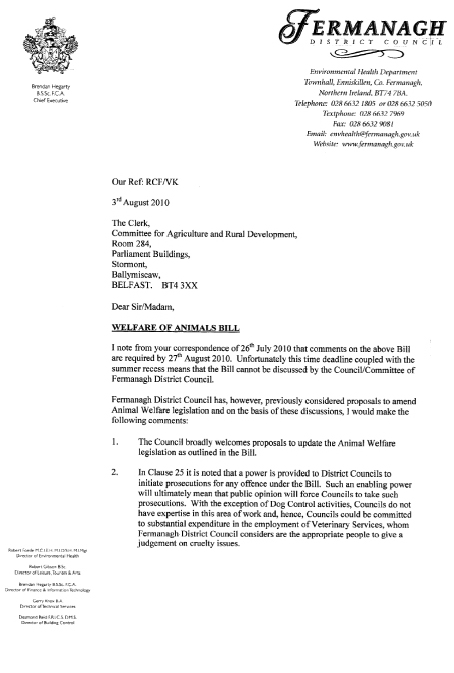
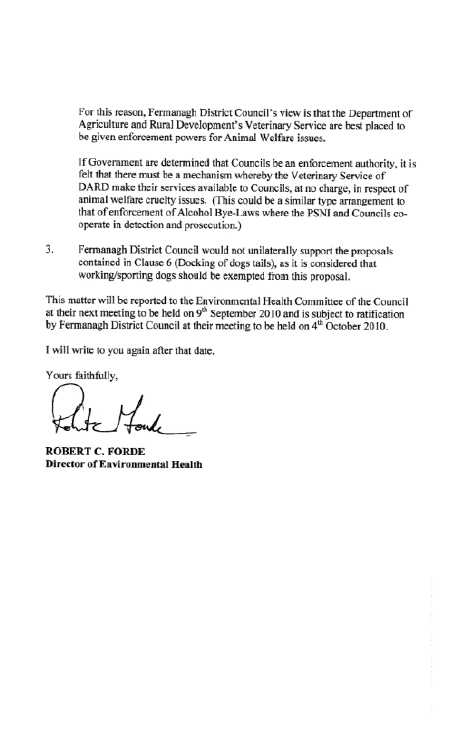
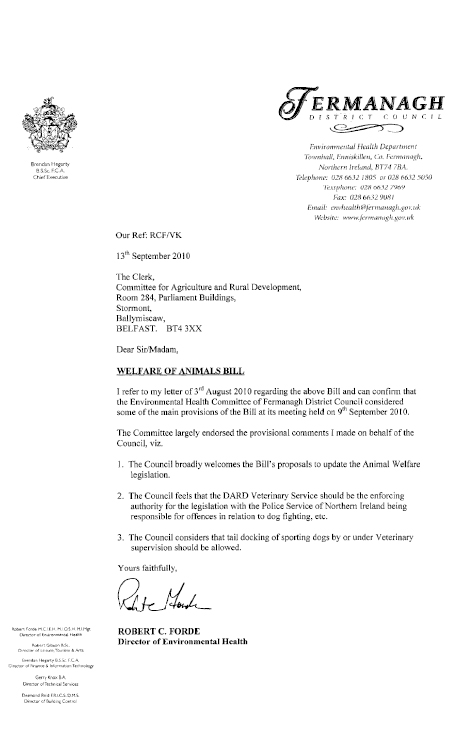
From: ian hoey
Sent: 03 August 2010 16:10
To: +Comm. Agriculture Public Email
Dear Committee,
I first contacted Stormont over a year ago about my concerns with circuses that use animals.
I would like to address the committee dealing with the Welfare of Animals Bill in relation to this issue. As a lay person linking my points to the relevant parts of the Bill is quite difficult, but I do not think that this should prevent me from presenting my views.
Welfare of Animals Bill:
Part Two Protection of Animals
4 (1) a : should not cause an animal to suffer
(2) d : if the suffering is unnecessary
9 (2) a : animals should be kept in a suitable environment
(2) c : be able to exhibit normal behavioir patterns.....
I feel that circuses fail to meet these criteria when using animals to perform.
And I would like the opportunity to present my position to the committee.
Yours sincerely
Ian Hoey
From: Richard Browne
Sent: 03 August 2010 09:03
To: +Comm. Agriculture Public Email
Dear Committee
I write this email with regard to dogs under the new Animal Welfare Bill and I have been told that, under this new legislation, tail docking is to be banned in Northern Ireland for all dogs.
As an owner of English Springer Spaniels that are used for hunting and trialling, I would urge the committee to allow an exemption for working dogs within this new legislation.
My dogs have all been docked in the first few weeks of their lives before the bones have developed fully in the tail. This has had no effect on the dog's health or well being in anyway. On the other hand, I have seen Springer Spaniels which have not been docked, working in very thick cover for long periods that have had some really nasty injuries to their tails.
The very nature of a Springer is to hunt, that's what they have been bred for for hundreds of years. The dogs love hunting and their tails are wagging frantically as they hunt. The more cover that is hunted the longer tails get caught on bramble, gorse, hawthorn, wire etc. and the dogs can suffer terrible injuries to the tail. There is no treatment available with a vet for injuries to the tail and the owner is left to try to clean the wounds with antiseptic or salt and water and this makes the dogs suffer even more.
If this bill is truly about creating better welfare standards for all animals, then I cannot emphasise enough how important it is to have an exemption for working dogs. This has absolutely nothing to do with looks but is to do with the health and well being of our hunting partners and best friends.
Best Regards,
Richard Browne
From: Ian Bryson
Sent: 04 August 2010 08:30
To: +Comm. Agriculture Public Email
I would like to comment as follows:
1. I am in favour of not placing the Irish Hare on schedule 5, as per the Implications For Farmers Briefing Note of 26th January 2010.
2. Clause 6: Regarding tail docking, I would prefer an exemption for working dogs.
3. I would strongly oppose any amendment which might be made to ban or restrict hunting of hares, foxes and deer, and to curtail any other country activity such as shooting or fishing.
4. I would prefer the ban on hare coursing to be lifted, with this activity allowed in accordance with a strict set of rules.
5. I would like to see the use of snares continued, within a strict licensing system, such as that which exists in Scotland.
Should you wish for a further explanation of any of the above, please advise me accordingly.
Regards,
Ian Bryson
From: Aaron McMahon
Sent: 05 August 2010 13:58
To: +Comm. Agriculture Public Email
Subject: FW: Tail Docking-Common Sense!
To Whom It May Concern,
I would like to say that having taken up Shooting and Field sports in general in 2001 and owning several dogs since then, I can honestly say that the worst injury I have ever seen on a days shooting is that of a spaniel whose tail has not been docked for working. It seems that an undocked spaniels tail cuts very easily at the tip when working through cover and can therefore bleed profusely for the rest of the day causing pain and suffering and possible amputation.
It is in my opinion 'common sense' to dock working dogs tails and extremely cruel not to.
Yours Sincerely
Mr Aaron McMahon
From: andrew
Sent: 30 July 2010 15:07
To: +Comm. Agriculture Public Email
I want to voice my concern at the proposed inclusion of a ban on tail docking for working dogs in the forthcoming Animal Welfare Bill. The docking of working dogs tails at birth is an essential measure needed to control damage to the tail in working and hunting. It is well documented in the press that working dogs without docked tails suffer bleeding and tissue damage as a result of beating cover. I have had dogs with docked tails for many years and it does not distress any of them and indeed spares them from injury and infection caused by tail damage when working.
I will oppose this measure strenuously and ask you to include an exemption for working dogs to permit tail docking in NI.
Andrew Moag
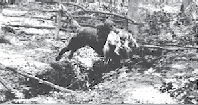
Undocked working German Long-haired Pointer
1. Tail Docking - The act of tail docking is an injury to the dog = 100% injury of all dogs docked (as would be cropping if permitted)
2. Number of dogs required to be docked to save 1 injury
The report states that 500 dogs would have to be docked to prevent 1 injury
3. Breed types affected by injury
The majority of injuries that occurred appeared to happen in non-working restricted environment (home/kennelling/cages/doors).
4. Survey1 on tail injury and lameness in gundogs 2005/06 found there to be numerous injuries especially to those dogs in the beating line with 'picking up dogs next at risk'.
5. National Regulation - English and Welsh regulation make the various and non-uniform exemptions difficult to police. Local Authorities in England (and Wales) are not obligated to investigate questionable docking. Some may pass their responsibility to the RSPCA in their respective areas.
6. Prosecution - This down-loading has the potential of increasing the work load of the RSPCA's investigation teams.
7. Transfer of ownership of docked dogs/removal to another region -The regulations in England and Wales do not state that the legal certification must be transferred with the dog to any new owner along with appropriate micro-chipping certification.
8. Advertisements - Internet/newspaper advertising is not bound by regulation to prohibit advertisements of docked dog/litter advertising. Whole/part litters advertised as "suitable for work/pet" but placed in pet type websites/newspapers
9. Required regulatory documentation for legal docking to take place -Gun licences/other documentation in order to have litters docked is reportedly easily obtainable.
10. Importation of docked dogs from abroad - (including Isle of Man etc.)
11. Exhibition of docked dogs (England and Wales) - Non payment of entrance fees.
(a) The reality of any docking is that it causes injury to the dog which if done, according to the report, would likely save only 1 dog in 500 from injury.
(b) The report made mention of docked dogs being injured. A docked tail where the scarred skin protecting the stump is thinner from the surgery leaves the area more vulnerable to injury or neuroma.
No comment necessary other than this cannot justify amputating the tail of certain types of dog (the injuries in the report affected non-docked breeds as well as those exempted Engl. Wales). Dogs inheriting von Willibrands disease could die as a result of being docked.
(a) Breeds injured were varied and not only from the exempted breeds.
(b) Spaniels can and should be bred with less gyratory and vivacious tail sets.
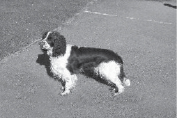
(c) The report noted that injuries were sustained more in the home rather than field environment. Therefore owners need to give more consideration to dogs' safety in restricted movement areas.
A total of 1,312 dogs in survey (17 breeds - 33% were "docked" breeds)
Injuries other than tails 21.6% )
Uninjured 75.4% ) totals rounded up
Tail injuries (15 to docked Spaniels) 3.0% )
'….. There were 10 tail injuries in 245 docked Springer Spaniels and 3 injuries, including one fracture, in 12 undocked dogs of that breed….'
(a broken tail can be mended with tongue depressor splints taped on for 2-3 weeks– docking may not have been required for these injuries).
It will be seen from the report that there was 'a significant association between dogs working in the beating line and lacerations, puncture wounds and tail injuries; next were the picking up dogs…This evidence is suggestive that dogs are being required to work in dangerous conditions where they get a higher percentage of body injury compared with the number of tail injuries.
(a) (As forecast prior to the Act being passed), a ban with exceptions by way of regulation did produce uncertainty and complexity. The differences in national regulations make it a non-cohesive legislation and therefore illogical and difficult to comprehend by dog owners.
(b) Prosecution is limited by the various loopholes the regulations present.
(c) Local Authorities in England (and Wales) are not obligated to investigate questionable docking and therefore do not (except Wales). Some may pass their responsibility to the RSPCA in their respective areas.
(a) This has the potential of increasing the work load of the RSPCA's investigation teams. There is never feed back from the RSPCA as to whether there has been follow-up of the cases reported to them There does not appear to be a freedom of information policy readily available.
(a) The regulations in England and Wales do not state that the legal certification must be transferred with the dog(s) to any new owner along with appropriate micro-chipping certification thus investigation problematical as disclosure of previous ownership/breeder not enforceable.
(b) Should an owner of a dog docked - since the Act - move to Scotland or Wales with different legislation this makes the regulations/law difficult to administer if the paperwork is not following the dog.
(a) There are no regulations regarding advertising docked dogs/litters
(b) Hosting sites and advertorial papers are solely interested in sales and revenue
(a) It has been reported to me and can be seen on various websites that gun licences can be obtained for the purpose of having litters docked. Example found 3/8/10
please do think of the terrier pups and get them docked. All you need as proof is a shotgun license or a letter from a farmer OR keeper saying you work the terriers...
IF you have any problems, please PM me http://www.k9community.co.uk/forums/index.php?s=a8f4edb13986e14c69ca4e4ba7caf536&showtopic=70429&pid=1051296&st=0&#entry1051296
(b) landowners as signatories are seemingly easily persuaded
(a) Since the introduction of the Act there has been a large trade in the export of dogs from Ireland (North and South). Some English breeders have moved to Ireland to evade the law and puppy farms have exploited the loophole by importing van loads of puppies for sale on motorway service stations, pet shops etc.
(b) There is also concern that dogs are being exported to countries where docking is still permitted and on arrival have their tails docked. This needs to be addressed.
(a) A loophole resulting from the Act has come into force whereby Shows only charge car parking fees and entry is "free" making it possible for docked dogs to enter the show.
(b) Regional breed shows usually do not charge admission to members of the public who are usually in attendance purely to find a breeder from whom to purchase.
(c) It is evident at certain dog shows where the public pay an admission fee that "docked" dogs are being shown and on occasion placed. At present there does not appear to be a ground swell of objection by other entrants which may be due to cost of complaining to the Kennel Club or may be a fear of being ostracised by judges and other exhibitors.
(d) The Kennel Club has refused to accept responsibility for policing the Act and it is likely that only shows such as Crufts will have a LA/RSPCA person on site who might investigate.
(e) It might be helpful if all regions spoke with one voice over the prohibition of showing docked dogs at any show (other say than a Charity Show) from a specific date
1. A survey of gundog lameness and injuries in Great Britain in the shooting seasons 2005/2006 and 2006/2007 J. E. F. Houlton. Davies Veterinary Specialists, Higham Gobion, Hertfordshire, UK
From: J BOAL
Sent: 08 August 2010 15:52
To: +Comm. Agriculture Public Email
Subject: Draft Welfare of Animals Bill
With reference to the Draft Welfare of Animals Bill in Northern Ireland re a proposal to ban tail-docking of dogs I feel that it is essential to have an exemption for working gundogs. I have owned working gundogs for more than thirty years and have learned from experience in the field that injuries to dogs tails can lead to veterinary surgery which is much more complicated and distressing for an adult dog than the necessary tail-docking carried out by a vet at the appropriate puppy stage.
John Boal
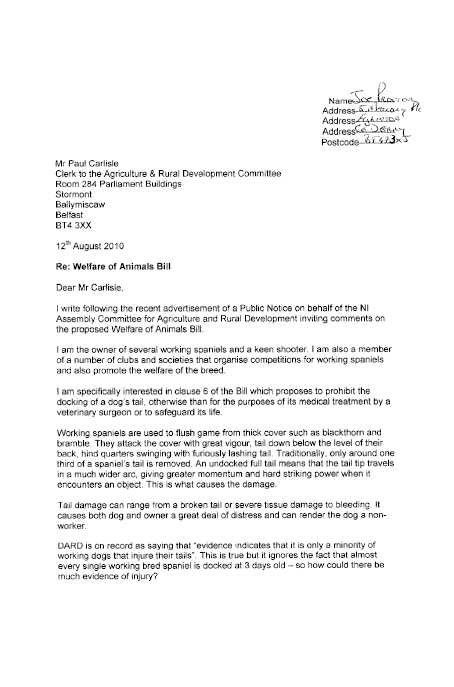
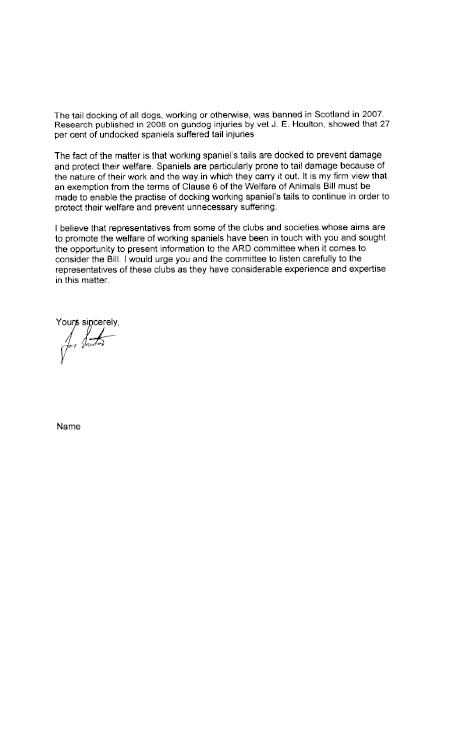
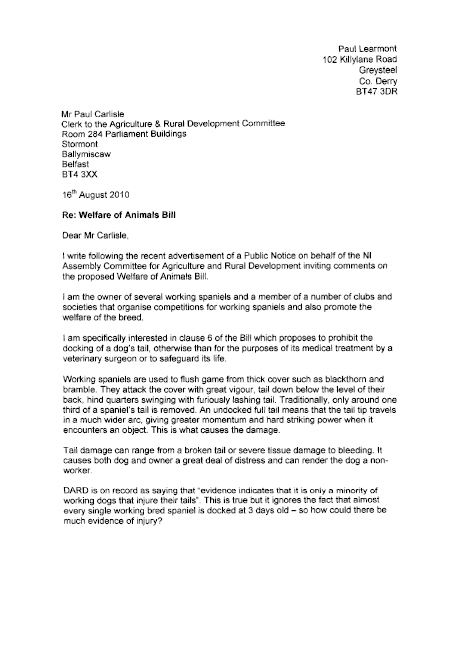
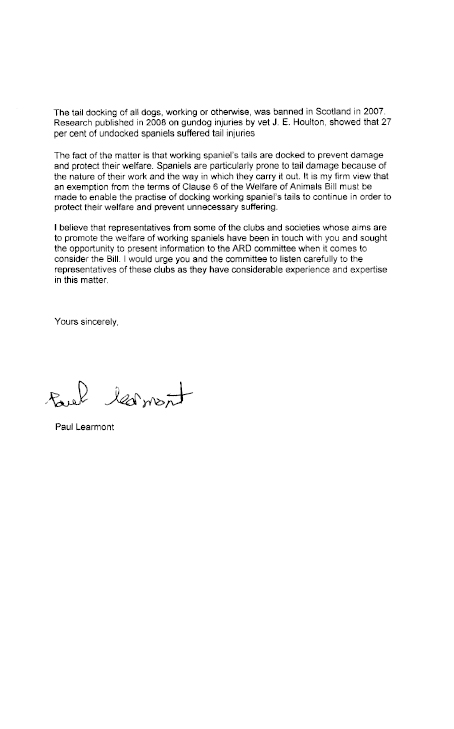
Mr Paul Carlisle
Clerk to the Agriculture & Rural Development Committee
Room 284 Parliament Buildings
Stormont
Ballymiscaw
Belfast
BT4 3XX
18th August 2010
Dear Mr Carlisle,
I write on behalf of the North West Ulster Spaniel Club following the recent advertisement of a Public Notice on behalf of the NI Assembly Committee for Agriculture and Rural Development inviting comments on the proposed Welfare of Animals Bill.
The North West Ulster Spaniel Club's aim is to promote the interests and welfare of working spaniels and to hold competitions, called Field Trials to assess and demonstrate the working abilities of spaniels. The club is licensed by the Kennel Club to run these Field Trials, the results of which often have a profound effect on breeding policies and therefore the future development of the breed.
The North West Ulster Spaniel Club is specifically interested in clause 6 of the Bill which proposes to prohibit the docking of a dog's tail, otherwise than for the purposes of its medical treatment by a veterinary surgeon or to safeguard its life.
Working spaniels are used to flush game from thick cover such as blackthorn and bramble. They attack the cover with great vigour, tail down below the level of their back, hind quarters swinging with furiously lashing tail. Traditionally, only around one third of a spaniel's tail is removed. An undocked full tail means that the tail tip travels in a much wider arc, giving greater momentum and hard striking power when it encounters an object. This is what causes the damage.
Tail damage can range from a broken tail or severe tissue damage to bleeding. It causes both dog and owner a great deal of distress and can render the dog a non-worker.
DARD is on record as saying that "evidence indicates that it is only a minority of working dogs that injure their tails". This is true but it ignores the fact that almost every single working bred spaniel is docked at 3 days old - so how could there be much evidence of injury?
The tail docking of all dogs, working or otherwise, was banned in Scotland in 2007. Research published in 2008 on gundog injuries by vet J. E. Houlton, showed that 27 per cent of undocked spaniels suffered tail injuries
The fact of the matter is that working spaniel's tails are docked to prevent damage and protect their welfare. Spaniels are particularly prone to tail damage because of the nature of their work and the way in which they carry it out. The membership of the North West Ulster Spaniel Club has considerable experience and expertise in welfare issues related to working spaniels. It is our firm view that an exemption from the terms of Clause 6 of the Welfare of Animals Bill must be made to enable the practise of docking working spaniels tails to continue in order to protect their welfare and prevent unnecessary suffering.
Representatives of the North West Ulster Spaniel Club would welcome the opportunity to present information to the ARD committee on this matter when the committee come to consider the Bill.
Yours sincerely,
Art McCrory
Secretary.
From: Ronan Gorman
Sent: 18 August 2010 13:30
To: +Comm. Agriculture Public Email
FAO Paul Carlisle
Paul,
Please find attached a letter from the North West Ulster Spaniel Club regarding the Welfare of Animals Bill and specifically proposals to introduce a ban on the docking of dog's tails. As you will see from the letter members of the club have a significant interest in this issue as working spaniels tails are docked in order to prevent injury and therefore to protect their welfare.
You will probably receive similar letters from a number of other spaniel clubs and indeed from individual members. We in the North West Spaniel Club would be very keen to appear before the committee and present important evidence to them on this matter. If you would like to liaise diectly with me I would be happy to arrange a delegation from the spaniels clubs to appear before the ARD committee.
Regards,
Ronan.
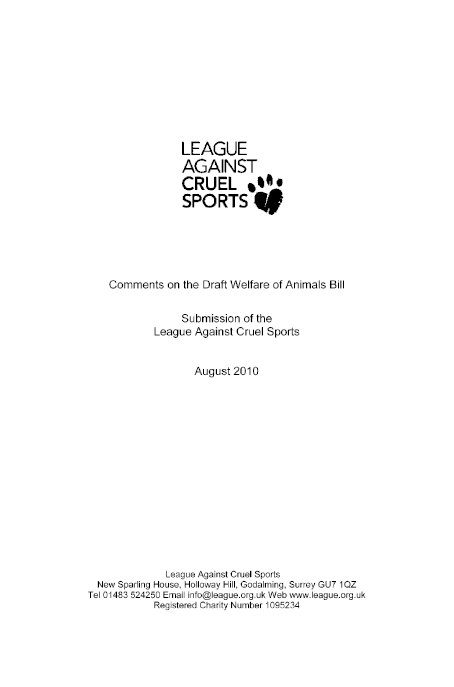
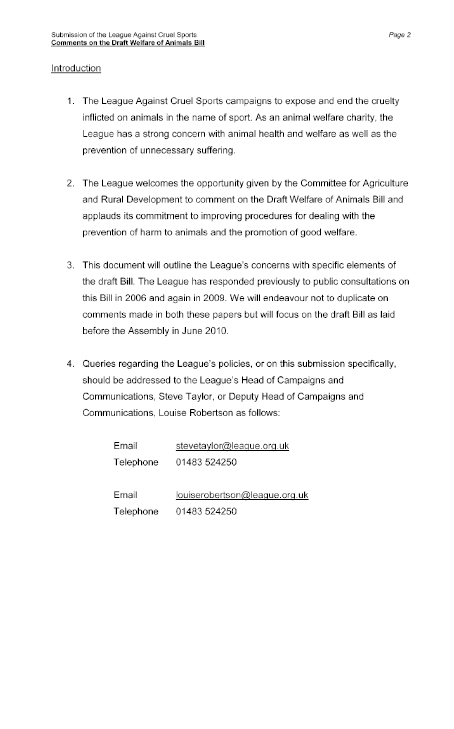
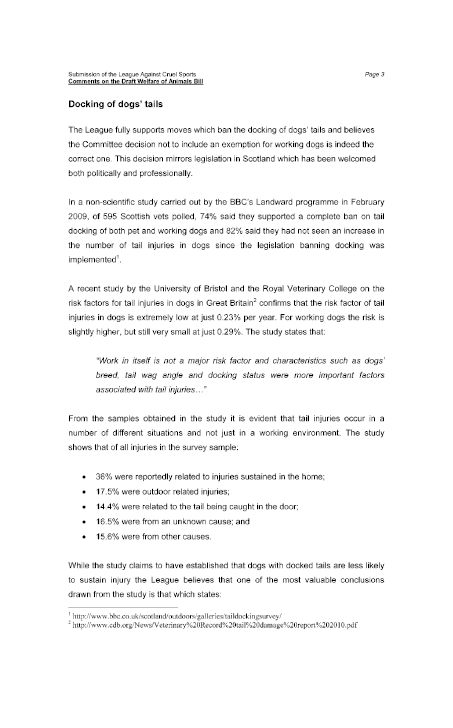
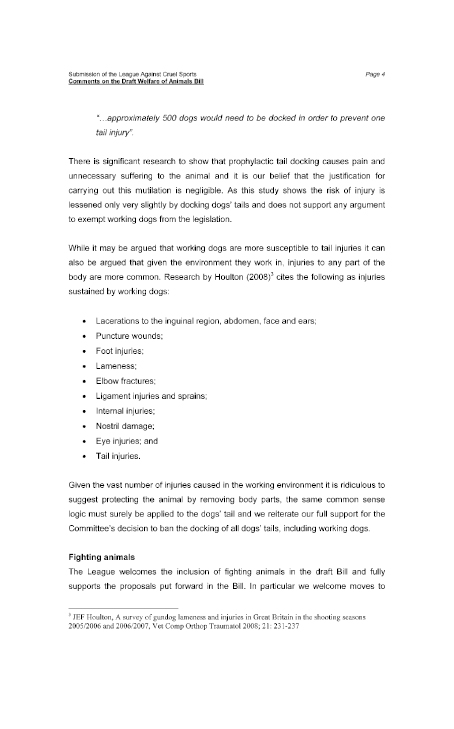
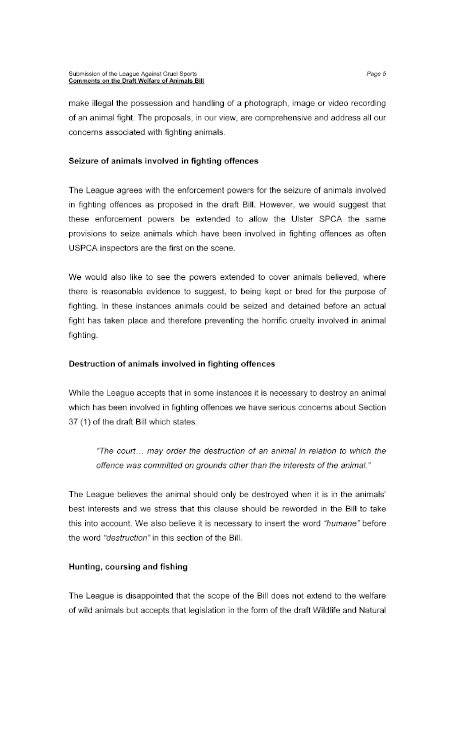
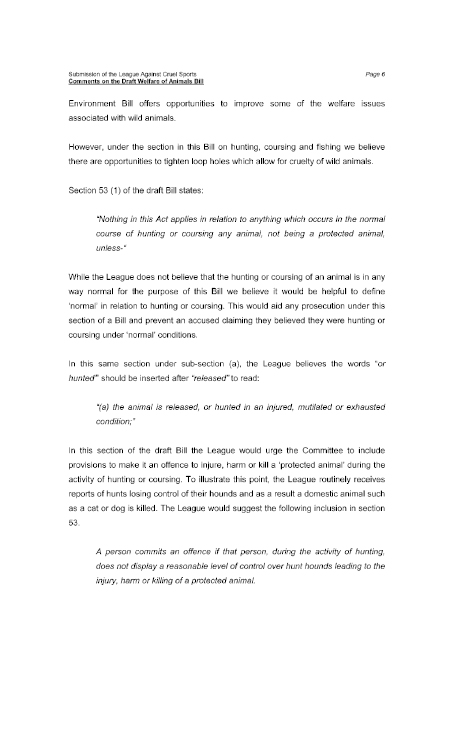
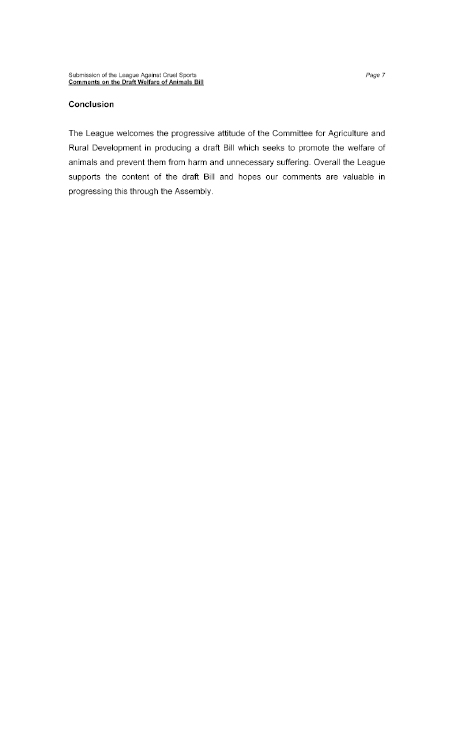
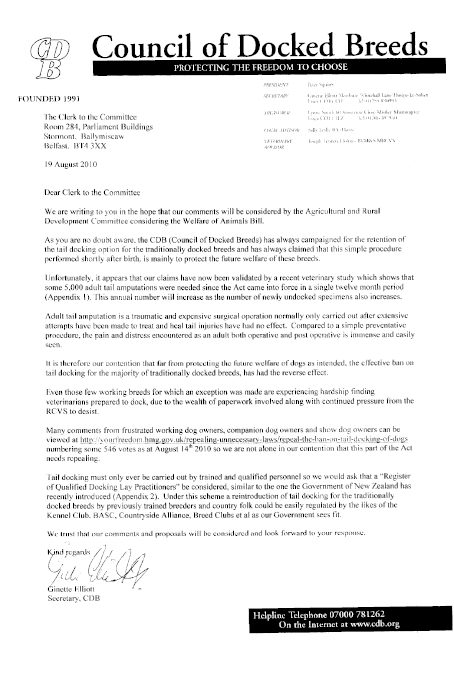
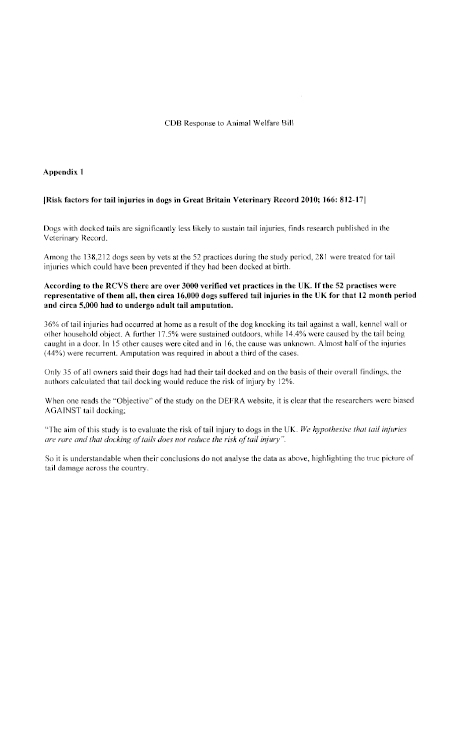
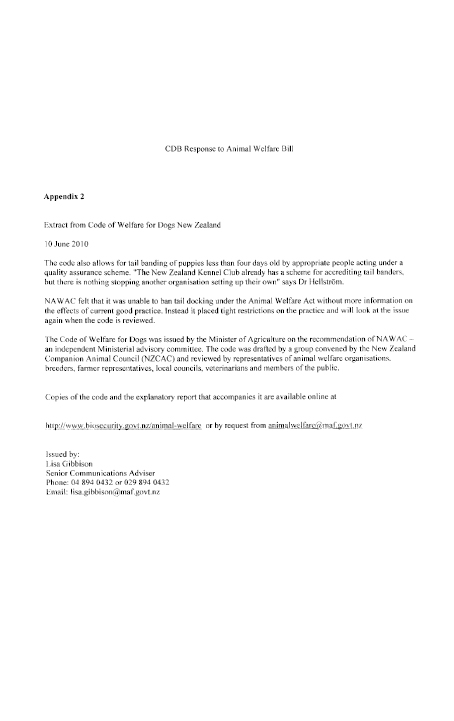
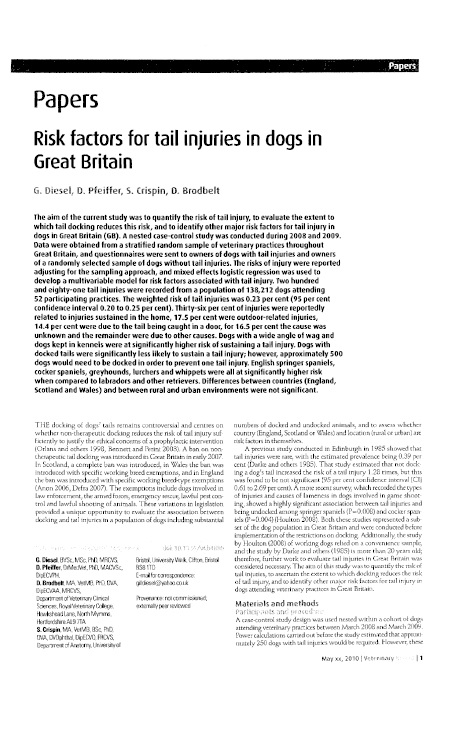
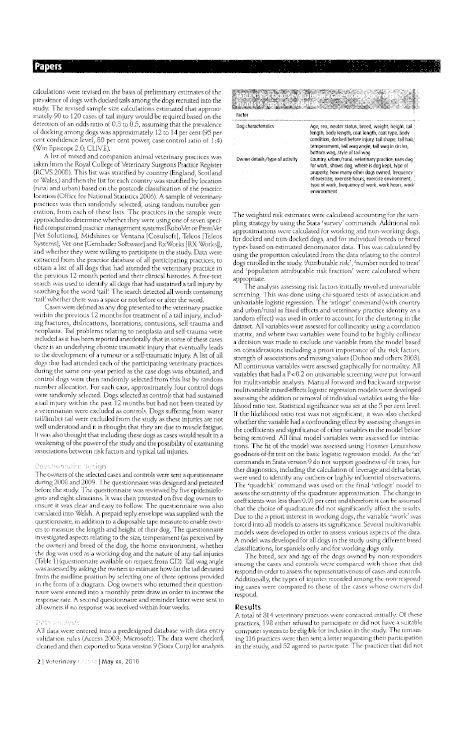
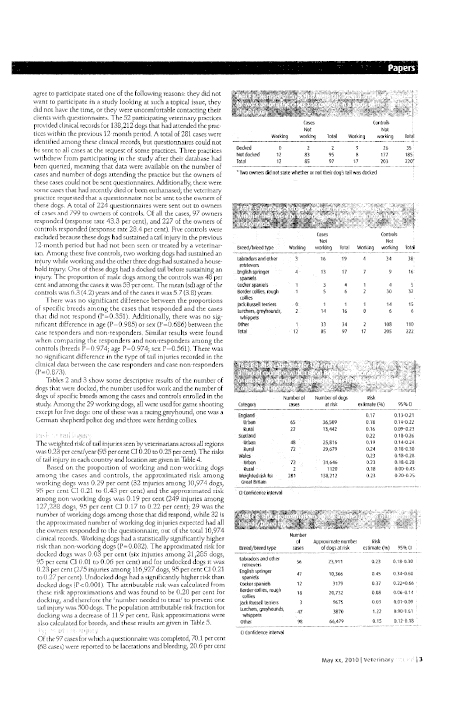
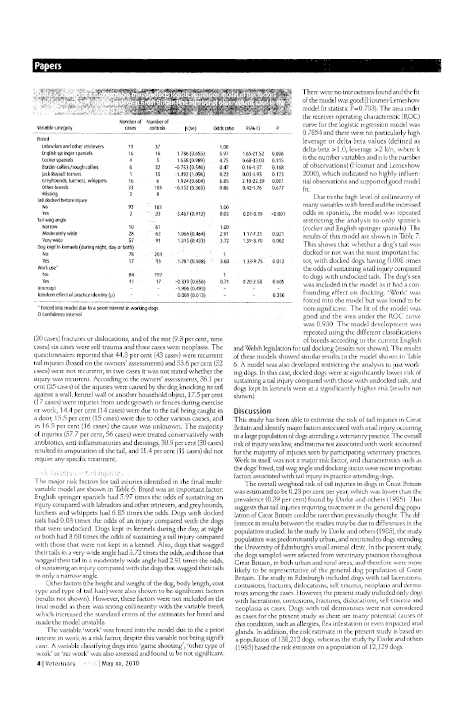
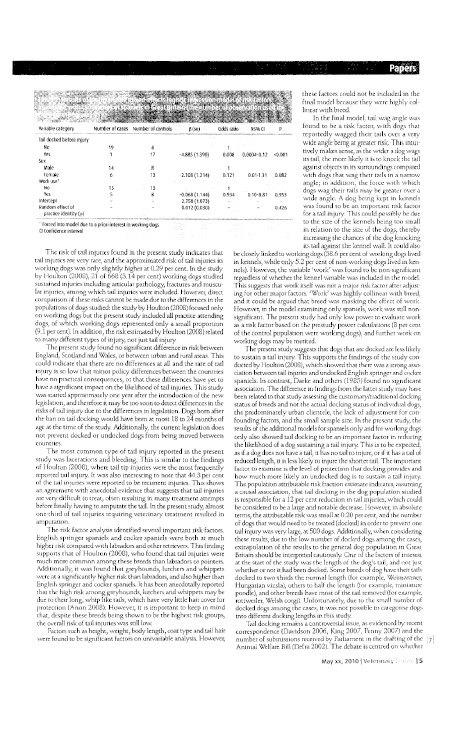
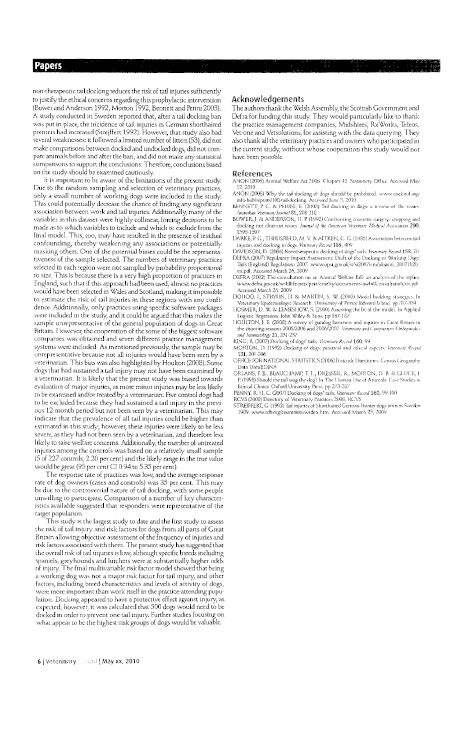
From: Denice Corbett
Sent: 23 August 2010 19:22
To: +Comm. Agriculture Public Email
Subject: Animal Welfare Bill
As a consultee I wish to respond to the proposed Bill.
As this procedure has been scientifically proven to be both painful and unnecessary I would respectfully suggest that it be banned for all animals including piglets and lambs.
I would suggest that it be required by law to microchip all dogs and cats at birth or soon after birth so that if lost or abandoned the animal in question could be traced back to the owner. This would, I feel, help stop the problem of stray dogs and save the taxpayer thousands of pounds each year.
As well as banned from keeping animals, those proven to have been cruel to animals should also be banned from working with animals.
In the proposed legislation mention is made of prosecuting those who have images of dog fights both locally and in the UK on their computer. I would respectfully suggest that anyone who has any images of animal abuse including dog fighting from anywhere in the world should be prosecuted, it does not seem logical to prosecute only those with local or regional images of such abuse.
Reference is made to suitable diet, this should include the access to fresh water at all times.
I feel that this statement needs to be looked at again; I refer to a case of suspected dog fighting in Tyrone a few years ago where a fighting dog was traced from Scandinavia to Dublin and finally Dungannon. The police accompanied by the USPCA and the local dog warden went to the home of the suspect and apprehended the dog in question but were not able to enter the home of the suspect and as they had no search warrant. On receipt of the warrant (the following day) all the dog fighting equipment and two other dogs were no longer on the premises, vital evidence was lost. This resulted in a lengthy court case. I apologise if some of the details in this statement are inaccurate but in essence it is as reported in the media this story illustrates that sometimes to wait for search warrants is giving the criminal time to destroy or get rid of evidence surely it is possible to give officers who are enforcing this Bill the necessary warrants to enable them to enter premises where evidence of animal abuse and/or cruelty is strong.
This is an area where animals, particularly farm animals, are subject to abuse. The legislation with regard to this whole area needs to be tightened up as there is ample evidence to suggest that chickens, pigs, sheep, horses and cattle are subject to overcrowding on a regular basis and draconian measures should be taken to regulate just how much space each animal should have to be comfortable on any journey. As well as the need to have fresh water.
The Bill requires suitably qualified officers to police this legislation, who are they?, where will they be based?, and will there be enough of them to affect the changes required in this legislation, also are there any plans to link this law with that of the Republic of Ireland surely this would make sense and be more workable.
Thank you for giving me this opportunity to comment on this Bill it has been a long time coming and is much needed.
Denice Corbett BA
From: Denice Corbett
Sent: 25 August 2010 08:58
To: +Comm. Agriculture Public Email
Re Animal Welfare Bill
I have already submitted comments but would like to add to them:
In relation to dogs I would like to respectfully point out that the tethering of dogs, is preventing the dog from exercising basic needs such as toileting and I have frequently seen dogs lying surrounded by their own faeces. This is especially so with guard dogs. Dogs, like humans, do not instinctively relish this in the fact it is very distressing to them.
Regards
Denice Corbett
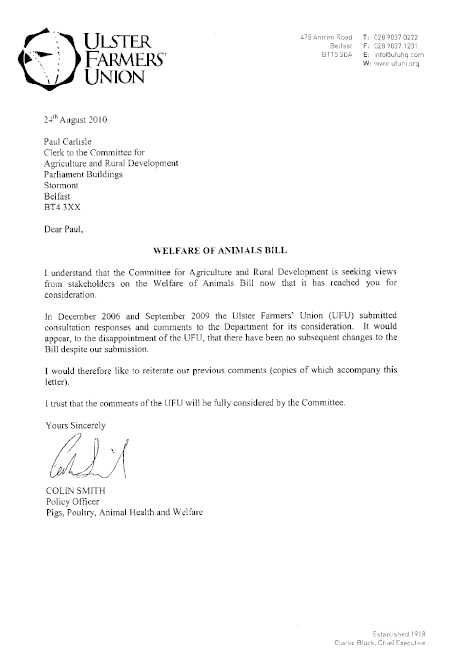
From: Colin Smith
Sent: 28 September 2009 16:38
To: Kate Davey DARD
Hi Kate,
I have been in touch with your colleague Billy Montgomery regarding last weeks meeting. Due to a mix up to do with Ian Stevenson's departure we were not aware of the meeting until today. We originally submitted a response to the consultation on 4th December 2006 (please find attached). Having looked quickly at the summary paper on the welfare Bill could I make a few short additional comments.
My apologies that these comments are so brief, I will be on leave until Monday 28th September, if you would like to speak to anyone regarding this response please contact our Policy Director, Wesley Aston.
Kind Regards
Colin
Colin Smith BSc (Hons)
Policy Officer (Pigs, Poultry, Animal Health)
Ulster Farmers' Union
475 Antrim Road
Belfast
BT15 3DA
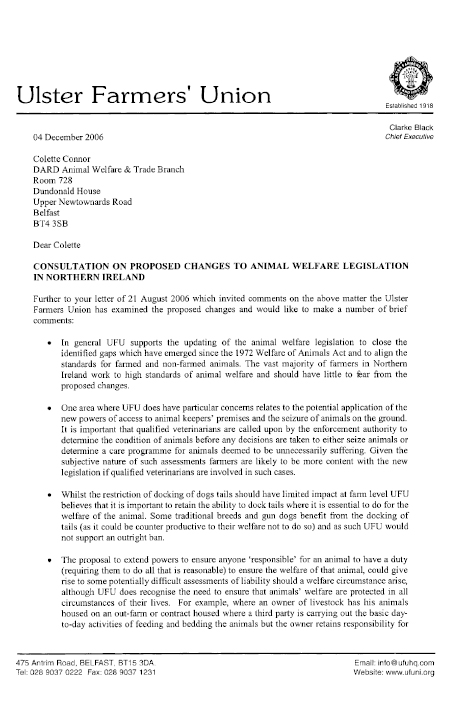


Tommy Mayne
Country Officer
BASC Northern Ireland
33 Castle Street,
Lisburn,
Co Down,
BT27 4SP
Tel: 028 9260 5050
Email: tommy.mayne@basc.org.uk
25 August 2010
The Clerk to the Committee
Room 284
Parliament Buildings
Stormont
Ballymiscaw
Belfast
BT4 3XX
Dear Mr Sir/Madam
The British Association for Shooting & Conservation (BASC) is the UK's largest shooting organisation and this letter and the documents associated with it represent our submission to the Committee for Agriculture and Rural Development on the content of the Welfare of Animals Bill.
BASC's working gundog survey, carried out in 2006, estimated that 47% of BASC members own at least one working dog. BASC Northern Ireland believes that some breeds of working dogs should be exempt from any ban on tail docking given the evidence that proves they are prone to tail injuries which can be both painful and reoccurring.
BASC Northern Ireland requests that the Committee clarifies its position on trapped animals, park deer and wing tagging.
BASC Northern Ireland's submission highlights many complex issues and BASC staff would welcome the opportunity to meet with DARD staff to consider and discuss our areas of concern.
BASC Northern Ireland, on behalf of Northern Irelands' gamekeepers and shooters, requests the opportunity to make a presentation to the Committee during its discussions on the content of the Bill.
Yours sincerely,
Tommy Mayne
Country Officer
BASC Northern Ireland
BASC is the representative body for sporting shooting in the UK and has a membership in excess of 130,000. Our aims are to protect and promote all aspects of sporting shooting and the wellbeing of the countryside. We actively promote good practice, training, education, scientific research and habitat conservation.
BASC believes that all those who shoot, must conduct themselves, at all times, according to the law, to the highest safety standards and with sportsmanship and courtesy. Working dogs play a vital part in recreational shooting, both in flushing quarry from cover and in recovering shot quarry.
Firstly, before we address the issue of tail docking, we must clarify the use of the phrase, "working dog" when used in the context of live quarry shooting.
There are many different breeds of working dog that assist their owners in the shooting field, such as Labradors, Setters and Pointers, however the three breeds normally associated with tail docking are;
The reason for docking the tails of working dogs such as the Spaniels, Terriers and Hunt-point-retrieve (HPR) breeds and their crosses, is well documented (please find these reports included with this submission). Given the very nature of the environment in which they work, these dogs often sustain unnecessary, painful and reoccurring tail damage which causes suffering to the dog and distress to the owner. These injuries, usually sustained whilst hunting in dense cover, can often be difficult to treat, given that bandages and dressings designed to keep the wounds clean and prevent infection, can become dirty or dislodged.
Dogs that are regularly used in water can develop a condition called "water tail", also known as "limber tail syndrome" or "dead tail". This condition specifically affects dogs of the hunting and sporting breeds, such as Spaniels, Pointers and Jack Russell Terriers. A "dead" tail will stick horizontally out for a few inches, then point straight downward. It appears "clamped" to the dog's body, and may even appear broken. The dog usually experiences pain and discomfort, and in serious cases, muscle damage may occur. Sometimes there is swelling around the base of the tail and it can be very painful to the dog. The most common cause of water tail is overexposure to cold, wet weather or swimming in cold water, sometimes in conjunction with field hunting.
Prophylactic docking is a preventative measure carried out by a qualified veterinary surgeon which involves surgical removal of the tail (or part of the tail) from litters of puppies at less than 5 days old to avoid tail damage during their working lives. The procedure causes no more than momentary discomfort since the puppy does not have a fully developed nervous system. When the pup is placed back with its littermates, it quickly falls asleep or starts feeding from the bitch.
Many undocked adult dogs undergo the tail shortening procedure out of necessity, when the tail has been damaged or, as a result of complete tail paralysis, tail tumours or for some other medical reason. This is known as Therapeutic docking and is carried out under general anaesthetic. The older the animal, the larger the tail, and therefore the more traumatic the procedure becomes.
Prophylactic docking should not be confused with "Cosmetic docking" which is carried out in order to maintain long established breed standards.
Statistics from the attached Biomathematics & Statistics Scotland (BioSS) report shows that Prophylactic docking is beneficial to the welfare of the working dog (please find the BioSS survey included with this submission).
Having carefully considered the long-term welfare and management benefits, Defra recognised the need for an exemption for working dogs in the Animal Welfare Act 2006, which bans tail docking in England and Wales. The exemption allows certain types of working dog to have their tails docked by a veterinary surgeon, provided they are no more than five days old and providing they comply with other stated criterion.
The Animal Health and Welfare (Scotland) Act 2006 included a total ban on all non-therapeutic tail docking of dogs. The Regulations do not allow for prophylactic tail docking of any dog therefore it is currently an offence for anyone, including veterinary surgeons, to dock the tails of puppies.
BASC Scotland and other organisations have submitted a petition to the Public Petitions Committee, seeking to overturn this ban. This has not yet been successful however recently published research supports the argument that prophylactic tail docking is essential to the long-term welfare of working dogs.
There are no restrictions on tail docking in the Republic of Ireland.
Although BASC is not aware of any veterinary statistics in relation to the number of tail injuries sustained by working dogs in Northern Ireland, it is likely that this figure would be insignificant. This is not due to the fact that the injuries go unreported, but most likely because the Province's working dogs have already had their tails docked therefore the risk of tail injury is greatly reduced. In Northern Ireland, prophylactic docking is currently carried out on farm animals such as lambs and piglets. Lambs undergo the procedure in order to prevent faecal soiling. Piglets have their tails shortened in order to prevent the animals biting each others tails which can result in wounds becoming infected.
There have been a number of different surveys and studies carried out in recent years in relation to tail injuries. One of these studies entitled 'Risk Factors for Tail Injuries in Dogs in Great Britain' was commissioned by the Scottish Government (and DEFRA) and carried out by the Royal Veterinary College during 2008 - 2009. This RVC survey covered 52 veterinary practices in mainland UK (please find the RVC survey included with this submission).
This study surveyed a total of 138,212 dogs of which only 24 were working dogs, therefore the chances of any of the other "non working dogs" having sustained a tail injury were greatly reduced. Hence, this survey does not truly reflect the number of horrific tail injuries sustained by working dogs during the survey period.
In order to get a much more realistic idea of the scale of the problem, we need to look at a Scottish survey, sponsored by Airlie Bruce Jones and carried out by BioSS between August 08 and July 2009 (please find the BioSS survey included with this submission).
The Scottish Government banned tail docking for all dogs in 2007 and consequently, the remit of this Scottish based (BioSS) survey was to discover what tail injuries, if any, may have occurred to "working gundogs" from August 2008 to July 2009, when dogs born after the docking ban started to work with full tails.
The BioSS study concluded:
"The study has identified strong statistically significant evidence that working dogs belonging to the Springer and cocker breeds have a higher risk of injury associated with longer tails. A similar effect was observed for hunt-point-retrieve (HPR) animals, but that effect was not formally statistically significant".
"No other risk factors were found to be statistically significant in explaining injury, though of course this does not mean that other, unrecorded, factors were not operational. The results do suggest, however, that longer tails are an important predisposition risk, either alone or in interaction with other risk factors".
Another separate survey, entitled "A survey of lameness and injuries in Great Britain in the shooting seasons 2005/2006 and 2006/2007"concluded that;
There were 10 tail injuries in 245 docked Springer Spaniels and three injuries, including one fracture, in 12 undocked dogs of that breed.
The corresponding figures for Cocker Spaniels were five injuries in 164 docked dogs and three injuries in 10 undocked dogs. Both breeds had a highly significant association between tail injuries and undocked dogs.
Please find a copy of the above survey included with this submission.
Recent research statistics show that a working dog which has sustained a tail injury, usually suffers from repeat injuries, requiring extended treatment and resulting in reduced working time. Reoccurring injuries mean that a partial tail amputation can become a necessity for those dogs that are required to carry out regular work. Tail amputations carried out by qualified vets under general anaesthetic usually involve a degree of risk.
BASC seeks an exemption, similar to that in England, for working dogs in respect of tail docking, within the Welfare of Animals Bill. BASC believes that to ban the prophylactic docking of working dogs tails would (as in Scotland and Sweden) result in unnecessary suffering for large numbers of the Province's working dogs.
BASC has sought clarification from officials at DARD and NIEA over a number of issues and concerns which if left unchecked could impact our membership and the shooting community of Northern Ireland. However a number of concerns still remain and these are outlined below.
BASC understands that the bill will apply to gamebirds not living in a wild state. Our understanding is that they would therefore be covered in laying units, on the rearing field and during the initial period of release. However, once the birds are able to move freely to and from the pen they would not fall within the remit of the bill.
This issue is more complicated when we look at examples of keeping deer and BASC seeks further clarification on the inclusion or otherwise of deer kept within;
Deer Parks - Deer are raised in a park type setting, where they are able to roam freely with minimal input. They may be provided with some supplemental feed, calves are unlikely to be weaned, nor antlers removed, stock is not housed and management is generally with a rifle.
Deer Farms - Deer may be farmed following the conventional agricultural practices, including organic, grazing is rotated, some or all stock may be housed in the winter (not all year round). Nutritional and mineral supplements are provided when necessary to maintain the deer's health, injuries and health problems receive prompt veterinary attention normally within a purpose built handling unit. Calves are usually weaned, antlers, certainly of the young stock, are removed on safety grounds.
One further issue in this area that requires clarification is the status of trapped animals. We understand that this bill will not directly deal with pest control practices. However we would strongly urge DARD to liaise with BASC to provide clarification as to whether a trapped animal would fall within the remit of the Act so in future we can inform our membership.
BASC is pleased that the term "hunting" has been clarified and will refer to normal sporting shooting practices. Formal recognition of this would be welcomed.
Section 3. (3) For the purposes of this act, a person who owns an animal shall always be regarded as being the person who is responsible for it.
This creates a problem for many shoot employers, shoot employees and gundog owners. Many shoot owners and syndicates employ gamekeepers to rear their birds for the forthcoming shooting season often these owners or syndicate members do not live on the estate and therefore do not have any day to day contact with the birds. In addition how would this apply to a gundog owner who puts their dog into kennels for training, or a holiday or asks someone else to work their dog in a field trail competition? It seems disproportionately heavy handed for these owners to be open to prosecution under this act when, in the examples provided, they have no direct influence over the day to day welfare of the animals they own. BASC believes this section should be reworded or removed.
Section 5. (4) - BASC seeks clarification on the status of wing tagging of gamebirds for stock monitoring. A practice which is less popular but still something some shoots may want to use to monitor the spread of released birds across an area and bag returns.
BASC seeks clarification on the term "inspector" when used within the bill and seeks assurances that non government officials will not be able to operate using this legislation.
BASC is aware of reports of foxes being released from the care of a human back into the wild, following veterinary care or capture within urban environments. BASC seeks clarification that those in charge of these animals would fall under the requirements of this act and that the re-release of these foxes could be an offence of abandonment under the act.
BASC does not believe that the rearing of gamebirds can be covered by this or any of the associated sub sections. The seasonal rearing of gamebirds for recreational sport shooting is widely acknowledged not to be the same as agricultural livestock farming and BASC seeks clarification of its exclusion on those grounds.
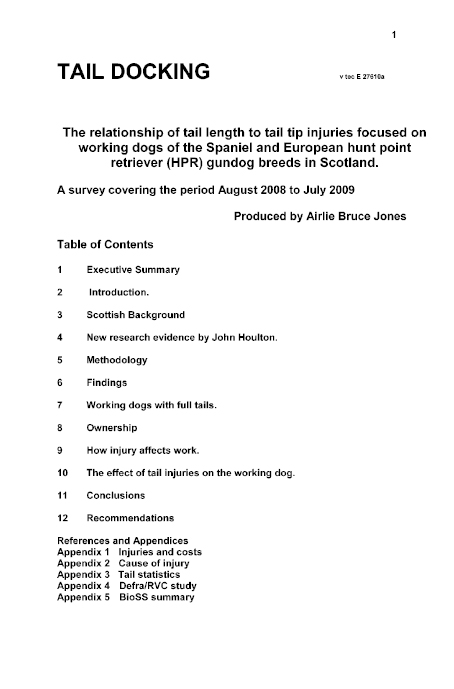
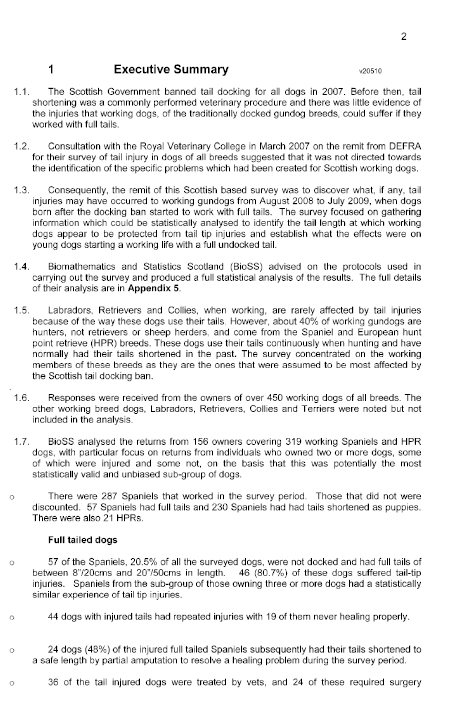
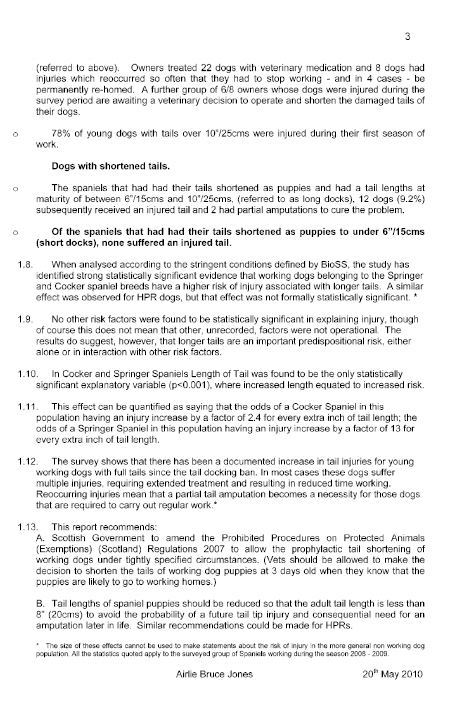
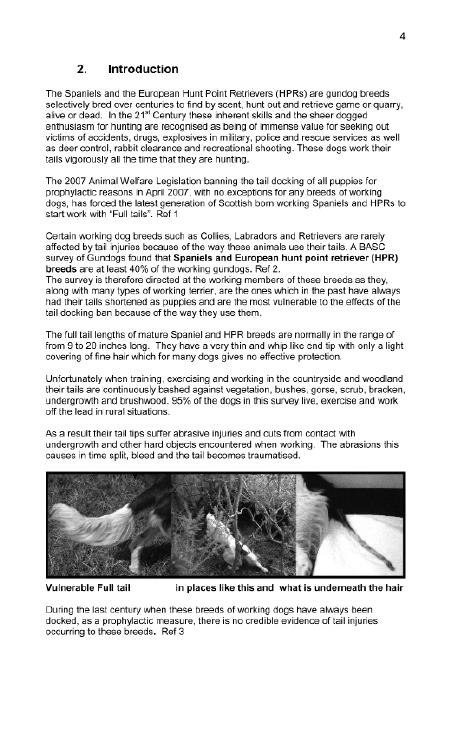
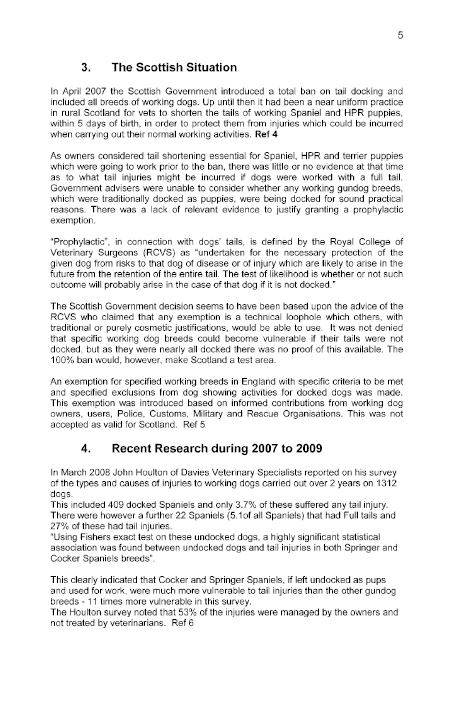
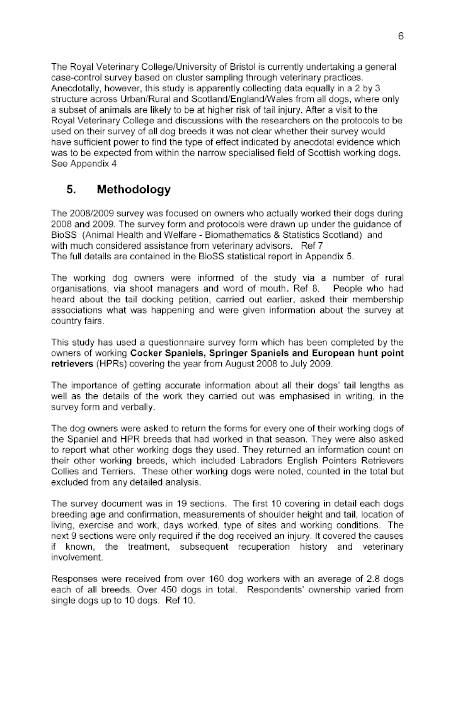
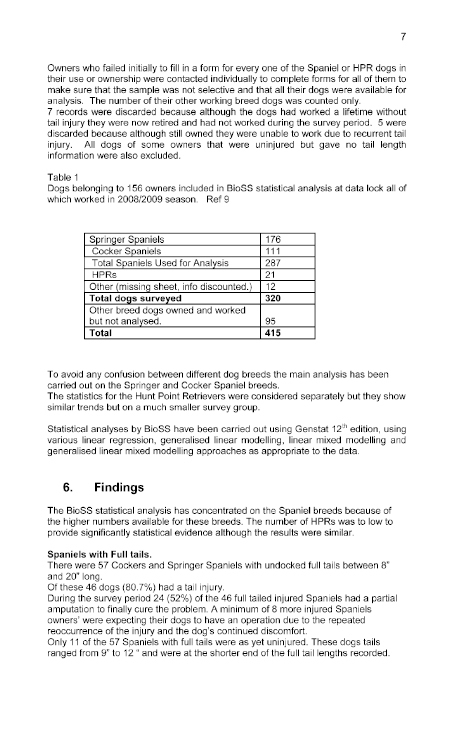
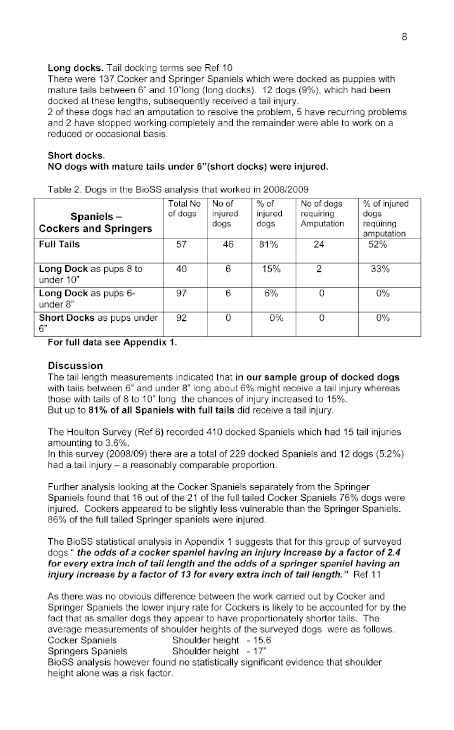
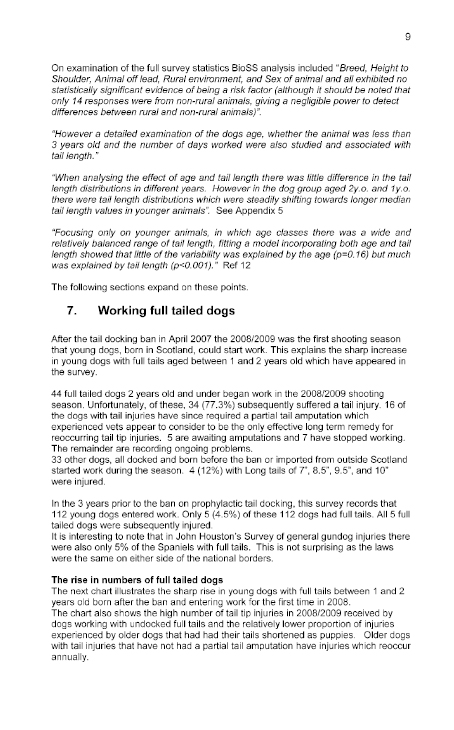
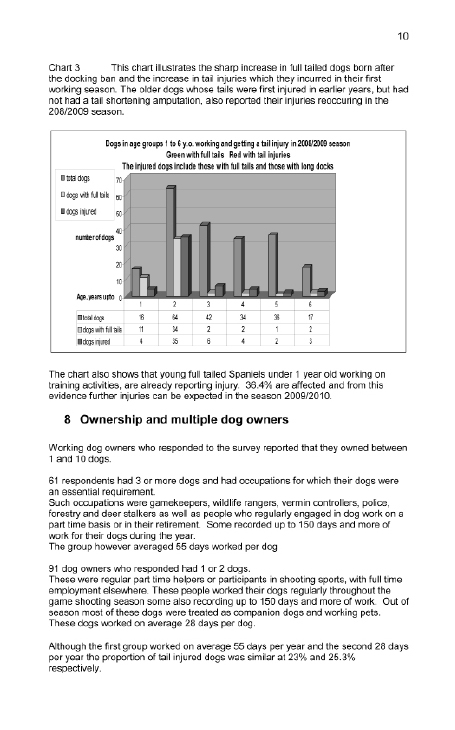
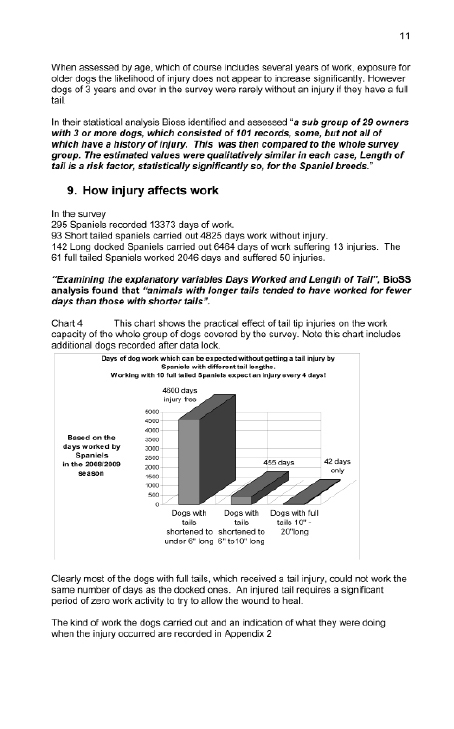
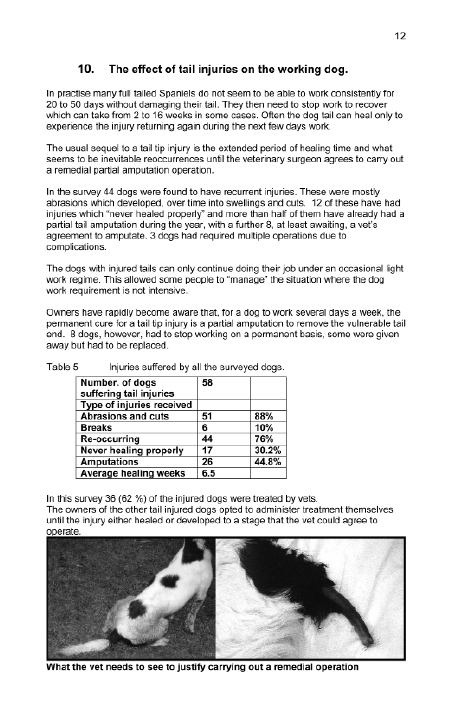
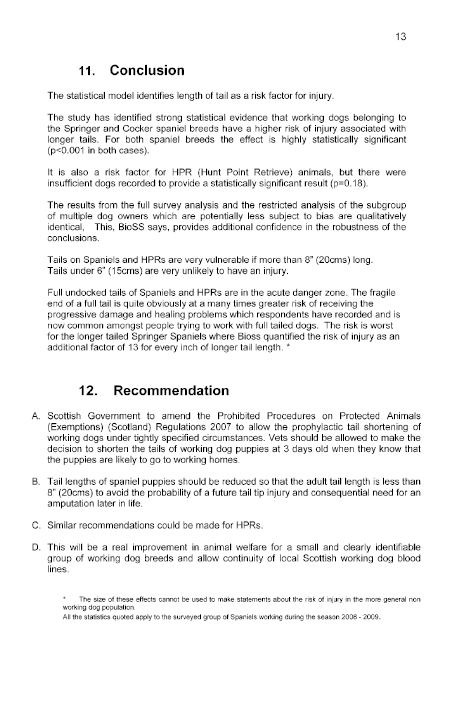
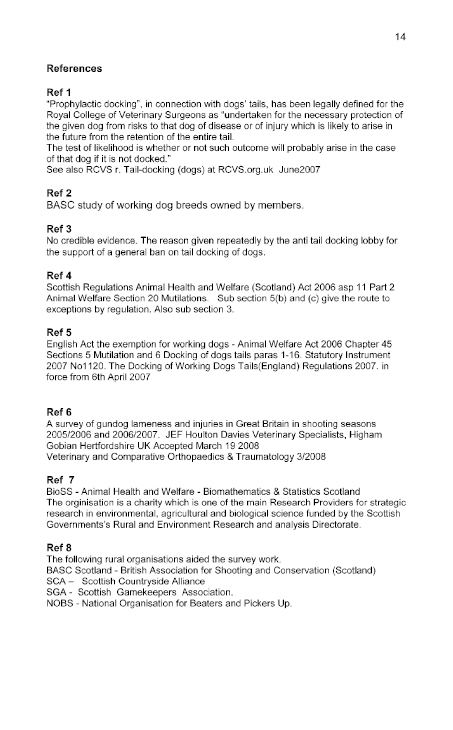
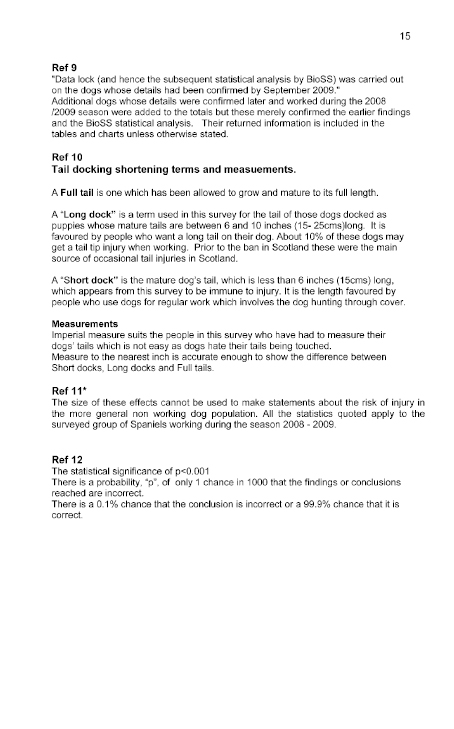
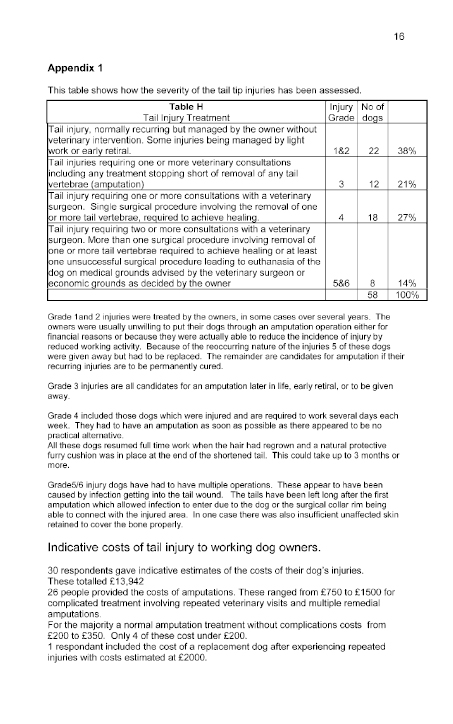
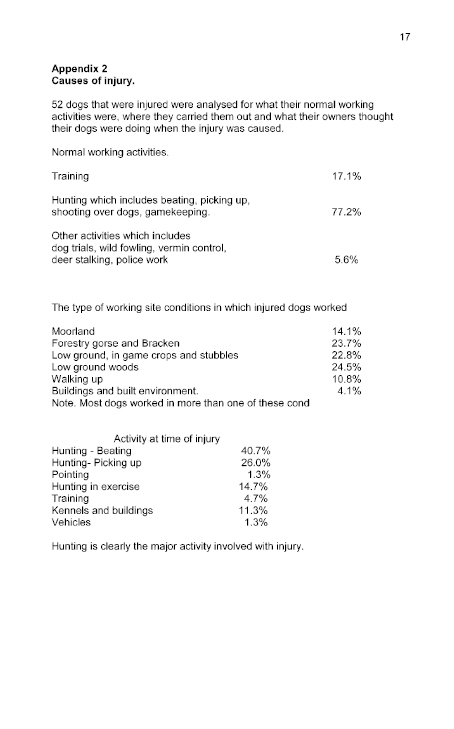
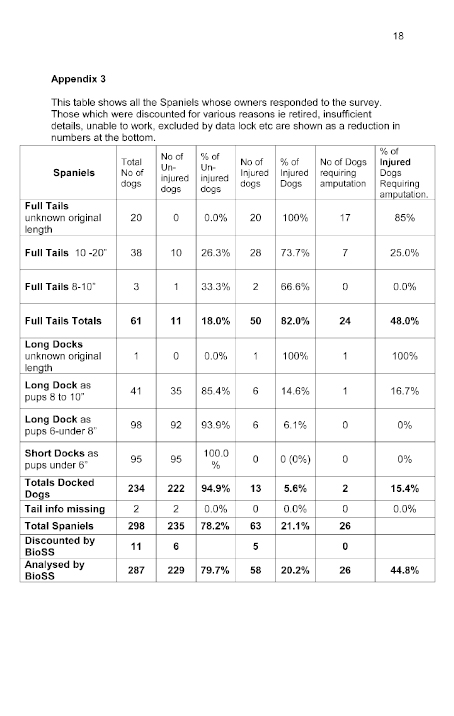
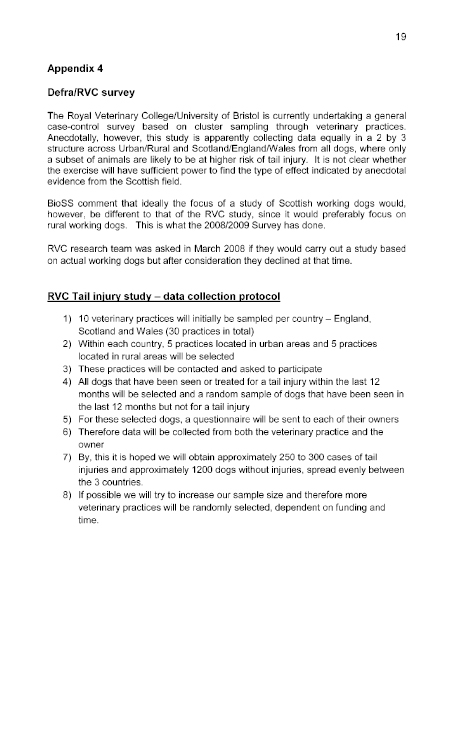
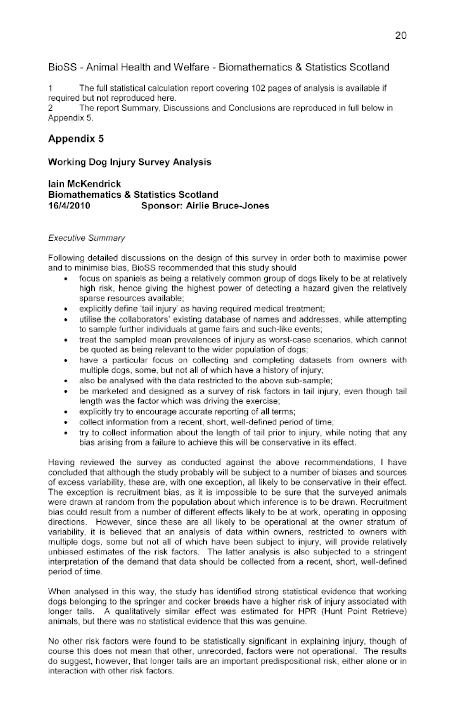
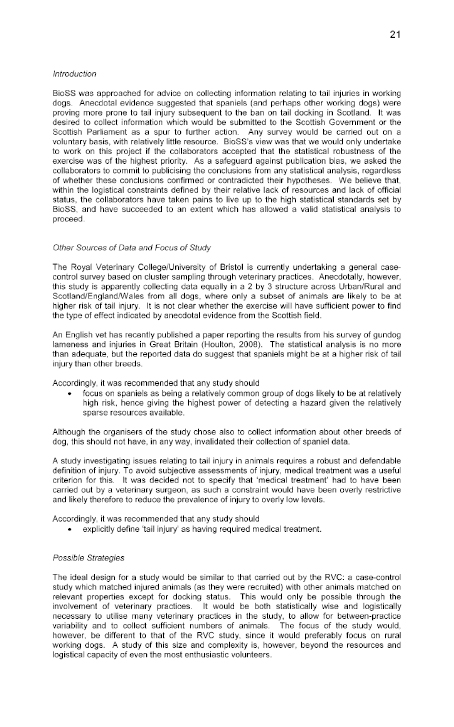

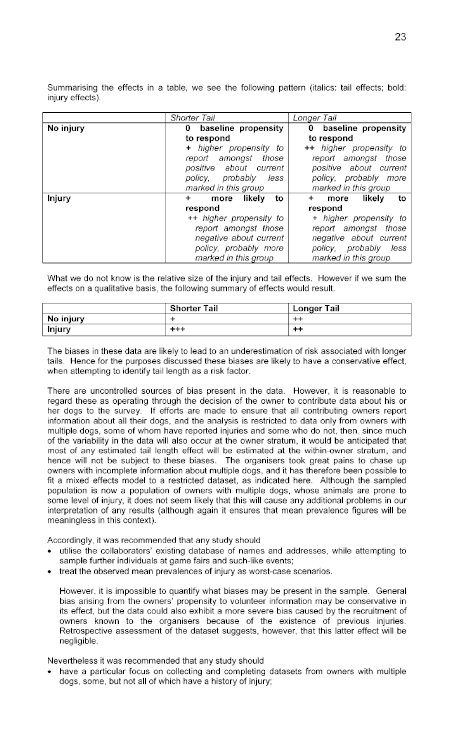
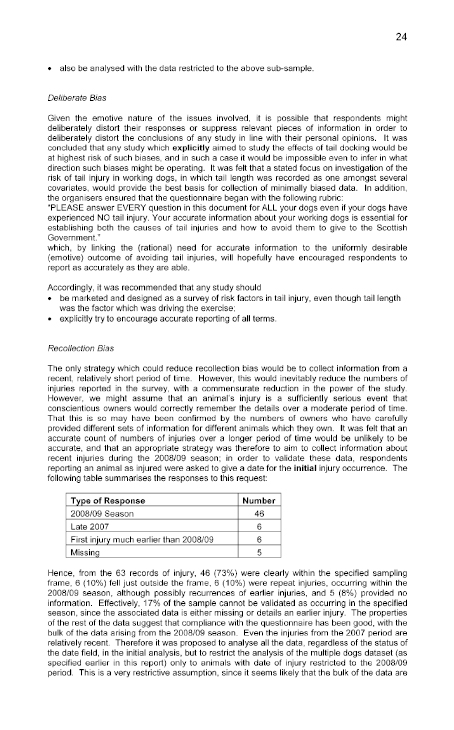
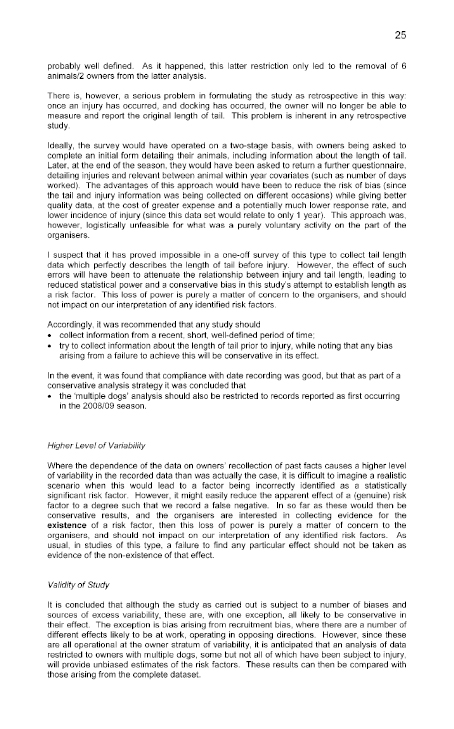
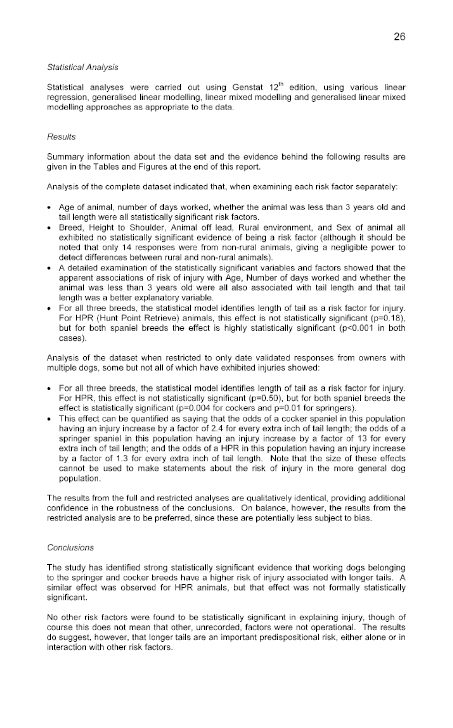
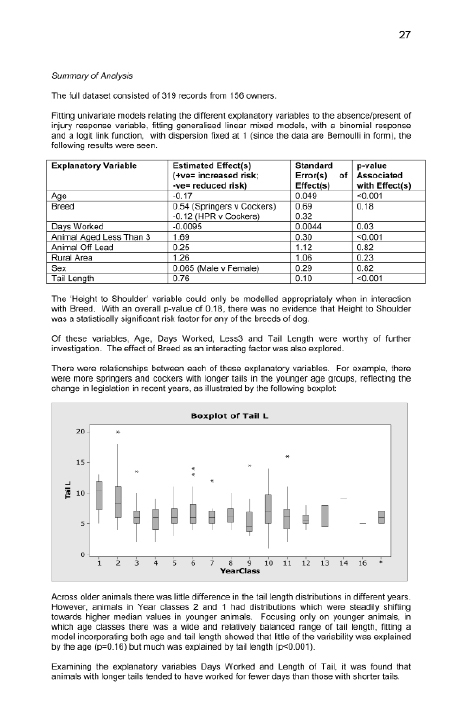
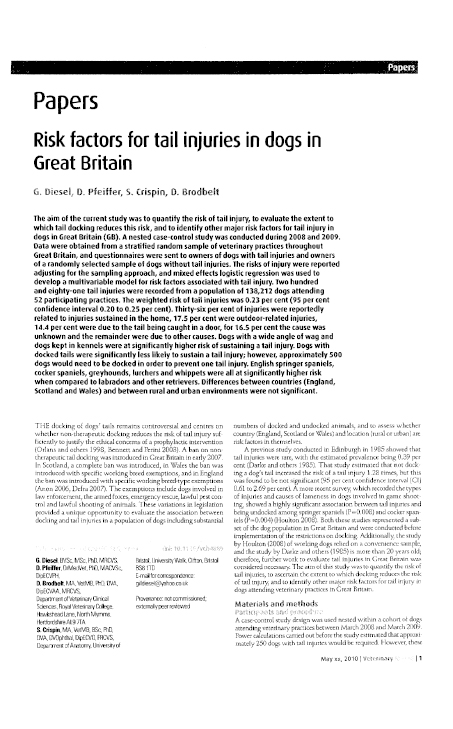
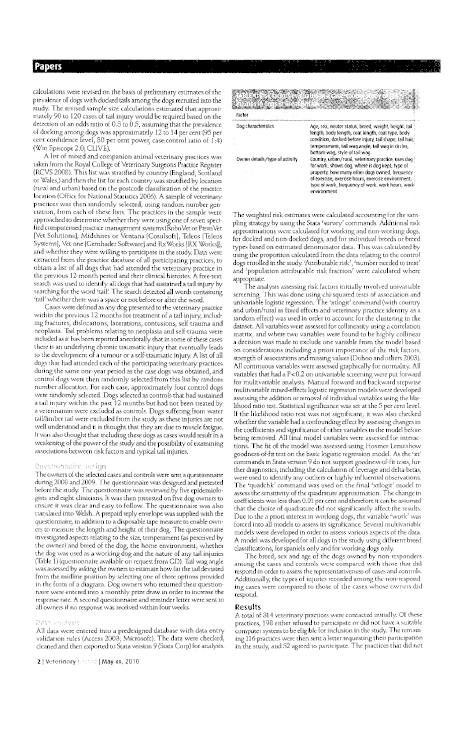
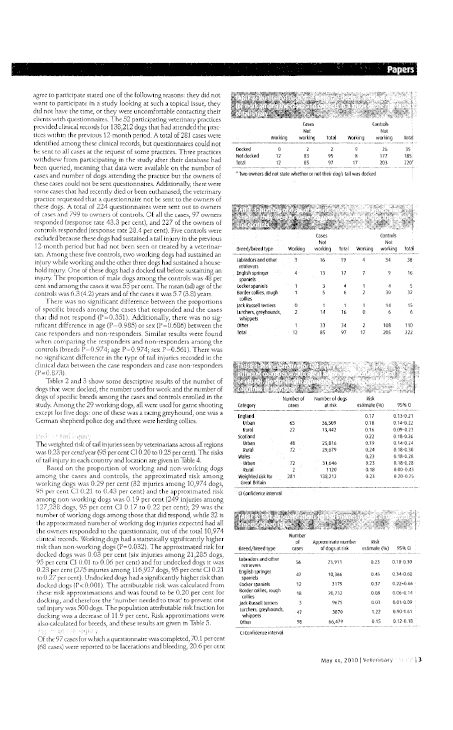
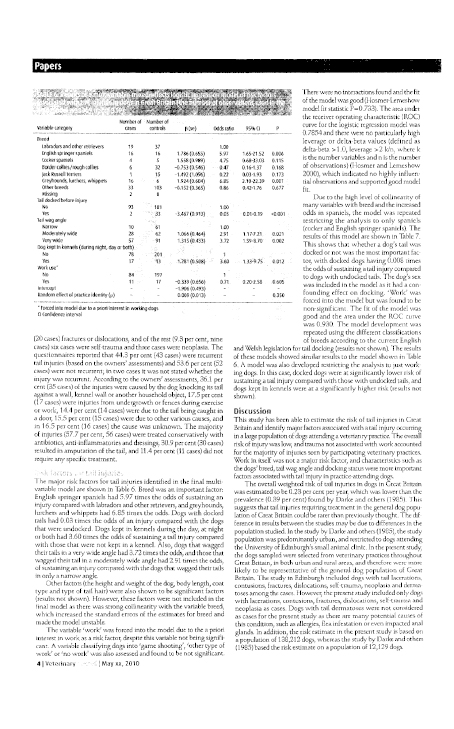
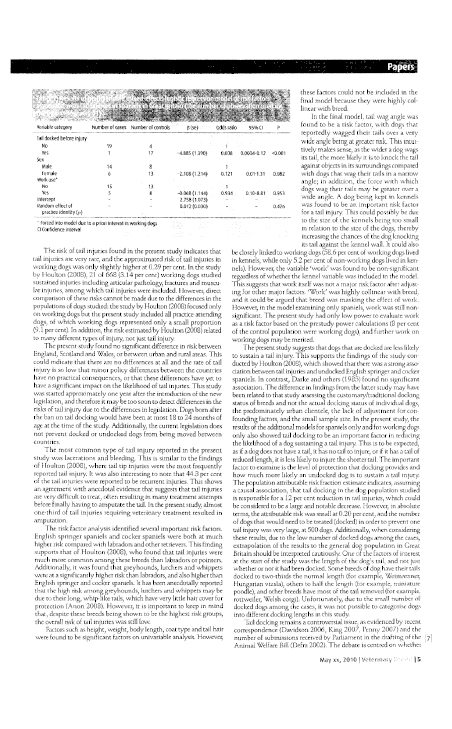
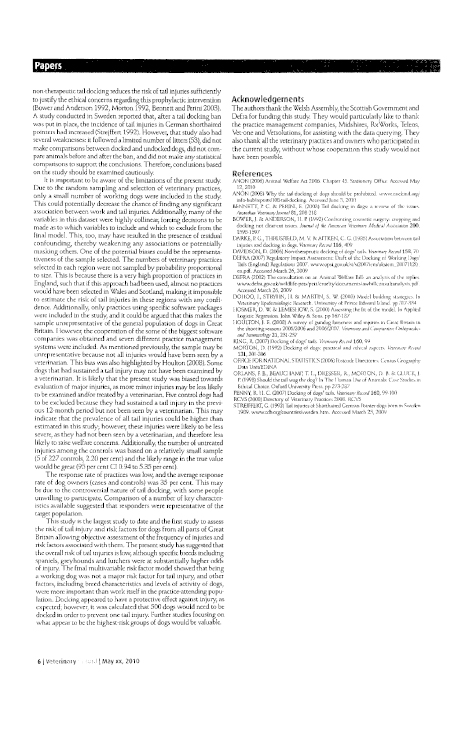
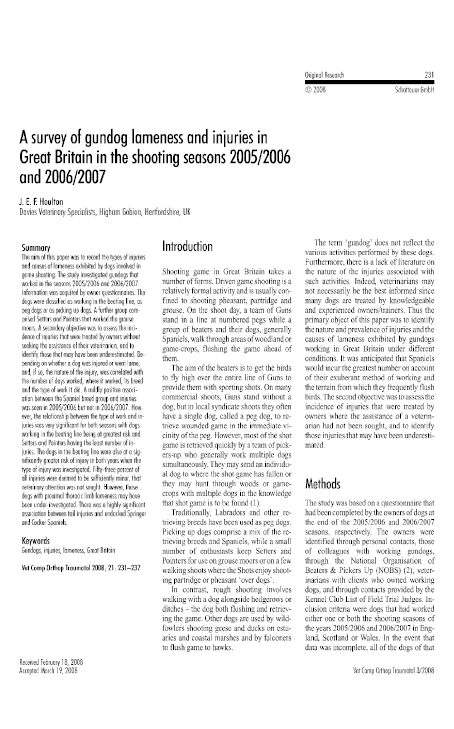
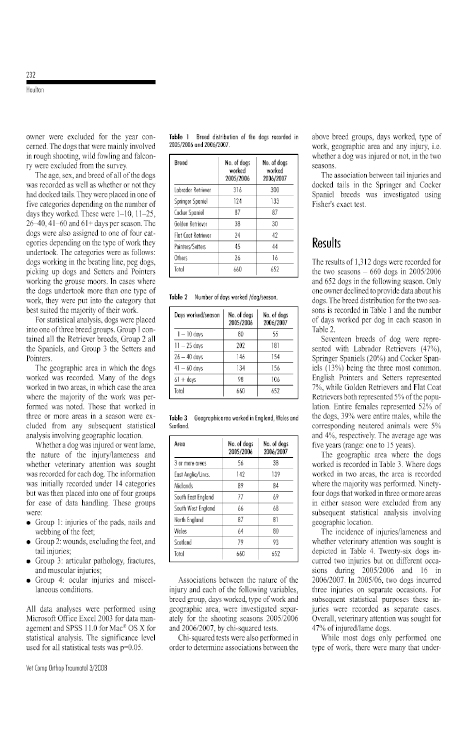
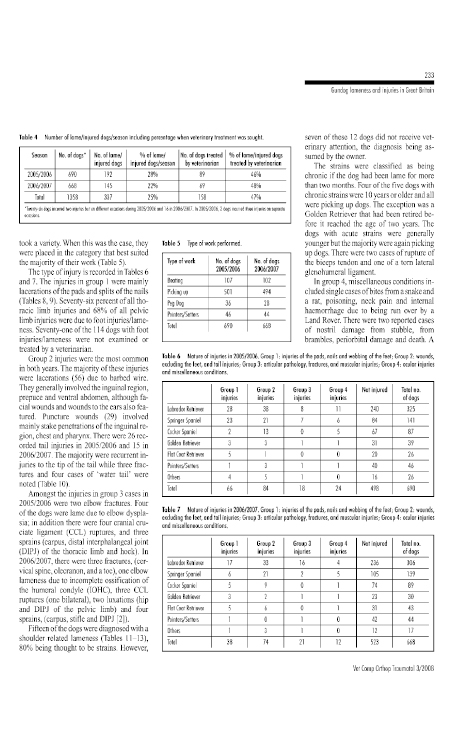
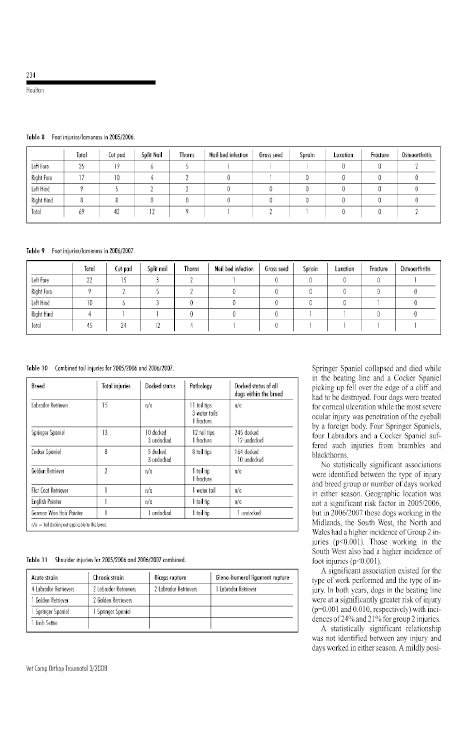
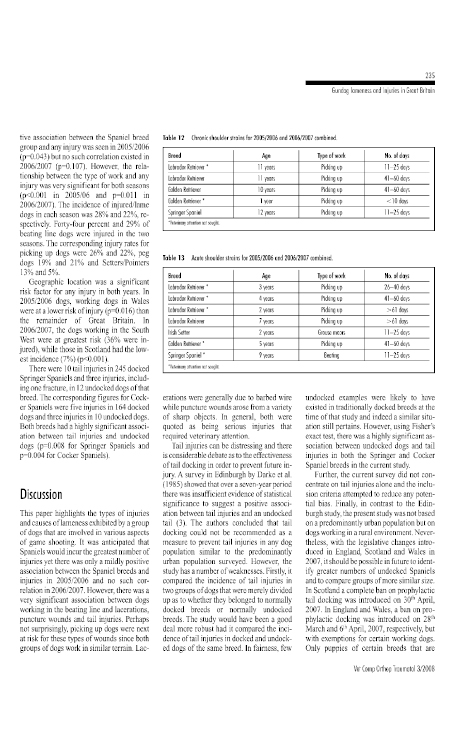
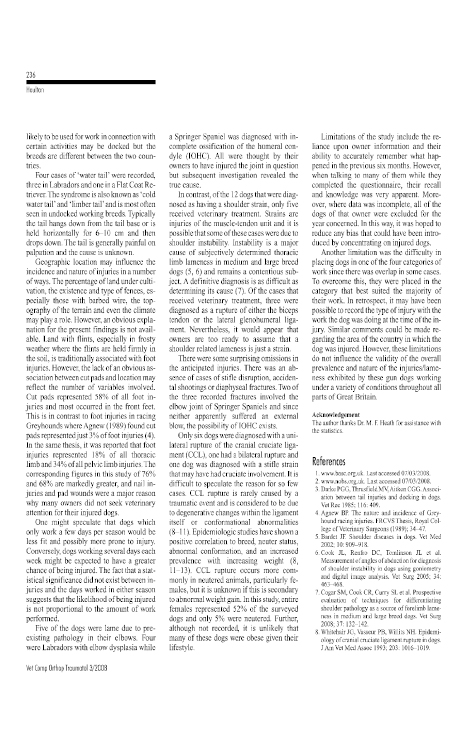
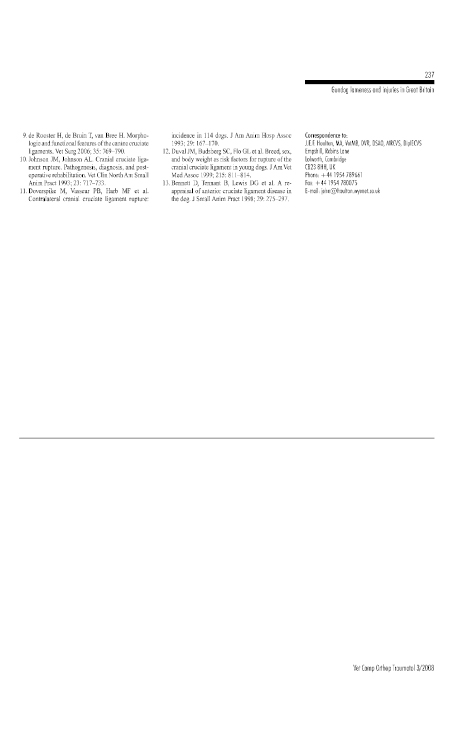
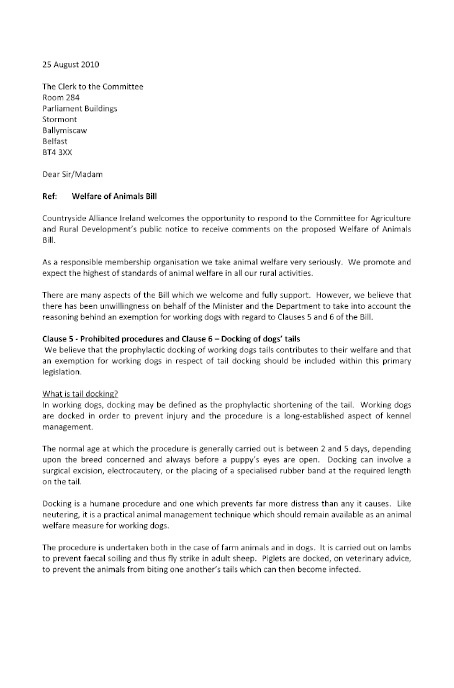
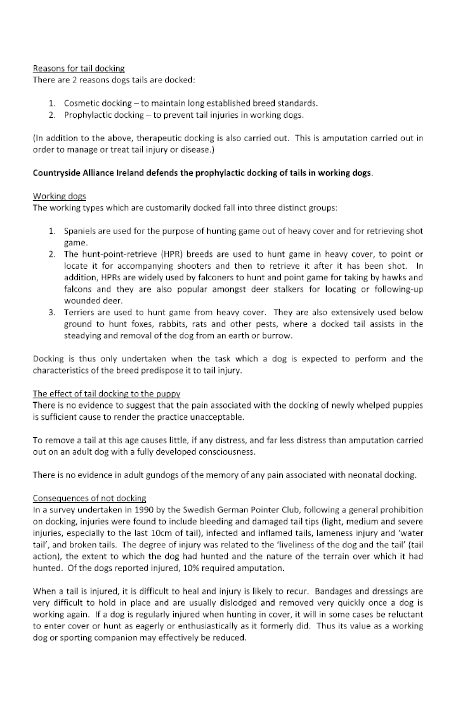
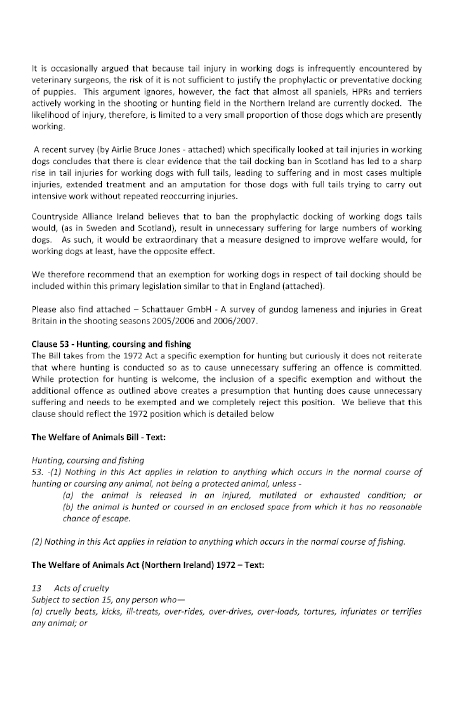
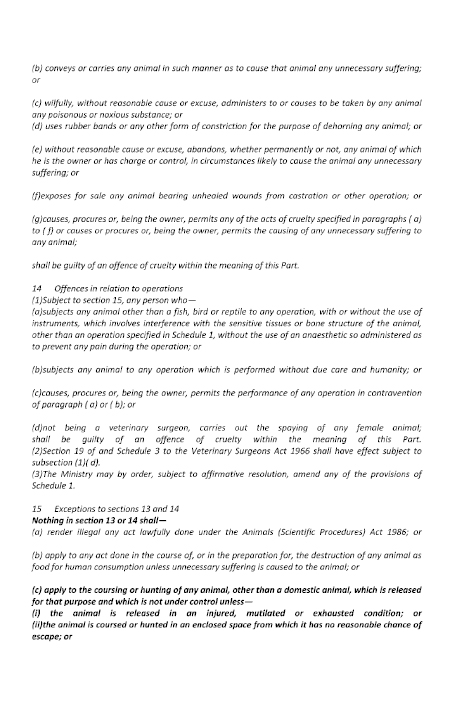
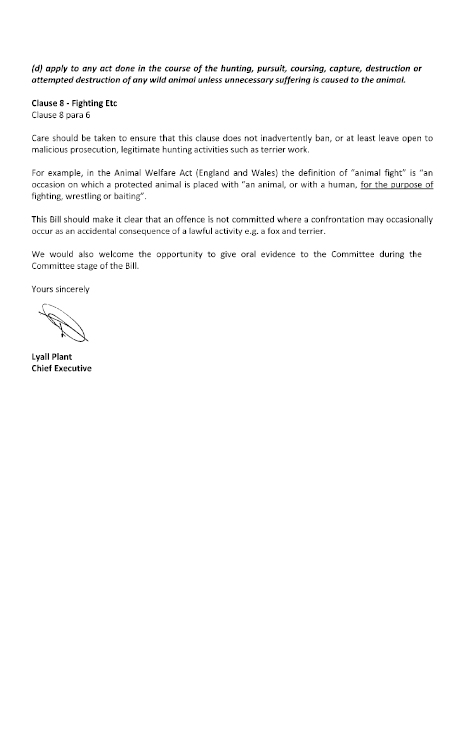
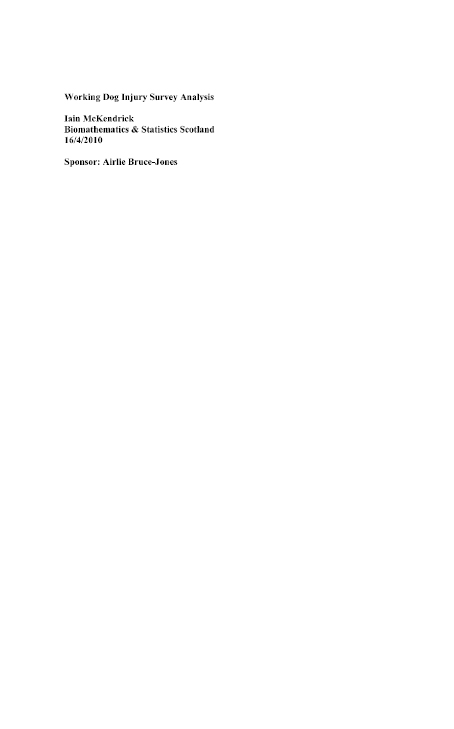
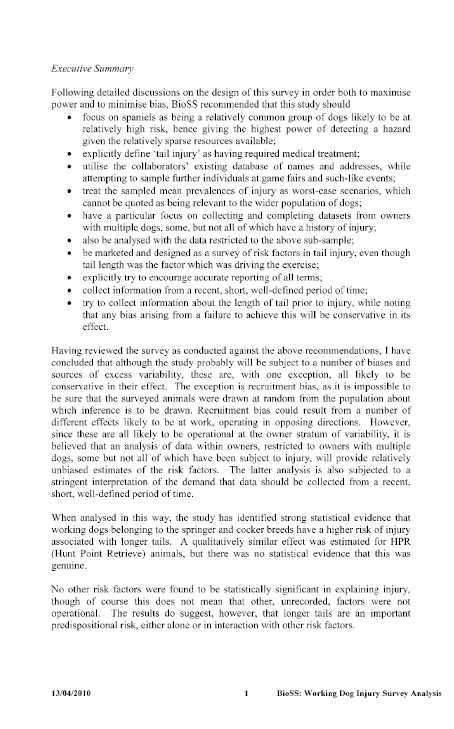
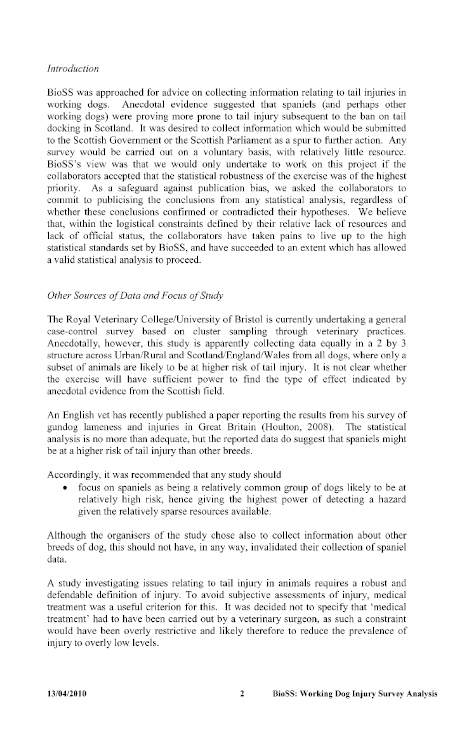
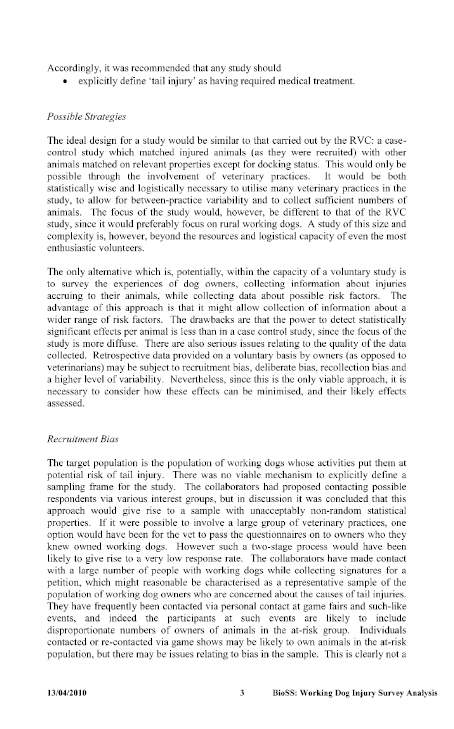
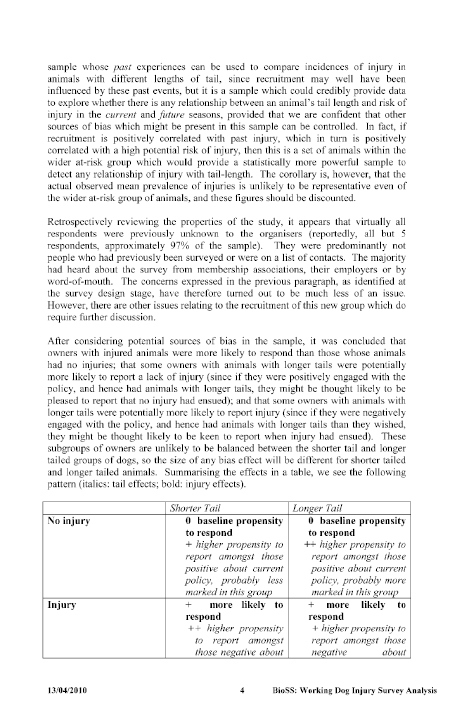
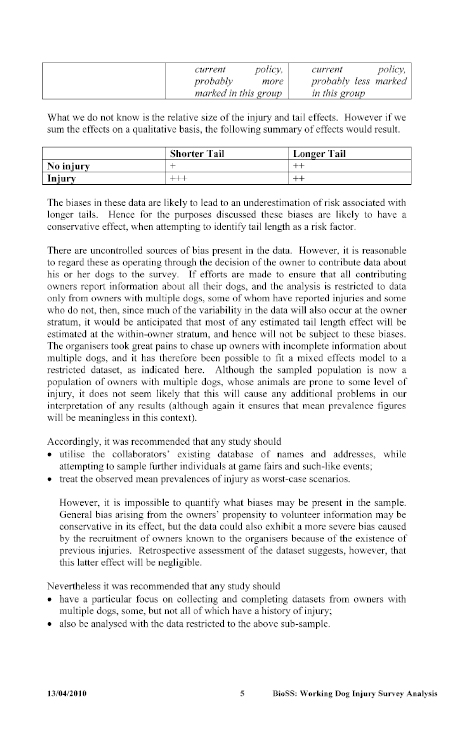
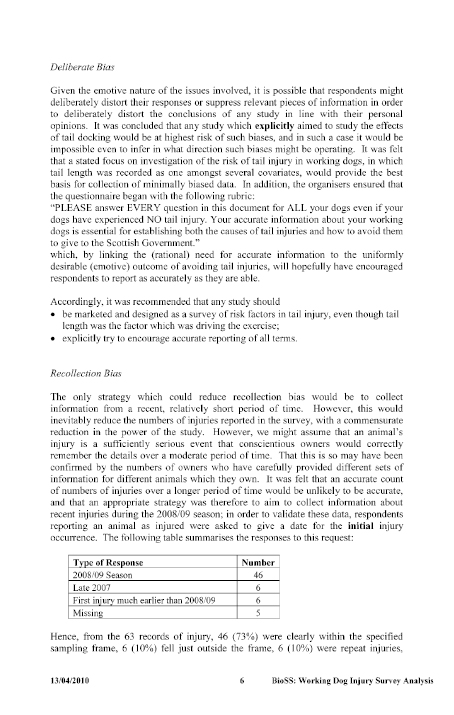
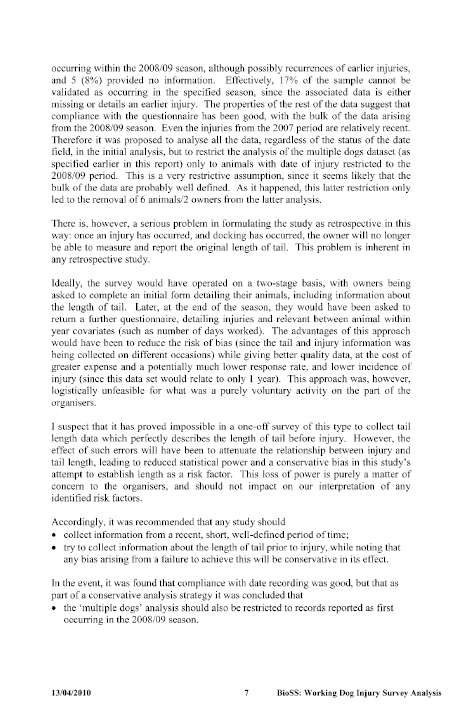
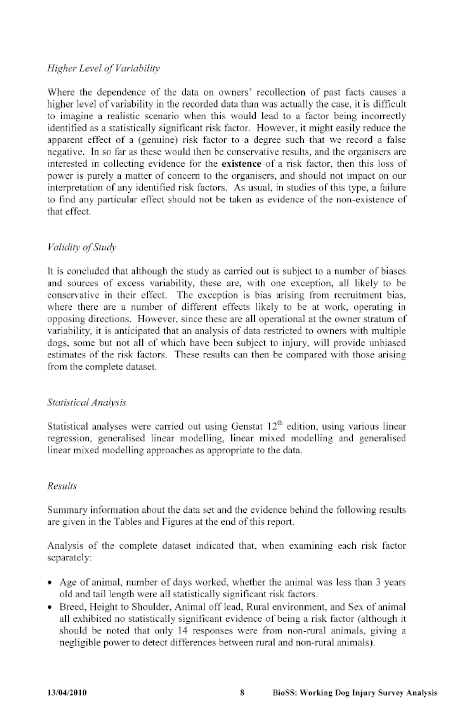
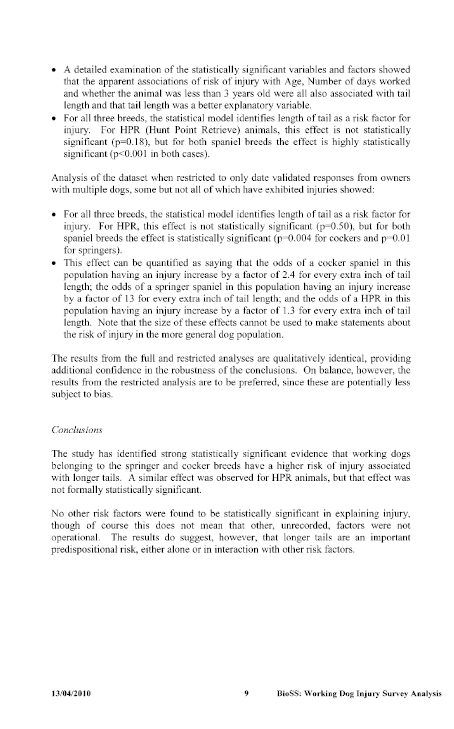
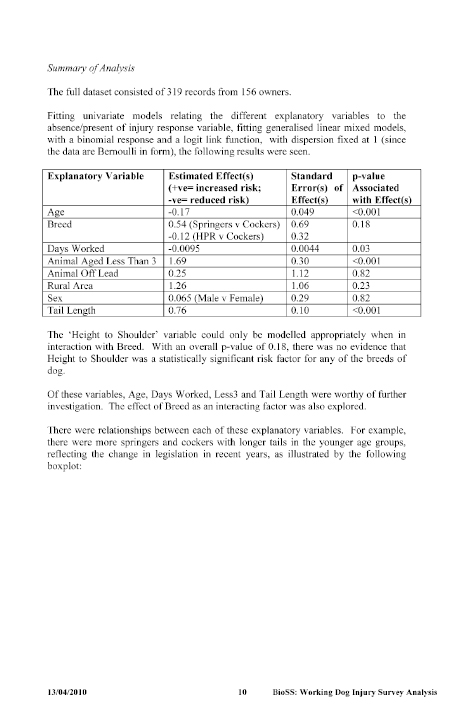
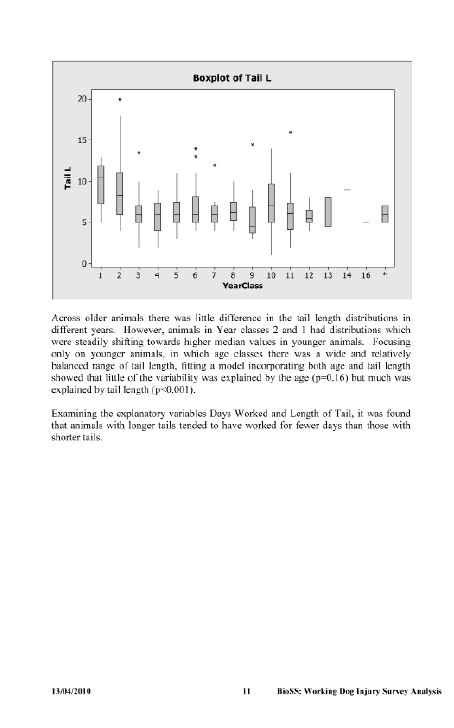
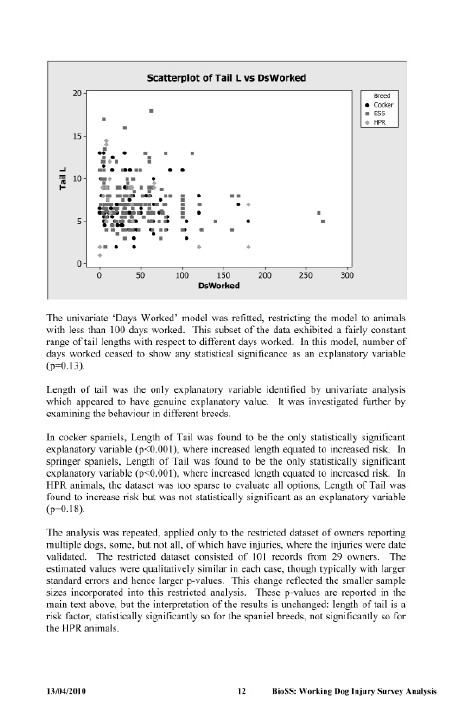
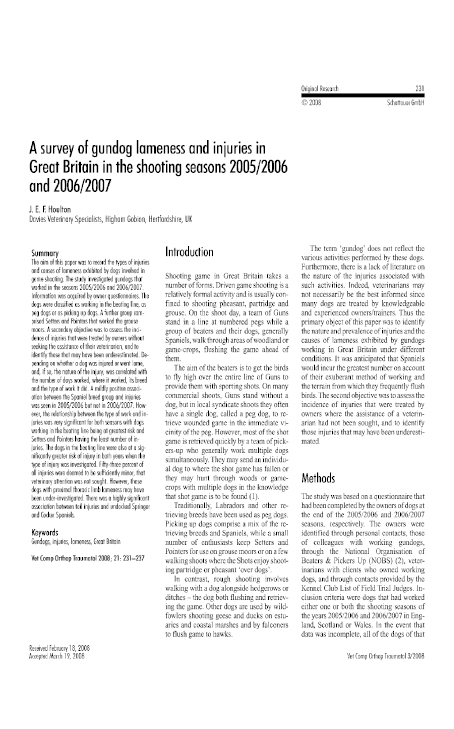
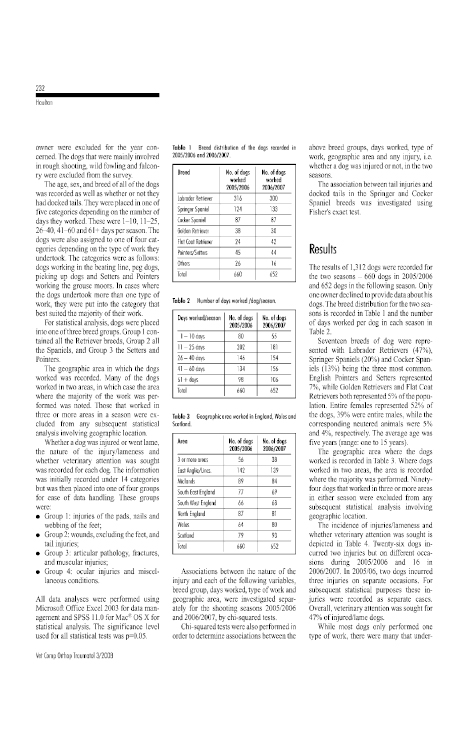
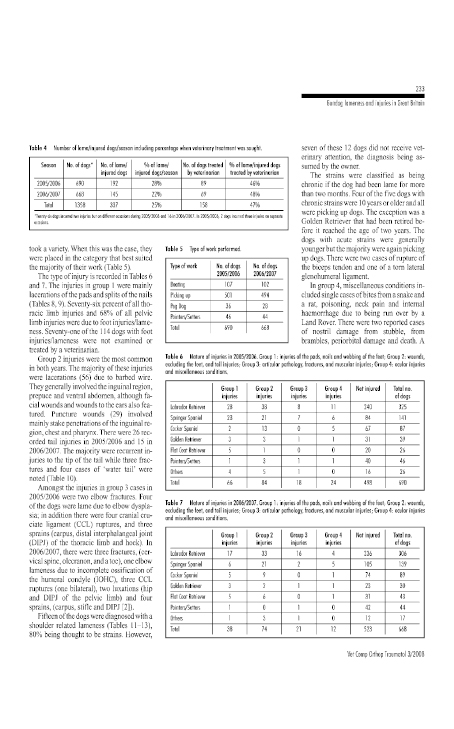
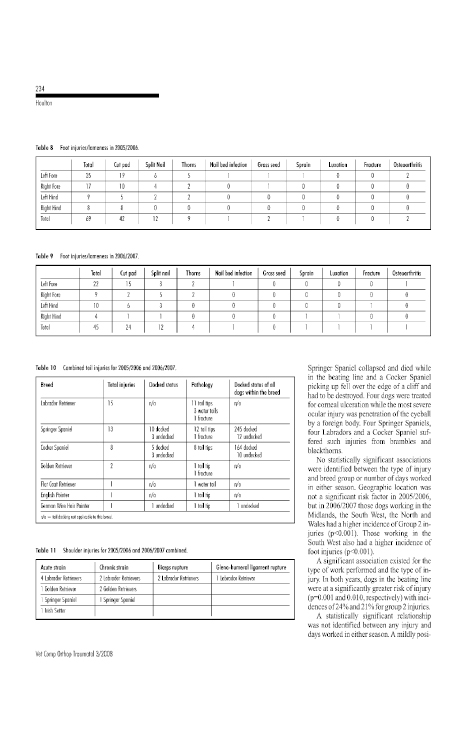
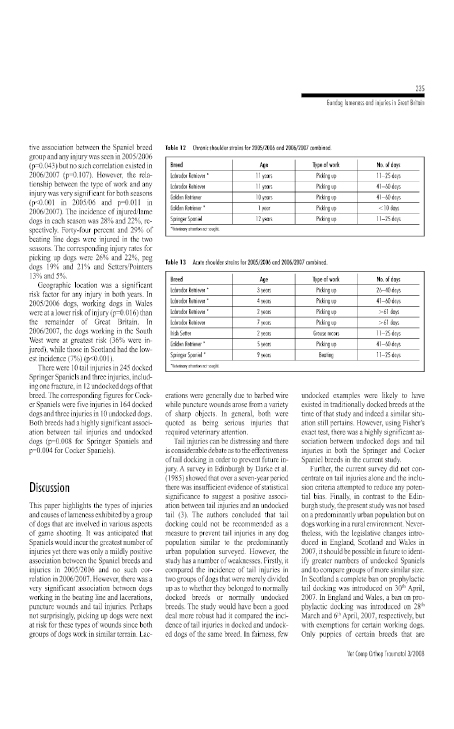
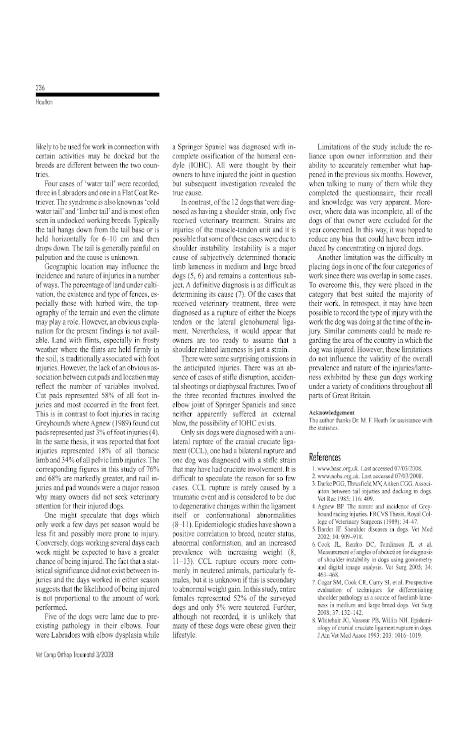
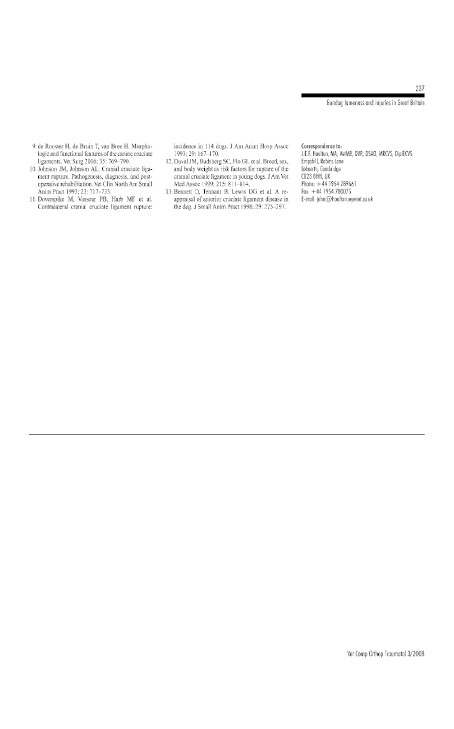
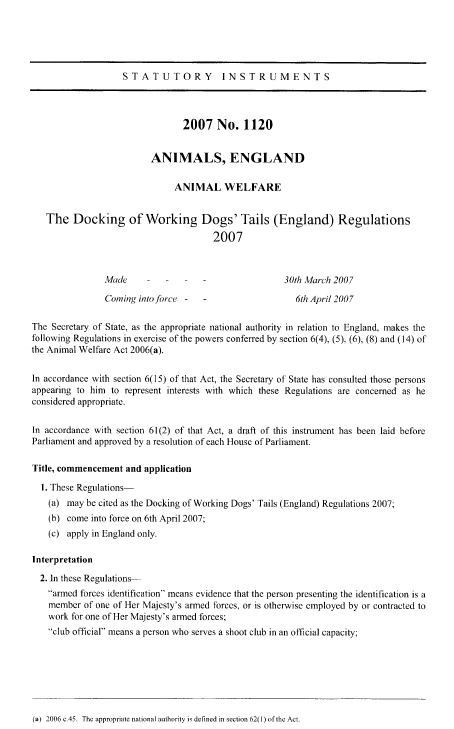
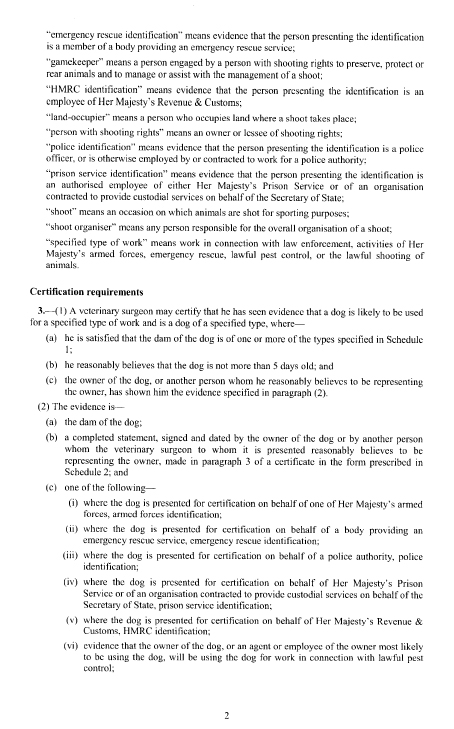
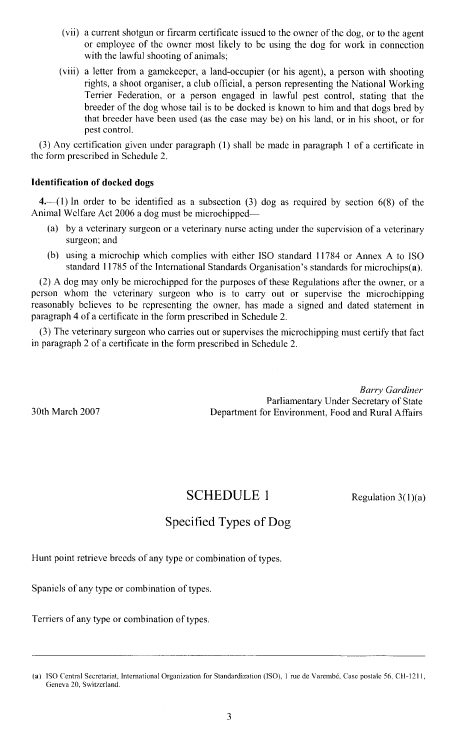
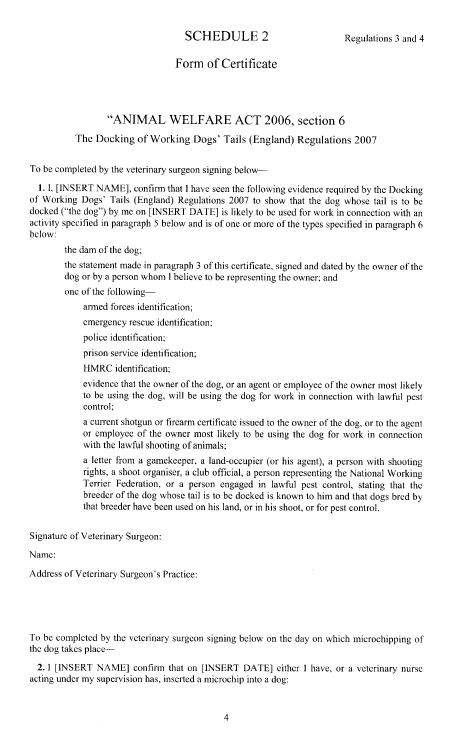
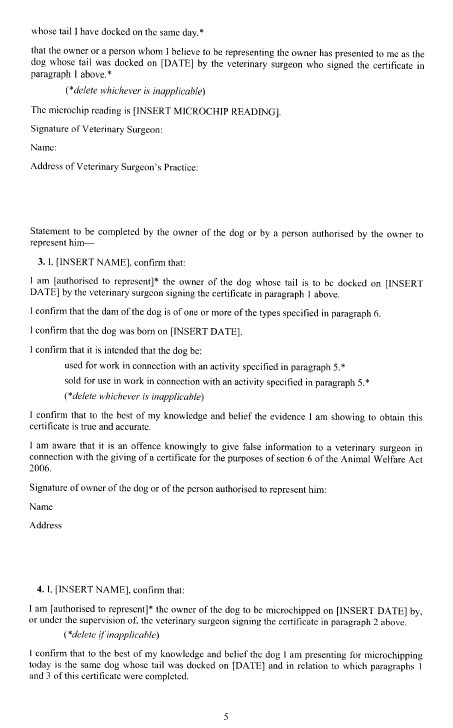
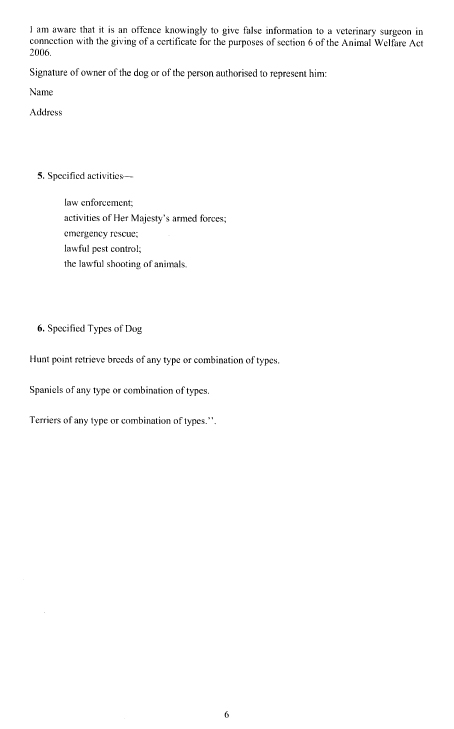
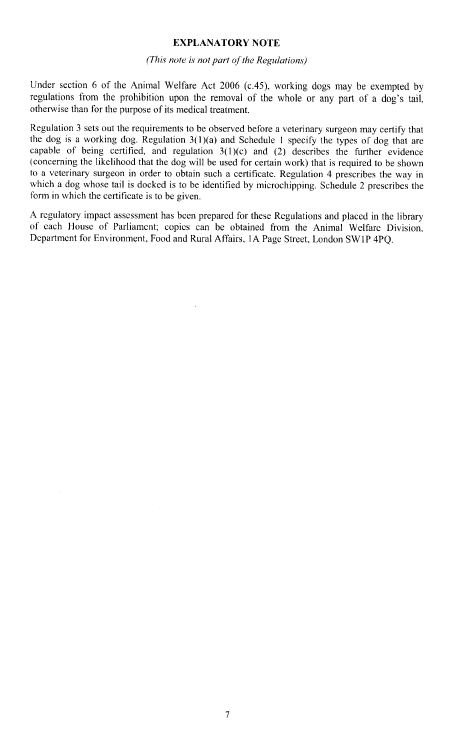
The Kennel Club, 1-5 Clarges Street, Piccadilly, London W1J 8AB, tel: 020 7518 1020, email Emily.jeffrey@thekennelclub.org.uk
The Kennel Club is the UK's largest organisation dedicated to the health and welfare of dogs. Within its broad remit the Kennel Club aims to protect and promote in every way the general improvement of dogs.
The Kennel Club runs a large number of programmes and makes investments through its Charitable Trust in education and health initiatives, to help dog owners across the UK to have healthy happy dogs, living long lives with responsible owners.
With a wealth of knowledge and experience of breeding, caring for and working with dogs gained over more than 130 years the Kennel Club has in recent years lobbied for improvements in welfare standards and legislation.
The Kennel Club is disappointed to see the inclusion of a prohibition on tail docking in the Bill.
The Kennel Club believes the docking of a dog's tail should be a decision for the individual breeder or owner based on his or her own intimate knowledge of the breed and the risk to the dog of not amputating the tail. There is a significant body of evidence supporting the Kennel Club's view that docking is frequently necessary in order to protect a dog's welfare, for instance a study conducted by Darke et al. found that not docking a dog's tail increased the risk of injury by 1.28 times. Whilst the Kennel Club would like to see this provision removed from the Bill, if this is not possible it would favour an exemption for working dogs who are particularly vulnerable.
Prohibition of tail docking can, in itself, have serious welfare consequences, as has been shown in Sweden where a ban resulted in a significant rise in tail injuries, affecting 51% of German Shorthaired Pointers. Research by Diesel et al. (2010) found that undocked working breeds have a 0.29% risk of injury, far greater than docked dogs whose risk is just 0.03%. Even if kept in kennels working dogs were found to have a far higher risk of tail injury. It is important to note, however, that 36% of tail injuries occur in the home.
A substantive amount of evidence exists to suggest that tail amputation in adult dogs can cause a significant degree of pain and further medical complications. Furthermore studies suggest that dogs' neuro-physiological pain mechanisms do not function in approximately the first 11 days of life, meaning a young puppy is likely to be far less sensitive to pain. This makes it highly desirable to dock early on in the dog's life in order to maximise the welfare benefit, avoid causing pain at the time of docking and avoid pain and injury later in life.
The Kennel Club also opposes the creation of an offence for entering a dog docked to a show at which the public pay an entrance fee as this would unfairly penalise owners whose dogs' tails have been amputated for sound medical reasons. Furthermore it would create a disincentive to carry out an amputation on medical grounds as this would prevent the owner's ability to participate in showing, a perfectly legitimate leisure activity for many dog owners, thus being entirely counterproductive as this may further risk the dog's welfare.
The Kennel Club is disappointed that the Bill fails to abolish the practice of selling puppies and dogs in pet shops. Puppies are often removed from their mothers before being fully developed and transported to pet shops. The journey and the alien environment at which puppies arrive is stressful for them and as a result puppies can develop physical and psychological problems. Furthermore there are often no checks on the welfare standards of the breeder supplying the puppy and there is no means for the puppy-buying public to ensure the puppy and/or its mother have been well cared for. The lack of continuity in this process is advantageous for unscrupulous breeders who can easily cover up bad practices.
The Kennel Club would also like to see the widening of this section to include a clause banning the sale and advertising of dogs over the internet in order to help tackle puppy farming. Currently pet vending over the internet is unlicensed, leading to a constant stream of internet puppy selling scams that the Kennel Club, as a member of the Pet Advertising Advisory Group, is especially concerned about. Unscrupulous breeders sell puppies online with little regard for the welfare of the puppy for as big a profit as possible. The lack of traceability which currently exists enables breeders to operate unchecked and makes it increasingly difficult for consumers to exercise their knowledge to find healthy puppies from reputable breeders.
The Kennel Club welcomes the announcement by the Minister to include powers which would enable the regulation of electric shock devices if desired under secondary legislation. However, it is disappointed that the Bill fails to prohibit the use of electric shock devices for a number of reasons.
Firstly, electric shock devices are ineffective since a shock device trains a dog to respond out of fear of further punishment, rather than a natural willingness to obey. According to Walker, R. et al. (1997) a dog's "stress response to electric shock collars actually impedes a dog's ability to learn". Thus it does not address underlying behavioural problems, leaving the cause of, for instance, barking or aggression suppressed and increasing the possibility of further behavioural problems in the future.
Secondly, electric shock devices are unnecessary given the wealth of alternatives available. There are many positive training tools and methods that can produce dogs that are trained just as (if not more) quickly and reliably, with absolutely no fear, pain, or potential damage to the relationship between dog and handler. Studies of these methods have shown that rewarding a dog for good behaviour produces a more "balanced and obedient dog" (Hiby, E. et al., 2004). With these alternatives available, there is no need for electric shock devices.
Further, scientific studies conclude that shock devices are a stressful and painful method of controlling a dog's behaviour (Schilder, M. et al., 2004) and cause chemical changes which contribute towards intense anxiety disorders, including posttraumatic stress disorder (Tsevtkov, E. et al., 2002).
Electric shock devices are also open to abuse and misuse. As shock devices are readily available by mail order, via retail outlets and on the Internet, they are easily accessible to people with limited experience to administer 'correctional treatment' or by an inferior trainer to abuse and punish.
Finally, the Welsh Assembly Government's decision to ban the use of electric shock devices on 23rd March 2010 sets a precedent for other governments and assemblies who may wish to introduce an outright ban. The ban was the first secondary regulation to be introduced in Wales under the Animal Welfare Act which differs from the one in place at Westminster. The Welsh Assembly took the decision based on existing scientific evidence proving overwhelmingly that these devices are cruel.
While the Kennel Club has welcomed the introduction of animal welfare inspectors, it recommends the Bill should go further to require inspectors to meet the following criteria so as not to destroy trust in the inspection regime:
Experience - Having inexperienced or unqualified inspectors would undermine the effectiveness of the Bill. Any 'person' or 'body' chosen as an authorised inspector should have to demonstrate competence and be trained to a set of common high standards to ensure that the provisions contained in the Act are upheld and carried out properly.
Qualifications - The Kennel Club would encourage the Assembly to introduce a national, minimum qualification which all animal welfare inspectors have to hold to be authorised to ensure that provisions in the Bill are upheld and carried out to the highest possible standard. At the very least inspectors should not have any conviction for animal cruelty or a record of having had an animal removed for protection. In the interests of consistency, the Kennel Club further recommends a set of standard inspection forms be introduced for animal welfare inspectors from all local authorities to use to record each inspection.
The Kennel Club is concerned that the Bill does not specify the appropriate categories of person or 'characteristics' of persons who may be appointed to the role. At present no specific qualifications are needed to become a dog warden. As all local authority staff are reappointed without proof of competence, the Bill does nothing to achieve higher inspection standards. The Kennel Club believes that at the very least inspectors should be required to have an NVQ in animal care.
Euthanasia - The Bill currently provides local authority inspectors with the power to destroy an animal in order to alleviate suffering in cases of emergency. It is implicit in the Bill that destruction of animals should be carried out in a humane manner, as this exempts from prosecution anyone who acts under section 4 (suffering of animals). The Kennel Club would, however, welcome an amendment to the wording of section 17 (powers in relation to animals in distress) to reflect that any destruction must be conducted in a humane manner, especially since the term 'destroy' can encapsulate anything from drowning, or shooting, to clubbing over the head and poisoning. A recent example which has given us much cause for concern is that of some German Shepherd Dogs killed by captive bolt gun in Pontardawe, South Wales in 2009, for which the RSPCA was publicly criticised on the grounds of inhumanity.
Finally we would like to take this opportunity to thank the Agriculture and Rural Development Committee for inviting comments on this Bill and look forward to working with you in improving animal welfare in the near future.
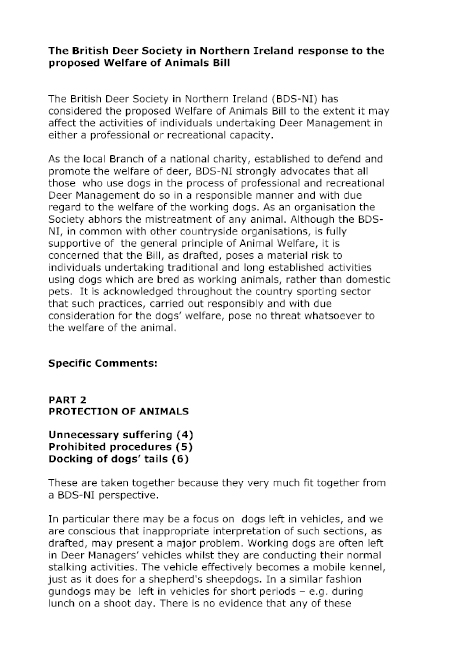
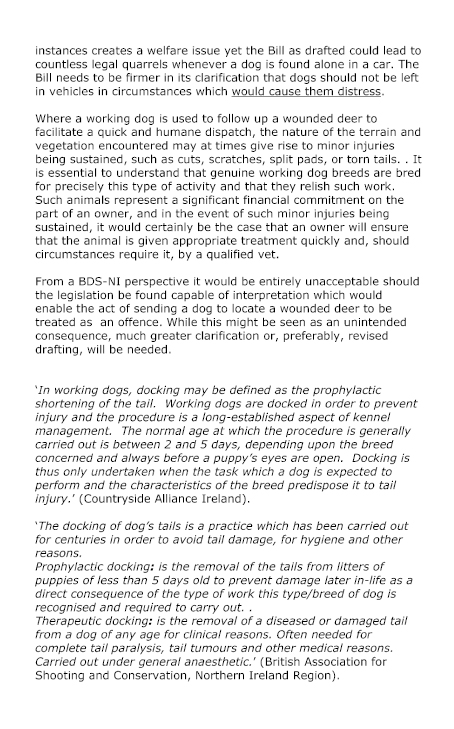
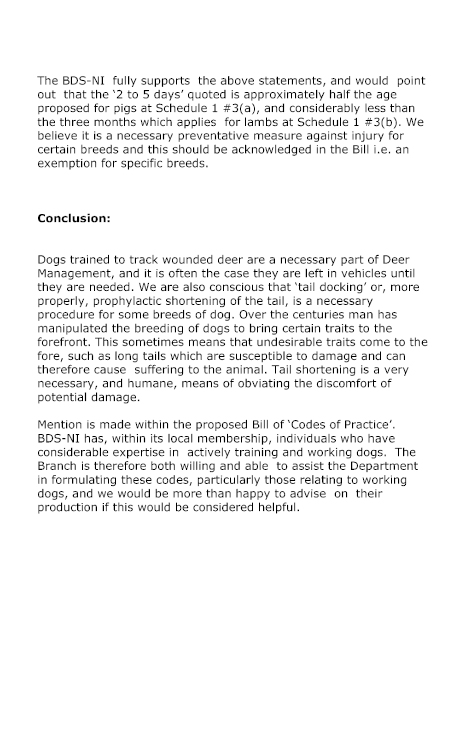
The CBI welcome the welfare of animals bill 2010 with open arms, it has been a long time coming, we are extremely grateful to both the Committee, The Minister, her team and senior personnel from her Department for their hard work and dedication in making this bill a reality.
As we have testified to both the Minister and the committee we are an industry in need of regulation and guidance, the misdeeds of a few must be dealt with firmly and stamped out so that the decent majority of animal owners might succeed and progress free from restriction or impediment.
On Balance we have this in the proposed Bill, As with any legislation there are words and phrases which may merit debate or further action, amendment etc, Listed below are some of these which we would bring to the Committee`s attention.
Commonly known as the "Five Freedoms" these are a basic requirement for any animal and are welcomed. We welcome this as a definition in law of "good practice".
It is excellent to see improvement notices enshrined in law, this would seem a very practical and sensible step.
The wording in this section is vague, We would presume that an Inspector under this Legislation would be a competent person, however a constable cannot be presumed to have a basic knowledge of animals and their welfare. Here he can remove an Animal without a Veterinary Surgeon yet the animal is not actually suffering. We all understand the need for strong legislative powers and that this section is entitled "animals in distress" but foremost in our minds are the recent abusive and misguided use of these same powers. We must have checks and balances in place so that both animals and their owners have basic protection under the law.
Again we have a Constable forcing his way into premises to rescue an animal who is "likely" to suffer, We would hope to have the burden of evidence in such cases directly linked to expert veterinary input which is held as expert witness in such matters. Were a Constable to seek assistance in such a matter he should be required to seek the help of a Qualified Veterinary surgeon and not "others" less qualified than himself.
It is vitally important that those committing serious offences against animals can be disqualified, and kept away from other roles with animals, This is progress.
Here we have a "veterinary surgeon" advising the court on the destruction of animals, This is the proper form and function for such a situation.
This is perhaps the most crucial area which will ultimately determine how successful this legislation is, The decision of whom to appoint as "inspector" is vitally important, The CBI can think of no others more qualified than the Department to appoint and oversee these persons.
The head of a Body Corporate shall be responsible for the welfare of animals under the law. This is excellent and badly needed legislation which eliminates the hiding places for those who flout the law and abuse animals.
It is important that the Committee understands that the word suffering used frequently throughout the legislation means "physical or mental suffering" how a Constable might identify mental suffering which was "likely" to happen is difficult to imagine.
It is confusing to see that under this bill a dog or puppy may not have his tail removed but a pig or lamb may and that a puppy may have its dew claws removed but not its tail. While the CBI do not attempt to defend tail docking as a cosmetic procedure we would be alarmed that this issue is being pushed through as a Welfare concern when it might be properly legislated for and controlled as in pigs or lambs to the benefit of that animals welfare.
This basically says an inspector or Constable can take ANYONE they wish onto premises, This would seem dangerous territory and we would be mindful of past examples where persons supposedly qualified in "animal welfare" accompanied constables and this lead to severe problems for animal welfare, officers were disciplined and animals suffered. We would hope this could be changed to encourage the involvement of qualified persons who would add weight to any investigations and backup officers and inspectors.
While these matters need consideration i would again reiterate our support for the legislation and what it hopes to achieve, We are grateful to the Committee for requesting our input and we would relish the opportunity to discuss these issues with individual committee members or collectively as we have done previously, The CBI represent the primary stakeholders in this legislation and our members have always seen these matters in a positive light. We would hope to assist the Committee by any means possible.
The CBI
The Clerk to the Agriculture and Environment Committee
Room 284
Parliament Buildings
Stormont
Belfast
BT4 3XX
By email to:- committee.agriculture@niassembly.gov.uk
26th August 2010
Dear Sir
We are grateful for the opportunity to comment on the Welfare of Animals Bill which is currently being considered by the Agriculture and Rural Development Committee of the Northern Ireland Assembly.
World Horse Welfare, is an equine charity, based in the UK and was founded in 1927. Our primary concern is with the welfare of all equines. In order to carry out our work, we have four farms in Great Britain where horses are rehabilitated prior to re-homing throughout the UK. We also have an active campaigning team working within the European Union to raise welfare standards and also which lobbies extensively against the long distance transport of horses for slaughter.
We are extremely pleased that the Northern Ireland Assembly is considering a Welfare of Animals Act which closely follows the Acts adopted elsewhere in the UK in 2006 and which have had such a positive effect on the welfare of animals, and equines in particular, since they introduce the 'duty of care' and other beneficial welfare concepts.
We do have some comments on the draft Bill that we hope the Agriculture Committee will be able to consider.
We are very pleased to note that there is a provision for Improvement Notices in clause 10 and that failure to comply with such a notice would be an offence. We take the view that failure to comply should be an offence and we trust that this element of the clause will not be deleted during Committee stage.
We are also pleased to note that there is a specific clause on abandonment- clause 14. We suggest that it would be beneficial if a requirement were to be included in clause 3(c) that veterinary attention has been sought, where necessary. This is one of the key elements that should be considered for an abandoned animal and, in particular, as to whether arrangements had been made for any injury or disease to be identified and treated.
Ownership of abandoned animals is another key issue that causes us concern. In the majority of cases ownership of such animals would be unknown and in the absence of an equine passport it would not be possible to re-home the animals in accordance with current European Union passport legislation. It would be beneficial if there were to be a provision in this clause to allow the courts to determine ownership as they can for animals dealt with under clause 19, where they have been taken into care or the owner is the subject of a disqualification order in the courts.
Clause 16 deals with Codes of Practice. We question as to why these Codes are not to be ratified by the Northern Ireland Assembly since this would give them additional authority should failure to meet their provisions be used in evidence in court.
A question has arisen with the Animal Welfare Act in England as to whether the reference in clause 18(1) only can refer to an individual animal or whether it could apply to a group of animals. You might care to have clarity on this point although we suspect that lawyers would argue that the reference to an animal would equally apply to more than one animal on the same premises.
Clause 32 on Deprivation is an extremely valuable provision that we have been re-considering in the context of the Animal Welfare Acts that are in place elsewhere in the UK. We take the view that failure by the courts to deprive persons of ownership of their animals where cruelty or suffering has been proved should be subject to appeal to a higher court. We have experience of situations where, inexplicably, such an order has not been made and we would like to see an appeal procedure introduced throughout the whole of the UK in order to safeguard the welfare of the animals to which any such court case refers.
In the same clause may we suggest that the provisions in clause 32(6) should be entered in the court records so that there can be no ambiguity as to the reasons for the decision taken by the court.
We are extremely concerned by the amount of time taken for the courts to deal with some cruelty and other cases using the Animal Welfare Acts in Great Britain since during that time the animals to which the charges relate cannot be re-homed unless an order has been made by the courts. It is difficult to see how this process can be accelerated since the powers may only be used where a person has been convicted of an offence. The situation is made worse by the fact that, for instance, section 33 in the Animal Welfare Act 2006 can only apply to the animals to which the offence relates. In order to ensure that other animals on these premises are provided with the level of care that they deserve we suggest that clause 32 in the Welfare of Animals Bill should also cover other animals in the same ownership and where it can be demonstrated that the duty of care required under clause 9 was not being provided.
We hope you find these comments helpful. If you have any queries please do not hesitate to come back to us.
Yours faithfully
K C Meldrum, CB, BVM&S, MRCVS, DVSM, Hon FRSPH
Veterinary Consultant
World Horse Welfare
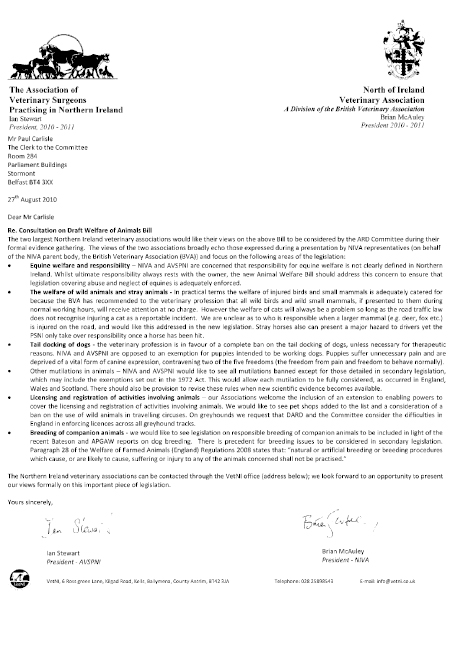
As the UK's largest dog welfare organisation we welcome the introduction of the Welfare of Animals Bill and we are grateful for the opportunity to submit comments.
Dogs Trust is the UK's leading dog welfare charity. Every year we invest substantial resources in addressing the stray dog problem through microchipping, neutering and our education services. We care for over 16,000 stray or abandoned dogs every year through our network of 18 Rehoming Centres, including our Ballymena Centre. In Northern Ireland we have neutered over 67,000 dogs; microchipped nearly 32,000, and in 2009 alone we ran 256 educational workshops, reaching out to nearly 8000 school children. The happiness of every dog is at the heart of everything we do and we never put a healthy dog down.
We welcomed the introduction of the Animal Welfare Act 2006 in England and Wales, and the Animal Health and Welfare (Scotland) Act 2006, and we are pleased that similar measures are being considered in Northern Ireland. We sincerely hope that legislative activity in the Republic of Ireland can be harmonized and that measures to protect the welfare of animals will come into force in both Northern Ireland and the Republic in the near future.
The introduction of a Welfare of Animals Act in Northern Ireland will bring forward a key opportunity to make regulations which strengthen individual aspects of animal welfare, and we hope that clear plans for a series of regulations will be made available shortly and that such regulations will be enacted. In England, regulations on Greyhound welfare, pet vending, dog breeding and others were planned, however, with the exception of the regulations on the welfare of racing Greyhounds, they have not materialised. This is a shame and we hope that Northern Ireland will take this opportunity to go further than the Act itself in advancing an animal welfare agenda. We would like to see further information on the welfare needs of animals being made available to the public through Codes of Practice. A Code of Practice on the welfare of dogs for instance, would contain practical guidance to help people comply with Section 9 of the proposed Act.
We consider that for any legislation to be effective it needs be properly resourced and enforced. Ideally we would like to see a requirement for each Local Authority to appoint an Animal Welfare officer with the appropriate level of training and expertise. In the present financial climate, and considering the budget pressures currently facing Local Authorities in Northern Ireland and across the UK, we do have concerns that securing the necessary funding to support the enforcement of the Act, and the prosecution of offenders, could prove problematic.
With regards to specific aspects of the Welfare of Animals Bill we consider it to be essential that any legislation to uphold the principles of animal welfare includes a duty of care to prevent unnecessary suffering, and we welcome the inclusion of such a duty in the proposed Bill. We also fully support the inclusion of a ban on the docking of tails. The procedure of docking a dog's tail has aroused much controversy and emotion over many years. There is a significant body of peer reviewed scientific evidence in support of banning the practice, as has happened in England, Wales and Scotland. There are three reasons to oppose docking: the pain caused by the process; the removal of an appendage used by the dog for communication; and the potential for long term side effects. We consider that the scientific evidence supports a total ban on docking except for therapeutic reasons following injury or disease. We would be happy to elaborate further on this issue if it would be helpful.
Whilst we support a ban on tail docking we would also like to see the inclusion of a ban on the use of electric shock devices. Dogs Trust has long considered the use of shock devices for training and discipline purposes to be cruel and unnecessary. Aversive training techniques, which include electric shock devices, undoubtedly cause pain for dogs. Research has shown that the application of shocks has also been found to elicit behavioural responses associated with fear and distress. The use of such techniques is highly likely to compromise the welfare of dogs and may in fact create or worsen behavioural problems.
We do not accept that the deliberate use of aversive stimuli is appropriate when it is generally accepted by vets and behaviourists that the use of aversive training techniques is less effective than training using reward. Such methods are proven to be highly successful in modifying unwanted behaviour, including aggression, without subjecting dogs to cruelty. We call on the Northern Irish government to consider amending the Welfare of Animals Bill to include a complete ban on the use of electric shock collars.
In addition to the above we would also like to see the introduction of strong measures to tackle indiscriminate breeding, and the practice of 'puppy farming', when dogs are bred to maximise profit with no regard for their welfare needs. We believe that action to tackle this cruel practice is long overdue across the UK and Ireland and we sincerely hope that the Northern Irish Assembly will take this opportunity to address these issues.
We are pleased to see that clear steps to improve dog welfare are already proposed in Northern Ireland, including the introduction of compulsory microchipping. However we are disappointed to see that the dog licence regime is to remain, as we do not feel that the licence contributes in anyway to solving the stray dog problem in Northern Ireland.
Again we welcome the introduction of the Welfare of Animals Bill and we are grateful for the opportunity to submit comments at this point.
Should you require any additional information please do not hesitate to contact;
Rachel Cunningham, Public Affairs Manager on 0207 833 7620
or Rachel.cunningham@dogstrust.org.uk.
From: Rodney Gillis
Sent: 27 August 2010 16:54
To: +Comm. Agriculture Public Email
Dear Sir/ Madam
These comments in relation to the Welfare of Animals Bill were provided at a recent meeting of this Council's Public Services Committee held on 24 August 2010 - as such they do not reflect the overall opinion of the Council until such times as the minutes from said meeting are ratified at Full Council on 13 September.
Whilst it was recognised that the bill mainly provides the legislative basis to implement any of the provisions within the Bill the Committee was concerned that there would inevitably be an expectation on local councils to provide the services/ powers that may become available, whether they are adopted by councils are not. There was also concern that regulations made (clause 12) would be beyond the experience or expertise that council's currently provide in terms of animal welfare (currently restricted to dealings with dogs) and that for a council to carry out new functions imposed upon them would then require additional resources and funding. The Committee was also concerned that the Bill, if enacted, would also place a potential burden and expectation on councils to prosecute any of the offences under the Act (clause 29). It is noted that there is not a statutory duty as yet to enforce animal welfare however it is commented that full consultation is required before any proposed regulations are introduced to ensure that there is openness and transparency in the handover of any powers to councils (only 6 councils seem to have responded to the initial consultation on this Bill in 2006). Whilst it is proposed that fees for licensing will be reviewed with a view to basing them on cost recovery it is difficult to see how this could be effectively achieved given that councils have no experience in what such licensing would entail at an initial stage. The Committee are concerned, therefore, that although the provisions of the bill do not as yet place a statutory duty on councils, there will be an expectation that councils do adopt the necessary powers despite their being a lack of knowledge and expertise within councils to deal with animal welfare and that there will not be adequate funding or support to carry out the functions that may be passed to them.
Representation was also made by an elected member in respect of the docking of tails (clause 6). It was the opinion of the committee after discussion that this offence should be amended to allow for an exemption to this to include dogs that are genuinely used as working dogs, or for hunts, where such practice is necessary to protect the dogs from damaging tails in the course of the working role.
It was also discussed that consideration would need to be given to the role of other animal welfare groups and their relationship to the legislation including their role, if any, in the enforcement of any of the provisions or subsequent regulations.
I will write to you again following the ratification of these comments, including any amendments or additions made.
Rodney Gillis
Senior Licensing Officer
Tel: 028 8772 0349
Dungannon and South Tyrone Borough Council
Comhairle Dhún Geanainn agus Thír Eoghain Theas
Rathgannon Sooth Owenslann Burgh Cooncil
Chairman - Barny Heywood
Western Group Environmental Health Service, Lisnamallard House,
Old Mountfield Road, Omagh, Co. Tyrone, Northern Ireland BT79 7EG
Tel: 028 8224 5321
Fax: 028 8224 5526
Email: barny.heywood@omagh.gov.uk
24th August 2010
The Clerk of the Agriculture and Rural Development Committee
Room 284
Parliament Buildings
Ballymiscaw
Stormont
Belfast
BT4 3XX
Dear Sirs
The Chief Environmental Health Officers Group (CEHOG) is grateful for the opportunity to comment on the above. Please find our response attached.
Yours sincerely
Barny Heywood
August 2010
1. The proposed new Bill is broadly welcomed and supports the policy objective of updating and strengthening powers to promote the welfare of vertebrate animals.
2. The first comment relates to any potential or envisaged role of Councils in the enforcement of this piece of legislation. In Northern Ireland, local councils have no current role or input in the area of animal health or welfare. Members of the committee will be familiar with the role of Council authorised staff in the enforcement of legislation designed to deal with dog control matters such as administration of dog licensing, dealing with stray and unwanted dogs and investigation of complaints about the behaviour of dogs ie dog attacks. That is where our role with animals ends.
3. The situation in other jurisdictions is somewhat different. In England and Wales, County Councils, Unitary authorities, Metropolitan Councils, London Boroughs and all Welsh Councils, have responsibility for enforcement of a broad range of animal health and welfare legislation for farmed animals while on farms, during transportation, at livestock markets and other licensed animal gatherings. This includes enforcement of legislation relating to animal identification, animal movement, bio-security, disease prevention and control, and animal by-products. These authorities have a statutory duty to enforce certain specific requirements for welfare at markets and during transport. The remit for welfare during transport extends to pet (companion animals) where they are being transported for commercial purposes. For many years these authorities have also enforced general animal welfare legislation at farms, markets and during transport.
4. District Councils, Unitary authorities, Metropolitan Councils, London Boroughs and all Welsh Councils have responsibility for licensing of certain animal establishments, including Pet Shops, Animal Boarding Establishments, Dog Breeding Establishments, Riding Establishments. These authorities will issue licences, carry out regular inspections of the licensed premises and where necessary take appropriate enforcement action when an operator has breached the terms of a licence.
5. The existence of an ongoing role with animal health, welfare and licensing/registration in England and Wales meant that local authorities were better placed to take on additional and complementary duties - some discretionary- contained in the Animal Welfare Act 2006 (the English and Welsh equivalent of this Bill) when it was introduced. However, there is no statutory duty on Councils in England and Wales to enforce the requirements of the Act and they receive no specific funds for this purpose. Some do promote animal welfare at premises where they already have a regulatory presence, such as farms and licensed animal establishments.
For example, where there is an animal welfare issue relating to animals in licensed premises, some of these authorities may use their discretionary powers and take action under the Animal Welfare Act. Others may liaise with an organisation such as the RSPCA, and the RSPCA would take any welfare prosecution. This will depend on the circumstances of the individual case, and other local factors.
6. There is no such existing foundation here in Northern Ireland for this type of animal welfare work. Indeed, even in England and Wales, to the best of our knowledge, a proposed Statement of Intent on enforcement of the Animal Welfare Act 2006 has been delayed. The statement was to be an agreement between the main bodies involved in enforcement of the Animal Welfare Act. It was intended that the document would outline the main expected roles of the various bodies in enforcement of the Act.
7. With reference to the policy proposals, it is noted that the original public consultation was carried out in 2006. In relation to the role of Councils, it is noted that the consultation document included a question about extending registration around dog breeding establishments and one on a greater role for councils in enforcement of welfare legislation. This question was worded with specific reference to licensing and registration of activities involving animals.
It is also noted that an Animal Welfare legislation Stakeholder workshop was held in 2009. Having reviewed the minutes of this meeting, no further reference to discussions with the invitees on an extended remit for councils in relation to wider animal welfare issues could be found.
It is contested that both these consultations were limited in scope and the proposals in the current Bill for the role of Councils extends far beyond that which was proposed and consulted on both in 2006 under direct rule and in 2009 under the N I Assembly.
It is noted that this is framed as a discretionary power as the term 'may' is used in this Clause. We can understand where, in the context explored in point 10.3 below, it would be appropriate for councils to have, and to use powers to prosecute for welfare of animal offences.
8.2 In relation to general welfare complaints about the keeping of companion animals, there would be reluctance to accept these powers as it would give rise to public expectations that Councils would investigate and prosecute cases of negligence and cruelty in the domestic setting in circumstances where Council may not have the necessary resources/expertise to do so.
The Department's comments in the Explanatory and Financial Memorandum to the bill are noted; that as the proposal to provide Councils with powers to enforce the provisions for mainly companion or domestic animals is 'permissive' ie discretionary, no additional funding will be made available. In such a situation we simply would not have the resources or expertise to deal with welfare issues.
8.3 It would appear that in England the vast majority of local authorities do not carry out animal welfare enforcement in private homes in relation to pets due to lack of expertise, resources and lack of integration with delivery of related or other services. Local authority regulatory services are primarily concerned with the regulation of business activity, not the regulation of domestic activities.
8.4 The Committee is respectfully encouraged to fundamentally reconsider this matter, particularly if new burden funding is not to be made available to Councils.
In the Bill the term 'inspector' is defined as a person appointed by either the Department or a Council, whereby the appointment of an inspector by the council should be in accordance with guidance issued by the Department, specifying whom the Department considers suitable to be appointed as an inspector.
9.2 It is respectfully suggested that Councils would require much more clarification on whether the department envisages any existing categories of staff as being 'suitable' or if additional staff with particular expertise will be required by the Councils.
9.3 In relation to expertise of inspectors and any potential requirements for veterinary support, it is envisaged from experience that any enforcement action through the courts will require the input of professional animal experts, whether from a vet or other expert. Such external deployment has the potential to incur significant expense on the part of the councils, which is rarely able to be reclaimed as costs.
9.4 In the current economic climate, there are many other competing demands on resources, and we would again refer you to the closing comment in point 8.4 above.
10.1 It is noted that for the purposes of licensing and registration of activities involving animals (Clause 12), that Regulations made under the Bill will provide for the licensing or registering authority to be a Council or the Department.
10.2 Whilst CEHOG has not been provided with explicit information on proposed additional roles for local councils, it is noted from the Explanatory and Financial Memorandum to the Bill, that the licensing and registration of animal establishments such as pet shops will transfer from DARD to Councils. The Memorandum further comments that 'Council representatives have indicated their support in principle to carrying out animal welfare enforcement'. We would respectfully query the representative nature of this comment; the forum at which it was discussed and the scope of the enforcement role envisaged by councils at the time the comment may have been made.
10.3 It is accepted that extending the current licensing and regulatory role of councils in the registration of dog breeding establishment to include the licensing of pet shops, riding schools, animal boarding kennels is possible. However, in relation to animals, the expertise of current Council staff lies only with dogs. The Bill will have the effect of adding significantly to the diversity of expertise and resource required in respect of existing local authority inspection and enforcement roles as a 'new burden'.
10.4 Notwithstanding the above comments, a pre-requisite to Councils taking on the additional roles and responsibilities must be the provision of suitable and sufficient resources, to address amongst other things the recruitment and training of suitable staff. If Councils are required to take on this role, they must be able to at least recoup their costs of inspection, licensing and enforcement. Councils must therefore be allowed to set license fees locally, so as to allow for full cost recovery. We believe that this is vitally important.
CEHOG welcomes the emphasis on the prevention of harm to an animal and the inclusion of offences where a person causes suffering to an animal or by not taking steps to ensure the needs of the animal are met, by his/her actions or failure to act.
CEHOG notes the power of the Department in Clause 12 (7) to make regulations in relation to licensing or registration or activities and the provision in Clause 12 (8) for the repeal of Article 12 and 13 of the Dogs NI Order in so far as they relate to the registration of dog breeding establishments. We would request that as part of the consultation envisaged by Clause 12 (9), matters such as fees for registration of establishments and offences for non compliance with regulations are included.
From: Lesly-Anne Thompson
Sent: 24 August 2010 23:08
To: +Comm. Agriculture Public Email
Dear Mr. Carlisle,
I have been in correspondence with Minister Gildernew regarding concerns that Quarantine has been excluded from the draft Welfare of Animals Bill published by the ARDNI Committee. Minister Gildernew has advised me that the ARDNI Committee are seeking comments from anyone with an interest in animal welfare and has suggested that a response to the Committee's consultation with regards to this matter would be appropriate at this stage.
Having read the draft Welfare of Animals Bill, I would like to commend the Committee on their hard work and dedication to this reform. I would like to express my whole- hearted support for the up-to-date, forward thinking approaches adhered to by the Committee when publishing the draft Bill, and particularly commend their commitment towards the 5 freedoms.
The Welfare of Animals Act (NI) 1972 PART II reads, "Control of Petshops, Animal Boarding, Riding and Zoological Establishments". Having read the Animal Welfare In Northern Ireland Proposals For New Legislation, I agree when the document suggests that the current legislation is too narrow and hence my attention has been drawn to the additions for proposed inclusion.
"Licensing or Registration of Activities Involving Animals
38. In addition, there are a number of other activities involving animals that are not covered by current animal welfare legislation, namely.
I would like to request that Quarantine be included in the above list. Quarantine is neither included in the draft Welfare of Animals Bill or the current Animal Welfare Act 2006 (England, Wales and Scotland).
While I understand that to date, for quarantine purposes security is of primary importance, considering the advances in knowledge and the forward thinking approaches of the ARDNI Committee in drafting the new Bill, it would seem that security and welfare of companion animals can no longer be mutually exclusive.
The Welfare Of Animals Bill Explanatory And Financial Memorandum, subsection Responsibility for an Animal reads, "In keeping with Article 13(g) of the 1972 Act, DARD considers that an owner is always responsible for his/her animals, whether or not he or she is in charge of them."
I am a responsible owner of 2 companion pets who are currently enduring a 6 month confined quarantine period in N.I. Their release date is Dec 21st 2010. While subjected to this quarantine confinement by law, for 6 months they currently are and will continue to be deprived of 2 of the 5 freedoms;
"9.-(2)(a) it's need for a suitable environment,
and
(c) it's need to be able to exhibit normal behaviour patterns"
Referring to Clause 3, Responsibility for animals, I agree with the Committee that,
"While the owner is always regarded as responsible for an animal, a person who is in charge of an animal is also responsible for it. This includes a person who assumes responsibility for the animal temporarily for example, a veterinary surgeon taking responsibility for the animals kept in his surgery overnight, staff at boarding premises, and staff at animal sanctuaries."
Respecting the above recommendations, I would like to request that Quarantine be added to the draft Bill and as referenced in the comments made below in the Animal Welfare In Northern Ireland Proposals For New Legislation it would seem 'a more appropriate way forward', at this stage.
"30. As such it is suggested that a duty to care for animals properly and to promote their welfare, rather than simply to avoid causing unnecessary suffering is a more appropriate way forward. Any person who is responsible (as defined in paragraph 16) for animals, should therefore have a duty to ensure the welfare of those animals..."
The proposal refers to a pet owner's responsibility for ensuring the welfare of a companion 'protected' pet, when transferring that responsibility, to another.
"31. Furthermore, when a person transfers responsibility for an animal to another temporarily, the duty should apply, in so far as he must ensure that the person to whom he transfers responsibility will care for it appropriately."
As there are no statutory rules currently imposed on UK or Irish quarantine premises, leaving quarantine kennel owners operating under a Voluntary Code of Practice, it seems incumbent on the authorities that impose quarantine on responsible pet owners, to ensure that every possible endeavour is taken to protect the welfare of a companion 'protected' pet during a forced 6 month confinement, and make this of uppermost importance for however long quarantine is maintained in UK and Ireland.
(3) The circumstances to which it is relevant to have regard when applying
subsection (1) include, in particular;
(a) any lawful purpose for which the animal is kept, and
(b) any lawful activity undertaken in relation to the animal.
I understand that the Welfare of Animals Bill passed its second reading at the NI Assembly on June 29th 2010 and the Bill has now been referred to the ARD Committee for consideration.
In showing my support for the draft Bill while at the same time, respecting the need for the ARD Committee to ensure the draft legislation is robust and that safeguards are required to avoid leaving loopholes, I appeal to the Committee to include quarantine in our new Welfare of Animals Bill, at this stage, if at all possible.
I welcome your response regarding this matter and I look forward to hearing from,
Sincerely,
Lesley Thompson.
NB: I have sent a hardcopy by post for your records.
By email to committee.agriculture@niassembly.gov.uk
By 27 August
The Clerk of the Agriculture and Rural Development Committee
Room 284,
Parliament Buildings,
Ballymiscaw,
Stormont,
Belfast
BT4 3XX
Dear Sirs
Thank you for the opportunity to provide the views of Banbridge District Council to the Committee on the above matter.
The Council would wish to take this opportunity to comment on the provisions of the Bill as set out in the report following.
I would ask you to note that due to time constraints over the summer period, it has not been possible to have this report ratified by the Council and it is anticipated that it will be reviewed by Committee at it's meeting on 20 September. Should any changes arise, I will advise you of same.
Yours faithfully

Gillian Topping
Head of Environmental Health
August 2010
1. The proposed new Bill is broadly welcomed and supports the policy objective of updating and strengthening powers to promote the welfare of vertebrate animals.
2. The first comment relates to any potential or envisaged role of Councils in the enforcement of this piece of legislation. In Northern Ireland, local councils have no current role or input in the area of animal health or welfare. Members of the committee will be familiar with the role of Council authorised staff in the enforcement of legislation designed to deal with dog control matters such as administration of dog licensing, dealing with stray and unwanted dogs and investigation of complaints about the behaviour of dogs ie dog attacks. That is where our role with animals ends.
3. The situation in other jurisdictions is somewhat different. In England and Wales, County Councils, Unitary authorities, Metropolitan Councils, London Boroughs and all Welsh Councils, have responsibility for enforcement of a broad range of animal health and welfare legislation for farmed animals while on farms, during transportation, at livestock markets and other licensed animal gatherings. This includes enforcement of legislation relating to animal identification, animal movement, bio-security, disease prevention and control, and animal by-products. These authorities have a statutory duty to enforce certain specific requirements for welfare at markets and during transport. The remit for welfare during transport extends to pet (companion animals) where they are being transported for commercial purposes. For many years these authorities have also enforced general animal welfare legislation at farms, markets and during transport.
4. District Councils, Unitary authorities, Metropolitan Councils, London Boroughs and all Welsh Councils have responsibility for licensing of certain animal establishments, including Pet Shops, Animal Boarding Establishments, Dog Breeding Establishments, Riding Establishments. These authorities will issue licences, carry out regular inspections of the licensed premises and where necessary take appropriate enforcement action when an operator has breached the terms of a licence.
5. The existence of an ongoing role with animal health, welfare and licensing/registration in England and Wales meant that local authorities were better placed to take on additional and complementary duties - some discretionary- contained in the Animal Welfare Act 2006 (the English and Welsh equivalent of this Bill) when it was introduced. However, there is no statutory duty on Councils in England and Wales to enforce the requirements of the Act and they receive no specific funds for this purpose. Some do promote animal welfare at premises where they already have a regulatory presence, such as farms and licensed animal establishments.
For example, where there is an animal welfare issue relating to animals in licensed premises, some of these authorities may use their discretionary powers and take action under the Animal Welfare Act. Others may liaise with an organisation such as the RSPCA, and the RSPCA would take any welfare prosecution. This will depend on the circumstances of the individual case, and other local factors.
6. There is no such existing foundation here in Northern Ireland for this type of animal welfare work. Indeed, even in England and Wales, to the best of our knowledge, a proposed Statement of Intent on enforcement of the Animal Welfare Act 2006 has been delayed. The statement was to be an agreement between the main bodies involved in enforcement of the Animal Welfare Act. It was intended that the document would outline the main expected roles of the various bodies in enforcement of the Act.
7. With reference to the policy proposals, it is noted that the original public consultation was carried out in 2006. In relation to the role of Councils, it is noted that the consultation document included a question about extending registration around dog breeding establishments and one on a greater role for councils in enforcement of welfare legislation. This question was worded with specific reference to licensing and registration of activities involving animals.
It is also noted that an Animal Welfare legislation Stakeholder workshop was held in 2009. Having reviewed the minutes of this meeting, no further reference to discussions with the invitees on an extended remit for councils in relation to wider animal welfare issues could be found.
It is contested that both these consultations were limited in scope and the proposals in the current Bill for the role of Councils extends far beyond that which was proposed and consulted on both in 2006 under direct rule and in 2009 under the N I Assembly.
It is noted that this is framed as a discretionary power as the term 'may' is used in this Clause. We can understand where, in the context explored in point 10.3 below, it would be appropriate for councils to have, and to use powers to prosecute for welfare of animal offences.
8.2 In relation to general welfare complaints about the keeping of companion animals, there would be reluctance to accept these powers as it would give rise to public expectations that Councils would investigate and prosecute cases of negligence and cruelty in the domestic setting in circumstances where Council may not have the necessary resources/expertise to do so.
The Department's comments in the Explanatory and Financial Memorandum to the bill are noted; that as the proposal to provide Councils with powers to enforce the provisions for mainly companion or domestic animals is 'permissive' ie discretionary, no additional funding will be made available. In such a situation we simply would not have the resources or expertise to deal with welfare issues.
8.3 It would appear that in England the vast majority of local authorities do not carry out animal welfare enforcement in private homes in relation to pets due to lack of expertise, resources and lack of integration with delivery of related or other services. Local authority regulatory services are primarily concerned with the regulation of business activity, not the regulation of domestic activities.
8.4 The Committee is respectfully encouraged to fundamentally reconsider this matter, particularly if new burden funding is not to be made available to Councils.
In the Bill the term 'inspector' is defined as a person appointed by either the Department or a Council, whereby the appointment of an inspector by the council should be in accordance with guidance issued by the Department, specifying whom the Department considers suitable to be appointed as an inspector.
9.2 It is respectfully suggested that Councils would require much more clarification on whether the department envisages any existing categories of staff as being 'suitable' or if additional staff with particular expertise will be required by the Councils.
9.3 In relation to expertise of inspectors and any potential requirements for veterinary support, it is envisaged from experience that any enforcement action through the courts will require the input of professional animal experts, whether from a vet or other expert. Such external deployment has the potential to incur significant expense on the part of the councils, which is rarely able to be reclaimed as costs.
9.4 In the current economic climate, there are many other competing demands on resources, and we would again refer you to the closing comment in point 8.4 above.
10.1 It is noted that for the purposes of licensing and registration of activities involving animals (Clause 12), that Regulations made under the Bill will provide for the licensing or registering authority to be a Council or the Department.
10.2 Whilst CEHOG has not been provided with explicit information on proposed additional roles for local councils, it is noted from the Explanatory and Financial Memorandum to the Bill, that the licensing and registration of animal establishments such as pet shops will transfer from DARD to Councils. The Memorandum further comments that 'Council representatives have indicated their support in principle to carrying out animal welfare enforcement'. We would respectfully query the representative nature of this comment; the forum at which it was discussed and the scope of the enforcement role envisaged by councils at the time the comment may have been made.
10.3 It is accepted that extending the current licensing and regulatory role of councils in the registration of dog breeding establishment to include the licensing of pet shops, riding schools, animal boarding kennels is possible. However, in relation to animals, the expertise of current Council staff lies only with dogs. The Bill will have the effect of adding significantly to the diversity of expertise and resource required in respect of existing local authority inspection and enforcement roles as a 'new burden'.
10.4 Notwithstanding the above comments, a pre-requisite to Councils taking on the additional roles and responsibilities must be the provision of suitable and sufficient resources, to address amongst other things the recruitment and training of suitable staff. If Councils are required to take on this role, they must be able to at least recoup their costs of inspection, licensing and enforcement. Councils must therefore be allowed to set license fees locally, so as to allow for full cost recovery. We believe that this is vitally important.
CEHOG welcomes the emphasis on the prevention of harm to an animal and the inclusion of offences where a person causes suffering to an animal or by not taking steps to ensure the needs of the animal are met, by his/her actions or failure to act.
CEHOG notes the power of the Department in Clause 12 (7) to make regulations in relation to licensing or registration or activities and the provision in Clause 12 (8) for the repeal of Article 12 and 13 of the Dogs NI Order in so far as they relate to the registration of dog breeding establishments. We would request that as part of the consultation envisaged by Clause 12 (9), matters such as fees for registration of establishments and offences for non compliance with regulations are included.
By email to committee.agriculture@niassembly.gov.uk
By 27 August
The Clerk of the Agriculture and Rural Development Committee
Room 284,
Parliament Buildings,
Ballymiscaw,
Stormont,
Belfast
BT4 3XX
Dear Sirs
Thank you for the opportunity to provide the views of Lisburn City Council to the Committee on the above matter.
August 2010
1. The proposed new Bill is broadly welcomed and supports the policy objective of updating and strengthening powers to promote the welfare of vertebrate animals.
2. The first comment relates to any potential or envisaged role of Councils in the enforcement of this piece of legislation. In Northern Ireland, local councils have no current role or input in the area of animal health or welfare. Members of the committee will be familiar with the role of Council authorised staff in the enforcement of legislation designed to deal with dog control matters such as administration of dog licensing, dealing with stray and unwanted dogs and investigation of complaints about the behaviour of dogs ie dog attacks. That is where our role with animals ends.
3. The situation in other jurisdictions is somewhat different. In England and Wales, County Councils, Unitary authorities, Metropolitan Councils, London Boroughs and all Welsh Councils, have responsibility for enforcement of a broad range of animal health and welfare legislation for farmed animals while on farms, during transportation, at livestock markets and other licensed animal gatherings. This includes enforcement of legislation relating to animal identification, animal movement, bio-security, disease prevention and control, and animal by-products. These authorities have a statutory duty to enforce certain specific requirements for welfare at markets and during transport. The remit for welfare during transport extends to pet (companion animals) where they are being transported for commercial purposes. For many years these authorities have also enforced general animal welfare legislation at farms, markets and during transport.
4. District Councils, Unitary authorities, Metropolitan Councils, London Boroughs and all Welsh Councils have responsibility for licensing of certain animal establishments, including Pet Shops, Animal Boarding Establishments, Dog Breeding Establishments, Riding Establishments. These authorities will issue licences, carry out regular inspections of the licensed premises and where necessary take appropriate enforcement action when an operator has breached the terms of a licence.
5. The existence of an ongoing role with animal health, welfare and licensing/registration in England and Wales meant that local authorities were better placed to take on additional and complementary duties - some discretionary- contained in the Animal Welfare Act 2006 (the English and Welsh equivalent of this Bill) when it was introduced. However, there is no statutory duty on Councils in England and Wales to enforce the requirements of the Act and they receive no specific funds for this purpose. Some do promote animal welfare at premises where they already have a regulatory presence, such as farms and licensed animal establishments.
For example, where there is an animal welfare issue relating to animals in licensed premises, some of these authorities may use their discretionary powers and take action under the Animal Welfare Act. Others may liaise with an organisation such as the RSPCA, and the RSPCA would take any welfare prosecution. This will depend on the circumstances of the individual case, and other local factors.
6. There is no such existing foundation here in Northern Ireland for this type of animal welfare work. Indeed, even in England and Wales, to the best of our knowledge, a proposed Statement of Intent on enforcement of the Animal Welfare Act 2006 has been delayed. The statement was to be an agreement between the main bodies involved in enforcement of the Animal Welfare Act. It was intended that the document would outline the main expected roles of the various bodies in enforcement of the Act.
7. With reference to the policy proposals, it is noted that the original public consultation was carried out in 2006. In relation to the role of Councils, it is noted that the consultation document included a question about extending registration around dog breeding establishments and one on a greater role for councils in enforcement of welfare legislation. This question was worded with specific reference to licensing and registration of activities involving animals.
It is also noted that an Animal Welfare legislation Stakeholder workshop was held in 2009. Having reviewed the minutes of this meeting, no further reference to discussions with the invitees on an extended remit for councils in relation to wider animal welfare issues could be found.
It is contested that both these consultations were limited in scope and the proposals in the current Bill for the role of Councils extends far beyond that which was proposed and consulted on both in 2006 under direct rule and in 2009 under the N I Assembly.
It is noted that this is framed as a discretionary power as the term 'may' is used in this Clause. We can understand where, in the context explored in point 10.3 below, it would be appropriate for councils to have, and to use powers to prosecute for welfare of animal offences.
8.2 In relation to general welfare complaints about the keeping of companion animals, there would be reluctance to accept these powers as it would give rise to public expectations that Councils would investigate and prosecute cases of negligence and cruelty in the domestic setting in circumstances where Council may not have the necessary resources/expertise to do so.
The Department's comments in the Explanatory and Financial Memorandum to the bill are noted; that as the proposal to provide Councils with powers to enforce the provisions for mainly companion or domestic animals is 'permissive' ie discretionary, no additional funding will be made available. In such a situation we simply would not have the resources or expertise to deal with welfare issues.
8.3 It would appear that in England the vast majority of local authorities do not carry out animal welfare enforcement in private homes in relation to pets due to lack of expertise, resources and lack of integration with delivery of related or other services. Local authority regulatory services are primarily concerned with the regulation of business activity, not the regulation of domestic activities.
8.4 The Committee is respectfully encouraged to fundamentally reconsider this matter, particularly if new burden funding is not to be made available to Councils.
In the Bill the term 'inspector' is defined as a person appointed by either the Department or a Council, whereby the appointment of an inspector by the council should be in accordance with guidance issued by the Department, specifying whom the Department considers suitable to be appointed as an inspector.
9.2 It is respectfully suggested that Councils would require much more clarification on whether the department envisages any existing categories of staff as being 'suitable' or if additional staff with particular expertise will be required by the Councils.
9.3 In relation to expertise of inspectors and any potential requirements for veterinary support, it is envisaged from experience that any enforcement action through the courts will require the input of professional animal experts, whether from a vet or other expert. Such external deployment has the potential to incur significant expense on the part of the councils, which is rarely able to be reclaimed as costs.
9.4 In the current economic climate, there are many other competing demands on resources, and we would again refer you to the closing comment in point 8.4 above.
10.1 It is noted that for the purposes of licensing and registration of activities involving animals (Clause 12), that Regulations made under the Bill will provide for the licensing or registering authority to be a Council or the Department.
10.2 Whilst CEHOG has not been provided with explicit information on proposed additional roles for local councils, it is noted from the Explanatory and Financial Memorandum to the Bill, that the licensing and registration of animal establishments such as pet shops will transfer from DARD to Councils. The Memorandum further comments that 'Council representatives have indicated their support in principle to carrying out animal welfare enforcement'. We would respectfully query the representative nature of this comment; the forum at which it was discussed and the scope of the enforcement role envisaged by councils at the time the comment may have been made.
10.3 It is accepted that extending the current licensing and regulatory role of councils in the registration of dog breeding establishment to include the licensing of pet shops, riding schools, animal boarding kennels is possible. However, in relation to animals, the expertise of current Council staff lies only with dogs. The Bill will have the effect of adding significantly to the diversity of expertise and resource required in respect of existing local authority inspection and enforcement roles as a 'new burden'.
10.4 Notwithstanding the above comments, a pre-requisite to Councils taking on the additional roles and responsibilities must be the provision of suitable and sufficient resources, to address amongst other things the recruitment and training of suitable staff. If Councils are required to take on this role, they must be able to at least recoup their costs of inspection, licensing and enforcement. Councils must therefore be allowed to set license fees locally, so as to allow for full cost recovery. We believe that this is vitally important.
CEHOG welcomes the emphasis on the prevention of harm to an animal and the inclusion of offences where a person causes suffering to an animal or by not taking steps to ensure the needs of the animal are met, by his/her actions or failure to act.
CEHOG notes the power of the Department in Clause 12 (7) to make regulations in relation to licensing or registration or activities and the provision in Clause 12 (8) for the repeal of Article 12 and 13 of the Dogs NI Order in so far as they relate to the registration of dog breeding establishments. We would request that as part of the consultation envisaged by Clause 12 (9), matters such as fees for registration of establishments and offences for non compliance with regulations are included.
From: Dianne McCook
Sent: 25 August 2010 10:20
To: +Comm. Agriculture Public Email
Moyle District Council would have the following concerns about Local Authorities roles in the enforcement of the bill and would be obliged if the Committee could take them into account during their consideration of the Bill.
Moyle District Council welcomes the introduction of the Welfare of Animals Bill. However the Council has concerns that the Bill is permissive in nature; a statutory enforcement duty is not given to any of the Bodies detailed in the Bill. Par 12 of the Explanatory and Financial Memorandum accompanying the Bill states that: -
"It is not therefore envisaged at this stage that additional funding will be made available to assist with enforcement costs. This will be kept under review as the legislation is implemented but should financial needs emerge, these are not expected to be substantial and would not arise from a statutory duty."
The implication being that as enforcement of the Bill is not a statutory function no additional funding will be given whatever the additional pressures on the Council.
Given that District Councils are, by definition, closer to the general public than both the PSNI and the Department of Agriculture it is felt that Councils will come under the greatest pressure to be seen to be enforcing this legislation. The fact that such powers are permissive is not important to the public, media or pressure groups. Councils may, therefore become the primary enforcing authority by default.
Enforcement costs can be high for animal welfare cases where such cases are defended and animals require housing; whilst the Bill makes provision for recovery of these costs there is no guarantee of recovery of a civil debt.
The memorandum states that Council powers will be restricted to non-farmed i.e. companion animals (par 12), however clause 29 makes no mention of this restriction. It is envisaged that the majority of complaints from the general public will refer to companion animals. This also begs an important question in the current economic climate; into which category will horses fall?
Clause 45 refers to Department Guidance regarding Council appointment of inspectors and the possible provision of lists of persons the Department considers suitable. Clarification is sought regarding the classes of person deemed by the Department to be competent and their potential cost to Council.
Par 13 of the memorandum states that under the bill all forms of licensing will pass from DARD to District Councils, this includes zoos. Clause 13 of the Bill suggests that zoos are licensed by the DOE. Is it intended that Local Authorities will become the enforcing authority for zoos?
Peter Mawdsley
Head of Environmental Health & Enforcement
Moyle District Council
Sheskburn House
7 Mary Street
Ballycastle
BT54 6QH
I make this submission as a private individual, but, also as a veterinarian with a professional interest in animal welfare.
It is from my concern in animal welfare that I make this submission, as I feel that a total ban on tail docking would cause significant welfare problems for working spaniels.
My particular concern is that undocked spaniels being used as working gundogs in areas where brambles are present will damage their tails. It is my opinion that many of these damaged tails will ultimately result in the requirement for partial tail amputation.
As an example, I previously lived in the Highlands of Scotland and worked an undocked spaniel with no ill effects as no brambles were present. However, on moving to Northern Ireland, the dog`s tail so badly damaged by brambles, that the tip lost its blood supply, became necrotic and had to be amputated. This is an unpleasant and painful procedure for an adult dog. There are significant risks of poor healing, self-mutilation and infection. In my own dog`s case, a second partial amputation was required and the dog was on antibiotics and pain-killers for an extended period.
Many veterinarians, as a result of the problems with this surgery, will amputate leaving only a stump, which has potential follow on problems with behaviour and physiology.
I have seen many cases of other undocked spaniels having similar problems which leads me to believe that a total ban on tail docking would lead to significant suffering.
A recent Veterinary Record paper on risks of tail damage in dogs showed a slight increase in the risk for working breeds, but stated that further research on working breeds was required. This paper is attached. In my view the main problem with the paper is that insufficient time has elapsed since the total ban in Scotland to allow significant numbers of undocked dogs to have reached working age.
It is the very tip of the tail that damages with brambles and traditionally, working spaniels were docked one third with two thirds remaining. This allows sufficient tail so that behavioural or physiological risks are minimised. This contrasts with show spaniels where two thirds of the tail was docked.
A survey was carried out by VetNI asking for local veterinarians` opinions on this issue. I understand that the Agriculture Committee were told that the veterinary profession within NI were in complete agreement in wishing for a complete ban.
This is not the case. The survey results were 80% in favour of a complete ban, but a significant minority of 20% did not take this view. I support my veterinary colleagues view in supporting a ban on tail docking as an unnecessary mutilation, but not a total ban, as in my opinion, it is necessary in working spaniels to prevent later and more severe suffering. I would argue that my colleagues in practice are not seeing tail damage in working spaniels precisely because working spaniels are currently being docked.
Tail docking is already strictly controlled both by statute and the Royal College of Veterinary Surgeons. I have attached legal council advice as regards tail docking of dogs in NI. This information is taken from the RCVS web-site.
I have also attached the DEFRA certificate which must be completed by both the owner and the veterinary surgeon. All docked pups must be recorded and have to be microchipped by three months of age.
Therefore, if it is enforced that only veterinary surgeons can dock pups (which has been the law since 1993) then systems are in place which would prevent other breeds from being docked even if exemptions were present.
Tony Patterson BVM&S, MRCVS, CertSHP
37 Drumfadroad
Millisle
Co. Down
BT22 2JQ
7 September 2010
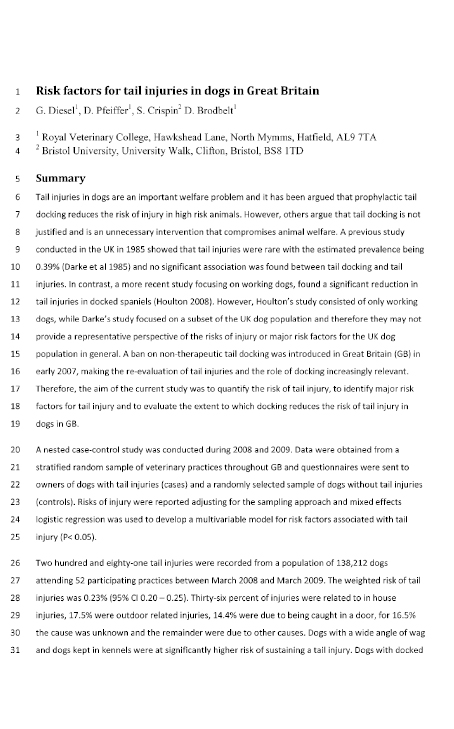
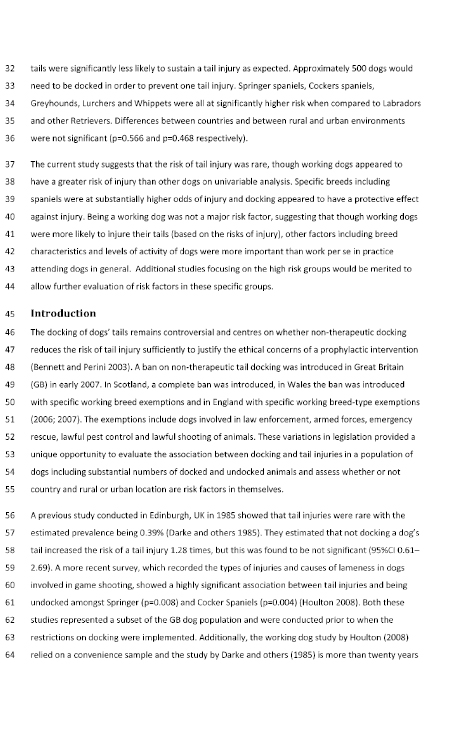
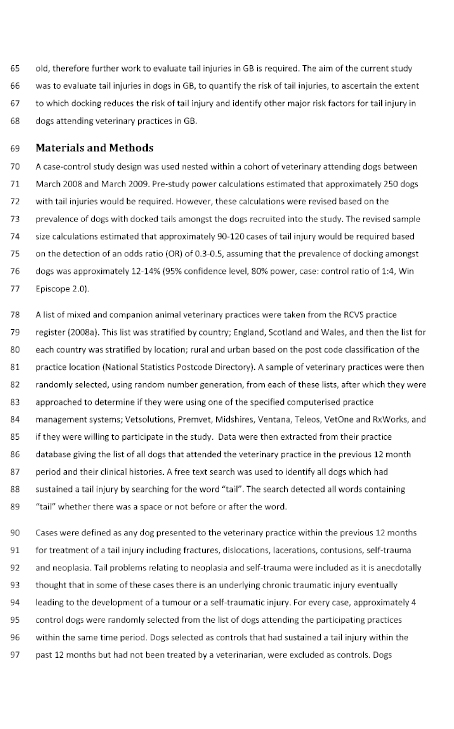
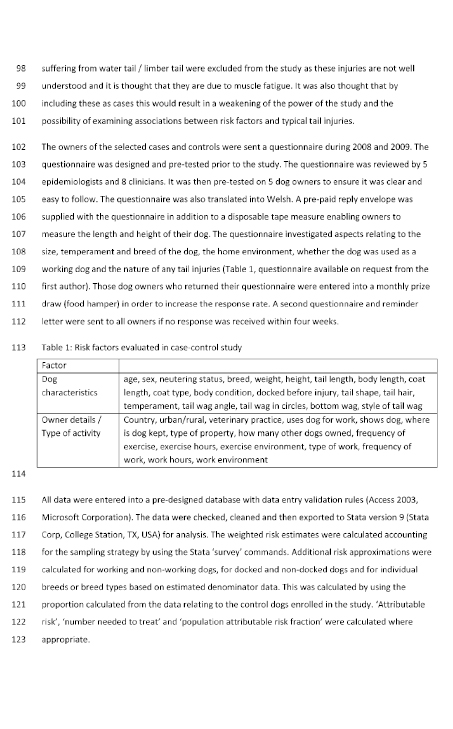
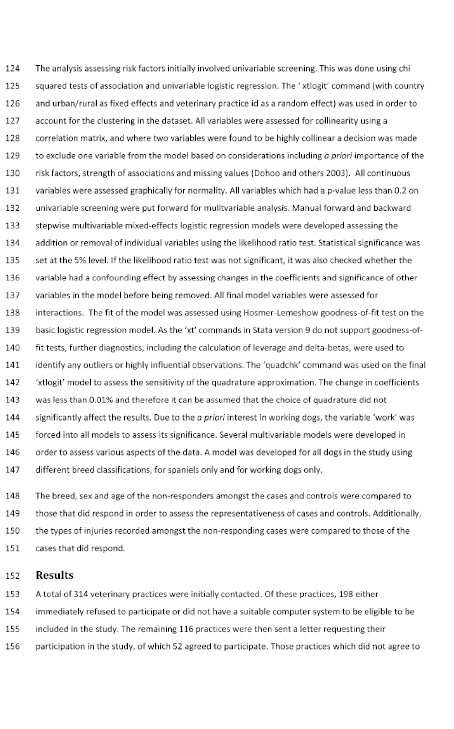
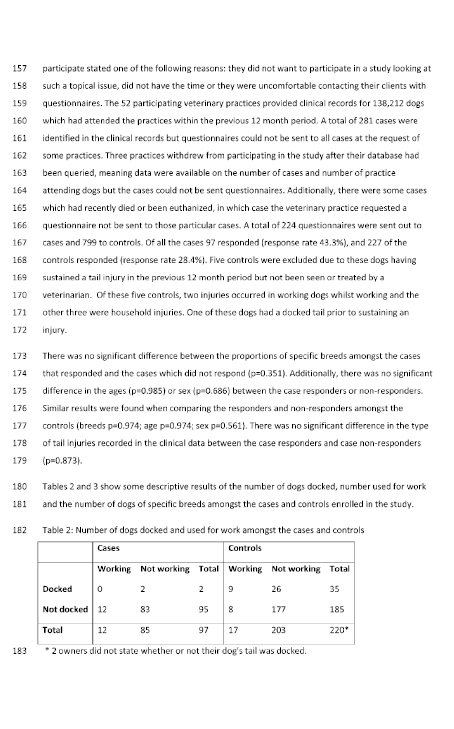
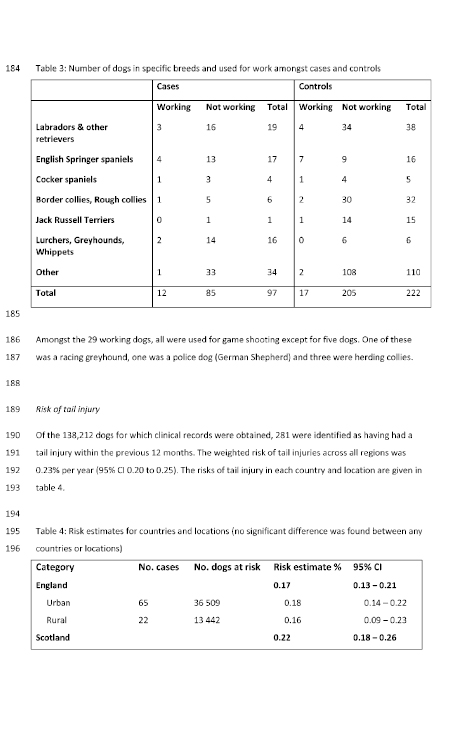
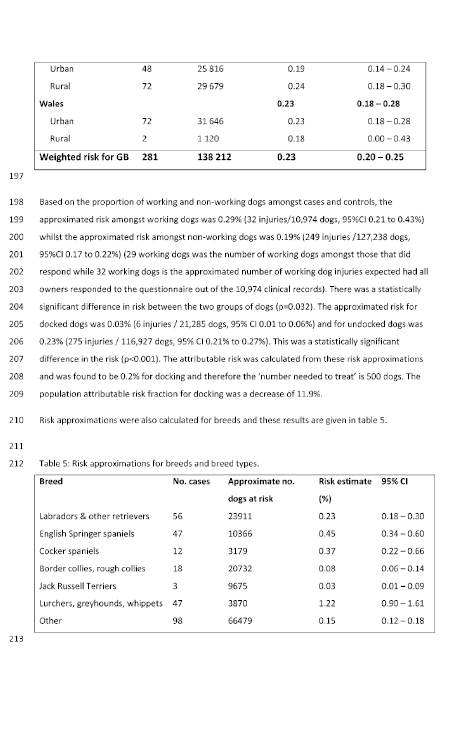
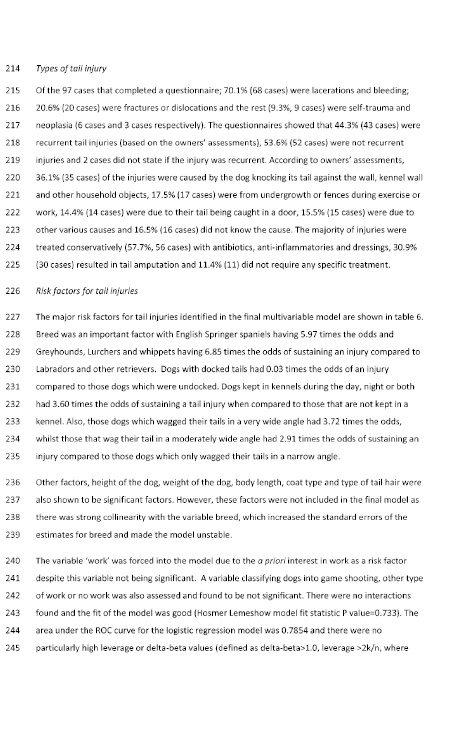
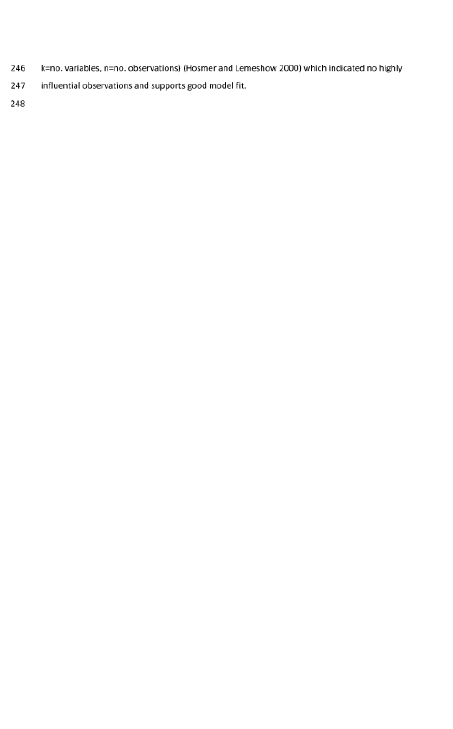
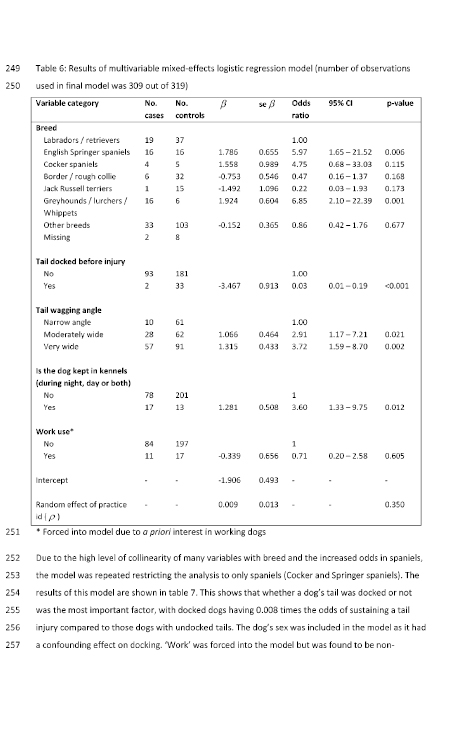
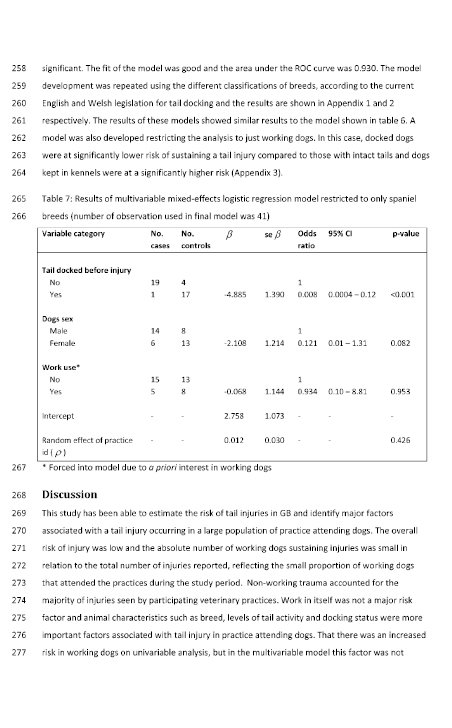
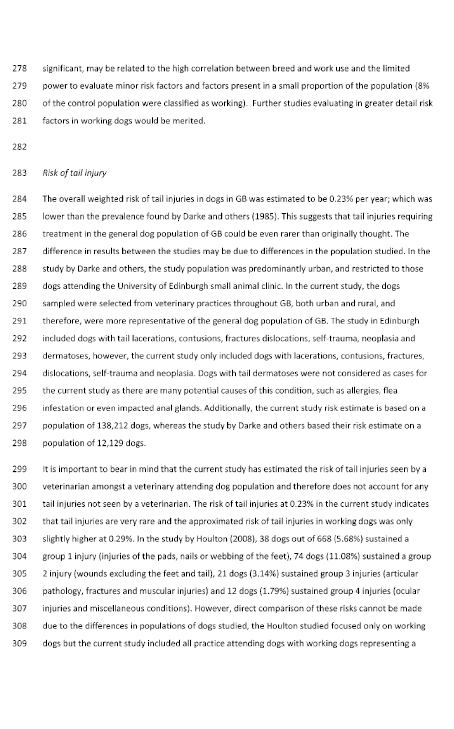
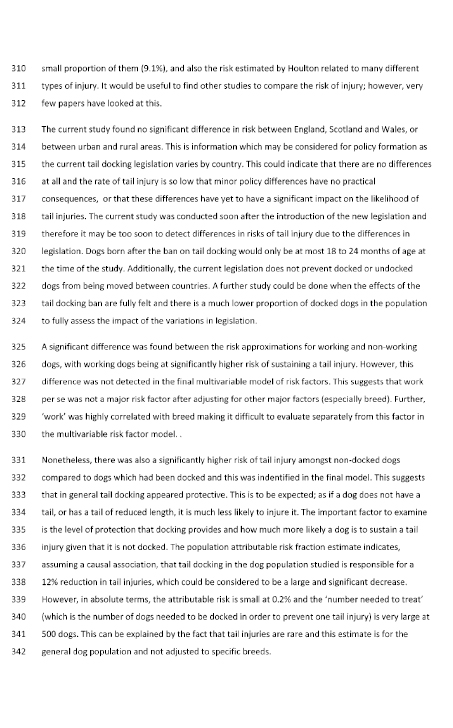
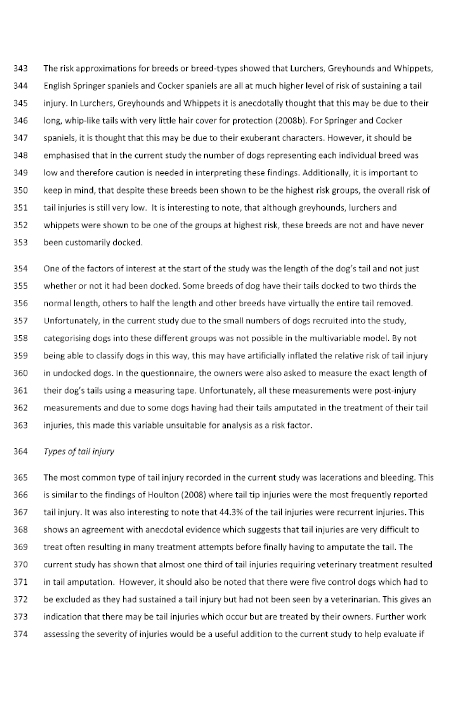
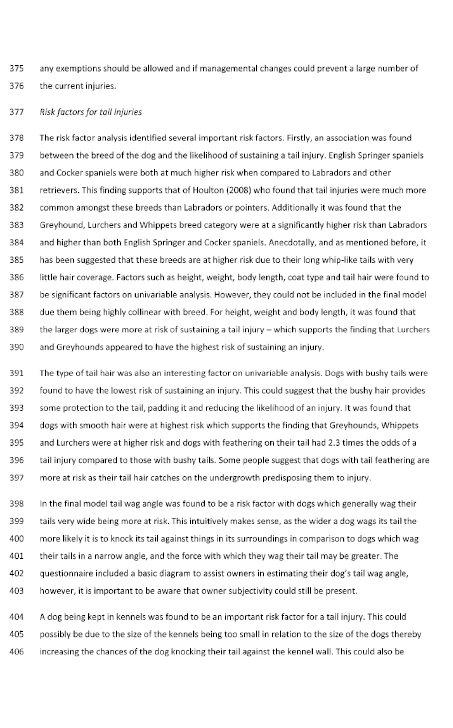
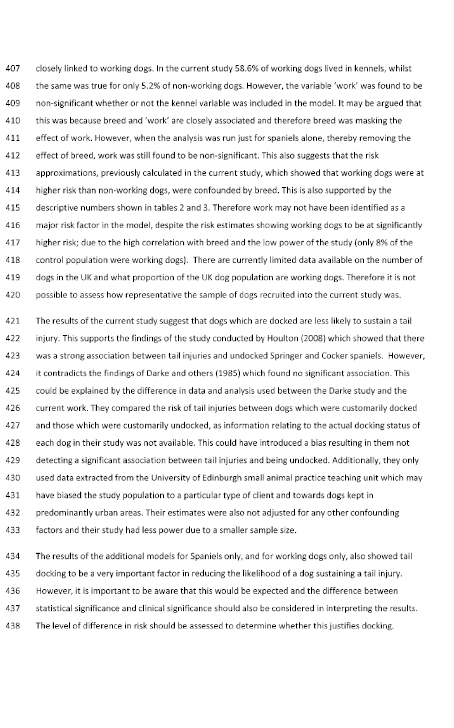
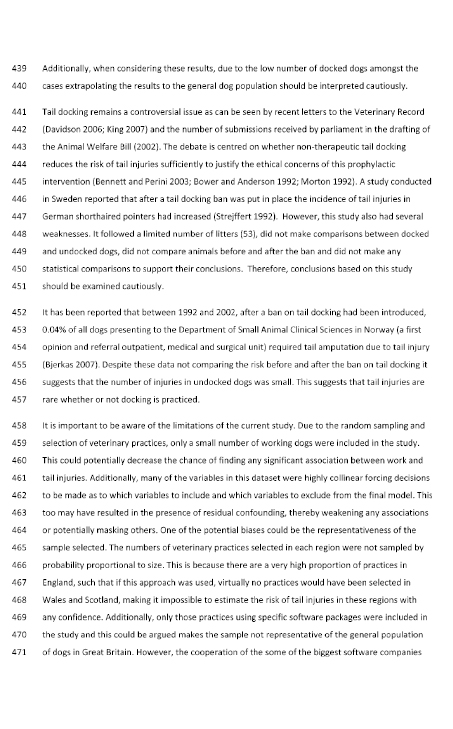
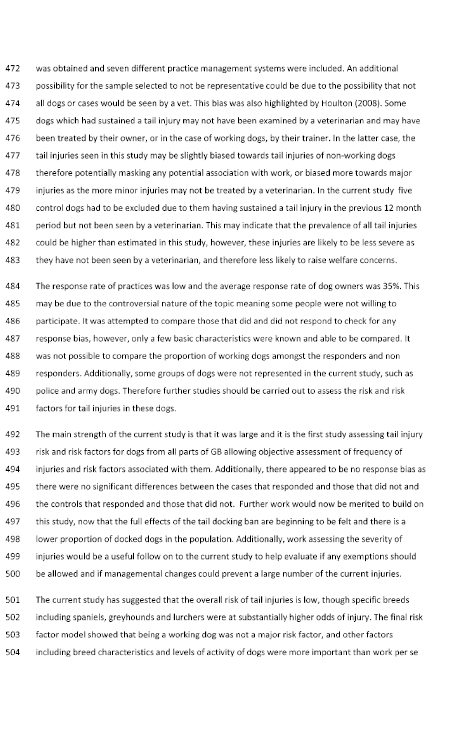

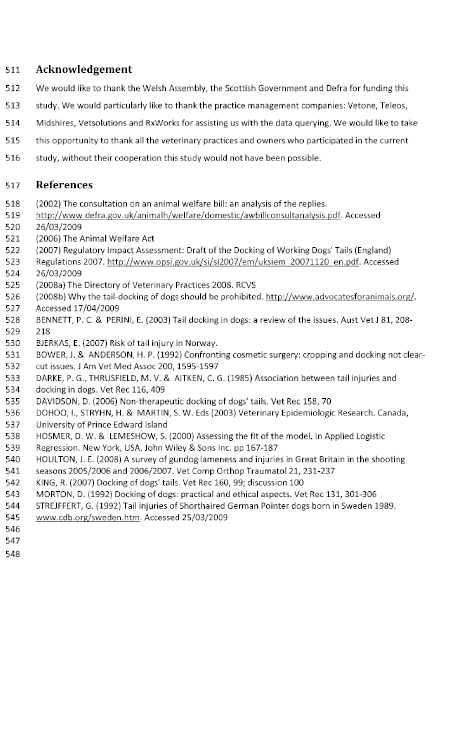
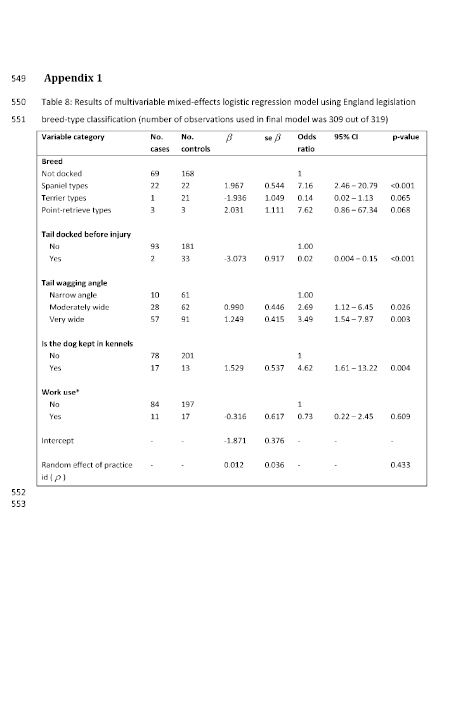
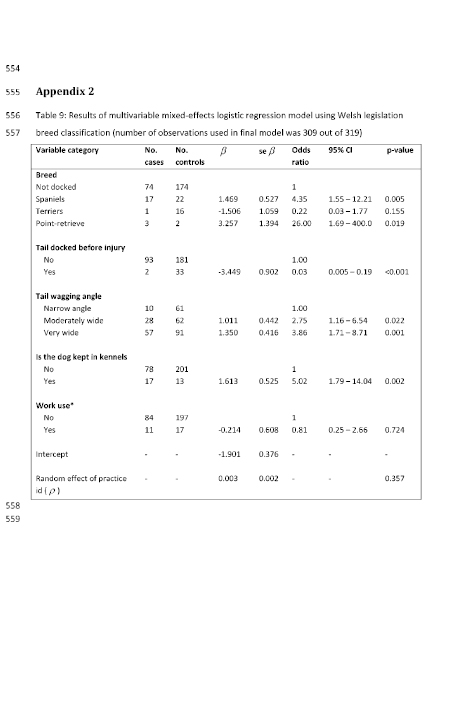
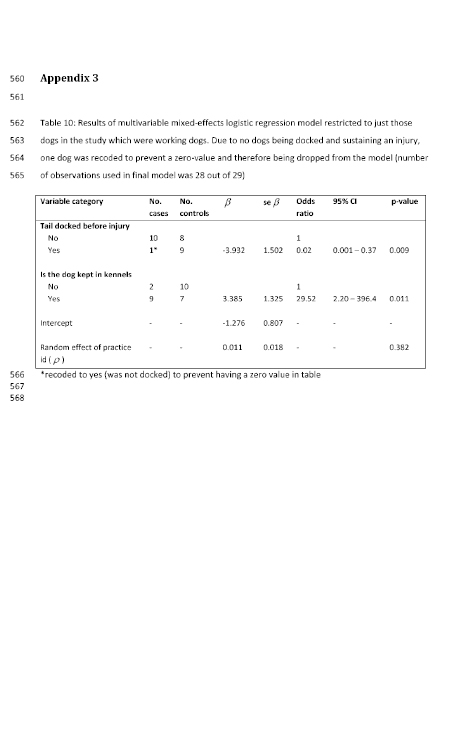
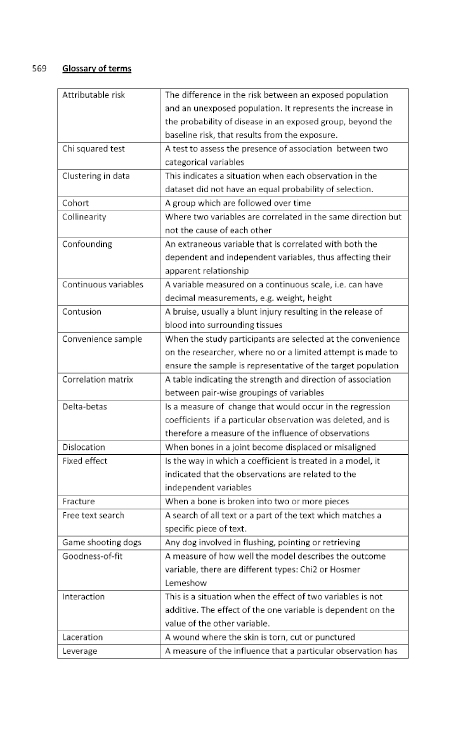
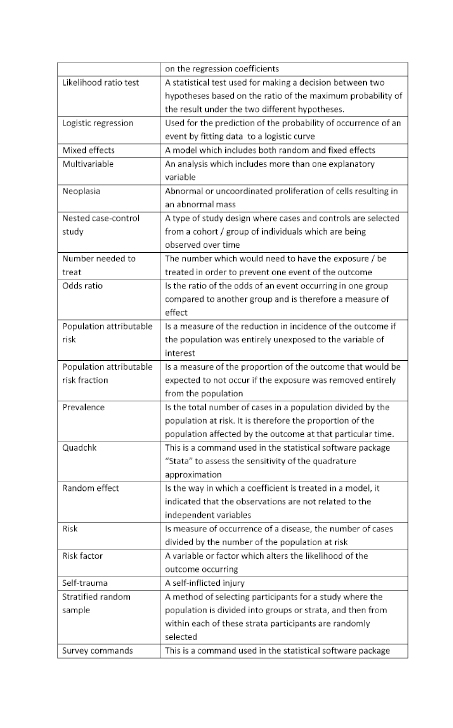
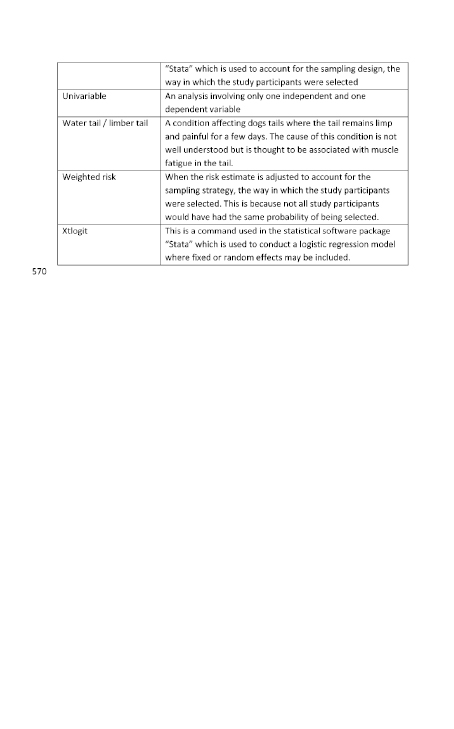
7. There has been no change in the law in Northern Ireland. Thus the legal advice obtained by the RCVS in 1996, set out below, still applies:
1. Docking, which may be defined as the amputation of the whole or part of a dog's tail has, since July 1993, been illegal under UK law, if performed by a lay person.
2. The Royal College has for many years been firmly opposed to the docking of dogs' tails, whatever the age of the dog, by anyone, unless it can be shown truly to be required for therapeutic or truly prophylactic reasons.
3. Docking cannot be defined as prophylactic unless it is undertaken for the necessary protection of the given dog from risks to that dog of disease or of injury which is likely to arise in the future from the retention of an entire tail. The test of likelihood is whether or not such outcome will probably arise in the case of that dog if it is not docked. Faecal soiling in the dog is not for this purpose a disease or injury, and its purported prevention by surgical means cannot be justified.
4. Similarly, docking cannot be described as prophylactic if it is undertaken merely on request, or just because the dog is of a particular breed, type or conformation. Council considers that such docking is unethical.
5. Docking a dog's tail for reasons which are other than truly therapeutic or prophylactic is capable of amounting to conduct disgraceful in a professional respect. In the event of disciplinary proceedings being brought in respect of tail docking, it shall be open to the RCVS by evidence to prove, and to the Disciplinary Committee on such evidence to find, that any therapeutic or prophylactic justification advanced for the docking in question is without substance. If such a finding is made, the Disciplinary Committee may proceed to consider and to decide whether in the circumstances the veterinary surgeon who undertook that docking knew, or ought to have known, that such purported justification is without substance.
6. For the avoidance of any doubt, any instance of tail docking which is found to have been undertaken for reasons which were not truly therapeutic or prophylactic will necessarily constitute an unacceptable mutilation of the dog, which, if carried out by a veterinary surgeon who knew or ought to have known of the lack of true justification, would almost certainly be considered to be conduct disgraceful in a professional respect.
RCVS Council, June 2007
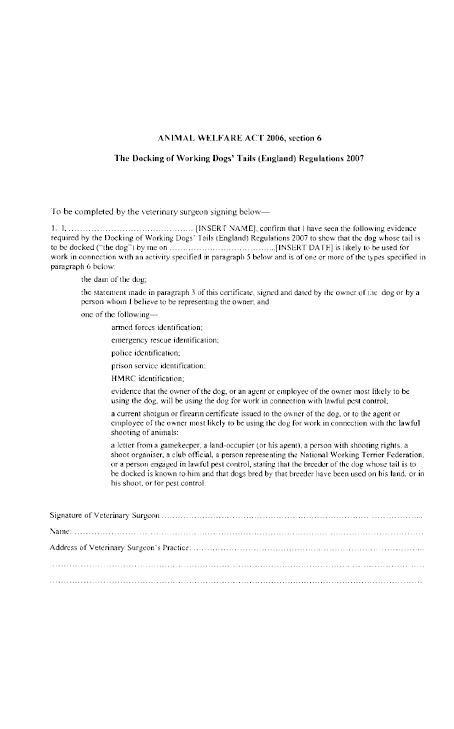
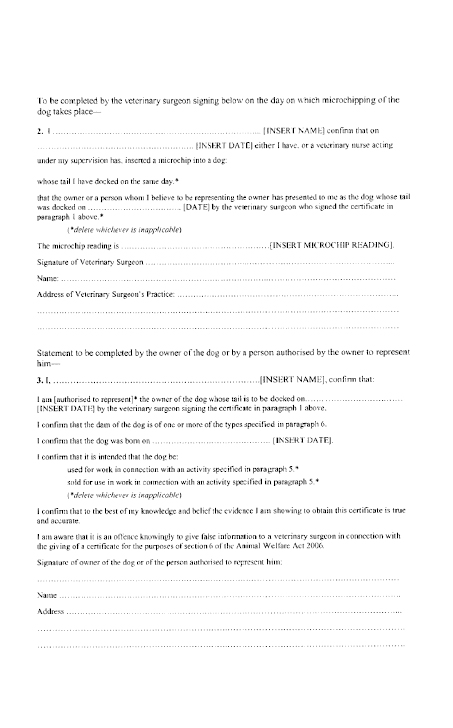
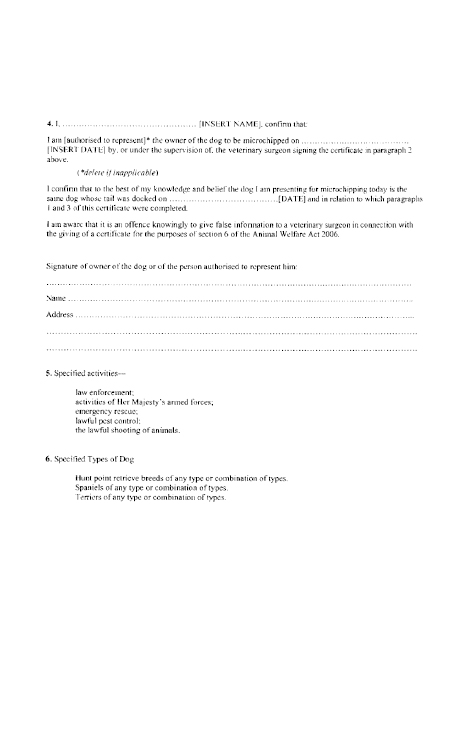
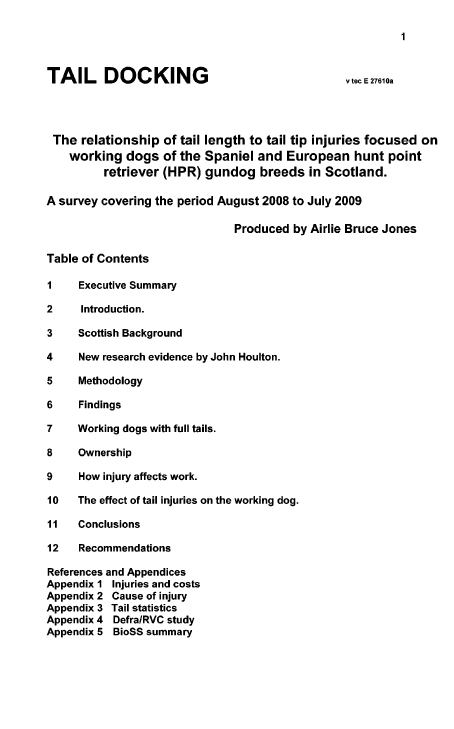
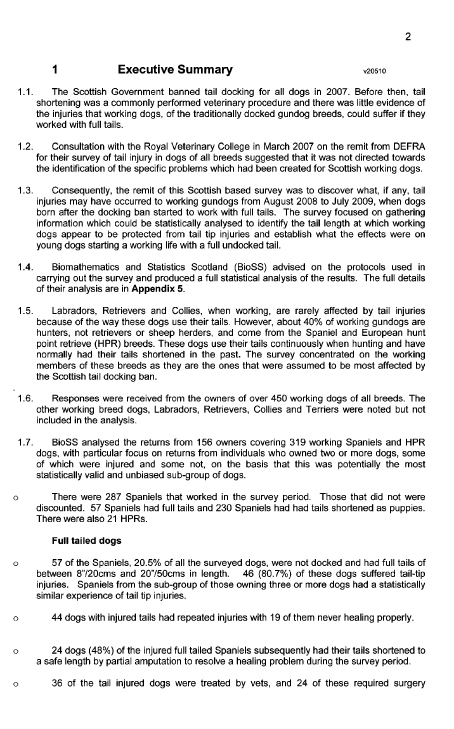
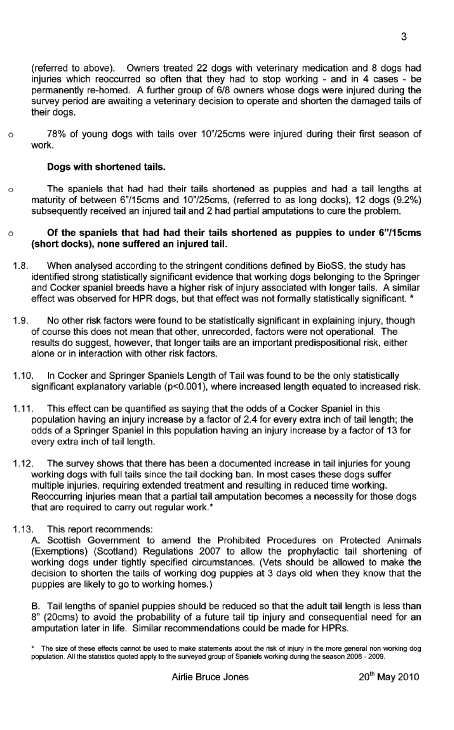
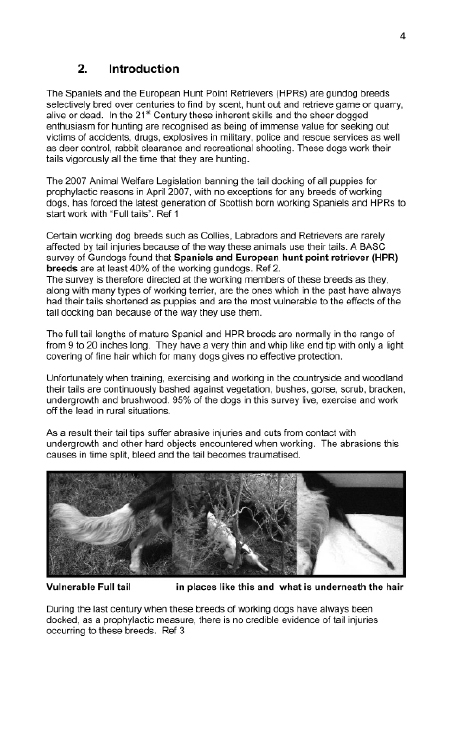
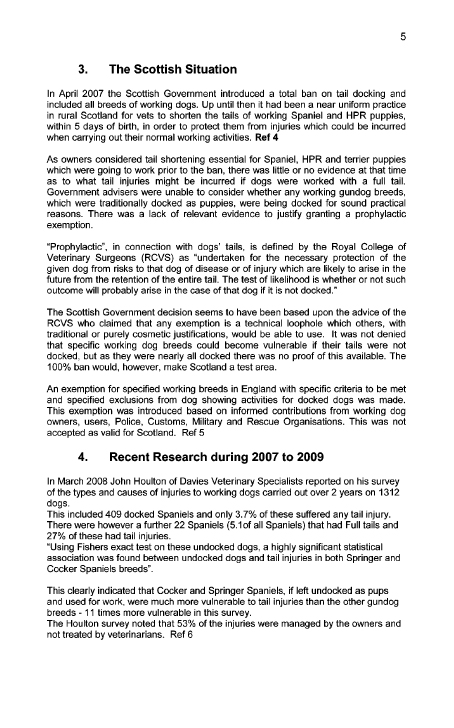
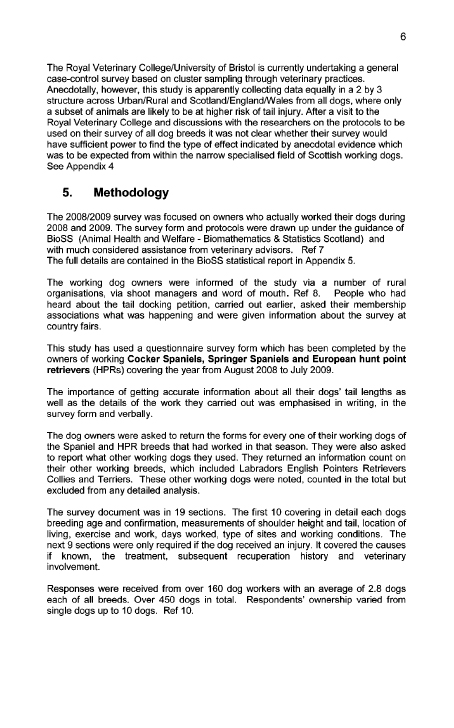
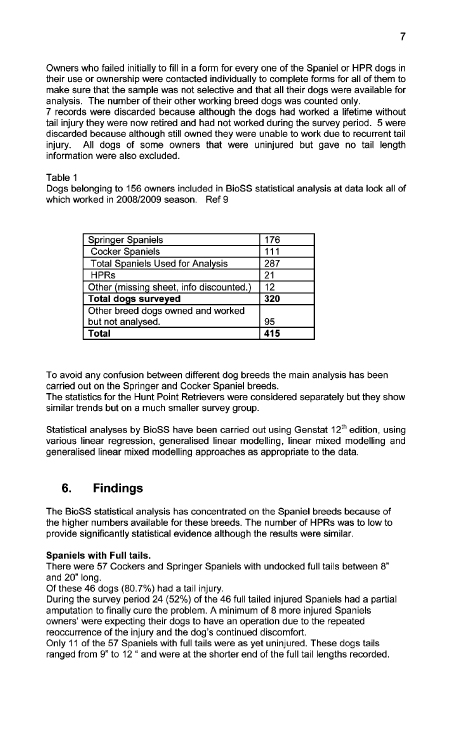
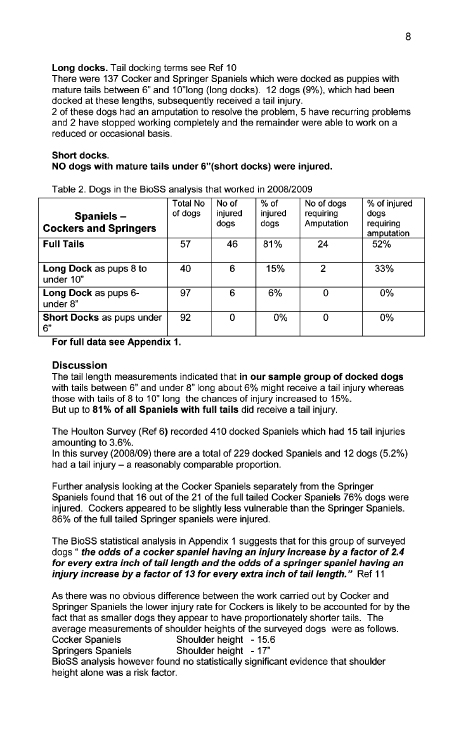
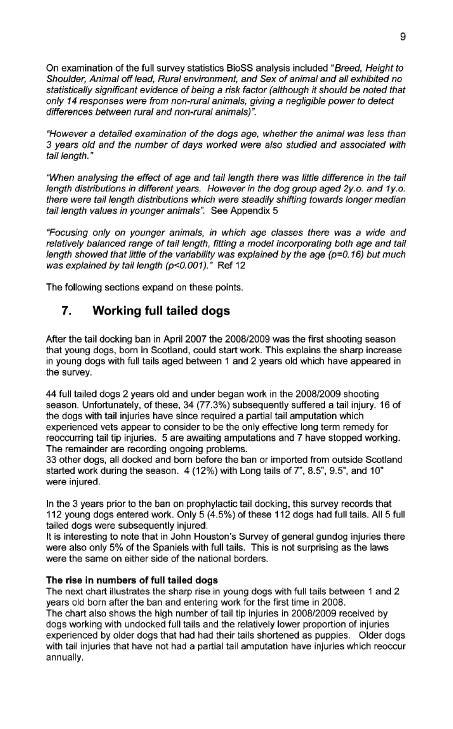
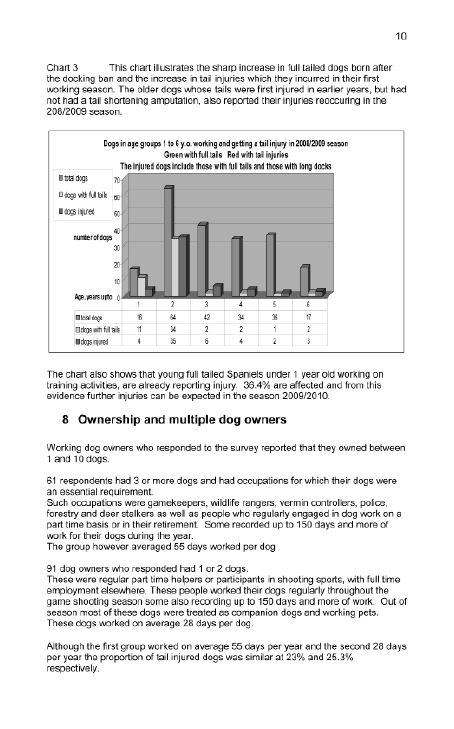
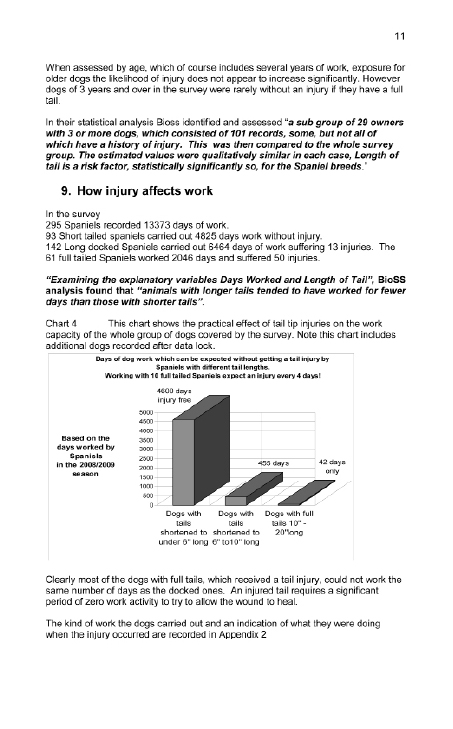
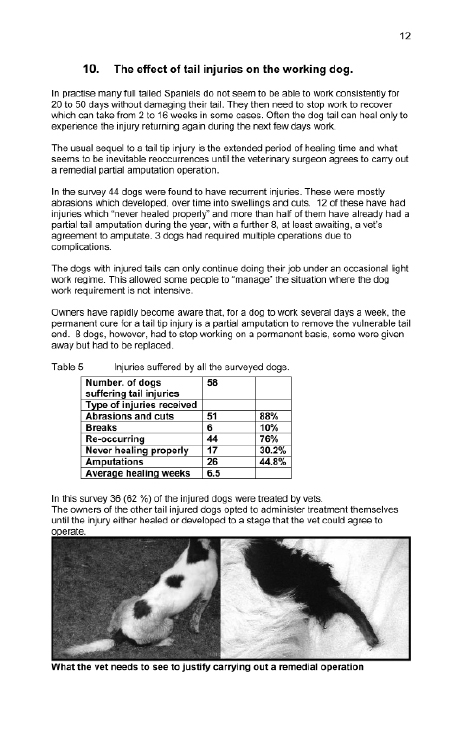
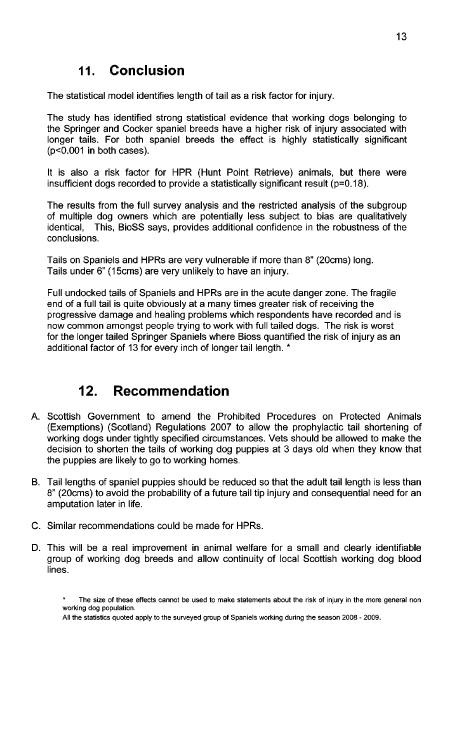
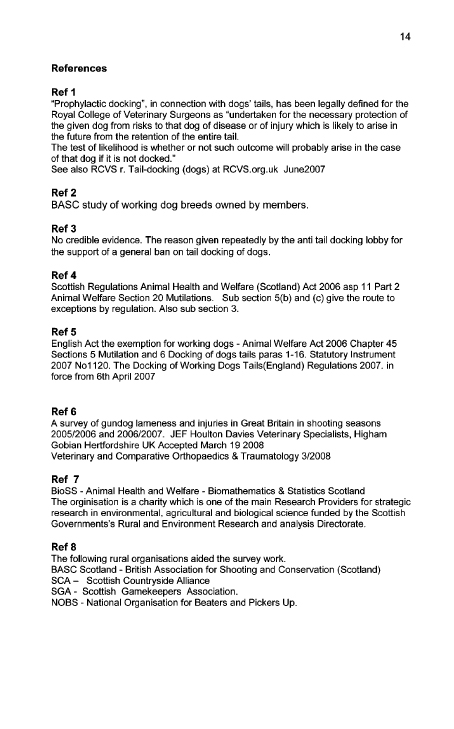
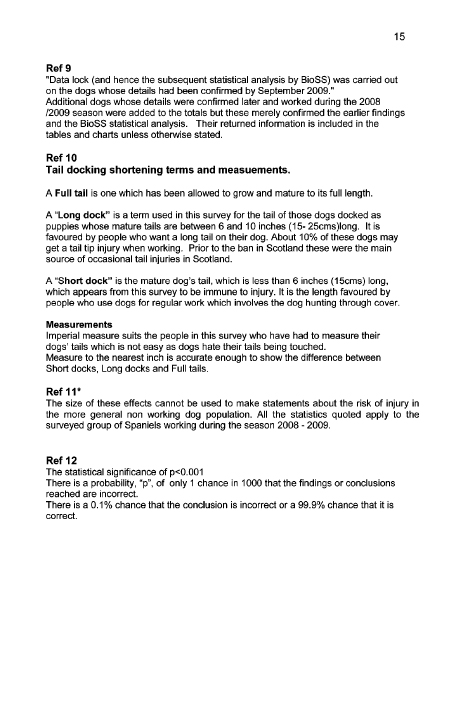
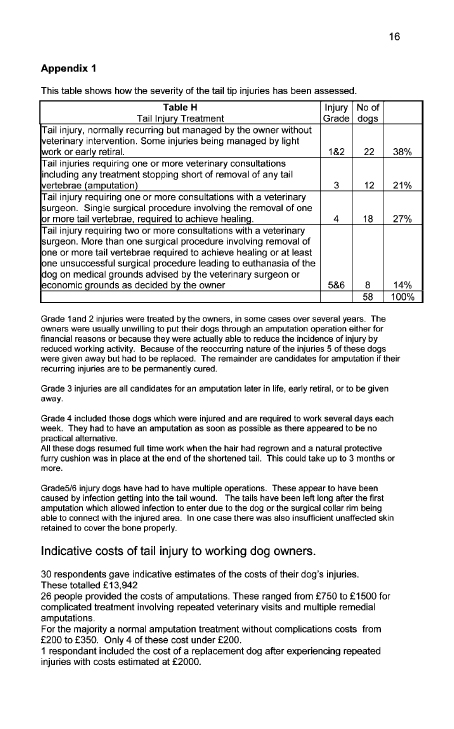
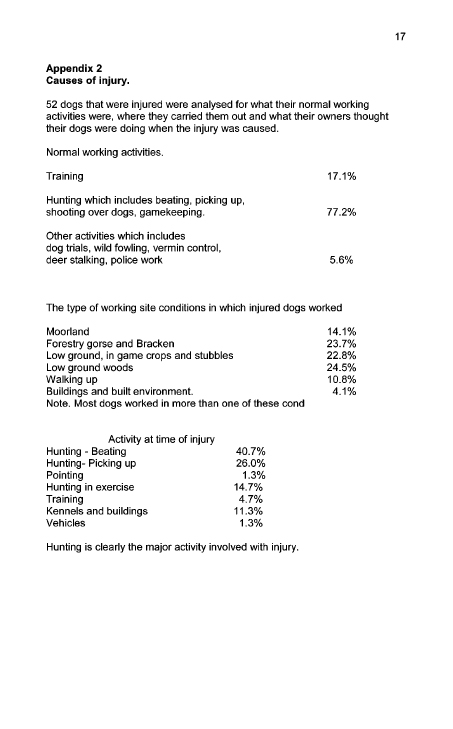
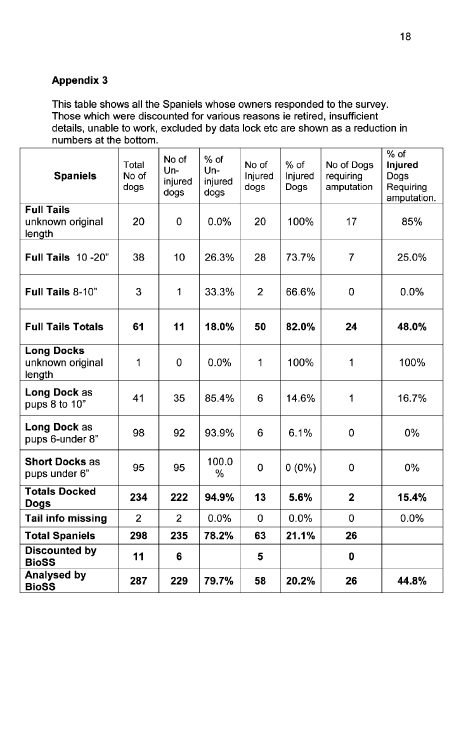
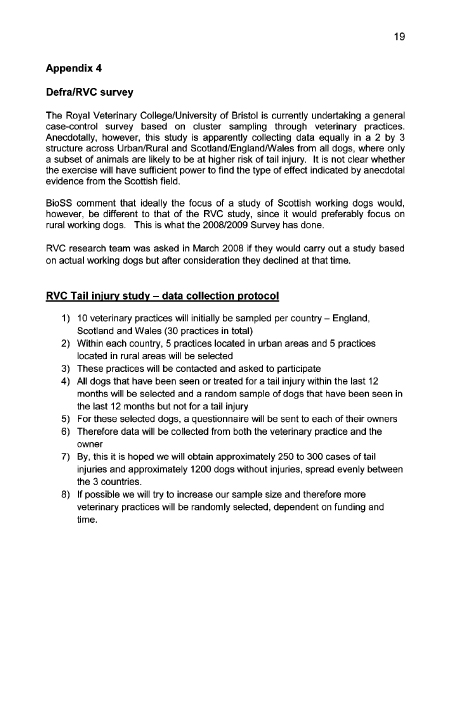
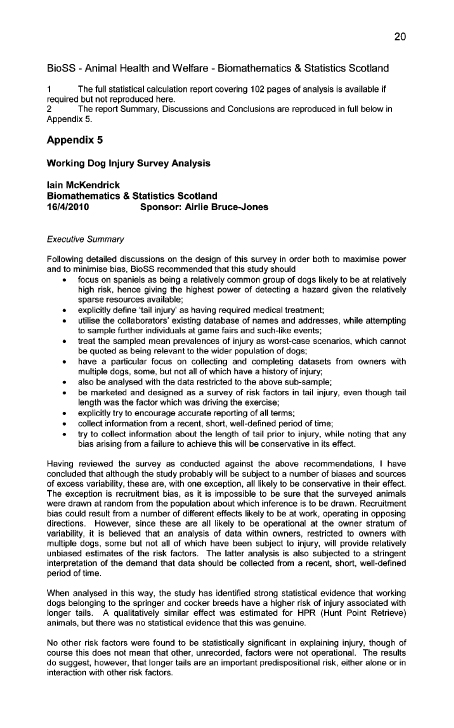
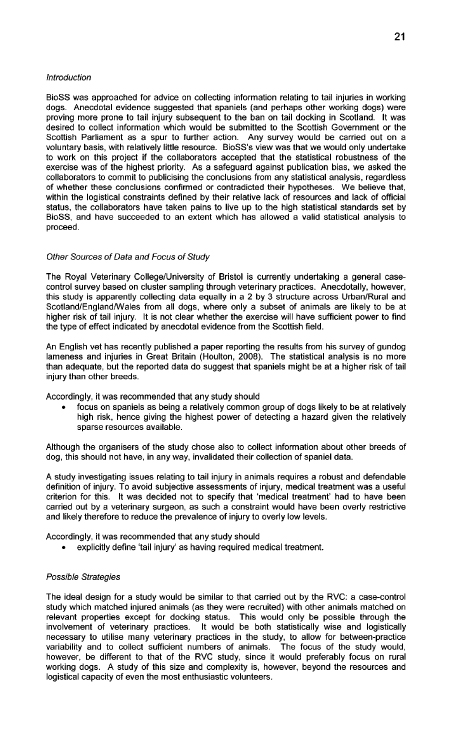
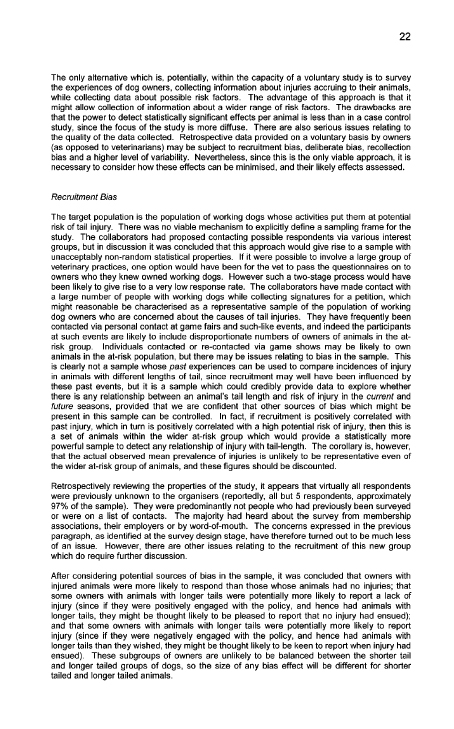
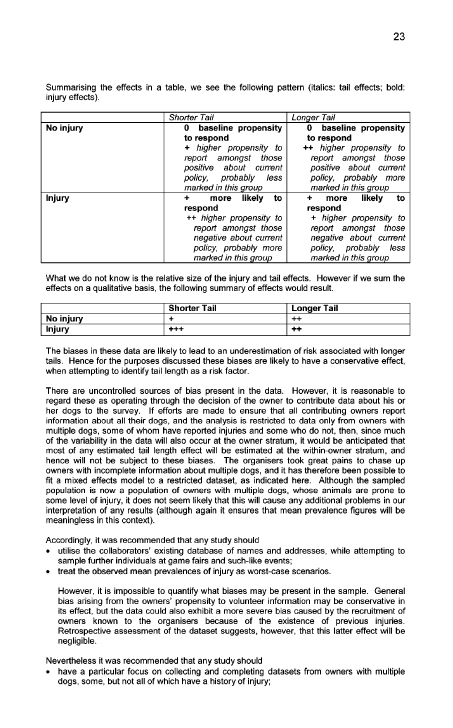
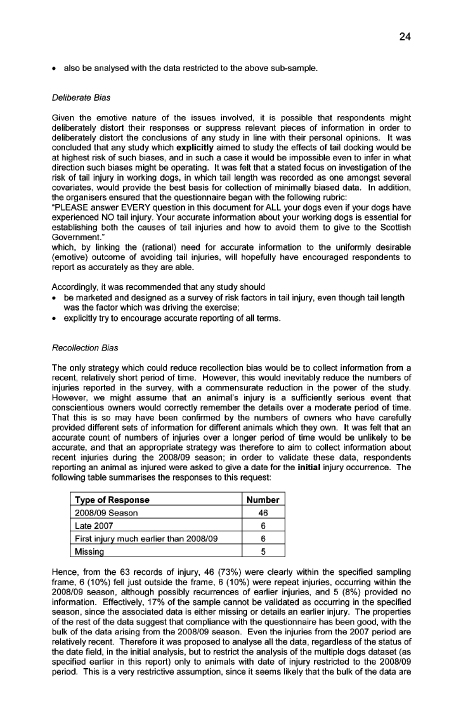
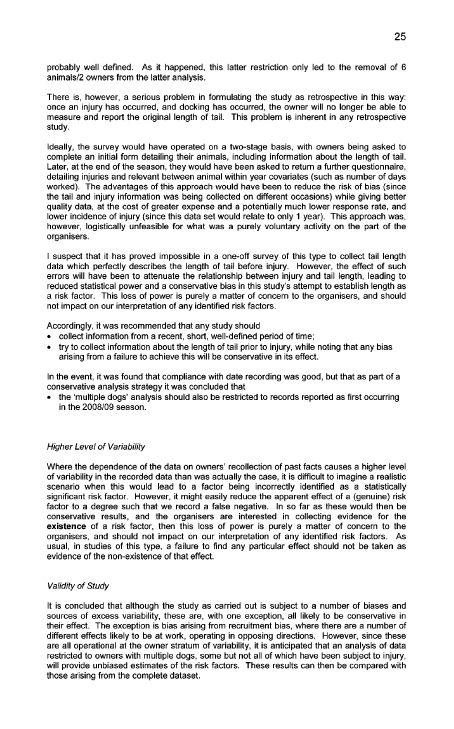
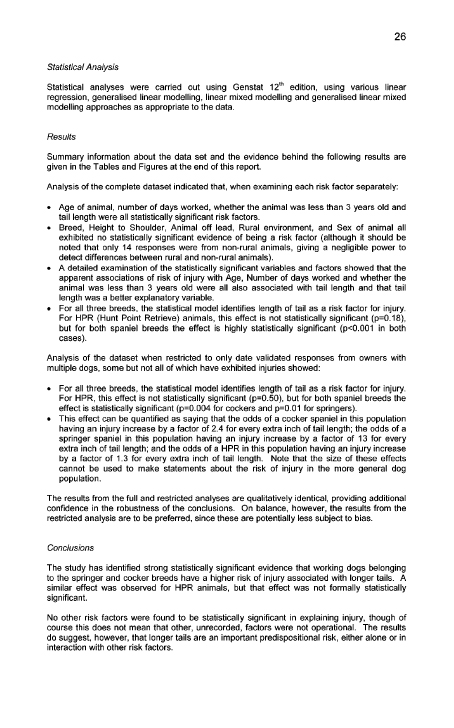
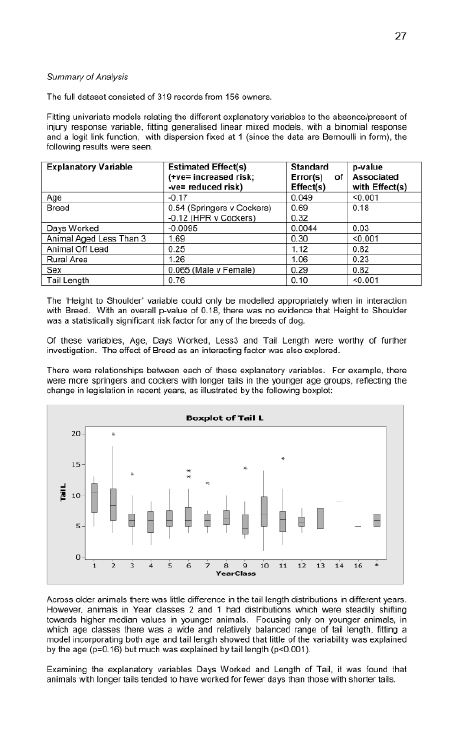
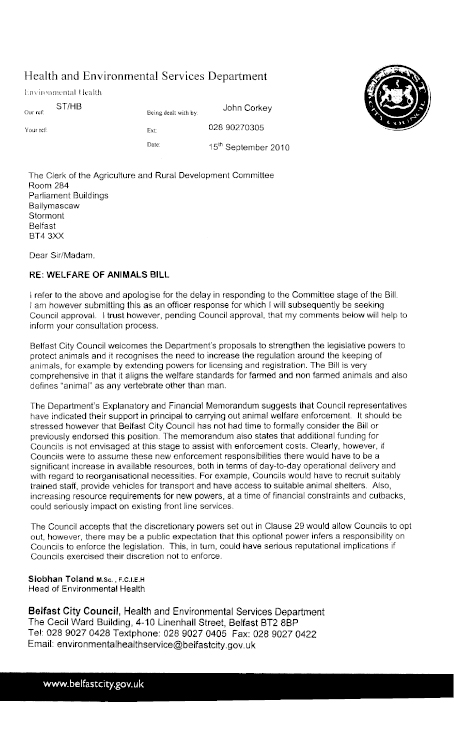
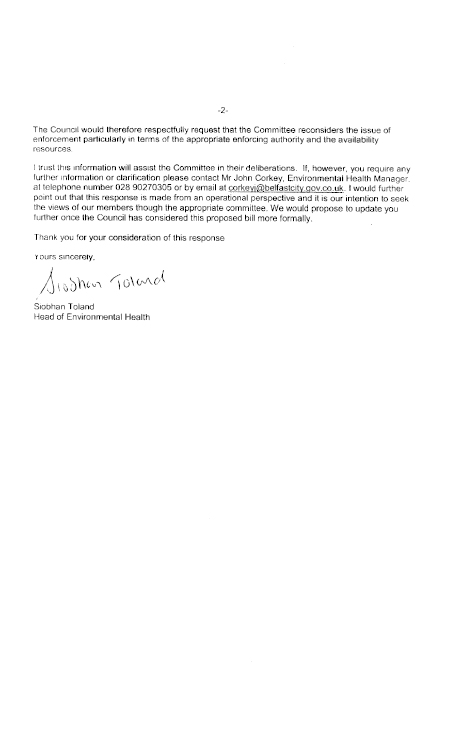
1. DARD Consultation paper on proposed provisions of the draft of the Bill - 21 August 2006
2. Letter to Clerk to the Committee – 21 October 2010
3. Letter to Clerk to the Committee – 01 November 2010
4. Letter to Clerk to the Committee – 01 November 2010
5. Letter to Clerk to the Committee – 08 November 2010
6. Tabled Paper – 16 November 2010
7. Letter to Clerk to the Committee – 22 November 2010
8. Letter to Clerk to the Committee – 23 November 2010
9. Letter to Clerk to the Committee – 29 November 2010
10. Letter to Clerk to the Committee - 10 December 2010
Dear Consultee
21 August 2006
I am writing to seek your comments on the attached consultation document entitled 'Proposals for New Animal Welfare Legislation in Northern Ireland'. Comments are sought by 5 December 2006. This is not a consultation on the provisions of an Animal Welfare Bill itself but rather it is an opportunity for you to comment on legislative proposals which seek to enhance powers in respect of animal welfare in Northern Ireland.
Animal welfare legislation in England and Wales and in Scotland is at present spread over 23 Acts of Parliament going back to the Protection of Animals Act 1911. There has in the past been significant judicial criticism of the language of that legislation. As a result, the Department for Environment, Food and Rural Affairs in England, acting jointly with the Welsh Assembly, and the Scottish Executive have carried out fundamental reviews to rationalise and simplify the existing legislation, leading to the drafting of a Bill, which is currently progressing through its final Parliamentary Stages at Westminster.
Unlike in GB, Northern Ireland animal welfare legislation has, to some degree, already been simplified and consolidated by the Welfare of Animals Act (Northern Ireland) 1972. However, some gaps have been identified in the legislation over the 30 years since it came into operation and it is clear that there is a need for some reform of existing animal welfare legislation.
In addition to this, the European Union has in recent years given high priority to farmed animal welfare and in that time legislation relating to the welfare of non-farmed animals has not made similar progress, whereby there is a gap between the standards for farmed and non-farmed animals. For these reasons, DARD is therefore taking steps to strengthen existing welfare provisions in NI legislation, including taking cognisance of the provisions of the new animal welfare legislation currently being introduced in Great Britain.
In summary, the proposals include powers to:
The consultation paper is also available on the DARD website at www.dardni.gov.uk or from:-
Department of Agriculture and Rural Development
Animal Welfare
Room 728
Dundonald House
Upper Newtownards Road
BELFAST BT4 3SB
by Fax (028) 9052 4320
Or by E-Mail to animal.welfare@dardni.gov.uk
Written responses to the consultation paper should be sent to the address above and responses should arrive no later than 5 December 2006. It will not be possible to consider responses received after this date.
The Department will publish a summary of responses following completion of the consultation process. Your response, and all other responses to the consultation, may be disclosed on request. The Department can only refuse to disclose information in exceptional circumstances. Before you submit your response, please read the paragraphs below on the confidentiality of consultations and they will give you guidance on the legal position about any information given by you in response to this consultation.
The Freedom of Information Act 2000 gives the public a right of access to any information held by a public authority, namely, the Department of Agriculture and Rural Development in this case. This right of access to information includes information provided in response to a consultation. The Department cannot automatically consider as confidential information supplied to it in response to a consultation. However, it does have the responsibility to decide whether any information provided by you in response to this consultation, including information about your identity, should be made public or be treated as confidential. If you do not wish information about your identity to be made public please include an explanation in your response.
This means that information provided by you in response to the consultation is unlikely to be treated as confidential, except in very particular circumstances. The Lord Chancellor's Code of Practice on the Freedom of Information Act provides that:
For further information about confidentiality of responses please contact the Information Commissioner's Office (or see web site at: http://www.informationcommissioner.gov.uk/).
Yours sincerely
Animal Welfare & Trade Branch
1. The intention of new proposed animal welfare legislation in Northern Ireland is to update existing legislation, which is now more than 30 years old and to introduce new powers and penalties to deal with new types of offences. The proposed legislation will also seek to address a perceived gap in the protection given between farmed and non-farmed animals. The legislation will also seek to extend law in certain important respects, most notably by introducing a new duty for owners and keepers of all vertebrate animals to take reasonable steps to ensure the welfare of the animals in their care.
2. The legislation will govern animals owned, and in the custody of persons, whether permanently or temporarily. It is not intended to cover the use of animals for scientific purposes under the Animals (Scientific Procedures) Act 1986, nor will it address hunting or coursing.
3. There is a need for reform of existing animal welfare legislation. The purpose of the new legislation will be to prevent cruelty to any animal and to set out the obligations of people to promote the welfare of all animals (including domestic pets) for which they are responsible. This should include owning, managing, or in any way keeping any animal, including buying, selling and transporting.
4. The European Union has given high priority to farmed animal welfare and Directive 98/58/EC sets minimum standards for all farmed animals and provides a framework for species-specific standards; these provisions are implemented in Northern Ireland by the Welfare of Farmed Animals Regulations (Northern Ireland) 2000. Legislation relating to the welfare of non-farmed animals has not made similar progress and therefore poorer standards apply to such animals. As a result, animal welfare organisations have been campaigning against what they see as double standards in animal welfare law for Northern Ireland.
5. A public consultation by Department for Environment, Food and Rural Affairs (Defra) in England and Wales was held during the first half of 2002. This revealed overwhelming support for a new all embracing Animal Welfare Act. This was followed by a similar exercise in Scotland in March 2004. Defra introduced an Animal Welfare Bill to Parliament, covering England and Wales, in October 2005. Since then the Bill has progressed through Parliament and was introduced to the House of Lords on 15 March 2006. In Scotland, the Environment and Rural Affairs Department followed Defra and introduced their Animal Health and Welfare (Scotland) Bill in October 2005.
6. DARD is therefore seeking to take steps to address the gap between the legislative protection provided to farmed and non-farmed animals and to replicate the provisions of the GB legislation where necessary and strengthen existing welfare provisions in NI legislation. Any new legislation will also sit within the framework of the Northern Ireland Animal Health and Welfare Strategy, a copy of which is available at www.dardni.gov.uk, which states that all those involved with animals should be fully aware, and accepting, of their role, and that it is animal owners and keepers that are ultimately responsible for the health and welfare of their animals.
7. English animal welfare legislation is at present spread over 23 Acts of Parliament going back to the Protection of Animals Act 1911, which is itself a consolidation of 19th century legislation. Defra has accordingly carried out a fundamental review to rationalise and simplify the existing legislation.
8. In Northern Ireland, animal welfare legislation has, to some degree, already been simplified and consolidated by the Welfare of Animals Act (Northern Ireland) 1972, ('the 1972 Act') which largely revoked and re-enacted the 1911 Act in respect of Northern Ireland. However, many of the gaps identified in GB also apply here, and thus amendment to the legislation is necessary.
9. It is also the case that, legislation in respect of commercial dog breeding in Northern Ireland is far less onerous than the provisions of the Breeding of Dogs Act 1973 and the Breeding and Sale of Dogs (Welfare) Act 1999 which operate in Great Britain and which effectively render such activities illegal. These provisions were not replicated in Northern Ireland. Consequently, provided that the dogs are kept in premises that are adequate for the purposes of the Dogs (NI) Order 1983, puppy farming is not an illegal activity within Northern Ireland. However, it has since become apparent there is now a need to consider new provisions in the legislation controlling dog breeding.
10. Any new legislation would therefore aim to ensure that protection for animals in Northern Ireland is at least equal to the powers being introduced in new legislation currently being progressed in GB and seeks to address gaps that have arisen since the coming into operation of existing legislation.
11. Since the 1972 Act was implemented, there has been increasing public awareness that an animal does not suffer solely as a result of physical abuse caused by deliberate acts of cruelty or neglect. There is equal concern about the quality of an animal's life and the need for legislation that will provide for an animal's physiological and other needs. It is felt, at least by some animal welfare organisations, that mainly due to legislation from the European Union, these needs have to an extent been addressed in the laws now in place for farm livestock and animals in transit. However, there is some real concern that the legislation for non-farmed captive animals has not kept up to pace with the legislation protecting farm animals.
12. There are a number of specific issues on which we wish to hear views. These issues are listed below. However, this is by no means an exhaustive list and respondents are free to comment more widely if necessary.
13. In new legislation being brought forward in GB, there is a restriction in the definition of animals protected under animal welfare legislation to include only vertebrates. This is on the basis that there is insufficient evidence available that invertebrates feel pain or distress. However, powers are written into the draft GB legislation that would allow subordinate legislation to be made to amend the range of animals to which new legislation would apply. This would only happen when, or if, scientific knowledge demonstrated that this is appropriate.
14. Part IV of the Welfare of Animals Act (NI) 1972 defines animals as 'including birds, fish and reptiles', which by failing to be specific, could be seen to be out of line with GB. It is therefore proposed to follow GB on this definition. Furthermore, in line with draft legislation in GB, it is also proposed to seek enabling powers to amend this definition by secondary legislation when or if scientific knowledge demonstrates this is appropriate.
15. Paragraphs 29-34 below detail the offence of failing to ensure good animal welfare (i.e. to provide a duty of care). This is already imposed on owners and keepers of farmed animals, through the Welfare of Farmed Animals (NI) Regulations 2000, but is not currently extended to non-farmed animals. It is proposed to extend this offence to include those animals commonly domesticated in Northern Ireland. The aim of the provision would be to ensure protection for those animals that are normally in the control of man, or indeed which are dependent on man for some or all of their needs (this would include most pets for example). These animals are to be defined as 'Protected Animals'.
16. In addition, it has been suggested that when 'non-domesticated' animals are not living in their wild state - as would be the case where wild animals are held temporarily by, for example, an animal sanctuary – they should also be included as 'Protected Animals' (and therefore subject to the duty of care).
17. Paragraphs 19-28 below establish a number of new cruelty offences, which extend existing provisions as set out in Part III of the Welfare of Animals Act (NI) 1972. It is suggested that whilst cruelty offences would apply to all animals (as defined in paragraph 14 above), including companion, farmed animals and wild animals (as is the case under the 1972 Act), the latter cannot be subject of a duty to care. (In addition to the protection under welfare legislation, additional limited protection is also provided by the Wildlife (NI) Order 1985. (The central aim of which is to protect population numbers, rather than to protect animal welfare) and makes it an offence to injure, take or kill certain protected wild animals and to use certain methods of taking or killing wild animals). Such animals would not be defined as 'Protected Animals' (and therefore not subject to the duty of care).
18. Following on from the definition of what constitutes a protected animal, DARD believes that responsibility for an animal should cover a range of activities including owning, keeping, managing, transporting, buying or selling where people can have responsibility for an animal either on a permanent or temporary basis. In keeping with Article 13(g) of the 1972 Act, DARD considers that an owner is always responsible for his/her animals, whether or not he or she is in charge of them. A person under 16 can have a range of responsibilities for an animal, but the responsibility for that animal should legally rest with the parent or guardian. A person should never be able to relinquish responsibility for an animal by abandoning it.
19. Under the 1972 Act, a person commits an offence if he causes, procures or, being the owner, permits the causing of unnecessary suffering. Unnecessary suffering can be caused in two ways: either by taking an action which causes unnecessary suffering, or failing to take such steps to prevent unnecessary suffering from happening. In both cases, it could be argued that an offence would be committed if the person should have reasonably known that his action or his omission to take action would have caused the animal to suffer. Under Article 20 of the 1972 Act, an owner of an animal will not have been deemed to permit cruelty if he has exercised reasonable care and supervision so as to prevent an animal suffering unnecessarily. It is unclear whether this is sufficient and it is proposed to extend unnecessary suffering provisions to make it an offence to fail to take such steps to prevent unnecessary suffering from happening. Such offences would apply to all persons who have responsibility for an animal.
20. When deciding whether suffering has been unnecessary, a number of factors should be taken into consideration. These focus on the necessity, proportionality, humanity and competence of the conduct of the person who has caused unnecessary suffering to an animal.
21. Generally, animals should not be subjected to any kind of mutilation, except where justified to avoid suffering or to improve welfare. In the 1972 Act a person is guilty of an offence if he subjects an animal to any operation other than those set out in the Schedule to the 1972 Act, where this Schedule exempts the tail docking of dogs before their eyes are open.
22. There have been calls to extend this and therefore to ban, or at least restrict, the docking of dogs' tails where there may be arguments for retaining the practice for certain working dogs whose tails are particularly prone to injury whereby docking is for welfare reasons.
23. Under the 1972 Act, it is an offence to 'wilfully administer, or cause to be taken by any animal, any poisonous or noxious substance'. It is also an offence to sell or offer for sale any foodstuff, which has been rendered poisonous.
24. It has been suggested that powers should be extended to include substances that are otherwise harmless when administered in a harmful quantity or method.
25. The 1972 Act prohibits animal fighting and baiting but this, it is recognised, may not go far enough. It is already an offence to promote, cause, permit or attend an organised fight between animals. Additionally, powers may need to be included in order to stop anyone from betting on animal fighting. Further, the practice of fighting between man and animals has become popular overseas, and the legislation should be clear that such a practice is outlawed before the practice comes to Northern Ireland.
26. Concerns have also been raised regarding the use of animals to blood dogs for fighting and that it is necessary to extend powers to halt such activities. It could be argued that the offences of cruelty and causing unnecessary suffering in the 1972 Act may be deemed sufficient to deal with such activities, and views are sought on whether this is the case and whether there are outstanding issues in respect of animal fighting.
27. New legislation being introduced in England and Wales makes it an offence to record, own, supply, publish or show a video recording of an animal fight.
28. Unlike the rest of the UK, Northern Ireland does not have specific rules in respect of a prohibition on the making films involving cruelty to animals. However, as existing legislation makes it an offence to cause unnecessary suffering to an animal, it may be that an amendment to the 1972 Act is not necessary.
29. It has been argued that the 1972 Act is deficient in the sense that it only allows prosecutions once cruelty or unnecessary suffering have occurred. In many cases, it is possible to identify animals which are being cared for inadequately and in some cases this inadequate care may lead to suffering if it continues. One-way of dealing with this situation would be to extend the cruelty offence to cover behaviour, which is likely to result in unnecessary suffering. The difficulty with this approach is that it may be hard to prove in practice.
30. As such it is suggested that a duty to care for animals properly and to promote their welfare, rather than simply to avoid causing unnecessary suffering is a more appropriate way forward. Any person who is responsible (as defined in paragraph 16) for animals, should therefore have a duty to ensure the welfare of those animals. As in the case of the Welfare of Farmed Animals NI Regulations (2000), which implement EU Directive 98/58 concerning the protection of animals kept for farming purposes, this duty of care should require them to ensure that all the animals' physical needs are catered for to include:
31. Furthermore, when a person transfers responsibility for an animal to another temporarily, the duty should apply, in so far as he must ensure that the person to whom he transfers responsibility will care for it appropriately.
32. In the case of animals kept by children under the age of 16 then the responsibility for caring for the animal should lie with the parent or other adult who has parental responsibility for that child or with whom the child and the animal habitually reside.
33. In order to aid enforcement of the obligation to ensure welfare, it is proposed that inspectors should have powers to make an improvement notice setting out steps that need to be taken to improve the welfare of a protected animal.
34. In line with amendments to GB legislation, and in keeping with the duty of care regarding children under 16 as highlighted in paragraph 16, consideration should be given to setting a minimum age (16 years) of a person to which pets can be sold or transferred or given as prizes.
35. There are currently no powers to regulate instances where pets, such as goldfish, are given as prizes. Part II of the 1972 Act states that it is illegal to sell pets without a licence (i.e. 'carrying out a business of selling animals as pets') but it has also been suggested that it may be inappropriate to allow an animal to be given to another person as a prize, as this is contrary to the view that keepers of animals have a responsibility to meet the welfare needs of the animal. That is to say being responsible for an animal may not sit easily with the concept of a person winning an animal as a prize.
36. On the other hand it has been argued that banning the practice of giving pets as prizes may be disproportionate. An alternative to an outright ban may therefore be to stop the practice of giving of animals as prizes to those who are under 16. This, it could be argued, would retain consistency with the basic principle reflected in paragraph 16 above.
37. Under the 1972 Act it is an offence to keep a petshop, animal boarding, riding, or zoological establishment without a licence from DARD. It has been suggested that the current legislation is too narrow, for example, in how it defines a petshop such that it does not include pet fairs, bird shows or pet wholesalers.
38. In addition, there are a number of other activities involving animals that are not covered by current animal welfare legislation, namely:
Consideration of whether there is a need to license circuses purely on the basis of animal welfare. The Animal Welfare Bill for England and Wales has recently been amended to seek to ban the use in travelling circuses of certain non-domesticated species whose welfare needs cannot be satisfactorily met in that environment. It may therefore be necessary to follow suit in Northern Ireland and allow for the licensing of travelling circuses for animal welfare. It is also unclear whether there are outstanding issues with regard to other performing animal acts.
Most animal sanctuaries are operated by people who have the welfare interests of the animals as their overall objectives. However, there have been cases, despite the best of intentions, where the facilities for the animals have fallen short of acceptable welfare standards. As such there is likely to be support for the licensing of such establishments.
Cat and dog boarding establishments are regulated under the 1972 Act, but there is no requirement for boarding for other animals such as rabbits.
An animal boarding establishment is defined in Part II of the 1972 Act as "any premises at which the business of providing accommodation for other people's cats or dogs in return for payment is carried on, other than accommodation so provided in connection with a business which the provision of such accommodation is not the main activity". As a result establishments where the main business is to train dogs for example (and which would often provide accommodation), are not subject to any regulation. Again there is a need to consider addressing this anomaly.
39. In order to deal with these anomalies and to ensure sufficient regulation of animal related activities, it is suggested that new powers be sought to require the licensing or registration of a wider range of animal-related activities to those currently regulated and set out in paragraph 37.
40. It would be the aim of primary legislation to set out that DARD may, by regulation (secondary legislation), make provision regarding licensing of activities involving animals, where such regulations would provide for the range of activities outlined in paragraph 38, in addition to other activities that may arise in due course or as a result of consultation. Each regulation would then be subject to separate consultations in due course.
41. Consideration may also be given to subjecting some activities to a registration rather than a licensing requirement. The registration procedure would be used in cases where it is necessary for the DARD to know of the existence and location of organisations or individuals who are keeping specific animals or carrying on particular activities, but where the additional controls and costs of a licensing regime are either unnecessary or would be unduly burdensome.
42. Powers that may be introduced in new legislation are likely to include the following:
43. It has also been suggested that powers to refuse or revoke a licence in the case of a person who has been refused a licence for any other relevant activity, or has been convicted of an offence to do with animal welfare for example.
44. The Dogs (Breeding Establishments and Guard Dogs Kennels) (Northern Ireland) Regulations 1983 permit District Councils to license dog breeding premises on the basis that they reach a proper standard of construction, are adequately ventilated and that certain fire precautions exist. This is far less onerous than the provisions of the Breeding of Dogs Act 1973 and the Breeding and Sale of Dogs (Welfare) Act 1999 that operate in Great Britain and which effectively render such activities illegal. Consequently, provided that the dogs are kept in premises that are adequate for the purposes of the 1983 Order, puppy farming is not an illegal activity within Northern Ireland.
45. The full equivalent powers of the Breeding of Dogs Act 1973 and the Breeding and Sale of Dogs (Welfare) Act 1999, where not implemented in Northern Ireland as little or no commercial dog breeding was carried out here until recently and the Welfare of Animals Act (Northern Ireland) 1972 was therefore considered to be adequate for the purpose of dealing with cruelty issues.
46. However, it has since become apparent that this may not be the case and there is now a need to consider the introduction of equivalent provisions to the legislation controlling dog breeding that operates within Great Britain. Legislation in GB provides for specific licence conditions for the breeding of puppies in such establishments and such conditions include the setting of a minimum age at which a bitch can be mated, a maximum number of litters that a bitch can produce in her lifetime and a minimum period between each litter.
47. In addition to concerns relating to puppy breeding in Northern Ireland, there have also been issues raised with regard to the welfare of puppies being transported from, or through, Northern Ireland en route to Scotland. In Scotland it is planned to introduce a ban on the importation of those dogs which have been bred in establishments that do not meet the highest standards.
48. However, as noted above, it is hoped to introduce higher standards with respect to breeding establishments in Northern Ireland, standards that would seek to be equivalent to those currently in place in the rest of the UK. These measures, together with the introduction of new EU rules in January 2007 on the welfare of animals during transport (which will make it an offence to transport cats and dogs under 8 weeks of age commercially, unless accompanied by their mother) could effectively end commercial intensive dog breeding in NI. These new rules may therefore negate the need for further legislation in respect of transport of dogs.
49. Welfare concerns have been raised that the betting industry led business of greyhound racing is responsible for regulating itself with regard to the welfare of dogs. Although the 1972 Act gives DARD obligations in relation to animal welfare for all keepers of animals, these obligations do not extend to veterinary supervision of greyhound racing or trials, nor does DARD veterinary inspectors have powers of entry to racetracks.
50. Currently if an animal is injured at a greyhound meeting it is ultimately the responsibility of the owner to take that animal to a veterinarian. Race organisers may, of course, arrange for private veterinary cover if they so wish.
51. It has been suggested that consideration should be given to licensing greyhound racing courses in terms of animal welfare, although in GB a decision has yet been reached as to whether secondary legislation will include regulation of greyhound racing. If regulation was required, the issues that could be considered might include a requirement to have a veterinary surgeon present at all greyhound races and/or to have all dogs inspected by a veterinary surgeon before and after each race or as to whether there is a need for a limit on the frequency that individual dogs can race.
52. The 1972 Act allows a police officer that finds an animal, which is so diseased or so severely injured, or in such a physical condition that, it cannot be removed without causing it unnecessary suffering to destroy the animal or have it destroyed. The Act is ambiguous as to the powers of a police officer to remove the animal if this could be done without causing further suffering.
53. It is proposed to introduce additional powers whereby a DARD inspector or police officer who finds an animal that is so suffering can take a range of steps that need to be taken immediately to alleviate the animal's suffering. The steps that could be taken include removing it to a place of safety or caring for it at the premises where it was taken into possession. This would not only include animals which are suffering but also those, which are likely to suffer if action is not taken and
54. In carrying out such powers, it is proposed that inspectors or police officers should be reimbursed for all reasonable expenses incurred when taking possession of an animal and they are able to undertake these functions without hindrance.
55. In order to enforce any new powers of seizure, new powers of access for the purpose of searching for an animal that is suffering or is likely to suffer if conditions do not change are proposed therefore extending Article 25 of the 1972 Act which allows for a police office to enter at any reasonable time any premises where he has reason to believe that an offence of cruelty has been committed.
56. It is proposed that where an animal has been taken into possession without the agreement of the owner or keeper then a court should be able to decide the future of that animal. This could include:
57. It is also proposed that a court may specify certain actions and provisions, such as specified treatment for the animal, for its destruction, sale (any money obtained as a result of the sale of an animal may be used to offset expenses incurred in carrying out an order or in looking after the animal) or other method of disposal.
58. As noted above, the 1972 Act prohibits animal fighting and baiting. However, there are no powers for authorities to seize an animal used in connection with the range of fighting offences in the legislation, except for those dogs defined as dangerous dogs (such as pit bull terriers) under the Dogs Order 1987 (as amended). It is the case that powers to seize an animal involved in fighting could be used to save the animal from participating in further fighting activities. On conviction it would also be possible to dispose of that animal which may other wise be difficult to trace. It is anticipated that any such powers could be only be exercised by the Police.
59. Under Section 25 of the Welfare of Animals (NI) Act 1972 any person found guilty of an offence of cruelty under the Act is liable to imprisonment for up to 3 months and/or a fine not exceeding level 5 on the standard scale. It has been recognised that these penalties may not be a sufficient deterrent and it is proposed to review these. It has been suggested that a range of penalties should be available with higher penalties liable for certain breaches of the legislation. For example, it is considered that breaches of legislation involving the causing of unnecessary suffering, animal mutilation, administration of poisons and offences in respect of animal fighting should carry higher penalties than are currently available. This may include imprisonment for up to a year and/or a fine not exceeding £20,000.
60. In the 1972 Act a person convicted of an offence of cruelty in addition to any other punishment, may in the case of a first offence, and shall in the case of a subsequent offence, be disqualified from having custody of a specific animal (such as the animal to which an offence of cruelty had been committed) or animals in general.
61. It has suggested that additional powers may be needed to extend this disqualification to ensure that it is clear that 'having custody' includes a range of activities, namely, owning, keeping and participating in the keeping of animals, being involved in arrangements under which the keeping of animals may be controlled or influenced (for example, at premises owned or managed by a disqualified person); dealing in animals; and transporting and arranging for the transport of animals.
62. It has also been suggested that additional powers may be needed that will allow a court to set conditions on the number of animals that can be kept by a person who has been convicted of an offence under animal welfare legislation in order to protect the welfare of those animals.
63. In line with powers being progressed in England and Wales, it is considered that courts should have the power to forfeit, and if appropriate, destroy, items which relate to an offence of cruelty such as causing suffering, mutilations, poisoning or animal fighting. Such items might therefore include any item designed or adapted for the use in an animal fight or designed or adapted for causing suffering to an animal.
64. When the Welfare of Animals Act 1972 came into operation, the policy that prevailed at that time was to limit the responsibilities of local councils. As a result of this, DARD took on roles such as licensing pet shops and other activities involving animals, which would otherwise be undertaken by local councils, as is the case elsewhere in the UK.
65. However, in light of the on-going and fundamental review of the role of local government in Northern Ireland, it has been proposed that consideration should be given to devolving such responsibilities over time to the new councils to be set up under the Review of Public Administration (RPA). Whilst any such plans would be subject to the outcome of local government review and the out workings of the RPA, views are welcomed on the advantages or otherwise of such a change.
66. A press release providing details of the consultation document has also issued. A copy of the consultation is also available from the DARD website at www.dardni.gov.uk/consultations.
67. On completion of the consultation process, comments will be analysed and assessed. Your comments will assist in the drafting of future legislation.
68. As part of the Department's consultation process a series of meetings with interested groups will take place. Should you wish to participate in such discussions please let us know as part of your written response to this initial consultation exercise.
| Issue | Question | Comment |
| The definition of "Animal" | Q1. Do you agree with the definition of animal as "vertebrate animals, other than man"? | |
| Q2. Do you agree with inclusion of powers to make subordinate (secondary) legislation to amend range of animals to which new legislation would apply when or if scientific knowledge demonstrated that this is appropriate? | ||
| Definition of "Protected Animal" | Q3. Do you agree with the definition of a protected animal? | |
| Responsibility for an Animal | Q4. Do you agree with the definition of who is responsible for an animal? | |
| Unnecessary Suffering | Q5. Do you agree with the need to extend the definition of unnecessary suffering? | |
| Mutilation | Q6. Do you agree there should be an extension of legislation restricting the docking of dogs' tails? | |
| Q7. If so, should this practice be banned altogether, or restricted to certain breeds of dog, or to only those dogs actively employed as working dogs? | ||
| Administration of Poisons | Q8. Do you agree with the additional powers to make it an offence to administer substances that are otherwise harmless when administered in a harmful quantity or method? | |
| Animal Fighting | Q9. Do you agree that powers should be extended to include offences in respect of betting on animal fighting an offence? | |
| Q10. Do you agree that powers should be extended to make it clear that fighting between man and animals is illegal? | ||
| Q11. Are there outstanding issues with respect to animal fighting that should be considered in new legislation? | ||
| Q12. Do you believe that this (videoing an animal fight) is an issue in Northern Ireland, about which legislation should be produced? | ||
| Making Films involving Animal Cruelty | Q13. Is there a specific need to extend rules in respect of making films involving cruelty to animals? | |
| An Obligation to Ensure Good Welfare | Q14. Do you agree with the need to extend powers to ensure anyone responsible for an animal has a duty to ensure the welfare of that animal? | |
| Q15. Do you agree with the proposal to introduce improvement notices? | ||
| Transfer of Animals by Sale or Prize to Persons Under 16 | Q16. Do you agree with the setting of a minimum age (of 16 years) of a person to which pets can be sold or given as gifts? | |
| Giving Animals as Prizes | Q17. Do you consider it appropriate to legislate for the giving of animals as prizes? | |
| Q18. If so, should powers be sought to ban this practice or to set a minimum age (16 years) of a person to whom an animal can be given as a prize or should this practice be banned completely? | ||
| Licensing or Registration of Activities Involving Animals | Q19. Do you agree that the Department should seek powers to make legislation to license or register a wider range of activities involving animals than are currently in the legislation (see paragraph 37), including those listed in paragraph 38? | |
| Q20. Are there are any activities involving animals, which you consider should or should not require licensing? | ||
| Q21. With reference to circuses and the use of animals in performing acts, is there a need to consider legislating to ban the use in travelling circuses of certain non-domesticated species whose welfare needs cannot be satisfactorily met in that environment as is currently being taken forward in GB? | ||
| Q22. Are there outstanding issues with respect to the use of animals in performing acts in addition to regulation of travelling circuses? | ||
| Q23. Are there are any activities involving animals, which you consider should not require licensing, but would better suit a registration system? | ||
| Q24. Do you agree with the likely range of powers that should be included in primary legislation that will allow the Department to make legislation to license additional activities involving animals? | ||
| Dog Breeding | Q25. Do you agree that the new powers that will allow the Department to make legislation to license activities involving animals (as highlighted in paragraph 38) should include the licensing of breeding establishments to provide further welfare protection in line with powers already in place in GB (whereby the new rules will be consulted on separately as with other activities involving animals)? | |
| Q26. Are there specific issues that should be considered in any new rules in respect of dog (and cat) breeding establishments, beyond those set out in paragraphs 44 -45? | ||
| Q27. Are there any outstanding issues with respect to the transit of puppies from or through NI that should be considered in drafting new legislation? | ||
| Greyhound Racing | Q28. Do you believe that any new powers that will allow the Department to make legislation to license additional activities involving animals (as highlighted in paragraph 38) should include the licensing of the welfare aspects of greyhound racing? | |
| Q29. Are there specific issues that should be considered in drafting new rules in respect of the welfare aspects of greyhound racing, beyond those set out in paragraphs 49-51 (whereby the new rules will be consulted on separately as with other activities involving animals)? | ||
| Powers of Seizure | Q30. Do you agree with the powers that an inspector or a police officer could have to deal with animals in distress? | |
| Q31. Do you agree with the powers that are available to courts to deal with animals taken into possession? | ||
| Seizure of Animals Involved in Fighting etc. | Q32. Do you believe that it is appropriate for powers of seizure of animals be extended to those animals involved in fighting? | |
| Imprisonment or Fine | Q33. Do you agree in the need to provide for a range of penalties to cover different offences? | |
| Deprivation/Disqualification | Q34. Do you agree with the extension of provisions of deprivation Orders? | |
| Q35. Do you agree with the need for new provisions that will allow a court to place conditions on how many animals a person can keep following conviction under animal welfare legislation? | ||
| Forfeiture of Equipment Used in Offences | Q36. Do you agree with the proposal for new provisions on forfeiture? | |
| Enforcement Responsibilities | Q37. Do you believe that new legislation should look to provide a greater role for local councils in enforcement of animal welfare legislation, particularly in respect of licensing or registering activities involving animals? | |
| Other Issues | You are free to comment more widely if necessary. |
Animal Health and Welfare Policy Division
Welfare of Animals Bill Team
Welfare of Animals Bill Team
Room 807, Dundonald House
Upper Newtownards Road
Ballymiscaw
Belfast BT4 3SB
Telephone: 028 9052 4730
Fax: 028 9052 4982
21 October 2010
Dear Paul
Apologies for the delay in replying to your letter of 13 October, please find attached the Department's response to the questions raised by the Agricultural and Rural Development Committee. We will of course be happy to answer any further questions the Committee may have on any of the issues as necessary.
In your letter you also stated that the Committee were concerned and sought reassurance in regards to the enforcement of the Bill between the Department and District Councils and hoped that before the Bill leaves the Committee Stage that we would provide the appropriate evidence, I will write to you separately on this and other outstanding issues.
Yours sincerely

Kate Davey
Welfare of Animals Bill Team
Attachment: Response to queries arising from ARD Committee on the Welfare of Animals Bill.
Query Sheet
Date of Committee Meeting: 12 October 2010
Agenda Item:
Response Required by: noon, 18 October 2010
Yes. It is an offence under the Veterinary Surgeons Act 1966 (as amended by S.I. 1991/1412) for an unqualified person to carry out veterinary surgery which includes tail docking of a dog.
Destruction of an animal without the certification of a veterinary surgeon is likely to be an exceptionally rare event. This is only likely to happen where the animal is suffering to such an extent that it is obvious that there is no betterment for the animal and the attendance of a veterinary surgeon cannot be obtained within a reasonable time. For example an animal with a broken or leg amputated, and all efforts to get a veterinary surgeon to quickly attend the incident have failed.
Clause 45 provides powers for both the Department and District Councils to appoint inspectors. It is the Department's intention that such inspectors must be employees of the Department or District Council. Clause 45(3) provides powers to allow the Department to include in guidance a list of persons whom the Department considers suitable for appointment by a Council to be an inspector. Clause 45(2) requires the Council to have regard to the guidance issued by the Department. The intention of these 2 sub-sections is, should it prove necessary in the future, to allow Councils to appoint inspectors who were not direct employees.
The Department will provide training for District Council staff in respect of the provisions in the Bill, powers of inspectors and their roles and responsibilities. The Department will also provide advice to District Councils on the skills and experience that appointed inspectors should have. It will be for District Councils to decide which of their employees are to be inspectors and what specific training the individual person actually requires.
The Department has limited responsibility in respect of equines or their welfare. The welfare of livestock on agricultural land, which includes horses used in the farming of land, is regulated under the Welfare of Farmed Animals Act (NI) 1972. That legislation is enforced by the Department, although the Department has no powers of seizure. The Welfare of Farmed Animals Act makes it an offence to cause unnecessary suffering to any animal, or to abandon an animal in a manner which would cause unnecessary suffering, and this would apply to horses used in farming.
The PSNI is otherwise responsible for enforcing the current Welfare of Animals Act (NI) 1972 with regards to horses not used in farming but only the PSNI has the power to seize any injured or sick horse, whether used in farming or not.
We understand that VetNI concerns over cats not being regarded as an animal stems from the definition of "animal" in the Road Traffic (NI) Order 1981, which excludes a cat from the list of "animals" in respect of accidents with vehicles. However, cats will not be excluded from the provisions in the Welfare of Animals Bill. Where a cat is the responsibility of any person it will be protected by the Welfare of Animals Bill under the duty of care provisions in clause 9, which sets out obligations to ensure the welfare of animals.
No records are held that indicate the Department has had any conversations with any other Department in respect of cats not being recognised as an animal in road accidents.
Yes, clause 12 (on licensing and registration of activities involving animals) will be the primary legal power from which the Department could introduce new subordinate legislation on pet shops, if that is necessary in the future.
In exercise of powers conferred under section 11(1) of the Welfare of Animals Act (NI) 1972 petshops are currently licensed under the Petshop Regulations (NI) 2000.
These regulations set out the conditions for keeping a petshop and the controls to ensure the health, safety and welfare of the animals keep in the petshop.
No authority has direct responsibility for greyhound racing in Northern Ireland however, under Section III of the current Welfare of Animals Act (NI) 1972 all animals are protected from unnecessary cruelty or suffering in any circumstance.
Should a welfare complaint be received regarding a greyhound, only the PSNI has the powers of entry to investigate under the Act.
Under the Dog's (NI) Order 1983, a person who keeps three or more unsterilized bitches, any of which is used for breeding purposes, must register that activity with the district council. This applies equally to a greyhound breeder as to any other dog breeding establishment. Once registered as a breeding establishment the district council issues a certificate of registration. Councils have the authority to inspect all dog breeding establishments and investigate whether any offence has been committed.
The Department will consider the need for specific codes of practice for non-farmed animals following enactment of the Bill. Any such codes are likely to be breed specific and could include breeding provisions if considered necessary for some or all individual species. New draft codes would be subject to the consultation process and scrutiny by the ARD Committee.
There is no provision in the Welfare of Animals Bill to provide the Department with the authority to transfer statutory responsibilities to district councils as this was not envisaged as being necessary. The Department has been empowered by the Northern Ireland Executive to bring forward the Welfare of Animals Bill. The policy paper submitted to the Executive, and agreed at their meeting on 5 November 2009, stated that some powers in relation to non-farmed animals would be undertaken by district councils. The Bill was drafted to reflect this policy position and allows district councils to appoint inspectors under clause 45. It is proposed that district councils will be responsible for implementing the aspects of the Bill that relate to non-farmed animals, including registration and licensing of activities involving animals.
As part of the Budget 2010 exercise the Department has submitted a bid for £760,000 to assist District Council implement and enforcement all of the provisions in the Bill in respect of non-farmed animals. This includes investigation of complaints, the issue of improvement notices, action in respect of animals in distress and prosecution as and when necessary. To assist in estimating the potential future workload for District Councils we have drawn on the RSPCA figures in GB pro rata for NI. It will ultimately be for District Councils to determine how this money should be allocated across Councils or, for example whether it would be more efficient to deliver the service from one or more central locations.
Corporate Policy Division
Central Management Branch
Dundonald House |
Dundonald House |
Date: 1 November 2010
Dear Paul
In your letter of 29 September 2010 you advised that "The Committee would ask that the Department indicate, at the earliest possible moment, whether it intends to remove or seek to amend the clause." This issue has been discussed with the Minister and she is disappointed that the Committee has decided to remove clause 6 from the Bill before hearing the views of all the stakeholders who had been invited to give evidence at its oral evidence sessions.
The Minister is also very concerned that the Committee's decision will allow the cosmetic tail docking of traditionally docked breeds to continue. The removal of clause 6 will in effect abolish the existing power in the 1972 Act, which requires that tail docking of a dog must be carried out before the pup's eyes are open. This will mean that there is no legislative control on the timeframe for tail docking dogs.
The Minister understands that the Committee has now heard all the oral evidence from invited stakeholders and now that these stakeholders have presented their evidence she is currently considering the Committee's request.
I would be grateful if you would bring this to the attention of the Committee.
Yours sincerely

pp
Joe Cassells
Departmental Assembly Liaison Officer

Welfare of Animals Bill Team
Room 807, Dundonald House
Upper Newtownards Road
Ballymiscaw
Belfast BT4 3SB
Telephone: 028 9052 4408
Fax: 028 9052 4982
Your reference
Our reference
Mr Paul Carlisle
Clerk to the ARD Committee
Parliament Buildings
Ballymiscaw
Stormont
BT4 3XX 1 November 2010
Dear Paul,
In my letter of 4 October, I indicated that I would forward papers on the outstanding issues. This reply is in respect of the EQIA and the screening out process, the current use of the negative resolution process in relation to the definition of animal, the draft permitted procedures schedule, which would be introduced by subordinate legislation, and policy proposals for subordinate legislation.
As requested by the Committee, I attach (at Annex A) a copy of the Department's equality and human rights screening template for this Bill. The policy for the welfare of animals Bill has been screen out therefore no equality impact assessment has been prepared. However all future subordinate legislation made under the Welfare of Animals Bill will be subject to equality screening in line with the Department's statutory duties.
As you are aware, at the clause by clause scrutiny of the Bill on 19 October we confirmed the Minister's agreement to amend Clause 1 of the Bill to apply the affirmative resolution procedure, as requested by the Committee, rather than retaining the negative resolution procedure. This will in effect amend Clause 55(1) and (2) and this amendment will be forwarded for the Committee's attention when drafted by OLC.
You will recall that clause 5 of the Bill deals with prohibited procedures (excluding tail docking of dogs) and that this should be read in conjunction with Schedule 1. We advised the Committee that the Department intends introduce a list of permitted procedures to ensure that existing farming and other practices, such as ear tagging, micro chipping etc, which affect the sensitive tissues of an animal, can continue. The Committee has requested sight of the permitted procedures list. The list will be introduced as a schedule to subordinate legislation after the Bill is enacted and is attached at Annex B. The list reflects the procedures which are currently permitted but the future content will be subject to consultation with the ARD Committee and stakeholders at the subordinate legislation stage and subject to affirmative resolution.
The permitted procedures list will also allow the removal of paragraphs 3 – 6 (inclusive) from Schedule 1. The remaining two paragraphs left in Schedule 1 concerning diagnosis of disease and medical treatment have now been included in the revised clause 5(5), so Schedule 1 in the Bill can be removed in its entirety as can the current clause 5(6) on future amendments to Schedule 1, which will not now be necessary. The revised Clauses 5(5) to (7) should be carried forward as an amendment in the Bill, as set out at Annex C.
Finally, in relation to future subordinate legislation on activities involving animals under clause 12, all we envisage at this time is the introduction of new dog breeding establishment legislation in 2011/12. A policy paper laying out proposals in relation to dog breeding establishments is being drafted and will also require clearance by the Minister before issue.
I will write to you separately on any remaining issues and in the meantime we are happy to answer any further questions the Committee may have.
Yours sincerely

Welfare of Animals Bill Team
Attachment:
Annex A – Screening Out Document
Annex B – Draft permitted procedures schedule
Annex C – Amendment to Clause 5
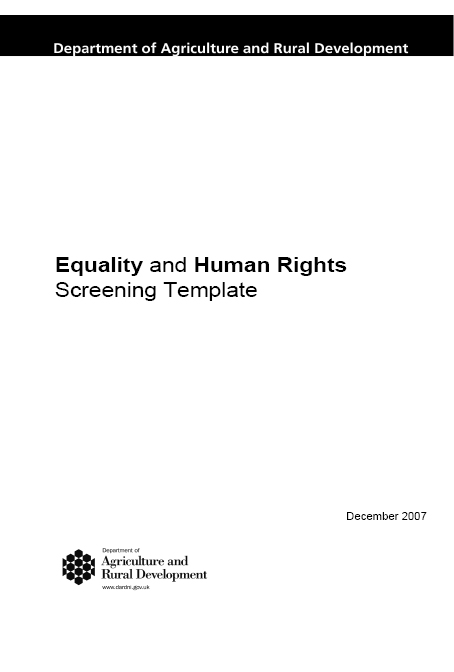
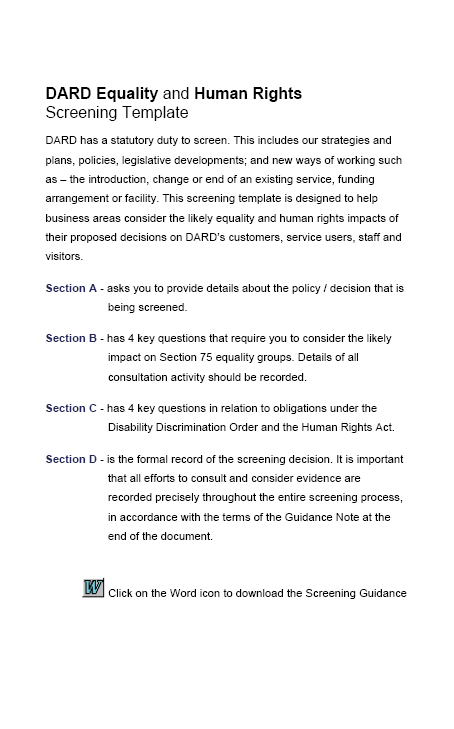
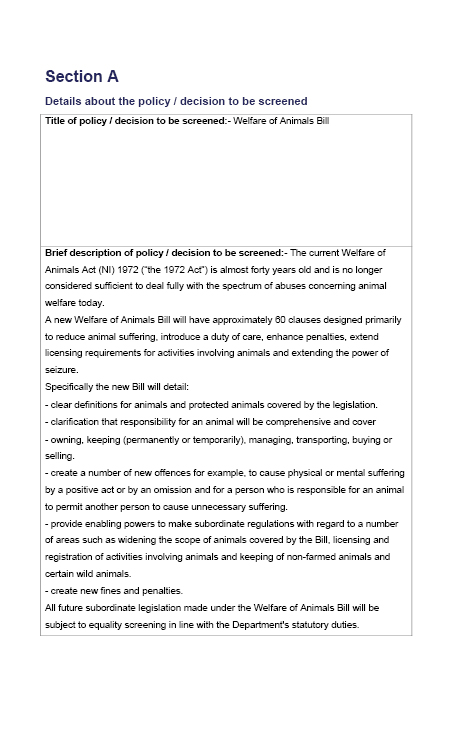
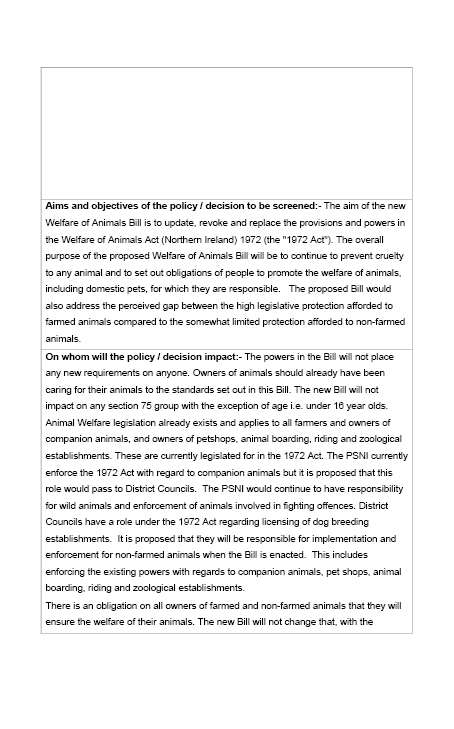
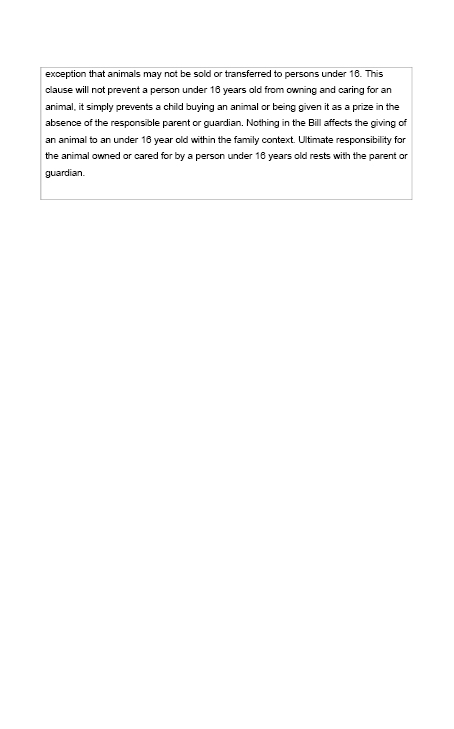
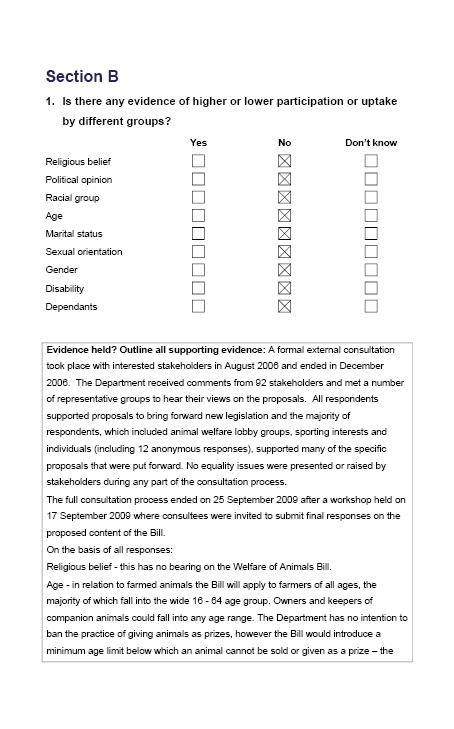
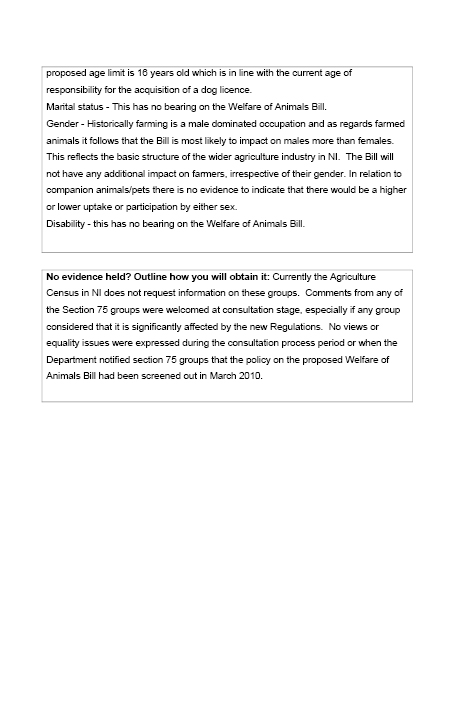
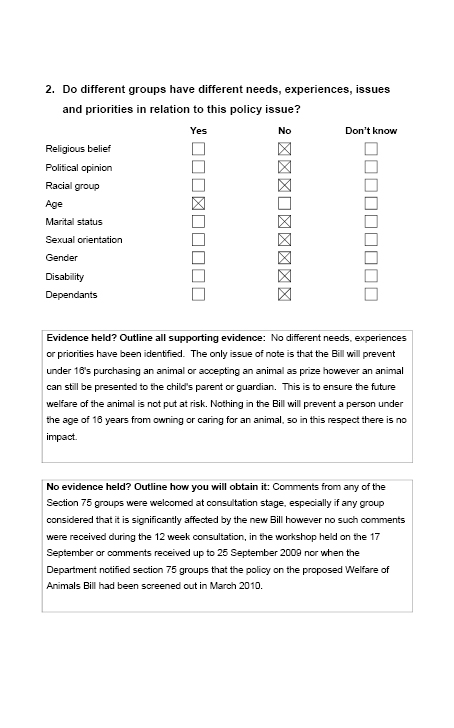
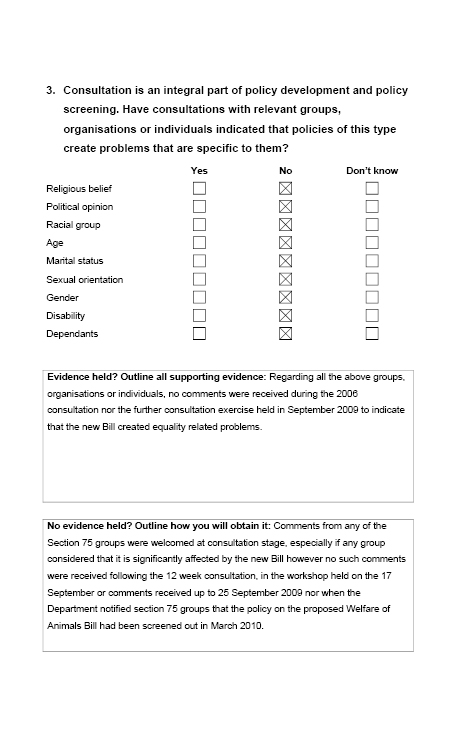
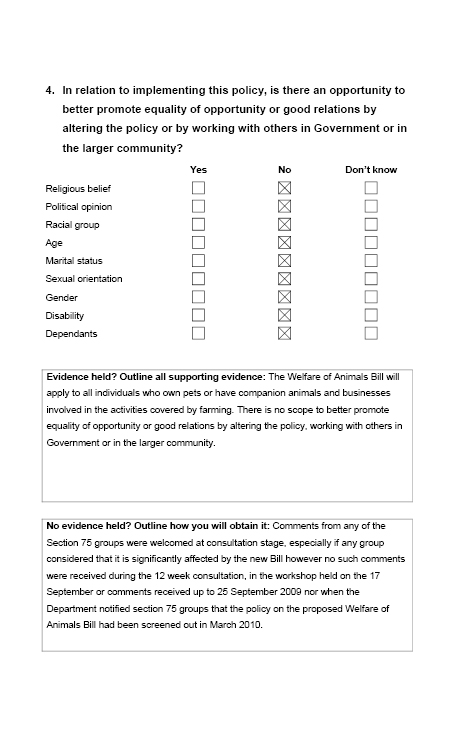
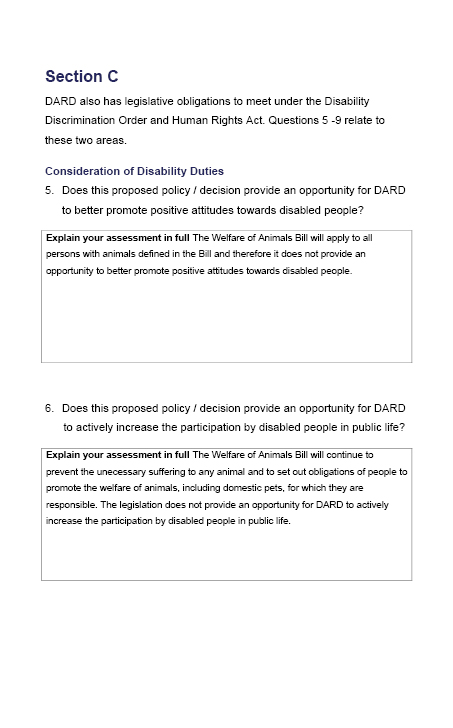
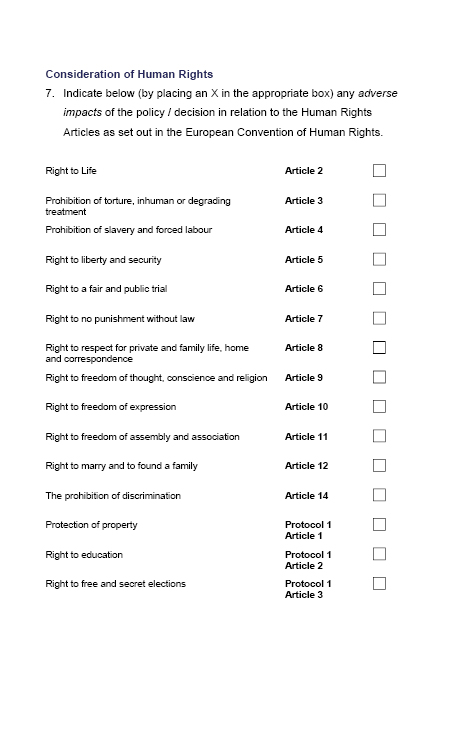
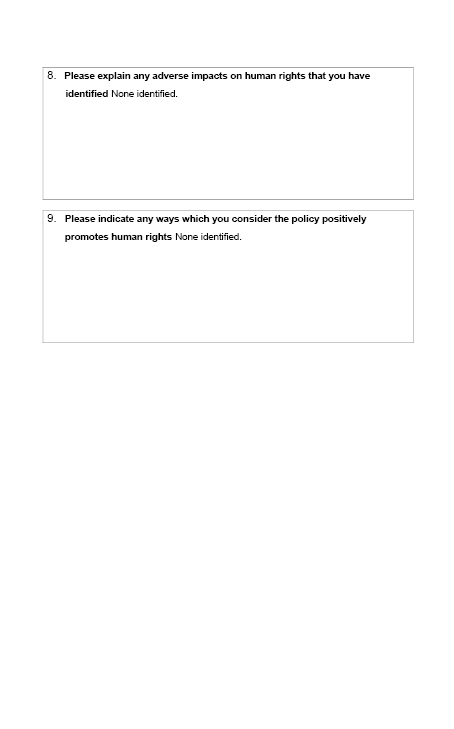
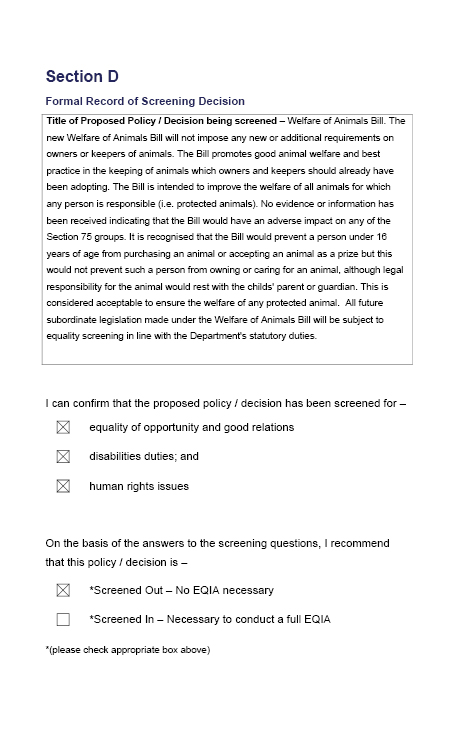
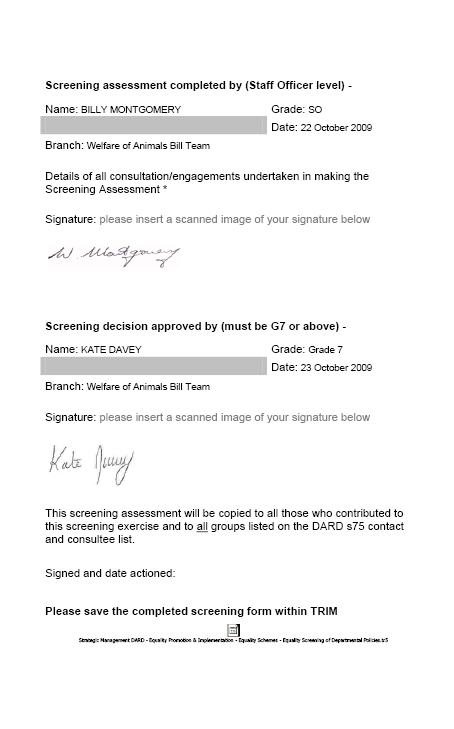
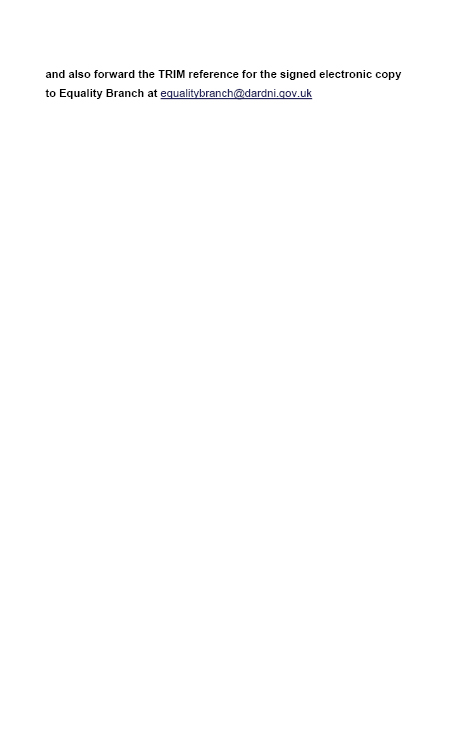
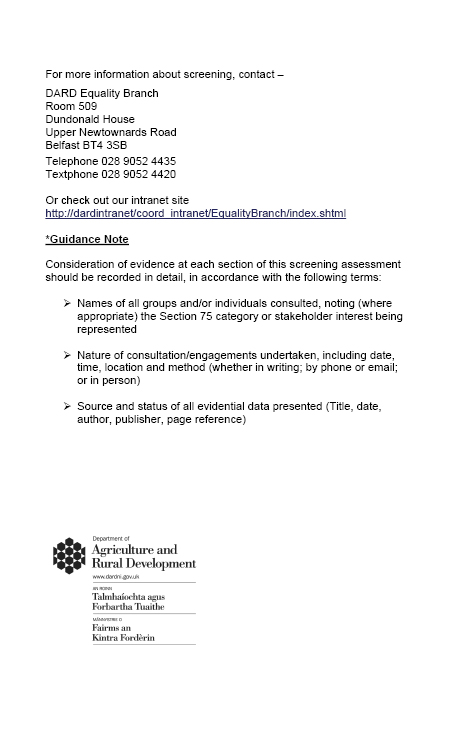
Section 5 (5) (b)
1. A procedure which is carried out for the purpose of diagnosis of disease.
2. A procedure which is carried out for the purpose of medical treatment of an animal.
Identification Procedures:
Ear clipping.
Ear notching.
Ear tagging.
Freeze branding.
Micro-chipping.
Tattooing.
Other methods of identification involving a mutilation required by law.
Procedures for the Control of Reproduction:
Castration.
Embryo and ovum transfer.
Implantation of a subcutaneous contraceptive.
Vasectomy.
Other Management Procedures:
Dehorning.
Disbudding.
Nose ringing.
Removal of supernumerary teats.
Identification Procedures:
Ear clipping.
Ear notching.
Ear tagging.
Micro-chipping.
Tattooing.
Other methods of identification involving a mutilation required by law.
Procedures for the Control of Reproduction:
Castration.
Implantation of a subcutaneous contraceptive.
Embryo and ovum transfer.
Vasectomy.
Other Management Procedures:
Nose ringing.
Tail docking.
Tooth reduction.
Tusk trimming.
Identification Procedures:
Micro-chipping.
Neck tagging
Wing tagging
Web tagging
Web notching
Other methods of identification involving a mutilation required by law.
Procedures for the Control of Reproduction:
Castration.
Implantation of a subcutaneous contraceptive.
Ovidectomy.
Vasectomy.
Other Management Procedures:
Beak trimming of poultry.
Desnooding.
De-toeing of domestic fowl and turkeys.
Dubbing.
Laparoscopy.
Wing pinioning.
Identification Procedures:
Ear clipping.
Ear notching.
Ear tagging.
Micro-chipping.
Tattooing.
Other methods of identification involving a mutilation required by law.
Procedures for the Control of Reproduction:
Castration.
Embryo and ovum transfer.
Implantation of a subcutaneous contraceptive.
Laparoscopic insemination.
Vasectomy.
Other Management Procedures:
Dehorning.
Disbudding.
Removal of the insensitive tip of the horn.
Tail docking.
Identification Procedures:
Ear clipping.
Ear notching.
Ear tagging.
Micro-chipping.
Tattooing.
Other methods of identification involving a mutilation required by law.
Procedures for the Control of Reproduction:
Castration.
Embryo and ovum transfer.
Implantation of a subcutaneous contraceptive.
Laparoscopic insemination.
Vasectomy.
Other Management Procedures:
Dehorning.
Disbudding.
Removal of the insensitive tip of the horn.
Identification Procedures:
Freeze branding.
Hot branding.
Micro-chipping.
Tattooing.
Other methods of identification involving a mutilation required by law.
Procedures for the Control of Reproduction:
Castration.
Embryo and ovum transfer.
Implantation of a subcutaneous contraceptive.
Vasectomy.
Identification Procedures:
Ear clipping.
Ear notching.
Ear tagging.
Micro-chipping.
Tattooing.
Other methods of identification involving a mutilation required by law.
Procedures for the Control of Reproduction:
Castration.
Implantation of a subcutaneous contraceptive.
Embryo and ovum transfer.
Vasectomy.
Other Management Procedures:
Removal of antlers that are not in velvet.
Identification Procedures:
Ear clipping.
Ear notching.
Ear tipping of feral cats.
Insertion of subcutaneous tracking devices.
Tagging.
Micro-chipping.
Tattooing.
Other methods of identification involving a mutilation required by law.
Procedures for the Control of Reproduction:
Castration.
Embryo and ovum transfer.
Implantation of a subcutaneous contraceptive.
Spaying.
Vasectomy
Other Management Procedures:
Laparoscopy.
Removal of the dew claws of dogs.
Identification Procedures:
Chemical branding.
Freeze branding.
Pit tagging
Micro-chipping.
Removal or perforation of parts of fishes' fins, adipose fins or fin rays.
Other Management Procedures:
Removal of fish scales.
Implantation of a subcutaneous contraceptive.
Reptiles
Identification Procedures:
Micro chipping
Procedures for the Control of Reproduction:
Implantation of a subcutaneous contraceptive.
Other Management Procedures:
Laparoscopy
Identification Procedures:
Micro chipping
Tattooing
Procedures for the Control of Reproduction:
Vasectomy
Castration
Spaying
Embryo and ovum transfer
Implantation of a subcutaneous contraceptive.
PART III
CATTLE: REQUIREMENTS WHEN CARRYING OUT CERTAIN PERMITTED PROCEDURES
When carried out on cattle, a procedure listed below must be carried out in accordance with the condition or conditions specified for that procedure.
When the method used is the application of a rubber ring or other device to constrict the flow of blood to the scrotum, the procedure may only be carried out on an animal aged before the second week of life or by any other means before the age of two months.
When any other method is used, an anaesthetic must be administered where the animal is aged 2 months or over.
An anaesthetic must be administered.
The procedure may not be carried out on a farmed animal.
The procedure may only be carried out as part of a conservation breeding programme.
An anaesthetic must be administered.
An anaesthetic must be administered.
The procedure may only be carried out on an animal aged not more than 6 months.
The disbudding of claves by chemical cauterisation before the second week of life.
When any other method is used an anaesthetic must be administered.
An anaesthetic must be administered where the animal is aged 3 months or over.
PART IV
PIGS: REQUIREMENTS WHEN CARRYING OUT CERTAIN PERMITTED PROCEDURES
When carried out on a pig, a procedure listed below must be carried out in accordance with the condition or conditions specified for that procedure.
Castration of pigs by the application of a rubber ring or other constricting device may only be carried out by a veterinary surgeon before the second week of life of the animal or by a person experienced in performing the techniques involved and who is either a person responsible for the animal or a person who is employed or engaged by such a person to attend to the animal. The method used must not involve the tearing of tissues.
Castration by any other means other than the application of a rubber ring or other constricting device to a pig, must be carried out by a veterinary surgeon before the age of 8 days .
An anaesthetic and additional prolonged analgesia must be administered where the animal is aged 7 days or over.
The procedure may not be carried out on a farmed animal.
The procedure may only be carried out as part of a conservation breeding programme.
An anaesthetic must be administered.
The procedure may only be carried out on an animal that is not kept continuously in an indoor husbandry system.
The procedure may only be carried out where measures to improve environmental conditions or management systems have first been taken to prevent tail-biting, but there is still evidence to show that injury to pigs' tails by biting has occurred.
Tail docking of pigs may be carried out by a person experienced in performing the techniques involved and who is either a person responsible for the animal or a person who is employed or engaged by such a person to attend to the animal before the second week of life without a anaesthetic as long as there is quick and complete severance of the part of the tail to be removed. A veterinary surgeon may dock the pigs tail, using an anaesthetic and additional prolonged analgesia, if the operation is necessary for reasons of health or to prevent injury from the vice of tail biting. The method used must not involve the tearing of tissues.
The procedure may only be carried out on an animal that is aged not more than 7 days.
The procedure must consist only of the uniform reduction of the corner teeth by either grinding or clipping so as to leave an intact smooth surface.
The procedure may only be carried out where measures to improve environmental conditions or management systems have first been taken to prevent tail-biting and other vices, but there is still evidence to show that injury to sows' teats or to other pigs' ears or tails by biting has occurred.
The procedure may only be carried out where there is evidence to show that it is necessary to prevent injury to other animals or for safety reasons.
PART V
BIRDS: REQUIREMENTS WHEN CARRYING OUT CERTAIN PERMITTED PROCEDURES
When carried out on a bird, a procedure listed below must be carried out in accordance with the condition or conditions specified for that procedure.
Except in the case of beak trimming (where the provision of paragraph 10 apply), no procedure listed in the section on birds in Part II may be performed on birds that are laying hens or that are intended to become laying hens unless that are kept on establishments with fewer than 350 such birds.
The procedure may only be carried out on farmed ducks and only where performed within 36 hours of hatching for the purposes of a breed improvement programme.
The procedure may only be carried out on farmed ducks and only where performed within 36 hours of hatching for the purposes of a breed improvement programme.
The procedure may only be carried out on farmed birds for the purposes of breed improvement programmes or testing for the presence of disease.
The procedure may only be carried out on birds other than farmed birds for conservation purposes (including education and captive breeding programmes) or for research.
The procedure may only be carried out on farmed birds for the purposes of breed improvement programmes or testing for the presence of disease.
The procedure may only be carried out on birds other than farmed birds for conservation purposes (including education and captive breeding programmes) or for research.".
The procedure may not be carried out on farmed birds.
The procedure may only be carried out as part of a conservation breeding programme.
An anaesthetic must be administered.
The procedure may not be carried out on farmed birds.
The procedure may only be carried out as part of a conservation breeding programme.
The procedure may not be carried out on farmed birds.
The procedure may only be carried out as part of a conservation breeding programme.
An anaesthetic must be administered.
The procedure may not be carried out on farmed birds.
The procedure may only be carried out as part of a conservation breeding programme.
An anaesthetic must be administered.
The procedure must be performed using a suitable instrument, and on-
(a) both the lower and upper beaks, with not more than one third of each removed, or
(b) the upper beak only, with not more than one third removed.
Any subsequent haemorrhage from the beak must be arrested by cauterisation.
On poultry that are intended to become laying hens and which are kept on establishments with 350 or more such poultry or laying hens, the procedure-
i. may only be carried out in order to prevent feather pecking or cannibalism;
ii. may not be performed on poultry that are intended to become laying hens (or which are laying hens) and which are 10 days or over.
iii. must be carried out by a person who has been provided with suitable and sufficient information, instruction and training so that they are qualified to perform the procedure; and
iv. may only be carried out using infra-red technology.
Where the turkey is aged not more than 21 days, the procedure may be carried out either by manual pinching-out or with a suitable instrument.
The procedure may not be carried out on a bird that is aged 3 days or over unless a veterinary surgeon considers that it is necessary that it be carried out.
An anaesthetic must be administered where the bird is aged 3 days or over.
The procedure may not be carried out on a bird that is aged 3 days or over unless a veterinary surgeon considers that it is necessary that it be carried out.
An anaesthetic must be administered where the bird is aged 3 days or over.
An anaesthetic must be administered.
The procedure may not be carried out on farmed animals.
An anaesthetic must be administered where the bird is aged 10 days or over.
PART VI
SHEEP: REQUIREMENTS WHEN CARRYING OUT CERTAIN PERMITTED PROCEDURES
When carried out on a sheep, a procedure listed below must be carried out in accordance with the condition or conditions specified for that procedure.
When the method used is the application of a rubber ring or other device to constrict the flow of blood to the scrotum, the procedure may only be carried out on an animal aged not more than 7 days.
When any other method is used, an anaesthetic must be administered where the animal is aged 3 months or over.
An anaesthetic must be administered.
The procedure may not be carried out on a farmed animal.
The procedure may only be carried out as part of a conservation breeding programme.
The procedure may only be carried out as part of a breed improvement programme.
An anaesthetic must be administered.
An anaesthetic must be administered.
An anaesthetic must be administered.
In all cases, enough of the tail must be retained to cover the vulva of a female animal or the anus of a male animal.
When the method used is the application of a rubber ring or other device to constrict the flow of blood to the tail, the procedure may only be carried out on an animal before the second week of life, or by any other means before the age of three months.
When any other method is used an anaesthetic must be administered.
PART VII
GOATS: REQUIREMENTS WHEN CARRYING OUT CERTAIN PERMITTED PROCEDURES
When carried out on a goat, a procedure listed below must be carried out in accordance with the condition or conditions specified for that procedure.
When the method used is the application of a rubber ring or other device to constrict the flow of blood to the scrotum, the procedure may only be carried out on an animal before the second week of life or by any other means before the age of two months.
When any other method is used, an anaesthetic must be administered where the animal is aged 2 months or over.
An anaesthetic must be administered
The procedure may not be carried out on a farmed animal.
The procedure may only be carried out as part of a conservation breeding programme.
The procedure may only be carried out as part of a breed improvement programme.
An anaesthetic must be administered.
An anaesthetic must be administered.
An anaesthetic must be administered.
PART VIII
HORSES: REQUIREMENTS WHEN CARRYING OUT CERTAIN PERMITTED PROCEDURES
When carried out on a horse, a procedure listed below must be carried out in accordance with the condition or conditions specified for that procedure.
An anaesthetic must be administered.
An anaesthetic must be administered.
PART IX
DEER: REQUIREMENTS WHEN CARRYING OUT CERTAIN PERMITTED PROCEDURES
When carried out on a deer, a procedure listed below must be carried out in accordance with the condition or conditions specified for that procedure.
An anaesthetic must be administered.
The procedure may not be carried out on farmed deer.
The procedure may only be carried out as part of a conservation breeding programme.
An anaesthetic must be administered.
The procedure may only be carried out on farmed deer or deer that are kept on land in the same manner as if they were farmed deer.
Only the non-sensitive part of the antler may be removed.
PART X
CATS and DOGS: REQUIREMENTS WHEN CARRYING OUT CERTAIN PERMITTED PROCEDURES
When carried out on a cat or dog, a procedure listed below must be carried out in accordance with the condition or conditions specified for that procedure.
An anaesthetic must be administered.
An anaesthetic must be administered.
The procedure may only be carried out as part of a conservation breeding programme.
An anaesthetic must be administered.
The procedure may not be carried out on a farmed animal.
The procedure may only be carried out as part of a conservation breeding programme.
An anaesthetic must be administered.
An anaesthetic must be administered.
The procedure may only be carried out as part of a conservation breeding programme.
In either case, an anaesthetic must be administered.
An anaesthetic must be administered except where the dog is a puppy and before its eyes are open.
PART XI
When carried out on a fish, a procedure listed below must be carried out in accordance with the condition or conditions specified for that procedure.
Removal of fish scales.
The procedure may only be carried out for the purposes of age determination.
PART XII
When carried out on an animal other than one dealt with in any of Parts III to XI, a procedure listed below must be carried out in accordance with the condition or conditions specified for that procedure.
An anaesthetic must be administered.
An anaesthetic must be administered.
An anaesthetic must be administered.
The procedure may only be carried out as part of a conservation breeding programme.
An anaesthetic must be administered.
The procedure may not be carried out on a farmed animal.
The procedure may only be carried out as part of a conservation breeding programme.
Welfare of Animals Bill – amendment to clause 5
The revised Clauses 5(5) to (7) should be carried forward as an amendment in the Bill, as follows –
"(5) This section does not apply in relation to -
(a) any procedure carried out by a veterinary surgeon;
(b) any procedure which is carried out for the purpose of diagnosis of disease;
(c) any procedure which is carried out for the purpose of medical treatment of an animal;
(d) any other procedure which is specified in regulations made by the Department.
(6) Before making regulations under subsection (5), the Department must consult such persons appearing to the Department to represent relevant interests as the Department considers appropriate.
(7) Nothing in this section applies to the removal of the whole or part of a dog's tail (which is dealt with in section 6)."
Welfare of Animals Bill Team
Room 807, Dundonald House
Upper Newtownards Road
Ballymiscaw
Belfast
BT4 3SB
Mr Paul Carlisle
Clerk to the ARD Committee
Parliament Buildings
Ballymiscaw
Stormont
BT4 3XX 8 November 2010
Telephone: 028 9052 4408
Fax: 028 9052 4982
Dear Paul
Thank you for your letter of 3 November 2010 in which you raised a number of issues. The Department's response to each issue is set out below.
Officials advised the Committee last week that the Minister was considering the Committee's request to either remove Clause 6 from the Bill or to provide an exemption for working dogs. I can now advise that, at the Minister's request, a meeting was held with the Committee Chair and Deputy Chair to discuss this issue on Monday 8 November. The Minister advised that she would be extremely concerned if Clause 6 was removed from the Bill as it would allow the totally unacceptable practice of cosmetic tail docking of dogs. While the Minister considers that there is inconclusive evidence to justify an exemption for working dogs, she is prepared to accede to the Committee's request to provide an exemption from tail docking for certain working dogs in the following specific circumstances.
The basis of the exemption would have to take account of lessons learned from existing tail docking exemptions in England and Wales. Therefore the Minister has advised that the only exemption she would be prepared to consider would be restricted to purebred spaniels and hunt point retriever breeds involved in lawful pest control or lawful shooting of animals. She has made it clear that the exemption would not be extended to terriers, as no documentary evidence whatsoever has been produced in respect of injuries to terriers' tails. The Minister also advised that this exemption would have stricter controls in order to address the loopholes in the legislation in England and Wales. While the exemption would be framed on the face of the Bill, the detail would be set out in subordinate legislation which would be subject to full public consultation and made by affirmative resolution.
The Minister also raised with the Committee Chair and Deputy Chair the issue of the proposed enforcement role for Councils in respect of non-farmed animals and they have agreed to meet again for further discussion on how best to take forward this issue.
We note the Committee's view that the remit for enforcement of dog breeding establishments should in the future rest with the Department. The current position is that the licensing of dog breeding establishments rests with District Councils. This has been the case since at least 1983 when the Dogs (Breeding Establishments and Guard Dog Kennels) Regulations came into operation. Clause 12 of the Bill will allow the Department to introduce new legislation on dog breeding establishments and we have given an undertaking to make this one of the first new pieces of subordinate legislation. Whilst District Councils are currently responsible for dog breeding establishments, the enforcement role is an aspect which could be considered when drafting the new subordinate legislation. That legislation would be subject to the full consultation process to seek the views from stakeholders, including District Councils. You may wish to know that the Department held a meeting on 28 October 2010 with District Council representatives from SOLACE and NILGA during which the future dog breeding legislation was discussed. The council representatives welcomed the fact that new subordinate legislation would be on a full cost recovery basis and that they would be able to recover their costs in respect of licensing of dog breeding establishments, which is not the case at present. I attach, at Annex A, a paper setting out the policy principles for consideration before the drafting of subordinate legislation under the new Act. These have been agreed with the Minister.
Query 2 on the Query Sheet resulting from the 2 November 2010 meeting with the Committee requested that the Department provides the Committee with minutes/notes of the meeting recently held with NILGA and SOLACE. I wish to advise that the note of that meeting, which took place on 28 October 2010, is attached at Annex B.
I will write to you separately on any remaining issues and in the meantime we are happy to answer any further questions the Committee may have.
Yours sincerely

Kate Davey
Welfare of Animals Bill Team
Attachment:
Annex A – Policy principles for dog breeding legislation
Annex B - Note of meeting with NILGA and Solace on 28 November 2010
1. Dog breeding establishments have come under scrutiny in recent years due to increased commercial breeding and the creation of 'designer breeds' both in Northern Ireland and further afield. Previously, it was thought that Northern Ireland did not have a significant commercial dog breeding problem and in any event that current legislation in the Welfare of Animals Act 1972 was sufficient to deal with any blatant cruelty cases should they arise. However, responses to the 2006 consultation on the proposed Welfare of Animals Bill indicated unanimous support for further regulation of dog breeding establishments to improve welfare standards.
2. Currently, providing premises comply with the Dogs (Breeding Establishments and Guard Dog Kennels) Regulations (NI) 1983, intensive commercial breeding is not an illegal activity. Dog breeding establishments are registered annually by district councils and where an establishment does not meet certain standards, registration is refused. These Regulations are however less stringent than the GB legislation, i.e. the Breeding of Dogs Act 1973 and the updated Breeding and Sale of Dogs (Welfare) Act 1999, which effectively rendered the intensive breeding of puppies illegal.
3. The proposed policy has to find the right balance of provisions which will encourage legitimate breeders to comply and also provide a strong deterrent to stop illegal commercial breeding activities.
4. The current legislation governing Breeding Establishments is covered in the:
5. Primary powers currently exist in the Dogs (NI) Order 1983 governing licensing, registration (including breeding establishments), dog control and enforcement. As new primary powers will be provided in the Welfare of Animals Bill to licence or register any activity involving animals, it is intended that new breeding establishments legislation would be introduced after the Bill is enacted, which would at the same time repeal the legislation-making provisions in the Dogs Order, articles 12 and 13. Proposals set out in this paper will be subject to further development and consultation with stakeholders at the appropriate time. Regulations on dog breeding would be intended to improve the welfare standards in which dogs in such establishments are kept, and to deal effectively with concerns over intensive commercial breeding.
6. The policy in respect of commercial breeding establishments will however need to ensure that legal breeders are not penalised following the introduction of new enforcement and inspection measures with which they will need to comply, while tackling those breeders who do not apply sufficient welfare standards to animals in their care. The qualifying criteria for licensing, for instance the number of bitches and litters per year, staff / bitch ratio, etc, will also form an intrinsic part of new policy.
7. The five freedoms set out in the Welfare of Animals Bill will underpin the new policy. This not only includes the construction of buildings (i.e. that they comply with certain building conditions) but also ensuring that the dogs have suitable housing including a "view" from their kennel, as opposed to being contained in isolation by brick or corrugated walls. A code of practice may also be introduced if considered necessary.
8. Fines and penalties for offences against the new policy are set out in clause 31 of the Welfare of Animals Bill. Subordinate legislation will introduce new offences. Where fees or other charges are introduced, for example for licensing or registration, these should be on a full cost recovery basis, so there is no additional financial burden on district councils. All proposed fees or charges would be subject to stakeholder consultation.
9. The Breeding Establishment Regulations largely focus on the minimum requirements for registration and operation and are largely reflective of the five freedoms e.g. construction and size of pen, food, ventilation, lighting, bedding, exercise, etc. They do not tackle any of the core issues surrounding the requirements for a revision of the breeding regulations, such as the need to control intensive commercial breeding. The main aspects to be considered for inclusion in subordinate legislation are as follows:
10. In GB, the current legislation is the Breeding of Dogs Act 1973 (as amended). The Act applies in England, Scotland and Wales and provides that bitches are not mated until they are at least one year old, that they give birth to no more than six litters in a lifetime and they do not exceed more than one litter per year. Accurate breeding records must be maintained by the breeding establishment and there are tighter controls on the sale of dogs by dealers and pet shops, for identification of traded dogs, and stiffer penalties, including imprisonment.
11. It was recognised by the Welsh Assembly Government that there are deficiencies in the legislation and plans are in place to introduce new legislation and statutory guidance on both dog breeding and licensing in Wales. On the 21 October Welsh Assembly Government launched a 12 week public consultation on their proposed new Animal Welfare (Breeding of Dogs) (Wales) Regulations 2011. See Part I of Annex A for detail on key issues included in the draft Welsh legislation. There are no known plans to amend the legislation in England and Scotland.
12. An independent inquiry by Sir Patrick Bateson into Dog Breeding was published in January 2010. The Associate Parliamentary Group for Animal Welfare also published a report in November 2009. Several recommendations were made which are listed in Part II of Annex A.
13. In Ireland, the Dog Breeding Establishments Act 2009 was passed in July 2010 however no commencement orders have been made. A list of the key provisions in the 2009 Act is shown in Part III of Annex A.
14. Following enactment of the Welfare of Animals Bill in 2011, the Department intends to include in its legislative programme for 2011/12 new dog breeding legislation to improve the welfare standards for breeding bitches and their pups and tighten up the law on commercial dog breeding facilities. We may have to take into account any future EU legislation where this impacts on dog breeding establishments. This could therefore influence the timeframe for the new legislation.
The proposed changes set out in the draft legislation include:
In an independent inquiry into Dog Breeding by Professor Sir Patrick Bateson FRS of University of Cambridge funded but conducted independently of Dogs Trust and the Kennel Club several recommendations were made. The inquiry was anonymously peer reviewed by five experts in three scientific fields. Amongst several recommendations were:
In a report by the Associate Parliamentary Group for Animal Welfare published November 2009 it was recommended that:
The Act defines a breeding establishment as a premises at which bitches are kept, not less than 6 of which are more than 6 months old, and capable of being used for breeding purposes. Persons guilty of offences shall be liable on summary conviction, to a fine not exceeding €5,000 or imprisonment for a term not exceeding 6 months or both, or on conviction on indictment, to a fine not exceeding €100,000 or imprisonment for a term not exceeding 5 years or both.
The other main provisions in the Act are:
A number of derogations apply to the Breeding Establishment Act. The most common of which is that the Bill does not apply to hunt clubs.
| England Scotland and Wales Breeding of Dogs Act 1973 (as amended) | Ireland Dog Breeding Establishments Bill 2009 | Wales Draft Animal Welfare (Breeding of Dogs) (Wales) Regulations 2011 | |
| Definition of dog breeding establishment | A person carries on a business of breeding dogs for sale and sells some of the pups. Where a person keeps a bitch at any premises at any time during any period of twelve months; and the bitch gives birth to a litter of puppies at any time during that period he shall be treated as carrying on a business of breeding dogs for sale at the premises throughout the period if a total of four or more other litters is born during the twelve month period. | A premises at which bitches are kept, not less than 6 of which are— (a) more than 6 months old, and (b) capable of being used for breeding purposes, but shall not include a local authority dog pound. | A person keeps 3 or more breeding bitches and breeds 2 or more litters of puppies in any 12 month period; advertises 10 or more puppies for sale in a 12 month period; supplies 10 or more puppies for sale in a 12 month period; advertises a business of breeding or selling puppies occupies premises which holds a planning consent authorising dog breeding: or keeps 3 or more breeding bitches in kennel accommodation which an Inspector reasonably believes is consistent with commercial dog breeding. |
| Fixed Payment Notice/Penalties | No | A fixed notice fine can be issued for non display of a registration certificate not exceeding €2,000. | No. |
| Requirement to keep a Register / Licensing of breeding establishments | Breeding establishments will be licensed by local authority and a person shall not keep an establishment unless licensed. The local authority shall consider if the dogs will have suitable accommodation and are in line with the five freedoms Bitches are not mated if they are less than 1 year old, Bitches do not give birth to more than 6 litters of pups each, there is a clear period of 12 months from they last delivered. Licensing will be annual. Records must be kept and be available for inspection. | A register of dog breeding establishments must be kept and requires operators to register and pay an annual fee. Bitches do not give birth to more than 6 litters of pups each and not more than 3 litters are born in 3 years. Records must be kept and be available for inspection. | Breeding establishments will be licensed by local authority and a person shall not keep an establishment unless licensed. Owner must comply with 13 licensing conditions in respect of - Accommodation & environment, diet, normal behaviour, enhancement & enrichment, socialisation, health, mating, change of ownership, identification and record keeping. |
| Staff: dog ratio | No | No | No |
| Health Controls | No | No | No |
| Fees | Varies considerably between council areas e.g. £49 in one area and £133 in another. | Sliding scale based on number of bitches ranging from €400 to €3000 | Local Authorities will set fees but must not exceed reasonable cost of carrying out the activity. |
| Microchipping | No | Yes | Yes |
| Improvement notices | No | Yes | No |
| Closure notices | No | Yes | Power to revoke license |
Attendees:
DARD Council Officials
Colette McMaster Liam Hannaway (SOLACE)
Kate Davey Nora Winder (Act. CE of NILGA)
Andrew Kell Gillian Topping (NILGA)
1. On Thursday 28 October 2010 the Department met with officials from SOLACE and NILGA. The Department referred to the 2006 consultation on the policy proposals, the stakeholder workshop that was held in Septermber 2009 and to the discussions in November 2009 with representatives of CEHOG, NILGA and SOLACE. The Department provided a comprehensive update on the progress of the Bill to date, the powers contained in the Bill and the proposal for District Councils to implement those powers in respect of non-farmed animals, including domestic pets and horses, and licensing and registration functions.
2. NILGA officials raised concern that enforcement work in respect of domestic pets and horses was going to be a function undertaken by Local Government, and thus funded by the taxpayer, and not passed to the USPCA in Northern Ireland, in line with the RSPCA undertaking this work in England & Wales. The Department advised that the animal welfare structures in both jurisdictions were entirely different. The USPCA was not structured or resourced in line with the RSPCA and it would simply not be in a position to take this work forward. Therefore there is no scope for the same arrangements as in England & Wales to be replicated in Northern Ireland. Council officials confirmed that this was their understanding also. They also made the point that councils did not fully appreciate from the original policy consultation in 2006 that it was proposed that district councils would take on an animal welfare enforcement role, i.e. beyond the licensing and registration function. They raised concern about the additional cost in accessing a veterinary surgeon for the more serious cases where animals are to be seized.
3. The Department advised that a bid has been submitted for £760,000 under Budget 2010 to assist district councils in implementing the Bill in respect of non-farmed animals. In confirming how this bid was formulated, the Department appraised council officials of enforcement of the equivalent legislation in England & Wales.
4. Based on the England & Wales welfare caseload the pro-rata equivalent for Northern Ireland would be in the range of 80 – 90 cases per week of which 50% could be unfounded and cleared either at the time of the call or by a quick visit. Of the remaining complaints, over 99% were resolved either by giving advice or by issuing an improvement notice with a follow up inspection if required. It was estimated that there could be approximately 4,600 animal welfare cases in Northern Ireland annually. Including the unfounded cases, this equates to 3 to 4 cases per week for each District Council (based on 26 Council areas).
5. Council officials were concerned that if these functions become the responsibility of district councils and funding was initially provided, in the current financial climate this funding could be removed in subsequent years and district councils could be left with the work but no funding. The Department acknowledged that there is considerable uncertainty regarding the availability of future funding.
6. The Department confirmed that any licensing and registration functions that transfer to district councils would be on a full cost recovery basis, which means there should be no additional financial burden on councils. Before any licensing or registration work transferred to District Councils new subordinate legislation would need to be made for each function and this would take time. The Department confirmed that one of the first pieces of subordinate legislation to be introduced following enactment of the Bill will be for Dog Breeding Establishments, which is already within the enforcement control of district councils. NILGA and SOLACE officials welcomed the fact that in the future they would be able to recover their costs in respect of the licensing of dog breeding establishments, which is not the case at present. Such legislation would undergo a full consultation and district councils would also have the opportunity to input to the development of the policy.
7. Council officials sought clarification on the permissive nature of the Bill as they understood that they had a choice to implement or not. The Department advised that based on recent legal advice, the powers in the Bill are 'permissive' in that they allow Councils discretion as to how they discharge these responsibilities, as best they can within their overall budget. Councils could not simply ignore the Bill and do nothing as it is a statutory instrument of the NI Assembly.
8. Council officials were advised that while the Bill would be enacted early next year, the provisions of the Bill would only come into force by commencement orders. Assurances were given that the Department would work with District Councils to ensure they have the necessary structures in place before the powers were commenced.
9. Discussions also covered how the welfare work could be implemented should district councils have responsibility for this work. The Department advised that it would be for the District Councils to either individually or collectively decide how the funding should be allocated and spent in implementing the welfare provisions for non-farmed animals. The Department suggested that for economies of scale and uniformity of approach enforcement work might be best implemented from a small number of locations as opposed to operating from each district council office. Council officials suggested that this could be possible using the current regional organisation split between the 5 areas in Northern Ireland (i.e. north, south, east, west and Belfast areas) as this structure was already used for other functions.
10. Council officials referred to a range of other new work that would go to district councils resulting from at least 4 other Assembly Bills e.g. High Hedges, Clean Neighbourhoods & Environment, Waste and Contaminated Land, and the Dogs Bill. The only one of these where it was proposed to provide additional resources was the Dogs Bill (through the dog licence fee).
11. Council officials suggested that it would be beneficial for DARD officials to make a presentation on the Bill, and the proposals for implementation, to a meeting of the Chief Executives of SOLACE on 5 November 2010.
Meeting ended at 4.10pm
Department of Agriculture & Rural Development
Welfare of Animals Bill Team
Dundonald House
Belfast
BT4 3SB
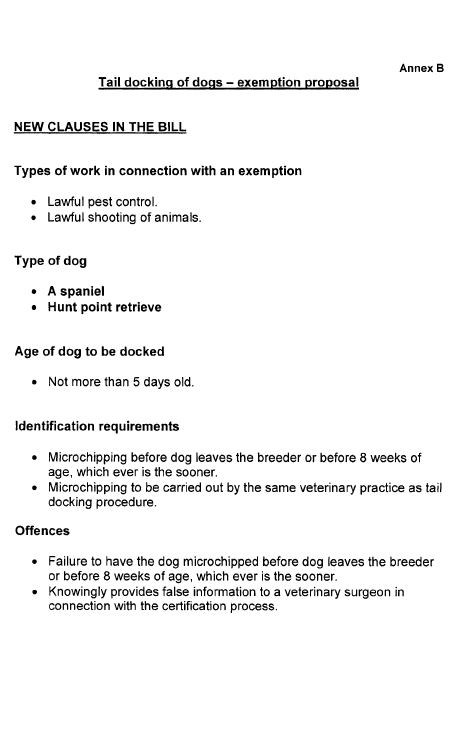
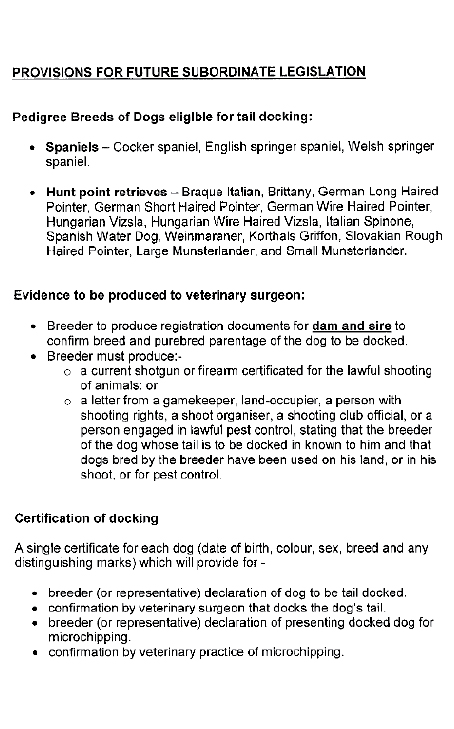

Mr Paul Carlisle |
Welfare of Animals Bill Team |
22 November 2010
Dear Paul,
In the clause by clause scrutiny on the 9 November we agreed to send the Committee the RSPCA Review of the Animal Welfare Act 2006 which highlights at Section 6 (Docking of Dogs' Tails) difficulties and good points that have been identified in the Animal Welfare Act 2006 by the RSPCA. I attach a copy of the Review.
With regard to clause 6 on tail docking the Committee Chairman indicated that it would be useful to see the text of any proposed amendment from the Department. The Committee was supplied with this amendment at the evidence gathering session held on the 16 November. May I draw to your attention a further minor amendment to clause 6 (attached at Annex A) at subsection (8). This is to ensure the dog (pup) is pure bred and therefore requires that the sire and dam are of the same breed and are registered as pedigree dogs.
I would also like to advise you of a minor typographical amendment to clause 45(3). It should state "in subsection (2)" as opposed to "in subsection (1)". For clarity I attach the full clause at Annex B.
I will write to you separately on any remaining issues and in the meantime we are happy to answer any further questions the Committee may have.
Yours sincerely

Kate Davey
Welfare of Animals Bill Team
Attachment: Annex A – RSPCA Review of the Animal Welfare Act 2006
Annex B – Amendment to Clause 6
Annex C - Amendment to Clause 45
(1) A person commits an offence if that person?
(a) removes the whole or any part of a dog's tail; or
(b) causes the whole or any part of a dog's tail to be removed by another person.
(2) A person commits an offence if?
(a) that person is responsible for a dog,
(b) another person removes the whole or any part of the dog's tail, and
(c) the first-mentioned person permitted that to happen or failed to take such steps (whether by way of supervising the other person or otherwise) as were reasonable in all the circumstances to prevent that happening.
(3) A person does not commit an offence under subsection (1) or (2) if the whole or any part of a dog's tail is removed?
(a) by a veterinary surgeon for the purpose of medical treatment; or
(b) in order to prevent or remove an immediate danger to the life of the dog in circumstances where it is not reasonably practicable to have the tail, or, as the case may be, any part of the tail, removed by a veterinary surgeon.
(4) Subsections (1) and (2) do not apply if the dog is a certified working dog that is not more than 5 days old.
(5) For the purposes of subsection (4), a dog is a certified working dog if a veterinary surgeon has certified, in accordance with regulations made by the Department, that the first, second and third conditions mentioned below are met.
(6) The first condition referred to in subsection (5) is that there has been produced to the veterinary surgeon such evidence as the Department may by regulations require for the purpose of showing that the dog is likely to be used for work in connection with lawful pest control or the lawful shooting of animals.
(7) The second condition referred to in subsection (5) is that the dog is?
(a) of a type of spaniel specified for the purposes of this subsection by regulations made by the Department; or
(b) of a type commonly used for hunting, pointing or retrieving and specified for the purposes of this subsection by regulations made by the Department.
(8) The third condition referred to in subsection (5) is that the dog and its sire and dam are registered as pedigree dogs with the Kennel Club, or with such other organisation as the Department may, by order, specify.
(9) It is a defence for a person accused of an offence under subsection (1) or (2) to show that that person reasonably believed that the dog was one in relation to which subsection (4) applies.
(10) A person commits an offence if that person?
(a) owns a subsection (4) dog, and
(b) fails to take reasonable steps to secure that, before the dog is [8 weeks] old, it is identified as a subsection (4) dog in accordance with regulations made by the Department.
(11) A person commits an offence if that person takes a dog, or causes a dog to be taken, from a place in Northern Ireland for the purpose of having the whole or any part of its tail removed, otherwise than for the purpose of medical treatment administered by a veterinary surgeon.
(12) A person commits an offence if?
(a) that person shows a dog at an event to which members of the public are admitted on payment of a fee,
(b) the dog's tail has been wholly or partly removed (in Northern Ireland or elsewhere), and
(c) the removal took place on or after the day on which this section comes into operation.
(13) Where a dog is shown only for the purpose of demonstrating its working ability, subsection (12) does not apply if the dog is a subsection (4) dog.
(14) It is a defence for a person accused of an offence under subsection (12) to show that that person reasonably believed?
(a) that the event was not one to which members of the public were admitted on payment of an entrance fee;
(b) that the removal took place before the day on which this section comes into operation; or
(c) that the dog was one in relation to which subsection (13) applies.
(15) A person commits an offence if that person knowingly gives false information to a veterinary surgeon in connection with the giving of a certificate for the purposes of this section.
(16) The Department may by regulations make provision about the functions of inspectors in relation to?
(a) certificates for the purposes of this section, and
(b) the identification of dogs as subsection (4) dogs.
(17) Before making regulations under this section, the Department must consult such persons appearing to the Department to represent any interests concerned as the Department considers appropriate.
(18) In this section -
"Kennel Club" means the club established for the registration of pedigree dogs in Great Britain and Northern Ireland;
"subsection (4) dog" means a dog whose tail has, on or after the commencement day, been wholly or partly removed without contravening subsection (1), because of the application of subsection (4).
*.?(1) In this Act, "inspector", in the context of any provision, means?
(a) in so far as that provision relates to farmed animals, a person appointed to be an inspector for the purposes of that provision by the Department;
(b) in so far as that provision relates to other animals, a person appointed to be an inspector for the purposes of that provision by a council.
(2) In subsection (1), "farmed animal" means any animal bred or kept for the production of food, wool or skin or for other farming purposes.
(3) The Department may by regulations amend the definition of "farmed animal" in subsection (2).
(4) Before making regulations under subsection (3), the Department must consult such persons appearing to the Department to represent relevant interests as the Department considers appropriate.
(5) In appointing a person to be an inspector for the purposes of this Act, a council must have regard to guidance issued by the Department.
(6) The Department may, in connection with guidance under subsection (5), draw up a list of persons whom the Department considers suitable for appointment by a council to be an inspector for the purposes of this Act.
(7) A person may be included in a list under subsection (6) as suitable for appointment as an inspector for all the purposes of this Act or only for such one or more of those purposes as may be specified in the list.
(8) Each council must furnish to the Department, at such times and in such manner as the Department may direct?
(a) such information relating to the exercise of the council's functions under this section; and
(b) such information relating to the exercise of functions by inspectors appointed by the council for the purposes of this Act,
as the Department may require.
(9) An inspector shall not be liable in any civil or criminal proceedings for anything done in the purported performance of the inspector's functions under this Act if the court is satisfied that the act was done in good faith and that there were reasonable grounds for doing it.
(10) Relief from liability of an inspector under subsection (9) shall not affect any liability of any other person in respect of the inspector's act.
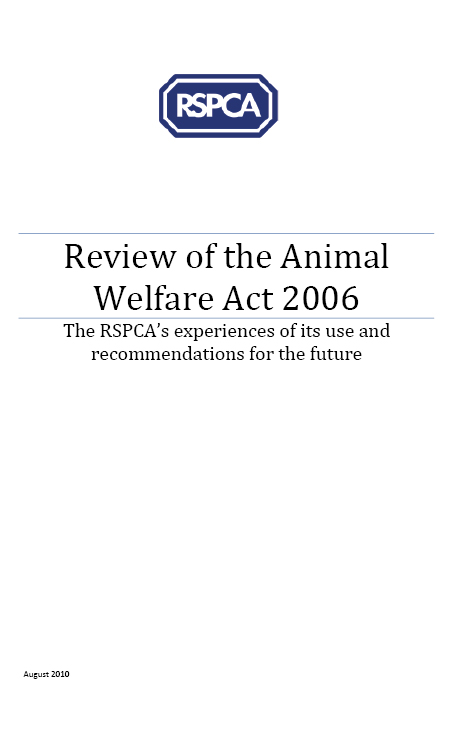
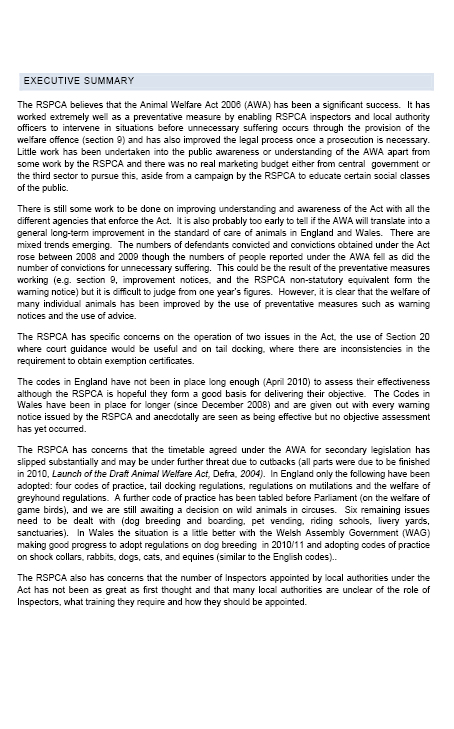
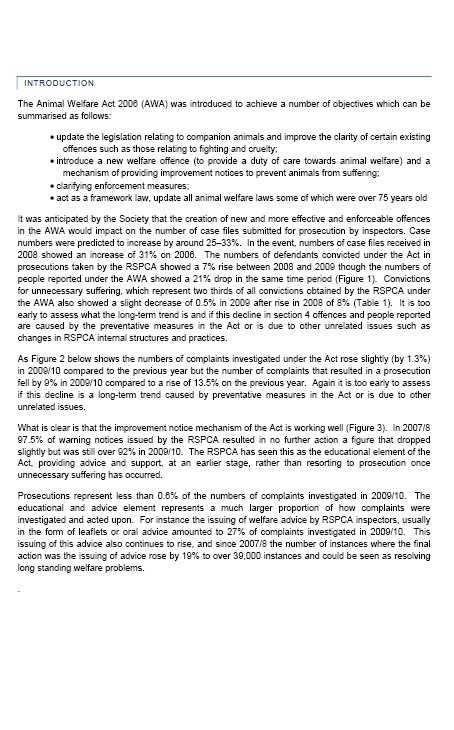
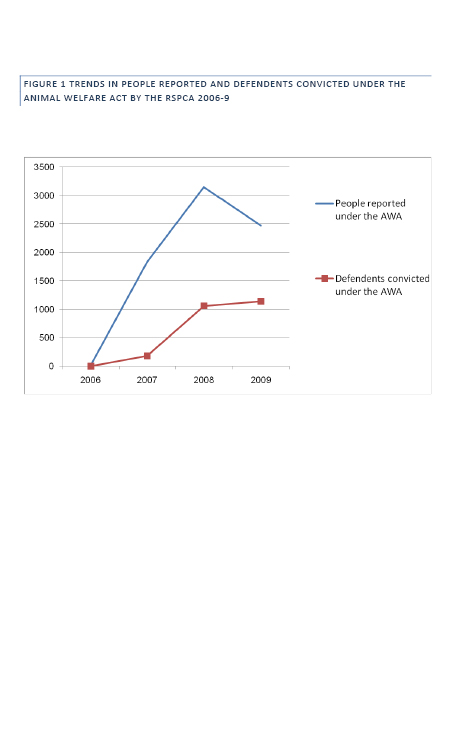
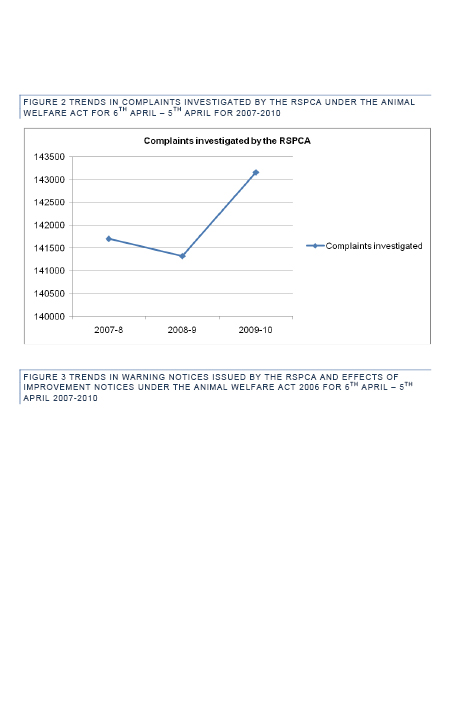
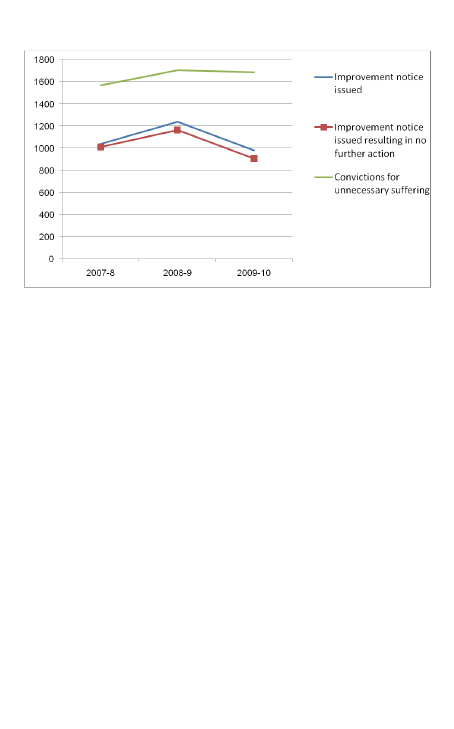
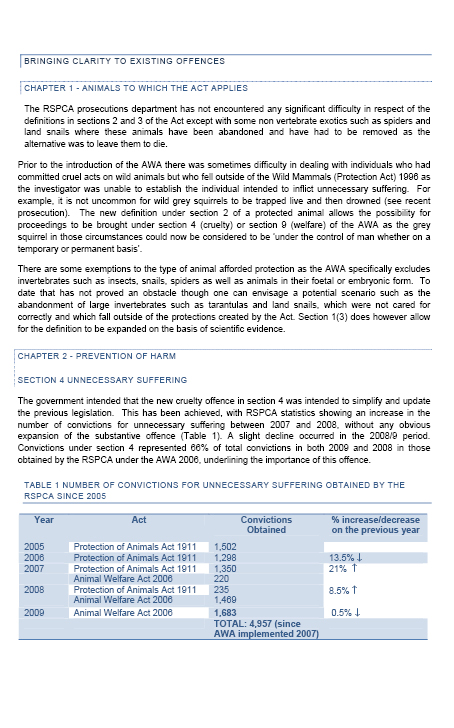
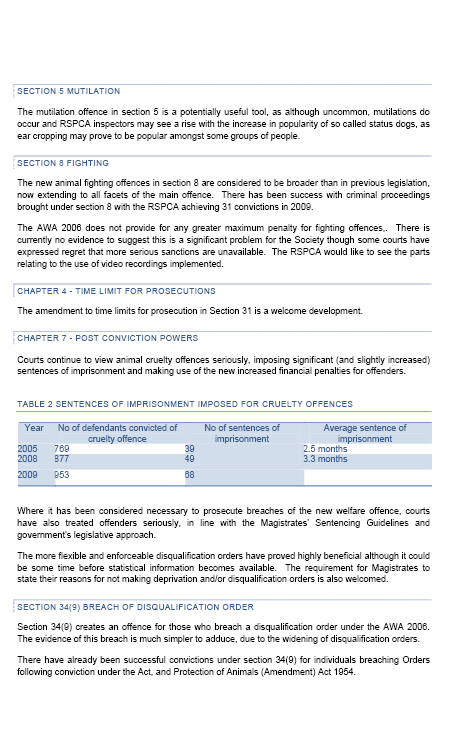
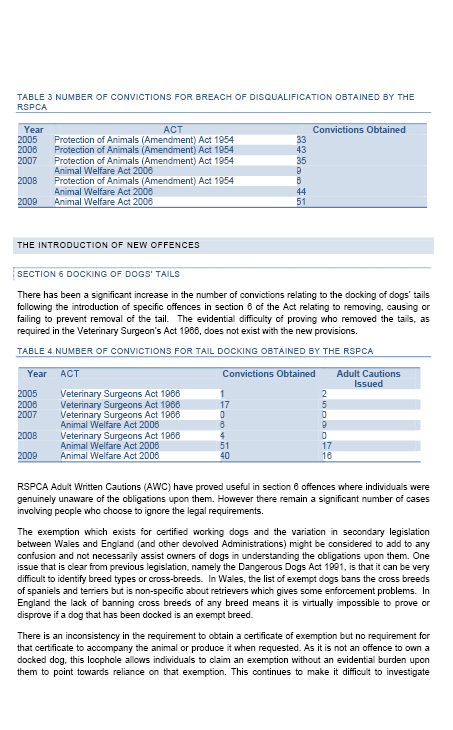
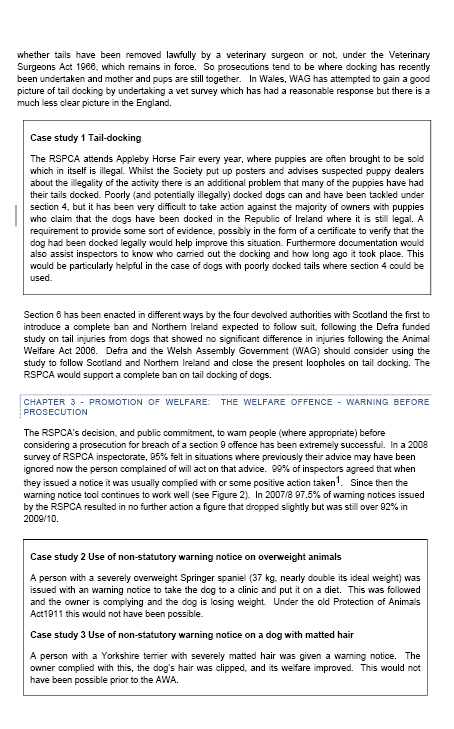
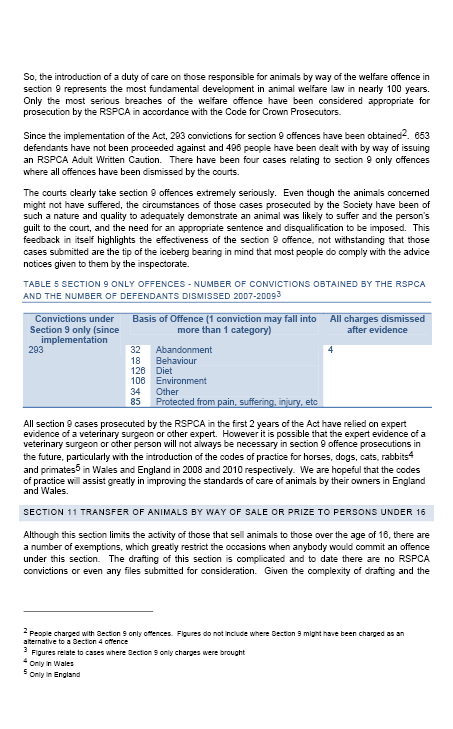
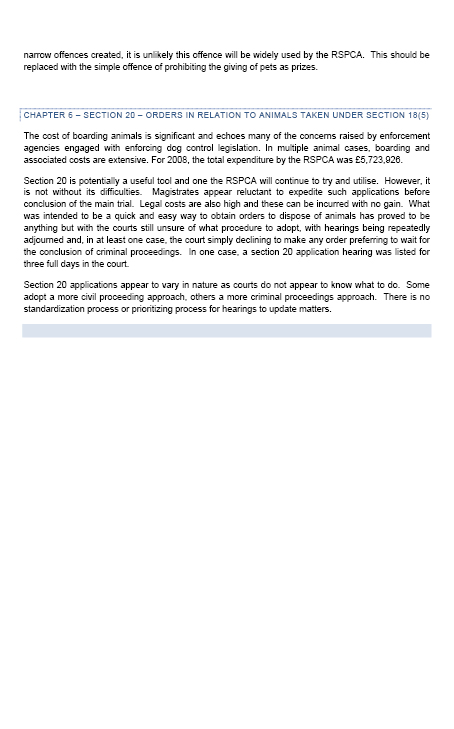
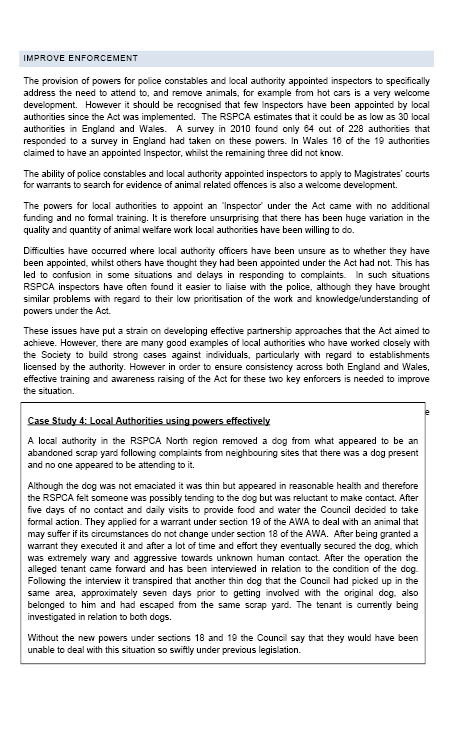
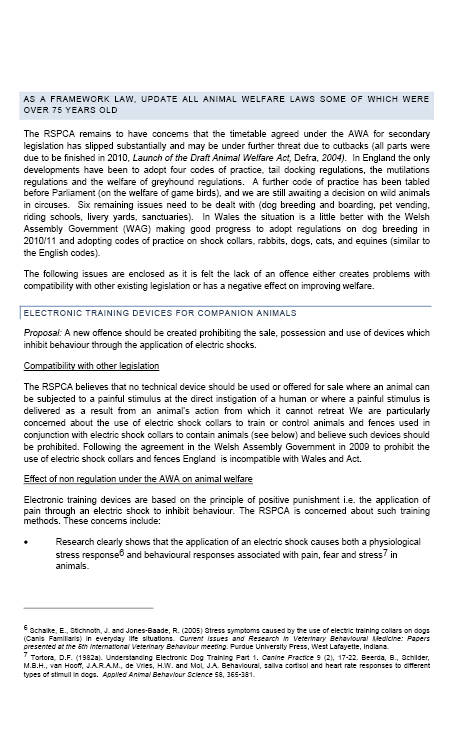
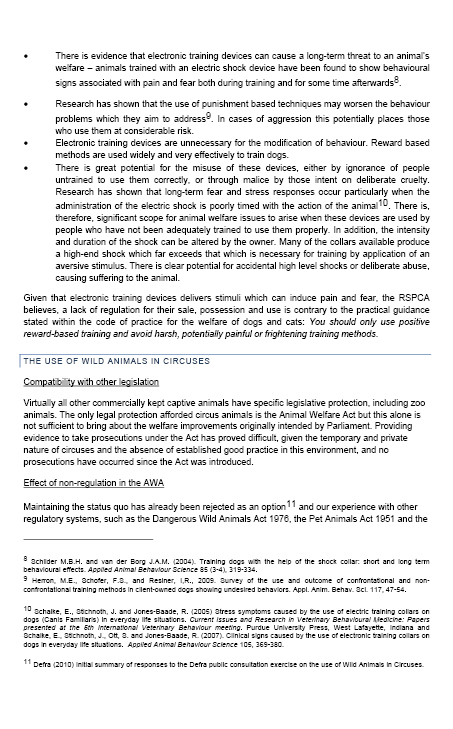
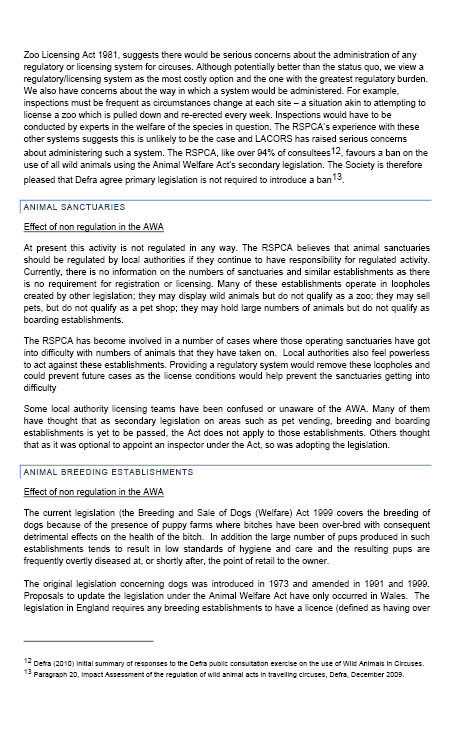
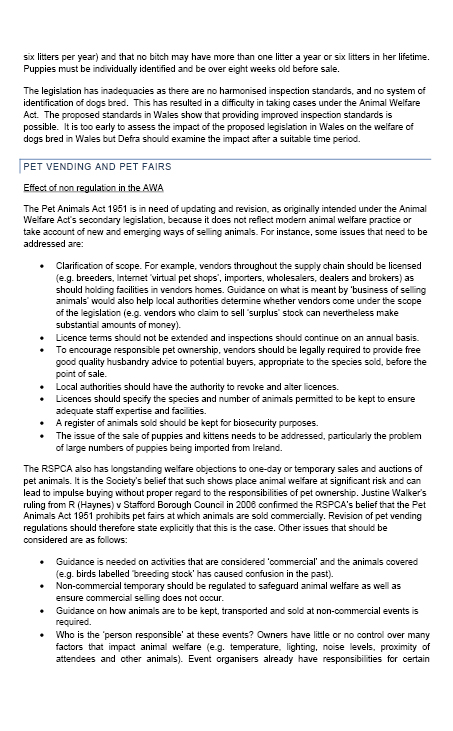
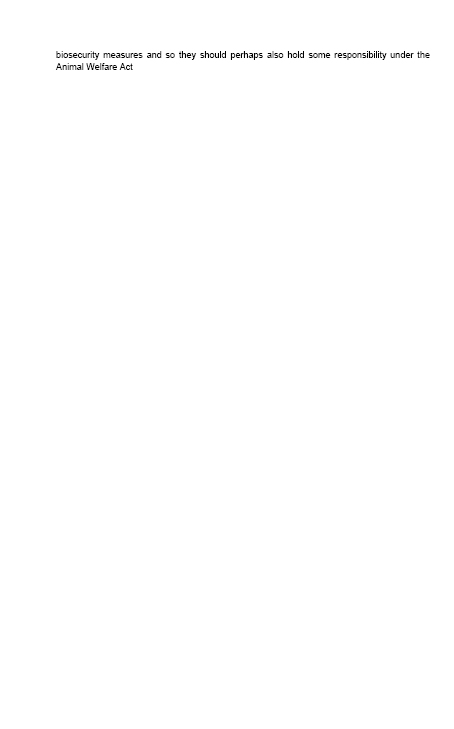
Your reference
Our reference
Mr Paul Carlisle |
Welfare of Animals Bill Team |
23 November 2010
Dear Paul
Thank you for your letter of 17 November 2010 in which you highlighted the Committee's concerns over the proposed tail docking exemption, the lack of consultation with elected members of local councils and the calculation and availability of long term funding for Councils to undertake enforcement powers in the Bill in respect of non-farmed animals.
You advised that Committee members have agreed that the Minister's proposed tail docking exemption is too restricted and that the specification of types of dogs to be included in the exemption should reflect Schedule 1 of the English regulations. Members have also agreed that exempting these dog types in conjunction with the additional controls that have been proposed in the Minister's exemption would ban cosmetic docking. The Committee has recommended this to the Minister and has asked for a response.
The Minister has been advised of the Committee's recommendation and I can advise that the Minister, following discussions she had yesterday with a number of Committee members, is prepared to remove the requirement for the sire and dam to be registered pedigree dogs, however both parents will still need to be purebreds of the same breed as the Minster is not prepared to extend her proposed exemption to include cross breeds. As no documented evidence has been produced to justify an exemption for terriers the Minister is not prepared to extend the exemption to cover any breed of terrier. As the Minister advised when she attended the Committee last Tuesday, she is prepared to provide an exemption only for dogs which are likely to be working dogs and which have an increased risk of tail injury. In addition we need to learn the lessons from England and Wales and close any loopholes in the legislation. Regarding cross breeds the RSPCA has advised and I quote "In England the lack of banning cross breeds of any breed means it is virtually impossible to prove or disprove if a dog that has been docked is an exempt breed". A copy of the RSPCA's report has already been sent to you.
With regard to the proposed role and funding for Councils, you advised that the Committee has recommended that clauses 12, 29 and 45 are laid dormant to allow for consultation with elected council members and that these clauses should only be enacted, or repealed, through the affirmative process following discussions on the long term resourcing of the proposed enforcement responsibilities. Again we have advised the Minister of the Committee's recommendation and I can advise that the Minster is not prepared to agree that these Clauses are left dormant. The Minister has also asked that we advise the Committee of the consequences of leaving these Clauses, in particular Clause 45, dormant.
Clause 45 provides powers for both the Department and Councils to appoint inspectors. If this Clause is made dormant, very few aspects of the Bill will be enforced. Neither the Department nor Councils would have the powers to appoint inspectors to investigate complaints and offences or to seize animals which are suffering or likely to suffer if their circumstances do not change under the Bill and no enforcement body could issue improvement notices. Only the PSNI would have any powers under the Bill, but they would have no powers to issue improvement notices.
The purpose of Clause 12 is to provide enabling powers to allow the Department to make subordinate legislation for the licensing and registration of activities involving animals. To make this provision dormant would mean that the Department could not, for example, bring forward any new legislation on dog breeding establishments, or indeed for any other activity involving animals. As specified in Clause 55(1), the Bill already provides that all subordinate legislation under Clause 12 can only be made using the draft affirmative procedure. In addition, in line with paragraph 2 of Schedule 2 each piece of subordinate legislation must state if the licensing authority is the Department or the Councils, so in effect the Committee and the Assembly will have control over what licensing function passes to Councils.
Clause 29 allows councils to prosecute offences under the new Act. This clause does not need to be made dormant for it to have no effect. Until such times as the Councils have the authority to appoint inspectors under Clause 45, they will not be able to avail of clause 29 in any event.
The Minister has asked that we reiterate the following assurances which she gave to the Committee last Tuesday:-
In order to give Councils the time to prepare for their enforcement role the Minister has proposed an amendment to Clause 45 which separates the enforcement roles of DARD inspectors in respect of farmed animals and Council inspectors in respect of non-farmed animals. This amendment will allow for the enforcement role for DARD inspectors (45(1) (a)) to be commenced immediately following enactment of the Bill and the enforcement role for Councils (45(1) (b)) to be commenced at a later date via a commencement order when the above assurances have been fulfilled.
In respect of the £760k funding for Councils the Minister and Department are committed to providing a baseline of £760k a year for the duration of the forthcoming budget period. We envisage this funding rolling forward into the budget period scheduled to begin on the 1 April 2015 and if that is not the case the Department will advise this Committee. Calculation of the amount of funding for Councils is based on actual case numbers provided by the RSPCA in England on a pro-rata population basis for NI.
It may also be beneficial for the Committee to know that the current powers in the Welfare of Animals Act (NI) 1972 in respect of cruelty offences which can provide protection to non-farmed animals will stay in place until Clause 45(1) (b) is commenced.
I am happy to discuss as necessary.
Yours sincerely

KATE DAVEY
Welfare of Animals Bill Team
Tel: 028 9052 4408
Welfare of Animals Bill Team
Room 807,
Dundonald House
Upper Newtownards Road
Ballymiscaw
Belfast
BT4 3SB
Telephone: 028 9052 4408
Fax: 028 9052 4982
Mr Paul Carlisle
Clerk to the ARD Committee
Parliament Buildings
Ballymiscaw
Stormont
BT4 3XX
29 November 2010
Dear Paul
Thank you for your letter of 23 November 2010 and for meeting with me at short notice on
24 November.
You have asked if the Department intends to amend clause 6 on the basis of the Minister's proposed exemption, or whether the intention is to revert to the original clause as introduced. I can confirm that the Minister is currently considering her position on this matter.
You advised that while the Committee has acknowledged the Minister's confirmation that £760,000 would be made available to councils for enforcement of the Bill in respect of non-farmed animals, members remain concerned as to whether the funding would continue, especially if the Departmental budgets are reprioritised in the future by a new Minister. The Committee has asked that the funding for Councils is ring-fenced for at least the period of the next CSR.
The Minister has asked that we reaffirm in writing the guarantees she gave to the Committee when she attended on the 16 November:
In response to the Committee's concerns about the security of the funding, the Minister and the Department are committed to providing a baseline of £760k a year for the duration of the forthcoming budget period. The Minister has included in Budget 2010 a bid for £760k per year to assist Councils with this work. She is prepared to give a firm commitment that, even if that bid is not successful, she guarantees that £760k per year will be allocated in the Department's budget. It will be put in a baseline for the next budget period to assist Councils with enforcement of the Bill in respect of non-farmed animals. The Minister has asked us to highlight to the Committee that any proposal to change the funding in the future would be advised to the Committee by officials and would be open to scrutiny by the Committee.
You advised that Committee members have asked that the Minister confirm that commencement of clauses 17, 29 and 45, which delegate enforcement and inspection responsibilities to local councils, will be deferred for a period of at least 12 months to allow for further consultation with elected Council Members.
It may be helpful to explain that while the Welfare of Animals Bill provides new powers in respect of non-farmed animals, it also provides powers in respect of farmed animals as it replaces the Welfare of Animals Act (NI) 1972. If Clause 45 is deferred the Department will have no power to appoint inspectors and effectively no power to implement any part of the Bill in respect of farmed animals. The Bill as introduced was drafted to apply to all animals irrespective of who undertakes enforcement, but the Minister has proposed a revised Clause 45 (copy provided to you on 23 November) to clearly identify and separate the areas of enforcement responsibility between the Department for farmed animals and Councils for other animals.
On the basis of the proposed revised Clause 45, it will be legally possible to commence the part of the clause which gives the Department power in respect of farmed animals and to defer commencement of the power for Councils to appoint inspectors in respect of other animals (i.e. non-farmed). This means that commencement of that part of clause 45 in respect of councils (i.e. 45 (1) (b)) can be started later.
Until clause 45(1) (b) is commenced, Councils will not be able to avail of any powers in the Bill, including clauses 17 and 29, therefore there is no need to defer these clauses as Councils will have no powers to use them. In addition, it is critical that clause 17, which relates to animals in distress, is not deferred as that would also prevent the Department from enforcing the Bill in respect of farmed animals in distress.
I can confirm that the Minister is prepared to give a firm commitment that sub-section (1) (b) of Clause 45 will not be commenced until 12 months from Royal Assent at which time it will be introduced by commencement order. This will allow Councils time to get the necessary resources, systems and procedures in place and be ready to implement the new powers before they come into force. If Councils advise the Department during this period that they are ready to start implementation of the powers in the Bill in respect of non-farmed animals sooner than 12 months from Royal Assent, earlier commencement of this sub-section may be considered.
I am happy to clarify further as necessary.
Yours sincerely

Kate Davey
Welfare of Animals Bill Team
55. - (1) No regulations shall be made under section 1, 5, 11, 12, 13 or 45 unless a draft of the regulations has been laid before, and approved by resolution of, the Assembly.
(2) Any regulations made by the Department under section 49 shall be subject to negative resolution.
(3) Any order or regulations made under this Act may contain such supplementary, consequential, transitional or saving provisions as the Department considers necessary or expedient.
Docking of dogs' tails
6. (1) A person commits an offence if that person —
(a) removes the whole or any part of a dog's tail; or
(b) causes the whole or any part of a dog's tail to be removed by another person
(2) A person commits an offence if —
(a) that person is responsible for a dog,
(b) another person removes the whole or any part of the dog's tail, and
(c) the first-mentioned person permitted that to happen or failed to take such steps (whether by way of supervising the other person or otherwise) as were reasonable in all the circumstances to prevent that happening.
(3) A person does not commit an offence under subsection (1) or (2) if the whole or any part of a dog's tail is removed —
(a) by a veterinary surgeon for the purpose of medical treatment; or
(b) in order to prevent or remove an immediate danger to the life of the dog in circumstances where it is not reasonably practicable to have the tail, or, as the case may be, any part of the tail, removed by a veterinary surgeon
(3) Subsections (1) and (2) do not apply if the dog is a certified working dog that is not more than 5 days old.
(4 For the purposes of subsection (3), a dog is a certified working dog if a veterinary surgeon has certified, in accordance with regulations made by the Department, that the first and second conditions mentioned below are met.
(5 The first condition referred to in subsection (4) is that there has been produced to the veterinary surgeon such evidence as the appropriate national authority may by regulations require for the purpose of showing that the dog is likely to be used for work in connection with —
(a) law enforcement,
(b) activities of Her Majesty's armed forces,
(d) lawful pest control, or
(e) the lawful shooting of animals.
(6) The second condition referred to in subsection (4) is that the dog is of a type specified in Schedule 6 for the purposes of this subsection by regulations made by the Department.
(7) It is a defence for a person accused of an offence under subsection (1) or (2) to show that he reasonably believed that the dog was one in relation to which subsection (3) applies.
(8) A person commits an offence if —
(a) he owns a subsection (3) dog, and
(b) fails to take reasonable steps to secure that, before the dog is 8 weeks old, it is identified as a subsection (3) dog in accordance with regulations made by the Department.
(9) A person commits an offence if —
(a) he shows a dog at an event to which members of the public are admitted on payment of a fee,
(b) the dog's tail has been wholly or partly removed (in England and Wales or elsewhere), and
(c) removal took place on or after the commencement day.
(10) Where a dog is shown only for the purpose of demonstrating its working ability, subsection (9) does not apply if the dog is a subsection (3) dog.
(11) It is a defence for a person accused of an offence under subsection (9) to show that he reasonably believed —
(a) that the event was not one to which members of the public were admitted on payment of an entrance fee,
(b) that the removal took place before the commencement day, or
(c) that the dog was one in relation to which subsection (10) applies.
(12) A person commits an offence if he knowingly gives false information to a veterinary surgeon in connection with the giving of a certificate for the purposes of this section.
(13) The appropriate national authority may by regulations make provision about the functions of inspectors in relation to —
(a) certificates for the purposes of this section, and
(b) the identification of dogs as subsection (3) dogs.
(14) Power to make regulations under this section includes power —
(a ) to make different provision for different cases, and
(b) to make incidental, supplementary, consequential or transitional provision or savings.
(15) Before making regulations under this section, the appropriate national authority shall consult such persons appearing to the authority to represent any interests concerned as the authority considers appropriate.
(16) In this section —
Schedule 6
Hunt point retrieve breeds of any type or combination of types
Spaniels of any type or combination of types
Terriers of any type or combination of types
Welfare of Animals Bill Team
Room 807, Dundonald House
Upper Newtownards Road
Ballymiscaw
Belfast BT4 3SB
Telephone: 028 9052 4408
Fax: 028 9052 4982
Mr Paul Carlisle
Clerk to the ARD Committee
Parliament Buildings
Ballymiscaw
Stormont
BT4 3XX
10 December 2010
Dear Paul
Thank you for your letter of 8 December 2010 in which you ask for confirmation of the outcome of the Department's legal advice on the use of the word breed instead of type.
The Department fully appreciates it will be for the Committee to decide the wording of their proposed amendment to Clause 6 but to help future enforcement should the Assembly decide to support the Committee's amendment I discussed the draft of the Committee's amendment with our legal advisor.
Whilst I appreciate the wording of the Committee's amendment is in line with the English exemption, the Department's concern focuses around the term "hunt point retrieve breeds". In a legal context there is no such thing as hunt point retrieve breeds. Legislation as a rule should avoid what might be considered insider jargon, as it will inevitably be applied and construed in different ways by non-insiders. It may help put this in context to first to define type and breed.
Type describes the classification of dogs by broad function or utility, either current or historic.
Breed is the classification of dogs by common ancestry, heritage and pedigree.
For example a "spaniel" is a type, and English Springer is a breed.
As regards the term "hunt point retrieves dogs"; there is a type of dog used for hunting, a type used for pointing and a type used for retrieving. There are numerous breeds of each type.
For clarity and precision you may wish to consider the following wording for the Committee's proposed Schedule:
Spaniels of any breed or combination of breeds
Terriers of any breed or combination of breeds
Any breed commonly used for hunting, or any combination of such breeds
Any breed commonly used for pointing, or any combination of such breeds
Any breed commonly used for retrieving, or any combination of such breeds.
It will of course be for the Committee to take its own legal advice on this issue and agree the wording of its own amendment. However the Department understands the wording outlined above will accommodate the Committee's policy for an exemption for both purebred and crossbred dogs used for lawful shooting of animals or lawful pest control and provide clarity on the dogs which can be considered for docking under the proposed exemption.
I am happy to discuss as necessary.
Yours sincerely

Kate Davey
Welfare of Animals Bill Team
Tel: 028 9052 4408
1. Committee for Agriculture and Rural Development - Public Consultation notice
2. Northern Ireland Assembly Research and Library Service - Bill paper
3. Correspondence from Clerk to the Committee to DARD - 28 October 2010
4. Correspondence from Clerk to the Committee to DARD - 03 November 2010
5. Correspondence from NILGA to Clerk to the Committee - 10 November 2010
6. Correspondence from Clerk to the Committee to DARD - 10 November 2010
7. Correspondence to witnesses re proposed tail docking exemption (sample) - 11 November 2010
10. Dogs Trust - response to proposed tail docking exemption - 12 November 2010
11. VetNI - response to proposed tail docking exemption - 15 November 2010
12. Kennel Club - response to proposed tail docking exemption - 15 November 2010
13. Councils - response to proposed tail docking exemption - 16 November 2010
14. Correspondence from NILGA to the Clerk to the Committee - 16 November 2010
15. Correspondence from Clerk to the Committee to DARD - 17 November 2010
16. Correspondence from Clerk to the Committee to DARD - 24 November 2010
17. Canine Breeders Ireland - response to proposed tail docking exemption - 01 December 2010
18. Correspondence from the Clerk to the Committee to DARD - 08 December 2010
19. Correspondence from NILGA to the clerk to the Committee - 13 December 2010
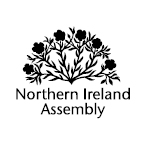
Public Notice
Welfare of Animals Bill
The Committee for Agriculture and Rural Development would like to receive comments on the proposed Welfare of Animals Bill.
A draft copy of the proposed has been drawn up by Department of Agriculture and Rural Development – this is available at the web address below:
http://archive.niassembly.gov.uk/legislation/primary/2009/nia28_09.htm
Any organisation or individual with an interest in this matter is invited to submit their comments on specific clauses within the Bill to the Committee, preferably by e-mail, to the address below.
Submissions should be received no later than 5pm Friday 27 August 2010.
The Clerk to the Committee, Room 284, Parliament Buildings, Stormont,
Ballymiscaw, Belfast BT4 3XX
028 9052 1063
E-mail: committee.agriculture@niassembly.gov.uk
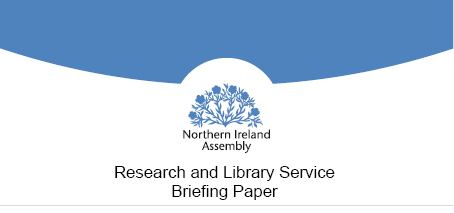
This paper provides an overview of the main proposals contained with the Bill. The paper also identifies those areas within the Bill which may prove to be contentious in the light of consultation responses received, views gathered from a variety of stakeholder events, and the Departmental responses to both.
Paper 344-10 9th September 2010
The Welfare of Animals Bill has been developed to replace the 1972 Welfare of Animals Act (Northern Ireland) which currently governs issues dealing with animal welfare in Northern Ireland.
The Welfare of Animals Bill seeks to update animal welfare legislation in Northern Ireland by building and enhancing upon elements of the 1972 Act and by aligning welfare standards for farmed and non farmed animals.
The Bill also proposes the introduction of the following new measures.
Based upon the analysis of public consultation responses and the comments from a number of stakeholder workshops it would appear that most respondents and participants were generally happy with most elements of the proposed Bill.
There are however a number of proposals within the Bill which are potentially contentious largely due to the lack of specific detail within the Bill itself, and a lack of detail regarding any guidance or subordinate legislation that will either accompany or follow the Bill. These issues are explored within this paper.
Whilst there is evidence for the good treatment of animals in both domestic and agricultural settings within Northern Ireland, it is impossible to get away from the fact that there continue to be high profile and less well known instances of animal cruelty throughout our community.
Against this background the Department of Agriculture and Rural Development (DARD) has brought forward the Welfare of Animals Bill which was formally introduced to the Northern Ireland Assembly on the 21st June 2010 following public consultation in 2006 and a series of stakeholder meetings in 2009.
As well as building on elements of the 1972 Welfare of Animals Act the Bill proposes the creation of a number of new legislative measures as follows:
Consideration of the consultation views suggests that the proposed Bill has been generally well received.
There are however a number of proposals within the Bill which are potentially contentious largely due to the lack of specific detail within the Bill itself and a lack of detail regarding any guidance or subordinate legislation that will either accompany or follow the Bill. These areas, which are examined further within this paper relate to:
Key Points
Executive Summary
Contents
1 Introduction
2. Context for proposed changes to Animal Welfare measures
3. Main elements of the Bill
4. Possible areas of contention within the Bill
4.1 Lack of specific detail within the Bill
4.2 Definition of what constitutes an "animal" - an opportunity for
the advocation of additional codes of best practice without regulation
4.3 Definition/detail of commonly domesticated animals in Northern Ireland
4.4 Tail docking and dew claw removal in dogs
4.5 Tail docking in other animals - inconsistencies
4.6 Enforcement of the proposals within the Bill - skills, costs and cost recovery
4.7 Enforcement of the measures within the Bill - definition of inspectors
4.8 The regulation of puppy farms/dog breeding establishments
4.9 Five freedoms for animal welfare - possible inclusion
The welfare of animals within Northern Ireland is currently governed by the Welfare of Animals Act (Northern Ireland) 1972. The 1972 Act dealt with issues relating to animal welfare under three distinct sections as follows:
The 1972 Act related to the welfare of vertebrate animals and included birds, fish and reptiles under its auspices.
The regulation of the 1972 Act was the responsibility of appointed inspectors/officers from the Veterinary Division within what is now Department for Agriculture and Rural Development, and the RUC/PSNI also played a role particularly in relation to section 3 of the Act and the enforcement of powers in respect of cruelty and unnecessary suffering offences against any animal.
The 1972 Act whilst mainly focussing on welfare issues relating to farmed animals, also provided the only mechanism by which to combat cruelty to non-farmed animals including horses, cats and dogs.
In late 2006 the Department for Agriculture and Rural Development instigated a public consultation exercise aimed at determining how issues pertaining to animal welfare could best be addressed. This move was made in recognition of the fact that the 1972 Welfare of Animals Act was over 40 years old and had in some understandable respects failed to forsee, take account of, or keep pace with particular scientific and other developments in the area of animal welfare.
Following her appointment as Minister for Agriculture and Rural Development in 2007, Michelle Gildernew built upon the previous public consultation exercise by engaging with a range of stakeholders to gather their views on animal welfare issues and potential solutions. These stakeholder meetings culminated in an animal welfare stakeholder workshop attended by representatives from 21 animal welfare and stakeholder organisations which was held in September 2009.
Having considered the comments made as a result of both the public consultation and stakeholder meetings The Minister decided to proceed with the development of a new Welfare of Animals Bill to replace the 1972 Act and in so doing update and strengthen the powers available for the protection of animals.
The draft Bill had its first reading in the Assembly on the 21st June 2010.
Whilst there are no freely available statistics detailing the actual total number of animal welfare cases or convictions in Northern Ireland, it is fair to say that the issue is very topical, based upon reports within the local and national press over the last few years.
Notable examples of animal cruelty over the last few years that have made a major media impact have included the discovery of a puppy farm near Katesbridge in January 2006 containing 37 dogs in various states of deprivation, subsequently 12 dogs had to be put down. In addition, and also within the Banbridge District Council area, in September 2008 the USPCA removed over 100 animals from the Little Acre Open Farm[1] in various states of neglect while they also discovered the rotting carcasses of around 60 animals.
January of this year saw both DARD officials and USPCA staff discovering significant cases of animal cruelty and neglect involving cattle and horses in a number of different locations across counties Down and Armagh[2].
Whilst there is no verifiable evidence to suggest that cases of animal cruelty and neglect are on the rise in Northern Ireland the instances cited previously indicate that this is very much a live issue impacting upon both farmed and non farmed animals
The Welfare of Animals Bill contains 60 clauses and 5 schedules and is presented in 6 parts. The substantive elements of the Bill in terms of changes to the 1972 Act are contained within the first 18 clauses and schedule 1.
In broad terms the new Bill aligns welfare standards for farmed and non farmed animals.
As well as building upon and enhancing certain elements of the 1972 Act the Bill will also introduce the following measures:
Whilst many of the elements within the Welfare of Animals Bill appear sound and reasonable, there are nonetheless a number of areas and issues within the Bill around which there is a lack of consensus based upon the findings from the consultation and stakeholder workshop exercises.
As a general point, and before dealing with specific issues, it should be noted that many of the concerns identified in relation to the Bill by stakeholders and consultees alike arose from the lack of specific detail within the Bill. Whilst recognising that one of the functions of the Bill is to enable the creation of subordinate legislation further down the line to deal with specific issues, and that as a result the lack of specific detail is deliberate, it should be recognised that this situation appears to have been a source of frustration for many interested parties. With this mind it would be useful for the Department, at the earliest opportunity, to set out both a timetable and a methodology for engaging stakeholders in the development of effective subordinate legislation.
The majority of consultee and stakeholder responses agreed with the proposed definition of an animal within the Bill as being a "vertebrate other than man". Some respondents and participants were however keen to see invertebrates and the embryonic, foetal or larval forms of vertebrates included. In recognising that Clause 1 within the bill provides an option for the extension of the definition of an animal to cover both of these areas, pending new scientific evidence, it may be appropriate for the Department to publish more guidance on best practice pertaining to the welfare of these forms of animal life which are currently not covered under the Welfare of Animals Bill.
Clause 16 within the Bill which covers codes of practice for animal welfare may provide just such an opportunity for a proactive approach to animal welfare. DARD already has codes of recommendation for the welfare of livestock such as cattle[4]. A number of consultees and stakeholders for example raised the specific issue of the need to legislate for cephalopods and decapod crustaceans. The most quoted instance of an animal welfare issue here related to the preparation of crabs and lobsters for eating by the means of being boiled alive. In instances such as these the Bill and any subsequent subordinate legislation could make reference to a more humane and animal welfare considerate method for killing crabs and lobsters. The RSPCA has produced such guidance in the form of a fact sheet[5] that could easily be referred to without requiring regulation.
Clause 2 within the Bill sets out the criteria for the definition of what is a "protected animal"'. Under this clause it is proposed that any animal of a kind which is "commonly domesticated within Northern Ireland should be a protected animal". As pointed out by a number of consultees and stakeholders there is a need to set out in more detail those animals which qualify as being domesticated.
The creation of such a list would also align the Welfare of Animals Bill with provisions under the Dangerous Wild Animals (Northern Ireland) Order 2004[6]. A number of stakeholders and consultees raised the issue of the keeping of primates as pets and questioned whether primates could be referred to as domesticated animals. The Dangerous Wild Animals Order sets out those animals that should be classed as dangerous wild animals within schedule 2 of the order. This list includes many sub species of primate such as the chimpanzee, gibbon and tamarin to name but a few. As such, and at face value, this would appear to exclude named primates from being classed as domesticated animals, but this issue could once again be addressed through the production of the aforementioned comprehensive list detailing those animals which are classed as commonly domesticated.
The issue of tail docking in dogs is undoubtedly the most controversial element within the Bill based upon the comments made by consultees and stakeholders. The Bill as it currently stands proposes a complete ban on the docking of dog tails unless the tail is removed for medical reasons or to prevent danger to the life of a dog and this is set out within Clause 6.
The proposal for a complete ban would see Northern Ireland being aligned with the current legal position around tail docking in Scotland and the proposed position within the Republic of Ireland. The situation regarding England and Wales is not as clear cut due to the fact that in general terms the removal of dog's tail in whole or part is an offence but this does not apply if the dog is a certified working dog that is not more than 5 days old. Under the Animal Welfare Act 2006, a dog is classed as a working dog within England and Wales if it is verified as being so by a vet. To reach this status the dog needs to fulfil two conditions as set out in Clause 6, points 5 and 6 within the Act. In broad terms these conditions are met if the dog is a police or military dog, involved in lawful pest control, emergency rescue or lawful hunting. The definition employed is also not breed specific.
Much of the contention around this particular issue is linked to the often conflicting and in some instances contradictory evidence provided by those who both advocate and oppose tail docking in dogs. There is not an extensive catalogue of evidence either advocating for or opposing the docking of dog tails. Advocates and opponents tend to refer to two 'key' pieces of research when presenting their case and Table 1 below provides a brief overview of these two studies.
| Title of Research | Date completed | Methodology | Main findings |
| 'Risk factors for tail injuries in dogs in Great Britain', G.Diesel, D.Pfeiffer, S. Crispin, D.Brodbelt7 | 2010 | Questionnaire sent to 224 owners of dogs with tail injuries and 799 owners whose dogs had no tail injuries. Dog owner details were obtained from a stratified random sample of veterinary practices throughout GB | Weighted risk of tail injuries was 0.23 percent/year; Risk among working dogs was 0.29 percent; Risk among non working dogs was 0.19 percent ; Variation in risk of tail injury ;depending on breed – highest risk being English springer spaniel (0.45 percent) and lowest risk Jack Russell terrier (0.03 percent); Overall risk of tail injuries is low. |
| 'Tail Injuries of Shorthaired German Pointer Dogs Born in Sweden in 1989', Gunilla Strejffert on behalf of The Breed Council – German Shorthaired Pointer8 | 1992 | Interview investigation carried out among 53 litters of German Pointers registered during 1989. Dogs were then tracked in 1990 and 1991 to establish the number of tail injuries incurred. | Autumn 1990 – dogs were now 1-1.5 yrs old and 27% had suffered tail injuries; Autumn 1991 – dogs were 2-2.5 yrs old – 35% had suffered from tail injuries; Over 1/3 of dogs had tail injuries. |
As can be seen from table 1 the evidence either for or against tail docking is primarily based upon the two studies identified. Given the fact that the studies are used to either advocate for or against the docking of dog tails table 2 below sets out the caveats that need to be considered when referring to either of these pieces of research as providing a definitive case either for or against tail docking in dogs.
| Research | Caveats regarding use of findings |
| 'Risk factors for tail injuries in dogs in Great Britain', G.Diesel, D.Pfeiffer, S. Crispin, D.Brodbelt9 | Only involved a small number of working dogs due to random sampling and selection of veterinary practices – could reduce the chance of finding a significant association between work and tail injuries; Potential for bias in the representativeness of the sample selected – may not fully reflect the GB dog population due to national variation and fact that not all tail injuries may have been seen by a vet; Response rate of veterinary practices and dog owners was relatively low; Research may have been completed too soon after the ban on tail docking and as such may have underreported tail injuries in breeds which were previously docked - ban came in early 2007 and research was completed between March 2008 and March 2009; Only conducted in GB – consideration should be given to possible differences in dog populations between GB and Northern Ireland. |
| 'Tail Injuries of Shorthaired German Pointer Dogs Born in Sweden in 1989', Gunilla Strejffert on behalf of The Breed Council – German Shorthaired Pointer10 | Limited sample size of 53 litters and the owners of the litters were self selecting – open to bias; Lack of comparison between docked and undocked dogs; Did not compare animals before and after the tail docking ban; No statistical comparisons to test the validity of the conclusions; Only conducted in Sweden – consideration should be given to possible differences in dog populations between Sweden and Northern Ireland. |
The overwhelming message to be drawn from this situation is that there is a real need for further objective research using a much larger sample of dogs to determine whether tail docking does significantly reduce the risk of serious tail injury amongst dogs in general and certain species of working dog specifically. It would also be useful for such research to either include or focus exclusively on dogs in Northern Ireland. The evidence that currently exists, whilst undoubtedly interesting and thought provoking, makes any decision around the advocacy or banning of tail docking in dogs very difficult.
It is also interesting to note that the removal of dew claws from dogs prior to the opening of their eyes will continue to be permissible (schedule 1 of the Bill) despite the fact that the evidence either for their retention or removal could accurately be described as sparse and largely anecdotal. For some dog owners and vets the removal of dew claws protects the dog from injury whilst others advocate for their retention on the basis that removal may contribute to arthritis in later life. Given that the practices of tail docking and dew claw removal generally occur at the same point early in a puppy's life, it seems inconsistent to ban one procedure on questionable evidence whilst allowing another to continue where there is no empirical evidence.
Some stakeholders and consultees raised the issue of inconsistency in relation to the docking of tails in different animal species. The proposals within the Welfare of Animals Bill continue to allow for the docking of pig and lamb tails up to a certain age for example. The rationale for such allowances appears to be on the basis of good animal husbandry. Tail docking in pigs, sheep, horses and dairy cattle is common across many parts of the world as revealed by a paper completed by the Department for Environment, Food and Rural Affairs as part of a review of the scientific aspects and veterinary opinions relating to tail docking in dogs[11].
There has however been research completed in recent years which seems to suggest that allowing tail docking in lambs and pigs is questionable given that it causes pain to the animal and may not reduce risks to animal health. With regard to the issue of pain, research conducted in New Zealand by Peers et al[12] and published in the New Zealand Veterinary Journal in 2002, revealed that newly docked and castrated lambs experienced a significant increase in blood pressure and heart rate and that these levels remained significantly raised for at least four hours – indicative of stress and pain.
With regards to improving animal health, whilst tail docking in lowland grazing sheep is generally accepted as an effective means of preventing fly strike, research completed by Morris[13] in 2000 reported the successes that organic farmers had in addressing the incidence of fly strike by placing flytrap bins in paddocks and regularly inspecting stock. Similarly, the docking of pig tails is generally undertaken on the premise that removal prevents tail biting, and as a result prevents infection and ill effects on pig health. There is however evidence which would suggest that tail docking is not the only way to prevent tail biting. A NADIS Pig Health Update from October 2007[14] for example, highlights the fact that other options such as providing straw, chewable toys and the introduction of dietary supplements such as salt can also prevent tail biting.
The question which needs to be asked here is what the motivation is for banning tail docking? If the major motivation for banning tail docking in this Bill, or any other legislation for that matter, is the prevention of pain in animals then it should stand to reason that there should surely be a blanket ban across all animal species given the evidence quoted. In such a scenario continuing to allow the docking of sheep and pig tails whilst banning the docking of dog tails would suggest the existence of a hierarchy of animal pain, with the infliction of pain on dogs being deemed unacceptable whilst pain in sheep and pigs is acceptable. Due to the fact that there is no scientific evidence to suggest that such a hierarchy exists between either domesticated or farmed animals there should also be no hierarchy based upon social convention.
Equally, it would appear to be inconsistent to ban tail docking in dogs and continue to allow the practice in sheep and pigs if the argument is that tail docking in pigs and sheep promotes better animal health. This argument is challenging given the conflicting messages emerging from the evidence on tail injuries in dogs referred to in the previous section of this paper and that presented in relation to sheep and pigs here highlighting alternatives to tail docking that can improve animal health or reduce the risk of disease.
Part 4 of the Welfare of Animals Bill deals with the issue of enforcement of animal welfare. Building upon the previous legislation the powers of enforcement will be the responsibility of either the PSNI or inspectors appointed by either DARD or one of Northern Ireland's current 26 District Councils. Councils are not legally required to appoint animal welfare inspectors but can choose to do so. In this respect the Bill provides permissive powers but does not place a statutory duty on councils to enforce the legislation as it relates to non farmed animals. The guidelines in relation to how councils could fulfil this function do not currently exist, but any subordinate legislation or guidance that does emerge on this matter needs to take account of concerns raised by consultees and stakeholders.
These concerns around the ability of councils to fulfil the animal welfare enforcement role could broadly be grouped under the two headings of skills and resources. With regard to skills, there is a real need for guidelines around the role and responsibilities for council based animal welfare inspectors which will also need to be applied on a consistent basis by those councils who decide to fulfil this function. Training may also be required to ensure that appointed inspectors are up to speed and standard in performing this role and questions remain over whether DARD, who seem ideally placed to do so, will either fund or deliver this training.
Turning to the issue of resources there appear to be no proposals in the Bill for additional resources from central to local government for either the training of inspectors, or the actual carrying out of enforcement duties and bringing prosecutions. All of these things will cost unknown amounts of money to deliver and it is hard to see how councils could perform any of these duties without some form of direct support from central government or through the creation of a mechanism/s to enable income generation as a legitimate part of the enforcement and prosecution processes.
The issue of income generation for councils could potentially be addressed by mirroring proposals in the Dogs (Amendment) Bill which is currently at committee stage within the Assembly. Clause 12 within the Dogs (Amendment) Bill[15] proposes that any fixed penalties in relation to dogs are payable to the local district council rather than the courts. Whilst the proposals contained within the Welfare of Animals Bill relate to fines rather than fixed penalties there may be merit in exploring the concept of a system which would enable councils to collect either a proportion or all of fine income relating to animal welfare cases. Additionally, the creation of improvement notices as proposed in the Bill might provide a means whereby a fixed penalty could be issued upon the issuance of an improvement notice, with the income being collected by the local council.
Part 4 of the Welfare of Animals Bill sets out the proposed powers of enforcement that will be available to address issues of animal welfare. The clauses contained within this part of the Bill make it clear that the power of enforcement either lies with an officer (PSNI) or an inspector which is defined as someone appointed by either the Department or a council. A number of stakeholders and consultees were concerned that such a definition would limit the potential for other organisations such as animal charities to be pro active on animal welfare issues. The USPCA for example, who participated in the stakeholder workshop that took place on the 17th September 2009, felt that the proposals as they currently stand, could delay the removal of an animal from circumstances in which it was suffering as an approved inspector(council) or officer(police) are required to remove any such animal. The USPCA also raised concerns around the fact that the PSNI are currently not dealing with many of the animal welfare cases reported to them, and that this situation may only get worse if the new Welfare of Animals Bill, when enacted, identified a wider number of animal welfare abuses.
In these circumstances, and given the fact that councils will not be obliged to appoint animal welfare inspectors, there may be a need to ensure that inspectors can be appointed from a wider pool than simply the Department or Council. Another alternative could be to enable the Department or Councils to appoint, or even sub contract, inspectors from organisations such as the USPCA. Subordinate legislation could include such provision but would also need to ensure that inspectors appointed in such a manner where required to have the same skills and training as inspectors appointed by the Department or councils.
Dog breeding establishments, and more particularly the issue of puppy farming, are undoubtedly high in the public consciousness as a result of a number of high profile cases of animal welfare abuse over the last few years. Concerns around the regulation of dog breeding featured prominently within the comments made by stakeholders and consultees.
Clauses 11, 12 and 13 within the Welfare of Animals Bill provide a means by which activities including dog breeding can be regulated, licensed or banned. In line with previous comments in this paper, whilst the Bill offers the opportunity to address many of the concerns raised around dog breeding, it will be for any subordinate legislation subsequently developed to actually address the issue. With this in mind the Department needs to set out its intentions for subordinate legislation at the earliest opportunity, and given the interest shown, consideration should be given to legislation relating to dog breeding.
Work done in Wales by the Welsh Assembly's Dog Breeding Review Group[16] sets out draft guidance on licence conditions for dog breeders. This document covers a range of issues including accommodation and environment, diet and nutrition, normal behaviour, health and welfare and record keeping, and as such could provide a useful starting point for subordinate legislation here. In addition the recent Independent Inquiry into Dog Breeding[17] completed by Professor Patrick Bateson form the University of Cambridge and Commissioned by the Kennel Club and the Dogs Trust makes a number of key recommendations around how dog breeding can be improved under the three broad headings of inbreeding and inherited diseases, poor or negligent management and care, and inadequacies in the buying and selling of dogs.
Further proposals in Clause 9, which mirror the measures contained within Clause 9 of the enacted Animal Welfare Act adopted in England Wales in 2006[18], were deemed by some to fall short of the standard set through the creation of the 'Five Freedoms' for Animal Welfare that have emerged from the Brambell report in 1965[19]. The 'five freedoms' that emerged from Brambell's report and subsequent work by the Farm Animal Welfare Council[20] are generally accepted as the benchmark for animal welfare standards and are as follows:
Whilst the measures for promoting and ensuring animal welfare contained within both the enacted Animal Welfare Act and proposed Welfare of Animals Bill are undoubtedly loosely based upon these 'Five Freedoms' it may be appropriate to make explicit reference to the five freedoms.
[1] USPCA's sickening find at Open Farm, Banbridge Leader, 30th September 2008
[2] Inquiries continue into livestock deaths, Newsletter, 28th January 2010
[3] Welfare of Animals Bill, Explanatory and Financial Memorandum, Northern Ireland Assembly website
[4] Northern Ireland Code of Recommendations for the welfare of livestock; Cattle, DARD, 2005
[5] Humane electrical stun/killing of Crustacea, RSPCA fact sheet
[6] Dangerous Wild Animals (Northern Ireland) Order, 2004
[7] Risk factors for tail injuries in dogs in Great Britain, G. Diesel, D. Pfeiffer, S. Crispin, D. Brodbelt, 2010
[8] Council of Docked Breeds Website
[9] Risk factors for tail injuries in dogs in Great Britain, G. Diesel, D. Pfeiffer, S. Crispin, D. Brodbelt, 2010
[10] Council of Docked Breeds Website
[11] A review of the scientific aspects and veterinary opinions relating to tail docking in dogs, Briefing paper, Animal Welfare Veterinary Team, DEFRA, 5th August 2002.
[12] Peers, A., Mellor, D.J., Wintour, E.M. and Dodic, M. (2002) Blood pressure, heart rate, hormonal and other acute responses to rubber ring castration and tail docking of lambs. New Zealand Veterinary Journal 50:2, 56-62
[13] Morris, M.C. (2000) Ethical issues associated with sheep fly strike research, prevention and control. Journal of Agricultural and Environmental Ethics 13, 205-217
[14] NADIS Pig Health - October 2007, Tail Biting, British Pig Executive
[15] Dogs (Amendment) Bill, 2010
[16] Draft guidance on licence conditions for dog breeders incorporating Animal Welfare Act 2006 "Five Needs", Dog Breeding Review Group, Welsh Assembly Government, 2010
[17] Bateson, P. (2010) Independent Inquiry into Dog Breeding, Cambridge University
[18] Animal Welfare Act, 2006
[19] Brambell Report, 1965. Report of the Technical Committee to enquire into the welfare of animals kept under intensive livestock husbandry systems. Her Majesty's Stationery Office, London, UK.
[20] Farm Animal Welfare Council Website
Paul Carlisle
Clerk to the Committee for
Agriculture and Rural Development
Parliament Buildings
Ballymiscaw
Stormont
Belfast
BT4 3XX
Joe Cassells
Departmental Assembly Liaison Officer
Department of Agriculture and
Rural Development
Room 509
Dundonald House
Ballymiscaw
Belfast
BT4 3SB 28 October 2010
Dear Joe
I refer to the above matter.
Please find attached a summary of the Committee's detailed consideration of clauses in respect of the above Bill. Members will continue to debate these matters with the Department at the next meeting, scheduled for 2 November 2010.
I am happy to discuss
Clerk to the Committee for
Agriculture and Rural Development
AW clause-by-clause consideration
| Clause | Explanation | Issues | DARD Response | Outcome | DARD Comments |
| PART 1 - INTRODUCTORY | |||||
| Clause 1 – Animals to which this Act applies | The Bill applies only to vertebrate animals, as these are currently the only demonstrably sentient animals. However, clause 1(3) makes provision to extend the Bill to cover invertebrates of any description in the future if the Department is satisfied on the basis of scientific evidence that these too are capable of experiencing pain or suffering | The Committee would wish the Department make Clause 1(3) subject to affirmative resolution rather than negative resolution, in line with legislation in England and Scotland | |||
| Clause 2 – Protected animals | Deferred until formal clause-by-clause scrutiny of the Bill | ||||
| Clause 3 – Responsibility for animals | Deferred until formal clause-by-clause scrutiny of the Bill | ||||
| PART 2 – PROTECTION OF ANIMALS | |||||
| Prevention of Harm | |||||
| Clause 4 – Unnecessary suffering | Deferred until formal clause-by-clause scrutiny of the Bill | ||||
| Clause 5- Prohibited procedures | Prohibited procedures are those which involve interference with the sensitive tissues or bone structure of the animal, for example castration and dehorning. This clause makes it an offence to carry out a prohibited procedure on any protected animal unless the procedure is carried out by a veterinary surgeon or is specified in Schedule 1 as being exempted from general prohibition. Normal farming practices (such as castration of lambs) will be permitted | Clause 5 will need to be amended to reflect that we will bring forward subordinate legislation or regulations that will list the routine farming procedures that remain permitted | |||
| Clause 6 – Docking of dogs' tails | This clause prohibits the docking of a dog's tail, otherwise than for the purposes of its medical treatment by a veterinary surgeon or to safeguard its life. It will be an offence to take (or cause another person to take) a dog from Northern Ireland for the purpose of having its tail docked. The clause also introduces a ban on the showing of dogs where the tail was docked after introduction of the new Welfare of Animals Act | The Committee agreed that this clause required additional consideration in respect of either of the following issues: Removal of the clause completely (as is the current Committee position); or An exemption for working dogs (as per English legislation) | |||
| Clause 7 - Administration of poisons etc | Deferred until formal clause-by-clause scrutiny of the Bill | ||||
| Clause 8 – Fighting etc | Deferred until formal clause-by-clause scrutiny of the Bill | ||||
| Promotion of Welfare | |||||
| Clause 9 – Ensuring welfare of animals | Deferred until formal clause-by-clause scrutiny of the Bill | ||||
| Clause 10 - Improvement notices | Deferred until formal clause-by-clause scrutiny of the Bill | ||||
| Clause 11 - Regulations for securing welfare of animals | Deferred until formal clause-by-clause scrutiny of the Bill | ||||
| Clause 12 - Licensing or registration of activities involving animals | This clause enables the Department to make regulations for the introduction of licensing and registration regimes in relation to activities involving animals for which a person is responsible for the purposes of securing the welfare of animals or the progeny of those animals | The Committee agreed that this clause required additional consideration in respect of either of the following issues: Clarification of the legal position regarding transposition of powers to councils through this Bill; Responsibility for the licensing of breeding establishments, on welfare grounds, being retained by DARD rather than local government; and An assurance that responsibilities under this clause will not be delegated until additional and substantial consultation has been undertaken with local councils. | |||
| Clause 13 - Prohibition on keeping of certain animals | Deferred until formal clause-by-clause scrutiny of the Bill | ||||
| Clause 14 – Abandonment | Deferred until formal clause-by-clause scrutiny of the Bill | ||||
| Clause 15 – Transfer of animals by way of sale or prize to persons under 16 | Deferred until formal clause-by-clause scrutiny of the Bill | ||||
| Clause 16 - Codes of practice | Deferred until formal clause-by-clause scrutiny of the Bill | DARD are to forward any new codes to Committee in advance of publication | |||
| PART 3 - ANIMALS IN DISTRESS | |||||
| Clause 17 – Powers in relation to animals in distress | This clause authorises an inspector or constable who finds a protected animal that is suffering to take immediate steps to alleviate the animal's suffering | The Committee agreed that this clause required additional consideration in respect of either of the following issue: Clarification is received in respect of contingency funding for Councils should the department's Budget 2010 bid not be met. | |||
| Clause 18 - Powers of entry for section 17 purposes | This clause confers powers of entry for the purposes of clause 17. It authorises an inspector or constable to enter onto premises to deal with a protected animal that is believed to be suffering or likely to suffer if remedial action is not taken. Power of entry does not extend to a private dwelling unless a warrant is obtained from a lay magistrate. Strict conditions must be met to satisfy the issue of a warrant. Schedule 3 provides safeguards in connection with powers of entry under warrant. On the rare occasion when urgent entry is required before a warrant can be obtained this clause authorises the use of reasonable force to effect entry without a warrant, for example if an animal is suffering so much that it would be inappropriate to delay | DARD are to forward any new codes to Committee in advance of publication | |||
| Clause 19 - Orders in relation to animals taken under section 17(5) | Deferred until formal clause-by-clause scrutiny of the Bill | ||||
| Clause 20 – Orders under section 19: appeals | Deferred until formal clause-by-clause scrutiny of the Bill | ||||
| PART 4 - ENFORCEMENT | |||||
| Enforcement Powers | |||||
| Clause 21 – Seizure of animals involved in fighting offences | Deferred until formal clause-by-clause scrutiny of the Bill | ||||
| Clause 22 - Entry and search under warrant in connection with offences | This clause provides that a lay magistrate may issue a warrant authorising an inspector or a constable to enter premises to search for evidence of offences relating to unnecessary suffering, prohibited procedures, tail docking, administration of poisons, fighting, ensuring welfare, failing to comply with an improvement notice, carrying out relevant activities without a licence or registration, abandonment, or breaching a disqualification imposed under clause 33 | DARD are to forward any new codes to Committee in advance of publication | |||
| Clause 23 - Inspection of records required to be kept by holder of licence | Deferred until formal clause-by-clause scrutiny of the Bill | ||||
| Clause 24 - Inspection in connection with licences | Deferred until formal clause-by-clause scrutiny of the Bill | ||||
| Clause 25 - Inspection in connection with registration | Deferred until formal clause-by-clause scrutiny of the Bill | ||||
| Clause 26 – Inspection of premises to check compliance with regulations made under section 13 | Deferred until formal clause-by-clause scrutiny of the Bill | ||||
| Clause 27 - Inspection of farm premises | Deferred until formal clause-by-clause scrutiny of the Bill | ||||
| Clause 28 - Inspection relating to Community obligations | Deferred until formal clause-by-clause scrutiny of the Bill | ||||
| Prosecutions | |||||
| Clause 29 - Power of councils to prosecute offences | This clause provides a power allowing district councils to initiate prosecution proceedings for any offence under the Bill | The Committee agreed that this clause should not be empowered until such times as the Department had consulted and agreed the scope of powers with Councils | |||
| Clause 30 - Time limits for prosecutions | Deferred until formal clause-by-clause scrutiny of the Bill | ||||
| Post-Conviction Powers | |||||
| Clause 31: Penalties | Deferred until formal clause-by-clause scrutiny of the Bill | ||||
| Clause 32: Deprivation | This clause enables the courts to confiscate an animal from an owner who has been convicted of an offence in relation to that animal. A deprivation order is limited to cases where there is a clearly identifiable animal or animals in respect of which the offence was committed. The court is required to give reasons if it decides not to make a deprivation order against a convicted person | The Committee agreed that this clause required additional consideration in respect of either of the following issue: The department to seek legal advice on whether a household (as is proposed in Dangerous Dog legislation in Westminster) can be disqualified from keeping an animal | |||
| Clause 33: Disqualification | Deferred until formal clause-by-clause scrutiny of the Bill | ||||
| Clause 34: Seizure of animals in connection with disqualification | Deferred until formal clause-by-clause scrutiny of the Bill | ||||
| Clause 35: Clause 34: supplementary | Deferred until formal clause-by-clause scrutiny of the Bill | ||||
| Clause 36: Destruction in the interests of the animal | Deferred until formal clause-by-clause scrutiny of the Bill | ||||
| Clause 37: Destruction of animals involved in fighting offences | Deferred until formal clause-by-clause scrutiny of the Bill | ||||
| Clause 38: Reimbursement of expenses relating to animals involved in fighting offences | Deferred until formal clause-by-clause scrutiny of the Bill | ||||
| Clause 39: Forfeiture of equipment used in offences | Deferred until formal clause-by-clause scrutiny of the Bill | ||||
| Clause 40: Orders under section 32, 34, 36, 37 or 39: pending appeals | Deferred until formal clause-by-clause scrutiny of the Bill | ||||
| Clause 41: Orders with respect to licences | Deferred until formal clause-by-clause scrutiny of the Bill | ||||
| Clause 42: Termination of disqualification under clause 33 or 41 | Deferred until formal clause-by-clause scrutiny of the Bill | ||||
| Clause 43: Orders made on conviction for reimbursement of expenses | Deferred until formal clause-by-clause scrutiny of the Bill | ||||
| Clause 44: Orders for reimbursement of expenses: right of appeal for non-offenders | Deferred until formal clause-by-clause scrutiny of the Bill | ||||
| PART 5 – GENERAL | |||||
| Clause 45: Inspectors | For the purposes of the Bill an "inspector" is a person appointed either by the Department or a council. Councils when appointing inspectors for the purposes of the Bill must have regard to any guidance that may be issued by the Department. The Department may also issue a list of approved persons who are considered suitable for appointment as inspectors by councils | The Committee agreed that this clause required additional consideration in respect of either of the following issue: The department should identify in legislation the qualifications, experience and expertise required to be appointed an inspector | |||
| Clause 46: Conditions for grant of warrant | The Bill makes provision for warrants in order to obtain entry to premises including private dwellings in a variety of circumstances. This clause sets out the conditions which must be met before a lay magistrate can grant a warrant to allow a constable or inspector to enter private dwellings and other premises | DARD are to forward any new codes to Committee in advance of publication | |||
| Clause 47: Powers of entry, inspection and search: supplementary | This clause gives effect to Schedule 3, which specifies the power and duties of those exercising powers of entry, inspection or search under warrant | DARD are to forward any new codes to Committee in advance of publication | |||
| Clause 48: Power to stop and detain vehicles | Deferred until formal clause-by-clause scrutiny of the Bill | ||||
| Clause 49: Power to detain vessels, etc | Deferred until formal clause-by-clause scrutiny of the Bill | ||||
| Clause 50: Obtaining of documents in connection with carrying out orders etc | Deferred until formal clause-by-clause scrutiny of the Bill | ||||
| Clause 51: Offences by bodies corporate | Deferred until formal clause-by-clause scrutiny of the Bill | ||||
| Clause 52: Scientific research | Deferred until formal clause-by-clause scrutiny of the Bill | ||||
| Clause 53: Hunting, coursing and fishing | Deferred until formal clause-by-clause scrutiny of the Bill | ||||
| Clause 54: Application to the Crown | Deferred until formal clause-by-clause scrutiny of the Bill | ||||
| PART 6 – SUPPLEMENTARY | |||||
| Clause 55: Regulations | This clause sets out which regulations made under the Bill will be subject to affirmative resolution and which will be subject to negative resolution | The Committee would wish the Department clause 1(3) subject to affirmative resolution rather than negative resolution | |||
| Clause 56: Interpretation | Deferred until formal clause-by-clause scrutiny of the Bill | ||||
| Clause 57: Minor and consequential amendments and repeals | Deferred until formal clause-by-clause scrutiny of the Bill | ||||
| Clause 58: Transitional provision | Deferred until formal clause-by-clause scrutiny of the Bill | ||||
| Clause 59: Commencement | Deferred until formal clause-by-clause scrutiny of the Bill | ||||
| Clause 60: Short Title | Deferred until formal clause-by-clause scrutiny of the Bill | ||||
| Schedule 1 | This schedule sets out the procedures to which clause 5 (prohibited procedures) does not apply | Deferred until consideration of clause 6 completed | |||
| Schedule 2 | This schedule sets out in more detail the powers to make regulations in respect of licensing and registration under clause 12 | Deferred until legal competence of DARD to place new responsibilities on local government are clarified and additional consultation with councils is undertaken | |||
| Schedule 3 | This schedule specifies the power and duties of those exercising powers of entry, inspection or search under warrant and requires inspectors to comply with a Code of Practice for Search under Warrant | Deferred until consideration of relevant codes is possible | |||
| Schedule 4 | Deferred until formal clause-by-clause scrutiny of the Bill | ||||
| Schedule 5 | Deferred until formal clause-by-clause scrutiny of the Bill | ||||
Paul Carlisle
Clerk to the Committee for
Agriculture and Rural Development
Parliament Buildings
Ballymiscaw
Stormont
Belfast
BT4 3XX
Joe Cassells
Departmental Assembly Liaison Officer
Department of Agriculture and
Rural Development
Room 509
Dundonald House
Ballymiscaw
Belfast
BT4 3SB
3 November 2010
Dear Joe
I refer to the above matter.
The Committee continued its clause by clause consideration in respect of those clauses with issues yet to be resolved. The Committee noted correspondence from the Department dated 1 November 2010 indicating that the Committee had taken its decision on tail docking before having received all oral evidence from stakeholders. The Committee had, in fact, received oral evidence on the matter previously from all stakeholders, including a presentation from the Northern Ireland Veterinary Association on behalf of the British Veterinary Association on 9 March 2010. This is in addition to the information provided in written responses that followed the Department's consultation on the policy principles and the Committee consultation on the clauses contained within the Bill. Whilst the Committee decision remains that the clause should be removed from the Bill, Members have indicated, on a number occasions that they would be prepared to discuss an exemption to the current clause with the Department. Mindful of the fact that the end date for the Committee Stage of the Bill is approaching, the Committee would call on the Department to indicate whether they would be prepared to amend the clause to allow for an exemption and to commence such negotiations immediately to ensure that the progress of the Bill is not delayed. Accordingly, the Committee has deferred clauses 6 and 22 for further consideration.
The Committee continues to be very concerned about the financial implications to Councils arising out of the implementation of this Bill, in particular clauses 17 and 29. The Committee has noted that the Department has submitted a bid for resource under Budget 2010; however, the Committee is concerned that the Department has not planned for contingency in the event that the bid is not met, on the basis that to do so would weaken the bid. The Committee would not wish this significant burden to be transferred to ratepayers and would, therefore, repeat its earlier request that these clauses remain dormant (for introduction by subordinate legislation) until such times as appropriate resources, structures, processes and procedures are agreed and are in place.
The Committee remains of the view that the powers contained within Clause 12 should be retained by the Department in respect of breeding establishments. The Committee regards the welfare issues and requirements surrounding the breeding of non-farmed animals for sale to be similar to those currently in place for the breeding of farmed animals and that, as the Department is currently responsible for the latter, they should also be responsible for breeding establishments. Accordingly, this clause has been deferred for further consideration.
The Committee noted the Departments responses in respect of clauses 16, 18, 32, 45 – 47 (inclusive) and 55.
A number of queries are detailed in the attached template and I would ask that you respond to these by Monday 8 November 2010.
I am happy to discuss
Paul Carlisle
Clerk to the Committee for
Agriculture and Rural Development
| Date of Committee Meeting: | Agenda Item: | Response Required by: noon. 8 November 2010 |
| Query Detail: If the department bid for additional resources is not met, will the fact that the powers under clauses 17 and 29 will have transferred to local councils make them responsible for sourcing these resources? Can the department provide the Committee with minutes/notes of the meeting recently held with NILGA and SOLACE? |
| Departmental Response: (please attach additional comments to this sheet) |
| Committee comments: |
Our Ref: AB/LR
10th November 2010
Clerk of Agriculture & Rural Development Committee
Room 284
Parliament Buildings
Ballymiscaw
Stormont
Belfast
BT4 3GW
Dear Sir
At a recent meeting of the above group, Councillors from across the region expressed deep concerns in respect of the Bill currently before the Northern Ireland Assembly. Members agreed to seek an urgent meeting with the Agriculture Committee on an informal basis in order to discuss those areas of concern and further inform the debate moving forward.
I would be grateful if you could advise, at your earliest convenience, whether the committee would be prepared to receive an appropriate delegation from the NILGA committee on this matter.
All correspondence should be forwarded through Mr Alan Burke, Co-ordinator, at the address below.
Yours faithfully
Cllr B Wilson
Chairman
Paul Carlisle
Clerk to the Committee for
Agriculture and Rural Development
Parliament Buildings
Ballymiscaw
Stormont
Belfast
BT4 3XX
Joe Cassells
Departmental Assembly Liaison Officer
Department of Agriculture and
Rural Development
Room 509
Dundonald House
Ballymiscaw
Belfast
BT4 3SB
10 November 2010
Dear Joe
I refer to the above matter.
The Committee noted correspondence relaying the Ministers proposal for an exemption to Clause 6 of the Bill in respect of tail docking. The Committee agreed to invite the Minister to attend the next meeting, scheduled for Tuesday 16 November 2010, to discuss this matter and the impact of enforcement legislation brought by this Bill on local government councils. I would be grateful if you could advise if the Minister can attend.
The Committee agreed to defer their decision on clauses 5, 6, 17 and 29 until the next meeting. The Committee deferred Clause 12 for further consideration. The Committee agreed to defer clauses 18, 22, 45 and 55 until the formal clause by clause scrutiny of the Bill.
I am happy to discuss
Paul Carlisle
Clerk to the Committee for
Agriculture and Rural Development
Paul Carlisle
Clerk to the Committee for
Agriculture and Rural Development
Parliament Buildings
Ballymiscaw
Stormont
Belfast
BT4 3XX
11 November 2010
Dear ,
You recently gave evidence to the Committee for Agriculture and Rural Development in respect of the above Bill.
Clause 6 of the Bill would introduce a ban on the docking of a dog's tail. The Committee is opposed to a complete ban and has discussed this matter at length with the Department of Agriculture and Rural Development. The Department has advised that the Minister has reassessed this matter and has indicated that she would be prepared to allow an exemption to the clause in respect of pure bred spaniels and hunt point retriever breeds involved in work in respect of lawful pest control and lawful shooting of animals. The docking would continue to be conducted by a veterinary surgeon when the pup is 5 days or less of age. Evidence would also need to be provided to the veterinary surgeon to demonstrate that the dog is likely to be used for work in lawful pest control or lawful shooting of animals. The exemption and associated controls would be detailed in subordinate legislation and is not, therefore, available to the Committee.
As you will appreciate, the Committee will soon complete its deliberations in respect of this matter. I would appreciate your urgent views on this matter, either by means of letter or, preferably, by email to:
paul.carlisle@niassembly.gov.uk
The Committee has asked that the Minister attend the next meeting of the Committee, scheduled for Tuesday, 16 November 2010, to discuss this matter and I would be grateful if responses were available in advance of this.
I apologise for the very tight deadline in respect of this and thank you for your continued contribution to the work of the Committee.
Yours sincerely

Paul Carlisle
Clerk to the Committee for
Agriculture and Rural Development
Thursday 11 November 2010
Mr Paul Carlisle
Clerk to the Committee for
Agriculture and Rural Development
Parliament Buildings
Ballymiscaw
Stormont
Belfast
BT4 3XX
Dear Paul
Many thanks for your letter dated 11 November 2010. We are pleased to be given the opportunity to respond.
Countryside Alliance Ireland welcomes the Minister's indication that would allow for an exemption for tail docking of working dogs. However, we do have concerns in relation to some of the proposed conditions contained within your letter.
These are;
1. 'Exemption to the clause in respect of pure bred spaniels and hunt point retriever breeds' – not all working dogs are 'pure bred'; indeed many are cross bred specifically to improve their work performance.
2. 'Involved in work in respect of lawful pest control and lawful shooting of animals' – we would require clarification and assurance that this includes field trial work.
3. Terriers – we would wish to see working terriers included within the exemption. Terriers are used to hunt game from heavy cover. They are also extensively used below ground to hunt foxes, rabbits, rats and other pests, where a docked tail assists in the steadying and removal of the dog from an earth or burrow – additional information attached.
In addition, many security and rescue services use spaniels in their work which would require them to be used in dense/heavy cover; these dogs would also need to be included within the exempted legislation.
May we suggest that the Committee propose legislation similar to that in operation in England which allows the following types of working dogs to be docked:
1. Hunt point retrieve breeds of any type or combination of types.
2. Spaniels of any type or combination of types.
3. Terriers of any type or combination of types.
Another factor we should take into account when deciding which breeds should be included within an exemption is the fact that there is much trading of dogs between Northern Ireland and Great Britain and any disparity may cause confusion or difficulties in this regard.
I hope you find our response helpful, however, please do not hesitate to contact me should you require any clarification or any additional information. I may be contacted on 028 9263 9911 or 07917 038758.
Yours sincerely

LYALL PLANT
Chief Executive
Enc
The working terrier has evolved over many hundreds of years. It consists of a number of different but clearly identifiable types. These are commonly known as:
The above are all currently docked. They are not registered with the Kennel Club, nor are they eligible for registration, being a completely separate working 'breed' from those which are exhibited.
The case for the need to dock working terriers is just as great as with any other type of dog. Indeed, the risk of their sustaining tail injuries can be much higher and the nature of their injuries more acute. These much smaller dogs not only work above ground alongside the more traditional gundog breeds and fulfil a similar role, but are also required to locate and flush pests from below ground.
Above ground (by virtue of their much smaller size) working terriers seek out and pursue their quarry in the densest cover where other larger breeds cannot reach. Because the cover is denser they are at far greater risk of sustaining tail injuries. Being terriers they pursue their quarry in a most determined manner and the risk of incurring tail injuries is further exacerbated by their natural behaviour, which is to bark repeatedly at the quarry whilst in pursuit and to "flick" or "wag" their tail from side to side. The closer they are to their quarry, then the more vigorous is their tail action.
Below ground the working terrier fulfils a significantly different, more specialised and entirely unique role, that of locating and flushing pest/quarry species which live or seek refuge below ground. This takes place in underground tunnels, in amongst stones and rock piles, and in man-made structures above ground such as rubbish piles and tips. The terrier's role is to seek out the quarry, indicate to its handler where the quarry is located and to cause it to leave. Again, the terrier achieves this by barking continually at the quarry once located. Throughout the entire process the terrier's tail is "wagging" or "flicking" from side to side, the closer it gets to its quarry then the more vigorously it wags its tail.
A correctly shortened tail is protected from injury by its position on the body, its relative length when compared to the width of the dog's hind quarters and the size of the hole or gap through which the terrier's body can pass. Nevertheless it is not uncommon for a terrier to wear away the hair at the end of its tail when working below ground, even if correctly docked. Were the terrier's tail any longer it would be continually beating against the sides of the hole, roots, rocks and all other obstructions encountered, and result in significant tail injuries.
Proportionally a two inch tear or injury to the tail of a work terrier weighing some twelve to fourteen pounds is a far more significant and difficult injury for either the dog or its owner to deal with, than for example a similar sized injury on one of the much larger traditional gundog breeds weighing some thirty to forty five pounds.
In July 1993 an amendment to Schedule 3 of the Veterinary Surgeons Act in mainland Britain removed tail docking from the list of operations which could be carried out by non-veterinarians. Following on from this, for a relatively short period of time, there did appear a number of undocked working terriers. However as a result of the tail injuries sustained and the problems this caused, today it would be extremely unusual to see an undocked working terrier. In fact they are virtually non-existent.
From: lyall plant1 [lyall@caireland.org]
Sent: 15 November 2010 09:18
To: O'Hare, Mark
Subject: RE: Welfare of Animals Bill
Mark
I have received the following comment from Airlie Bruce Jones. I would be grateful if you could also pass this on to the committee
One suggestion is that the legislation should also permit the docking of Spaniels and HPRs if they are going to be used as sniffer dogs for police or military use.
In our survey we have records of a Grampian police Spaniel with repeated tail resulting in amputation injuries received while on security and explosives searches at Aberdeen airport, Balmoral Castle and other important venues in the area.
We have reports from a veterinary surgeon in Dumfrieshire who carried out an amputation on a police Spaniel with similar experience.
We received a report from a police dog handler that has had to carry a sponge to wipe up tail blood stains when working his sniffer Spaniel in the Holyrood parliament building.
In a recent explosives investigation in the Chiltern woodlands, a site with a very high density of brambles within woodland clearings ALL the dogs used were Spaniels belonging to contractors and all the dogs had been docked. We know from practical experience that full tailed spaniels would be very unlikely to be able to work these conditions without injury.
Kind Regards
Lyall
From: O'Hare, Mark [mailto:Mark.O'Hare@niassembly.gov.uk]
Sent: 11 November 2010 12:06
To: lyall plant1
Subject: Welfare of Animals Bill
Hi Lyall,
Please find attached a letter detailing amendments the Department of Agriculture and Rural development are proposing to make to the Welfare of Animals Bill in relation to Clause 6, Docking of Dogs' Tails.
The Committee would like to urgently seek your views on these amendments in order to respond to the Department.
Thanks
Mark O'Hare
Committee for Agriculture & Rural Development
Room 284a
Parliament Buildings
Belfast BT4 3XX
Tel: 028 90 521541
Fax: 028 90 521679
E-mail: Mark.O'Hare@niassembly.gov.uk
From: Carlisle, Paul
Sent: 12 November 2010 12:42
To: Mitford, Ashleigh; O'Hare, Mark
Subject: Fwd: Welfare of Animals Bill
Attachments: NWTF Ireland Terrier Docking Brief.doc; ATT752115.htm
Sent from my iPad
Begin forwarded message:
From: "Tom Blades (Game & Gamekeeping)" <Tom.Blades@basc.org.uk
To: "paul.carlisle@niassembly.gov.uk" <paul.carlisle@niassembly.gov.uk
Cc: "wdbrr@aol.com" <wdbrr@aol.com>, "Tommy Mayne (Northern Ireland)" <Tommy.Mayne@basc.org.uk>, "Northern Ireland" <Nire@basc.org.uk>, "Conor O'Gorman (Policy)" <Conor.Ogorman@basc.org.uk>, "Kate Cairns" <kmagill@ufuhq.com
Subject: Welfare of Animals Bill
Dear Mr Carlisle,
Thank you for your letter, BASC is pleased to be given the opportunity to respond and our submission is supported by the Ulster Farmers Union.
We welcomed the committee's opposition to clause 6; a complete ban on the docking of dog's tails. On behalf of our members in Northern Ireland, we also welcome the Ministers reassessment of this matter and willingness to consider an exemption for working dogs.
However, we believe that the proposed exemption falls short of an outcome which will protect the welfare of all working dogs in Northern Ireland leaving us with a number of serious concerns.
The use of the words "pure bred" create a number of potential pitfalls and excludes non Kennel Club/Irish Kennel Club registered dogs. The owners of unregistered dogs would be unable to prove the purity of their dogs and therefore could not be sure of their compliance with the exemption. Moreover, we do not support or see the logic in the supposition that because a spaniel or HPR may, in its lineage, have been crossed with another breed but still remains of spaniel or HPR type, it cannot have its welfare protected from tail damage through docking.
If it is accepted that a pure bred springer spaniel or pure bred cocker spaniel can damage their tail through work, surely it is nonsensical not to accept that the offspring of a mating of these two breeds could not also damage its tail. Such a dog would be equally as likely to be used for the same type of work and exposed to the same potential for tail injury as it pure bred counter part, but could not be docked.
The wording of the exemption in relation to spaniels or HPR should be changed to "spaniel, hunt point retrieve breeds or their crosses".
We are concerned that the tail docking debate has, so far, centred mainly on spaniels and HPR breeds. We feel there is an essential and unique case to be heard for the docking of terrier's tails to prevent unnecessary, long term suffering of working terriers.
Terriers are unique because they can be worked in much the same way as spaniels, suffering the same potential tail damage. However, terriers are traditionally and more often bred for and worked underground, to locate and flush pest/quarry species on game shoots and farms across Northern Ireland. Working underground exposes the undocked terrier to significant risk of unnecessary injury avoidable by prophylactic docking.
In reviewing the evidence already presented to the Minister and the committee, we recognise that the case for inclusion of working terriers or their crosses within any exemption has not yet been sufficiently submitted. To rectify this, we attach a brief for circulation to the minister and committee members, from the Chairman of the National Working Terrier Federation which details the case for docking working terrier's tails. We support this evidence, and urge the inclusion of working terriers as defined in the brief within the exemption.
The wording of the exemption should include "working terriers or their crosses".
We believe that the evidence to satisfy a veterinary surgeon prior to the dog's tail being docked needs to be robust. This evidence should include the vet seeing the dam of the dog to be docked, a dated statement from the owner or representative that confirms that he/she is satisfied that the dog is likely to be used for work in lawful pest control or lawful shooting of animals (lawful purposes) and one of the following;
BASC seeks clarification that the "lawful shooting of animals" would include the working of dogs at field trial events.
My colleagues and I would be happy to provide any further information or clarification, please do not hesitate to contact me or the BASC Northern Ireland Office.
Yours sincerely
Tom Blades
Head of Game & Gamekeeping
BASC
Marford Mill
Rossett
Wrexham
LL12 0HL
Direct Line 01244 573019
Fax 01244 573013
E-mail: tom.blades@basc.org.uk
1A Bridgnorth Road, Trescott, Wolverhampton. WV6 7EU
Tel: 01902 765352, Mobile: 0776 7777 835, Email: WdBrr@aol.com
The N.W.T.F. was formed in 1984, when all the major working terrier clubs in England, Scotland and Wales joined together to form a single umbrella organisation Their main aim being to promote and advance the most humane and efficient practices associated with working terriers. It now consists of some 26 member clubs, representing over 4,000 individual members, plus other affiliated organisations.
Through its Codes of Conduct and Accredited Membership scheme, the N.W.T.F. has singly promoted best standards of welfare and accountability in terrier work nationally and internationally.
The N.W.T.F. has in the past provided both written and oral evidence on terrier work and other related matters at Westminster and to the Scottish Parliament, and similar written evidence to the National Assembly for Wales.
Its members are primarily involved with the breeding and working of terriers which are used for pest control and other related field sports activities, including shooting.
It is an indication of their, and previous generations, skill, dedication and concern regarding the future well being of the breed. That the modern day working terrier displays none of the hereditary faults which are so commonplace in so many other breeds today.
The working terrier has evolved over many hundreds of years. It consists of a number of different but clearly identifiable types. These are commonly known as:
The above are all currently docked. They are not registered with the Kennel Club, nor are they eligible for registration, being a completely separate working 'breed' from those which are exhibited.
Prophylactic docking (or tail shortening) is undertaken on welfare grounds across a range of working dogs. This includes certain terrier and gundog breeds used in connection with shooting, falconry, hunting and pest control. The procedure is carried out in order to minimise and prevent the risk of tail injuries whilst the dogs are working above ground in dense cover and in the case of working terriers also whilst working below ground. It's carried out in order to minimise the risk of far more major surgery at a later date.
The procedure itself is a relatively minor operation. It is carried out by a veterinary surgeon and normally takes place around 72 hours after the puppy is born. So minor is the nature of this operation that it is carried out without the need for any form of anaesthetic and it is quite normal (post operation) for the puppy to immediately resume suckling on the mother as if nothing had occurred. Once performed, this operation provides a lifetime's protection against far more serious injuries.
Tail injuries to undocked working dogs are extremely distressing and deeply painful. They can take a considerable time to heal, do continue to reoccur and in some instances may require part of the tail to be amputated under anaesthetic. This has significant negative welfare implications when compared to a relatively minor operation which is routinely carried out without any need for anaesthesia at around 72 hours after the puppy is born.
The case for the need to dock working terriers is far greater than with any other type of dog. The risk of their sustaining tail injuries is much higher and the nature of their injuries more acute. These much smaller dogs not only work above ground alongside the more traditional gundog breeds and fulfil a similar role, but are also required to locate and flush pests from below ground.
Above ground (by virtue of their much smaller size) working terriers seek out and pursue their quarry in the densest cover where other larger breeds cannot reach. Because the cover is denser they are at far greater risk of sustaining tail injuries. Being terriers they pursue their quarry in a most determined manner and the risk of incurring tail injuries is further exacerbated by their natural behaviour, which is to bark repeatedly at the quarry whilst in pursuit and to "flick" or "wag" their tail from side to side. The closer they are to their quarry, then the more vigorous is their tail action.
Below ground the working terrier fulfils a significantly different, more specialised and entirely unique role, that of locating and flushing pest/quarry species which live or seek refuge below ground. This takes place in underground tunnels, in amongst stones and rock piles, and in man made structures above ground such as rubbish piles and tips. The terrier's role is to seek out the quarry, indicate to its handler where the quarry is located and to cause it to leave. It achieves this by barking continually at the quarry once located. Throughout the entire process the terrier's tail is "wagging" or "flicking" from side to side, the closer it gets to its quarry then the more vigorously it wags its tail.
A correctly shortened tail is protected from injury by its position on the body, its relative length when compared to the width of the dog's hind quarters and the size of the hole or gap through which the terrier's body can pass. Nevertheless it is not uncommon for a terrier to wear away the hair at the end of its tail when working below ground, even if correctly docked. Were the terrier's tail any longer it would be continually beating against the sides of the hole, roots, rocks and all other obstructions encountered, and result in significant tail injuries.
Proportionally a two inch tear or injury to the tail of a work terrier weighing some twelve to fourteen pounds is a far more significant and difficult injury for either the dog or its owner to deal with, than for example a similar sized injury on one of the much larger traditional gundog breeds weighing some thirty to forty five pounds.
In July 1993 an amendment to Schedule 3 of the Veterinary Surgeons Act in mainland Britain removed tail docking from the list of operations which could be carried out by non-veterinarians. Following on from this, for a relatively short period of time, there did appear a number of undocked working terriers. However as a result of the tail injuries sustained and the problems this caused, today it would be extremely unusual to see an undocked working terrier. In fact they are virtually non-existent.
Our own experience is further confirmed by research carried out in Sweden following the prohibition of tail docking in 1989. Evidence by the Swedish German Pointer Club showed that in 53 undocked litters by 1990, 38% suffered tail injury, rising to 51% in 1991.
It is our firm belief and certain knowledge that an outright ban on tail docking would have severe negative welfare implications for working terriers, along with a number of other working breeds. This fact was further recognised by both the English Parliament and the Welsh Assembly who, based upon animal welfare considerations, exempted working terriers from their recent tail docking ban.
Yours sincerely

Barrie W. Wade C.I.T.P. M.B.C.S. (Chairman N.W.T.F.)
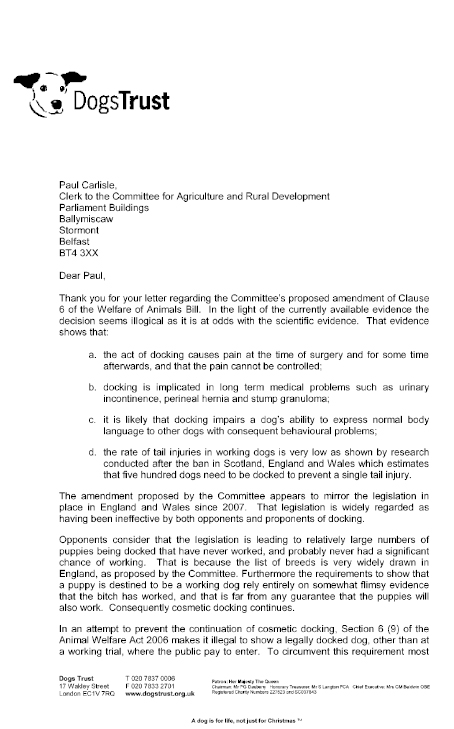
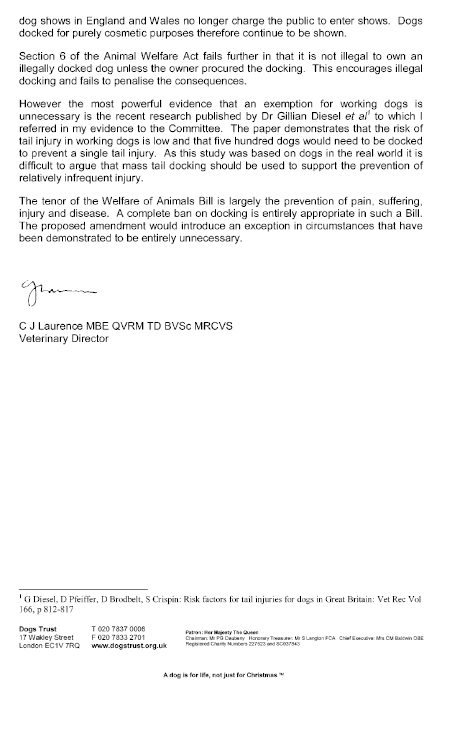
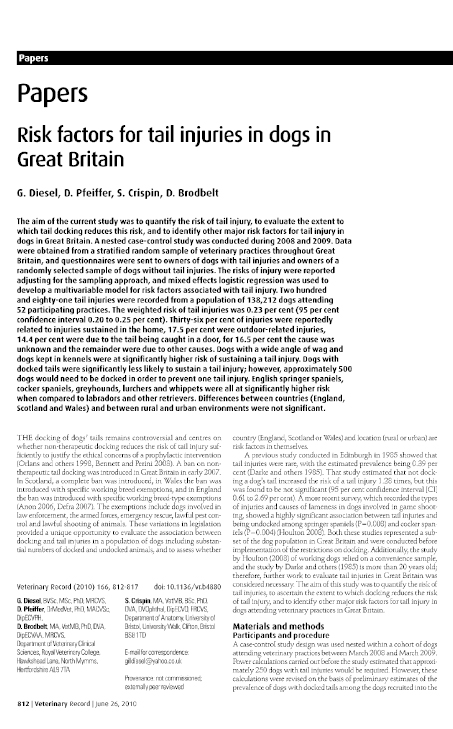
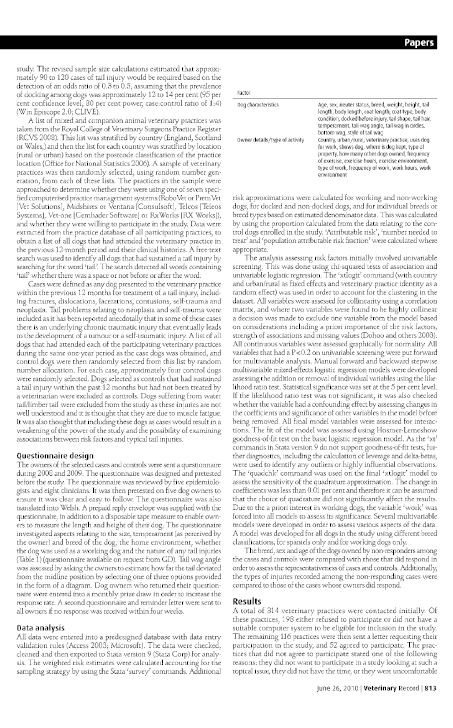
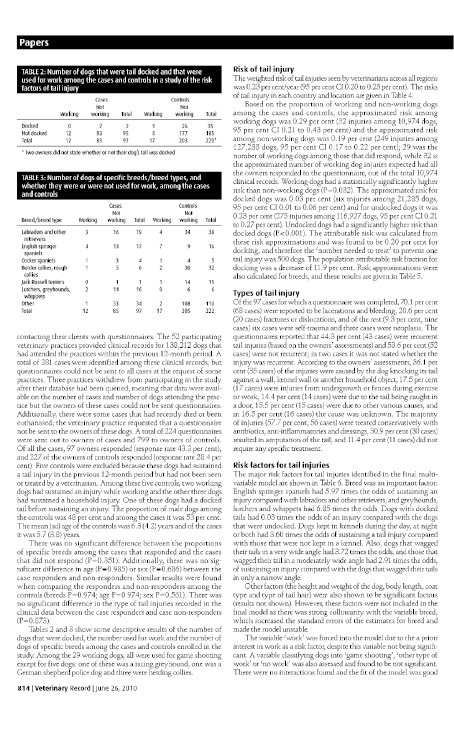
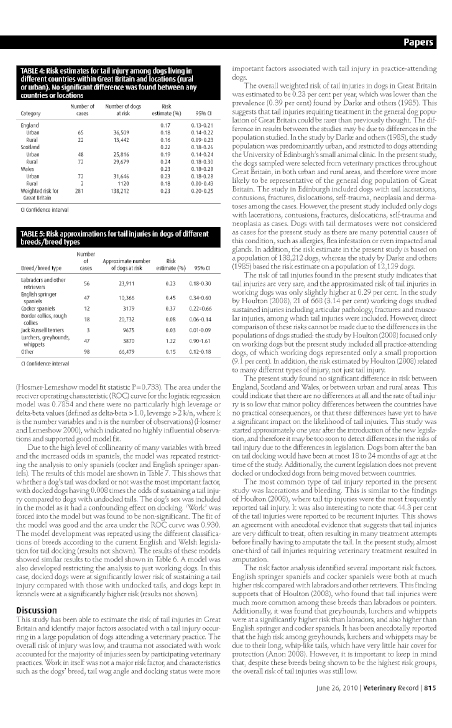
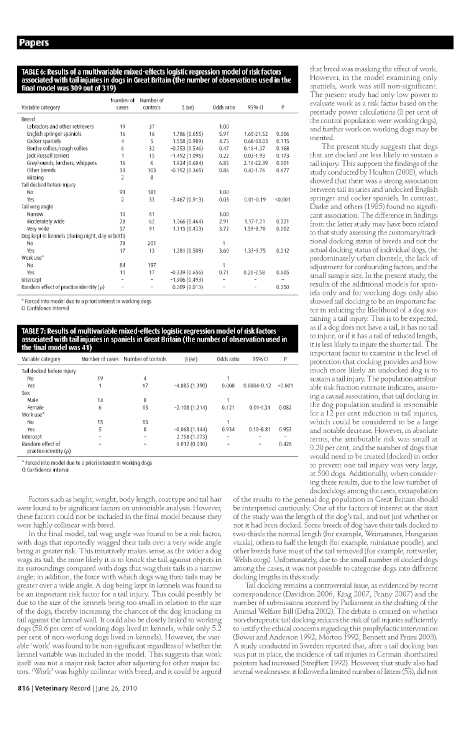
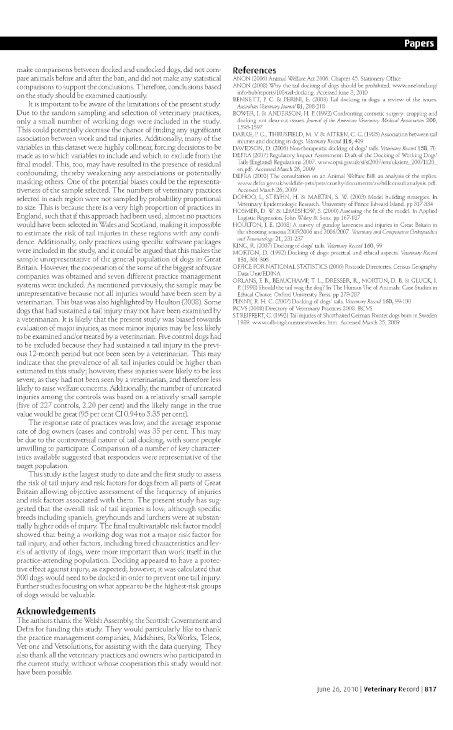
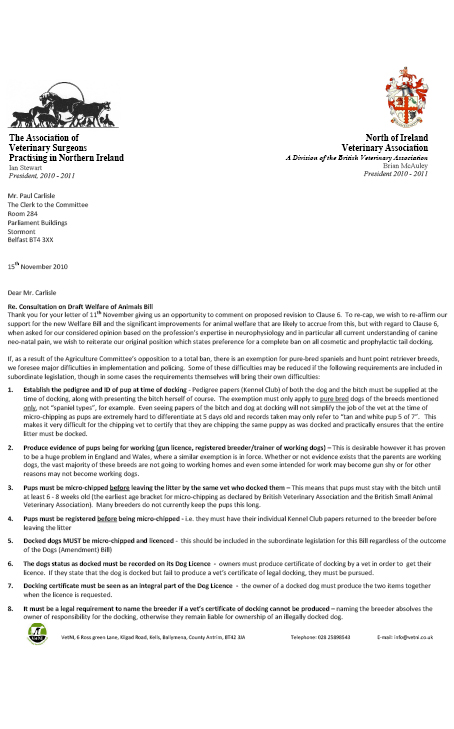
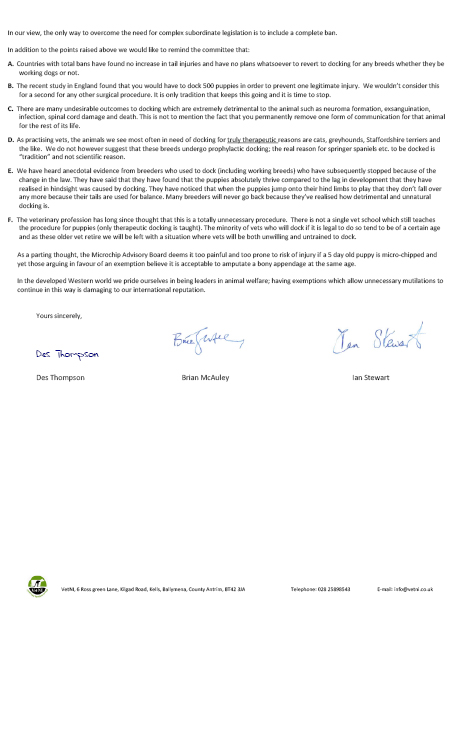
Mr Paul Carlisle
Northern Ireland Assembly
Parliament Buildings
Belfast
BT4 3XX
15 November 2010
Dear Mr Carlisle
I would like to take this opportunity to highlight the Kennel Club's position regarding docking in respect of the Welfare of Animals Bill currently being considered by the Department for Agriculture and Rural Development (DARD) Committee. Whilst the Kennel Club believes that the docking of dogs' tails should ultimately be a decision for the individual breeder based on his or her own knowledge of the breed, we recognise the concerns surrounding this issue resulting in the legislation introduced by England, Wales and Scotland which have introduced various bans.
In our recent presentation to the DARD Committee we recommended at the very least that a working exemption is introduced similar to that of the docking regulation in England – which exempts working breeds and their types which are arguably more susceptible to tail injury.
We also opposed the creation of an offence for entering a docked dog to a show at which the public pay an entrance fee which I hope will be addressed by the Committee. The Kennel Club is of the view that it is unfair to penalise responsible and genuine working dog breeders and owners who quite legally and properly have their puppies docked in the interest of their welfare, by making it illegal for them to show these dogs at certain shows. In addition, those owners of a full tailed dog which may have to have its tail amputated due to trauma later in life should not be penalised since anyone involved in showing would never purposely amputate their dog's tails as this would give them a disadvantage in the show ring.
If you would like any more information please feel free to contact me on 020 7518 1020 or alternatively email victoria.brown@thekennelclub.org.uk
Yours sincerely

Victoria Brown
Senior Public Affairs Officer
From: Claire Bradley [c.bradley@nilga.org]
Sent: 16 November 2010 16:58
To: Carlisle, Paul; O'Hare, Mark
Cc: Karen Smyth; Nora Winder
Subject: Welfare of Animals Bill - Amendment to Clause 6 (Docking of Dogs Tails)
Dear Paul,
Thank-you for your letter dated 11 November 2010 regarding the Amendment to Clause 6 (Docking of Dogs Tails).
To address your request, your correspondence was forwarded to councils for comment. As this amendment was not included in the initial legislation, councils were not in a position to comment on this in such a short timeframe. It is suggested that if the Department are planning to consult with councils on the Welfare of Animals Bill that this amendment is included in the consultation.
That said, it is considered highly unlikely that this is an area that councils would wish to be involved in and could pose difficulties for enforcement officers.
I trust you will find this useful.
Yours Sincerely,
Claire
Claire Bradley
Policy Assistant
Northern Ireland Local Government Association (NILGA)
Unit 5B Castlereagh Business Park
478 Castlereagh Road
Belfast, BT5 6BQ
Tel: 02890 798972
Fax: 02890 791248
Email: c.bradley@nilga.org
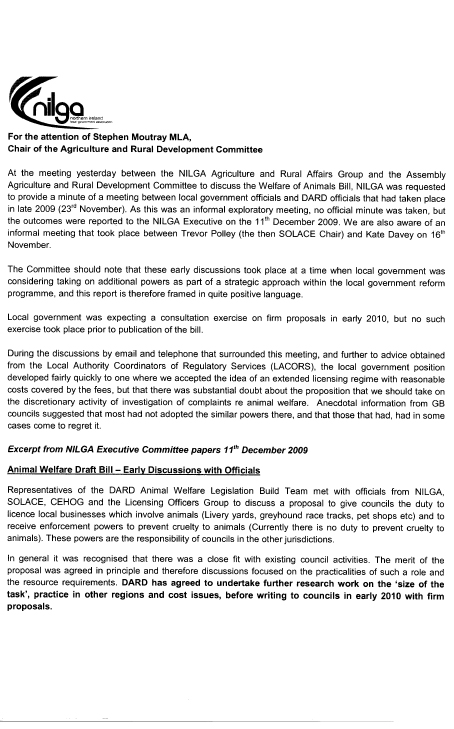
Paul Carlisle
Clerk to the Committee for
Agriculture and Rural Development
Parliament Buildings
Ballymiscaw
Stormont
Belfast
BT4 3XX
Joe Cassells
Departmental Assembly Liaison Officer
Department of Agriculture and
Rural Development
Room 509
Dundonald House
Ballymiscaw
Belfast
BT4 3SB 17 November 2010
Dear Joe
I refer to the above matter.
The Committee would wish to thank the Minister and officials for attending the meeting of 16 November 2010. Members acknowledged the Minister's proposals for an exemption to clause 6 of the Bill and welcomed the additional controls as detailed in the tabled draft document "Tail Docking of Dogs – exemption proposal". However, members agreed that the Ministers proposal for exemption continued to be too restrictive, particularly in respect of limiting the exemption to pure breed spaniels and hunt point retrievers and the exclusion of terriers as an exempted type of working dog. Members agreed that the specification of types of dogs to be specified should follow that contained in Schedule 1 of The Docking of Working Dogs' Tails (England) Regulations 2007, namely:
Members agreed that the above exempted types, in conjunction with the development of the exemption proposal, would allow for appropriate enforcement of the Bill and would allow for the Department's policy of banning the cosmetic docking of dog's tails, including those of terriers kept as pets, to be enacted in Northern Ireland. The Committee, would, therefore, recommend the aforementioned to the Minister and would be grateful for a response in advance of the next meeting, scheduled for 23 November 2010.
Whilst the Committee noted the Ministers commitment to provide cover, up to £760,000, for the entire CSR period in respect of the enforcement elements of the Bill, the Committee remains gravely concerned at the absence of appropriate consultation with the elected members of the local councils and with regards to the calculation and availability of long term resources. The Committee would recommend that clauses 12, 29 and 45 are laid dormant to allow for consultation with elected council members. These clauses should only be enacted, or repealed, through the affirmative process following discussions on the long term resourcing of the proposed enforcement responsibilities. Again, the Committee would appreciate if the Department could respond to this matter in advance to their next consideration of the Bill, scheduled for 23 November 2010.
I am happy to discuss
Clerk to the Committee for Agriculture and Rural Development
Paul Carlisle
Clerk to the Committee for
Agriculture and Rural Development
Parliament Buildings
Ballymiscaw
Stormont
Belfast
BT4 3XX
Joe Cassells
Departmental Assembly Liaison Officer
Department of Agriculture and
Rural Development
Room 509
Dundonald House
Ballymiscaw
Belfast
BT4 3SB
24 November 2010
Dear Joe
I refer to the above matter.
The Committee for Agriculture and Rural Development noted the proposed amendment to Clause 6 (Tail Docking) contained in correspondence from the Department dated and received 23 November 2010. The Committee agreed that this remained too restrictive, particularly in respect of limiting the exemption to pure breed spaniels and hunt point retrievers and the exclusion of terriers as an exempted type of working dog. Members were advised by departmental officials that this represented the final position of the Department and therefore agreed that they would table an amendment to the clause seeking to bring it into line with Schedule 1 of The Docking of Working Dogs' Tails (England) Regulations 2007, namely:
Members also indicated that, if their proposed amendment were enacted, they would wish the Department to urgently bring subordinate legislation in line with the principles contained in the Department paper tabled at the meeting of 16 November 2010, "Tail Docking of Dogs – exemption proposal". Members remain of the view that the amendment, in conjunction with the aforementioned paper, will allow for appropriate enforcement of the Bill and will further allow for the Department's policy of banning the cosmetic docking of dog's tails, including those of terriers kept as pets, to be enacted in Northern Ireland.
Members will wish to consider the text of their proposed amendment at the next meeting. I would be grateful, therefore, if you could urgently confirm if the Department intends to amend the clause as suggested previously by the Minister or whether the intention is to revert to the original clause. Obviously, this will have a bearing on the text of the proposed Committee amendment. As discussed with the Head of Animal Health and Welfare Policy, I am due to consider the amendment with the Northern Ireland Assembly Bill Office on Thursday, 25 November 2010. I would be grateful, therefore, if confirmation was received from the Department to inform this meeting.
With regards to resourcing implications on local Councils, Members again noted the Ministers confirmation that £760,000 would be available to local Councils to resource enforcement of the Bill. Members did, however, express concern that a new Minister appointed following the election could re-prioritise the departmental budget and that this burden would, automatically, fall to councils. Members would seek reassurance that these monies will be ring-fenced for, at a minimum, the period of the next CSR. In addition, Members have asked that the Minister confirm that commencement of clauses 17, 29 and 45, which delegate enforcement and inspection responsibilities to local councils, will be deferred for a period of at least 12 months to allow for further consultation with elected Council Members.
The Committee intends undertaking formal clause by clause scrutiny of the Bill at the meeting scheduled for 30 November 2010 and of the draft report at the meeting of 7 December 2010. This would allow the Committee Stage to complete in advance of 14 December 2010.
I am happy to discuss
Paul Carlisle
Clerk to the Committee for
Agriculture and Rural Development
01/12/10
Firstly I must direct my apologises to the Committee and the Committee Clerk. The CBI response to this correspondence is very very late, that is the sole responsibility of Myself (David Hamilton) and I must apologise profusely, My mother passed away around the time this email was received and it became lost in the events of that time.
It is never the less very important that we respond and that it is put on record, We would issue thanks that our opinion has been sought and mark it as a positive thing in that this process has been inclusive of all parties and their opinions.
The CBI consider it proper that concessions are made on the tail docking issue, the arguments presented to the Committee was unconvincing to say the least, despite the bluster surrounding this issue we genuinely feel, like so many of our members that there is a greater risk to animal welfare from the Ban than from docking itself. To limit the exemption to Hunt point and retriever breeds would seem a narrow option, on principal it is just but in reality an exemption should regard the actual daily working life of the dog, Eg his owner is a member of a hunt club, his owner holds a firearm license etc, these are a good indicator of how this dog works and the level of risk his tail is exposed to. In practical terms this would be more to the benefit of animal welfare.
Again our apologies, we understand this is a very important matter and hope this letter may be of some assistance. We remain at the Committees disposal should we be needed.
The CBI
Paul Carlisle
Clerk to the Committee for
Agriculture and Rural Development
Parliament Buildings
Ballymiscaw
Stormont, Belfast
BT4 3XX
Joe Cassells
Departmental Assembly Liaison Officer
Department of Agriculture and
Rural Development
Room 509
Dundonald House
Ballymiscaw, Belfast
BT4 3SB
08 December 2010
Dear Joe
I refer to the above meeting.
The Committee considered its draft amendment to Clause 6 of the Welfare of Animals Bill and also considered the first draft of the Committee Report.
Departmental Officials indicated that the Department is taking legal advice on the use of the word breed instead of type. I would appreciate confirmation of the outcome of this advice as soon as possible and in advance of the final meeting in relation to the Bill, scheduled for Monday 13 December.
In terms of secondary legislation, the Committee agreed that the following matter progress to the next legislative stage:
Information on the feedback from the Commission following its meeting with DARD and DOE in London on 01 December 2010 would be appreciated as soon as it is available.
The Committee deferred consideration of the following items unti the meeting of 14 December to enable witnesses' attendance:
Finally, I attach forwarded correspondence from the Committee for the Environment for comment.
I am happy to discuss.

Paul Carlisle
Clerk to the Committee for
Agriculture and Rural Development
Dear Paul
The members of the NILGA Agriculture and Rural Development Group greatly appreciated the recent arrangements which you put in place to meet informally with the Agricultural Committee. This Bill has now been widely discussed in the local government sector and there remains strong opposition to undertaking this function particularly in the context of RPA not progressing in the time scale laid out by the Department of the Environment. The Chairman of the NILGA Agriculture & Rural Development Group and myself were involved in a meeting yesterday with DARD (at their request).
The timetable for passage and implementation of the Bill was outlined and the DARD representatives indicated that they wanted to discuss implementation issues. We emphasised that local government through NILGA had taken a collective view on this matter which was opposed to these highly resource draining responsibilities being placed with councils.
The NILGA group would appreciate further opportunity to address the Agriculture Committee on this issue as a result of our deliberations yesterday and additional concerns which have emerged.
Yours sincerely
Alan Burke
Co-Ordinator
Dungannon & South Tyrone Borough Council
Circular Road, Dungannon, BT71 6DT
Telephone: 028 87 720367 Mobile: 07799 711528
Tommy Mayne BASC
Tom Blades BASC
Tony Patterson BASC
Jim Shannon BASC
Victoria Brown Kennel Club
Bill Lambert Kennel Club
Lyall Plant Countryside Alliance Ireland
Michael Watts Countryside Alliance Ireland
James Barrington Countryside Alliance Ireland
Brian McAuley VetNI
Ian Stewart VetNI
Des Thompson VetNI
John Corkey Belfast City Council
Gillain Topping Banbridge District Council
Karen Smith NILGA
David Hamilton Canine Breeders Ireland
Jonathan Hamilton Canine Breeders Ireland
Michael McKay Canine Breeders Ireland
Gerry Smyth Canine Breeders Ireland
Chris Laurence Dogs Trust
Colette McMaster DARD
Kate Davey DARD
Paddy McGuckian DARD
Andrew Kell DARD